Early Los Angeles Historical Buildings (1900 - 1925)
Historical Photos of Early Los Angeles |
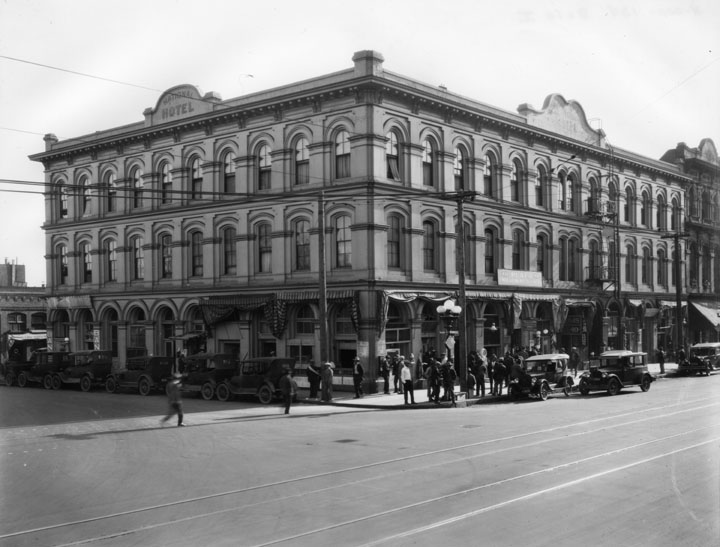 |
|
| (ca. 1920)* - The Pico House, sometimes called "Old Pico House", built by Pio Pico in 1869-70. For a period in the 1920's it became the "National Hotel" and here we see a corner view of the building at the corner of N. Main & Plaza St., with a sign for "Plaza Employment Agency" on the right side of the building. A crowd of people are hanging around the corner, and a row of cars is parked up the left side, while 3 or 4 cars are seen on the right side. |
Historical Notes Pío Pico constructed the Pico House in 1869-70. The first three-story hotel built in Los Angeles, it had about eighty rooms, large windows, a grand staircase, and a small interior courtyard.^* The Pico House (Hotel) was designated as California Historical Landmark No. 159 (Click HERE to see California Historical Landmarks in LA). |
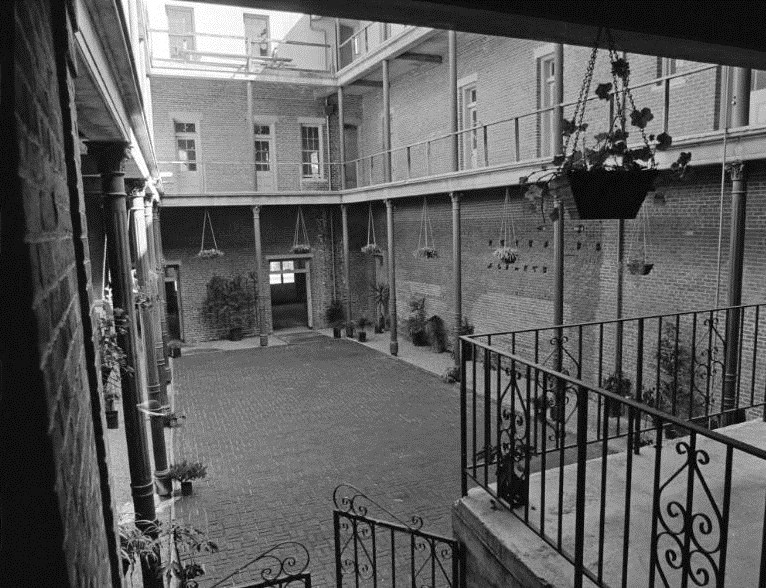 |
|
| (ca. 1971)*^*^ - View of the Pico House's interior courtyard shortly after it was restored. |
Click HERE to see more Early Views of the Pico House |
* * * * * |
Hamburger's Department Store (later May Co. - Macy's - California Broadway Trade Center)
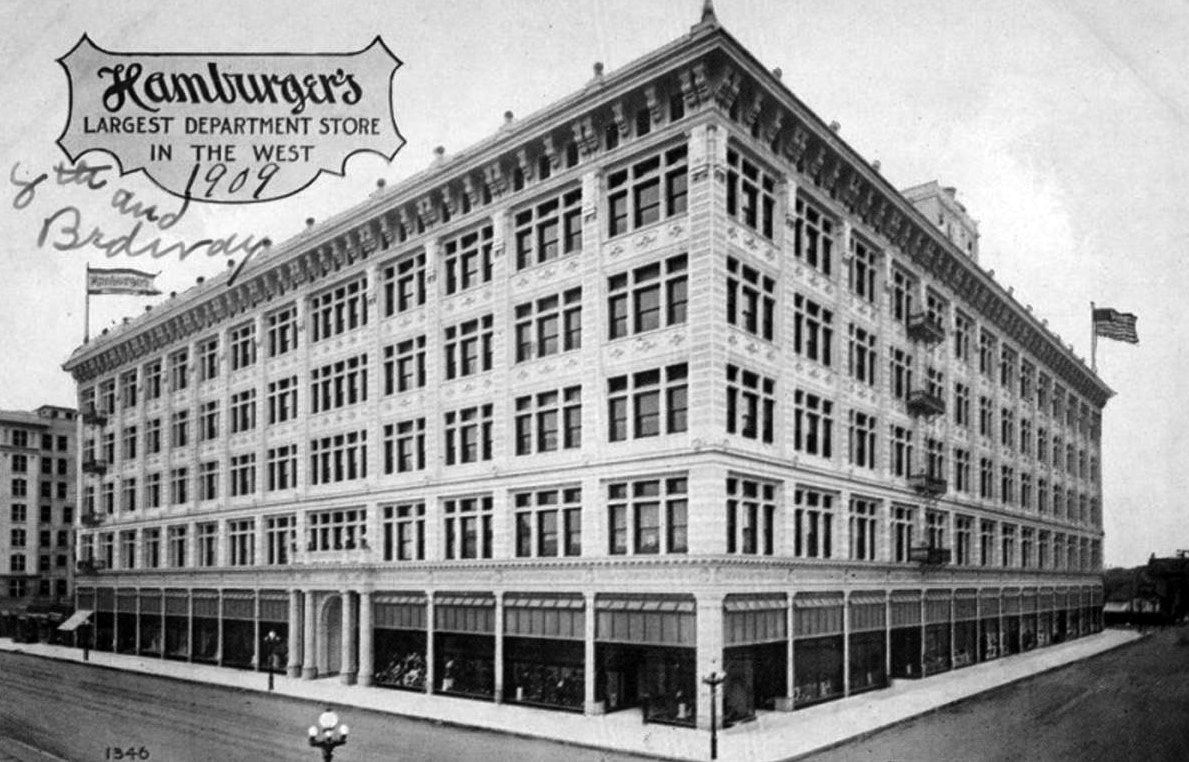 |
|
| (1909)* – Postcard view showing the newly constructed Hamburger’s Department Store located on the corner of Broadway and 8th Street. Hamburger’s was called the "Largest Department Store in the West." |
Historical Notes A. Hamburger and Sons was one of the first department stores to operate in Los Angeles. Originally known as A. Hamburger & Son's People's Store, the name later changed to Hamburger's Store. In 1908 the company relocated their store from the Phillips Block on Spring Street to a new building located at Broadway and Eighth Street (seen above). |
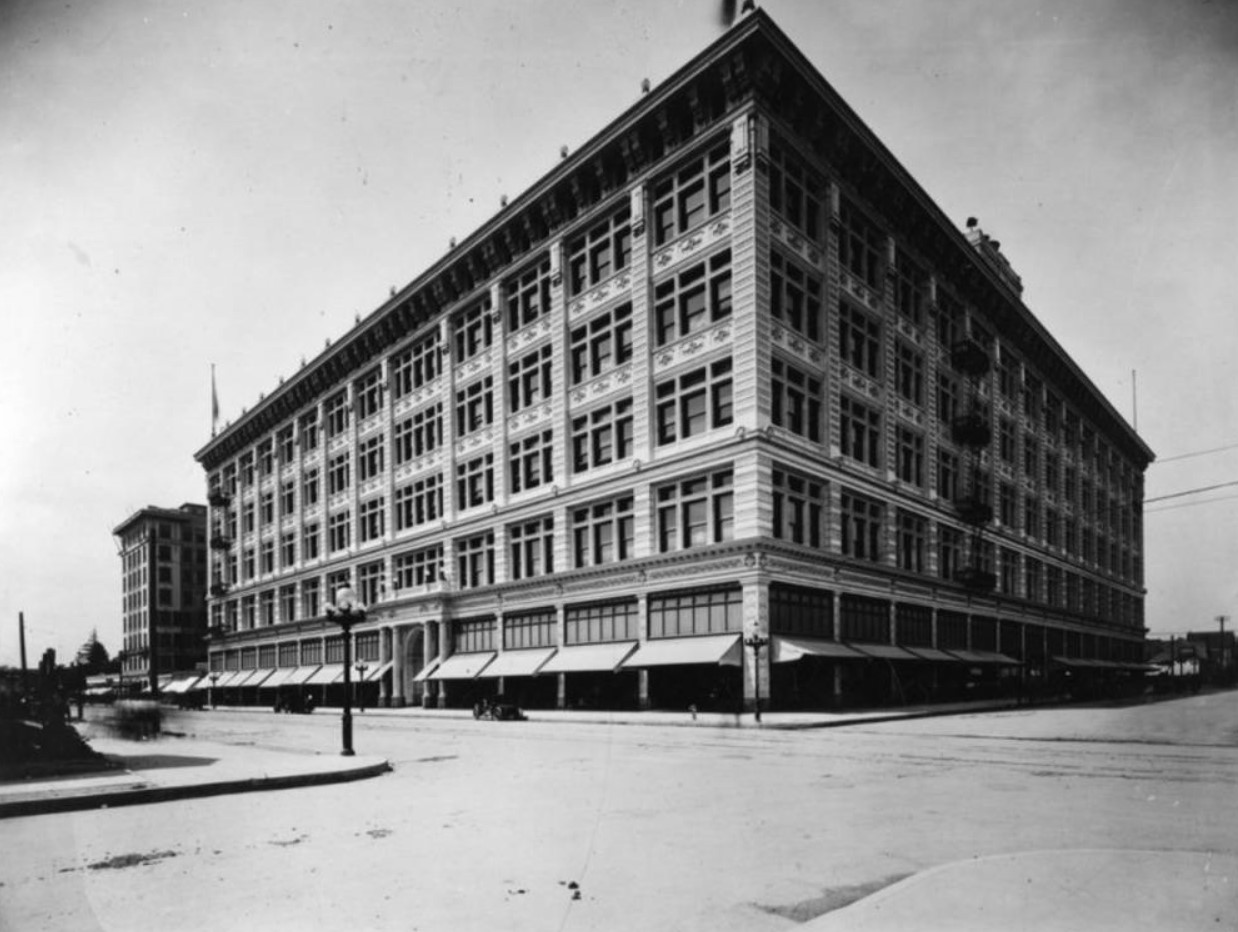 |
|
| (ca. 1909)* - View looking toward the SW corner of Broadway and 8th Street showing the Hamburger’s Department Store. The Majestic Theater (opened in 1908) can be at the end of the block in the distance. Note how empty the streets are. |
Historical Notes Originally designed by Alfred F. Rosenheim and opened in 1908, this Beaux Arts building was enlarged by Aleck Curlett in 1929 to accommodate more merchandise. The store was acquired from A. Hamburger & Sons Co. by David May in 1923 and renamed the May Company.* |
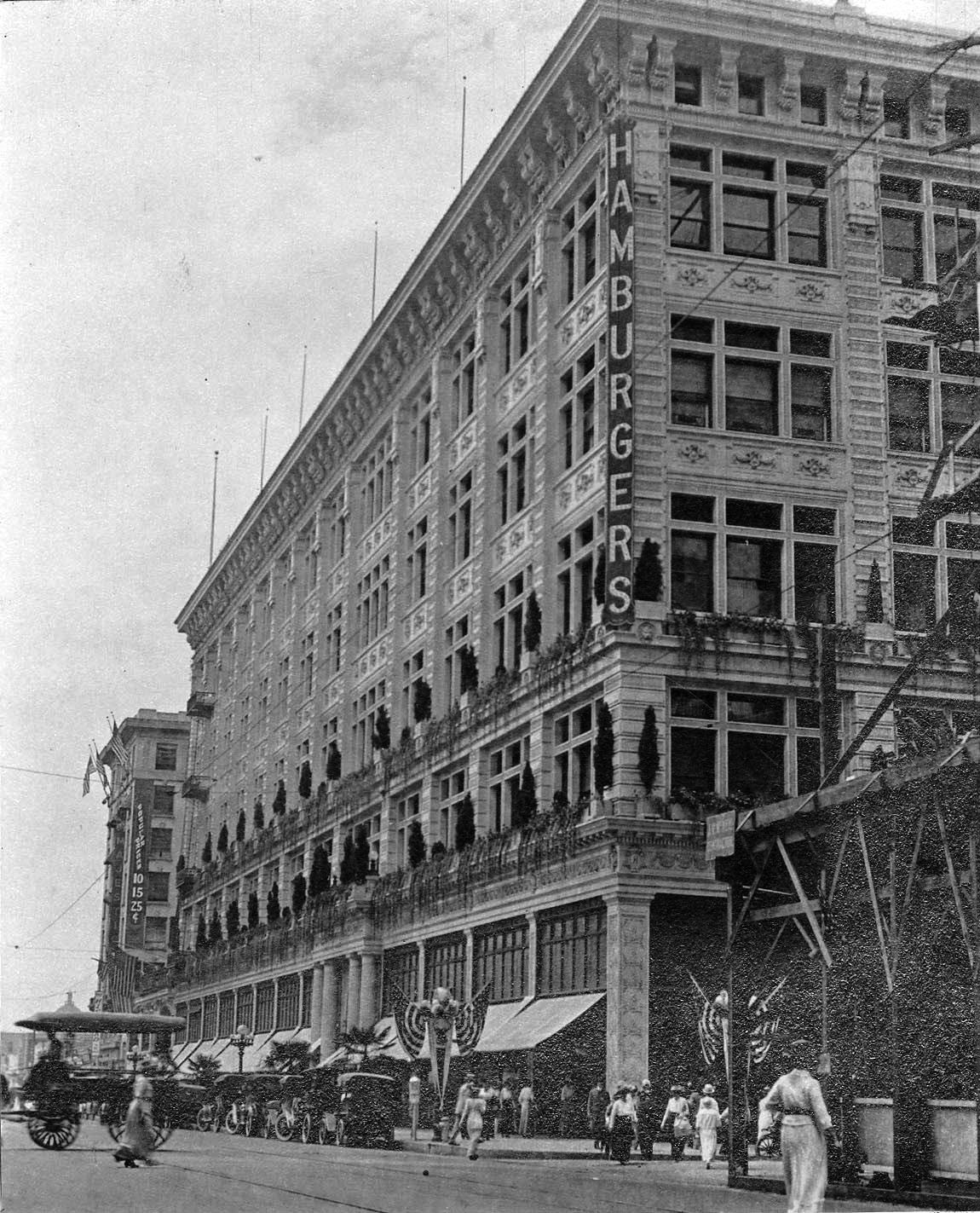 |
|
| (1915)^*#– View looking south on Broadway at 8th Street with the Hamburger’s Department Store seen on the SW corner. Horse-drawn carriages, cars, and pedestrians share the busy street. The Majestic Theater is at left with a large banner on its side that reads: “Popular Priced: 10¢ – 15¢ – 25¢”. The new building going up on the right (NW corner) is the Merritt Building. |
 |
|
| (ca. 1920)^.^ – Postcard view of Hamburger's department store located at the southwest corner of Broadway and Eighth Street in Downtown Los Angeles. “The Great White Store” |
Historical Notes A. Hamburger & Sons Co. was a department store founded in 1881 by Asher Hamburger and operated exclusively in Southern California until 1989. The Hamburger family first started its retail store, originally known as the People's Store, on Main Street near Requeña Street (later renamed Market Street). In 1887 they moved into the new Phillips Block on Spring Street. And in 1908, relocated and expanded to the Great White Store at Broadway and 8th Street. It was the largest department store building west of Chicago at that time. ^ |
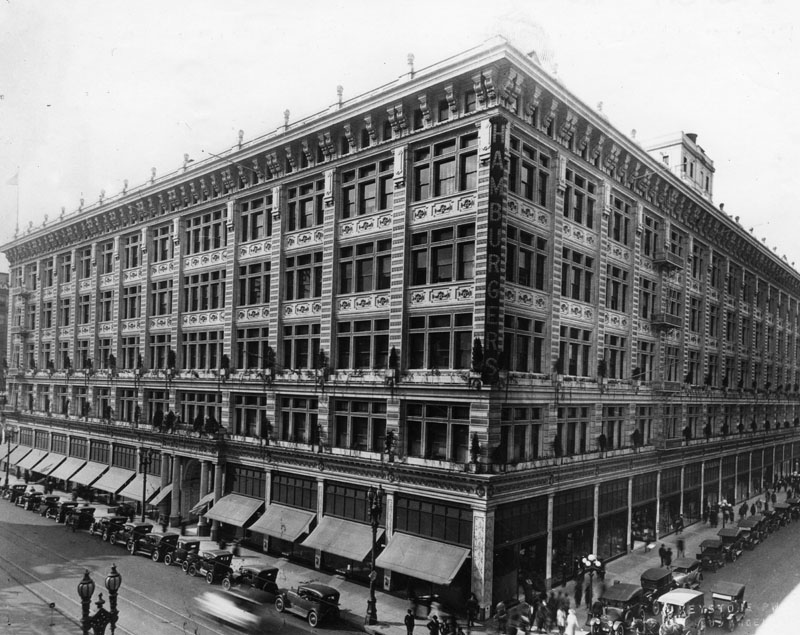 |
|
| (ca. 1926)* - Exterior view of Hamburger's ornately decorated department store located on the corner of Broadway and Eighth streets. Awnings cover the display windows on one side and cars are parked end to end at the curb. |
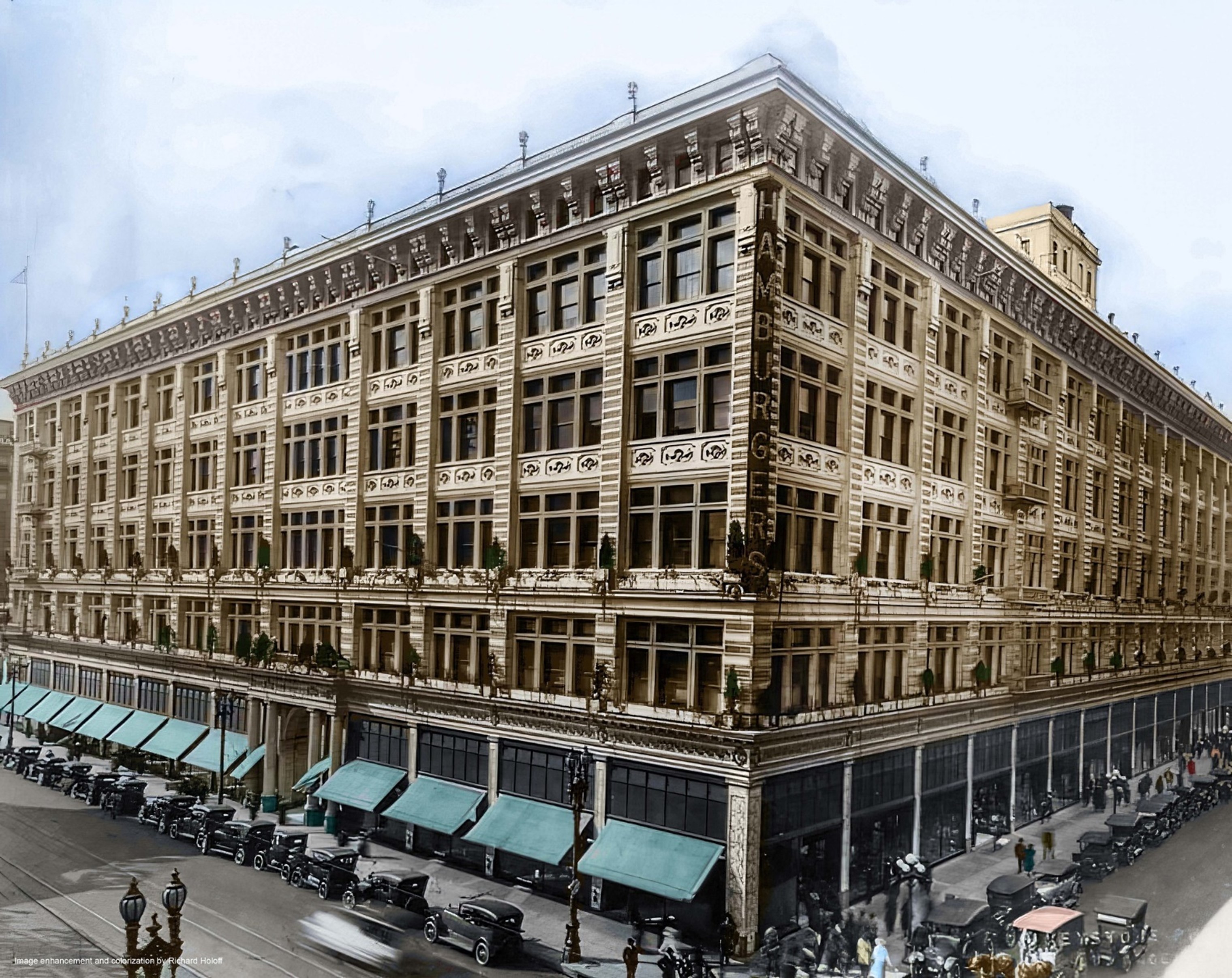 |
|
| (ca. 1926)* - Exterior view of Hamburger's ornately decorated department store located on the corner of Broadway and Eighth streets. Awnings cover the display windows on one side and cars are parked end to end at the curb. Image enhancement and colorization by Richard Holoff |
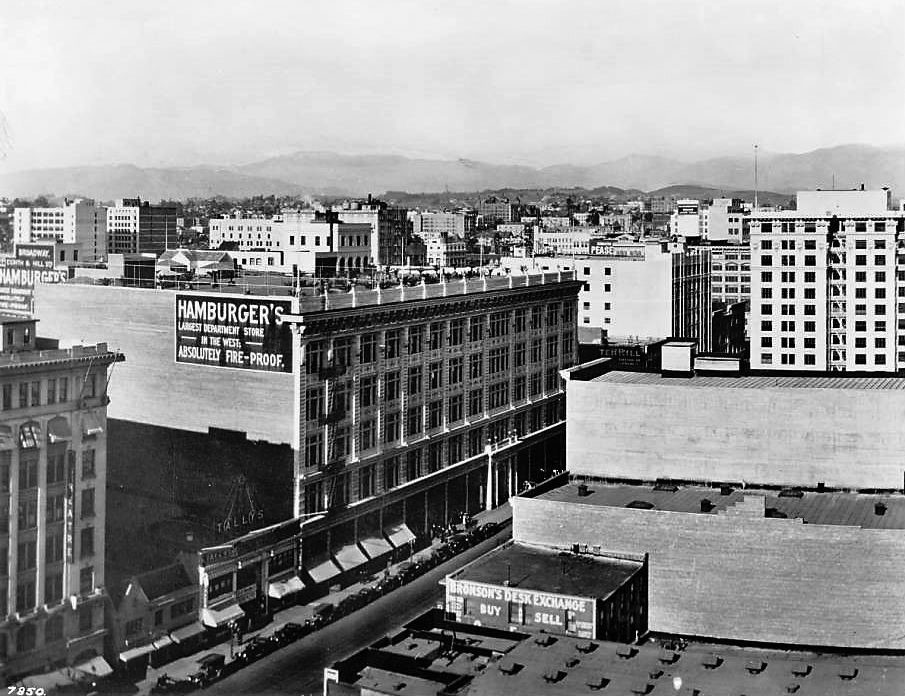 |
|
| (ca. 1915)^^ – View looking NW showing the Hamburger’s Department Store (later May Company) located on the SW corner of Broadway and 8th Street. At left can be seen the Majestic Theater and Tally's New Broadway Theatre. |
Historical Notes In 1923, the Hamburger Department Store was acquired by May Company California. The Beaux Arts building was enlarged by Aleck Curlett in 1929 to accommodate more merchandise. |
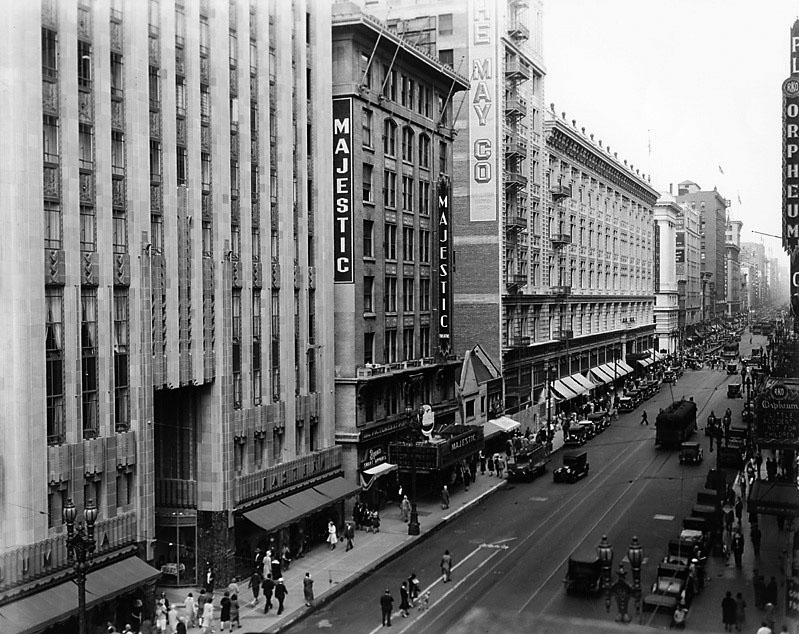 |
|
| (1930)* – View of Broadway looking north from 9th Street showing The May Company (previously Hamburger's) on the SE corner at 8th Street. Note that Tally''s Broadway Theater is now gone. The May Company was still working on the storefronts of its addition on the Tally's site. The Majestic Theater is seen at center with the newly opened Eastern Columbia Building on the left. The Majestic is running "Top Speed" with Joe E. Brown. Acorss the street, the Orpheum Theatre is playing "Little Accident," with Douglas Fairbanks, Jr. and Anita Page. |
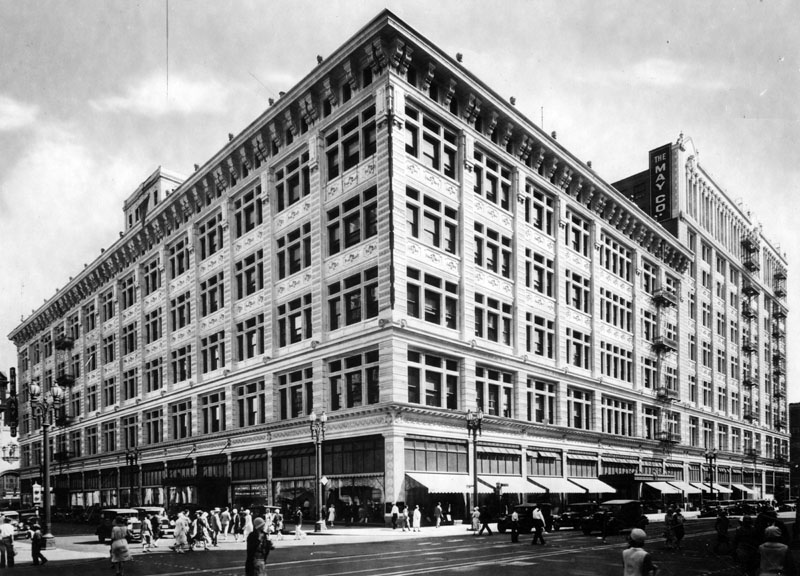 |
|
| (1933)* - View looking at the SE corner of Hill and 8th streets showing the May Co. Building (previously Hamburger's Department Store). The building runs all the way from Hill to Broadway on the south side of 8th Street. |
Historical Notes May Department Stores acquired Hamburger's in 1923 and renamed it the May Company. Much later in the century, the May Company and Robinsons chains of department stores would affiliate under the name Robinsons-May; and this entity would be bought out by Macy's in 2005.^ |
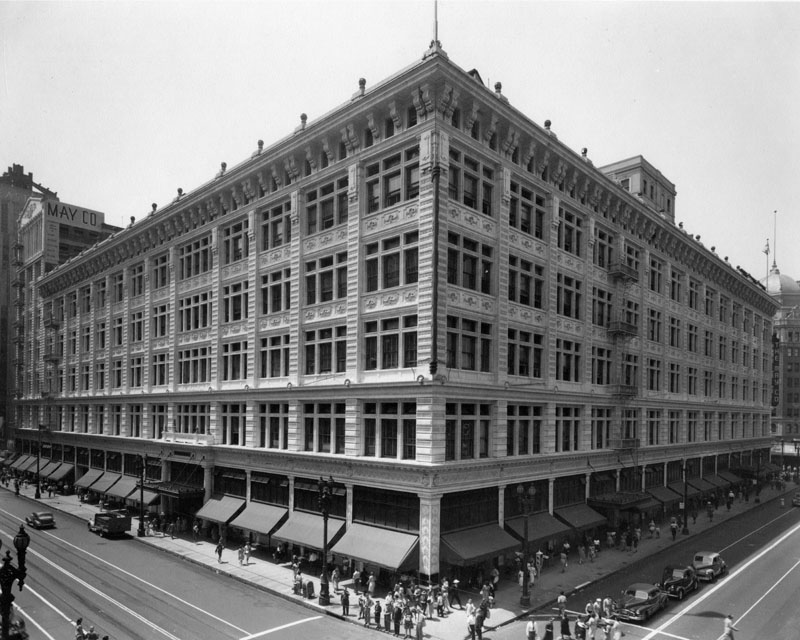 |
|
| (1951)* - Photo by Dick Whittington showing the exterior of the May Co. building located on the SW corner of Broadway and 8th streets in downtown Los Angeles. |
Historical Notes More recently, the building has been known as the California Broadway Trade Center and houses dozens of individual retail stalls.* The building is now owned by the Afshani brothers who, it is rumored, are planning to bring a hotel, apartments, and revamped retail space to the one-million-square-foot site, which runs all the way between Broadway and Hill.*## In 1989, the Hamburger/May Co. Department Store Building was designated Los Angeles Historic-Cultural Monument No. 459 (Click HERE for complete listing). |
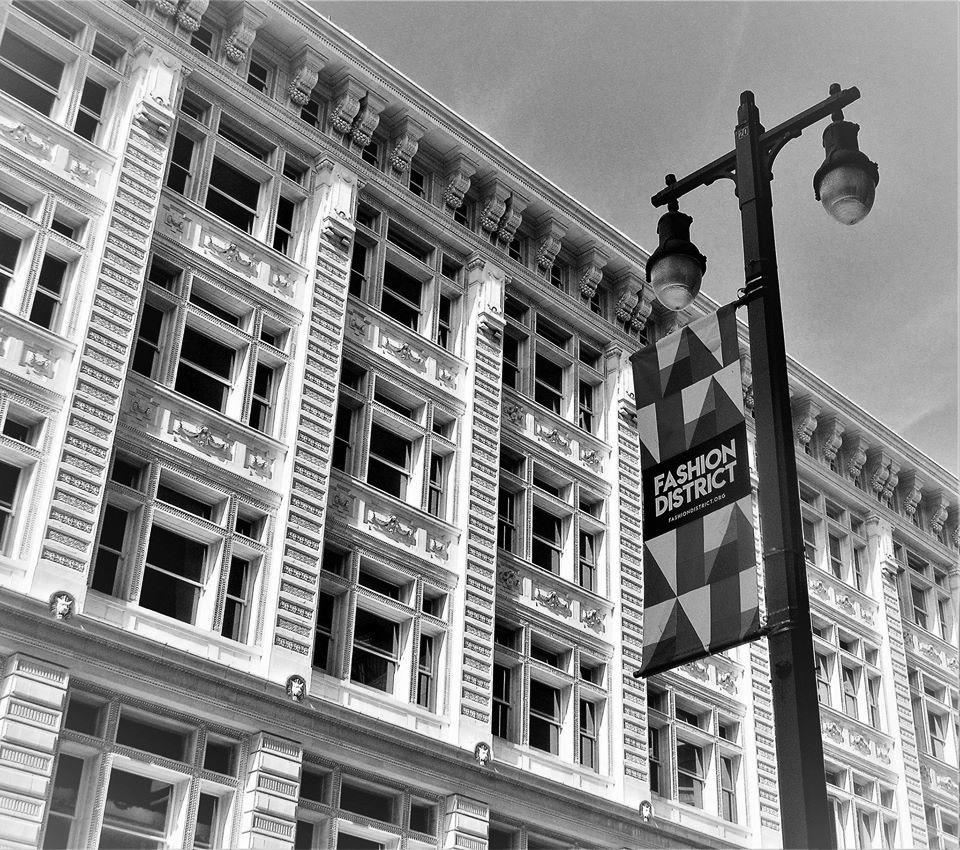 |
|
| (2020)^.^ – View looking up at the newly renovated California Broadway Trade Center (801 S. Broadway) with ornate dual-pendant teardrop-shaped streetlight seen in the foreground. The 1908-built Beaux Arts building (1908) was originally home to Hamburger’s Department Store. Photo by Howie Gray. |
* * * * * |
County Courthouse
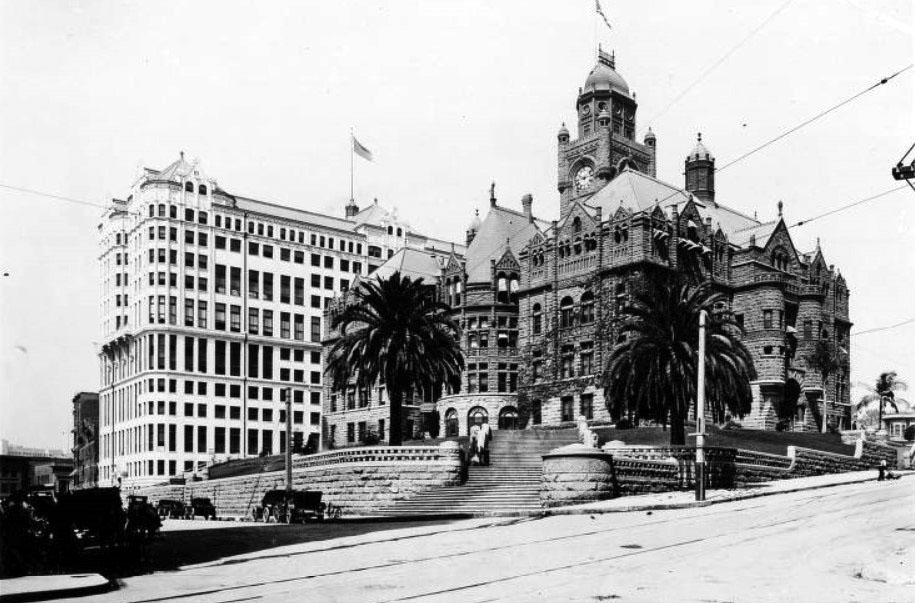 |
|
| (ca. 1917)#^*- View of the southeast corner of Temple Street and Broadway showing the County Court House and Hall of Records. |
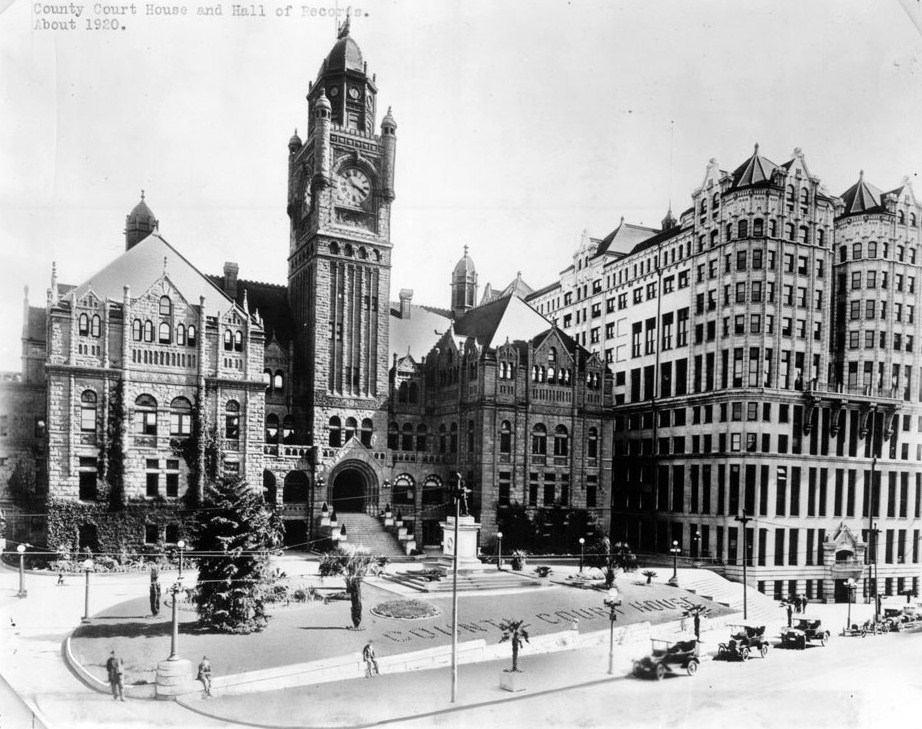 |
|
| (ca. 1920)^ - View of the Los Angeles County Courthouse and Hall of Records standing side-by-side. |
Historical Notes The LA County Courthouse was built in 1891 at the old site of Los Angeles High School. The building was demolished in 1936. The Hall of Records was built in 1906 and demolished in 1973.* |
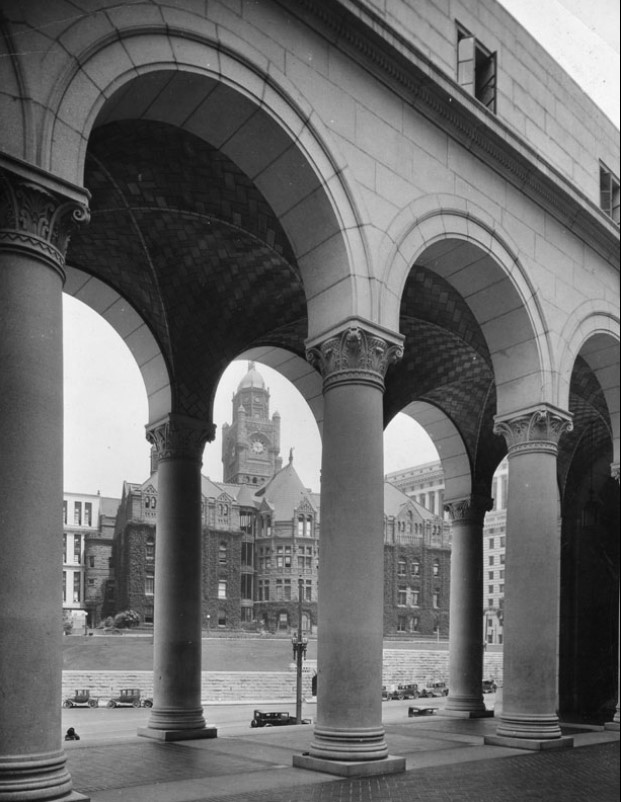 |
|
| (1928)* - View of the Los Angeles County Courthouse viewed through the colonnade of the recently completed City Hall. |
Click HERE to see more Early Views of the LA County Courthouse |
* * * * * |
Broadway Christian Church
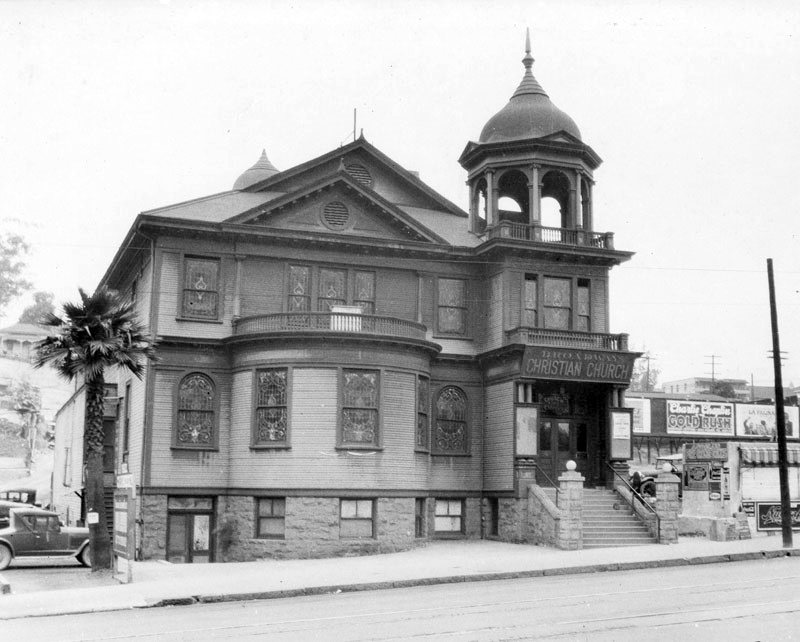 |
|
| (ca. 1923)* - View looking at the Victorian-style Broadway Christian Church at 223 Broadway, located across the street from the County Courthouse just south of Temple Street. |
Historical Notes Dedicated in 1895, this building served as the Broadway Christian Church until 1925, at which time the congregation relocated and built a Spanish-style church at 3405 W. Pico Blvd. in Los Angeles. Many years later, the Pico-Arlington Christian Church became the Ethiopian Christian Church. B. F. Coulter was an ordained minister and founded the Broadway Christian Church. He was also one of the earliest merchants in Los Angeles having started Coulter's Dry Goods in 1878. |
* * * * * |
Hotel Ford
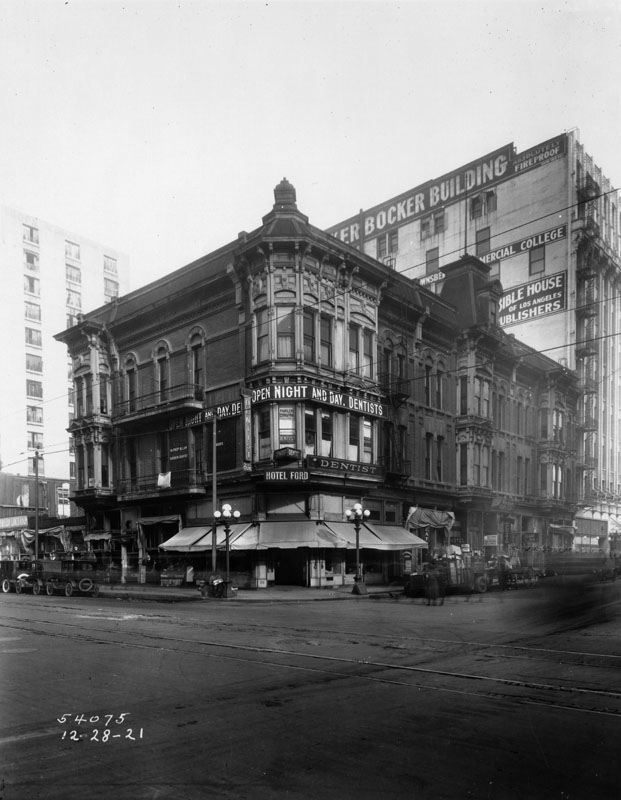 |
|
| (1921)* - The northwest corner of Olive and 7th Streets on December 28, 1921. This is the future site of the Bank of Italy Building. In this photo it is Hotel Ford, with a dentist's office above. It is also known as the United States Hotel. The Knickerbocker Building is at right. |
Bank of Italy Building (Today, Giannini Place)
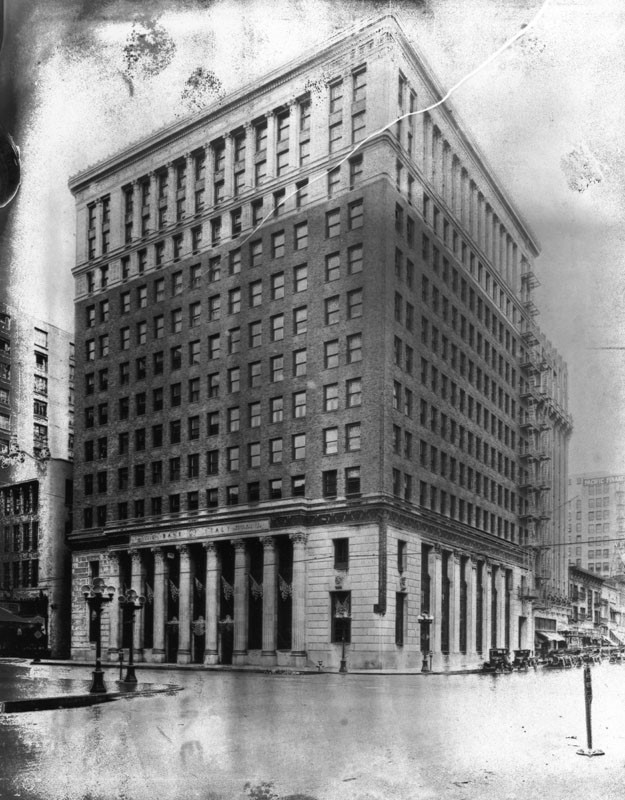 |
|
| (1922)* – View showing the newly constructed Bank of Italy at 649 South Olive Street. The building is a neoclassical base supporting office block, a rusticated base, with 3-story monumental colonnades. Date built: 1922. Architects: Morgan, Walls & Clements. |
Historical Notes The 12-story building was completed in 1922 and dedicated in 1923. It was built as the Los Angeles headquarters of the Bank of Italy, a forerunner to Bank of America founded by Amadeo Giannini. Designed by architectural firm Morgan, Walls & Clements, the Neoclassical architectural style building has Doric columns, ornate golden ceiling and marble floors. The bronze front doors are surrounded by terra cotta sculptures of American coins.
The Bank of Italy was founded in San Francisco, in 1904 by Amadeo Giannini. It grew by a branch banking strategy to become the Bank of America, the world's largest commercial bank with 493 branches in California and assets of $5 billion in 1945. It was also the first state-wide branch banking system. The Bank of Italy merged with the smaller Bank of America, Los Angeles in the 1928. In 1930, Giannini changed the name "Bank of Italy" to "Bank of America." As Chairman of the new, larger Bank of America, Giannini expanded the bank throughout his tenure, which ended with his death in 1949.^* |
 |
|
| (1920s)* – View looking at the NW corner of 7th and Olive streets showing the Bank of Italy, once the site of the Hotel Ford. |
Historical Notes When the Bank of Italy Building opened in 1922 it had a massive vault that included space for 12,000 safe-deposit boxes. The main vault door weighed 50 tons. Bank of Italy, already the largest bank in the West by 1923, also encouraged deposits from a group that most banks at the time overlooked — women and children. It became Bank of America in 1930. The building, now known as Giannini Place, was remodeled in 1968, and declared LA Historic Cultural Monument No. 354 on April 16, 1988. Click HERE for contemporary view. |
* * * * * |
Loew's State Theater
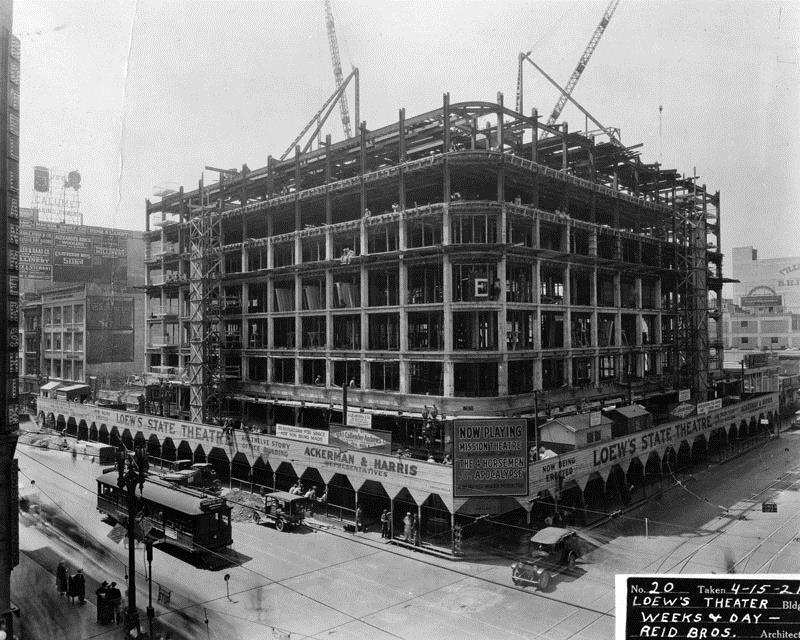 |
|
| (1921)* - View looking at the southwest corner of Broadway and 7th Street showing the construction of Loew's State Theater. Workers can be seen sitting on different floors taking a break. |
Historical Notes Loew's State Theatre, located at 703 S. Broadway was constructed in 1921 on the site of the Vogel Block (1893-1920). It opened the same year and had a seating capacity of 2,450. The theater offered both film and vaudeville when it opened. Designed by Charles Weeks and William Day, the 12-story Loew's State is said to be the largest brick-clad structure in Los Angeles.^* It was the 200th theatre built by Marcus Loew and was the most completely equipped on the coast. The theatre was housed in a twelve-story building costing $2,500,000. The theatre proper cost $1,500,000. It was built by Woods Brothers, Weeks and Day, and was under the direction of Ackerman and Harris, Western managers for Loew in San Francisco.**^ |
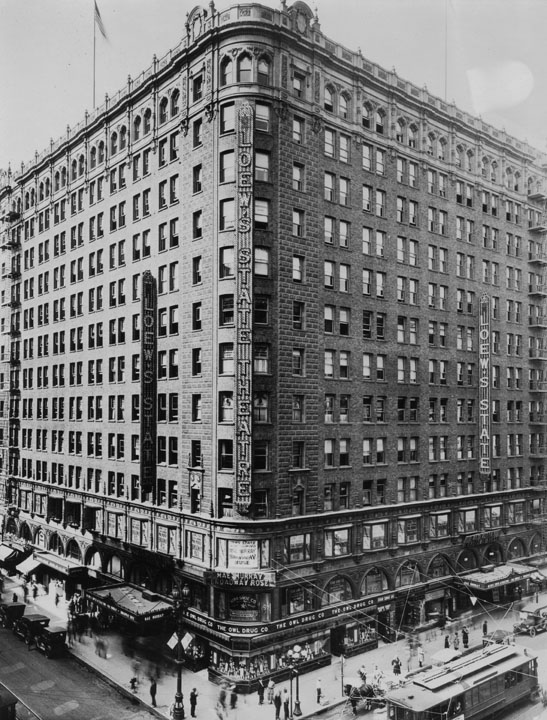 |
|
| (1921)* - Pedestrians walk by the marquee at the Loew's State Theater on the corner of 7th and Broadway as it advertises Mae Murray in "Broadway Rose". On the ground floor is The Owl Drug Co. Various businesses occupy the other floors. A horse and buggy is stopped at the intersection next to a streetcar. |
Historical Notes Loew's State Theatre was built as the west coast showcase for the product of the Loew's subsidiary Metro Pictures. The opening was on November 12, 1921 at one of downtown's busiest intersections, 7th and Broadway. Loew's State once used entrances on both streets. The 7th St. entrance was closed in 1936. The opening attraction was MGM's "Liliom." Marcus Loew was in attendance with a bevy of stars. Wonderfully successful as a vaudeville/movie house, it featured elaborate stage shows by Fanchon and Marco with leading performers. Judy Garland sang here when she was still one of the Gumm Sisters.**^ |
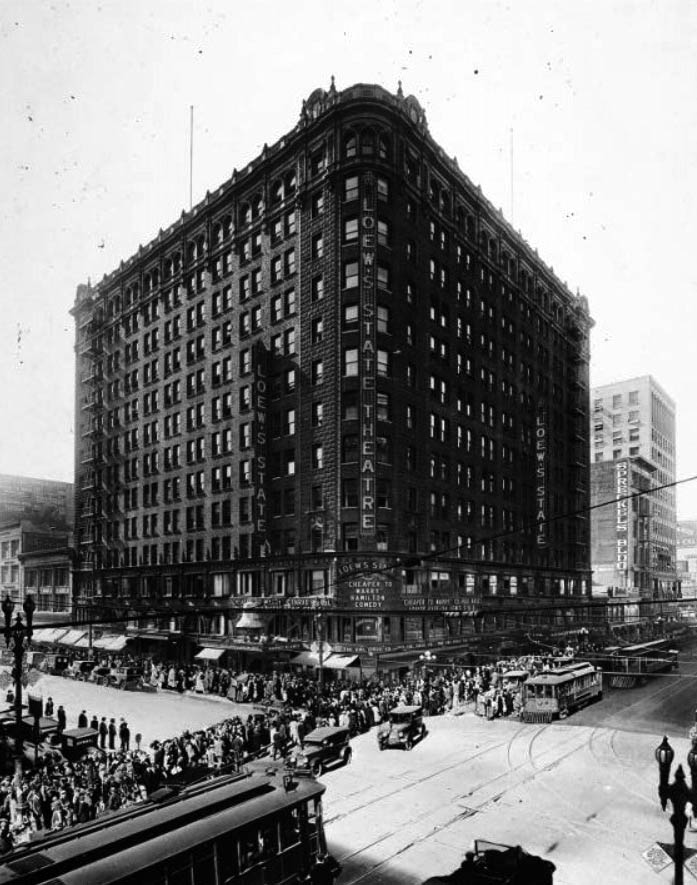 |
|
| (ca. 1924)^ – View of the Loew's State Building (Loew's State Theatre) at the southwest corner of Seventh Street and Broadway. Many streetcars can be seen operating here as thousands crowd into the theatre. |
Historical Notes In 1924 Marcus Loew engineered the merger of Metro with the Goldwyn Co. (which Sam Goldwyn had departed from in a 1922 power struggle) and the Louis B. Mayer group -- resulting in Metro-Goldwyn Pictures. By 1925, Mayer's name was also part of the company name, thus becoming MGM.**^ |
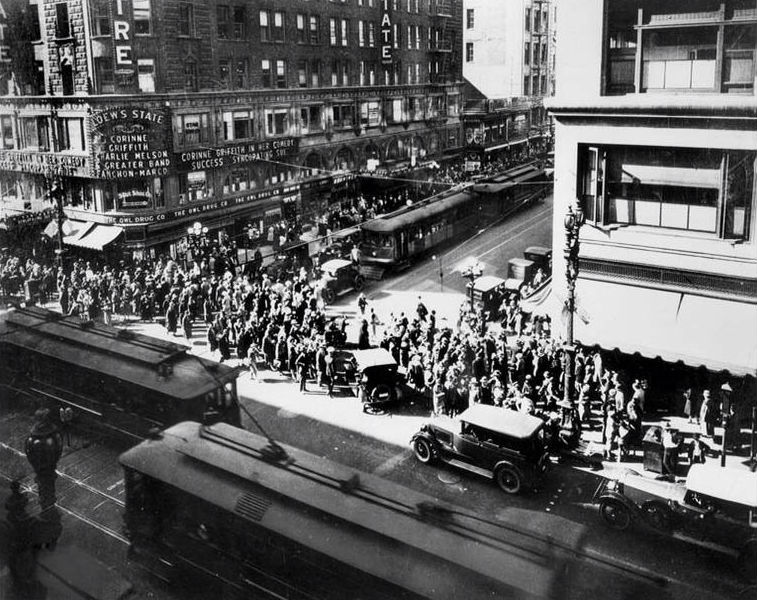 |
|
| (1926)**^ - View from above of 7th & Broadway, downtown's busiest intersection. Loew's State Theater is playing "Syncopating Sue" starring Corinne Griffith. |
Historical Notes MGM's prestige product was well suited to the type of theatres operated by the Loew's Corporation. Although at its height in the late 1920's, the circuit totaled only about 160 theatres, they were typically lavish first runs in major cities.**^ |
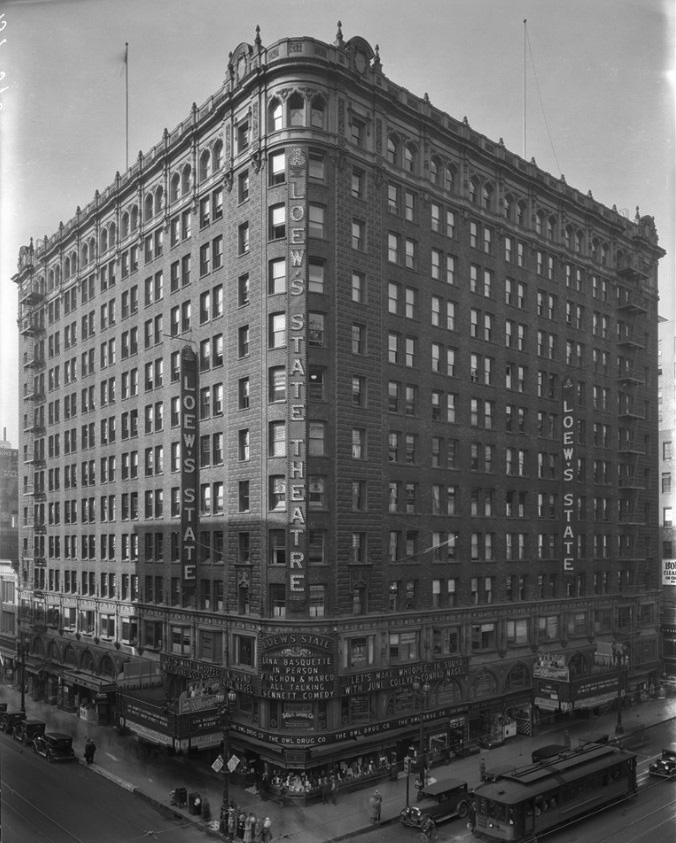 |
|
| (1928)^*# - Loew's State Theatre at 7th and Broadway. Shows theater/office building on corner. Theater marquee reads: "Lina Basquette in person, Fanchon & Marco, All talking Sennett comedy 'Let's Make Whoopee' in sound, June Collyer - Conrad Nagel." Businesses include: Owl Drug Co., Star Shoe Co., Leighton Cafeteria. Street corner shows pedestrians, automobiles, bicyclist, street car. |
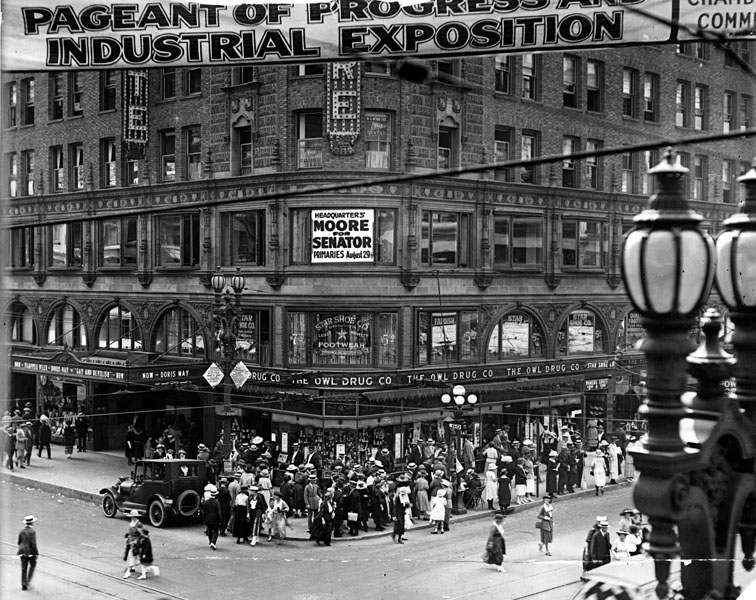 |
|
| (1922)* - Exterior view of Loew's State Theatre building. The streets are crowded with pedestrians crossing and standing along the sidewalks. Marquee reads: Now- Flapper week-Doris May in "Gay and Devilish." Occupants of the building also includes a dentist, Headquarters for Moore for Senator campaign, Star Shoe Co. and the Owl Drug Co. |
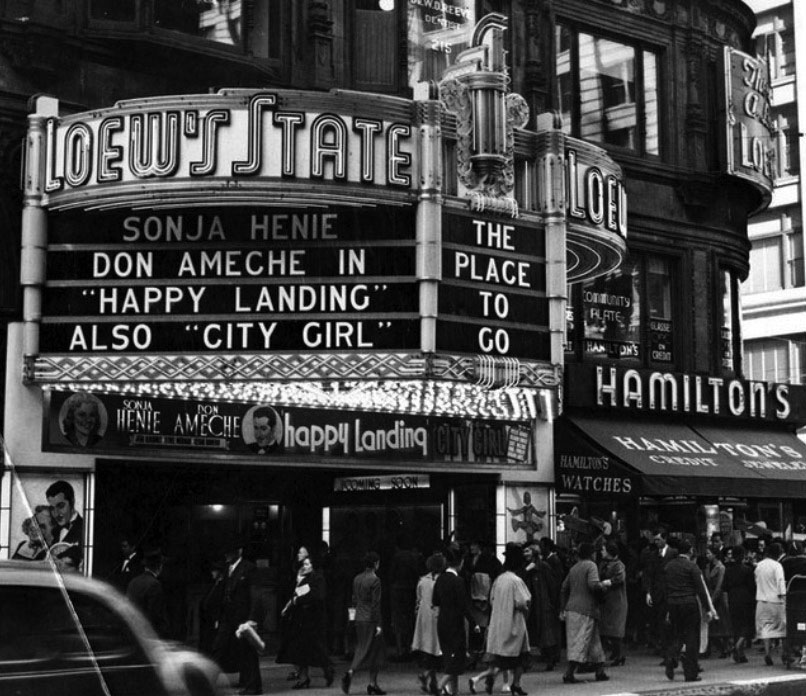 |
|
| (1938)*##^ – View showing the marquee at Loew’s State Theater, Broadway and 7th Street. Now Playing: Sonja Henie and Don Ameche in “Happy Landing”, also “City Girl”. |
Historical Notes The theater is noted for the seated Buddha located in a niche above the proscenium arch. The exterior has an elaborate "silver platter" chased ornamentation above the ground story. In 1998, Metropolitan Theaters stopped showing movies at the State and leased the space to the Universal Church. As of 2008, the State was being operated as a Spanish-language church.^* |
* * * * * |
Rex Arms Apartments
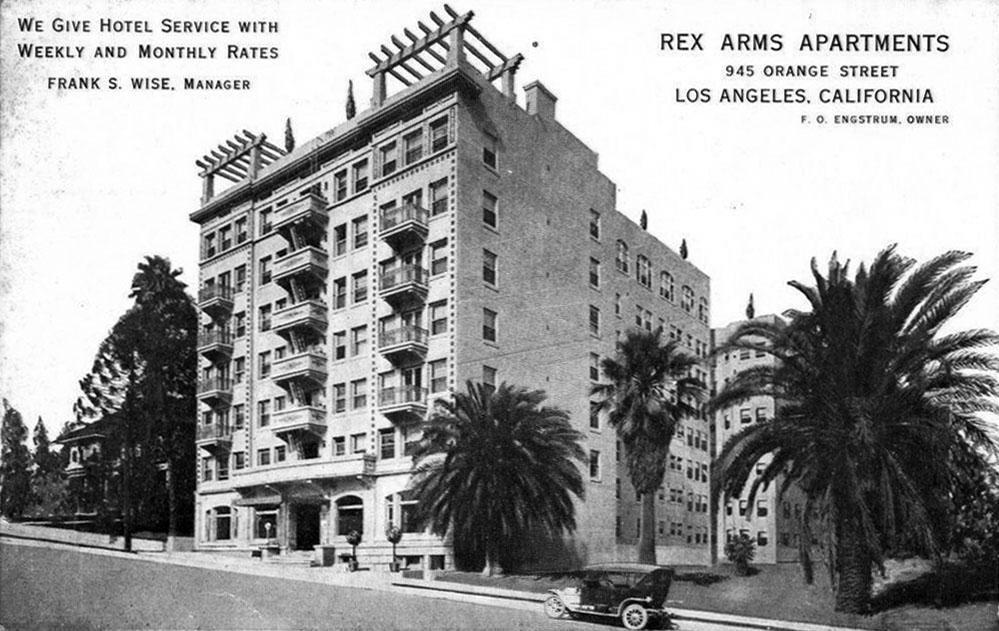 |
|
| (ca. 1920)*^ – Postcard view showing the Rex Arms Apartments located at 945 Orange St (later Wilshire Blvd). Card reads: “We give hotel service with weekly and monthly rates – Frank S. Wise, Manager” also “F. O. Engstrum, Owner” |
Historical Notes The nine-story Rex Arms Apartments opened in 1912 at 945 Orange Street, developed by F. O. Engstrum, whose firm was also behind the magnificent Bryson Apartments near MacArthur Park. At the time, the Rex was one of Los Angeles’ largest and grandest residential buildings, held up by the great ambitions of the city’s elites. After Orange Street was renamed Wilshire Boulevard, a portion of the Rex’s main facade was demolished during the avenue’s widening in the early 1930s.* |
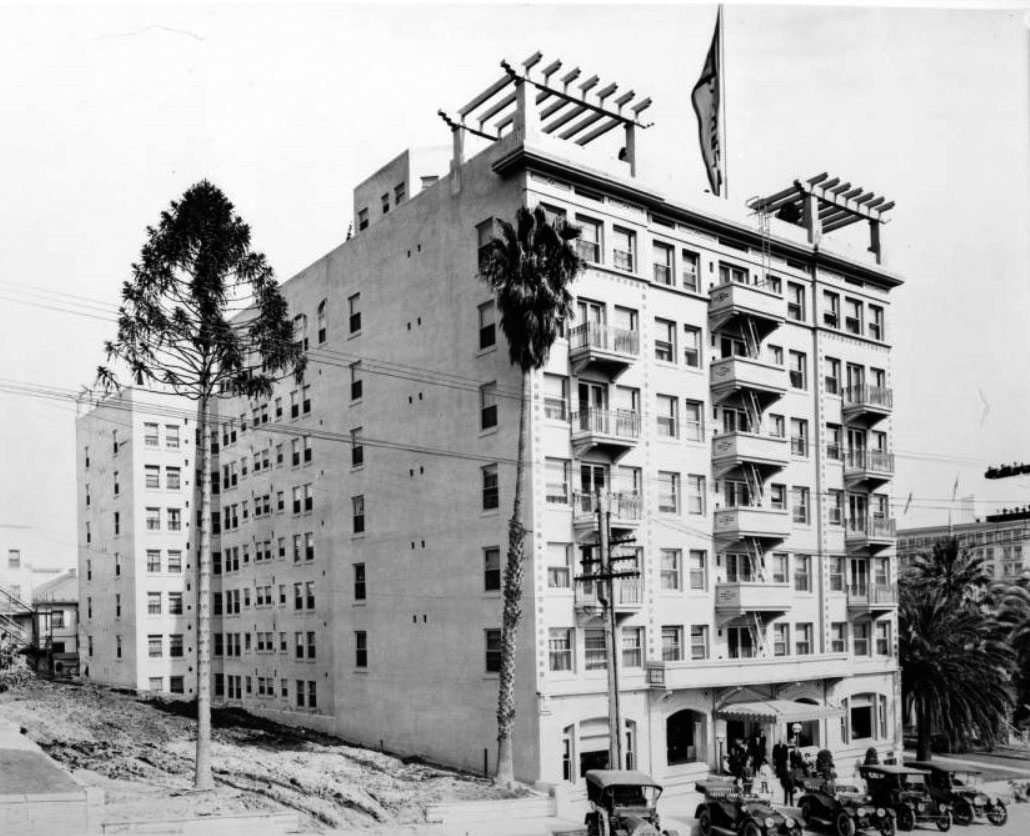 |
|
| (ca. 1920)^ - View showing the 9-story Rex Arms Apartment building located on the north side of Orange St (late Wilshire) just west of Figueroa. |
Historical Notes The Rex disappears from newspaper records in 1976, probably at the time of its destruction. Since 1980, the site has been occupied by a 22-story office tower designed by Skidmore, Owings, and Merrill. Originally named 911 Wilshire, the building’s name and address, for obvious reasons, were changed to 915 Wilshire several years ago. |
|
Van de Kamp's Bakery Shop (1st Windmill Shop)
.jpg) |
|
| (1921)* - View showing Van de Kamp's Bakery Shop on Western and Beverly Boulevard. This is the 1st of the windmill bakery shops which had first been a movie set and was purchased for use as a novel bakery. |
Historical Notes Van de Kamp's Holland Dutch Bakeries was a bakery founded in 1915 and headquartered in the Van de Kamp Bakery Building in Los Angeles. The company's trademark blue windmills featured on their grocery store signs and atop their chain of famous restaurants that were known throughout the region. |
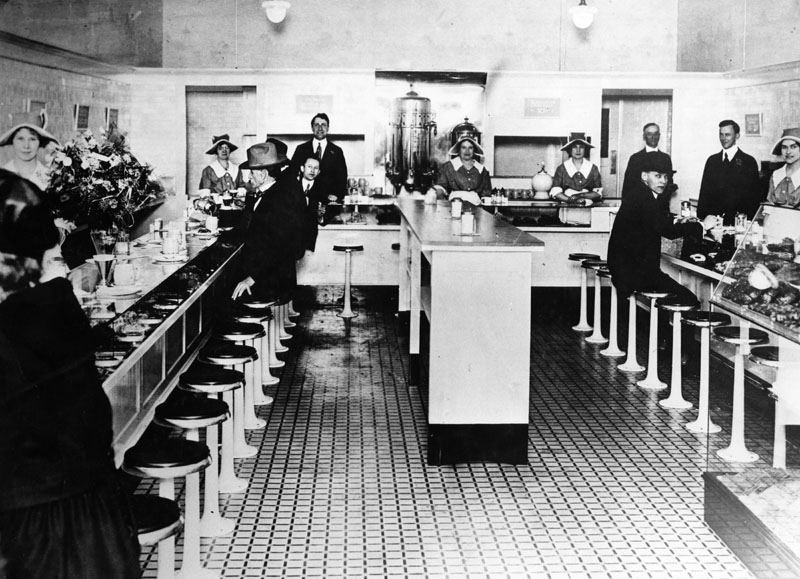 |
|
| (1921)* - Interior of Van De Kamp's first restaurant unit, on Spring Street in Los Angeles, in 1921. A few diners are seated on barstools at the counters, while restaurant staff smile for the camera. |
Historical Notes The bakery was sold by the Van de Kamp family and acquired by General Baking Co. in 1956. The company was sold to private investors in 1979, and closed in bankruptcy in 1990. Former Los Angeles County District Attorney John Van de Kamp is a grandson of the baker's founder. The family also founded Lawry's Restaurants and the Tam O'Shanter Inn. |
Van de Kamp's (Beverly and Westmoreland)
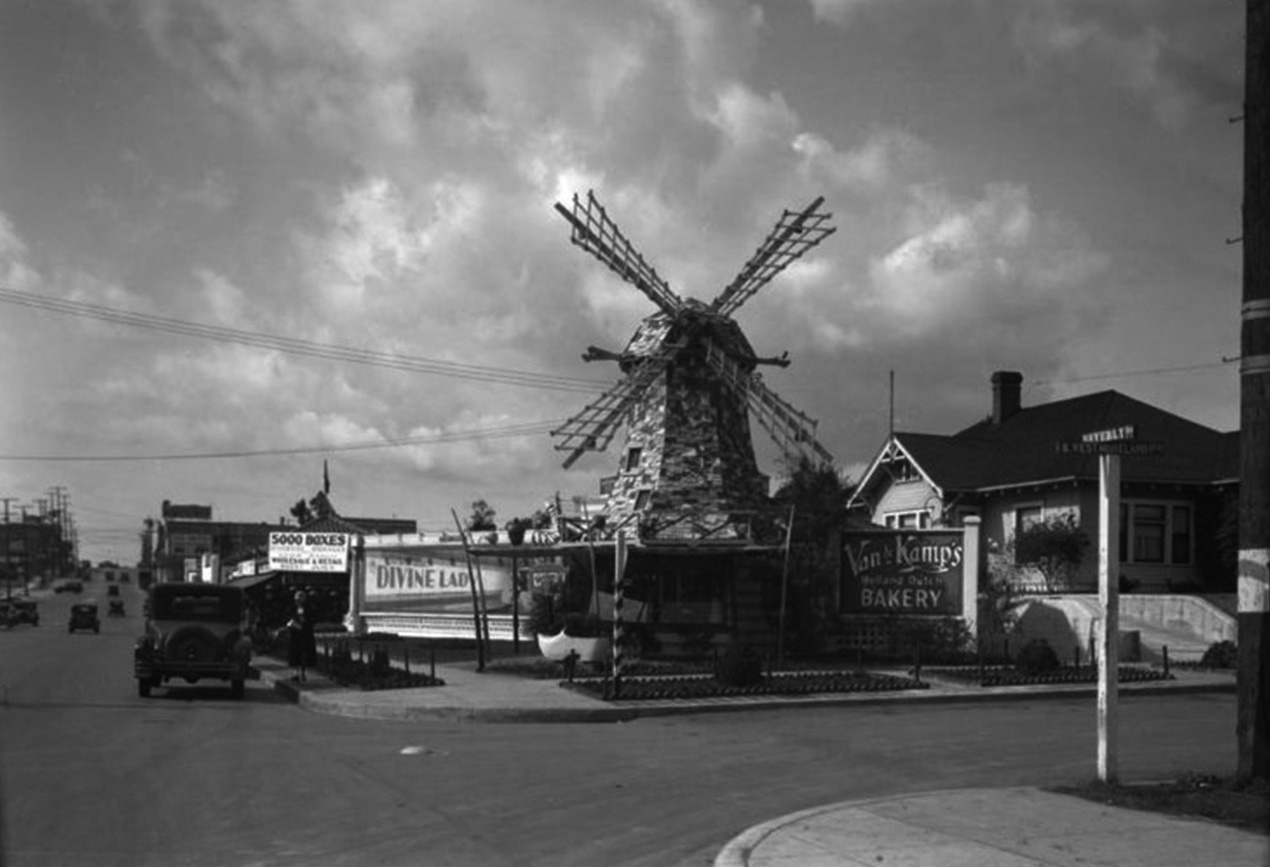 |
|
| (ca. 1930)* - View looking west on Beverly Boulevard at Westmoreland Avenue showing a Van de Kamp’s Dutch Baker on the NW corner. |
Historical Notes One of the most iconic novelty designs was the windmills of Van De Kamp’s Holland Dutch Bakery. The link between this unique architecture and Hollywood is evident—Harry Oliver, an MGM art director, was the creative mind behind the bakery's signature windmill design. |
 |
|
| (1937)* - Close-up view of Van de Kamp's at Beverly Boulevard at Westmoreland Avenue. Sign reads: 'Open Till Midnite' |
Historical Notes Former Los Angeles County District Attorney John Van de Kamp is a grandson of the baker's founder. The family also founded Lawry's Restaurants and the Tam O'Shanter Inn. |
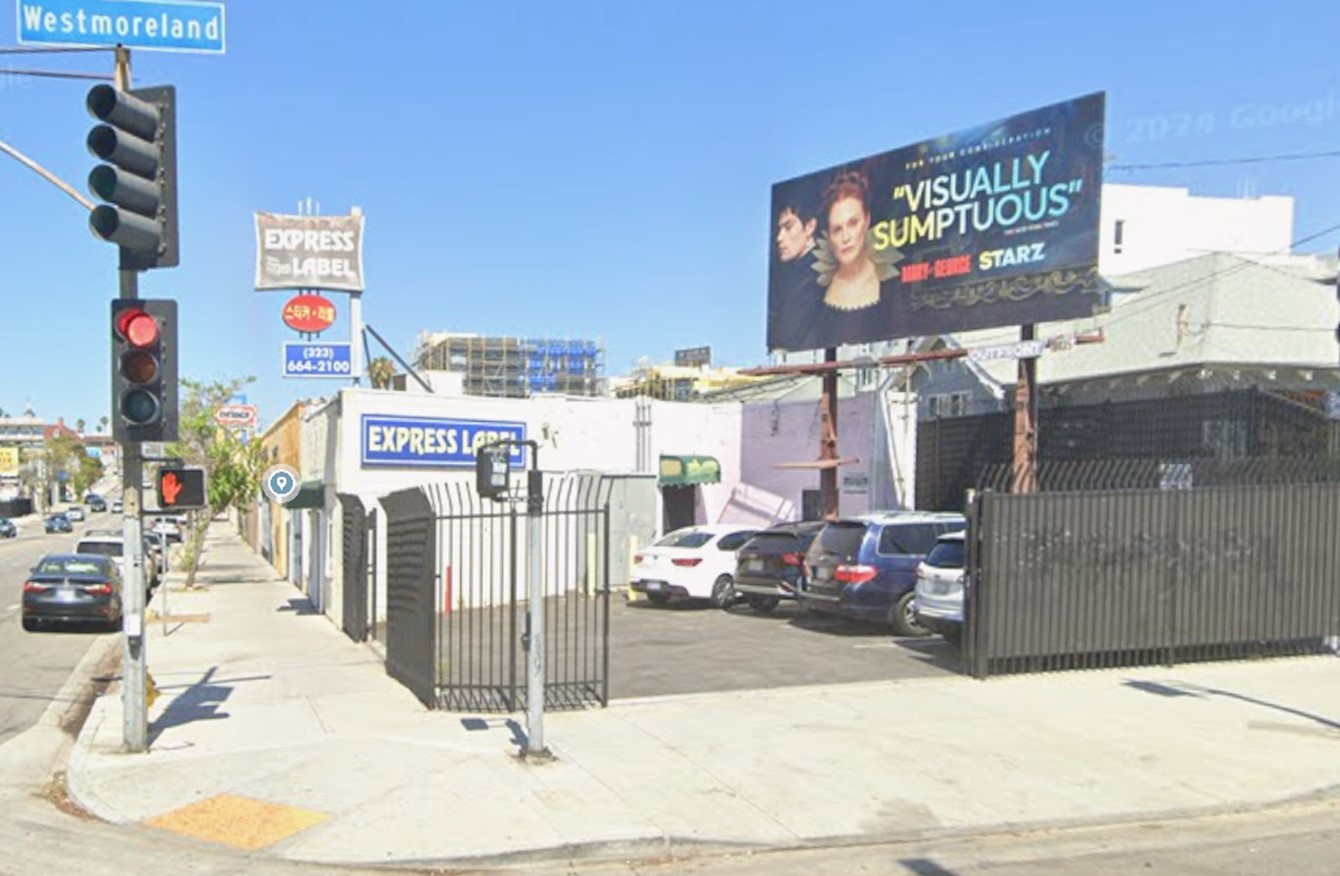 |
|
| (2024)* - Contemporary view of the northwest corner of Beverly Boulevard and Westmoreland Avenue where a Van de Kamp's Bakery once stood, now the site of a small parking lot. |
Then and Now
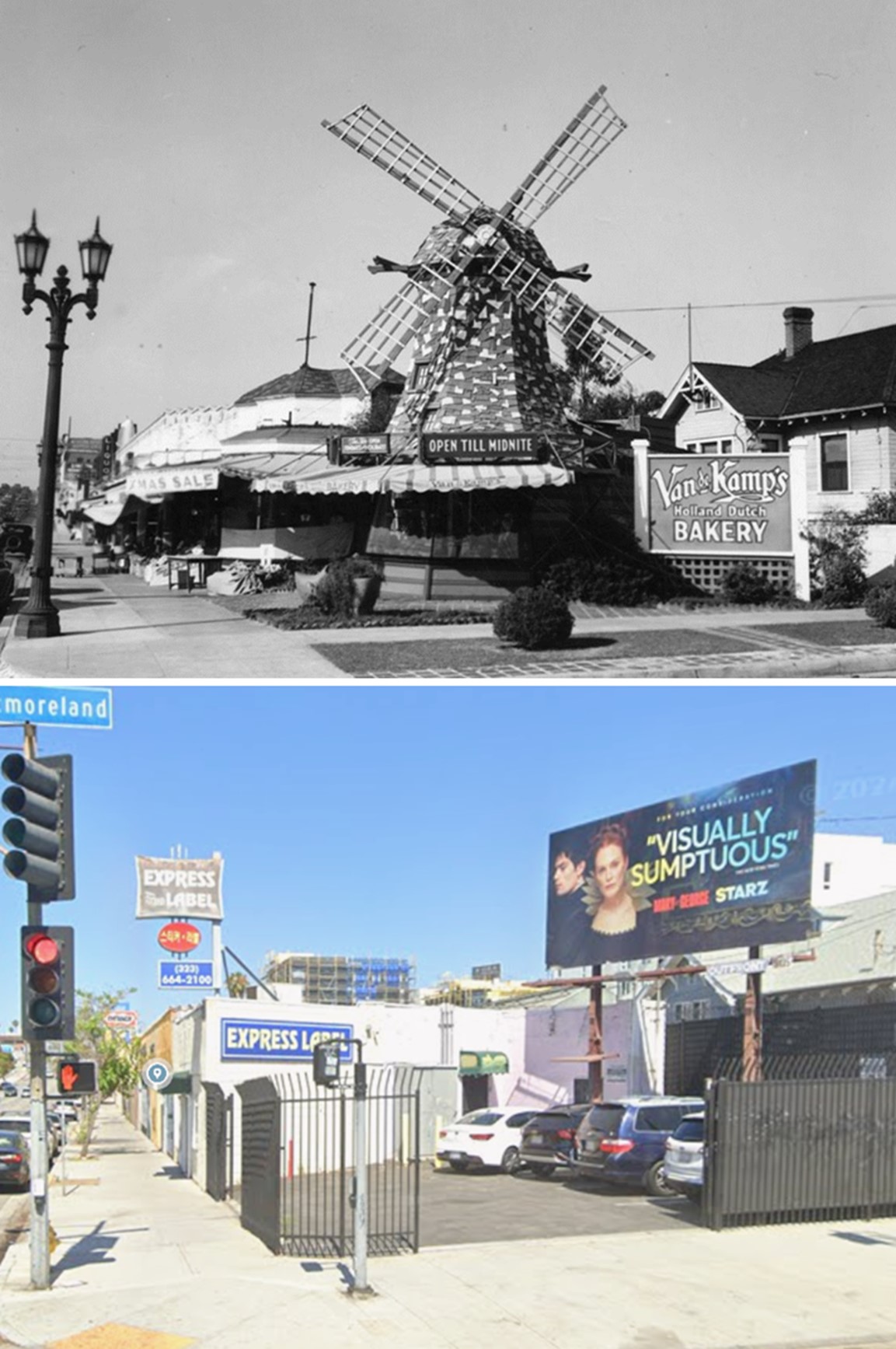 |
|
| (1935 vs 2024)* – A 'visually sumptuous' Van De Kamp’s Bakery once stood at the northwest corner of Beverly Boulevard and Westmoreland Avenue, now replaced by a small parking lot. |
Then and Now
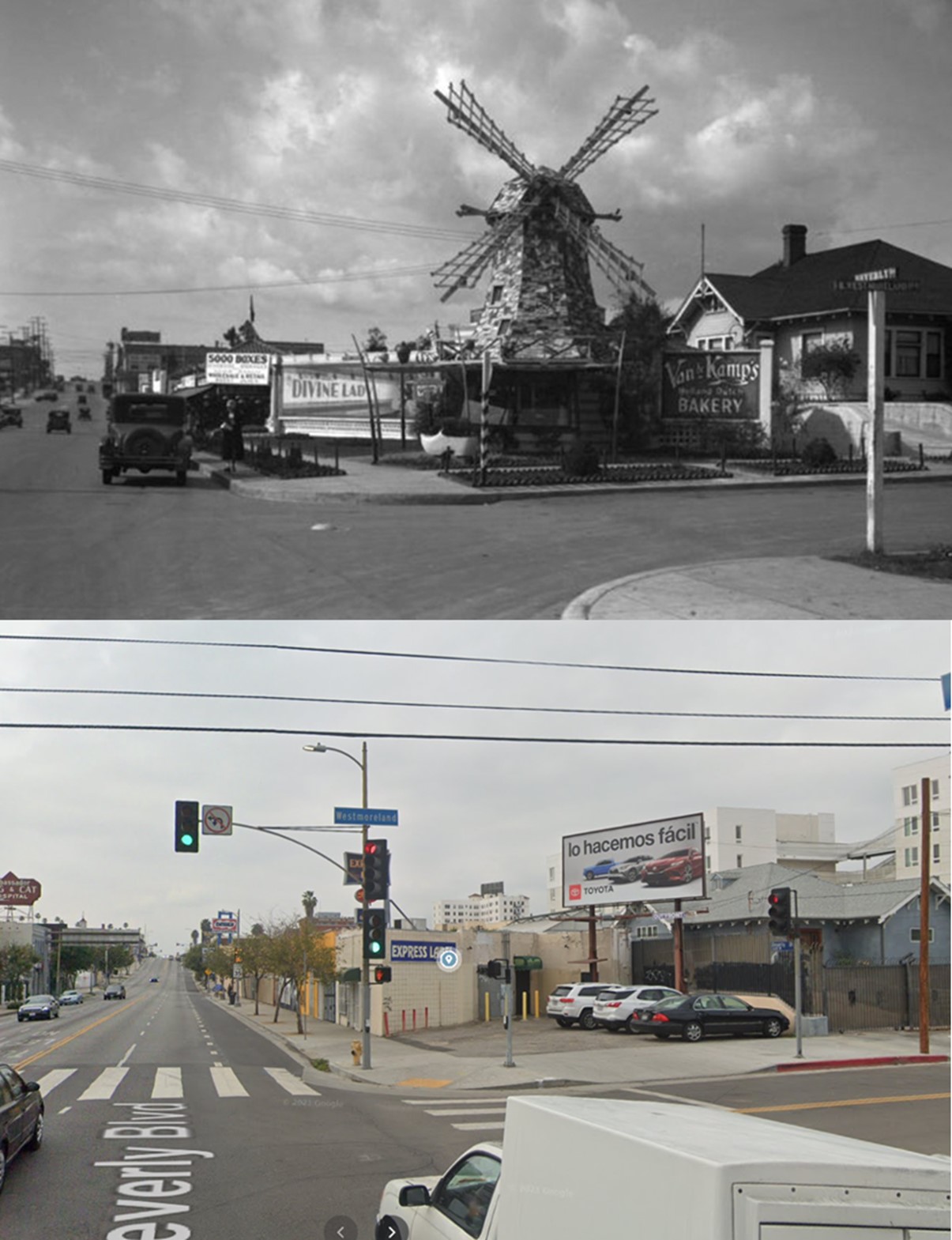 |
|
| (1930 vs. 2021)* |
* * * * * |
Tam O'Shanter Inn (originally Montgomery's Country Inn then Montogomery's Chanticleer Inn)
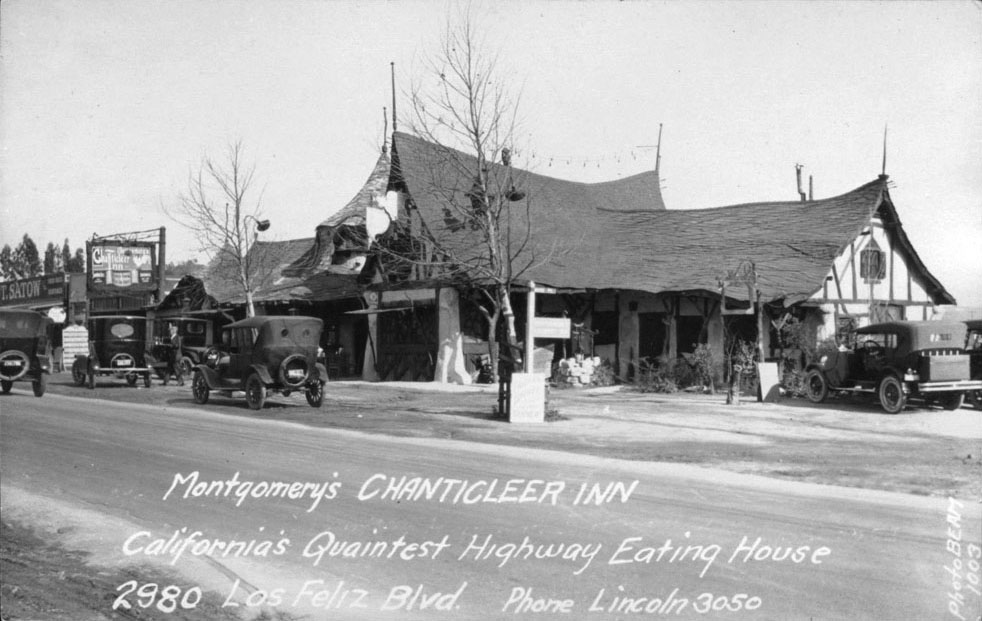 |
|
| (ca. 1924)* - View of the Montgomery's Chanticleer Inn (later Tam O'Shanter Inn) located at 2980 Los Feliz Blvd. |
Historical Notes Montgomery’s Country Inn was built in 1922 by Joe Montgomery partnering with Lawrence Frank and Walter Van de Kamp, founders of Van de Kamp's Holland Dutch Bakeries who also went on to found the Lawry's restaurant chain. They commissioned Harry Oliver to design the building. He constructed the Storybook Style building aided by movie studio carpenters. By 1924, it was known as Montgomery’s Chanticleer Inn, with its quaint tower and small store that sold pretzels, potato chips and the odd mixture of Navajo, Chinese and Italian curios. |
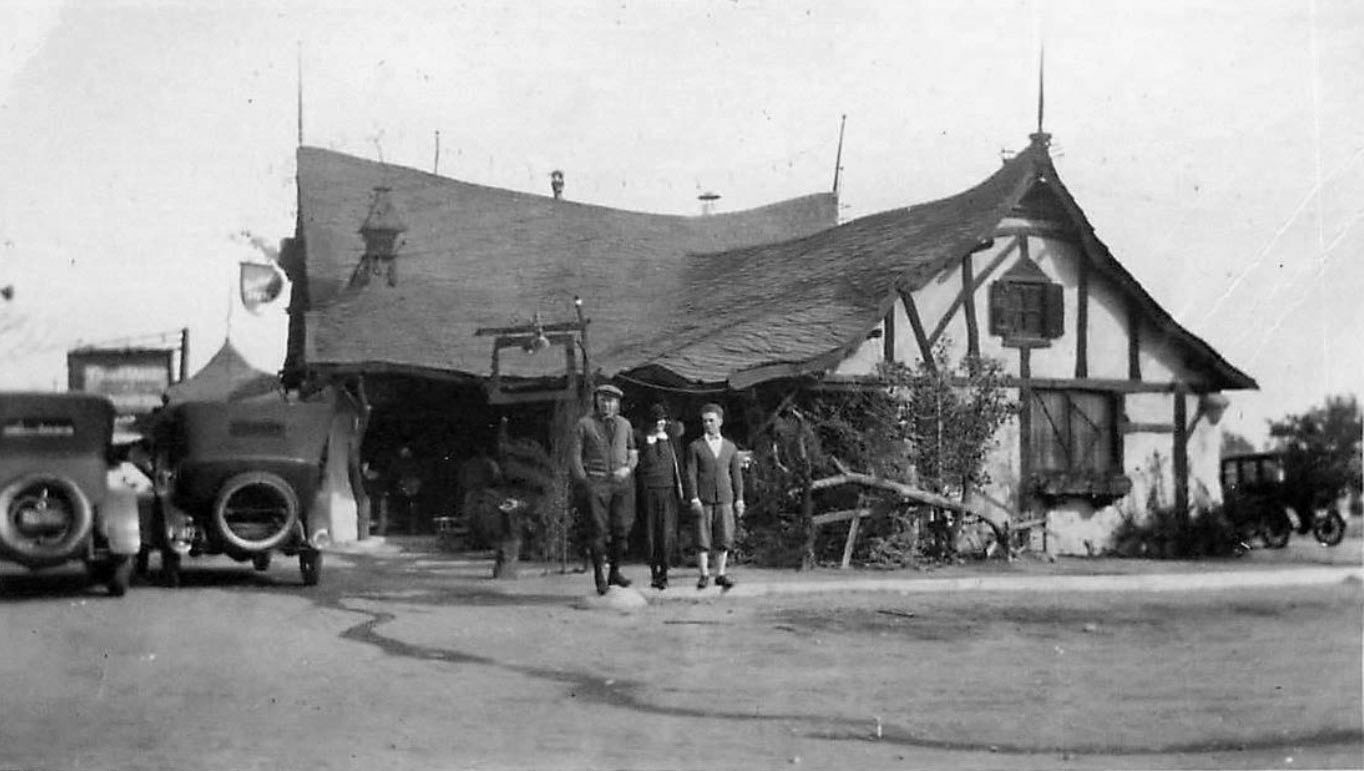 |
|
| (ca. 1924)* - View showing the Tam O'Shanter Inn, previously Montgomery's Chanticleer Inn. |
Historical Notes When Montgomery's Chanticleer Inn failed to thrive, a fellow Rotarian of one of the partners suggested that the restaurant would attract more customers if it adapted a Scottish theme and the name Tam O’Shanter. |
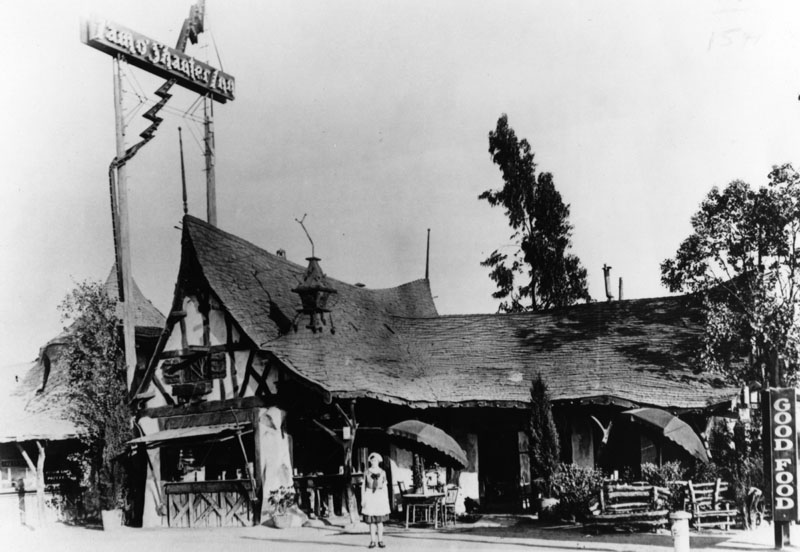 |
|
| (1920s)* - A waitress stands in front of the thatched roof Tam O'Shanter Inn. A sign at extreme right reads "Good Food." At left, a counter area is visible, and in the middle, a door leading to indoor dining. Two umbrellas and tables have been placed outside for outdoor dining. |
Historical Notes The exterior of the Tam O’Shanter has been remodeled many times since, but the initial design seen in the above picture shows the fairy-tale influence; tree trunk and branch columns, topsy-turvy roof lines, knotted wood, wrought iron flourishes and homely chimneys. Owner Lawrence L. Frank, once explained that “every piece of wood which was used in [building the tam] was thrown into fire first with the result that we never had to paint it and it got more beautiful as the years went by.” |
 |
|
| (1930s)* - View of a man sitting at the outdoor counter of the Tam O'Shanter Inn. |
Historical Notes This was Walt Disney’s favorite restaurant. He dined here nearly every week during the 1930s, 40s and 50s. |
.jpg) |
|
| (1930)* – View looking toward the southeast corner of Los Feliz Boulevard and Boyce Avenue showing the Tam O’ Shanter, advertising Malted Milk for 15 cents. Full car service can be seen at center-left, next to the umbrella. |
Historical Notes The Tam O’ Shanter soon became one of the nation’s first drive-ins with special wooden trays that enabled guests to dine in their cars. They called it 'Car Service de luxe'. |
 |
|
| (1930s)* – View showing four people enjoying a tray-served meal inside their car at Tam O’ Shanter. |
Historical Notes From a 1933 advertisement of the newly remodelled Tam o’ Shanter and its drive-in service: “We are happy to welcome you to our remodeled Tam o’ Shanter Inn. Important among the changes made, is the re-establishment of Car Service de luxe – a feature which we originated eight years ago. Ingenious tables installed in your car, enable you to sit and eat in the comfort and privace of your own automobile…” Click HERE to see more Early LA Drive-in Restaurants. |
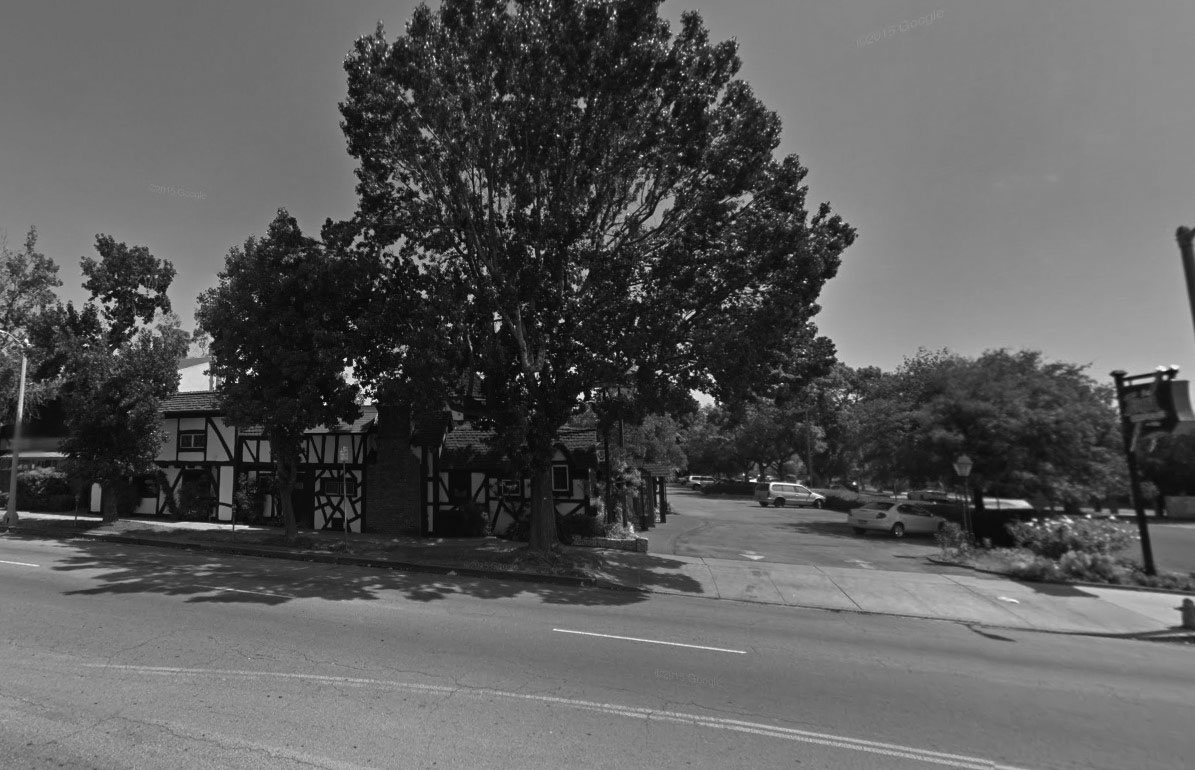 |
|
| (2015)* - Google Street View showing the Tam O'Shanter Restaurant located at 2980 Los Feliz Boulevard. |
Historical Notes The restaurant was remodeled in 1968 and renamed the "Great Scot", but has since been brought back to the its original name "The Tam O'Shanter Inn". The restaurant's decor still features English and Scottish medieval weapons, kilts, and family Coat of Arms and Medieval Family Crests. Opened in June 1922 by the founders of Van de Kamp's Dutch Bakeries and is still around today, making it Los Angeles’ oldest restaurant that has remained in the same location under the same ownership and management. |
* * * * * |
Hal E. Roach Studios
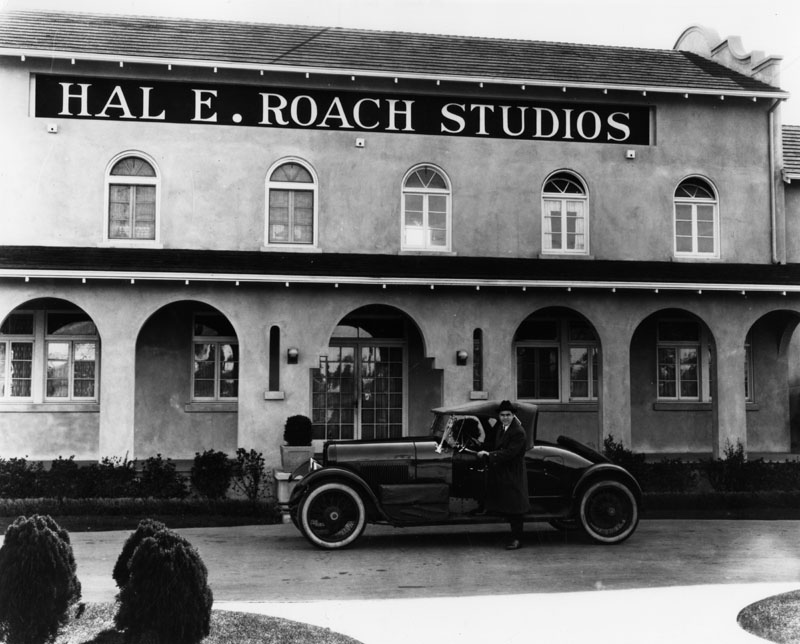 |
|
| (1921)* - Hal Roach (1892-1992) steps out of his car, which is parked outside his Hal E. Roach Studios, located at 8822 Washington Boulevard in Culver City. |
Historical Notes Harold Eugene "Hal" Roach, Sr. was an American film and television producer, director, and actor from the 1910s to the 1990s, best known today for producing the Laurel and Hardy and Our Gang (later known as The Little Rascals) film comedy series. After an adventurous youth that took him to Alaska, Hal Roach arrived in Hollywood in 1912 and began working as an extra in silent films. Upon coming into an inheritance, he began producing short film comedies in 1915 with his friend Harold Lloyd, who portrayed a character known as Lonesome Luke. |
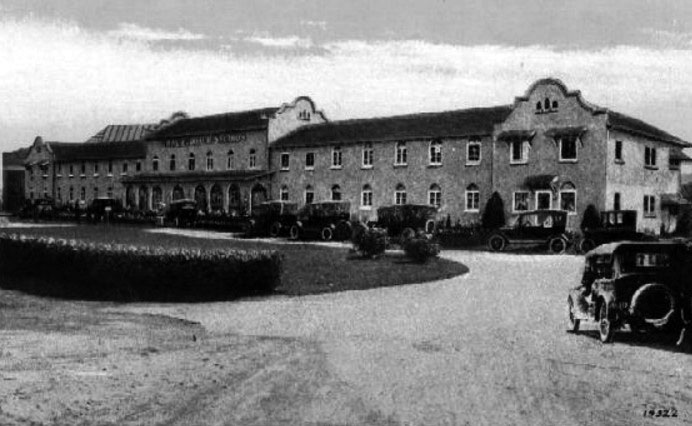 |
|
| (1920s)^* – Postcard view showing a line of cars parked in front of the Hal Roach Studios office buildings. |
Historical Notes Unable to expand his studios in downtown Los Angeles because of zoning, Roach purchased what became the Hal Roach Studios from Harry Culver in Culver City. During the 1920s and 1930s, he employed Lloyd (his top money-maker until his departure in 1923), Will Rogers, Max Davidson, the Our Gang kids, Charley Chase, Harry Langdon, Thelma Todd, ZaSu Pitts, Lupe Vélez, Patsy Kelly and, most famously, Laurel and Hardy. During the 1920s Roach's biggest rival was producer Mack Sennett. In 1925, Roach hired away Sennett's supervising director, F. Richard Jones.^* |
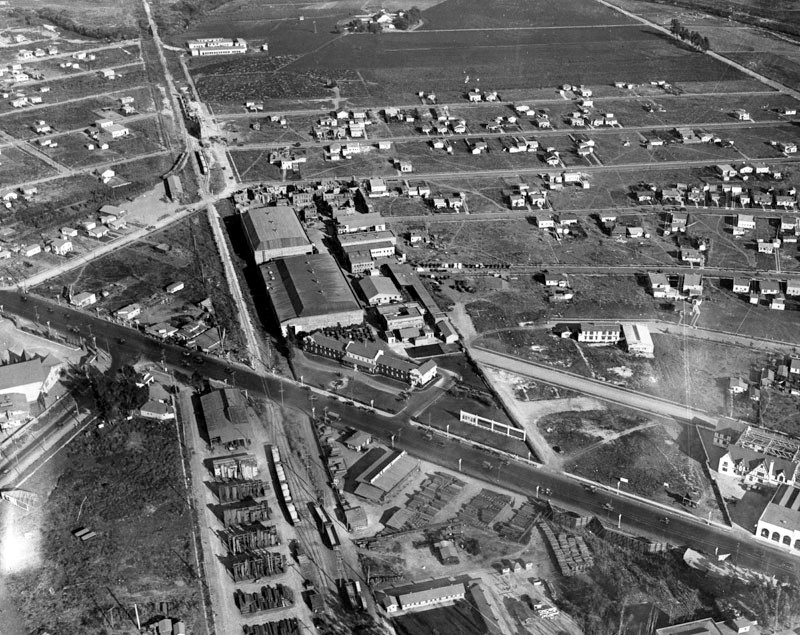 |
|
| (1926)* - Aerial view of the area surrounding Hal Roach Studios, located in the upper left--the second-to-the-largest building with a flat roof, behind which are the outdoor sets, 8822 Washington Blvd. at the corner of Washington and National in Culver City. Most of the Laurel & Hardy movies, the Our Gang shorts, and many Harold Lloyd comedies were made at the studio, |
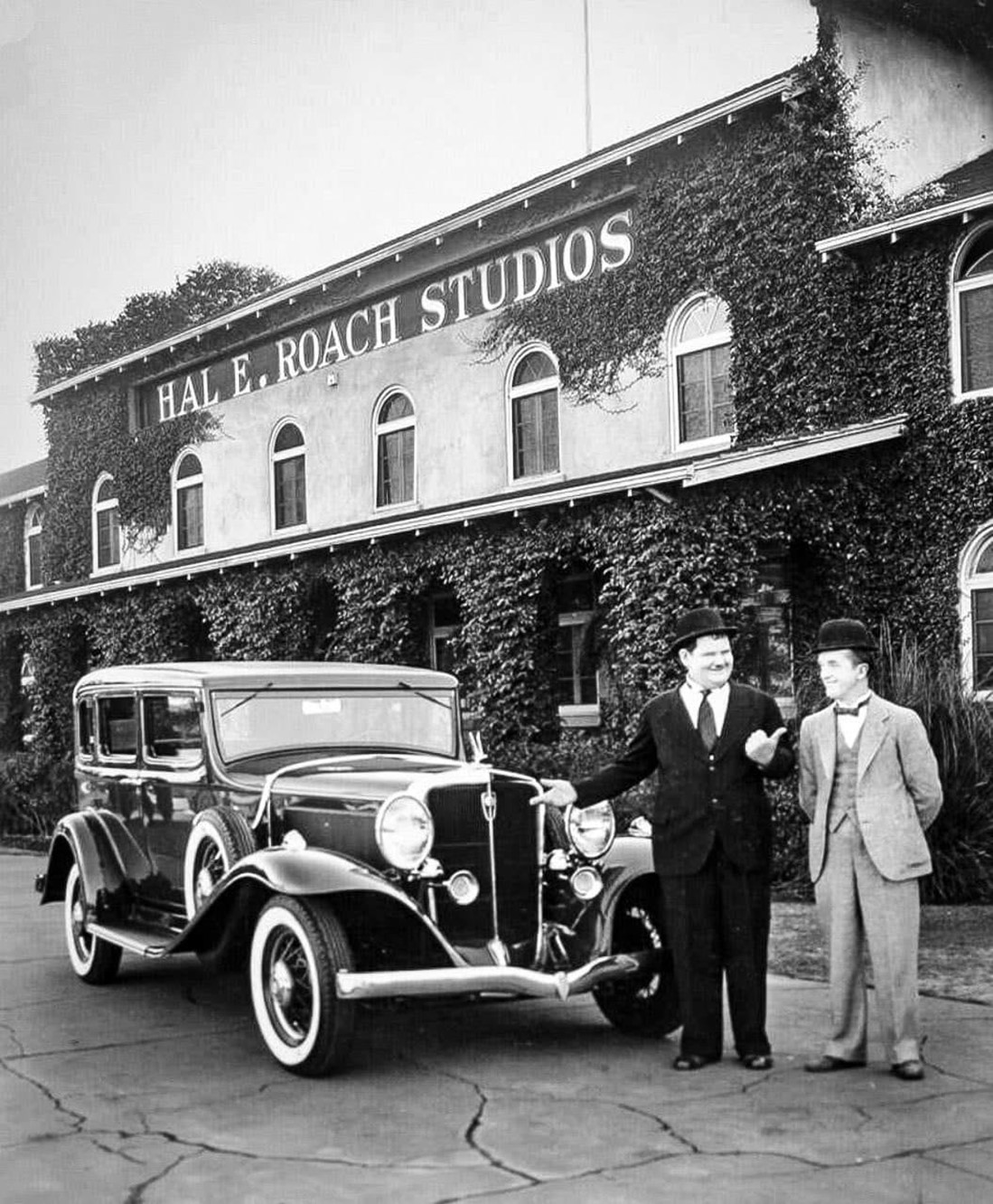 |
|
| (1931)* - Oliver Hardy and Stan Laurel stand next to a Studebaker in front of Hal E. Roach Studios. |
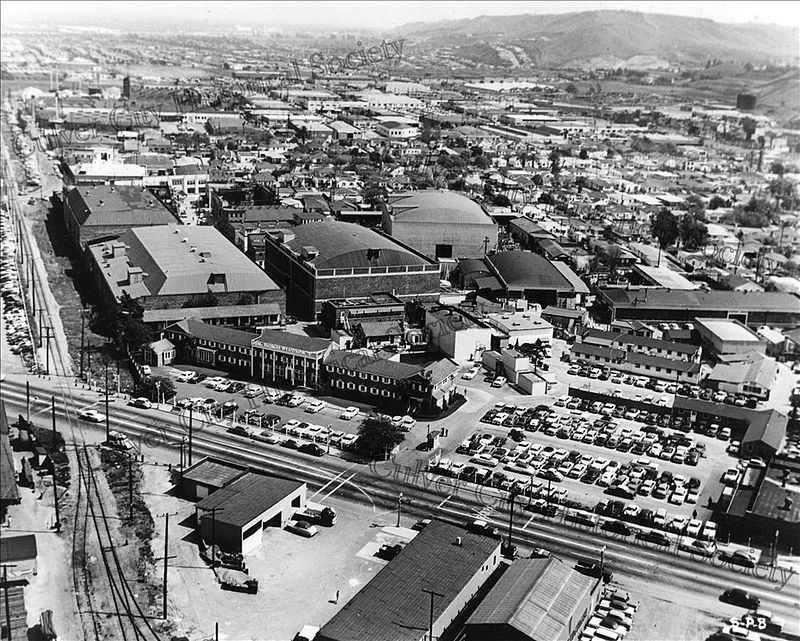 |
|
| (1950s)* - Aerial view of the the Hal Roach Studios and surrounding area. |
Historical Notes The 14.5 acre studio once known as "The Lot of Fun", containing 55 buildings, was torn down in 1963. They were replaced by light industrial buildings, businesses, and an automobile dealership. Today, Culver City's "Landmark Street" runs down what was the middle of the old studio lot, with the two original sound stages having been located on the north side of Landmark Street, and the backlot/city street sets had been located at the eastern end of Landmark Street. A plaque sits in a small park across from the studio's location, placed there by The Sons of the Desert, an international fraternal organization devoted to the lives and films of comedians Stan Laurel and Oliver Hardy.^* |
* * * * * |
San Pedro PE Depot
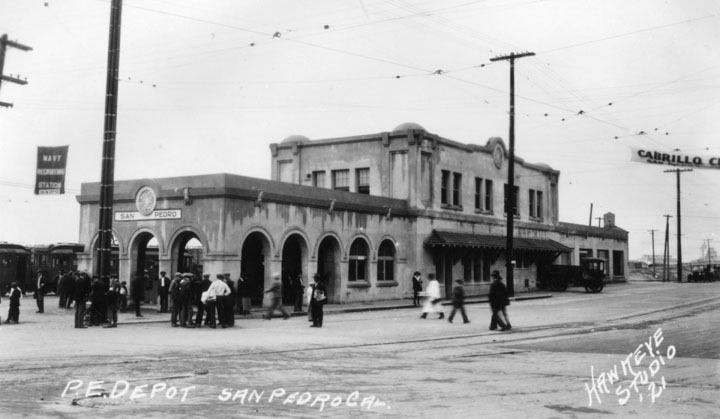 |
|
| (1921)* - Exterior view of the Pacific Electric Railway station in San Pedro. |
Historical Notes PE's two-story San Pedro depot was opened in 1920, and succumbed to the wrecking ball in 1961. The new 6th Station on the Port of Los Angeles Waterfront Red Car Line is located just east of the former PE station site, adjacent to the entrance of the Maritime Museum.*^^* |
Click HERE to see more in Early Views of San Pedro and Wilmington |
* * * * * |
Eagle Rock City Hall
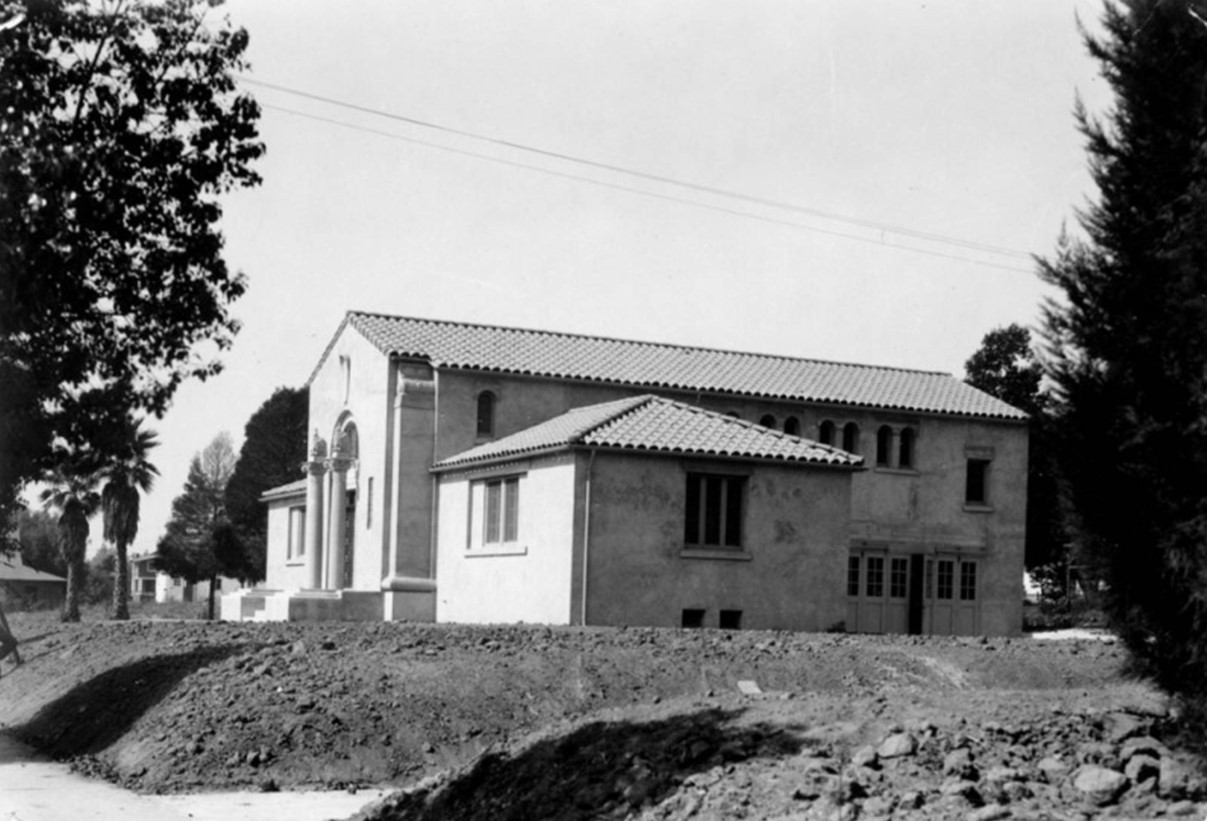 |
|
| (1922)* - Eagle Rock City Hall, probably at time of completion in 1922 because the grounds are not yet landscaped. |
Historical Notes The arrival of Owens Valley water via the Los Angeles Aqueduct and the concurrent depletion of the young city's wells ultimately led the city fathers to agree to annexation by Los Angeles in 1923. Eagle Rock is one of the few cities incorporated by Los Angeles to still have its original pre-annexation City Hall (2035 Colorado Blvd.) and Library (2225 Colorado Blvd.) still standing. Click HERE to see Contemporary View. |
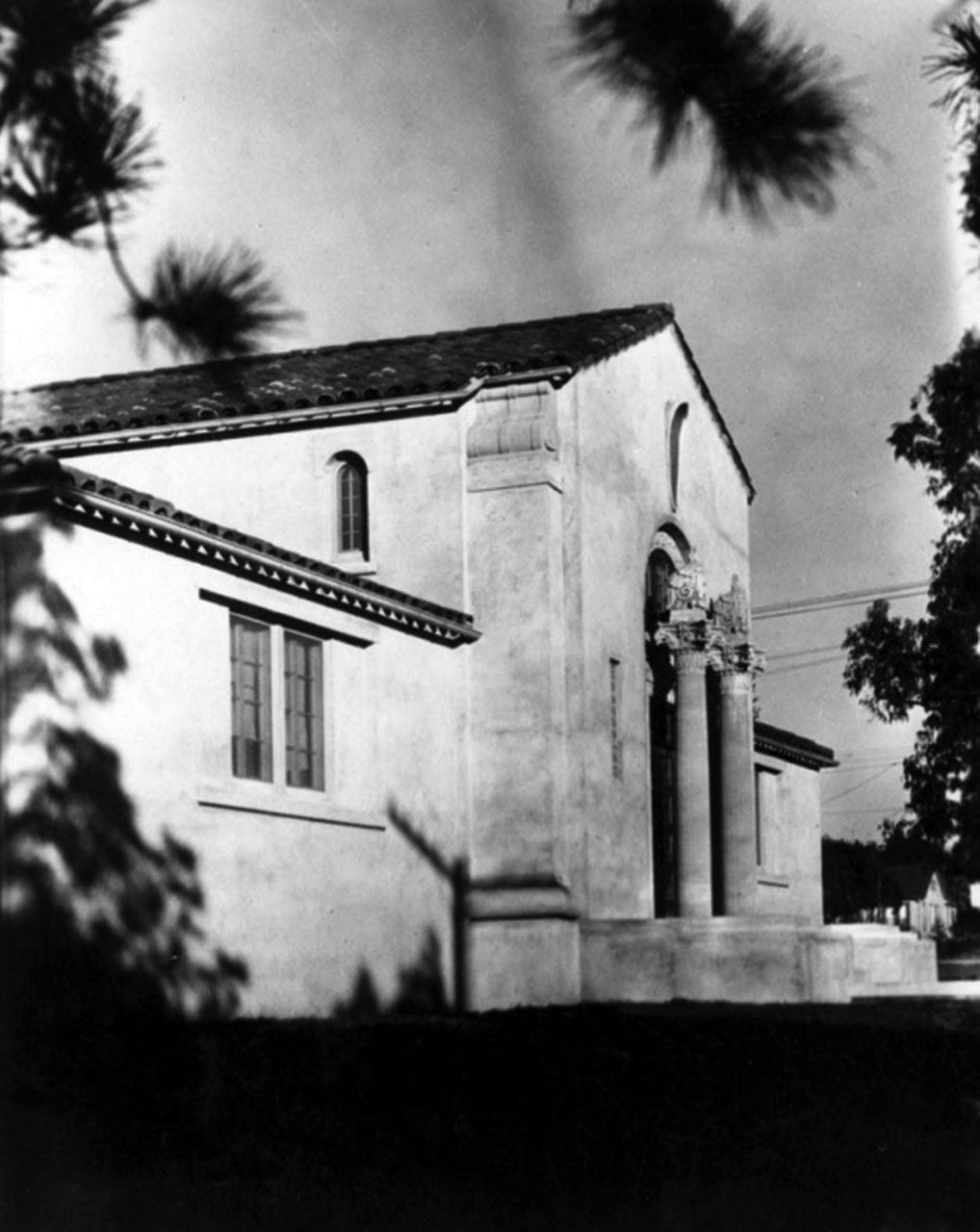 |
|
| (1923)* – Eagle Rock City Hall, showing detail of facade and front entrance. It was built in 1922 and was designed by architect William Lee Woollett. |
Historical Notes Click HERE to see Early Views of Eagle Rock |
* * * * * |
Angelus Temple
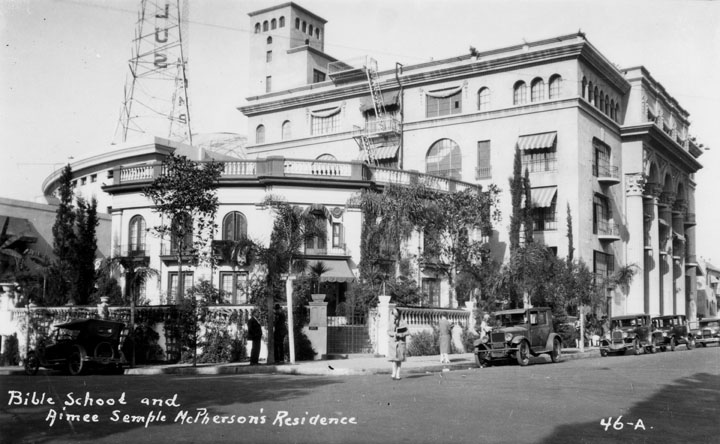 |
|
| (ca. 1922)* - Exterior view of the bible school and residence of Aimee Semple McPherson, founder of the Foursquare Church, located at Park Avenue and Lemoyne in Echo Park, adjacent to the Angelus Temple. |
Historical Notes Aimee Semple McPherson was a Canadian-American Los Angeles–based evangelist and media celebrity in the 1920s and 1930s. She founded the Foursquare Church which worshipped at the Angelus Temple adjacent to the bible school seen above. |
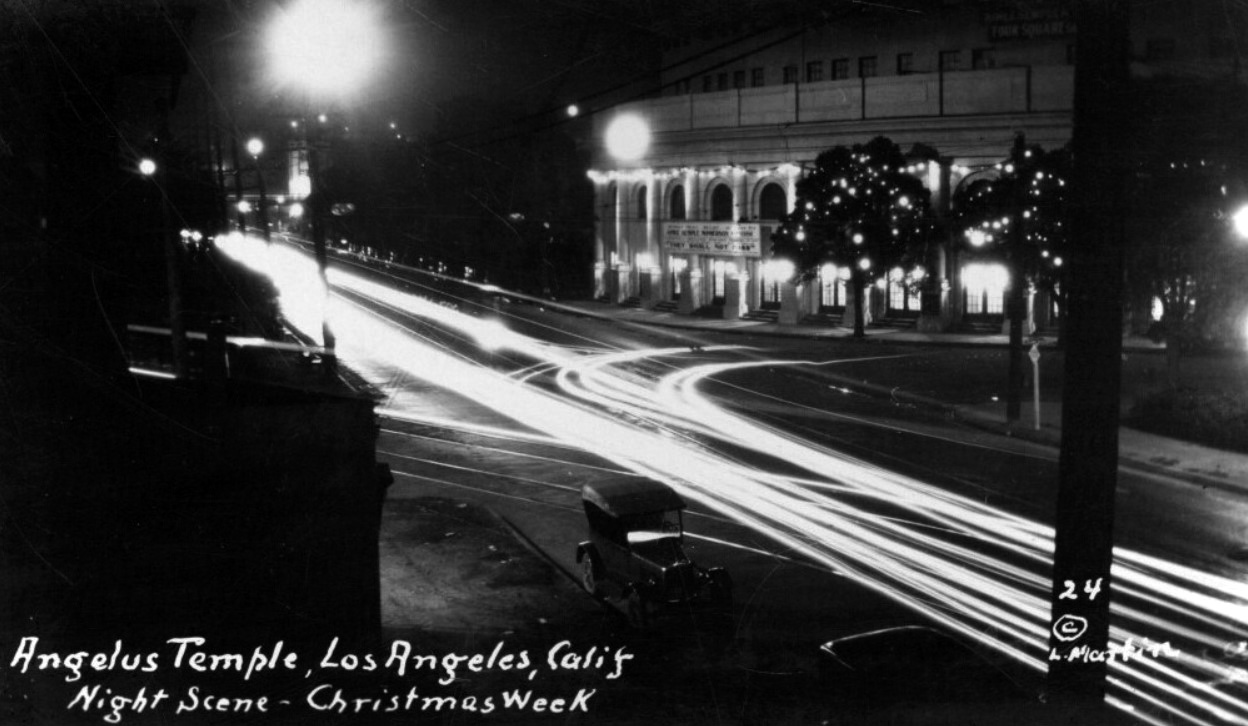 |
|
| (1920s)**# – Night time view of Angelus Temple located at 1100 Glendale Boulevard in Echo Park. |
Historical Notes Angelus Temple was the central house of worship of the International Church of the Foursquare Gospel. It was constructed in 1922 and dedicated on January 1, 1923. Located opposite Echo Park Lake, the temple had an original seating capacity of 5,300, huge for a church then and now, but suited well for the crowds McPherson attracted as an evangelical sensation of the 1920s and 1930s. |
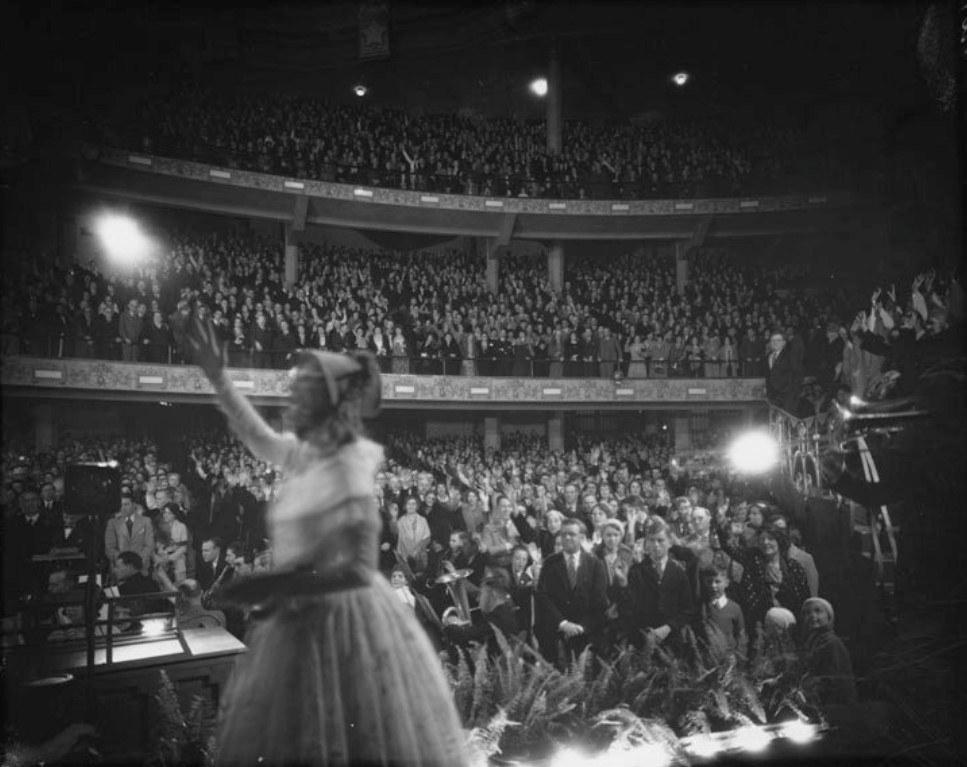 |
|
| (1930)^*^# - Evangelist Aimee Semple McPherson leading a song during Foursquare Gospel church service at the Angelus Temple. |
Historical Notes In her time she was the most publicized Christian evangelist, surpassing Billy Sunday and her other predecessors. She conducted public faith-healing demonstrations before large crowds, allegedly healing tens of thousands of people. McPherson's articulation of the United States as a nation founded and sustained by divine inspiration continues to be echoed by many pastors in churches today. News coverage sensationalized misfortunes with family and church members; particularly inflaming accusations she had fabricated her reported kidnapping, turning it into a national spectacle. McPherson's preaching style, extensive charity work and ecumenical contributions were a major influence in revitalization of American Evangelical Christianity in the 20th century. |
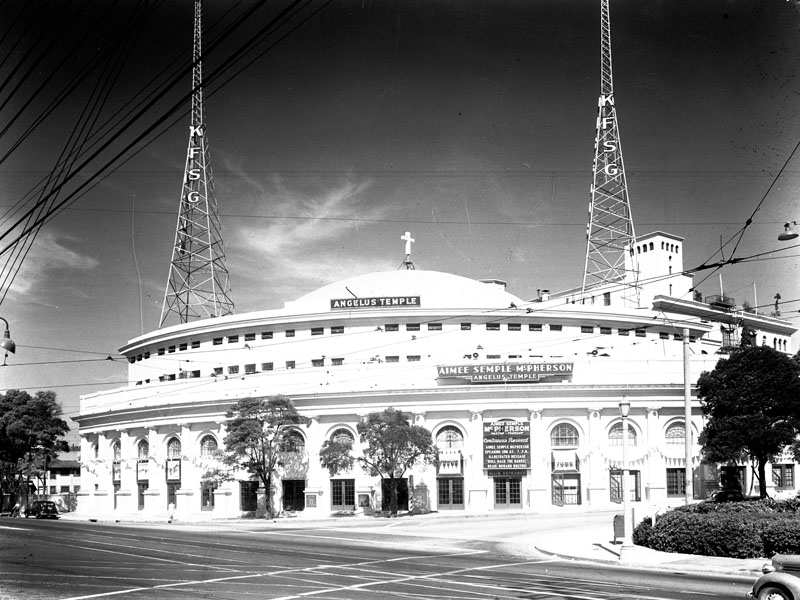 |
|
| (ca. 1934)* - Exterior view of Angelus Temple located at Glendale Boulevard and Park Avenue in Echo Park. The marquee reads: "Continuous Revival." The radio towers for the church's radio station, KFSG, are visible on the roof. |
Historical Notes McPherson has been noted as a pioneer in the use of modern media, especially radio, and was the second woman to be granted a broadcast license. She used radio to draw on the growing appeal of popular entertainment in North America and incorporated other forms into her weekly sermons at Angelus Temple.^* |
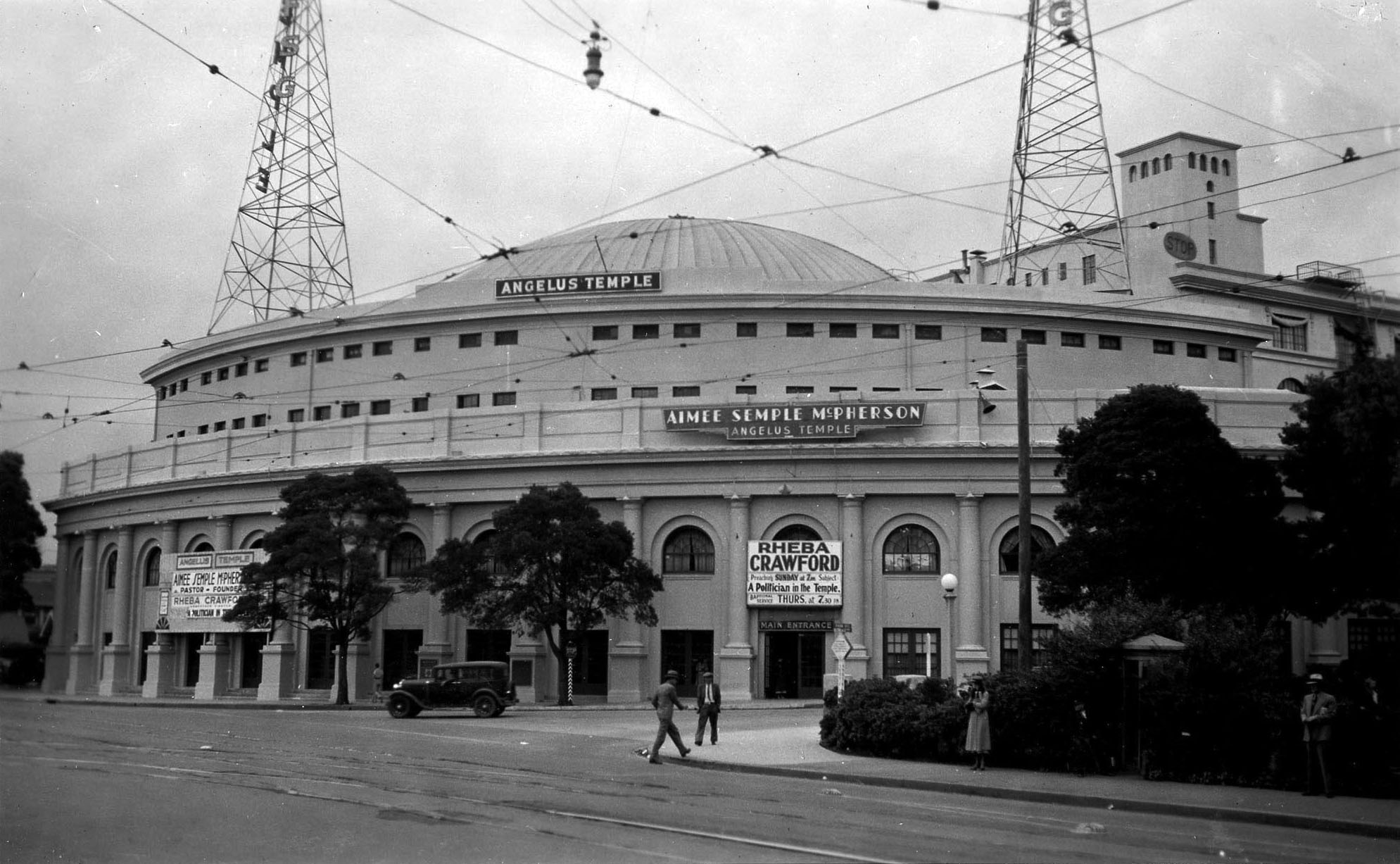 |
|
| (1935)^*# - View showing the Angelus Temple located on the northeast corner of Glendale Boulevard and Park Avenue. Echo Park is seen on the right. Sign over the doorway reads ‘Rheba Crawford’. |
Historical Notes Rheba Crawford Splivalo, known as the "Angel of Broadway," was appointed associate pastor of Angelus Temple in 1935. In 1937, she was involved in a long and contentious slander suit as the result of her ouster from the temple. McPherson had circulated rumors that Crawford was not as “pure as the wind-driven snow” as she portrayed and had characterized her as something of a slut, which her enemies grabbed on to and used. This didn’t prevent Reba Crawford from taking to the airwaves with a weekly commentary on the political goings-on around L.A. City Hall and Sacramento as well as filing a $1 million suit for slander, which was later settled.^ |
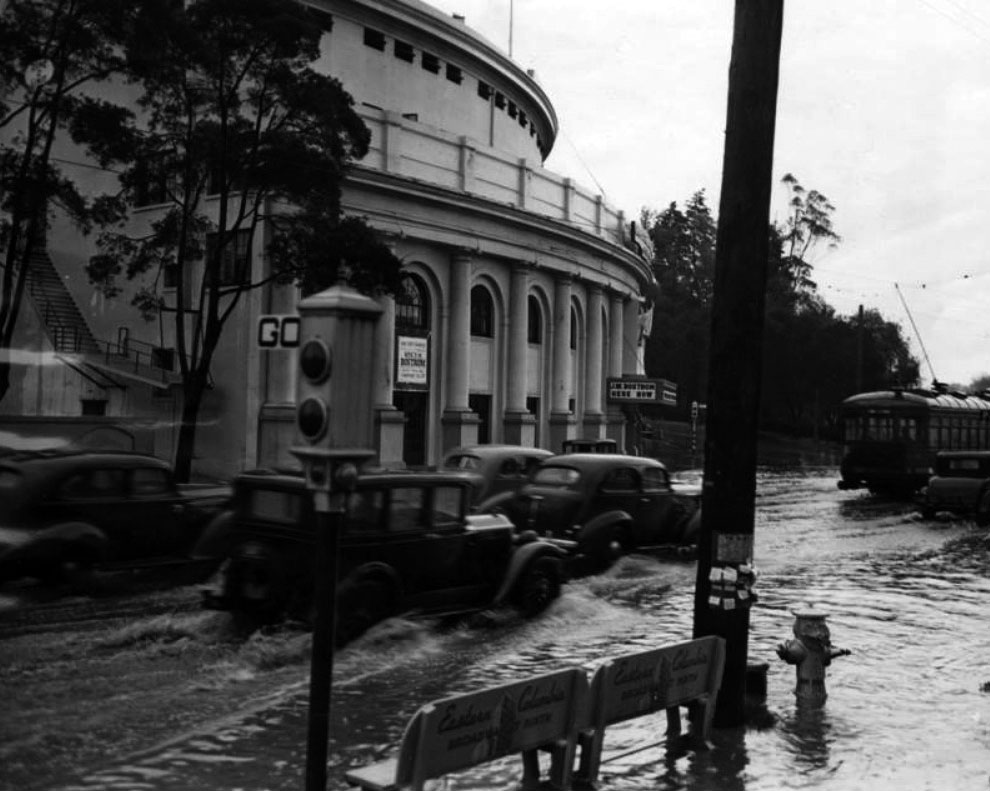 |
|
| (1940)*- Cars are shown sloshing through the flooded street in front of Angelus Temple in Echo Park on February 1, 1940. Streets in a number of parts of the city were flooded. Note the old-style traffic signal with semaphore arms. |
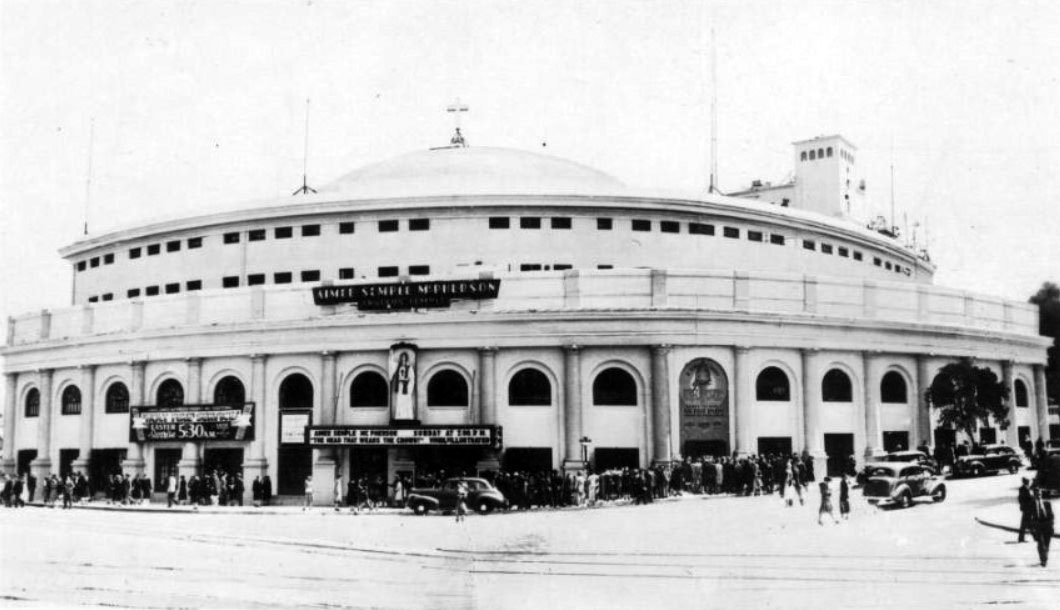 |
|
| (1940s)#^^ – Postcard view of the Angelus Temple just as services are being let out. |
Historical Notes The Angelus Temple was the largest construction of its time in North America, rising "125 feet from the main floor". A panorama of clouds, which was the work of artist Anne Henneke, adorns the ceiling, and the temple has eight stained glass windows depicting the life of Jesus Christ, created by artist George Haskins.^* |
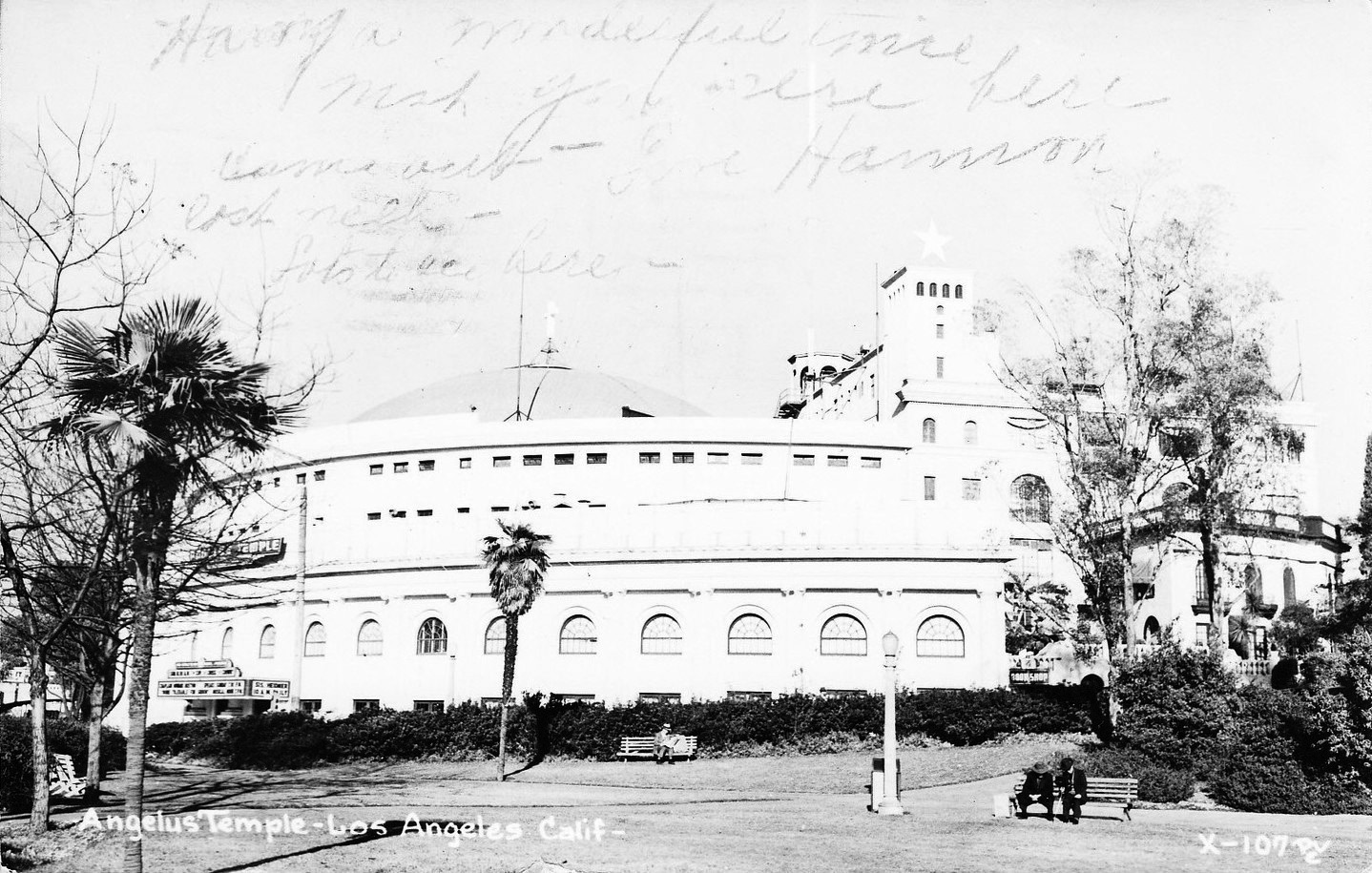 |
|
| (n.d.)**# – Postcard view showing men sitting on benches at Echo Park. Across the street (Park Avenue) stands Angelus Temple, left, and bible school and residence of Aimee Semple McPherson on the right. |
Historical Notes Angelus Temple underwent renovations in 1972, while still retaining its original interior and exterior appearance. The lighted cross atop the temple's dome is a longstanding landmark. |
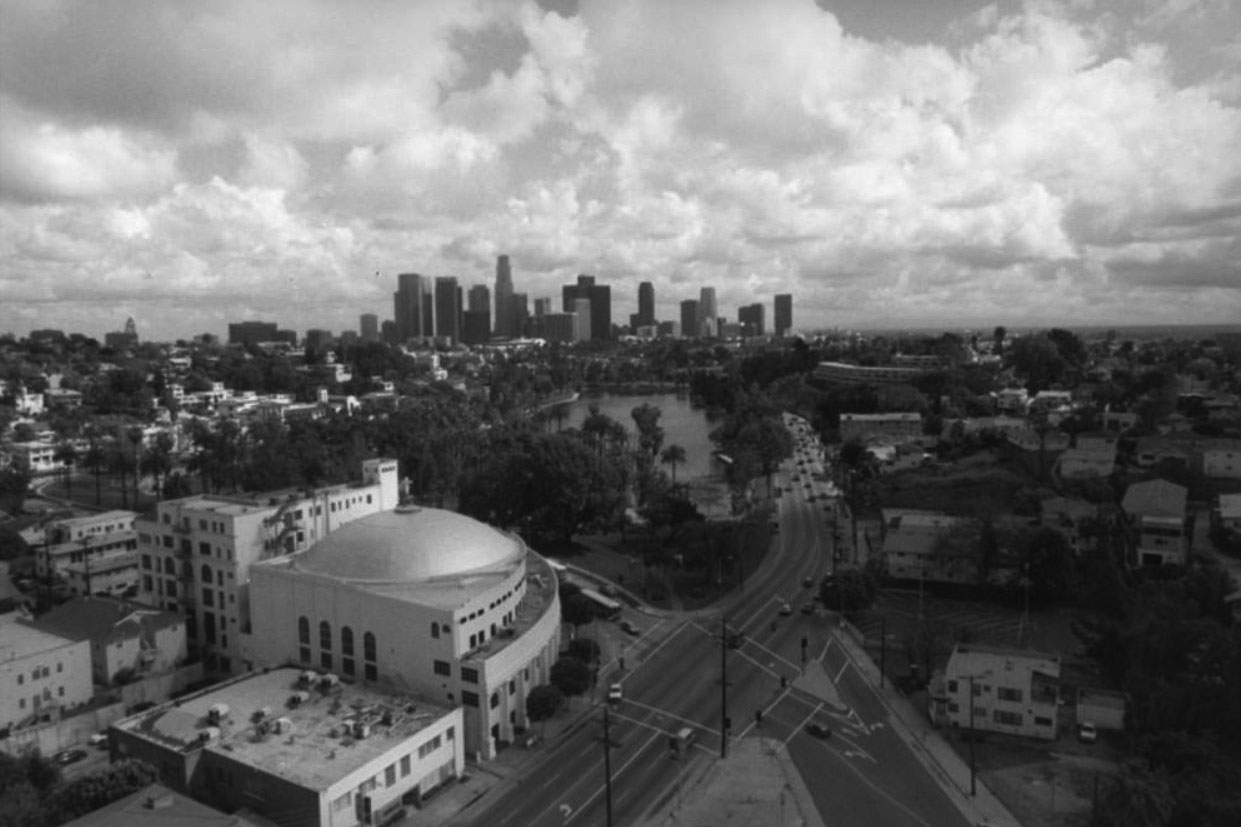 |
|
| (1998)* - Echo Park and its Lake are visible in the center of the photo, the famed Angelus Temple with its domed roof can be seen on the lower left, and Downtown L.A. skyscrapers sit majestically in the background. |
Historical Notes Angelus Temple was dedicated on January 1, 1923. It was added to the National Register of Historic Places in 1992, Building #92001875. On July 2002 the historic Temple completed major renovations, returning it to the classic and elegant look of the 1920's while also making it modern enough to have contemporary services suitable for today, without changing its historic elements. Nearly century-old homes, hillside bungalow courts, apartment buildings and pubic stairways also surround the landmark Echo Park. The visible street running along Angelus Temple and Echo Park is Glendale Boulevard. Click HERE to see more Early Views of Echo Park (1894+). |
* * * * * |
Rose Bowl Stadium
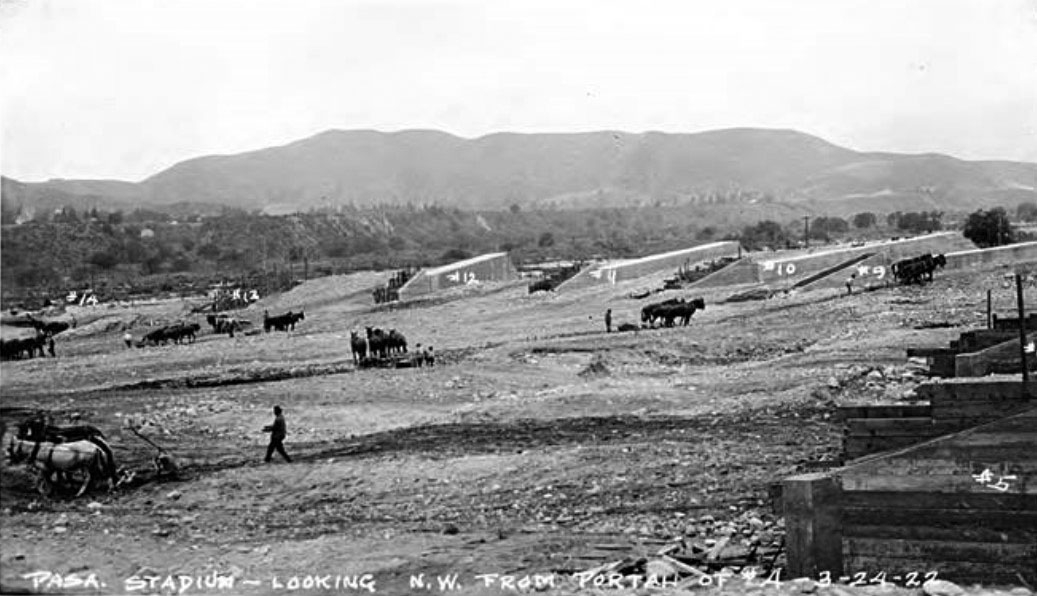 |
|
| (1922)* – View showing the early stages of construction of the Rose Bowl. The numbered structures are the tunnels, which were completed first. |
Historical Notes The idea for the Rose Bowl stadium emerged from the growing popularity of the annual Tournament of Roses football game. On March 20, 1920, the Tournament of Roses Association decided to build a stadium in Pasadena that could accommodate up to 100,000 spectators. Architect Myron Hunt, a member of the Association and respected local designer, was chosen to create the stadium's plans. Hunt's design was influenced by the Yale Bowl in New Haven, Connecticut, which had opened in 1914. In 1920, City officials declared the football facilities at Tournament Park unsafe for the growing New Year’s Day crowds. Ten-year $100 box seats were sold to raise funds for construction of a new facility. |
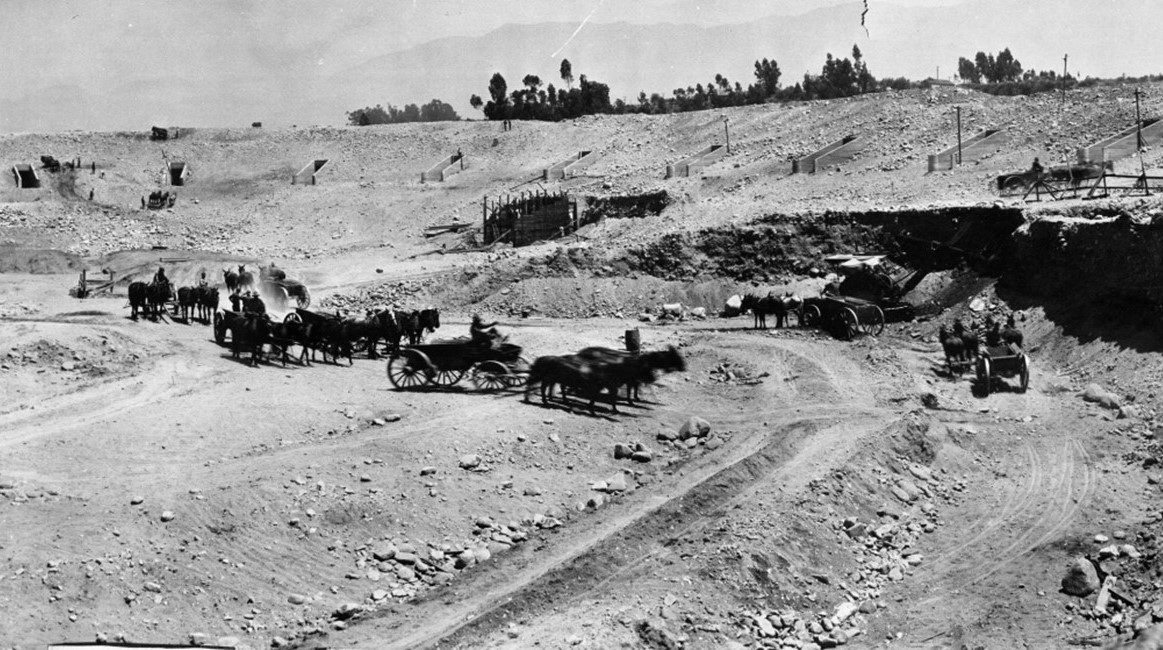 |
|
| (1922)* – Horse-drawn wagons haul off dirt during construction of the Rose Bowl Stadium. |
Historical Notes Construction of the Rose Bowl began on February 27, 1922, and was completed in just nine months, finishing in October 1922. The project employed a team of men and donkeys to dig and haul dirt, as well as to transport local river rock for the foundation. The stadium was built in the Arroyo Seco area of Pasadena, selected for its natural bowl-like topography. |
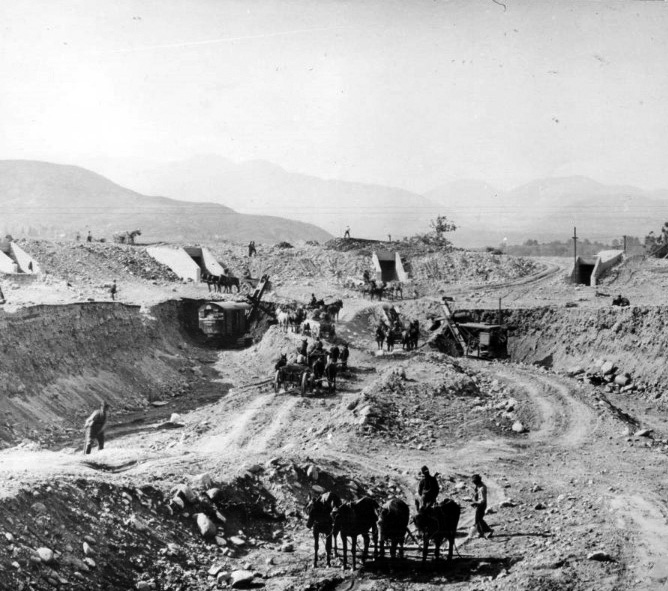 |
|
| (1922)* - The Pasadena Rose Bowl under construction in the Arroyo Seco dry riverbed. Construction began in 1921. |
Historical Notes The stadium was designed by architect Myron Hunt in 1921. His design was influenced by the Yale Bowl in New Haven, Connecticut, which was built in 1914. The Arroyo Seco dry riverbed was selected as the location for the stadium. |
 |
|
| (1922)* – View showing the Rose Bowl seats being assembled in the early stages of the stadium’s construction. |
Historical Notes The construction of the Rose Bowl in 1922 was a remarkable engineering feat set within the challenging landscape of the Arroyo Seco. Located in a picturesque but geologically complex area near Pasadena, California, the stadium's development required innovative solutions to overcome significant topographical obstacles. Engineers and architects had to carefully navigate the uneven terrain of the arroyo, managing complex earthwork to create a stable foundation. |
 |
|
| (1922)* - View looking west towards the San Rafael Hills showing horse-drawn wagons removing rocks and dirt as the Rose Bowl takes shape. |
Historical Notes The natural contours of the San Gabriel Mountains and the Arroyo Seco provided a stunning backdrop but also demanded precise planning for infrastructure. The stadium was designed to seat over 90,000 spectators, which required extraordinary engineering precision given the limited and challenging geographical space. Access roads, utility installations, and structural integrity were critical considerations that pushed the technological boundaries of early 20th-century construction techniques. |
.jpg) |
|
| (1922)* - Another view showing the construction work on the Rose Bowl. |
Historical Notes Despite these environmental and structural challenges, the construction team successfully transformed this natural canyon into one of the most iconic sports venues in the United States. The Rose Bowl not only became an architectural marvel but also preserved the natural beauty of its original setting. |
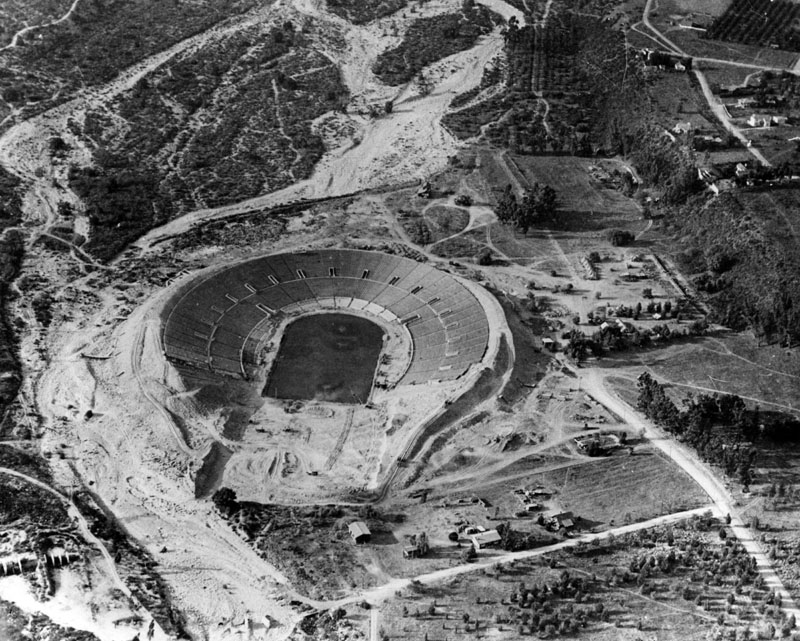 |
|
| (1922)* - Aerial view showing the Myron Hunt designed Rose Bowl taking on the shape of a horseshoe. |
Historical Notes The Rose Bowl was under construction for about a year (1921 to 1922). The design of the stadium was intended to accommodate as many patrons as possible, sitting close to the action. The first portion of the stadium was completed for less money than had been budgeted, and the seating capacity at the time was 57,000. |
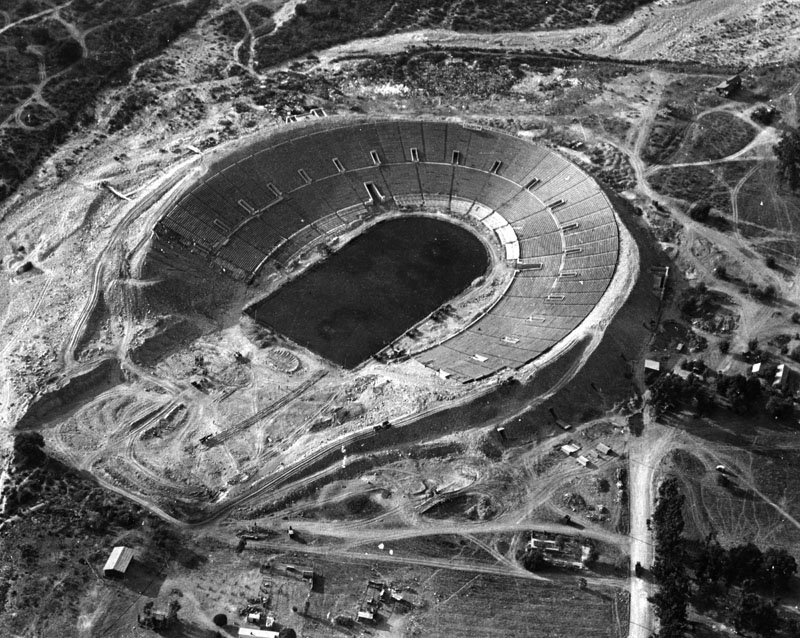 |
|
| (1922)* - A closer aerial view of the Rose Bowl under construction. |
Historical Notes The Rose Bowl was completed in Octobeer 1922, just several months prior to the completion of the nearby Los Angeles Memorial Coliseum, May 1923. The first game was a regular season contest on October 28, 1922 when Cal defeated USC 12–0. This was the only loss for USC and California finished the season undefeated. California declined the invitation to the 1923 Rose Bowl game and USC went in their place. |
Then and Now
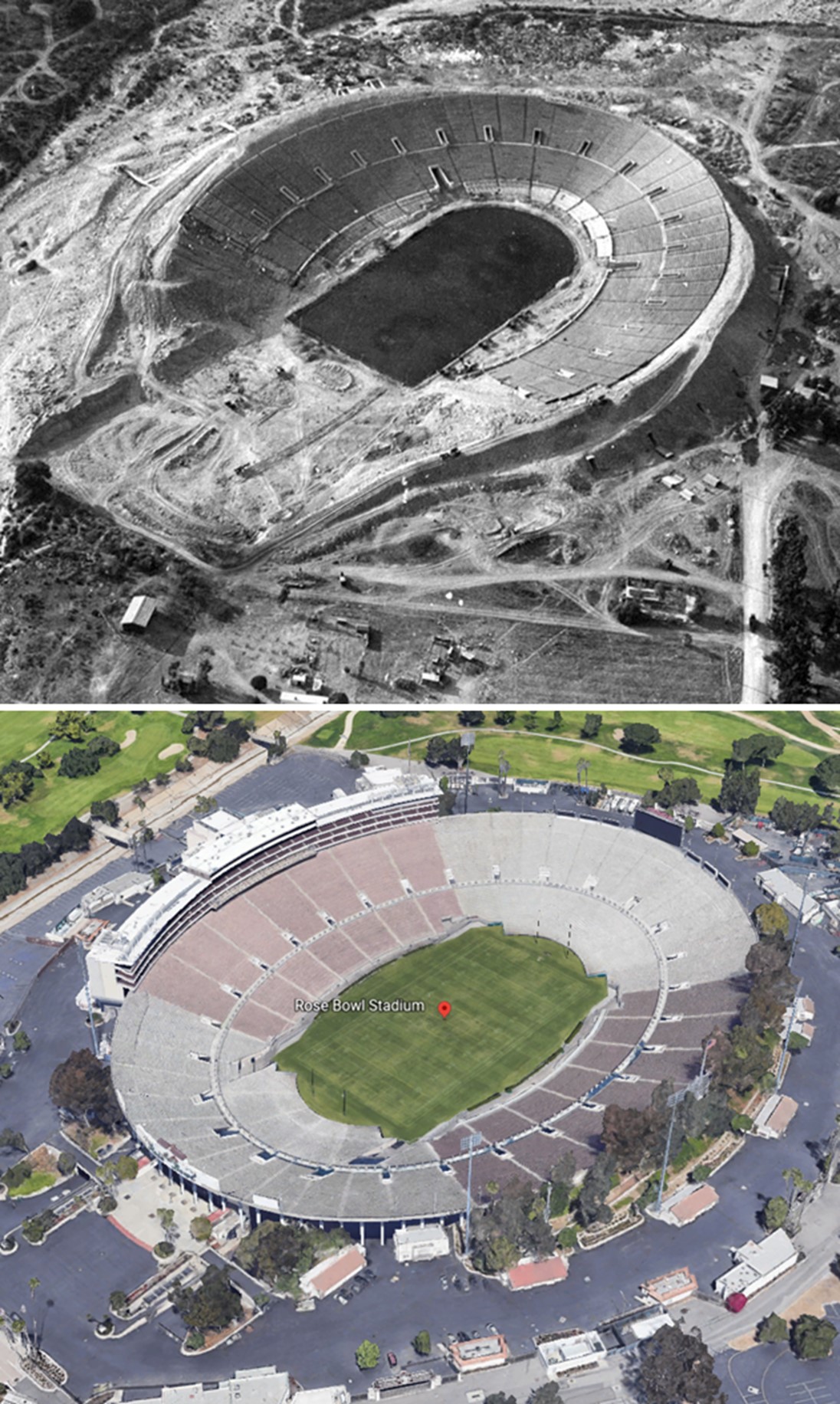 |
|
| (1922 vs. 2022)* - Then and Now |
Historical Notes The Rose Bowl stadium has undergone significant physical changes since its original construction in 1922, evolving from a horseshoe-shaped structure into a complete bowl with a seating capacity that has grown to over 92,000. Major renovations, particularly the most recent one completed in 2016, have modernized the facility while preserving its historic character. |
 |
|
| (1923)* - Panoramic view of the 1923 Rose Bowl Game between Penn State University and the University of Southern California at the Rose Bowl Stadium in Pasadena. The stands are almost filled, with the exception of some of the higher areas on the far side of the stadium. Small groups of what appear to be military men are seated on chairs on the track surrounding the field. The game is in progress, with the two teams in the middle of a series near midfield. There are men positioned at several places along the near sideline with photographic cameras, and one man near midfield has a motion picture camera. There is a very tall flag pole on the far right with a large American flag. A large number of automobiles are parked on the far right, beyond the open part of the stadium, where there are also a couple hundred people watching the game over the stadium fence. |
Historical Notes January 1, 1923 was the first time that the Rose Bowl Game was held at the Rose Bowl Stadium. The game featured Penn State University and the University of Southern California. Start of play was delayed more than an hour when Penn’s team was stuck in traffic. USC would go on to defeat Penn State 14 to 3. The name of the stadium was alternatively "Tournament of Roses Stadium" or "Tournament of Roses Bowl", until being settled as "Rose Bowl" before the 1923 Rose Bowl game. Click HERE to see more in Early Views of USC. |
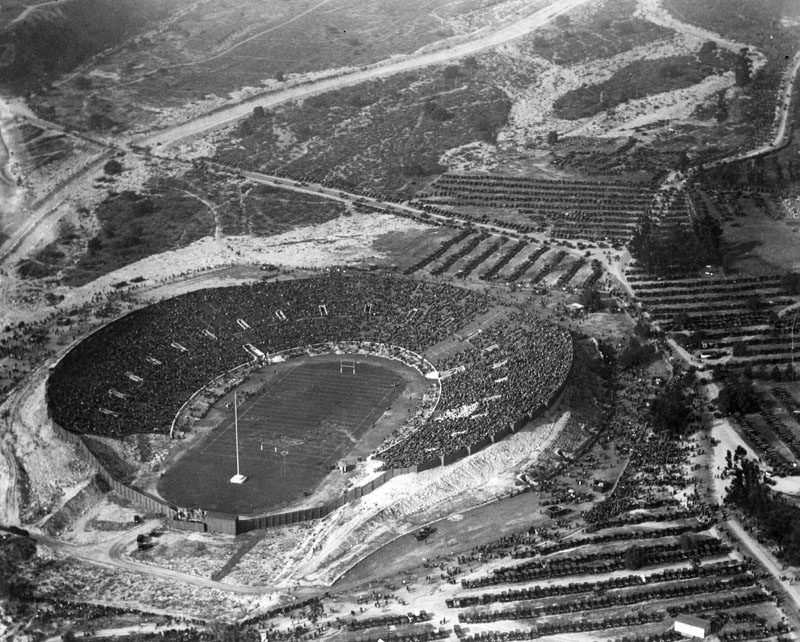 |
|
| (1925)* - Aerial view of the Rose Bowl on New Years Day, January 1, 1925. The stadium is almost full, yet crowds of people are still walking in. The football score that day was: Notre Dame, 27 vs Stanford, 10. |
Historical Notes Originally built as a horseshoe, the stadium was expanded several times over the years. The southern stands were completed in 1926, making the stadium a complete bowl. |
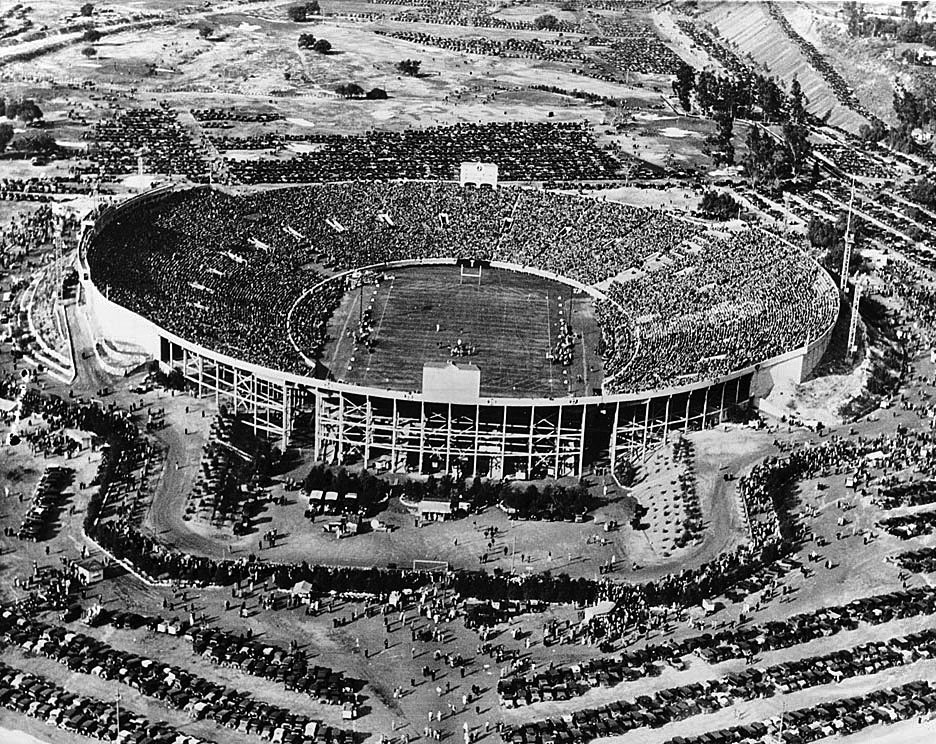 |
|
| (1926)* - Aerial view looking north showing the 1926 Rose Bowl game. |
Historical Notes The 1926 Rose Bowl Game is commonly referred to as "the game that changed the south." The game featured the Alabama Crimson Tide, making their first bowl appearance, and the Washington Huskies. Alabama was victorious 20–19, as they scored all twenty points in the third quarter. With the victory, the Crimson Tide was awarded its first National Championship. The game made its radio broadcast debut, with Charles Paddock, a sports writer and former Olympian track star, at the microphone. Alabama’s coach, Wallace Wade, was later inducted into the Rose Bowl Hall of Fame (1990). |
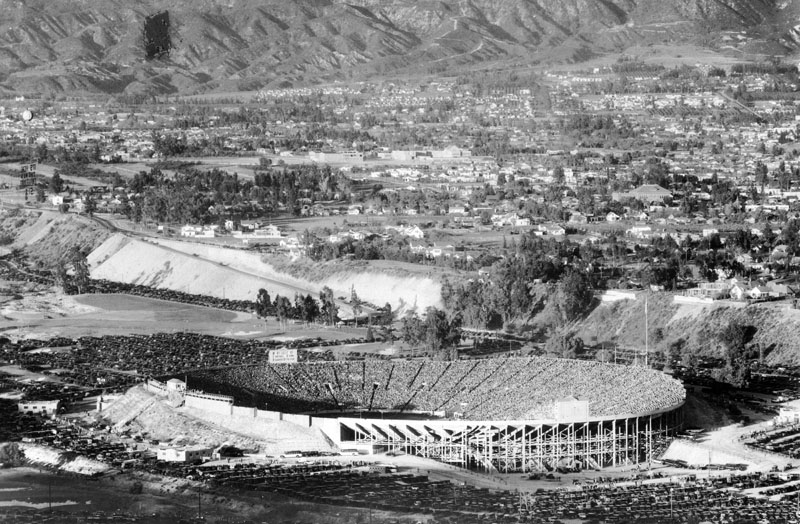 |
|
| (ca. 1928)* - Aerial view of the Rose Bowl after the southern stands were constructed making it a complete bowl. Though the stadium appears to be filled to capacity, people are still trickling in, and row upon row of automobiles can be seen neatly parked in the lots. View also shows the residential homes surrounding the stadium, as well as the mountains in the background. |
Historical Notes For many years, the Rose Bowl had the largest football stadium capacity in the U.S., and from 1972 to 1997, the maximum seating capacity was 104,594. Current official seating capacity is 92,542. The Rose Bowl game grew to become the "granddaddy" of all bowl games, because of its stature as the oldest of all the bowl games. The Rose Bowl stadium is a National Historic Landmark, and was added to the National Register of Historic Places on February 27, 1987. |
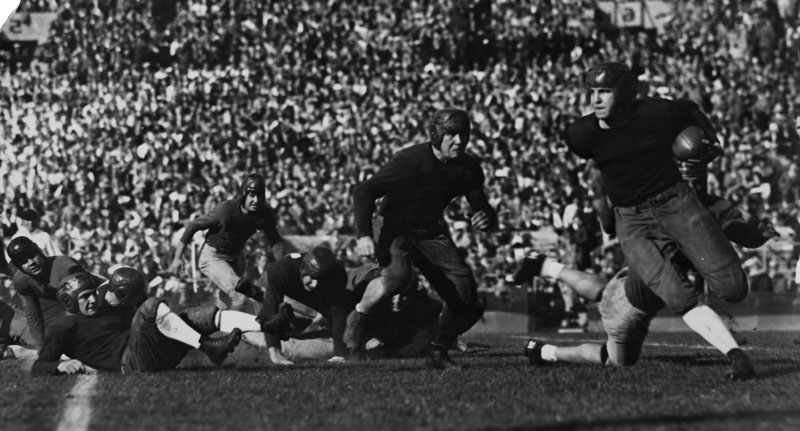 |
|
| (1929)* - Mizell of Georgia Tech, at left with ball, is shown at the start of a 32-yard gallop in which he carried the ball to California's 36-yard line in the game at the Pasadena Rose Bowl. January 2, 1929. Georgia Tech's football squad were one-point victors over University of California in the Rose Bowl classic. |
Historical Notes January 1, 1923 was the first time that the Rose Bowl Game was held at the Rose Bowl Stadium. The game featured Penn State University and the University of Southern California. Start of play was delayed more than an hour when Penn’s team was stuck in traffic. USC would go on to defeat Penn State 14 to 3. The name of the stadium was alternatively "Tournament of Roses Stadium" or "Tournament of Roses Bowl", until being settled as "Rose Bowl" before the 1923 Rose Bowl game. Click HERE to see more in Early Views of USC. |
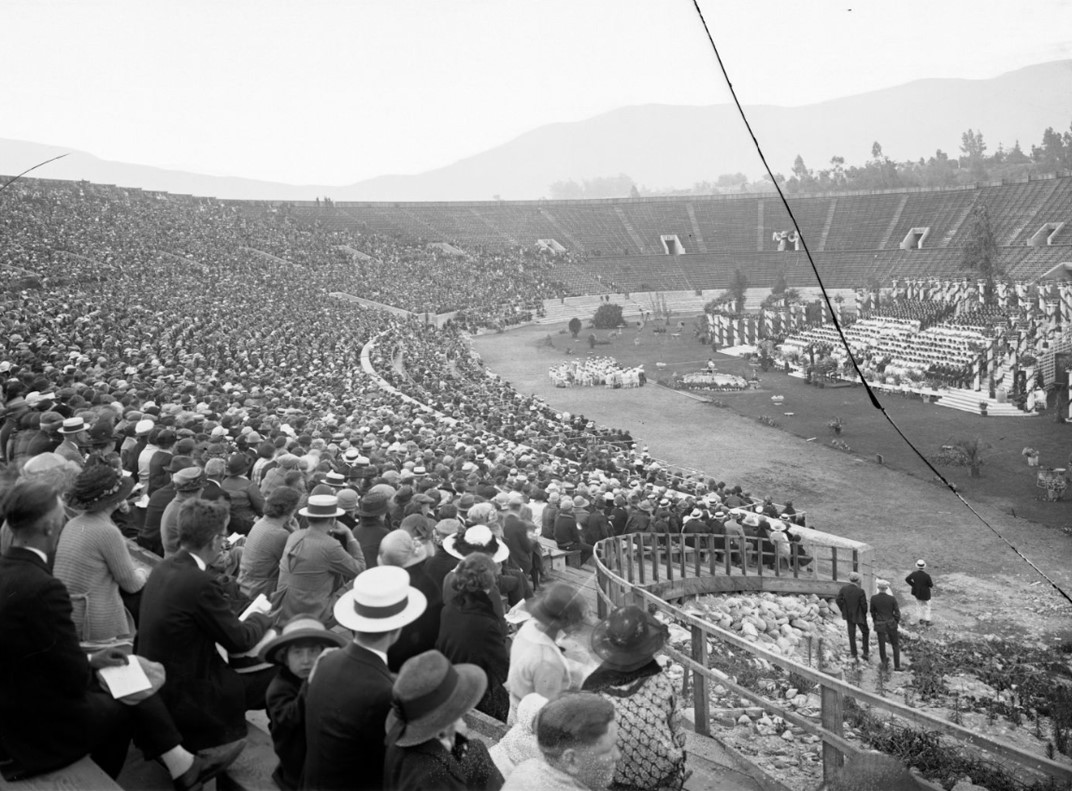 |
|
| (ca. 1924)* - A view of the Pasadena High School commencement ceremony at the Rose Bowl. A large crowd of spectators fills about half of the stadium. There are freestanding white bleachers on the far side which are occupied by the students, and a band is on the field in front of them. |
Historical Notes Today, the stadium still hosts commencement ceremonies for John Muir High School and Pasadena High School. It also hosts the annual football homecoming game, called the Turkey Tussle, between Pasadena High School and John Muir High School, in mid-November. Click HERE to see more Early Views of the Rose Bowl (1930s & 1940s). |
* * * * * |
Los Angeles Memorial Coliseum
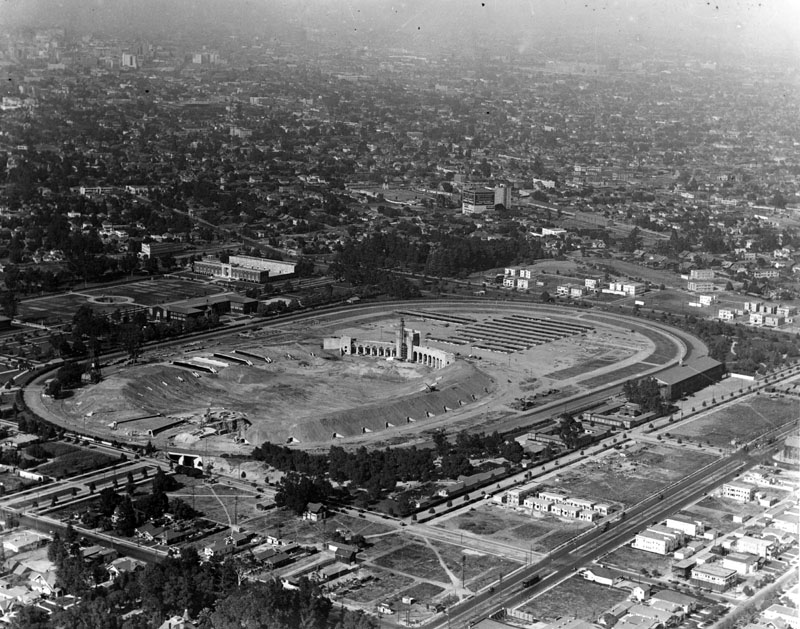 |
|
| (1922)* - Aerial view showing the early stages of the Coliseum's construction. The arches and east entranceway are already in place. |
Historical Notes The Coliseum was commissioned in 1921 as a memorial to veterans of World War 1. It was rededicated to veterans of all wars in 1968. The official ground breaking ceremony took place on December 21, 1921 with work being completed in just over 16 months, on May 1, 1923. Designed by John and Donald Parkinson, the original bowl's initial construction costs were $954,873. |
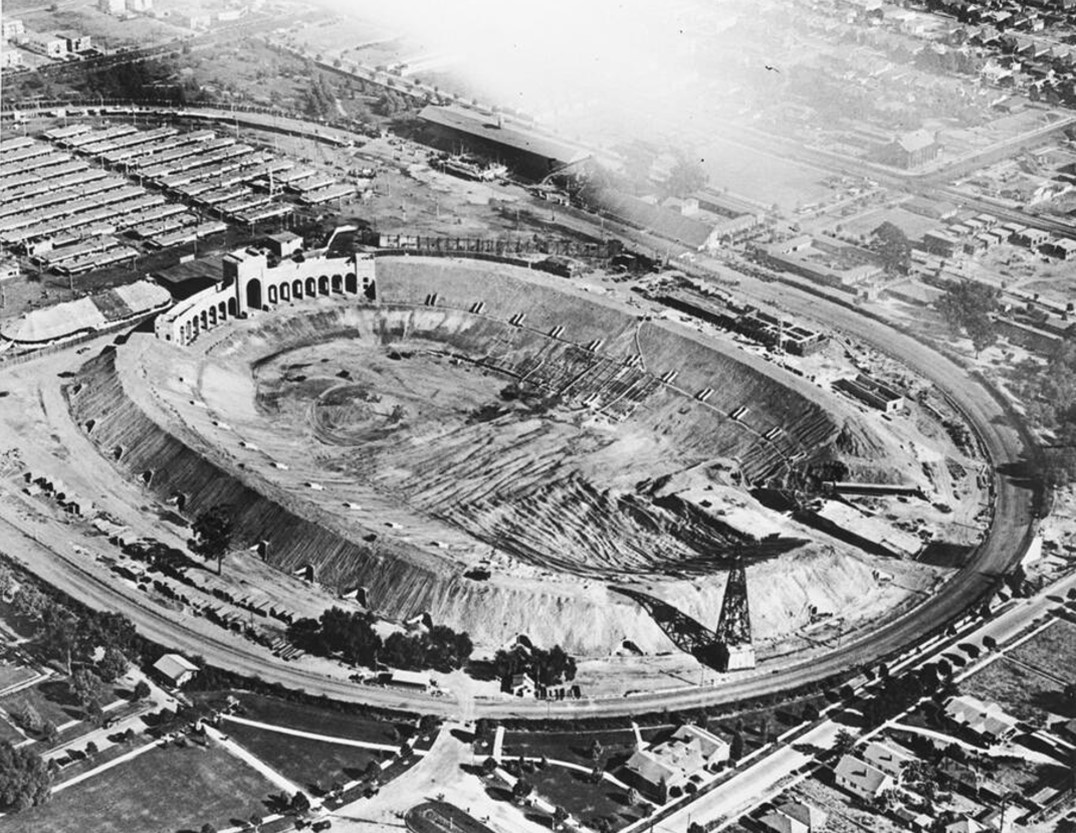 |
|
| (1922)* - Construction continues on the new LA Memorial Coliseum. The large stadium was built in less than two years, from December 1921 to May 1, 1923. |
Historical Notes The Coliseum was constructed on land within Exposition Park which orignially was call Agricultural Park. Dating back to 1872, farmers once sold their harvests on the grounds, while horses, dogs, camels, and later automobiles, competed along a racetrack. In 1913, it was renamed Exposition Park when four tenants moved in: California Museum of Science and Industry (Exposition Building), National Armory, Domed National History Museum and the Sunken Garden (later called Rose Garden). |
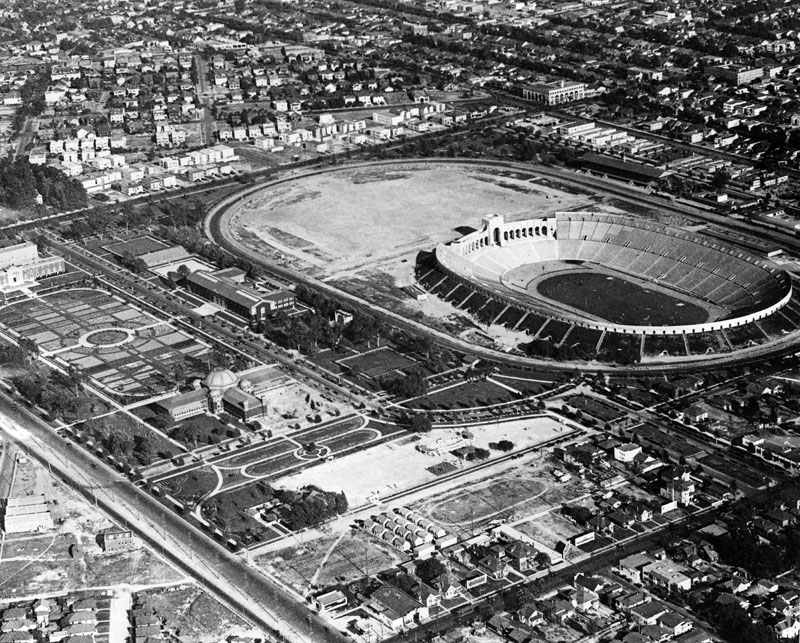 |
|
| (1923)* - Aerial views shows the progress of the construction work on the Coliseum. The stadium itself is almost complete with the surrounding area still needing work. In the foreground can be seen Exposition Park, including the Natural History Museum and Sunken Garden. |
Historical Notes The Los Angeles Memorial Coliseum, originally constructed in 1923 by architects John and Donald Parkinson, was initially built with a single bowl design and a capacity of 75,144 seats. In 1930, the stadium underwent its first major expansion, increasing seating to 101,574 and adding two tiers of tunnels. Throughout its history, the Coliseum has utilized innovative construction methods, including advanced structural engineering techniques that incorporated buckling restrained brace systems to provide strength and flexibility. |
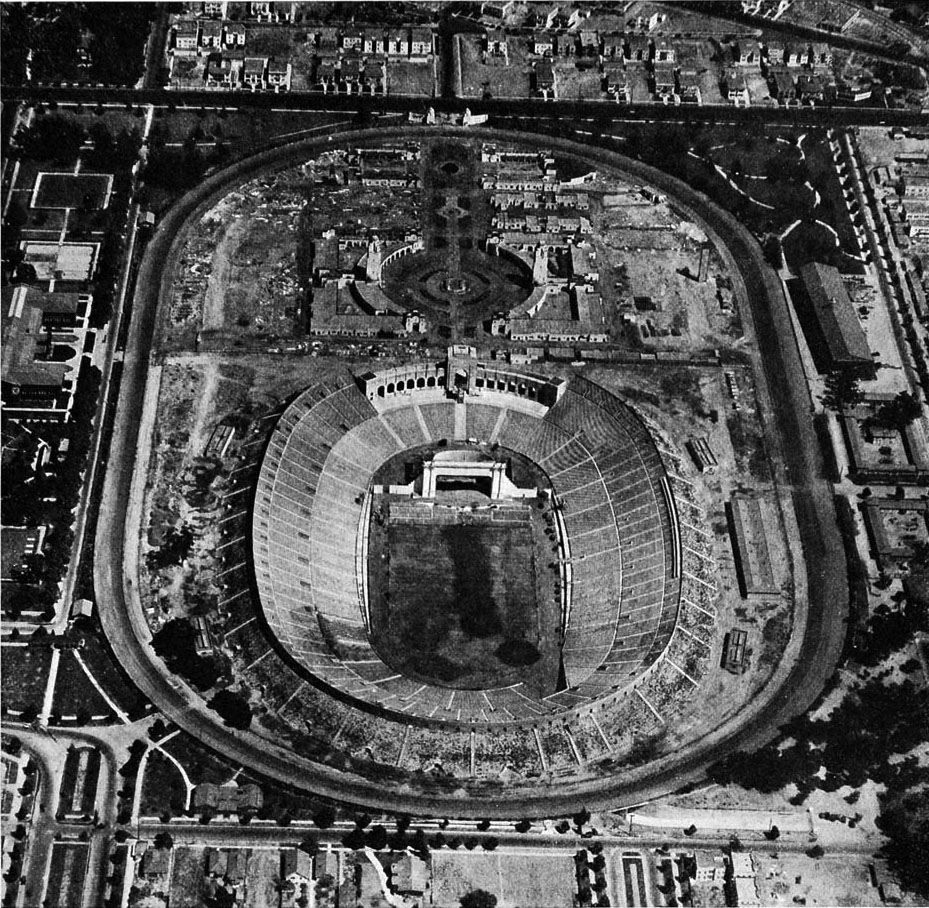 |
|
| (1923)* - Aerial view looking north showing an almost completed Coliseum. The next step is the landscaping. Figueroa Street, running left to right, is seen at top. |
Historical Notes When the Coliseum opened in 1923, it was the largest stadium in Los Angeles with a capacity of 75,144. |
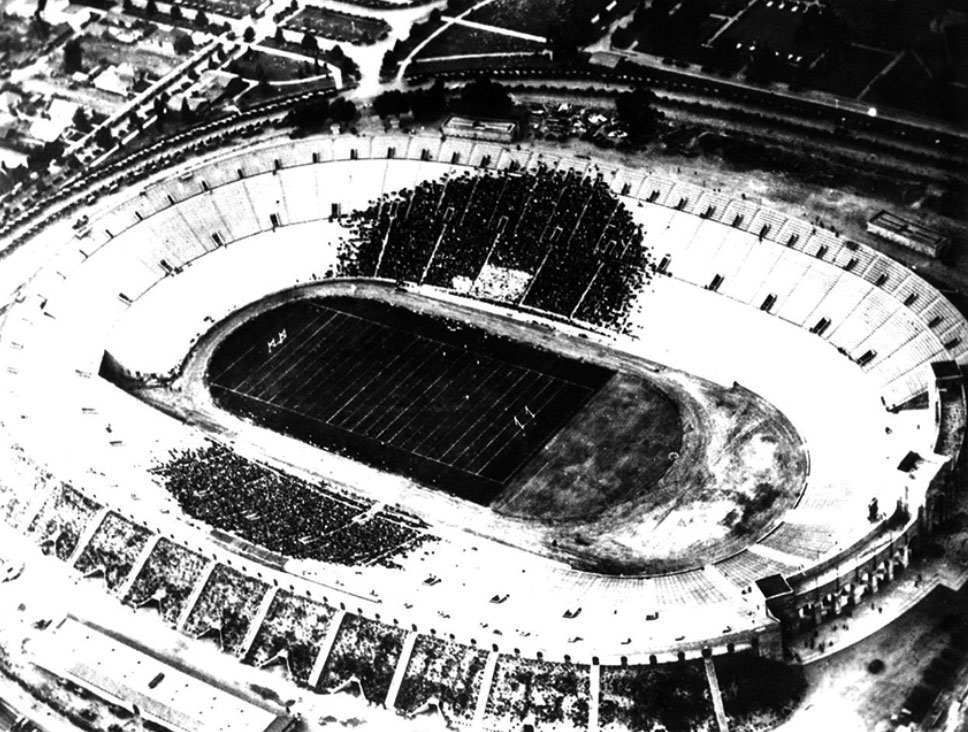 |
|
| (1923)* – View showing the 1st football game at the LA Memorial Coliseum, USC vs. Pomona. |
Historical Notes The Los Angeles Memorial Coliseum opened June of 1923; some 5 months later, on October 6th, the first football game was played in the stadium, with the University of Southern California defeating Pomona College 23-7 before a crowd of 12,836. Throughout the 1920s, the Coliseum quickly established itself as a premier venue for sports and events. It became the home field for USC football, hosting its first game on October 6, 1923. The stadium also showcased diverse events, including a notable boxing exhibition featuring Jack Dempsey in 1925. By the decade's end, the Coliseum had solidified its position as a cornerstone of Los Angeles' sporting and cultural landscape, setting the foundation for its future expansions and iconic status in American sports history. |
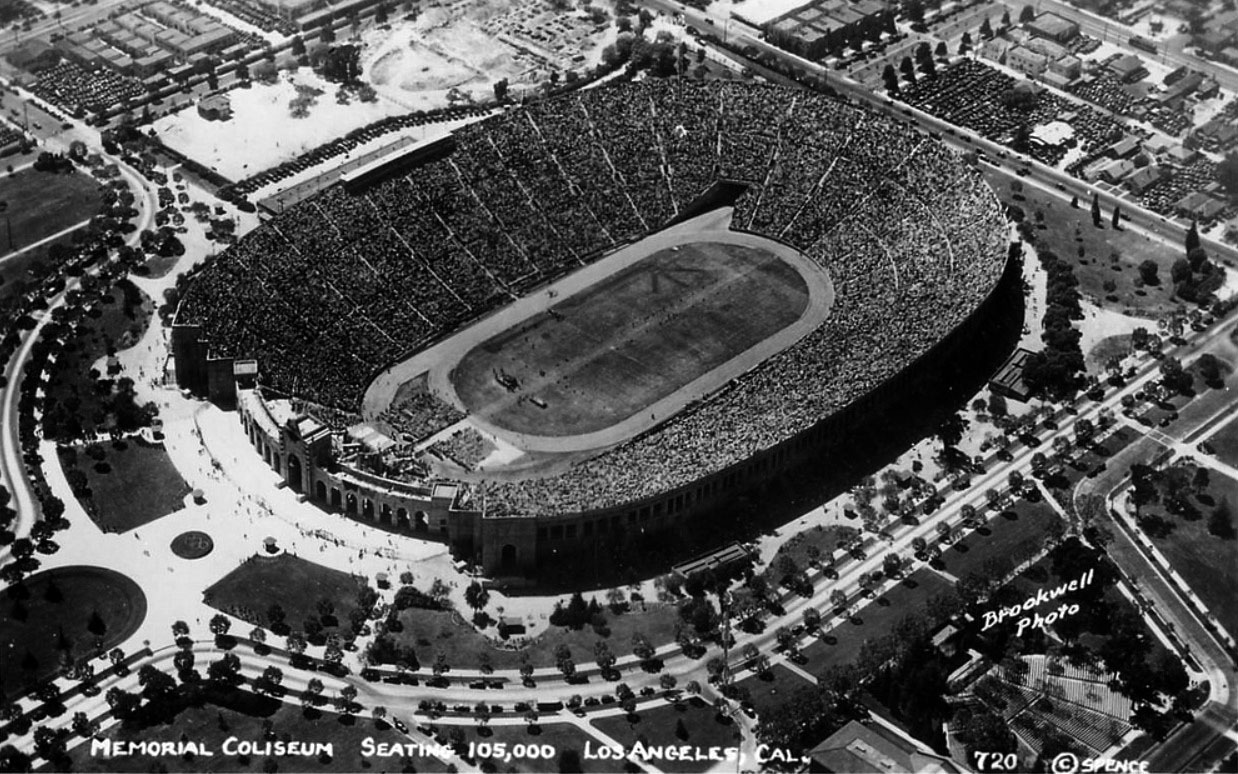 |
|
| (ca. 1930)* - Postcard view of the Memorial Coliseum after its expansion in preparation for the 1932 Olympics. Note: The Olympic torch has yet to be installed. |
Historical Notes In 1930, with the Olympics due in two years, the stadium was extended upward to seventy-nine rows with two tiers of tunnels, expanding the seating to 101,574. The now-signature torch was added. For a time it was known as Olympic Stadium. The Olympic cauldron torch which burned through both Games remains above the peristyle at the east end of the stadium as a reminder of this, as do the Olympic rings symbols over one of the main entrances. |
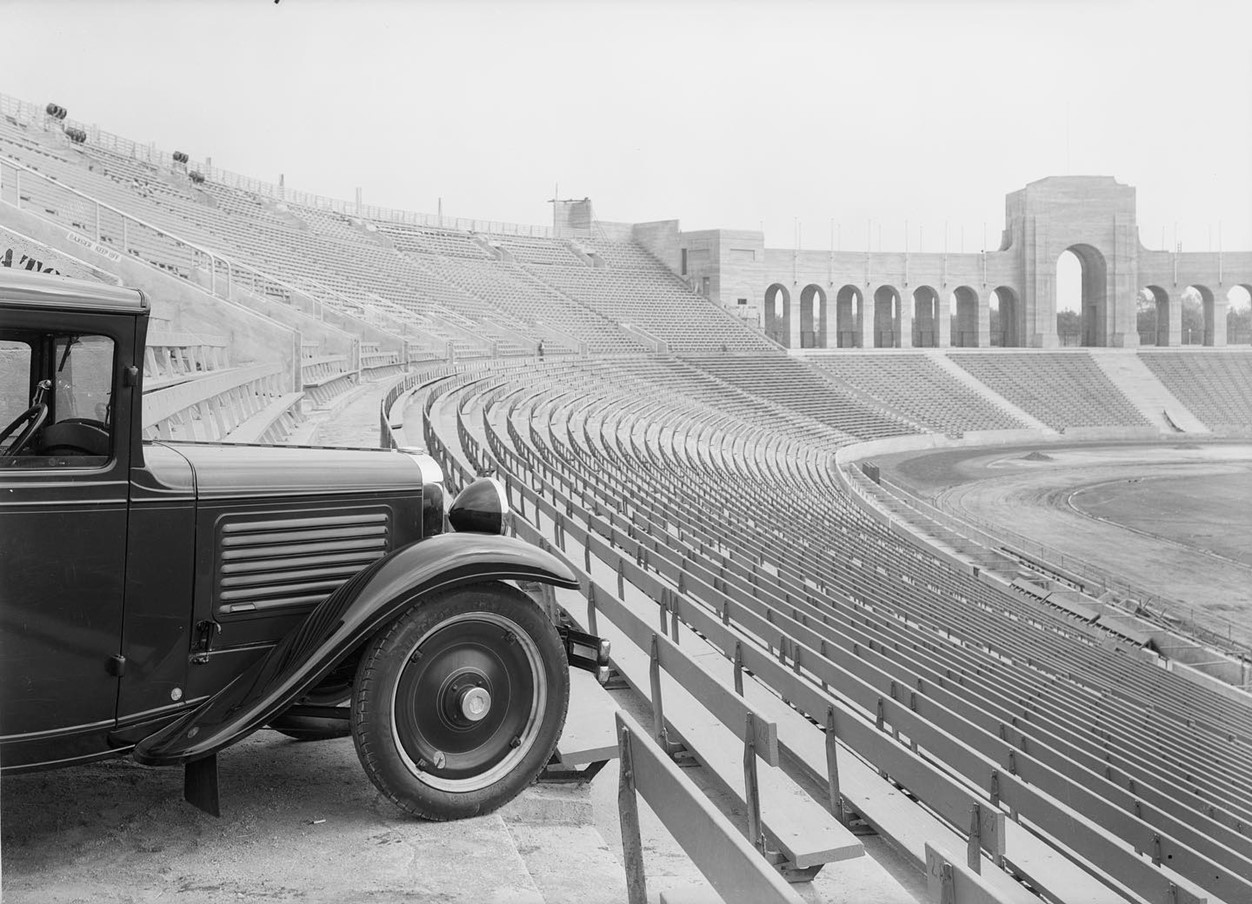 |
|
| (ca. 1929)* - A Ford Model A car is parked behind the wooden bleachers in the LA Memorial Coliseum. Note the torch we see today would not be installed until 1930. |
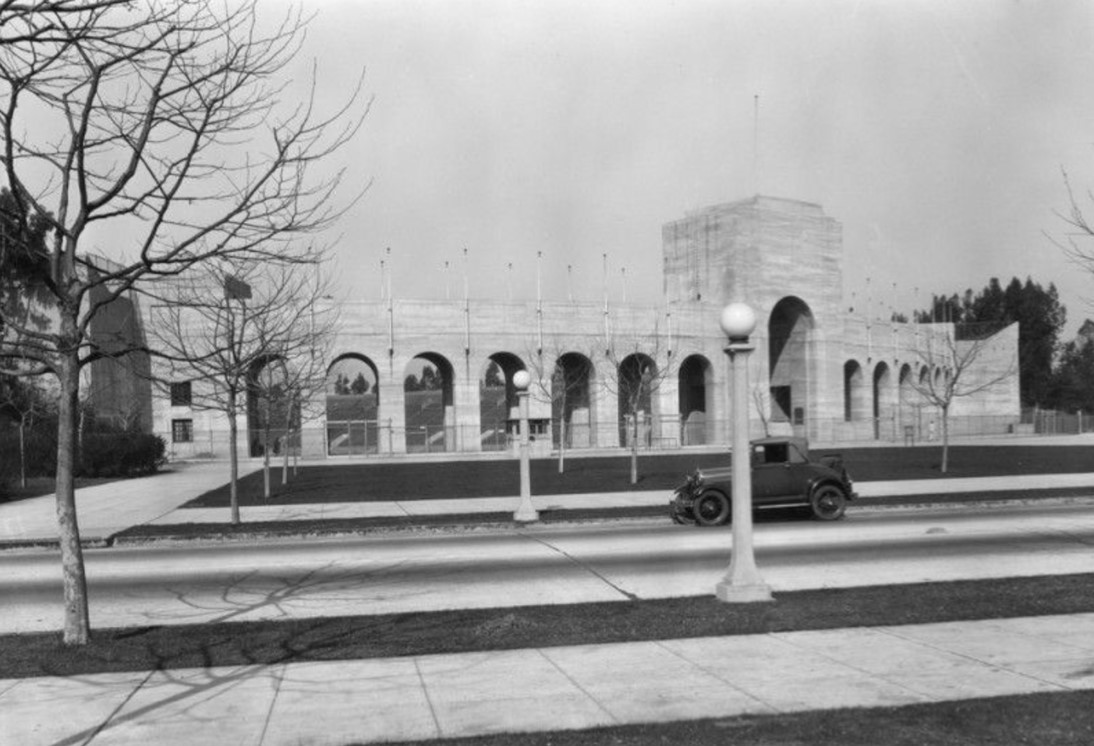 |
|
| (1920s)* - View of the front end of the Coliseum stadium at Exposition Park before the Olympic torch was added. |
Historical Notes The now-signature torch was added for the Olympics during the 1930 renovation. It is still being lit during the fourth quarters of USC football games. |
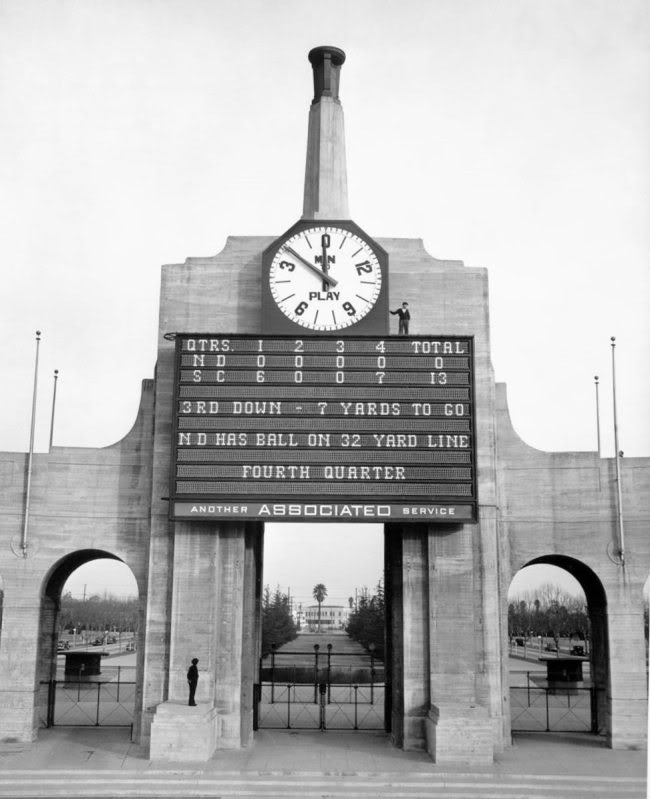 |
|
| (1932)* - Final score: USC 13 - Notre Dame 0: USC shut out Notre Dame on its way to a second consecutive consensus national title, matching Notre Dame's feat in 1929 and 1930. |
Historical Notes From 1928-1932, USC and Notre Dame combined to win the national title five straight years, with USC winning in 1928, 1931 and 1932, and Notre Dame winning in 1929 and 1930. USC and Notre Dame have a storied football rivalry that began in 1926, with Notre Dame leading the series 50 wins to 38 losses and 5 ties. The first matchup saw Notre Dame triumph 13-12, and over the years, the rivalry has produced memorable moments, such as USC's dramatic comeback from a 24-point deficit in 1974 and the thrilling "Game of the Century" in 2005, which USC won 34-31. Both teams have experienced periods of dominance, with USC breaking a recent losing streak at Notre Dame Stadium in 2017, while Notre Dame secured a decisive victory in 2020. This rivalry not only highlights competitive spirit but also holds cultural significance, as both teams compete annually for the Jeweled Shillelagh trophy. |
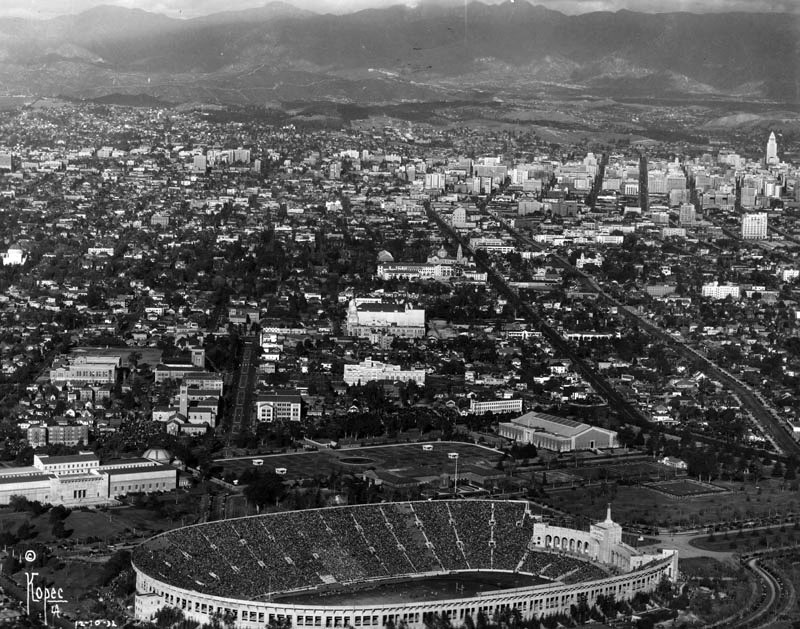 |
|
| (1932)* - Aerial view of Los Angeles, looking north, with the Coliseum in the foreground. Note: the Olympic torch is now in place. Downtown LA can be seen in the background with City Hall appearing to be the tallest building. |
Historical Notes In preparation for the 1932 Olympics, the Coliseum underwent its first major expansion, increasing capacity to over 100,000 and adding the iconic Olympic torch. This set the stage for the stadium's unique Olympic legacy, as it went on to host the 1984 Games and is slated to host again in 2028, making it the first stadium to host three Olympic Games. Prior to the late 1950s the Charter of the City of Los Angeles did not permit any portion of any building other than a purely decorative tower to be more than 150 feet. Therefore, from its completion in 1928 until 1964, the City Hall was the tallest building in Los Angeles, and shared the skyline with only a few structures having decorative towers, including the Richfield Tower and the Eastern Columbia Building. Click HERE to see more Early Views of the Los Angeles Memorial Coliseum during the Olympics. |
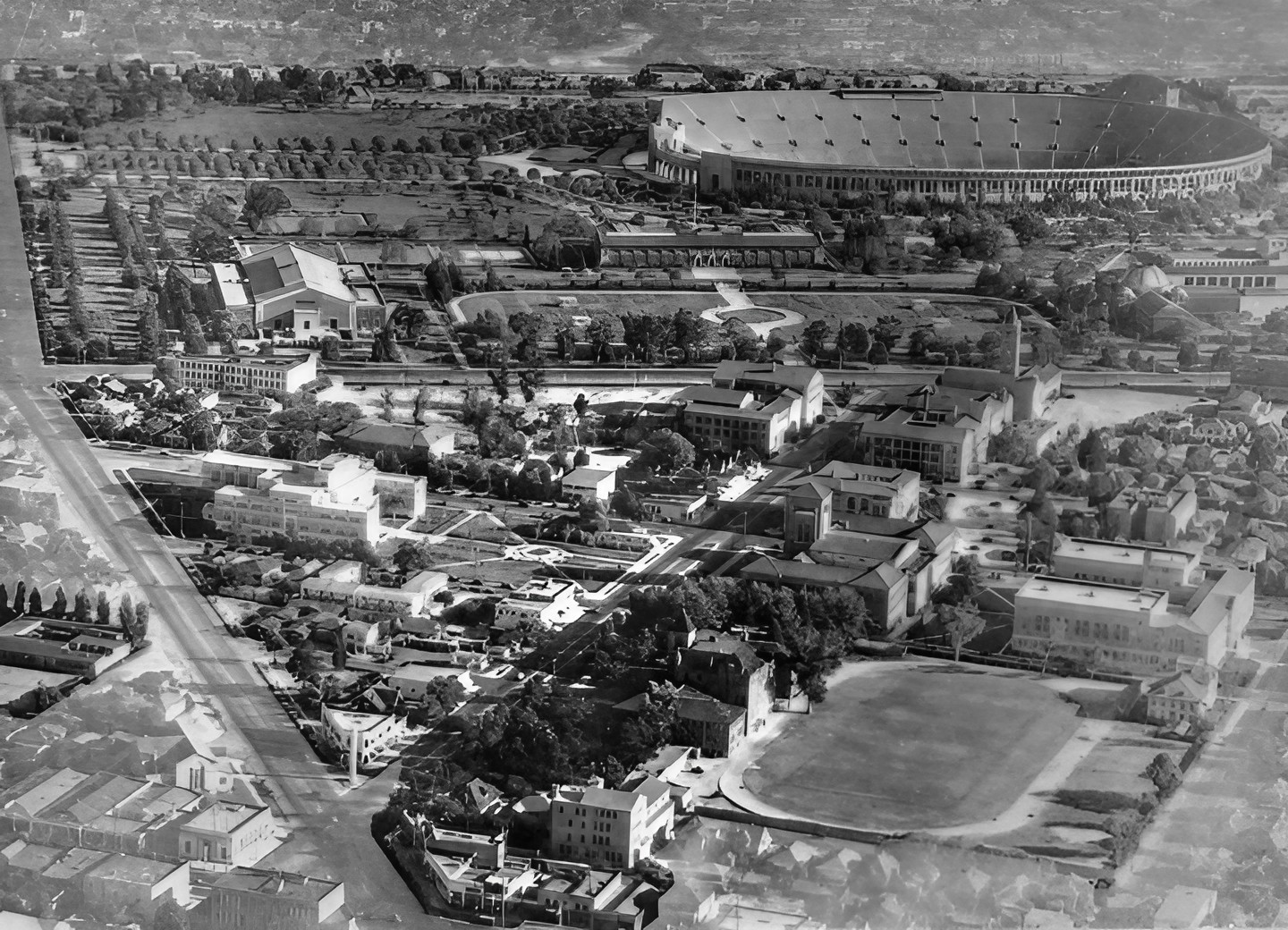 |
|
| (1930s)* - Aerial view looking south showing the Coliseum and Exposition Park in the distance with the USC campus in the foreground. |
Historical Notes In addition to serving as the home field for the USC Trojans since 1923, countless historic events have taken place inside these venerable walls during nine decades of celebrated history. It is the only facility in the world to play host to two Olympiads (X and XXIII), two Super Bowls (I and VII), one World Series (1959), a Papal Mass and visits by three U.S. Presidents: John F. Kennedy, Richard M. Nixon and Ronald Reagan. Click HERE to see more in Early Views of USC. |
* * * * * |
California Bank (1st and Vermont)
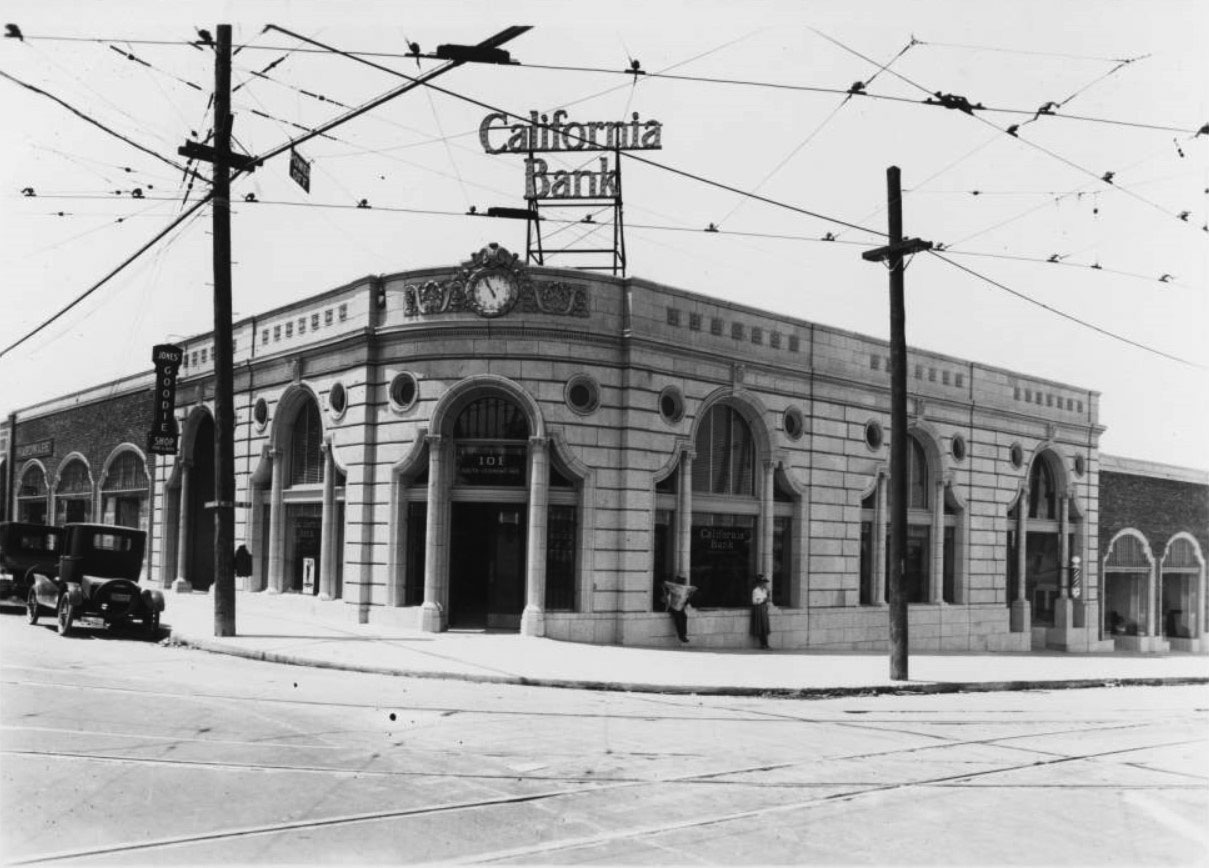 |
|
| (1922)^ - View of the California Bank branch office on the southwest corner of Vermont and First Street. Two poles stand in front of the bank with their streetcar wires weaving overhead. The bank has an arched entrance and tall, arched windows where two people lean on the right. Automobiles sit parked in front of Jones Goodie Shop on the far left. |
* * * * * |
Hollywood Bowl
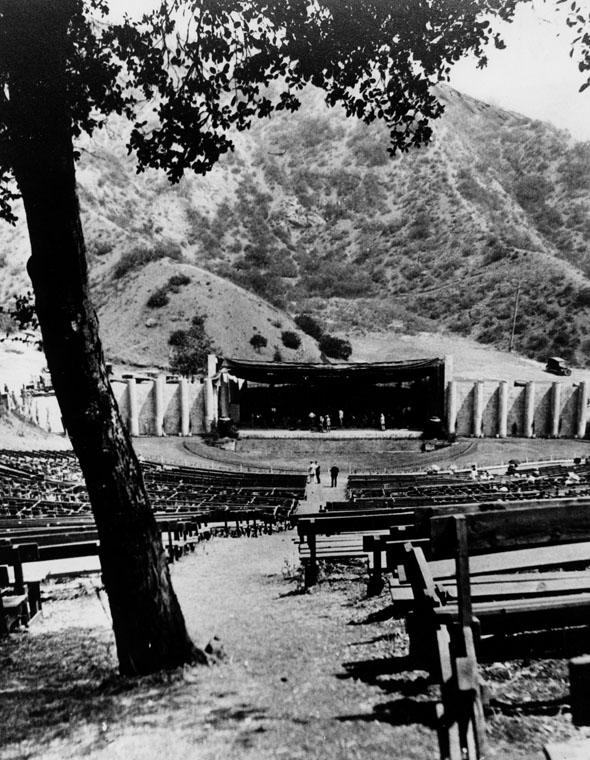 |
|
| (1922)* - Hollywood Bowl at first Symphony Under the Stars, July 11, 1922. This was the "Bowl's" official opening and was on the site of a natural amphitheater formerly known as the Daisy Dell. It has undergone several upgrades to improve seating as well as acoustics. |
Historical Notes On July 11, 1922, with the audience seated on simple wooden benches placed on the natural hillsides of Bolton Canyon, conductor Alfred Hertz and the Los Angeles Philharmonic inaugurated the first season of music under the stars at the Hollywood Bowl. The Bowl was very close to its natural state, with only makeshift wooden benches for the audience, and eventually a simple awning over the stage.^* |
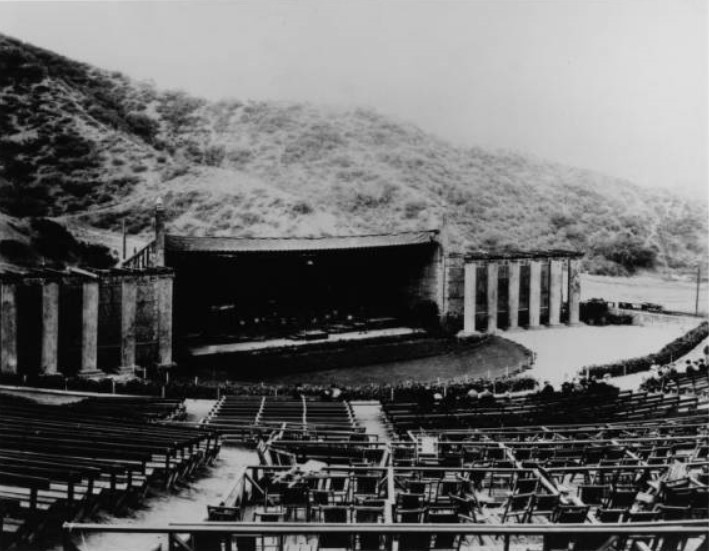 |
|
| (1920s)^ - View looking toward the stage from an upper row of seats. The stage of the Hollywood Bowl is shown at center, bordered on each side by columns. Curved rows of bleacher-like seats sit to the left of the camera, while in front of it are rows of box seats. A group of several people stands in the front rows of the center and right sections of seats. |
Historical Notes The Hollywood Bowl has been the summer home of the Los Angeles Philharmonic, since its official opening in 1922.^* In 1922 the admission price was 25 cents. |
Click HERE to see more Early Views of the Hollywood Bowl |
* * * * * |
Hollywood Masonic Temple
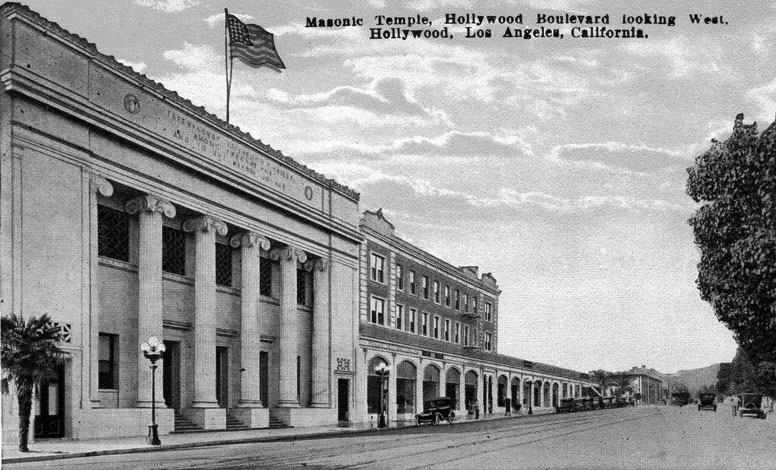 |
|
| (ca. 1922)^*# – Postcard view looking west on Hollywood Boulevard showing the newly constructed Masonic Temple located at 6840 Hollywood Boulevard. |
Historical Notes In 1921, the Hollywood lodge of the Masons relocated from their existing lodge on the current site of the Kodak Theatre. The construction of the new three-story building was led by lodge master, Charles E. Toberman, who was responsible for the Hollywood Bowl, Grauman's Chinese Theatre, the Roosevelt Hotel and the Max Factor Building. |
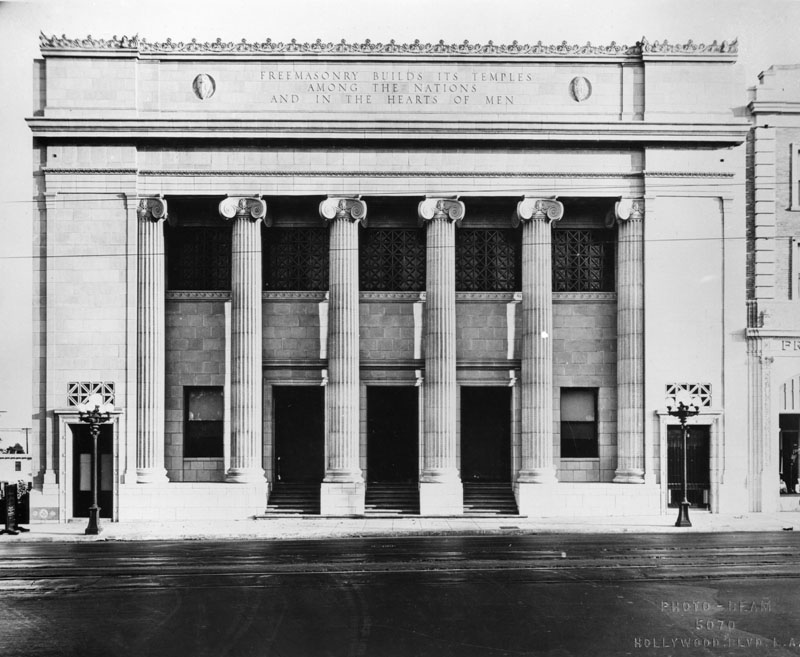 |
|
| (1922)* - Exterior view of the Masonic Temple located at 6840 Hollywood Boulevard, between Highland and La Brea. The building was built in 1922 and designed by Architects Austin, Field & Fry in a Greek Revival design with six tall pillars decorating the front entrance of the building. Note the two ornate 5-bulb streetlights in front of the building. Click HERE to see more in Early L.A. Street Lights. |
Historical Notes When the new temple opened, it was one of the most substantial structures in Hollywood. It had a billiard room, pipe organ, ladies parlor, ballroom and lodge rooms. One writer described the building as "unsurpassed for beauty, attractiveness and richness of equipment. The architect, John C. Austin also worked on the Shrine Auditorium, Griffith Observatory and Los Angeles City Hall.^* |
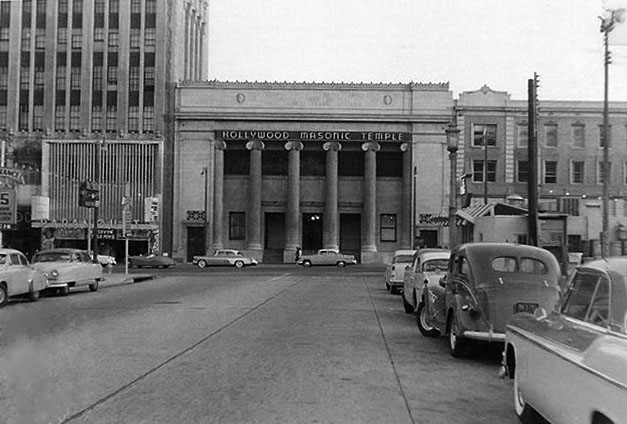 |
|
| (1955)**^# – View looking south on Orchid Avenue toward Hollywood Boulevard. The Hollywood Masonic Temple is seen on the south side of Hollywood Boulevard at the end of the T-intersection. Toff's Coffee Shop can be seen at center-right, NW corner of Orchid and Hollywood Blvd. |
Historical Notes Orchid Avenue at Hollywood Boulevard "disappeared" during the construction of the Hollywood Highland complex in the late 90s. The other half of the street still exists and can be accessed off of Franklin Ave, the next street north of Hollywood Blvd. |
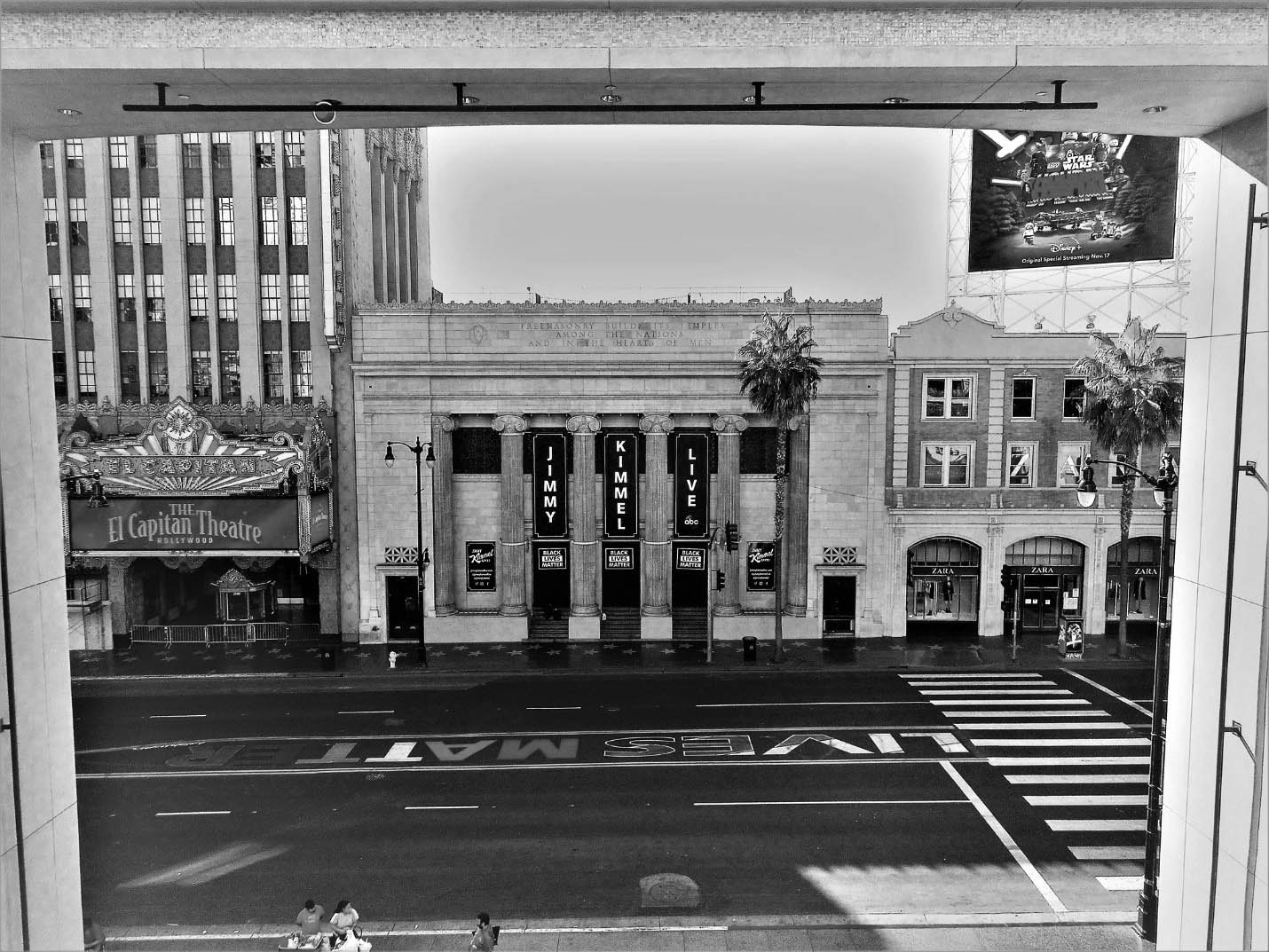 |
|
| (2020)^.^ - The Masonic Temple as seen from the Hollywood and Highland Center across the street. The building is now the El Capitan Entertainment Center where Jimmy Kimmel Live is filmed. Photo by Howard Gray |
Historical Notes The Masons operated the temple until 1982, when they sold the building after several years of declining membership. The 34,000-square-foot building was then converted into a theater and nightclub, and ownership subsequently changed several times, until it was bought by the Walt Disney Company's Buena Vista Pictures Distribution in 1998 for Buena Vista Theatres, Inc. In 1984, the Hollywood Masonic Temple (now known as the El Capitan Entertainment Centre) was desiganted LA Historic-Cultural Monument No. 277 (Click HERE to see complete listing). It was also listed in the National Register of Historic Places in 1985. |
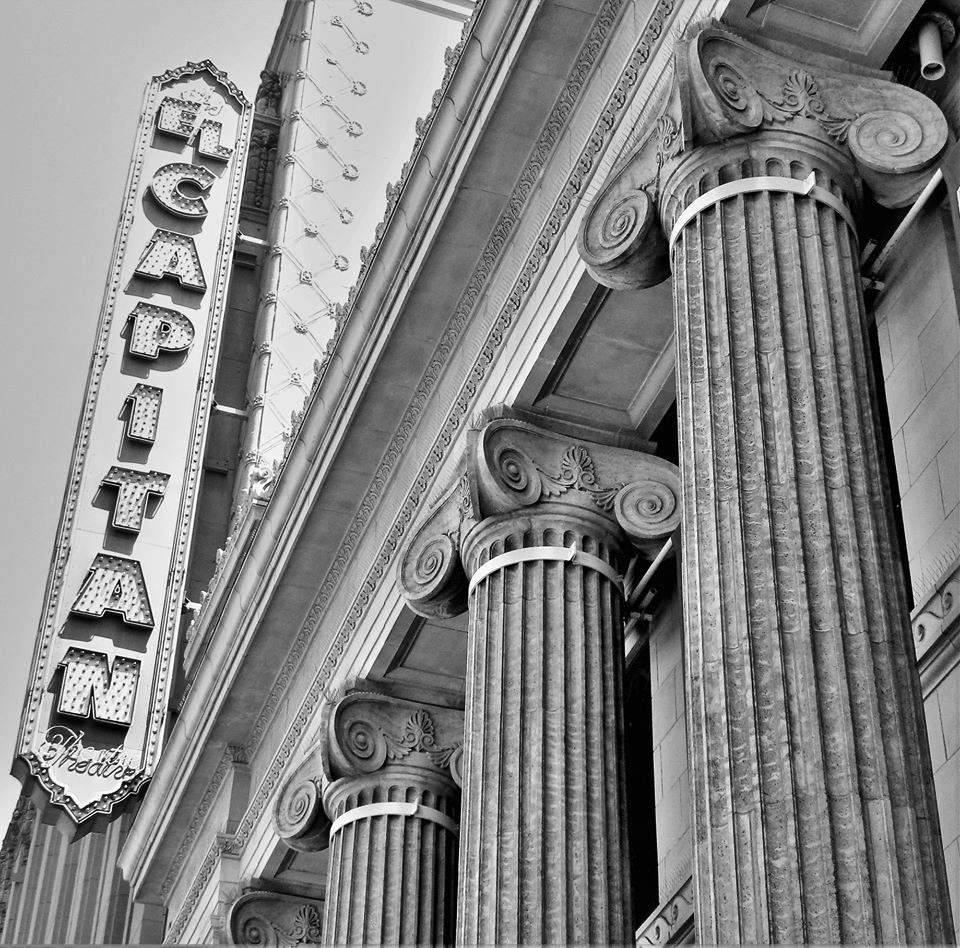 |
|
| (2020)^.^ - View looking up toward the El Capitan Theatre sign as seen from in front of the old Hollywood Masonic Temple, now the El Capitan Entertainment Center. Photo by Howard Gray |
Historical Notes In 2002, after extensive renovation, Disney reopened the building as the El Capitan Entertainment Centre. Disney restored original fixtures, including backlighted stone filigree, wrought iron torchieres, Batchelder tiles and old post boxes once used by Masonic officers. On January 26, 2003, Jimmy Kimmel Live! premiered at the entertainment center, its regular location.^ |
* * * * * |
Los Angeles Normal School
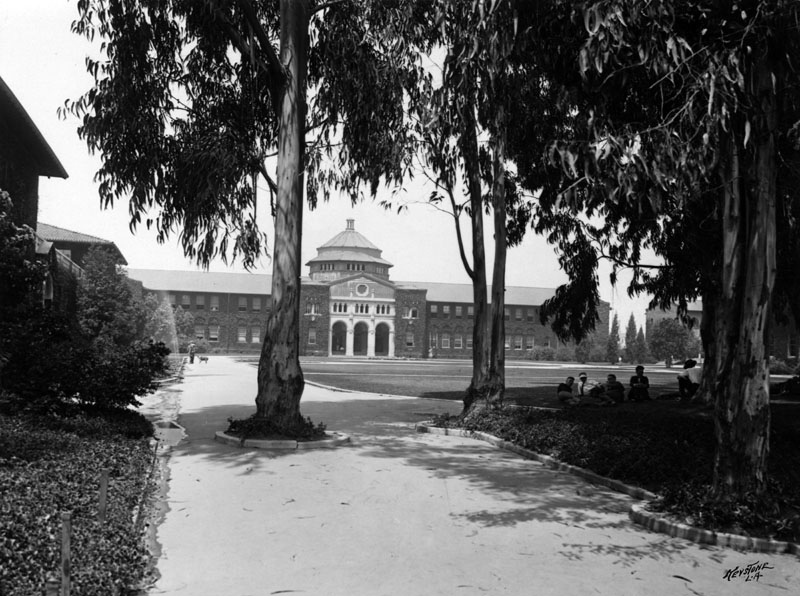 |
|
| (1922)* - Millspaugh Hall at the Los Angeles State Normal School on Vermont Avenue (later to become UCLA). Students can be seen sitting in the shade of a Eucalyptus tree. |
Historical Notes The cornerstone for Millspaugh Hall was laid on November 18, 1913; in September 1914, the school began its sessions in the new building. Millspaugh Hall was the center of student and administrative activity and occasionally an outdoor assembly area. The University of California, Southern Branch would eventually come to be known as the University of California, Los Angeles - or UCLA for short.* |
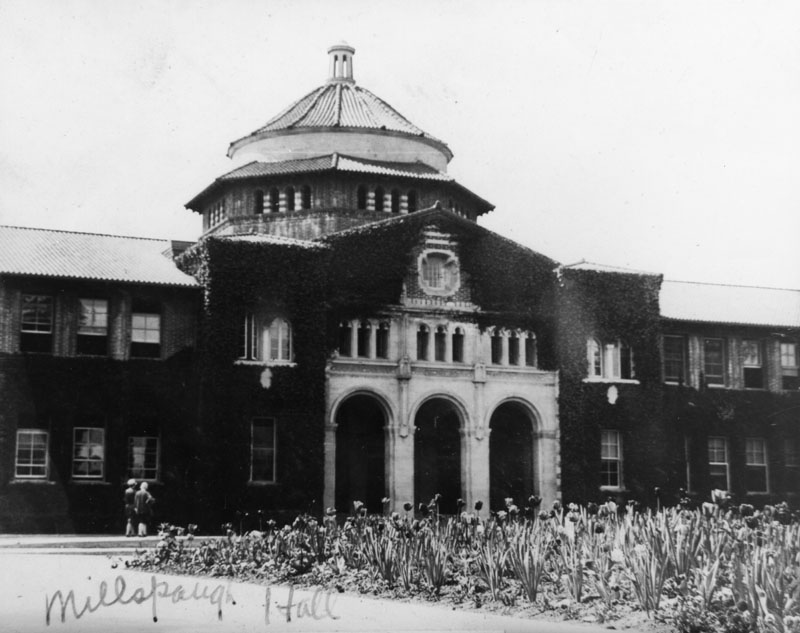 |
|
| (ca. 1925)* - Millspaugh Hall, an ivy-covered Beaux-Arts style building with a flared polygonal dome, was the Administration building of the University of California, Southern Branch, located at 855 N. Vermont Ave. |
Historical Notes UCLA's first Commencement was in 1920 and was held in Millspaugh Hall of what was then the Los Angeles State Normal School on Vermont Avenue. The institution conferred its first bachelor's degree in education in 1923, and its first bachelor of arts degree in 1925. The Class of 1928 was graduated in ceremonies held in the Hollywood Bowl, the site of UCLA Commencements for several years, even following the move from the Vermont Avenue campus to Westwood in 1929.^** |
Click HERE to see more in Early Views of UCLA |
* * * * * |
Egyptian Theatre
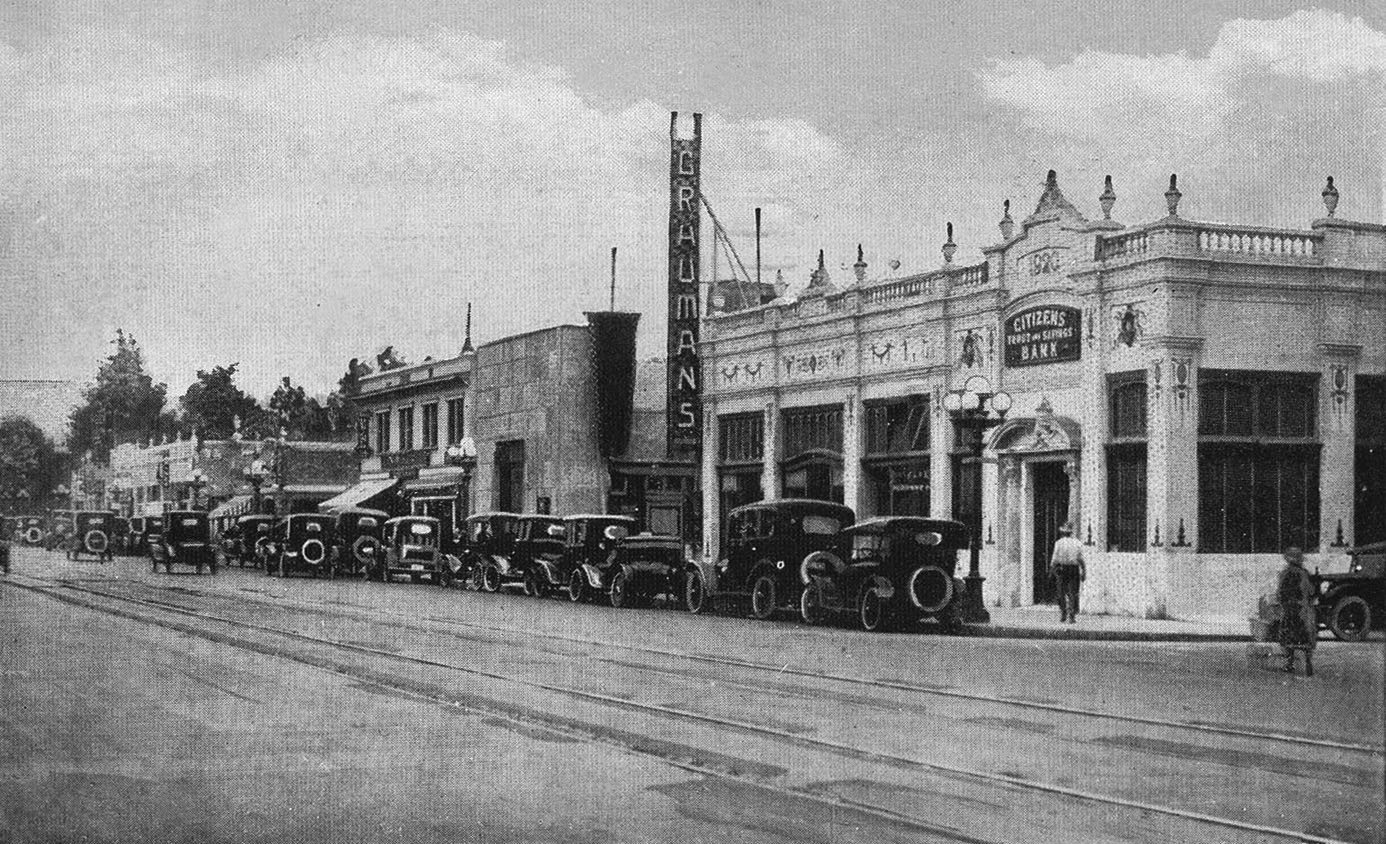 |
|
| (1922)^ - View looking east on Hollywood Boulevard at McCadden Place showing the newly opened Grauman's Egyptian Theater. |
Historical Notes The Egyptian Theatre was built by showman Sid Grauman and real estate developer Charles E. Toberman, who subsequently built the nearby El Capitan Theatre and Chinese Theatre on Hollywood Boulevard. Grauman had previously opened one of the United States' first movie palaces, the Million Dollar Theatre, on Broadway in Downtown Los Angeles in 1918. The Egyptian Theatre cost $800,000 to build and took eighteen months to construct.* McCadden Place was named after developer and subdivider W. C. McCadden. |
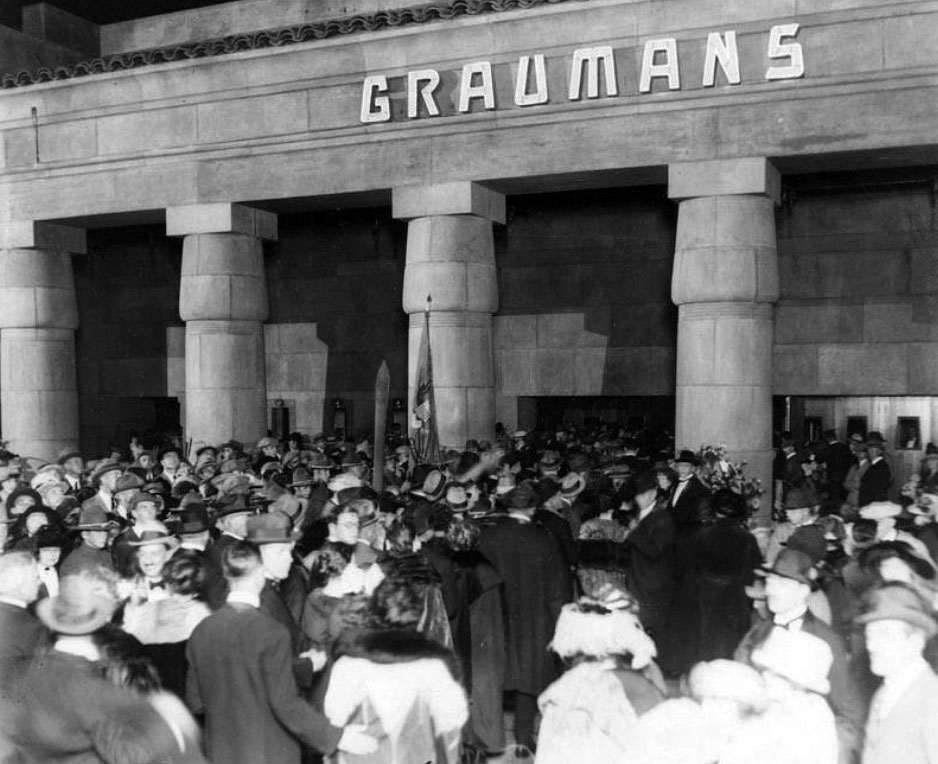 |
|
| (1922)^*^# - The Grauman's Egyptian Theatre on opening night. The film was Douglas Fairbanks' "Robin Hood," which was the first-ever Hollywood premiere. |
Historical Notes The Egyptian Theatre was the venue for the first-ever Hollywood premiere, Robin Hood, starring Douglas Fairbanks, on Wednesday, October 18, 1922. As the film reportedly cost over $1 million to produce, the admission price to the premiere was $5.00. One could reserve a seat up to two weeks in advance for the daily performances. Evening admission was 75¢, $1.00 or $1.50. The film was not shown in any other Los Angeles theater during that year.* The address 6712 Hollywood Boulevard, now the site of the Egyptian Theatre, was once the address of Gilbert F. Stevenson and his wife. In 1903, Stevenson, the Secretary and General Manager of the Western Masons Mutual Life Insurance Association, moved from downtown Los Angeles to a five acre lemon ranch on the corner of Prospect (now Hollywood Boulevard) and Dakota (now McCadden Place) Avenues.^#** |
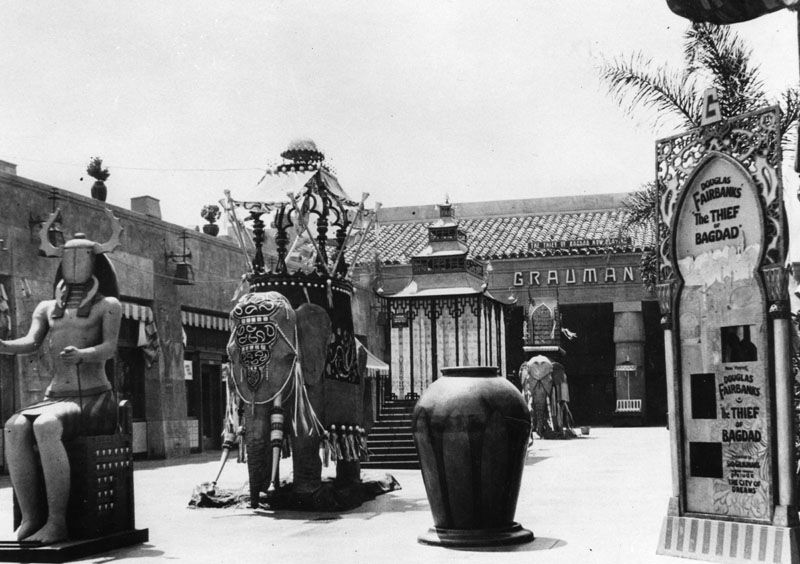 |
|
| (ca. 1923)* - A view of the courtyard of Grauman's Egyptian Theatre with statues of an Egyptian king, Indian elephants. Billboard advertising for Douglas Fairbanks "The Thief of Bagdad." |
Historical Notes King Tutankhamen’s tomb was discovered in Egypt on November 26, 1922 and an Egyptian craze swept the nation. |
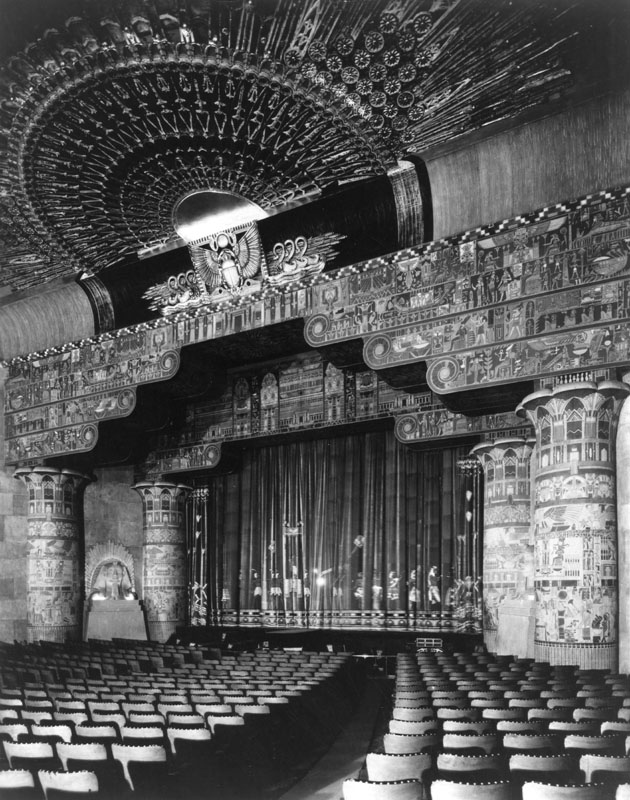 |
|
| (1922)* - Looking toward the stage across the seats in the auditorium, you can see the delicately carved arches around the stage as well as the ornate ceiling above it. |
Historical Notes Architects Meyer & Holler designed the Egyptian Theatre. The Milwaukee Building Company built it. |
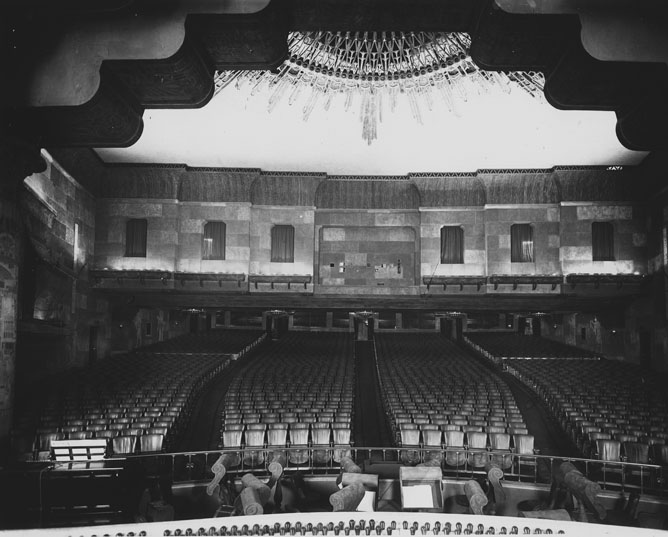 |
|
| (1924)* - Interior view of the Egyptian Theatre as seen from the stage. |
Historical Notes The original seating capacity of the theatre was close to 2,071 in a 115 by 125 foot auditorium. |
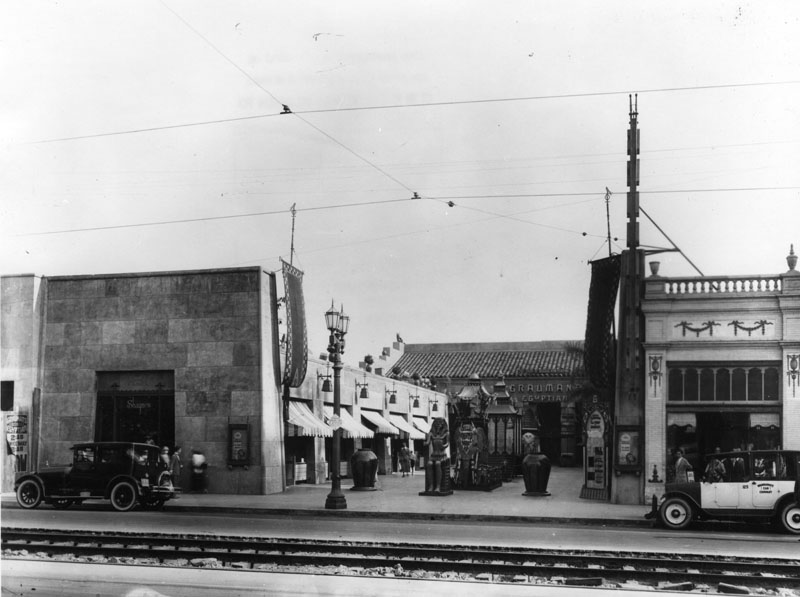 |
|
| (1924)* - View of the Grauman's Egyptian Theatre in 1924. Railroad tracks can be seen on Hollywood Boulevard in front of the theatre. |
Historical Notes The courtyard of the Egyptian is 45 feet wide and 150 feet long. The store fronts along the east side of the courtyard were described as having an "Oriental motif" and apparently sold imports. On the west side, the Pig ‘n Whistle restaurant, which opened on July 22, 1927 and operated until the late 1940s, had a side entrance onto the Egyptian Theatre courtyard. A small tiled area featuring the "pig ‘n whistle" motif still exists in the courtyard on the west wall near the fountain.^#** |
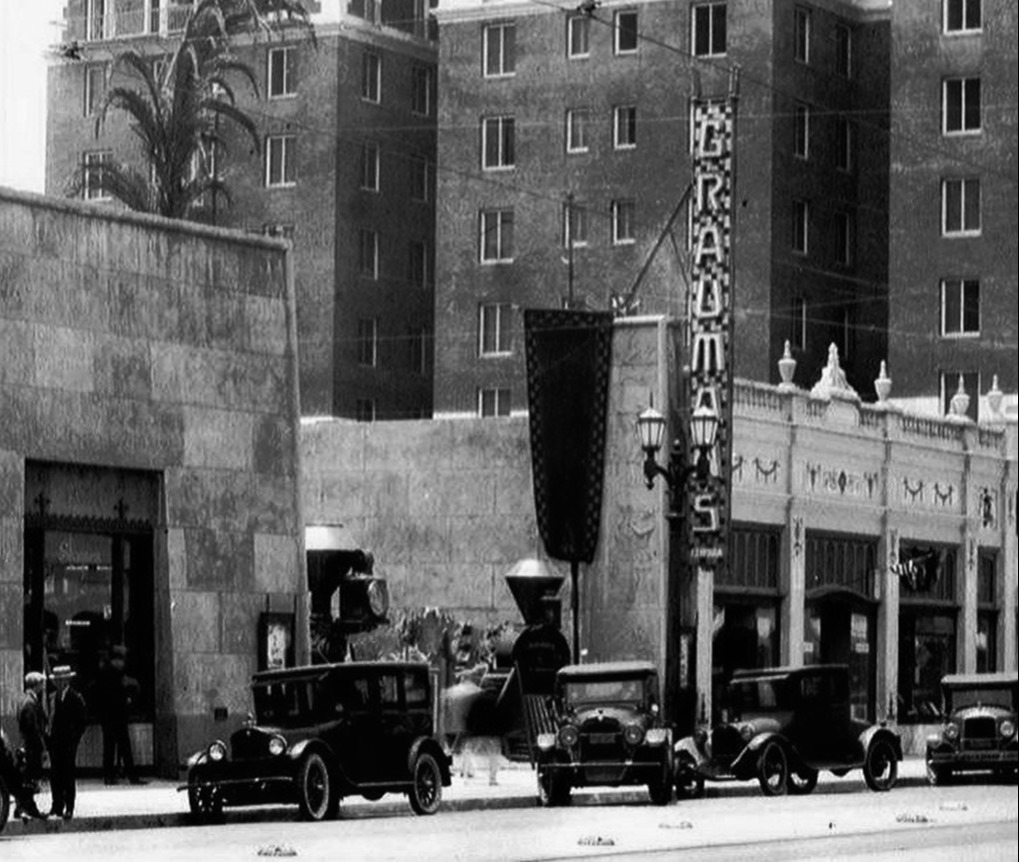 |
|
| (ca. 1924)* – Cars parked in front of Grauman’s Egyptian Theatre with the 1922-built Hotel Christie seen in the background. |
Historical Notes In 1927, Grauman would open a second movie theater further west on Hollywood Boulevard. In keeping with the public fascination in that era with international themes, he named his new theater the Chinese Theatre. Its popularity eventually rivaled and surpassed the Egyptian because of its numerous celebrity handprints, footprints and signatures in the cement of its forecourt.* |
 |
|
| (1932)*^#* – Postcard view of the front entrance to the Egyptian Theatre on Hollywood Boulevard. Now Playing: “Back Street” starring Irene Dunne and John Boles. |
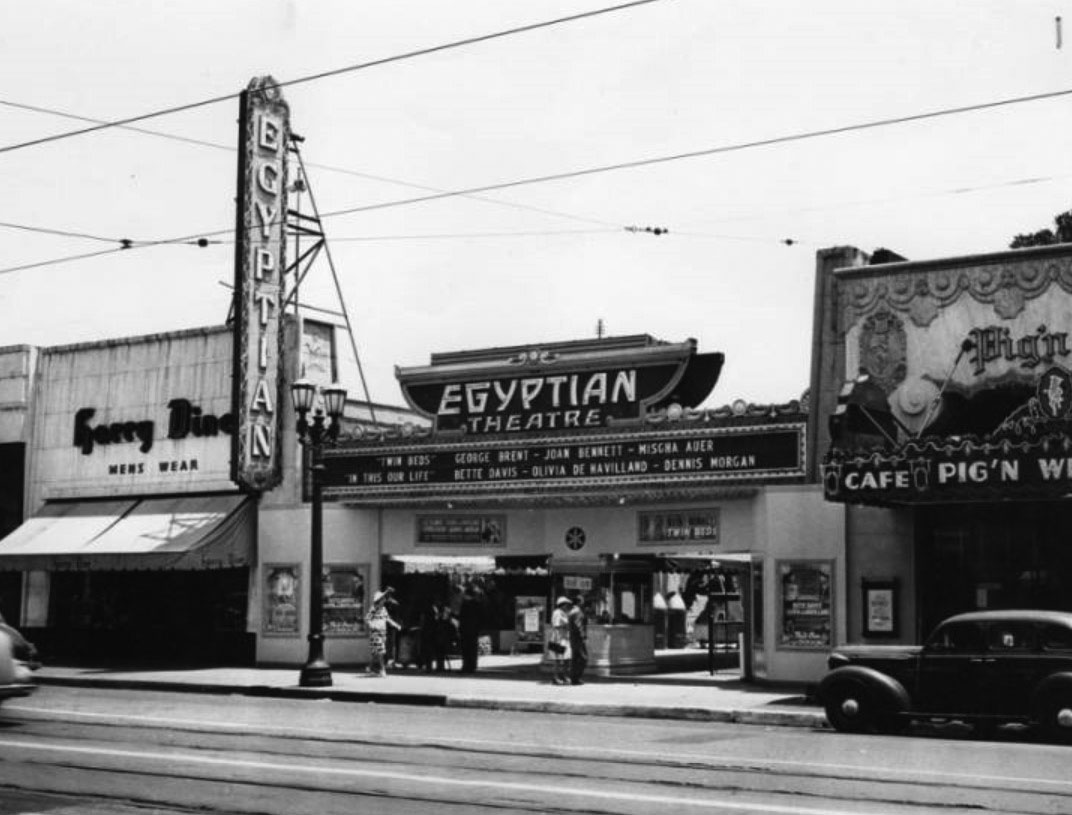 |
|
| (1942)* - View showing the entrance to the Egyptian Theatre with the Pig 'N Whistle Café seen on the right. The marquee reads: Twin Beds with George Brent, Joan Bennet, and Mischa Auer; and In This Our Life with Bette Davis, Olivia de Havilland, and Dennis Morgan. |
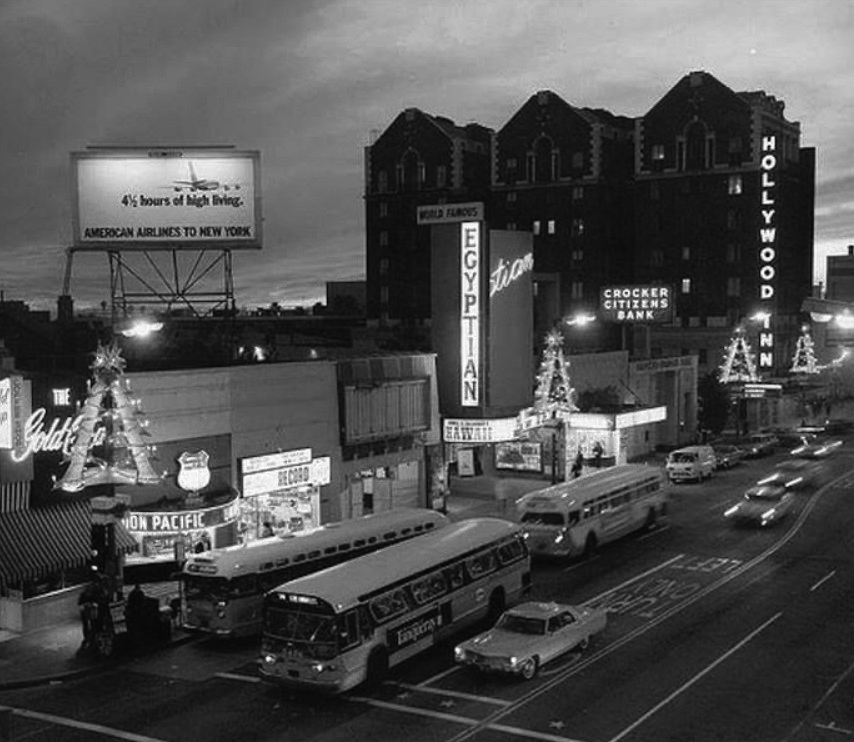 |
|
| (1966)#**^ – View looking southwest on Hollywood Boulevard from Las Palmas Avenue during the holiday season. The Egyptian Theatre is seen on the south side of the Boulevard with the Hollywood Inn (previously Hotel Christie and Drake Hotel) in the distance. |
Historical Notes As Hollywood declined in the 1980s and early 1990s, the Egyptian Theatre eventually fell into disrepair. In 1996, the city of Los Angeles sold the theatre to the American Cinematheque for a nominal one dollar with the provision that the landmark building be restored to its original grandeur and re-opened as a movie theatre. The Cinematheque committed to raising the funds to pay for the restoration and to using the renovated theatre as home for its programs of public film exhibition.^* |
.jpg) |
|
| (2014)#^^* – Google street view showing the Egyptian Theatre located at 6712 Hollywood Boulevard. |
Historical Notes The Egyptian Theatre was re-opened to the public on December 4, 1998, after a $12.8 million renovation. The original theatre seated 1760 patrons in a single auditorium. In the restored Egyptian the building has been reconfigured to add a second screening theatre. The main theatre now accommodates 616 patrons and is named after Los Angeles philanthropist Lloyd E. Rigler. The smaller, 77-seat theatre is named for Hollywood director Steven Spielberg.^* |
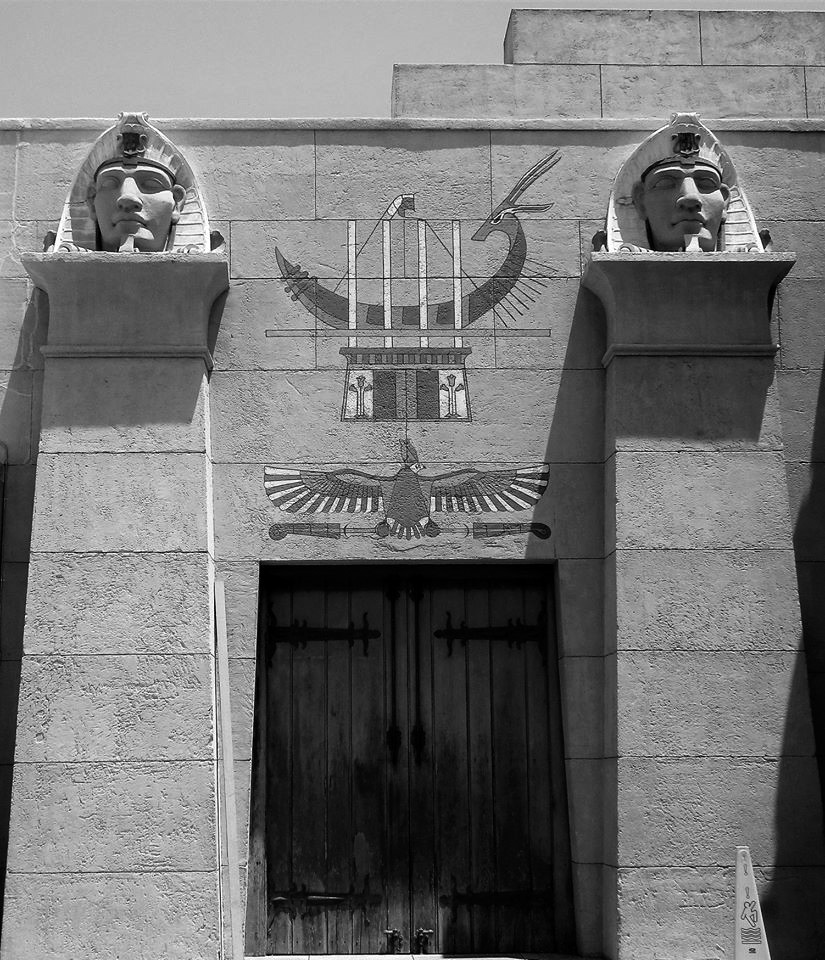 |
|
| (2020)^.^ - Grauman's Egyptian Theatre – Photo by Howie Gray |
Then and Now
 |
.jpg) |
|
| (1924)* vs. (2014)* - Egyptian Theatre |
Then and Now
 |
|
| (1922 vs 2020)* - Looking east on Hollywood Boulevard at McCadden Place showing the 1922-built Grauman’s Egyptian Theatre. |
* * * * * |
Guaranty Building
.jpg) |
|
| (ca. 1923)* – View showing the 12-story Guaranty Building designed by John C. Austin and Frederick Ashley, located on the northeast corner of Hollywood Boulevard and Ivar Avenue. |
Historical Notes The northeast corner of Ivar and Hollywood Blvd. has always occupied a special place in the social and economic history of Hollywood. Part of the original Hollywood ranch owned by Horace and Daeida Wilcox, the corner became the first permanent site of the First Methodist Church of Hollywood in 1910. The Guaranty Building and Loan Association paid the church $2000 per front foot for the site in 1923, and proceeded to erect the twelve story Guaranty Building, one of the first height-limit buildings on Hollywood Blvd. The owner and builder of the Guaranty Building was one of Hollywood's most prominent citizens. Gilbert Bessemyer was born in Hollywood on his father’s ranch in 1885. Gilbert, after attending public schools and the Normal School of Los Angeles, entered banking. By 1912 he was a director of the Hollywood National Bank and Citizens Savings bank. These were acquired by Security Trust and Savings (Security Pacific today). In 1919, and Beesemyer and a partner organized the Central Commercial Savings Bank (later known as the Bank of Hollywood). Beesemyer commissioned John C. Austin and Frederick Ashley to build the Guaranty Building. Classical Beaux Arts Buildings were popular from 1900 on for those businesses who wished to project a conservative image, primarily financial institutions.+^^ |
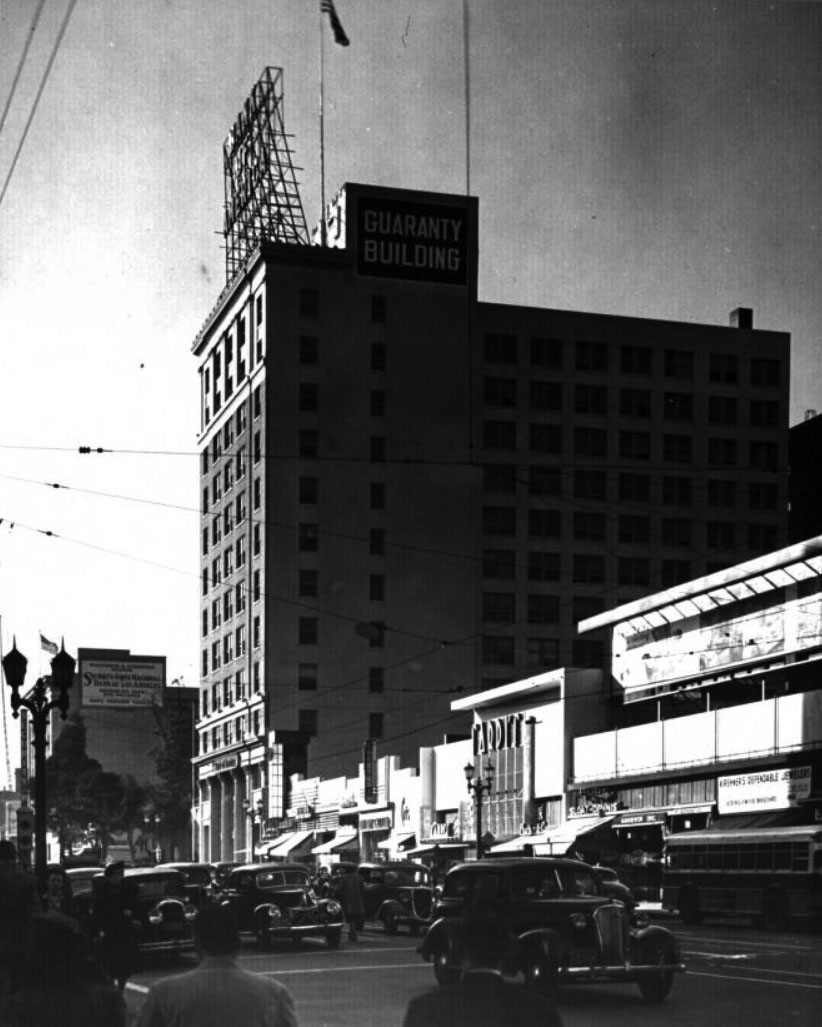 |
|
| (1939)^^ - Looking west on Hollywood Boulevard toward Cahuenga Boulevard. The 12-story Guaranty Building is the tallest in view. Sardi's Restaurant is at lower center-right. |
Historical Notes The complicated financial transactions of the film industry and a burgeoning real estate market had created a need for a number of financial services. Guaranty Savings took its place with other giants: Bank of America, Security Trust, and First Federal of Hollywood, among others. These and their smaller affiliates handled the investments of film moguls and citizens alike. |
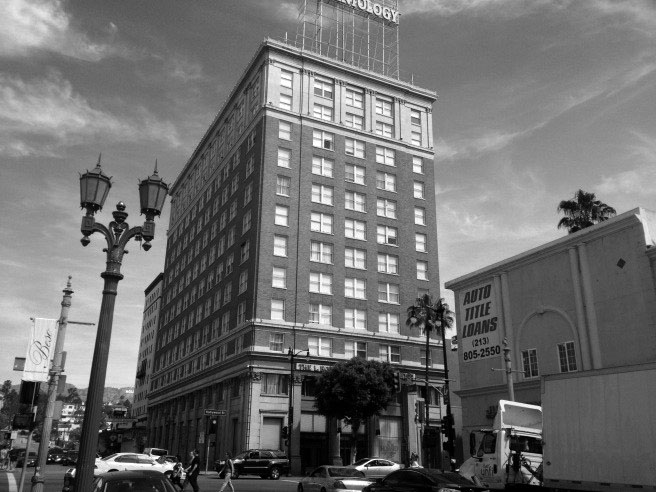 |
|
| (ca. 2016)*.* - View looking northeast on Ivar Avenue toward Hollywood Boulevard showing the Hollywood Guaranty Building located on the NE corner. Click HERE to see more contemporary street view. |
Historical Notes The twelve-story, Beaux Arts-style Guaranty Building (6331 Hollywood Blvd), designed by John C. Austin, was constructed in 1923. It was added to the National Register of Historic Places in 1979. In 1988 it was purchased by the Church of Scientology. |
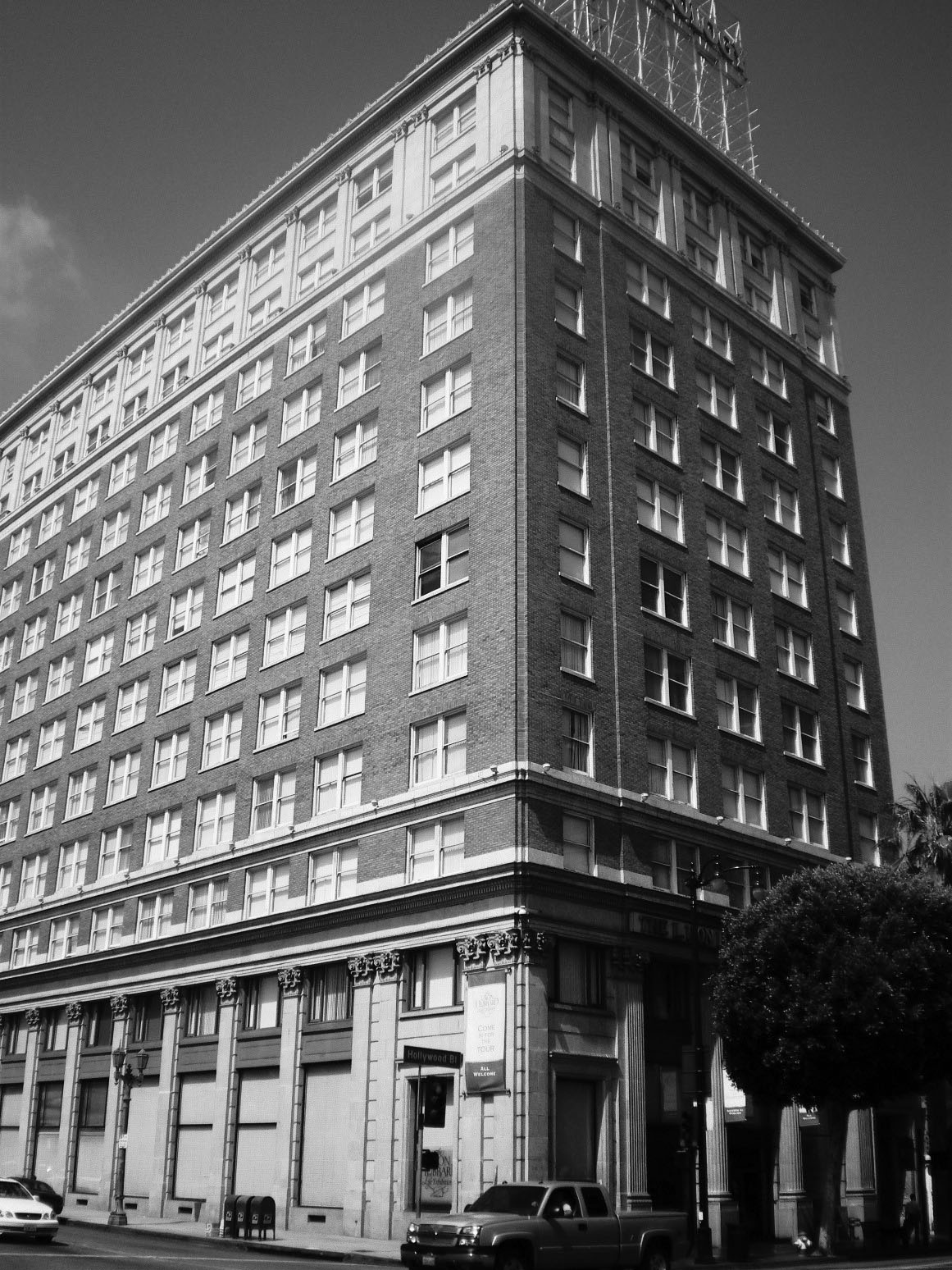 |
|
| (2008)^* – Close-up view of the Guaranty Building, located at 6331 Hollywood Boulevard in Hollywood. |
* * * * * |
Vista Theatre (originally Bard's Theatre)
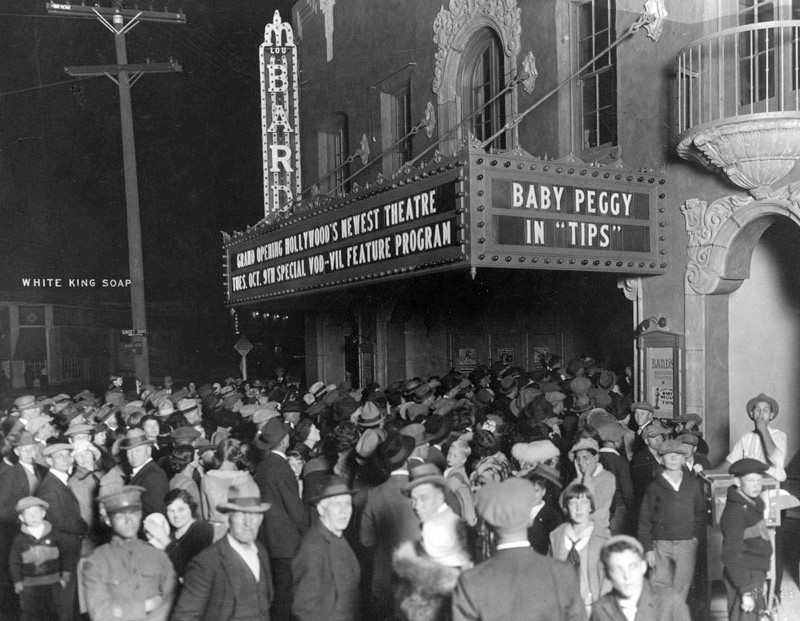 |
|
| (1923)* – View showing the opening of Bard’s Hollywood Theatre (later Vista Theatre), located at 4473 Sunset Drive in East Hollywood. Featuring Baby Peggy in "Tips". |
Historical Notes Bard’s Hollywood Theatre opened on October 16, 1923 with Baby Peggy in “Tips” plus vaudeville acts on stage. After the famous impresario Sid Grauman opened the Grauman's Egyptian Theatre in 1922, there appeared several movie palaces done in the Egyptian Revival Style in Los Angeles, Bard's Hollywood being one of the first; this wave of interest in Egyptian antiquities corresponded with the discovery of the tomb of King Tutankhamen in November 1922 by Howard Carter and the Earl of Carnarvon in the Valley of the Tombs near Luxor; their expedition electrified the world having recovered over 5000 relics, many composed of gold and alabaster; the theatre's exterior, done in the Spanish Colonial Revival Style, clashed notably with its Egyptian interior. * Architect: Lewis A. Smith |
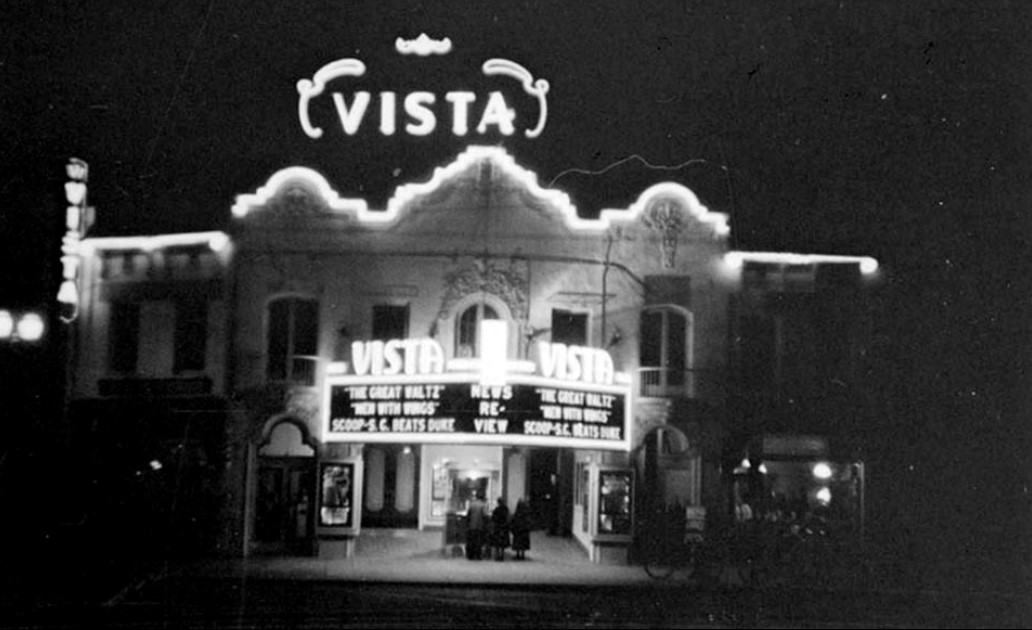 |
|
| (ca. 1938)* - Nighttime view of the Vista Theatre (previously Bard's Hollywood Theatre) with its new neon marquee. |
Historical Notes By the late 1920s, Bard's Hollywood Theatre became known as the "Vista." A new neon marquee was erected in 1938 for $1,000. * The Vista also features a variety of hand and foot prints in cement that commemorate some of the cast and crew members of films screened at the theatre. |
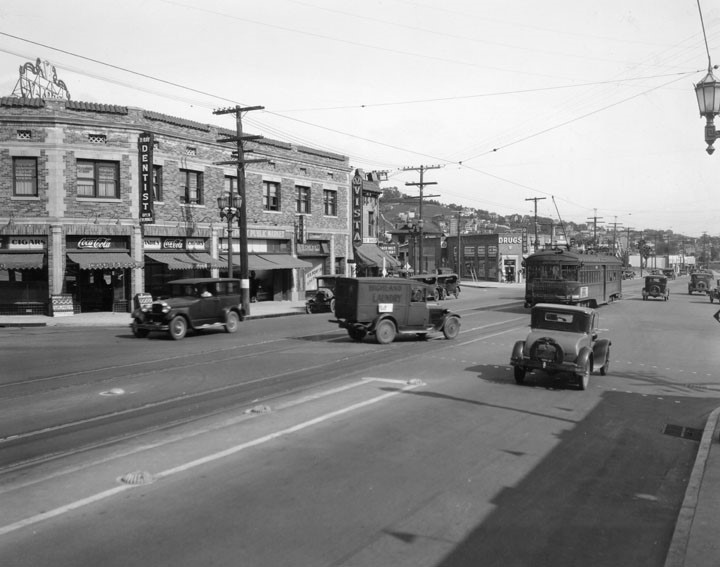 |
|
| (1930)* – View looking east showing the junction of Hollywood and Sunset. The marquee of the Vista Theater is visible at top center. |
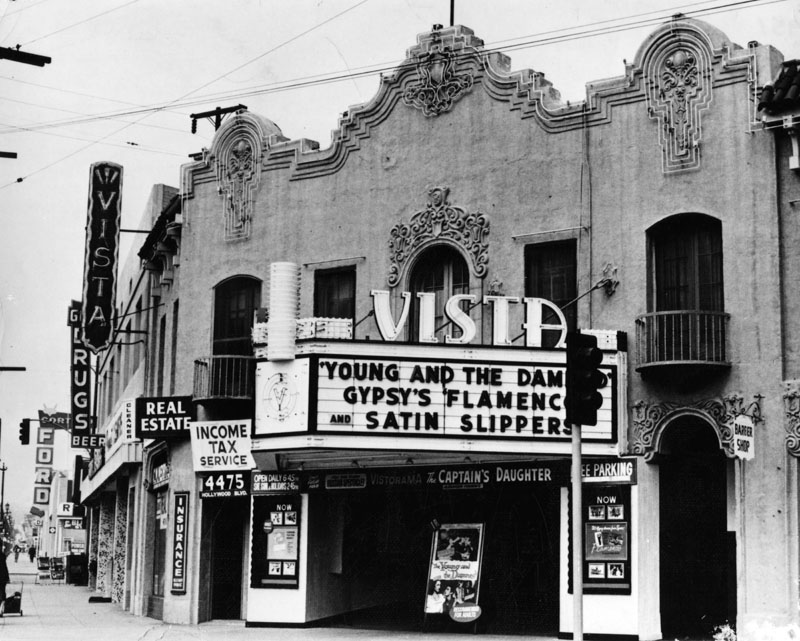 |
|
| (1951)* - View showing the Vista Theatre in East Hollywood, 4473 Sunset Drive. Note the architectural design details (Spanish Colonial Revival Style) on the face of the building. Architect: Lewis A. Smith. |
Historical Notes Alongside its elegant facade, the interior with its Egyptian designs is the true stunner at this old single screen palace. The original seating capacity in the auditorium held space for 838 seats. The owners later removed every other row to allow for increased legroom, reducing the number of seats to 400.^ |
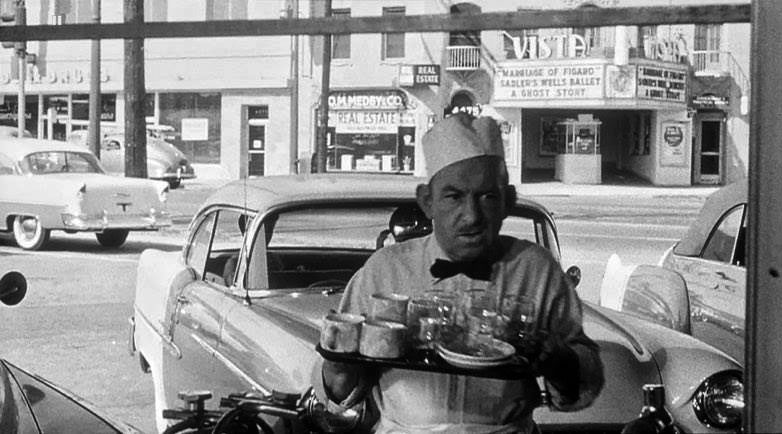 |
|
| (1955)* - A shot of the Vista Theatre from inside Stan's Drive-in Restaurant seen in "The Crooked Web" (Columbia, 1955). Thanks to Jonathan Raines for the screenshot. |
Historical Notes The Vista appears on the cover of Suicidal Tendencies' album Lights...Camera...Revolution! (1990). It also appears in the nighttime portions of the music video for Pharrell Williams's 2013 song "Happy", from the film Despicable Me 2. The theatre appears in the film True Romance (1993), as the place where Christian Slater's and Patricia Arquette's characters first meet. It also appears in the film The Crooked Web (1955), while the 'Walls of Babylon' scenes from D. W. Griffith's film Intolerance (1916) were filmed on the site before the theater was constructed. The Vista also appears in the made-for-television film Return to the Batcave: The Misadventures of Adam and Burt (2003).^ |
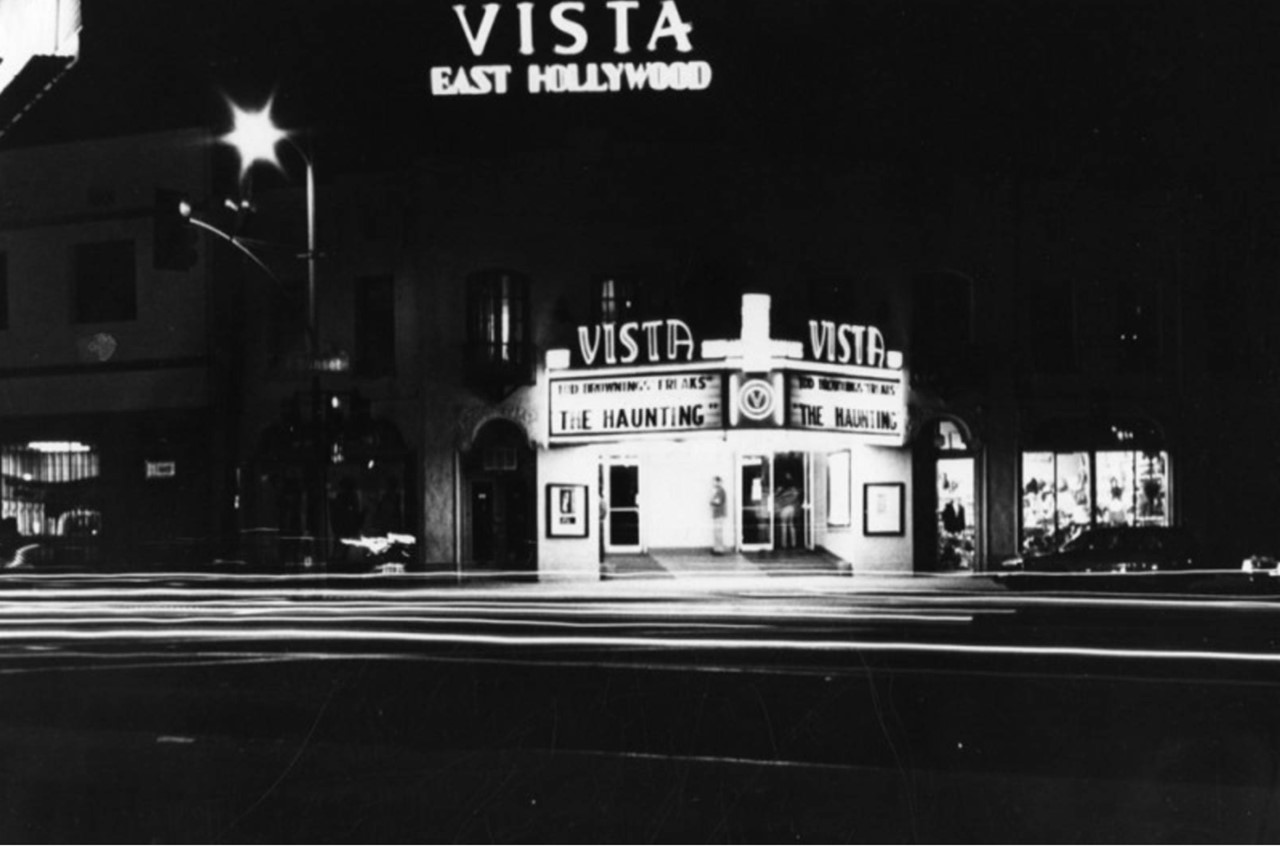 |
|
| (1970s)* - View of the front of Egyptian revival style Vista Theater taken at night. Stores to the side are dark except for a lighted window to the right and the front of the theater which is lit up. A sign high above is also lit and reads: Vista, East Hollywood. Film on marquee is The Haunting. Photo by Tom LaBonge. |
Historical Notes Until its refurbishment by Thomas Theaters in 1980, the theatre showed softcore pornography, then moved to hardcore porn and finally gay porn for 20 years. It also showed gay-oriented non-pornographic films, including the local premiere of The Times of Harvey Milk (1984).^ |
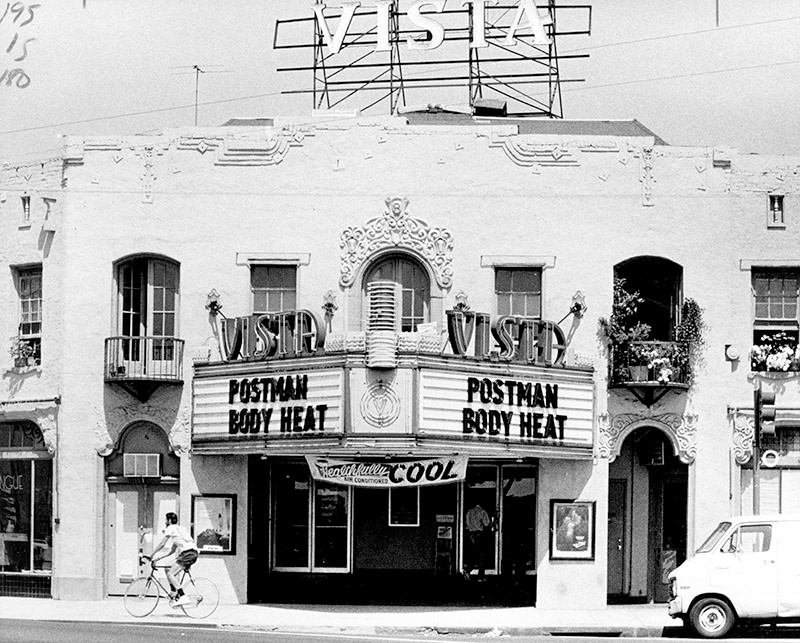 |
|
| (1980s)* - View showing a lone bicycle rider passing by the Vista Theatre. Now Playing: Postman and Body Heat. |
Historical Notes The Vista got a new screen in the early 1980s during the time it was owned by Landmark Theatres; at this time the theatre reverted to showing revival films. Landmark dropped the lease on the Vista in 1985.* |
 |
|
| (1983)* – Vista Theatre double feature: Romeo and Juliet & West Side Story |
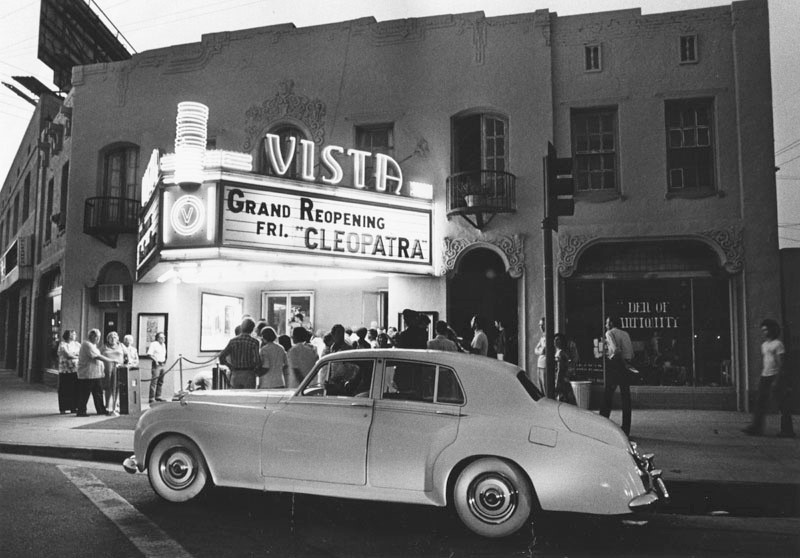 |
|
| (1980)* - A crowd of people stand at the entranceway awaiting the grand reopening of the Egyptian revival style Vista Theater, featuring the 1934 version of "Cleopatra." Silent-film star Mary MacLaren (1896-1985) helped re-open the Vista. Baby Peggy came back: In 1923 she opened the theater. |
Historical Notes In a manner reminiscent of Grauman's Chinese Theatre, the theater's forecourt features cement handprints and footprints of notable film figures. However, the handprints and footprints at the Vista Theatre tend to include more icons of independent and cult films such as Spike Jonze, John C. Reilly and Martin Landau, among many others.^ Click HERE for contemporary view of the Vista Theatre. In July 2021, director Quentin Tarantino revealed that he had purchased the theater. Tarantino has stated that the Vista will remain a first-run theater, and wherever possible, they will be screening 35mm prints. |
* * * * * |
Jensen's Recreation Center
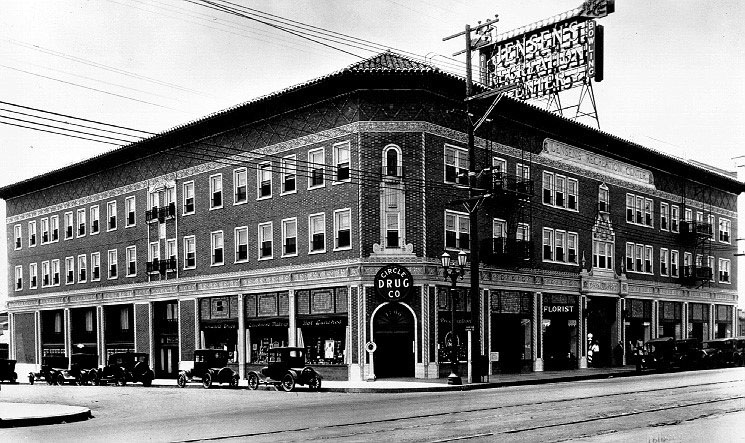 |
|
| (1924)^.^ – View looking at the SW corner of Sunset Boulevard and Logan Street showing Jensen’s Recreation Center. Note the large rooftop neon sign. Circle Drug Store occupies the corner space on the ground floor. A penny scale sits outside the front entrance of the store and a barbers pole sits just outside of the main Sunset Boulevard front building entrance that leads to a downstairs bowling alley and upstairs pool hall. Several model T’s are parked alongside and in front of the building. |
Historical Notes The Jensen Recreation Center was built by Henry Christian Jensen in 1924. It was one of several buildings constructed by Jensen in the course of a decade. Jensen was a German immigrant that made his fortune making bricks for the rapidly growing city of early 20th century Los Angeles. His business ventures often combined shopping and entertainment and were predecessors to today’s shopping malls or entertainment complexes such as Universal City Walk. Other Jensen ventures include Jensen’s Theatorium in Echo Park, now a grocery store; He also built Jensen’s Raymond Theatre in Pasadena, Palace Grand Theatre in Glendale, and Jensen’s Melrose Theater in East Hollywood. |
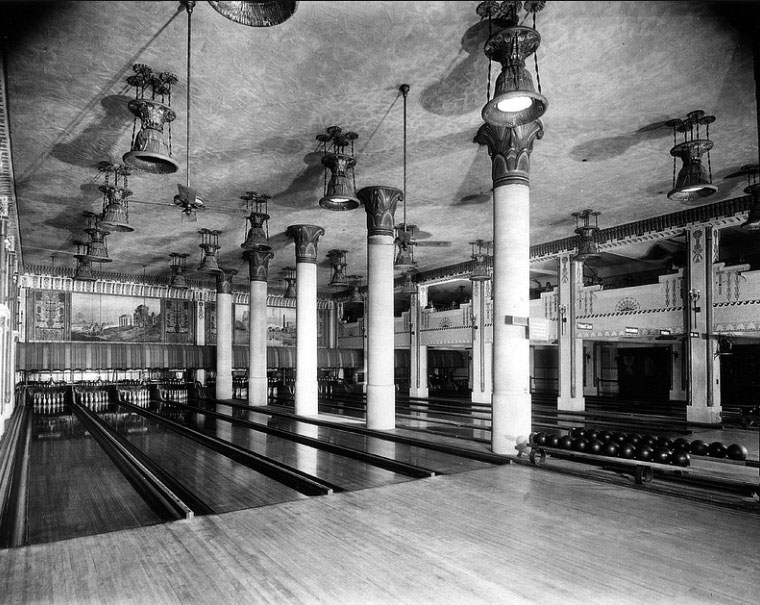 |
|
| (ca. 1929)^*# - Interior view of the bowling alley within the Jensen's Recreational Center complex showing ornate Beaux Arts/Italianate style capitals above pillars along center of room, tile trim below ceiling, mural scenes above bowling pins (center left), and bowling balls at right. |
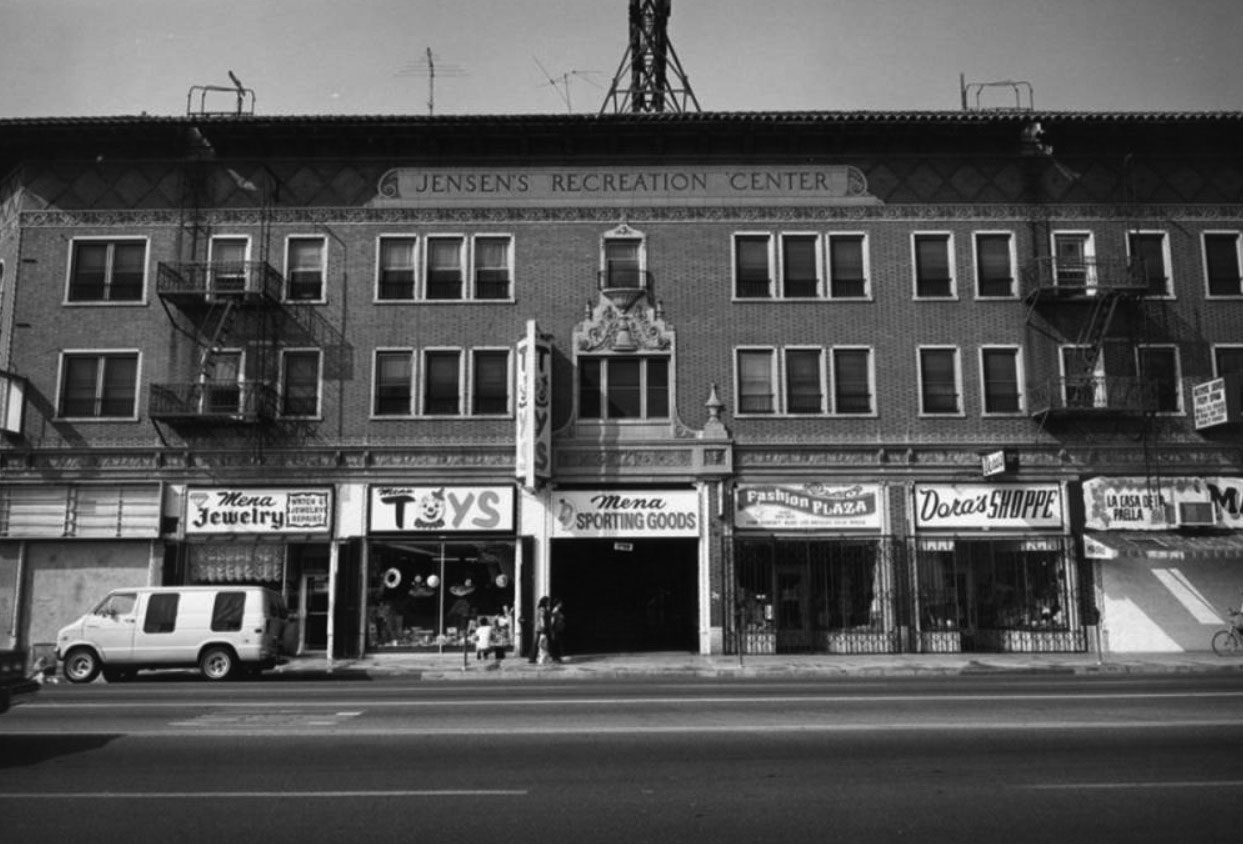 |
|
| (1981)* - Various retail stores are shown in a building named Jensen's Recreation Center located at 1706 W. Sunset Boulevard in the Echo Park section of Los Angeles |
Historical Notes Originally, the three-story Jensen’s Recreation Center had a row of shops, a bowling alley, and a pool hall at street level, and 46 apartments on the top two levels. The recreation center often hosted celebrity athletic events and continued to do so until it closed in the 1970's. The building was declared Los Angeles Historic Cultural Monument No. 652 in 1998. |
Then and Now
 |
|
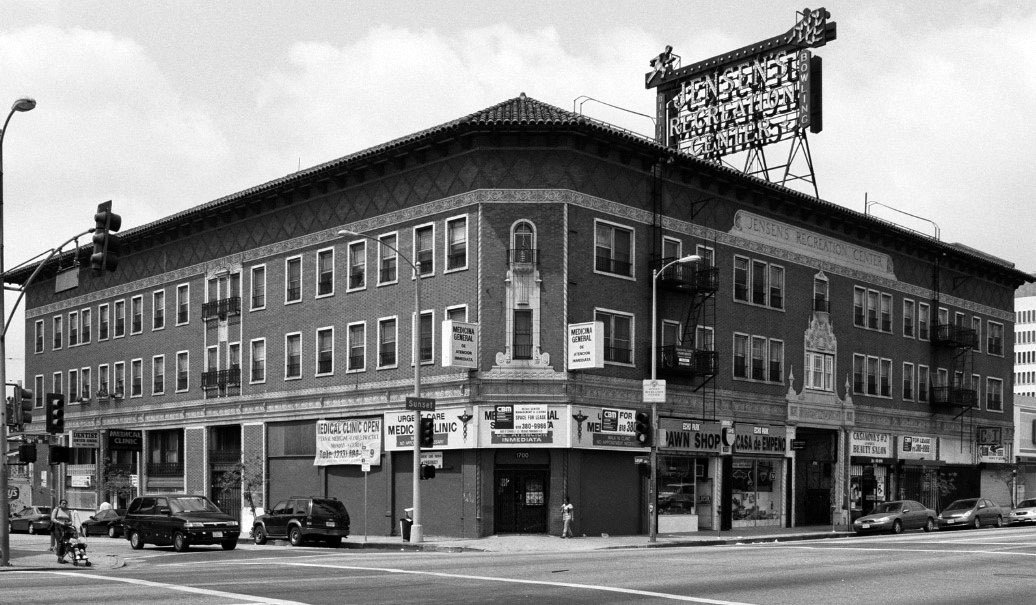 |
|
| (1924) vs. (2008)^ - Jensen's Recreation Center, 1700 W. Sunset Boulevard. |
Historical Notes In 2004 Sebren Development purchased the building and remodeled it. The bowling alley no longer exists, except for at least one 50 ft mural depicting an Egyptian landscape. The bowling alley space has been remodeled and commercially leased. Additionally, the apartments were remodeled. In 2013 a 500 sq. ft. studio apartment was renting for $1,025 / month (with utilities). Probably the most striking change was the 1997-2005 rehabilitation of the 17' x 28' incandescent sign atop the building (which uses animated lighting to depict a bowler throwing a strike). Restored through a County Historic Preservation Society grant (and other private funds) the sign is rarely lit (as it uses 1,300 incandescent bulbs). There is also colored lighting (under the eaves) which appears to have been abandoned.* |
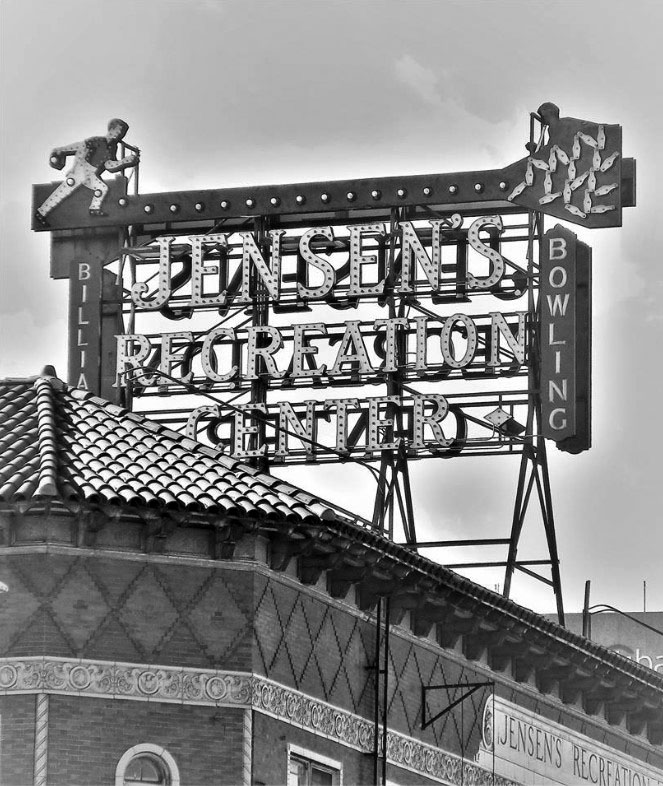 |
|
| (2019)^.^ - Close-up view showing the iconic rooftop sign on Jensen’s Recreation Center building. Photo by Howard Gray |
Historical Notes In 1998, the Jensen’s Recreation Center and Electric Roof Sign were designated LA Historic-Cultural Monument No. 652. |
* * * * * |
Beverly Theater (Beverly Hills)
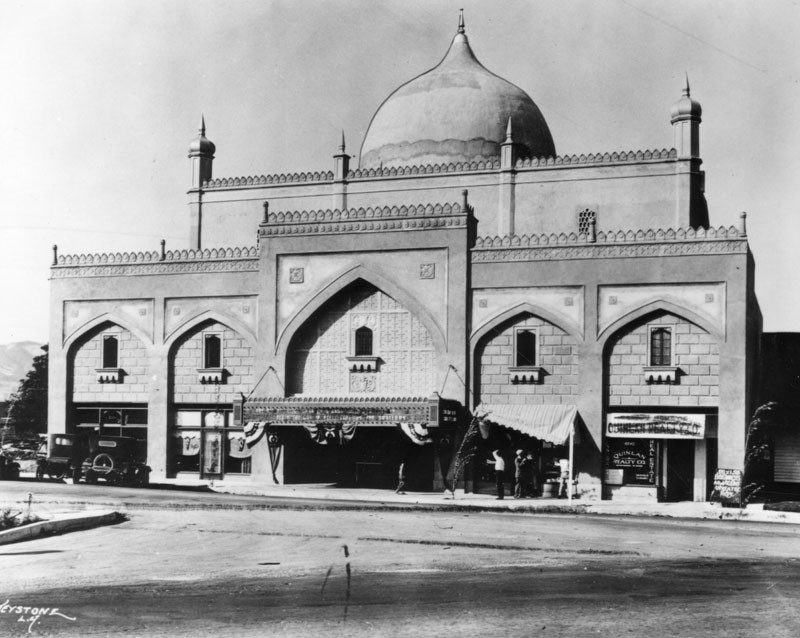 |
|
| (1925)* – View showing the newly built Beverly Theater located at 206 N. Beverly Drive. Its grand opening was May 18th, 1925. |
Historical Notes Designed by L.A. Smith in a style inspired by The Tomb of Second Mughal Emperor Humayun, Delhi 1880's. This was the first vaudeville and movie theater in Beverly Hills. It was built for Beverly Hills real estate mogul Daniel Quinlan.* There was retail on the ground floor and two studios on the 2nd floor. The south storefront was occupied by Daniel Quinlan's real estate office. The Quinlan family owned the building until 1936 when it got traded for property behind the Beverly Hills hotel. |
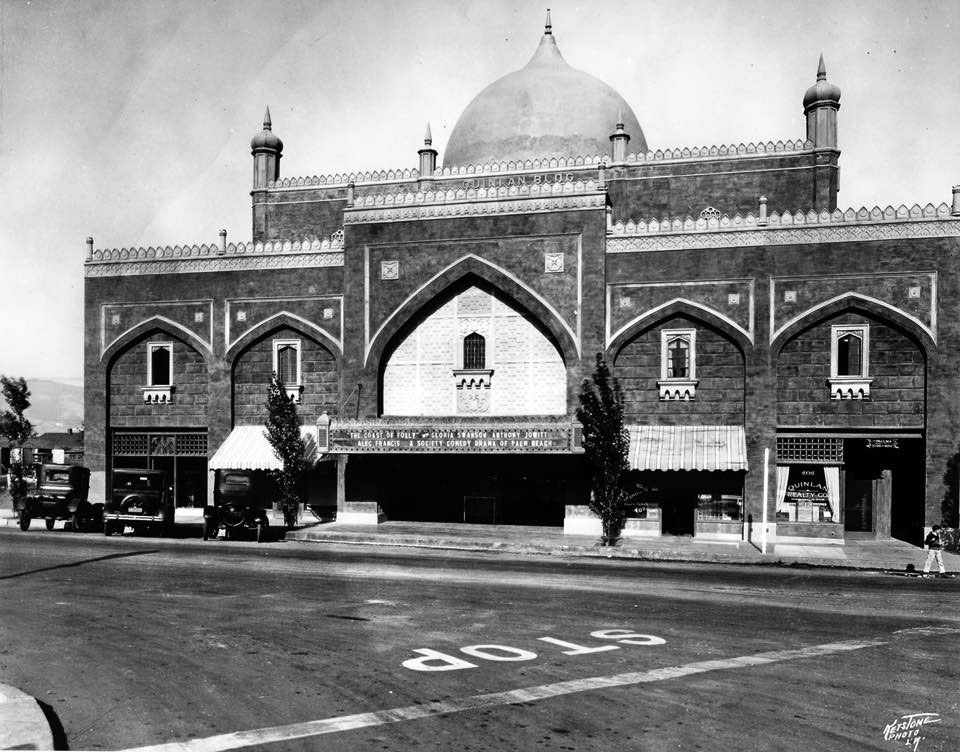 |
|
| (1920s)* – View showing the Beverly Theater designed in the Indo-Chinese style and topped with an onion tower. |
Historical Notes The theater was initially operated by West Coast Theatres as the West Coast Beverly. When the chain became Fox West Coast in 1929 the theatre was called the Fox Beverly. It stayed in the circuit until the late 50s and had a whole series of other operators: Amusement Corp. of America, Statewide, Loew's (as Loew's Beverly) and General Cinema. |
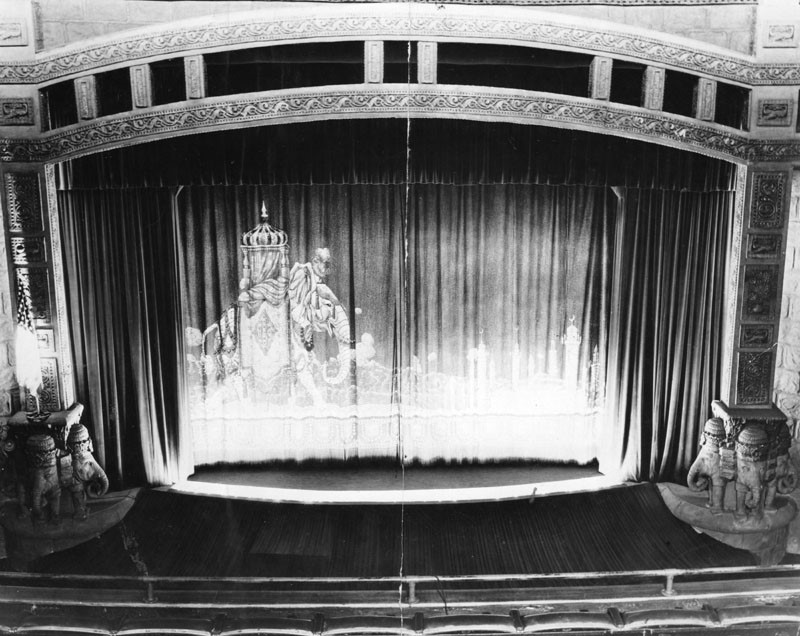 |
|
| (1940)* - Auditorium and stage area of the Beverly Theater. Carved elephants decorate the bottom of pillars on either side of the stage, and this motif is continued on the stage curtain. |
Historical Notes The Beverly Theater had a huge Wurlitzer Orchestral pipe organ. When it opened the theater also had an eight-piece orchestra as part of the house staff. |
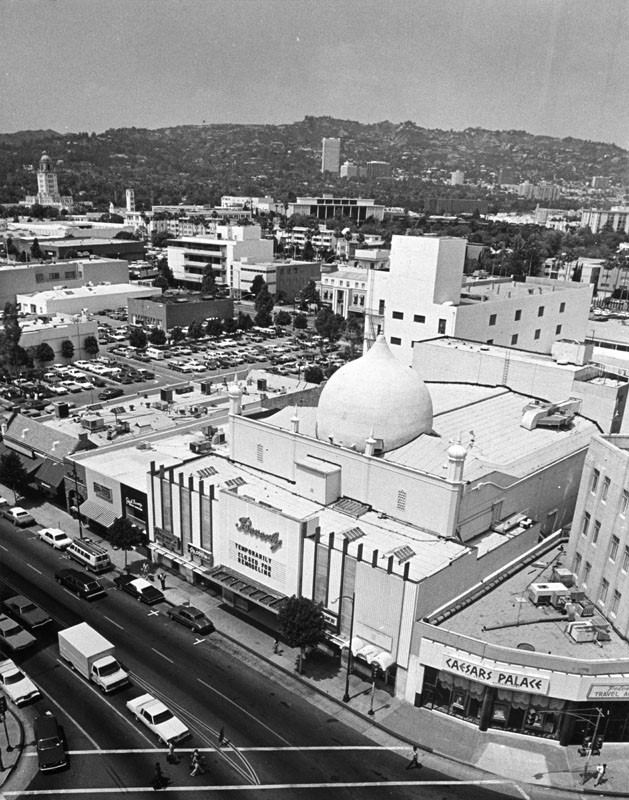 |
|
| (1970s)* - Aerial view of Beverly Hills with the domed Beverly Theater in the foreground at the intersection of Beverly Drive and Wilshire Boulevard. |
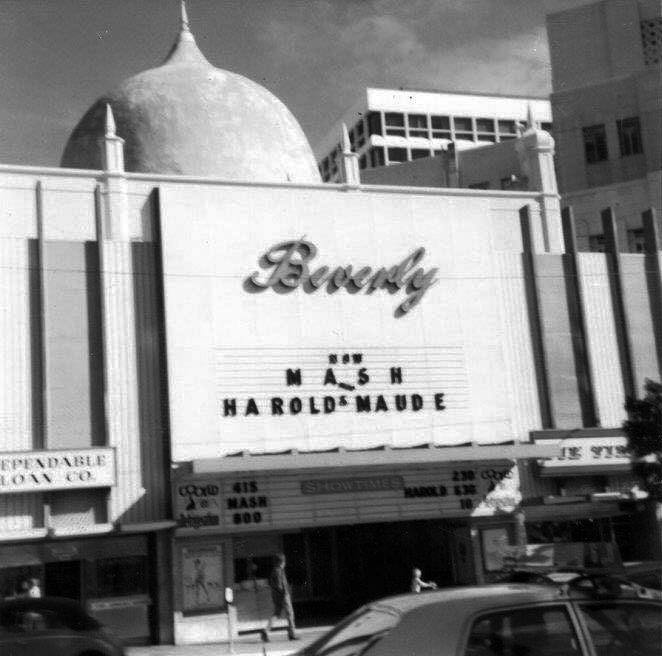 |
|
| (1974)* – Front view of the Beverly Hills Theater with a double feature showing "MASH" and "HAROLD & MAUDE". |
Historical Notes In the mid-1970’s, Beverly Hills had a number of theaters. But with the noise & traffic generated by such films as “Tommy”, “Woodstock”, and others, local citizens began to complain. Responding to these local complaints, General Cinemas closed the theater in 1977. |
.jpg) |
|
| (1978)* - Evening view of the Moorish style structure, located at 206 N. Beverly Drive in Beverly Hills, originally known as the Beverly Theater; a Christmas garland hangs from above. |
Historical Notes In 1977, after decades of serving as a movie house, the building was closed. The interior was gutted and redesigned to accommodate commercial use; it was occupied by Fiorucci, a boutique and later an Israeli bank.* |
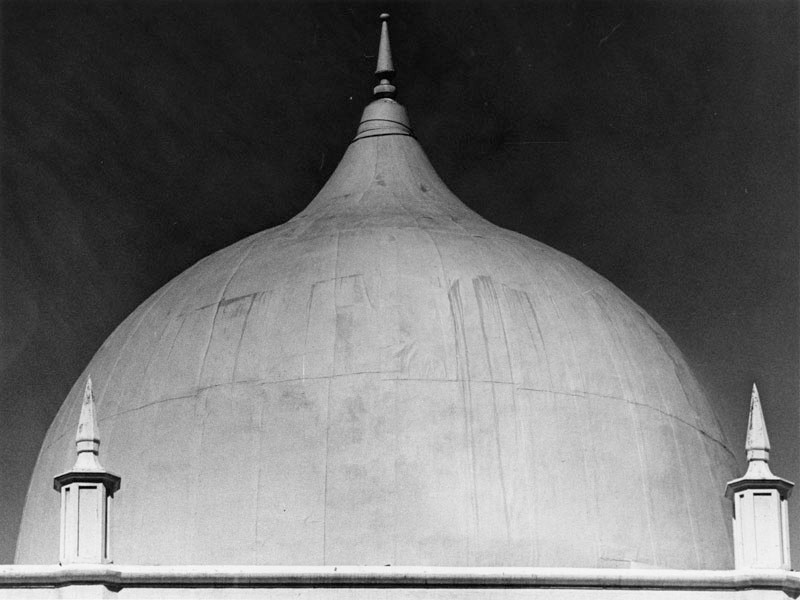 |
|
| (1978)* - Close-up view showing the dome of the old Beverly Theatre, at time of photo a bank. |
Historical Notes After many years of housing a bank, the Beverly Theater was sadly demolished in August of 2005 to make way for new development. The onion dome ... brings to mind Beverly Hills' temporary original name, "Morocco". Click HERE to see more in Early Views of Beverly Hills. |
* * * * * |
Farmers and Merchants National Bank
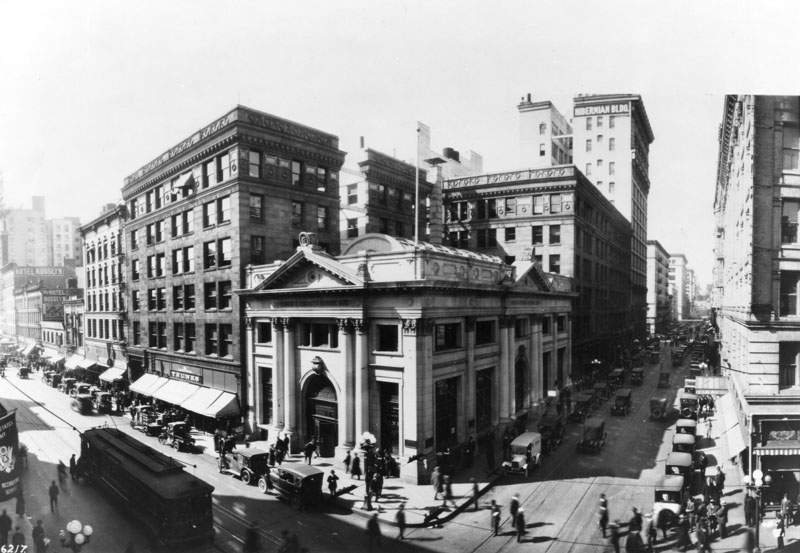 |
|
| (1923)* - Exterior view of Farmers and Merchants National Bank of Los Angeles, located at the southwest corner of 4th and Main Streets. Note the architectural designs on the building. |
Historical Notes Designed in the Classical Revival style, the Farmers and Merchants Bank remains one of Southern California's finest examples of the early "temples of finance" which were popular at the turn of the century. Its two-story facade, reminiscent of a Roman temple, is punctuated by an entrance framed with Corinthian columns topped by a large triangular pediment. Built in 1905, the bank was designed by the firm of Morgan and Walls. The Farmers and Merchants Bank was the first incorporated bank in Los Angeles, founded in 1871 by 23 prominent Los Angeles businessmen, with an initial capital of $500,000. The three largest subscribers were Isaias W. Hellman ($100,000), former California Governor John G. Downey ($100,000), and Ozro W. Childs ($50,000) who in later years became the founders of the University of Southern California. Other investors included Charles Ducommun ($25,000), I.M. Hellman ($20,000) and Jose Mascarel ($10,000.) Downey was named the first president. Isaias later served as president of the bank till his death in 1920.^* Click HERE to see more Early Views of the Farmers and Merchants Bank. |
* * * * * |
Biltmore Hotel
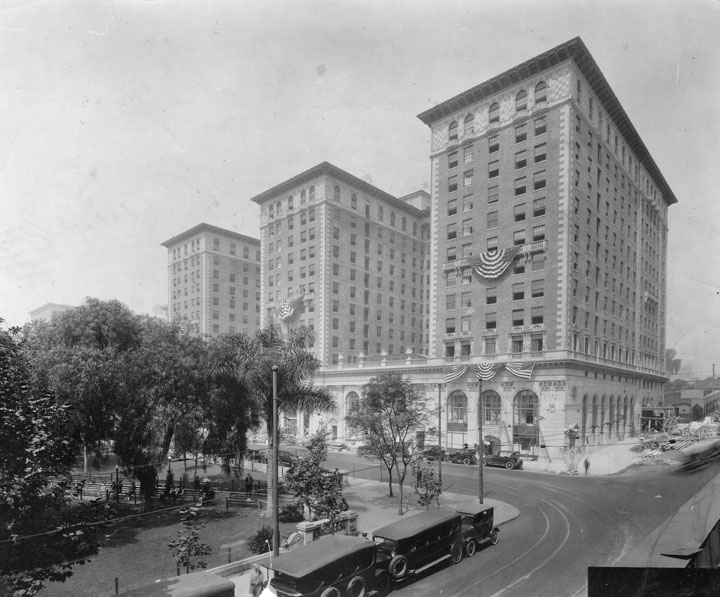 |
|
| (1923)* - People sit in Pershing Square while across the street flag decorated banners hang from the still unfinished Biltmore Hotel. The view at the corner of 5th and Olive shows building materials on the 5th St. side of the hotel. |
Historical Notes The Los Angeles Biltmore Hotel opened in 1923. With it's 1,500 guest rooms, it was the largest hotel west of Chicago. |
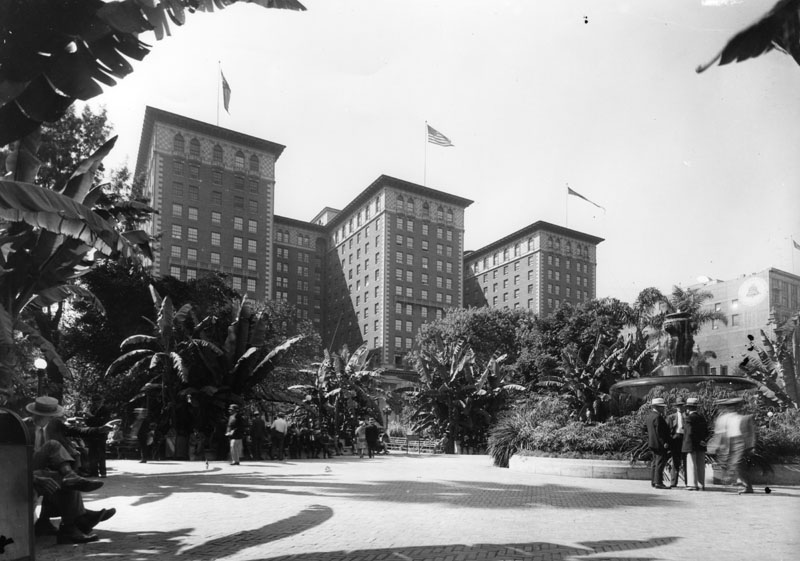 |
|
| (ca. 1923)* - View of the three towers of the Biltmore Hotel at 515 South Olive Street, as seen from the center plaza of Pershing Square. |
Historical Notes The architectural firm Schultze & Weaver designed the Biltmore's exterior in a synthesis of the Spanish-Italian Renaissance Revival, Mediterranean Revival, and Beaux Arts styles, meant as an homage to the Castilian heritage of Los Angeles. The "Biltmore Angel" is heavily incorporated into the design—as a symbol of the city as well as the Biltmore itself. With a thick steel and concrete frame, the structure takes up half a city block and rises over 11 stories. |
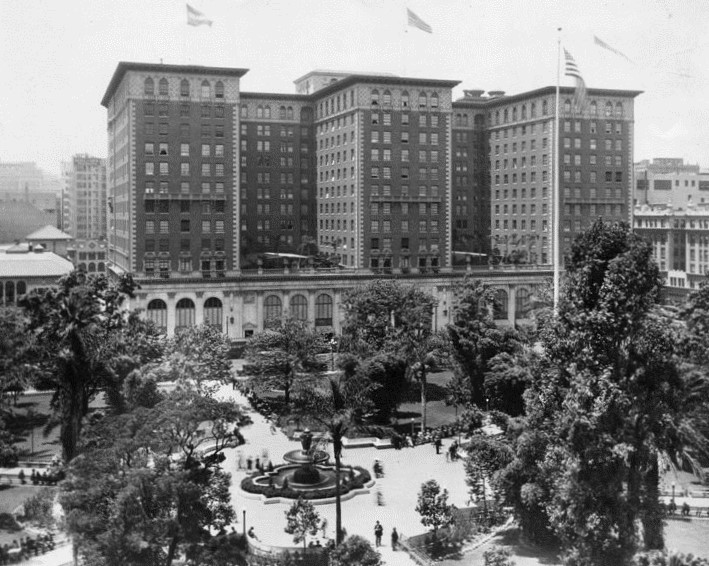 |
|
| (1920s)* - People, fountain, trees and bushes of Pershing Square are in the foreground, while the Biltmore Hotel and Biltmore Garage are in the background across Olive Street. |
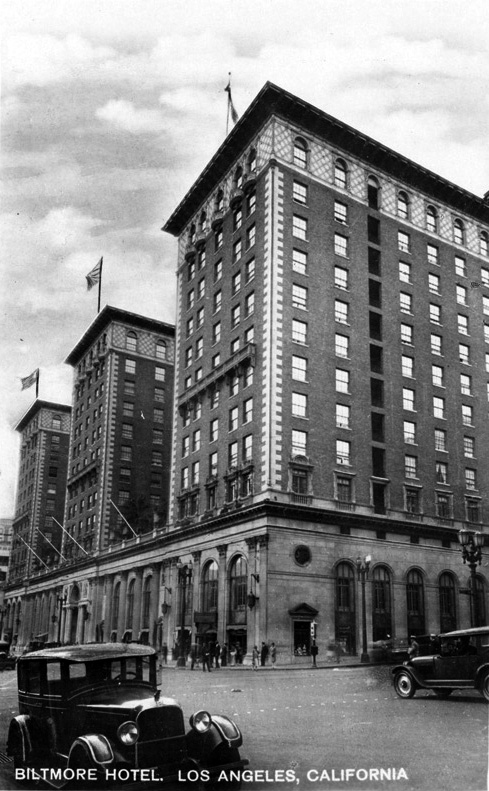 |
|
| (ca. 1930)^*# - View of Biltmore Hotel on the corner of 5th Street and Olive. |
 |
|
| (1940s)* - View showing the ornate lobby of the Biltmore Hotel. |
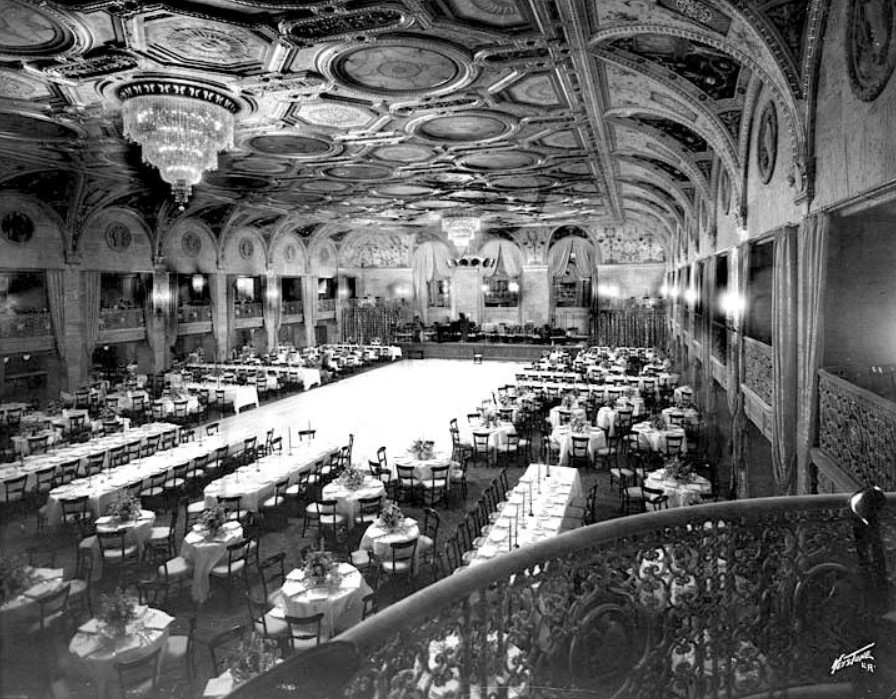 |
|
| (ca. 1930s)^ – View showing the two-story tall Biltmore ballroom (Biltmore Bowl), home to eight Oscar ceremonies. |
Historical Notes Originally called the Sala de Oro and later renamed the Biltmore Bowl, the ballroom was a vast and sumptuous space two stories tall and played host to eight Oscar ceremonies in the 30s and early 40s. In the 1950s, it suffered a devastating fire and was not rebuilt. In its place, the hotel built two smaller ballrooms.^ |
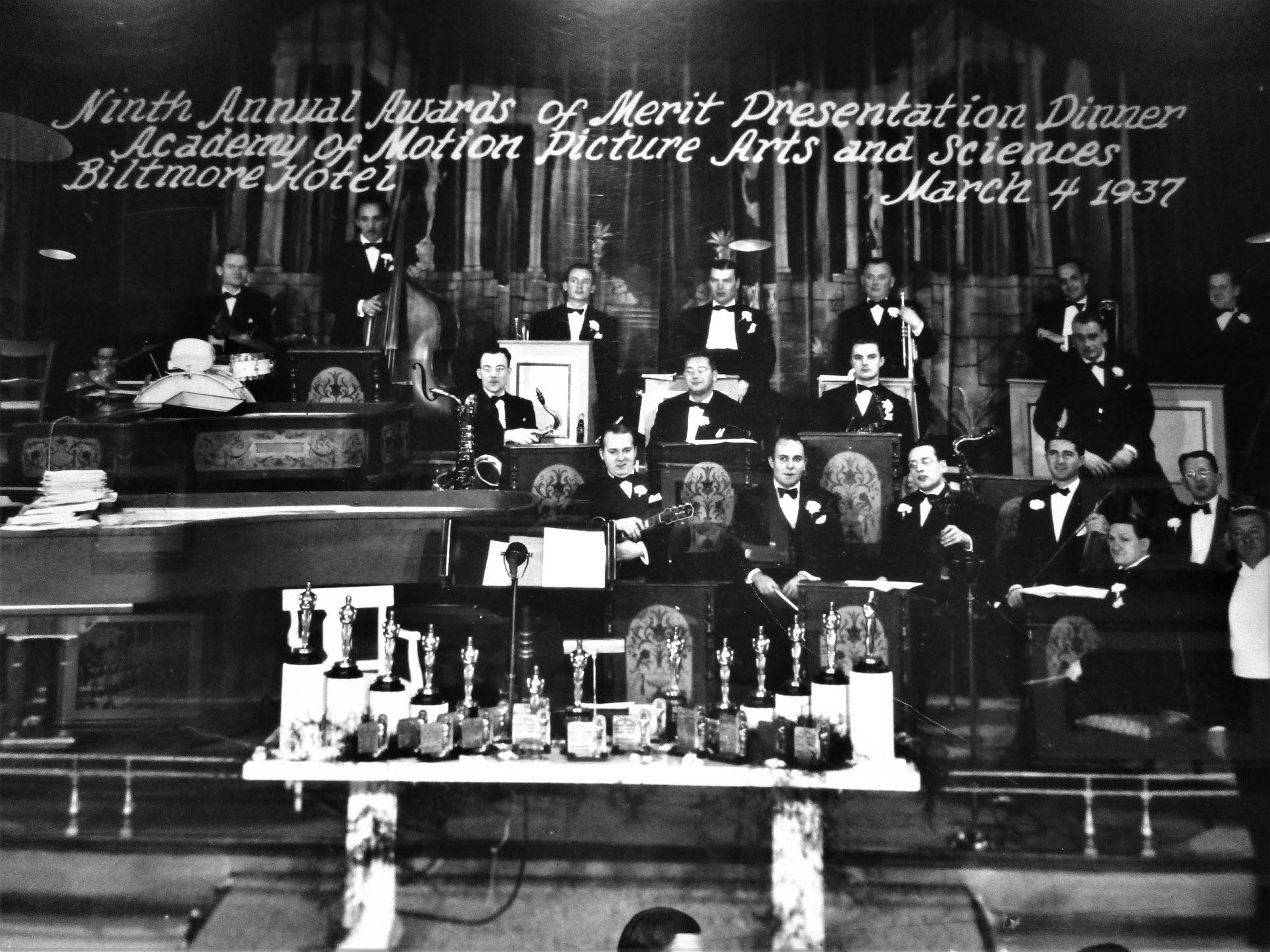 |
|
| (1937)^ – 9th Annual Awards of Merit Presentation Dinner, Academy of Motion Picture Arts and Sciences, Biltmore Hotel. This photo hangs in the Biltmore Hotel. |
Historical Notes The Los Angeles Biltmore is known for being an early home to the Academy Award Ceremony for the Oscars. The Academy of Motion Picture Arts and Sciences was founded at a luncheon banquet in the Crystal Ballroom in May 1927, when guests such as Louis B. Mayer met to discuss plans for the new organization and presenting achievement awards to colleagues in their industry. Legend has it that MGM art director Cedric Gibbons, who was in attendance, immediately grabbed a linen Biltmore napkin and sketched the design for the Oscar statue on it. Eight Oscar ceremonies were held in the Biltmore Bowl during the Academy's early years of 1931, 1935–39, and 1941-42. In 1977 Bob Hope hosted the Academy's 50th Anniversary banquet in the same room. |
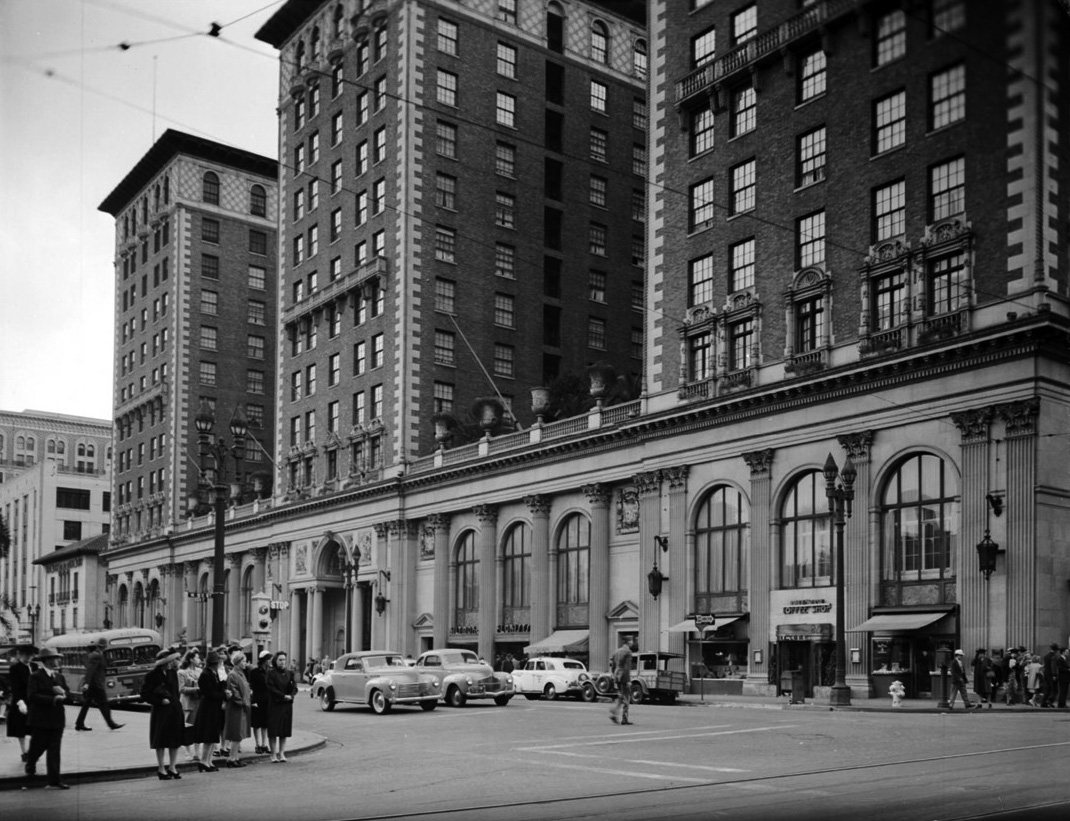 |
|
| (1943)* – The Biltmore Hotel as seen from the intersection of Olive and 5th Street. Note that the top of the streetlights are blacked-out (during WWII). |
Historical Notes During the War many streetlights throughout the City were blacked-out on top as a preventative measure. Click HERE to see more. |
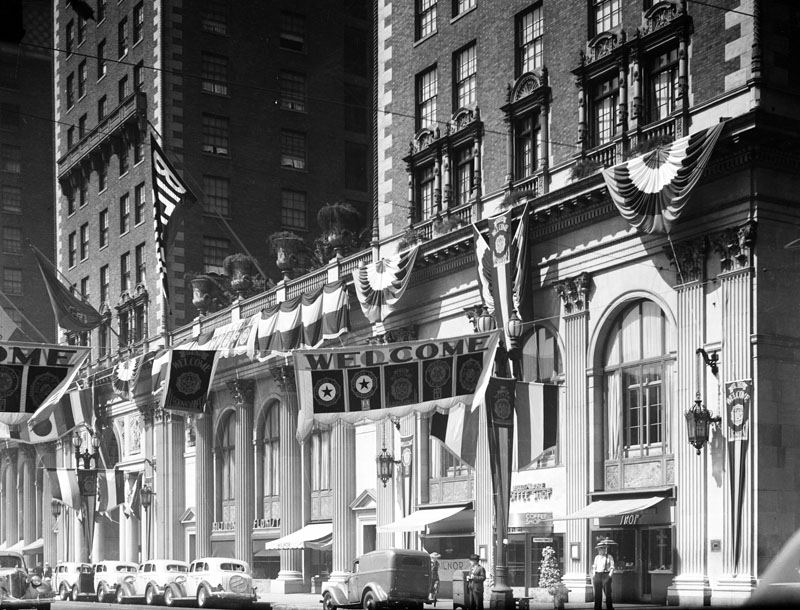 |
|
| (1940s)* - View of the lower eastern facade and entrance of the Biltmore Hotel, located at 515 South Olive Street. Buntings and a banner welcome visiting groups. |
Historical Notes In 1969 the Biltmore Hotel was designated a Los Angeles Historic-Cultural Monument No. 60 by the City of Los Angeles. Click HERE to see the LA Historic-Cultural Monument List. As of 2009, the Los Angeles Biltmore is operated as part of the Millennium & Copthorne Hotels chain as the Millennium Biltmore Hotel. From its original 1500 guestrooms it now has 683, due to room reorganization.^* |
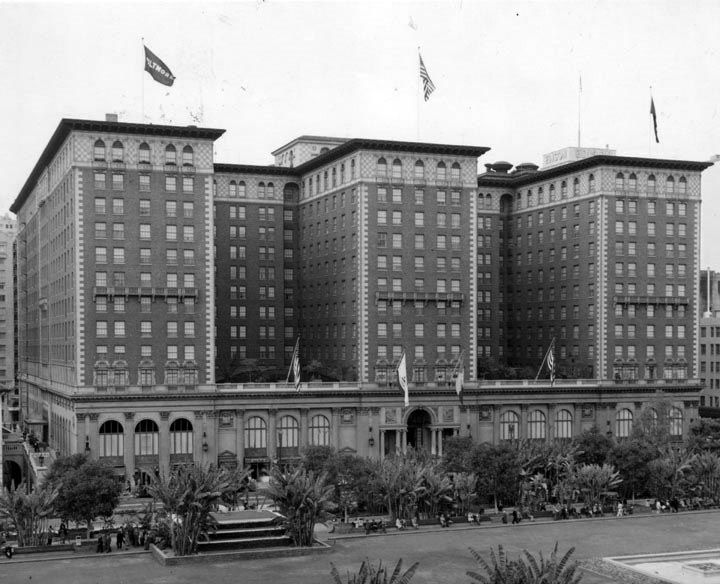 |
|
| (1950)* – View showing the Biltmore Hotel with a line of trees along the Olive Street side of Pershing Square. |
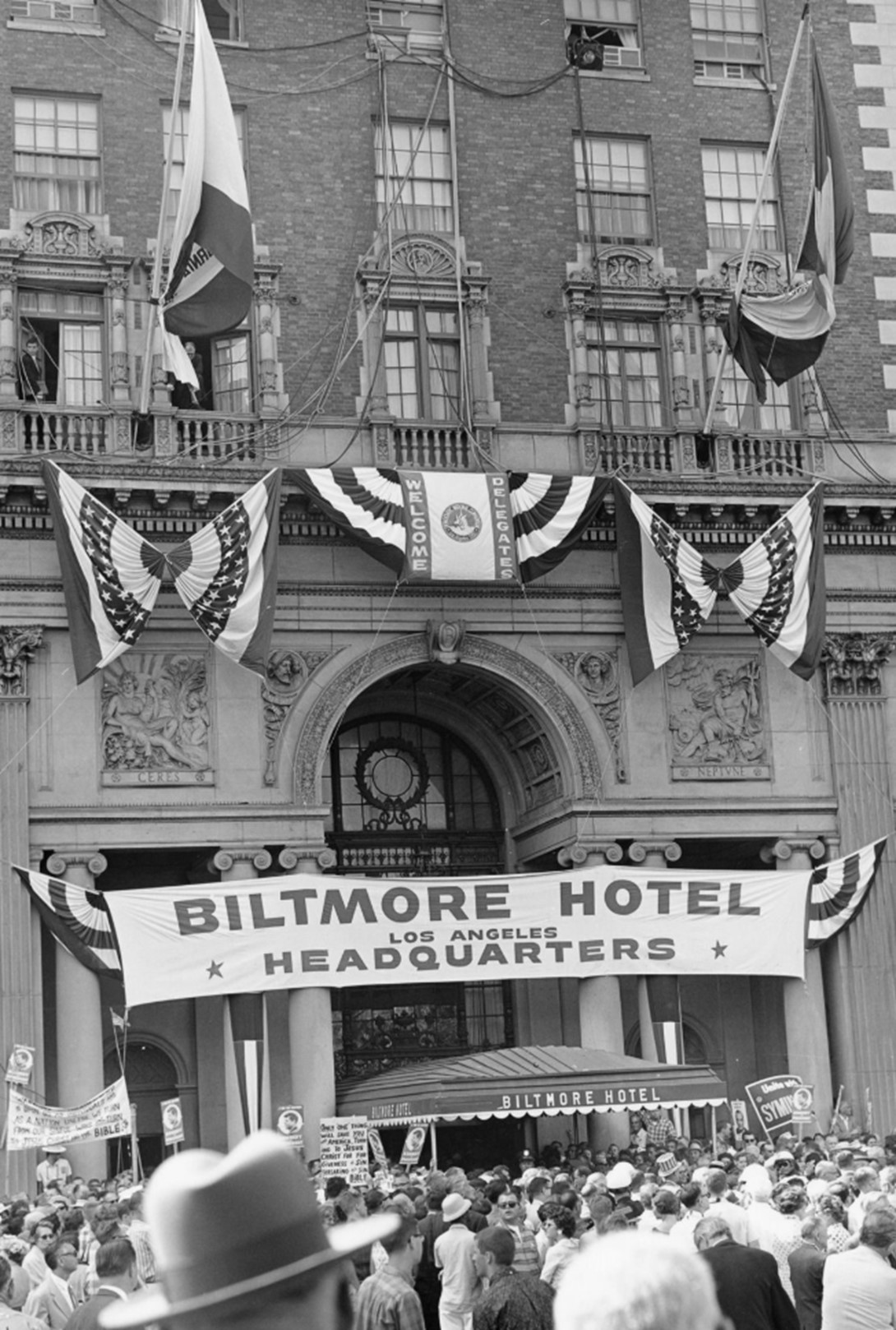 |
|
| (1960)* - Entrance to the Biltmore Hotel during 1960 Democratic Convention with banners hung outside building. Photo by William Reagh |
Historical Notes The 1960 National Democratic Convention was held at the Los Angeles Memorial Sports Arena from July 11 to July 15, 1960. This convention is notable for nominating John F. Kennedy as the Democratic candidate for President, who would go on to win the general election later that year. The Biltmore Hotel played a significant role during the convention. While the main activities, including the nomination process, took place at the Sports Arena, the Biltmore Hotel served as headquarters for many delegates and campaign activities, hosting political meetings, press conferences, and social gatherings. |
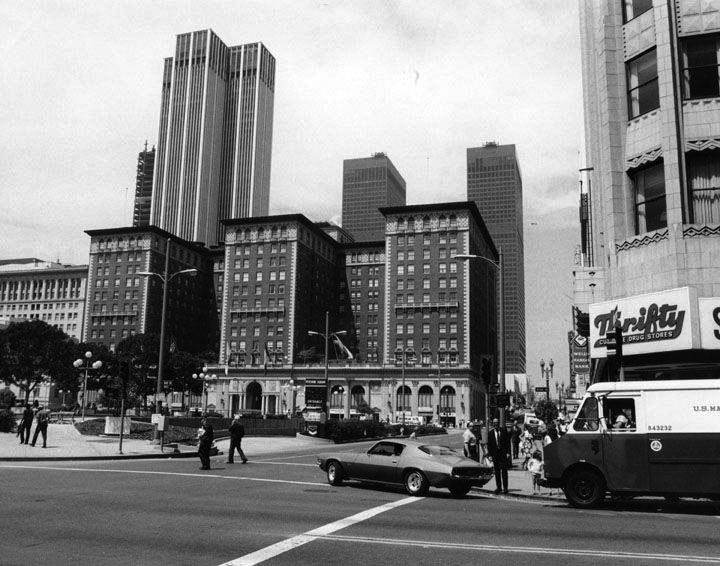 |
|
| (1970s)* – View looking west from the corner of 5th and Hill streets showing the Biltmore Hotel with Crocker-Citizens Bank Building and Arco Towers behind it. Thrifty is on the N/W corner. |
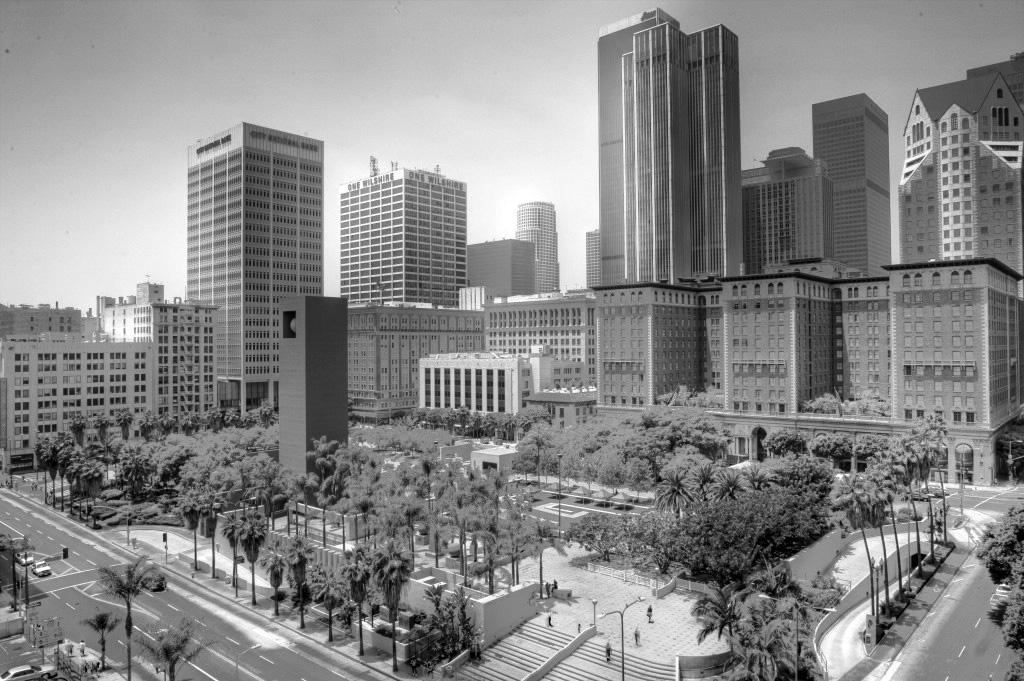 |
|
| (ca. 2011)* – View looking southwest showing Pershing Square as it appears today with the Biltmore Hotel on the right and the downtown skyline in the background. |
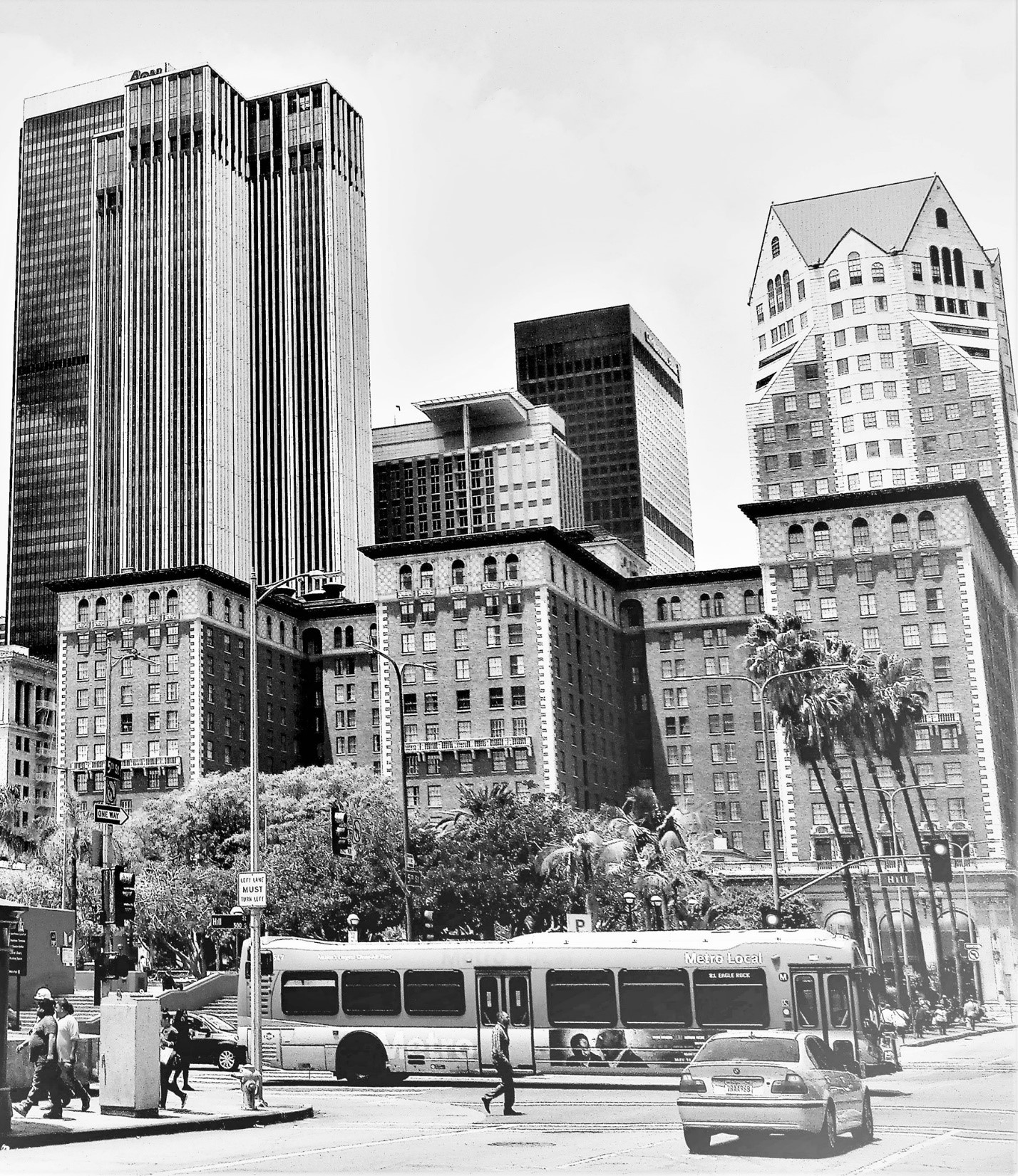 |
|
| (2016)* - Closer view showing the Biltmore Hotel with Pershing Square in the foreground and LA’s skyline to the west. Photo by Howard Gray |
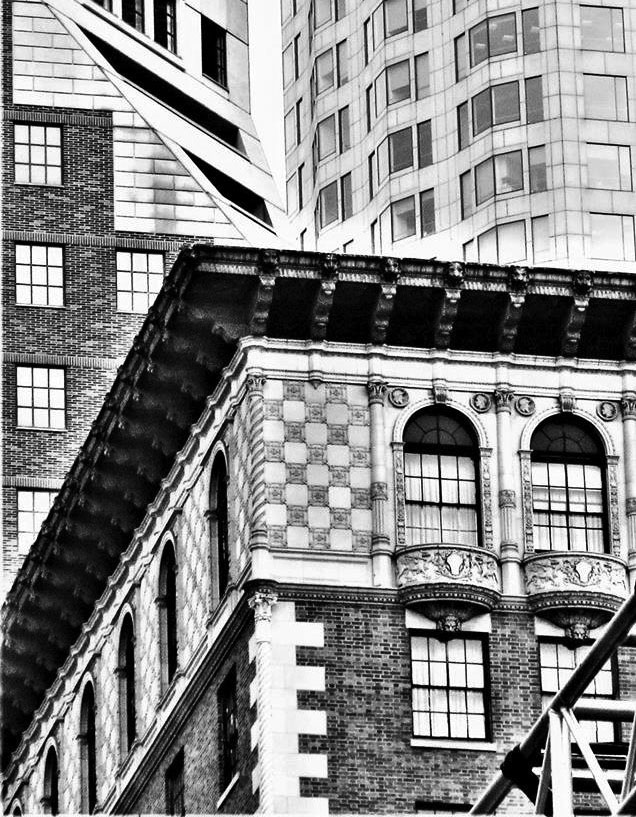 |
|
| (2017)^ – Close-up view showing the detail design on the Biltmore Hotel with the Bank Tower in the background. |
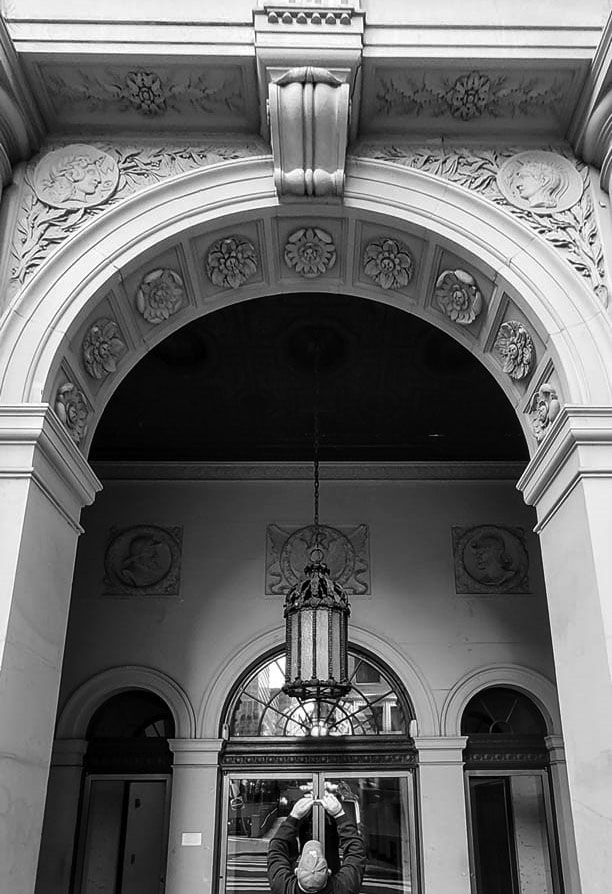 |
|
| (2021)* - Can’t resist taking a photo of detail design above front entrance to the Biltmore Hotel. Photo by Paul Wright |
Biltmore Theatre
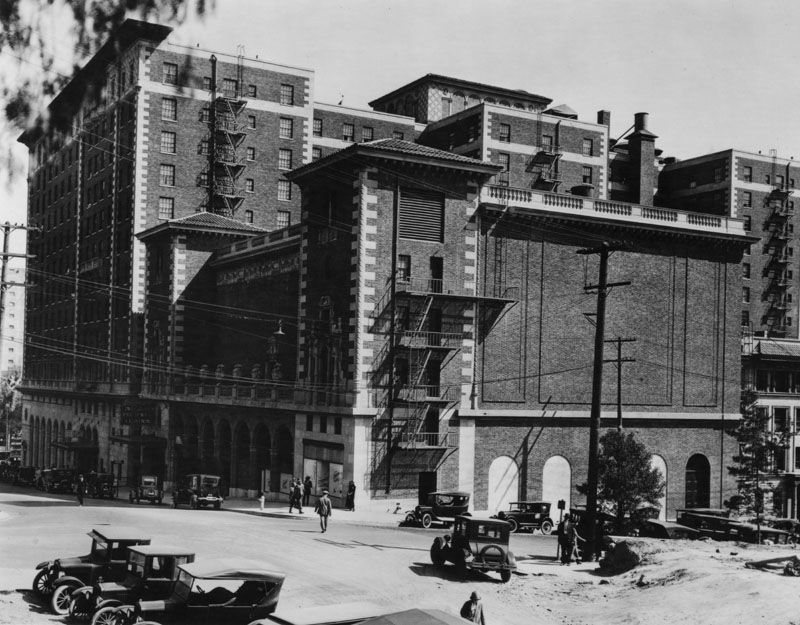 |
|
| (ca. 1924)* - Looking east on 5th Street and Grand Avenue, the Biltmore Hotel and Biltmore Theater are seen on the right. A marquee halfway down the block reads "Biltmore Presents [illegible]". The corner dirt lot (seen on the bottom right) would eventually become part of Central Library. |
Historical Notes Constructed in 1924, the Biltmore Theater was designed by renowned New York hotel architects Leonard Schultze and S. Fullerton Weaver who also designed the Biltmore Hotel. The theatre was connected to the hotel via an arcade and also had the entrance on 5th St. |
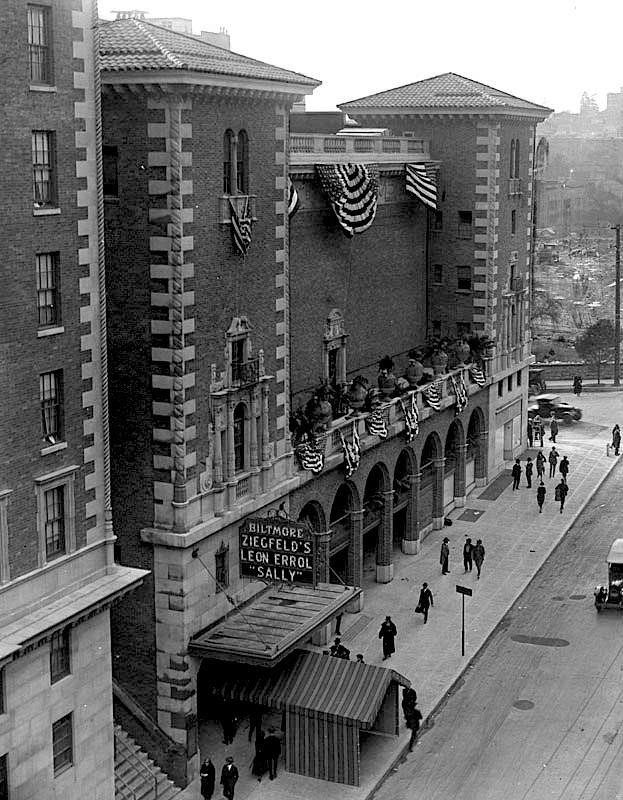 |
|
| (1924)* – Banners decorate the front of the Biltmore Theater at its grand opening. |
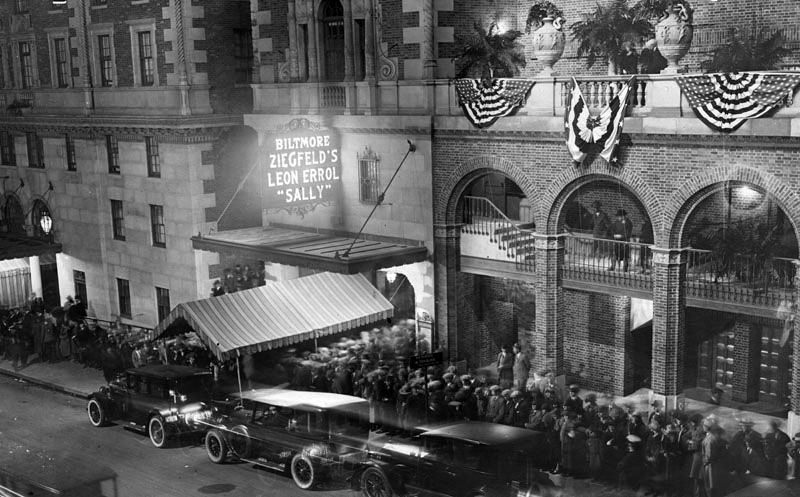 |
|
| (1924)* - The crowd at the Biltmore for the grand opening of the new theater with Ziegfeld's smash musical "Sally". |
Historical Notes The Biltmore Theater opened on March 3, 1924 with a Ziegfeld production of "Sally" starring Leon Errol. The musical was written by Jerome Kern, Clifford Grey and Guy Bolton. The theatre was under Erlanger circuit management. Will Rogers was the emcee and tickets were $10.00. |
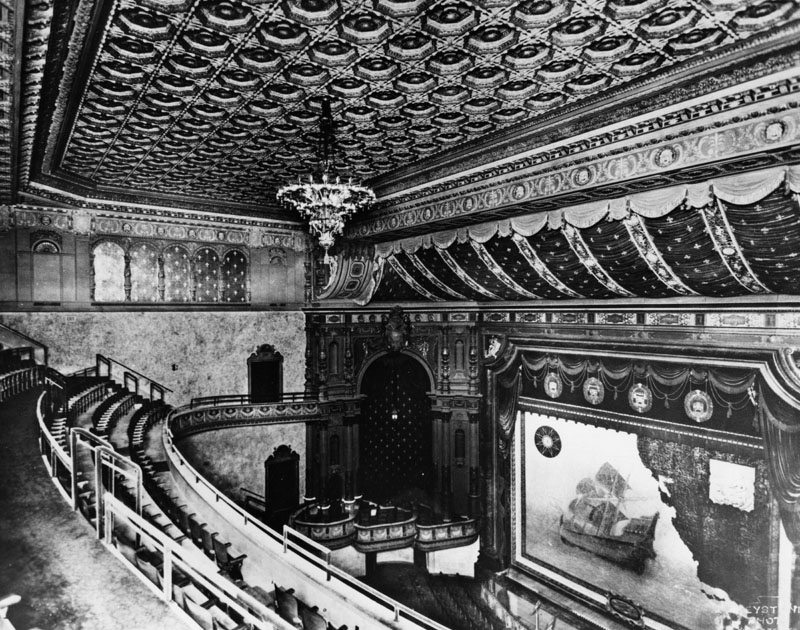 |
|
| (ca. 1924)* - View from the balcony of the painted theater curtain of the 1,654-seat Biltmore Theater. |
Historical Notes The Biltmore Theater was a major venue for Broadway shows playing in Los Angeles for decades. The Biltmore was still part of the Erlanger circuit during the 30s and 40s. |
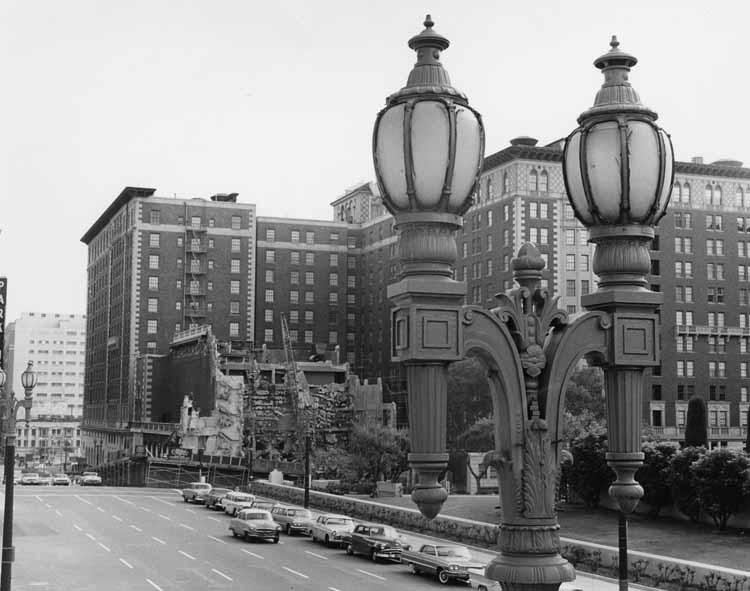 |
|
| (1964)^^^ – View looking east on 5th Street toward Grand Ave showing the Biltmore Theatre in the process of being demolished. Note the beautiful street light in the foreground. It’s known as dual-lamp UM-1906 electrolier which were installed as early as the 1920s. |
Historical Notes The Biltmore Theater was demolished in 1964 and the site was used as a parking lot until the 1980s when a tower addition to the hotel was built. |
* * * * * |
Masonic Temple (Highland Park)
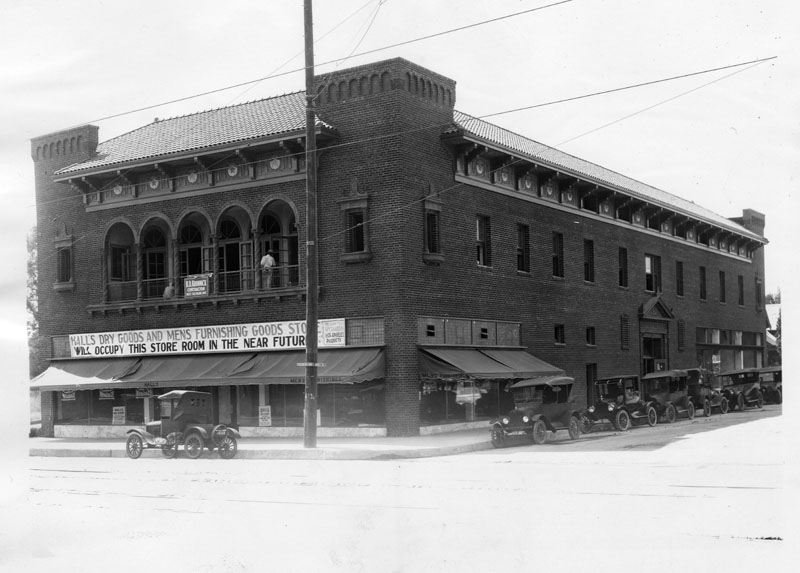 |
|
| (ca. 1923)* - Masonic Temple on North Figueroa Street and Avenue 56 in Highland Park, which has a sign announcing Hall's Dry Goods and Men's Furnishing Goods Store will soon occupy the first floor. The brick building is located on the southwest corner of the intersection. |
Historical Notes Completed in 1923, the 'Commercial/Renaissance Revival' style building served as Lodge 382 of the Free and Accepted Masons for sixty years. The original structure included retail shops on the ground floor with the lodge and banquet hall on the second floor. In 1983, the Masons were forced to vacate the structure when they were unable to afford the cost of retrofitting the building to meet seismic safety requirements.^* |
* * * * * |
Venice High School
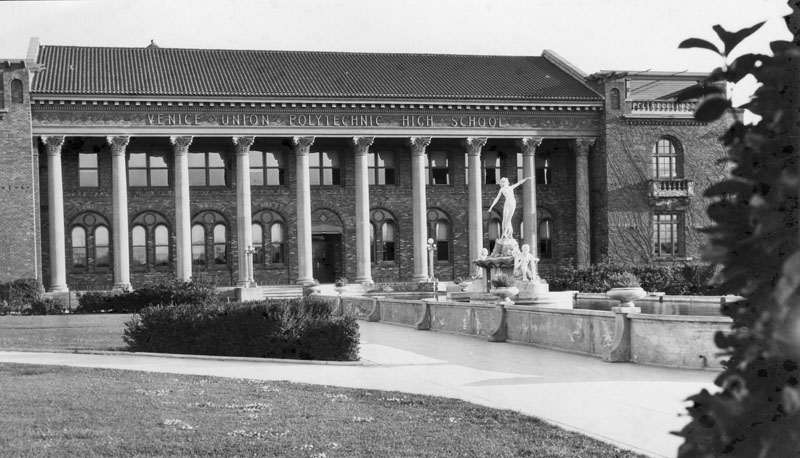 |
|
| (ca. 1924)* - The pool in front of the Venice High School contains a statue with 2 figures, a man kneeling and a woman standing above and behind him, done by sculptor, Harry Winebrenner. |
Historical Notes Venice Union Polytechnic High School, as it was originally called, was established in 1911 with classes being held in an old lagoon bathhouse; at the time, it boasted of 52 students and 8 faculty members. In 1913, a 29-acre site was purchased and in September of 1924, the school moved to its current location at 13000 Venice Boulevard. A year later, in 1925, the school was annexed to the city of Los Angeles and its name officially changed to Venice High School.* |
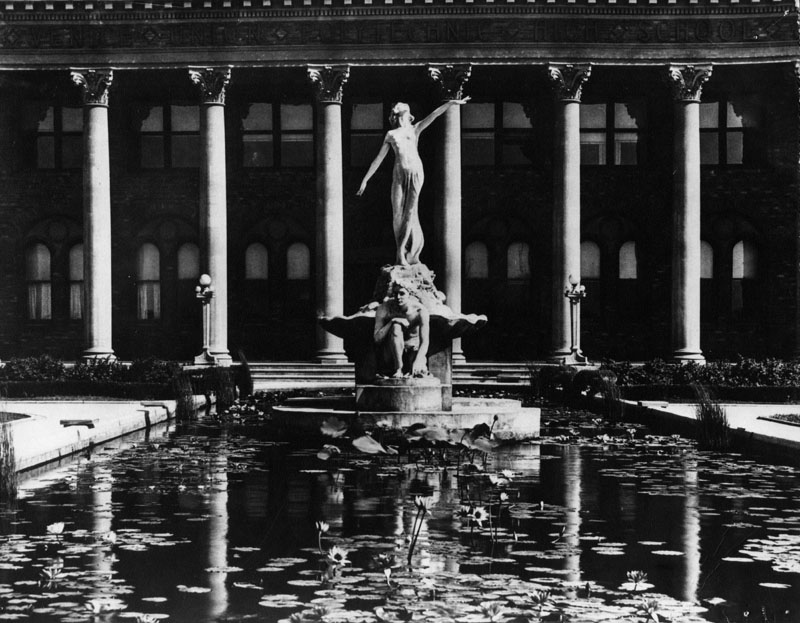 |
|
| (ca. 1924)* - A closer view of the pool in front of the Venice High School. Actress Myrna Loy (at that time she was a student--Myrna Williams) posed for the statue. |
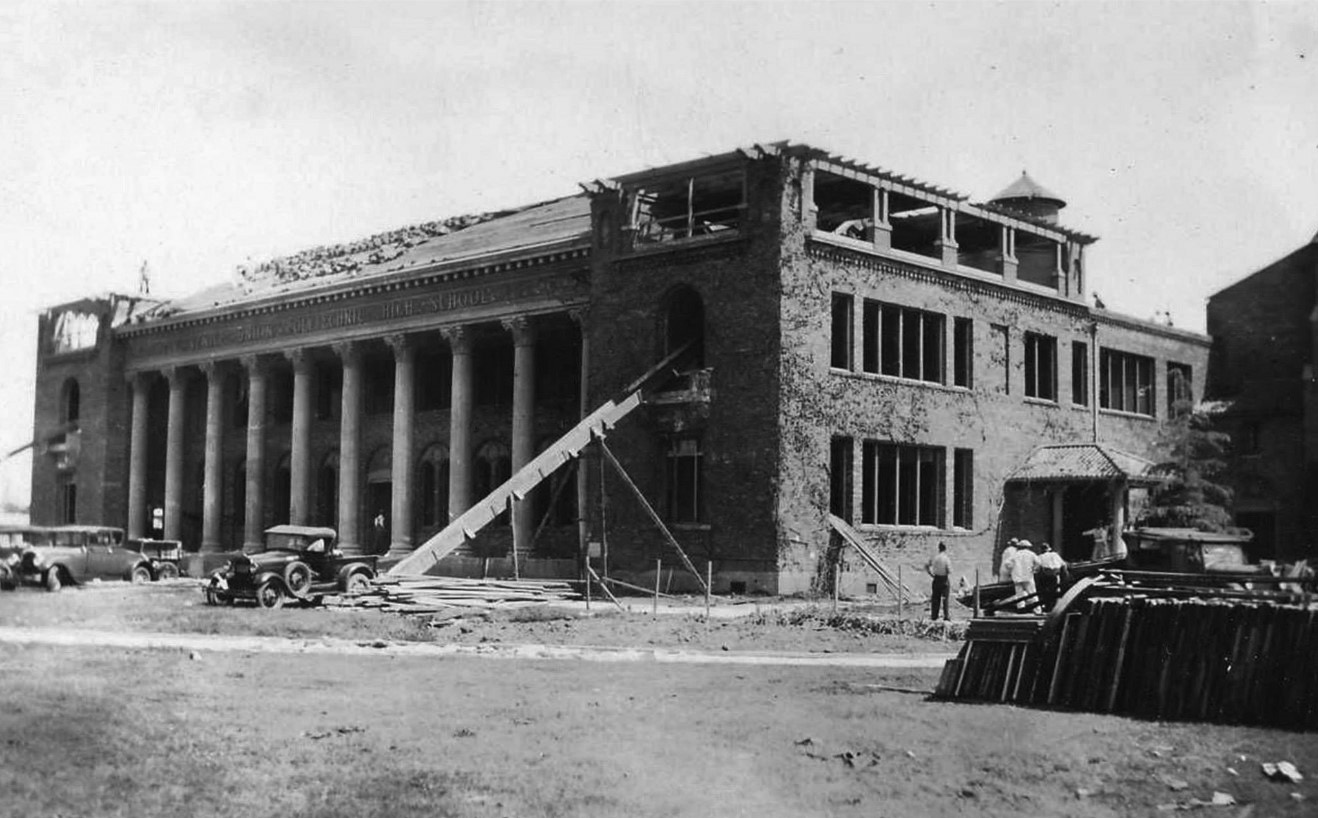 |
|
| (1933)^*^# – View showing Venice High School following the 1933 Long Beach earthquake. |
Historical Notes On March 10, 1933, the Long Beach Earthquake critically damaged the school, and it was subsequently torn down. As a result, for a period of two years classes had to be held in hastily constructed tents until a replacement school was built. On January 22, 1935 ground was broken for the new modern buildings that still stand today.* |
* * * * * |
Rancho Cienega O' Paso de la Tijera (also known as Baldwin Ranch)
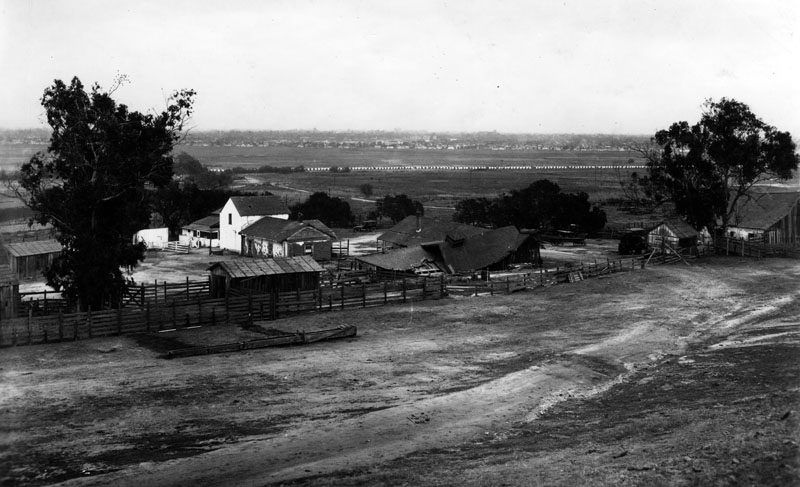 |
|
| (1924)* - Panoramic view of Rancho Cienega O' Paso de la Tijera (also known as Baldwin Ranch) located on the 2400 block of S. Crenshaw Boulevard in the Baldwin Hills area, looking east. The taller white building to the left of center is the Sanchez Adobe (not to be confused with the other Sanchez Adobe in Montebello) and is generally assumed to be the oldest building in Los Angeles. |
Historical Notes Rancho La Cienega O' Paso de la Tijera was a series of adjoining adobe structures located on the eastern side of the Baldwin Hills in an area determined to be approximately 4,481 acres. The unusual title of the Rancho is actually two names combined: "La Cienega" ("The Swamp"), refers to the marshes in the area between Baldwin Hills and Beverly Hills; the latter half of the name "Paso de la Tijera" ("Pass of the Scissors"), was a name used by the early Spanish to describe the pass through the nearby hills that resembled an open pair of scissors.* |
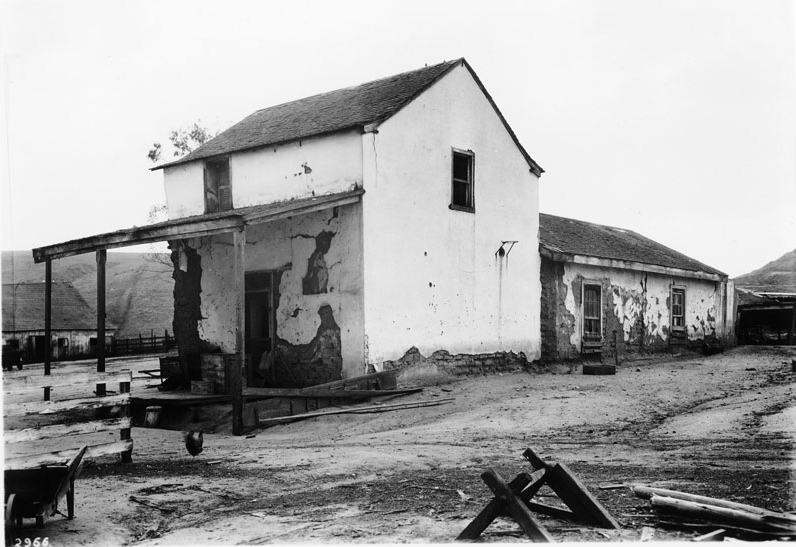 |
|
| (ca. 1924)^ - Casa de Sanchez, ca. 1924. At this time, the house was already 130 years old. |
Historical Notes This two story structure may have been built in the early 1790s, making it older than Avila Adobe, maybe older than Mission San Gabriel, older even, perhaps, than the 1795 Gage Mansion in Bell Gardens, currently considered the oldest structure in Los Angeles County. Like Mission San Fernando, the Sanchez Adobe wasn't previously part of Los Angeles but it's an integral part of it now, and was perhaps great-great-great-grandfathered in as the city's oldest building amid growth and annexation.^*^* |
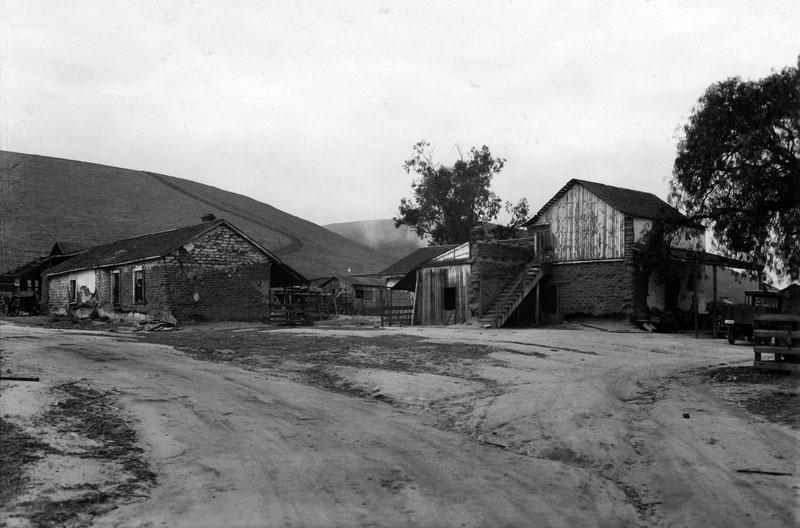 |
|
| (1924)* - View of Rancho Cienega O' Paso de la Tijera shows two adobes, a single-story on the left, and the Casa de Sanchez on the right; another smaller building is visible in the background between the adobes. |
Historical Notes The Rancho La Cienega O' Paso de la Tijera area remained unclaimed for many years following the first Spanish settlements in California. Squatters from the pueblo considering these lands public and built the La Tijera adobe as early as 1790 or 1795 for the purpose of raising cattle on surrounding land. In 1843, Manuel Michaeltorrena (then Mexican Governor of Alta California) formally granted Rancho La Cienega O' Paso de la Tijera to Vicente Sánchez.* |
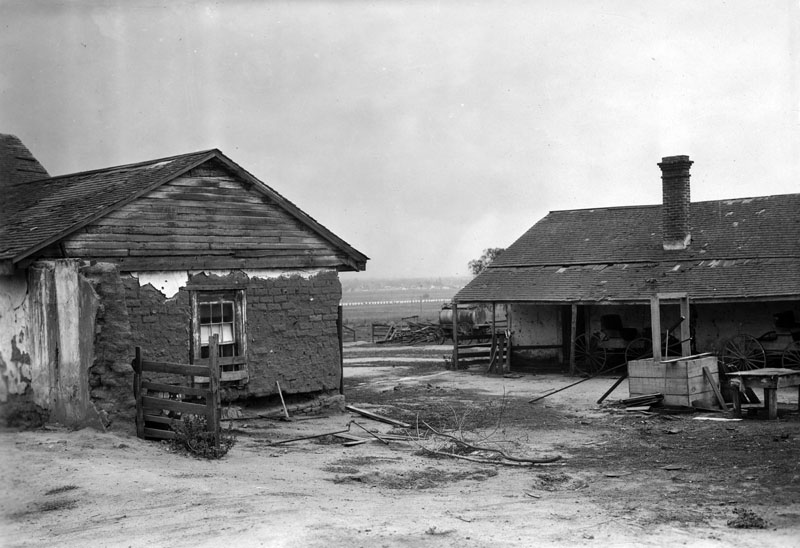 |
|
| (1924)* - View of Rancho Cienega O' Paso de la Tijera shows two adobes, both single-story, with what appears to be a wooden well in the area between them. |
Historical Notes In 1875, Tomas Sanchez (Vincente's grandson) sold Rancho La Cienega o Paso de la Tijera to Francis Pliney Fisk (F.P.F) Temple (brother of John Temple of Temple Block and Temple St.), Arthur J. Hutchinson, Henry Ledyard and Daniel Freeman. However, Temple experienced financial difficulties and in 1875 Elias J. (Lucky) Baldwin acquired the rancho, giving his name to the hills that dominated the western section of the rancho and thereafter known as the Baldwin Hills. Baldwin used the ranch primarily as a sheep pasture but it was not profitable. When Baldwin died 1909, his daughter Anita M. Baldwin realized that there was oil on the estate, and by 1916 drilling had begun.^* |
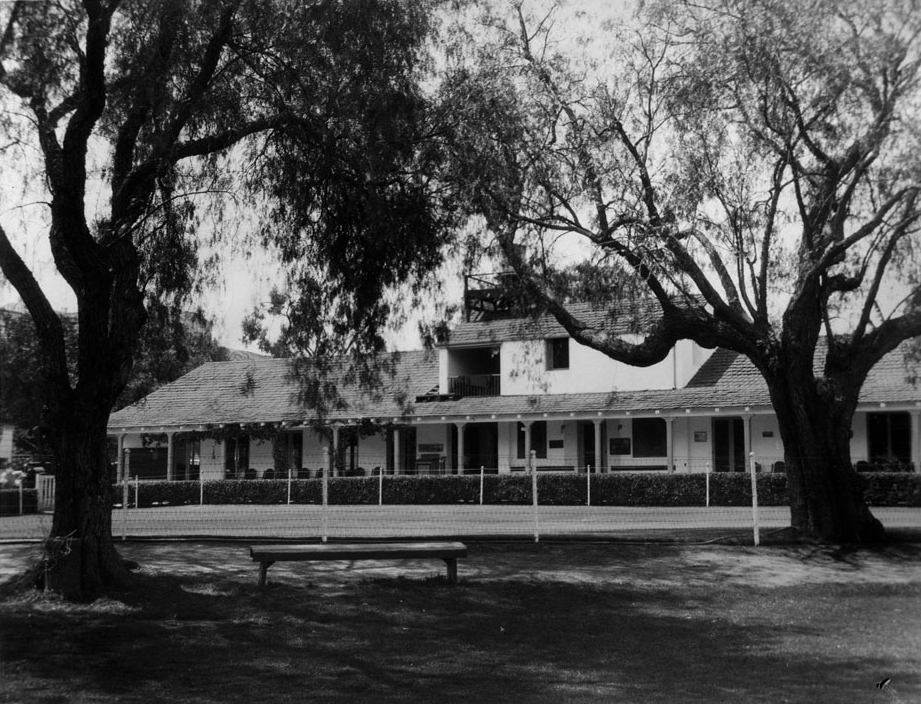 |
|
| (ca. 1935)^ - Exterior view of the remodeled adobe home of Tomas Sanchez on the Rancho Cienega de la Tiejera in Baldwin Hills. |
Historical Notes In more recent years, a portion of Rancho La Cienega O' Paso de la Tijera became the center of Sunset Fields public golf links located at 3725 Don Felipe Drive, off Crenshaw Boulevard. In 1959, Bernadette Fathers sold the property to Park View Women's Club.* Rancho La Cienega O' Paso de la Tijera (Sanchez Ranch) was declared Los Angeles Historic-Cultural Monument No. 487 on May 1, 1990 (Click HERE to see complete listing). |
* * * * * |
Sphinx Realty Company
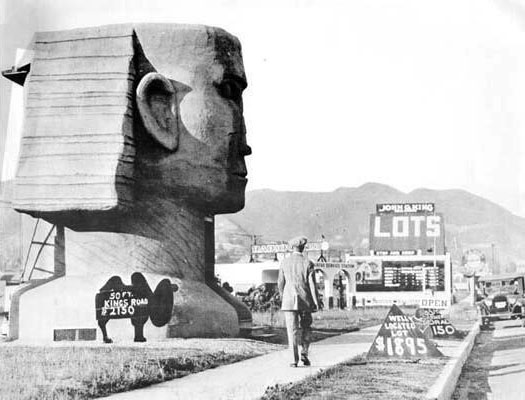 |
|
| (ca. 1920s)* – View looking north on Fairfax Ave showing a man walking in front of the Sphinx Realty Company. The building was located at 537 North Fairfax Avenue, across the street from Fairfax High School. Camel-shaped sign on the left reads: 50 ft. Kings Road - $2150. Triangular-shaped sign on right reads: Well Located Lot - $1895. |
Historical Notes In the 1920s, as the automobile was becoming the default way to get around the Southland, buildings and structures in the area became more unique. These “hey-you-can’t miss-me!” buildings (referred to as Novelty or Programmatic Architecture) were made to pull automobile drivers right off the road. Click HERE to see more examples of Programmatic Architecture. |
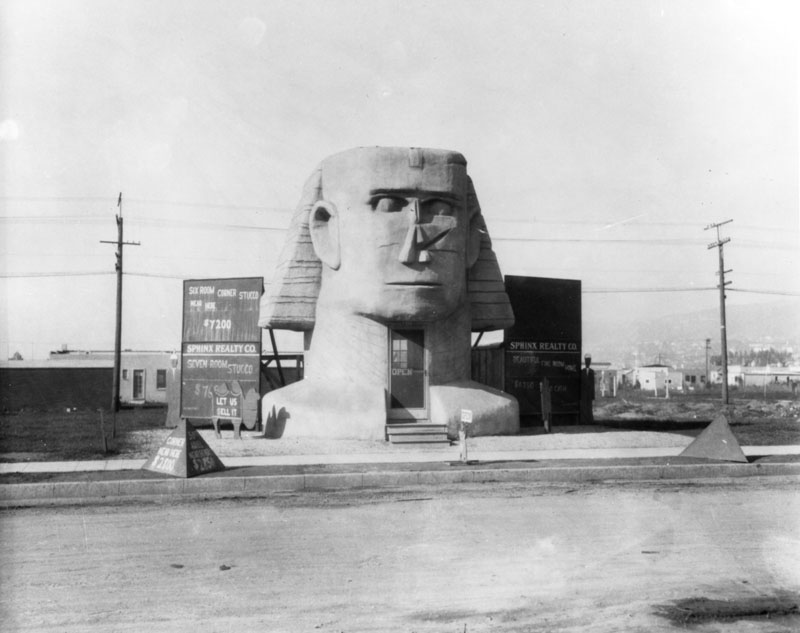 |
|
| (1920)* - Exterior view of the Sphinx Realty Company, in the shape of a sphinx, located at 537 North Fairfax Avenue, surrounded by signs listing these properties for sale: Beautiful five bedroom home, $6,750; Six room corner stucco near here, $7,200; Seven room stucco, $7,650; Corner near here, $2,500. |
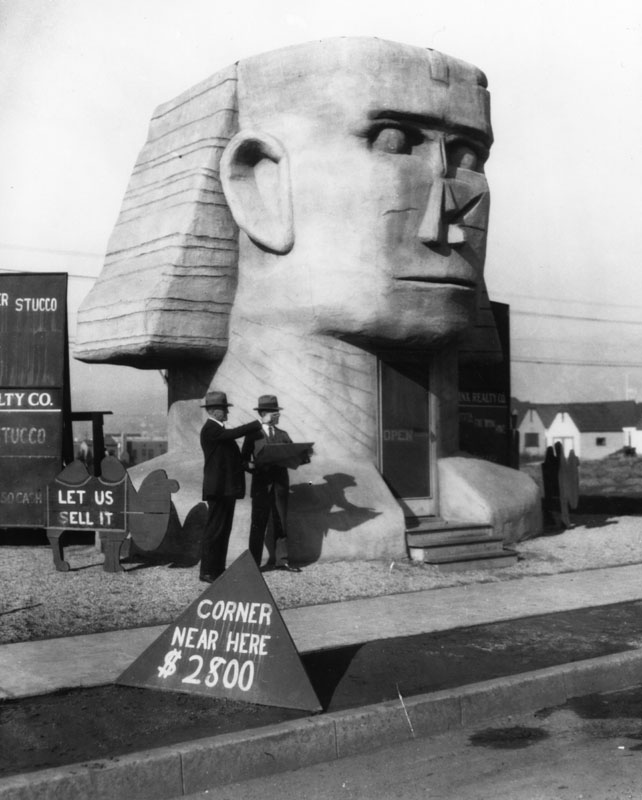 |
|
| (1920)* - View showing two men standing in front of the Sphinx Realty Company sales building located on Fairfax Avenue. The office was located across the street from where Fairfax High School stands today. Click HERE to see more examples of Programmatic Architecture. |
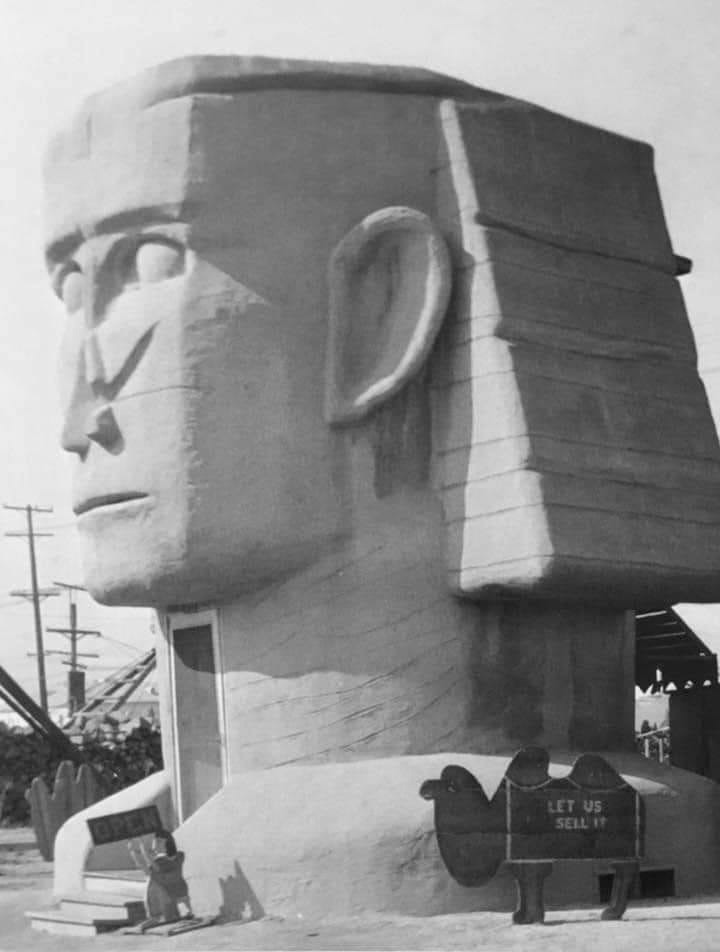 |
|
| (ca. 1920s)* - Sphinx Reality Company sales office, 537 N. Fairfax Ave - "LET US SELL IT". Click HERE to see more examples of Programmatic Architecture. |
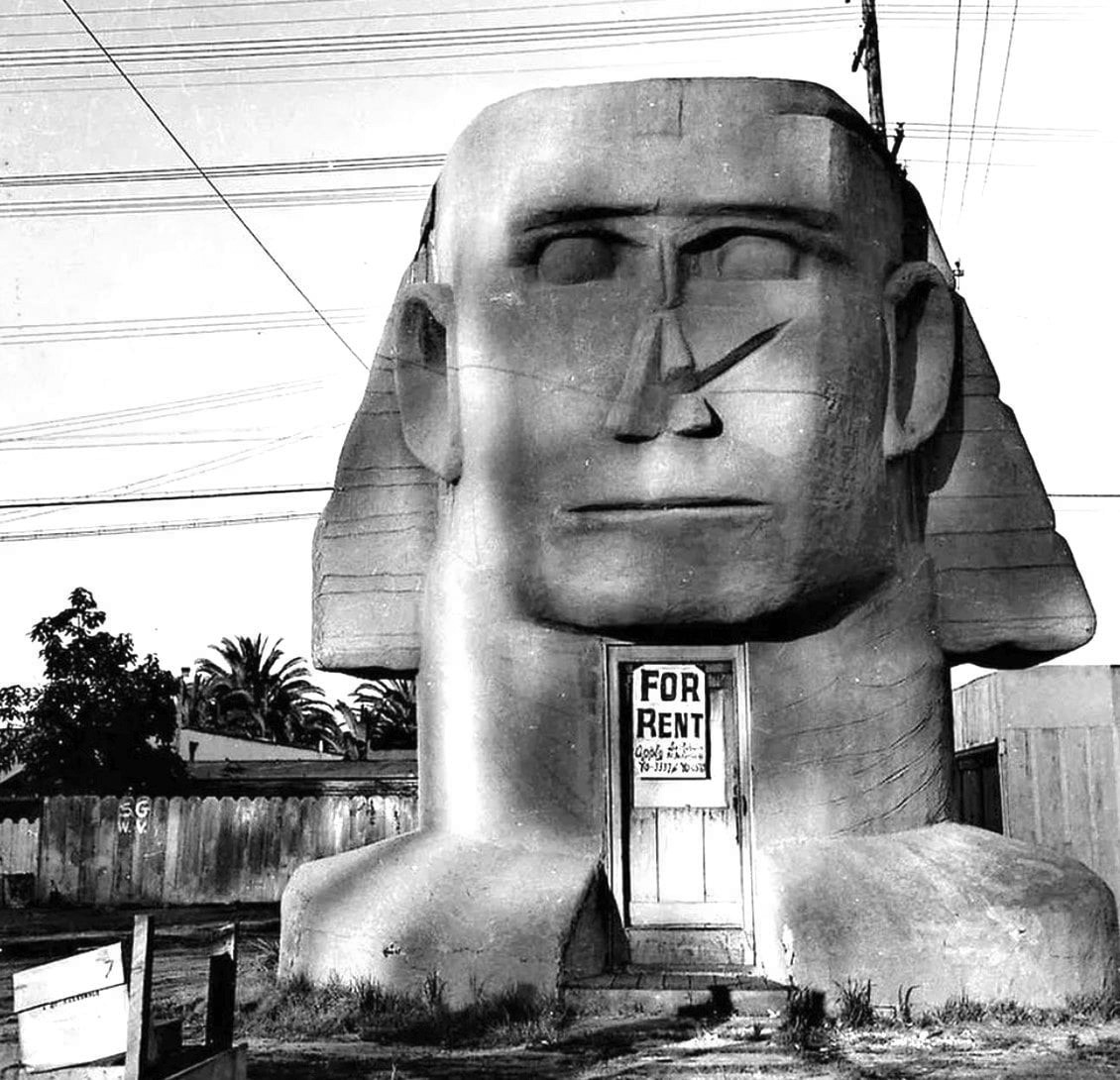 |
|
| (1920s)* - The Sphinx Realty building with a ‘For Rent’ sign on its front door. Nothing lasts forever. |
Historical Notes Click HERE to see more examples of Programmatic Architecture. |
* * * * * |
Fairfax High School
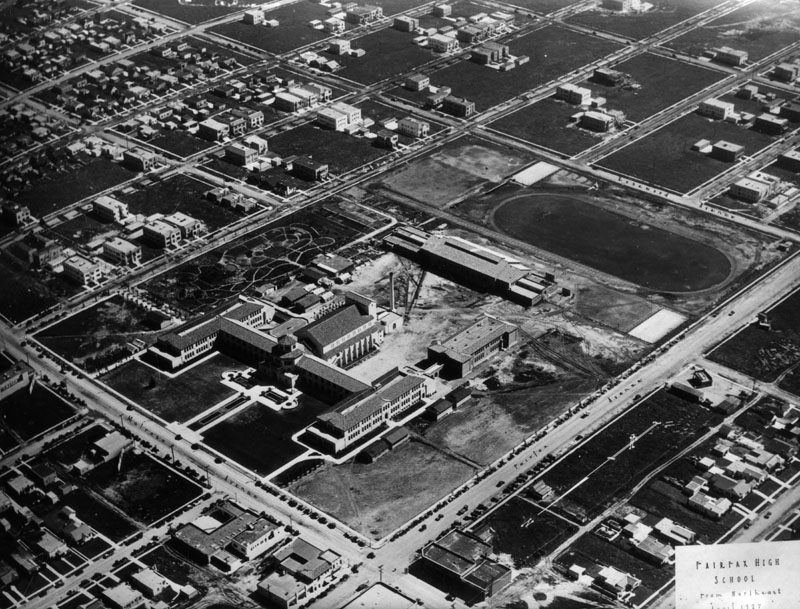 |
|
| (1927)* - Aerial view looking southeast showing Fairfax High School located on the southeast corner of Fairfax and Melrose Avenues. The Sphinx Reality Office (previous photo) was located at 537 N. Fairfax Avenue which is across the street from the track in the above photo. |
Historical Notes Originally, the land around Fairfax “was a swampy area or cienaga, the home of the duck and the mudhen - a veritable hunters’ paradise during the wet season of the year. As land became more valuable, the old cienega was drained and filled and a region suitable for residence created. Because of its swampy condition, the Board of Education was enabled to buy the twenty-eight acres on which this high school stands at a very low figure. When the time came to build our school, through a friend we were able to secure gratis thirty eight thousand loads of dirt. This raised the frontage on Melrose twenty - two inches, and so we are kept out of the water most of the time. Thus we have passed by slow transition from the jungle home of the lords of the forest to the more sheltered home of the Lords of Fairfax.” Written by the first Principal of Fairfax, R.G. Van Cleve - 1963 Yearbook. #*#* |
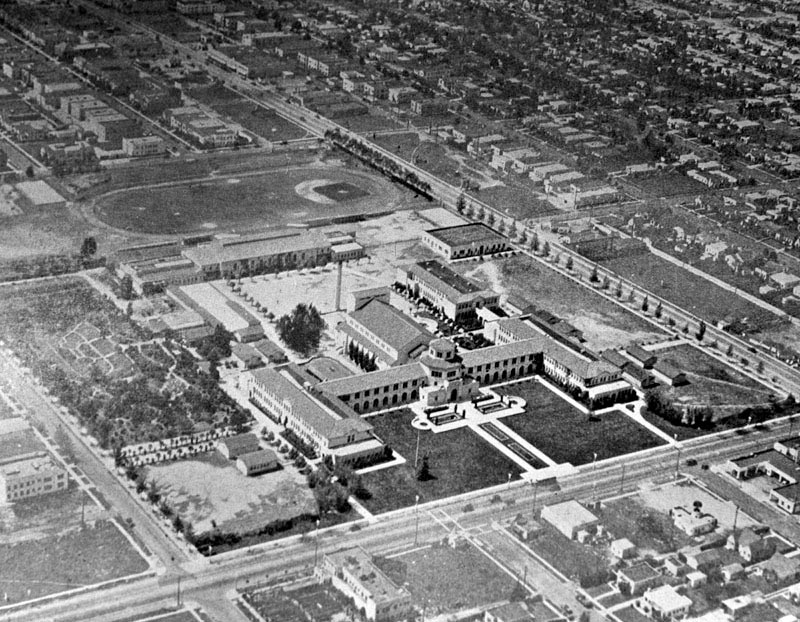 |
|
| (1931)* - Aerial view of Fairfax High School looking southwest. The tree-lined street running diagonally at top right is Fairfax Avenue. Melrose Ave runs east to west in the foreground. The school's "Rotunda" and auditorium can be seen at center of photo. |
Historical Notes In 1924, Fairfax High School, named for Lord Fairfax of Colonial America, opened its doors. Rae G. Van Cleve, the first principal, wished to make Fairfax very “American and Democratic.” The Fairfax family (direct descendants of Lord Fairfax) in Virginia gave permission to use the coat of arms (Rampant Lion) and the motto “Fare Fax” (“Say and Do”). The student body chose to name “Colonials.” In keeping with the Colonial backgrounds, Student Body officers bore colonial titles. The first boys’ and girls’ groups were called Lords and Ladies, and the student body president was called The Lord High Commissioner. Fairfax was initially designed to be an Agricultural & Mechanical school emphasizing “practical” skills. With 28 Acres of campus, school programs included landscape gardening, forestry, architecture, agronomy and an arboretum. The Domestic Science unit supervised the cafeteria so that the “girls” would get practice as well as the theory of cooking and serving “food”. #*#* |
 |
(1926)#*#* - View of what appears to be two lily ponds in front of the Fairfax High School Rotunda and Auditorium. Both the Rotunda and Auditorium are the only two original buildings still standing today.
|
Historical Notes Because the buildings were not earthquake-safe, the last year of the original campus was 1966. Brick by brick, the old structures came down, and completely new earthquake-safe building arose. New additions included a four-story administration and classroom facility, a physical education plant, an industrial arts complex and cafeteria. Students and faculty moved into the new building in 1968. Because of the unique beauty of the Rotunda and the Auditorium, a public campaign was successful in saving them, and the Auditorium was reinforced for seismic safety. Subsequently, the Fairfax Hall of Fame was established in the Rotunda. #*#* |
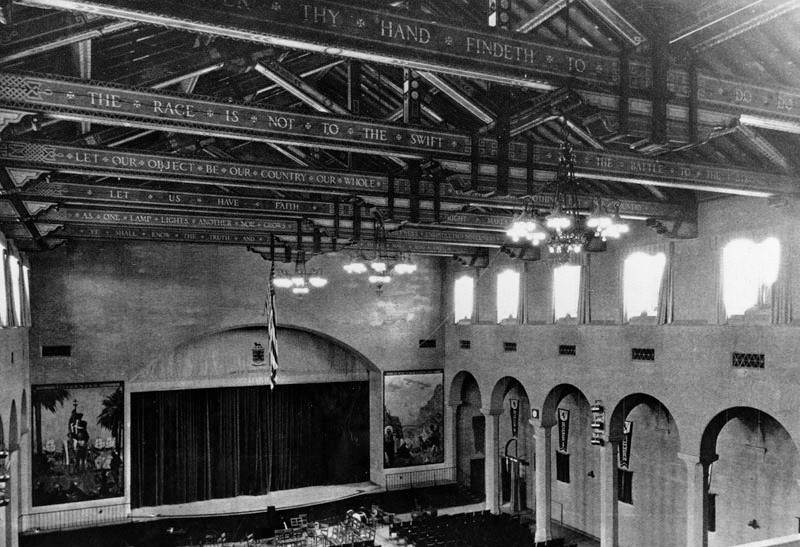 |
|
| (1931)* - Interior view of the auditorium at Fairfax High School. |
Historical Notes The auditorium was dedicated in 1926 and later named the DeWitt Swan Auditorium, in honor of the first Boys’ Vice Principal. The first annual in 1926 bore the dedication, “Enter to learn; go forth to serve.” In 1927, the summer graduating class dedicated the sunken gardens and the fountain that was located in front of the old building. The same year, a Fine Arts building and a gymnasium were added to the campus. By the time, Fairfax High School (containing grades 7-12) was an established, prestigious element in the Fairfax Community. #^#* |
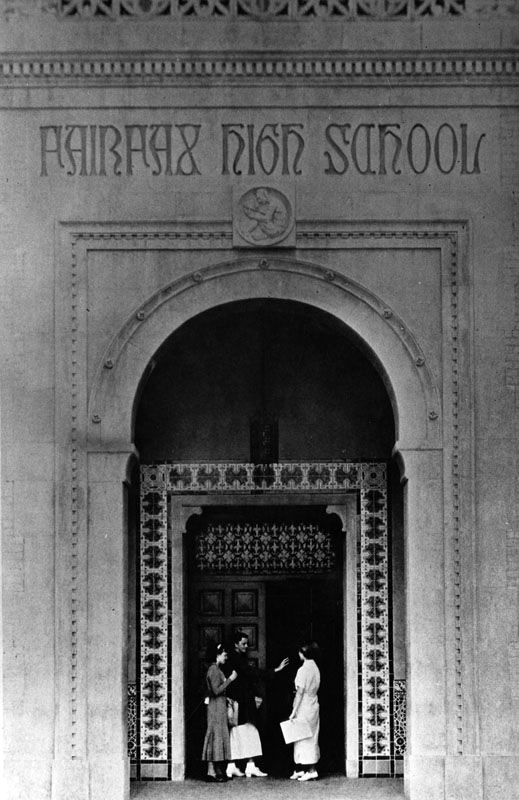 |
(ca. 1931)^ - Students standing outside the Moorish style archway of the entrance to the Fairfax High School auditorium. “Never say die, say do” - The Fairfax Motto, “Fare Fac”, was the subject of a 1930 contest for the best slogan and motto depicting its meaning. More than 150 entries were submitted. The winning motto: “Noble in speech, honorable in deed”. “Let your words be wise and your actions likewise”.
|
Historical Notes When the United States entered the war, hundreds of Fairfax students and alumni joined the military. The 1946 Colonial Yearbook was dedicated to those men and women, 96 of whom lost their lives. During the war years, Fairfax students sold $90,000 in war bonds, conducted numerous recycling material drives. Also in 1946, a Fairfax drama featured Ricardo Montalban and Jim Hardy, once a Lord High Commissioner starred at football. He continued his career at USC ad professionally with Rams, Chicago Cardinals and Detroit Lions. #*#* Click HERE for a list of Fairfax High School Notable Alumni. |
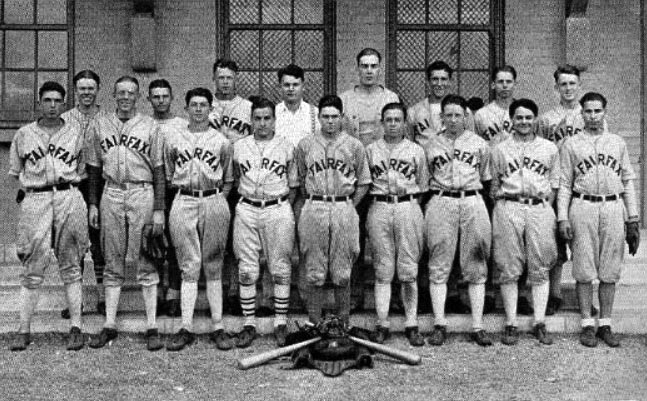 |
|
| (1929)#*#* – The Fairfax Varsity Baseball Team of 1929. Yearbook referred to the team as "Heavyweight Baseball". |
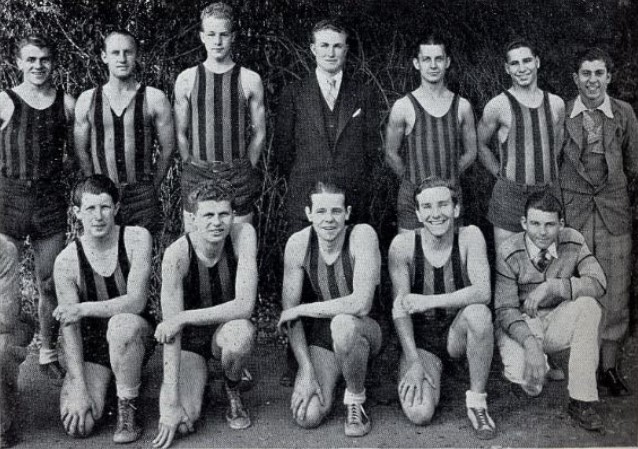 |
|
| (1929)#*#* – The Fairfax Varsity Basketball Team of 1929, at the time referred to as "Heavyweight Basketball". |
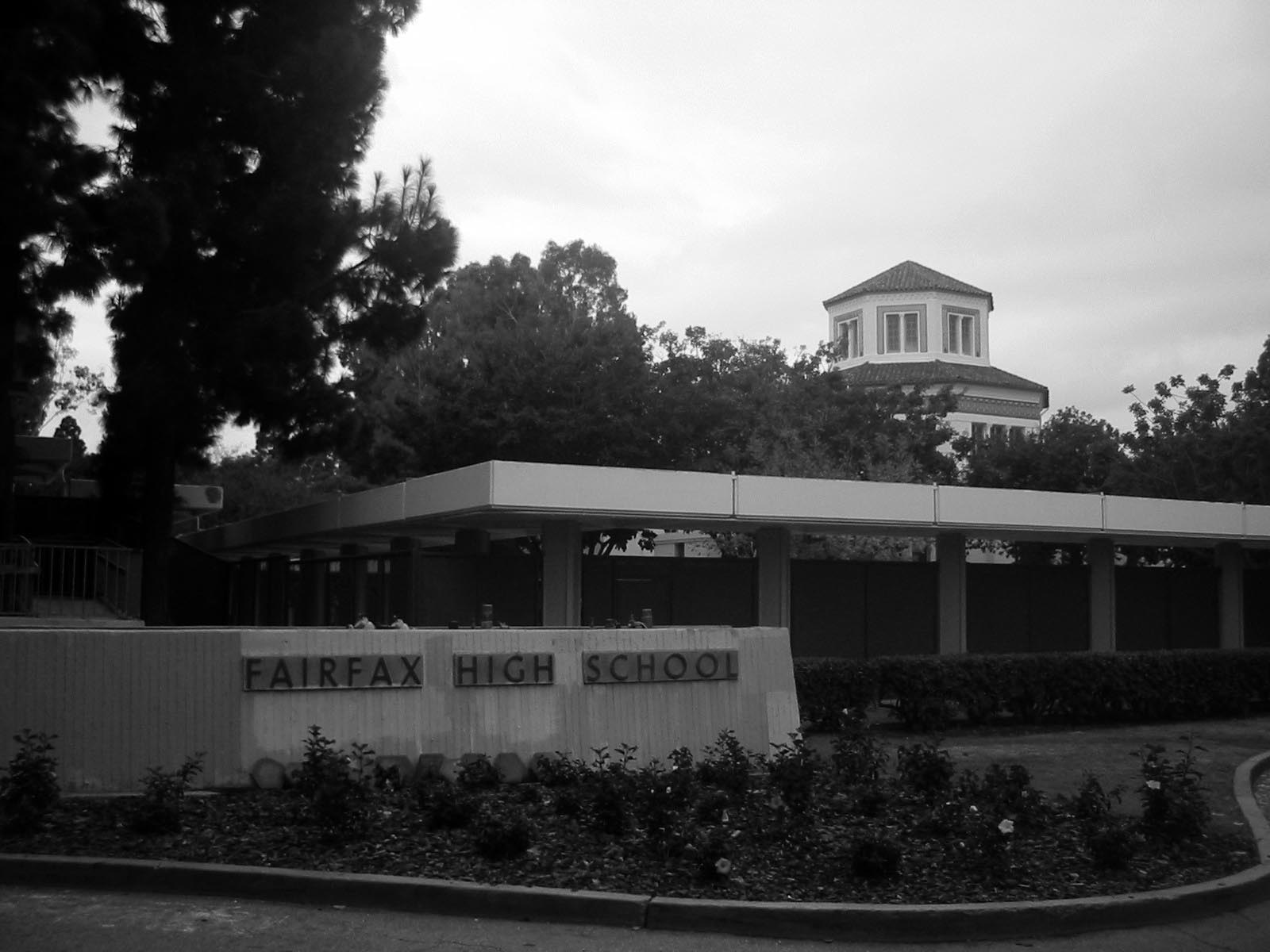 |
|
| (2006)^* - Fairfax High School as it appears today, with Rotunda in the background. Photo by Gary Minnaert |
Historical Notes Fairfax was the foreign language magnet school in the 1960s and 1970s, offering Hebrew, German, Chinese and Latin, among other languages. The Fairfax Magnet Center for Visual Arts opened in 1981 and remains the only visual arts magnet in the Los Angeles Unified School District. In 1984, Dr. Virginia Uribe, an LAUSD teacher and counselor for 42 years, founded LAUSD’s Project 10 program, the first dropout prevention program specifically for lesbian, gay, bisexual and transgender (LGBT) students in the United States. Organized by a group of local theater artists, the first Melrose Trading Post was held in 1998 in the school's parking lot. Regarded as most successful on-going fund-raising activity in the LAUSD, the flea market evolved into the Greenway Arts Alliance, the Friends of Fairfax and the Institute for the Arts at Fairfax High School, all which are of immense benefit to the school and students. In Fall 2008, Fairfax High School was reconfigured from a comprehensive high school into a complex of five new small learning communities (SLCs) and the existing Fairfax Magnet Center for Visual Arts.^* |
 |
The coat of arms of Thomas Fairfax, 6th Baron Fairfax of Cameron (1693–1781), which became the emblem of the County of Fairfax, Virginia, USA.^* |
Historical Notes There is a connection between Fairfax High School, Gilmore Gas Co., and Thomas Fairfax - a 'Lion'. Fairfax High School and Gilmore's first oil well are located in proximaty to each other and to Fairfax Avenue. It turns out that both Gilmore's logo and Fairfax's mascot is a 'Lion' - which is more than a coincidence. |
|
|
Fairfax High School's Mascot is a lion (left). Gilmore Oil Company's logo was also a lion. |
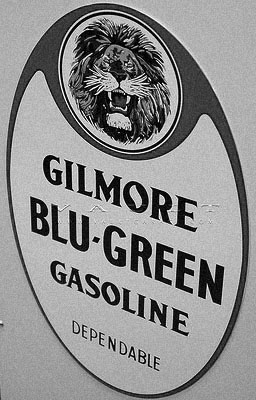 |
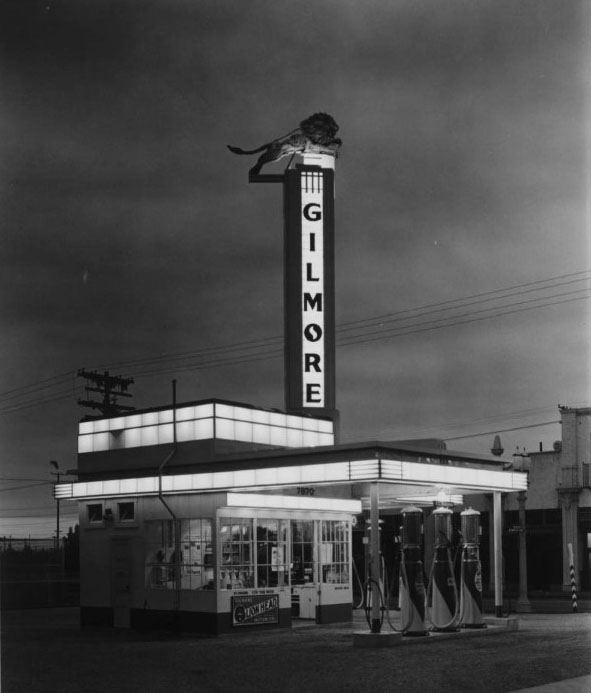 |
|
| (1935)#^* – Night view of the Gilmore Service Station located at 7870 Beverly Boulevard, one block east of Fairfax Avenue. Note the lion on top of the illuminated Gilmore sign. |
Historical Notes A.F. Gilmore and his son, Earl Bell (E.B.) turned their Gilmore Oil Company into the largest distributor of petroleum products in the Western U.S. E. B. Gilmore appears to have invented the self-serve gas station. He created a “gas-a-teria” not far from Farmers Market where customers saved 5 cents per gallon by filling their own tanks. Those who preferred to have their gas pumped by “professionals” at the gas-a-teria got unusual service for a period of time when young ladies on roller skates would glide to the pumps to gas the cars up.^**# Gilmore Gas Stations were eventually bought out by Mobil Oil Co. Click HERE to see more Early Views of LA Gas Stations. |
* * * * * |
Temple Emanu-el
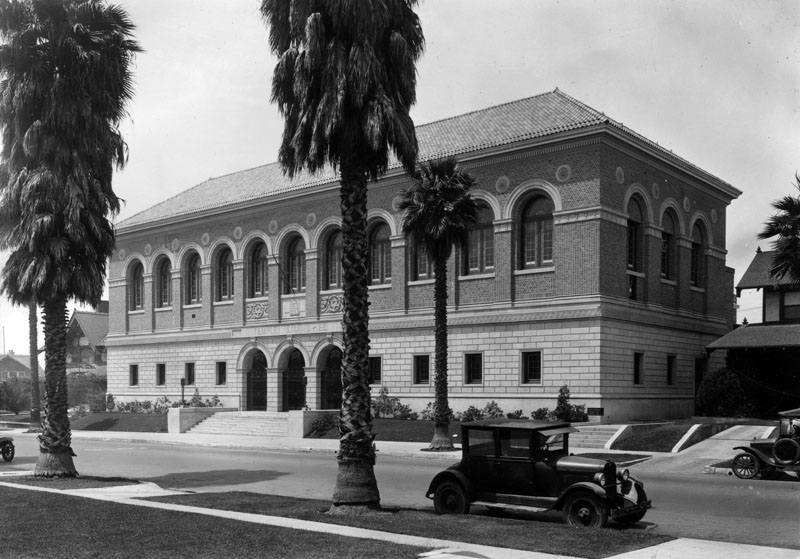 |
|
| (ca. 1924)* - Exterior view of Temple Emanu-el, located at 639 S. Manhattan Place near Wilshire Boulevard. |
Historcial Notes Designed by Russel and Alpaugh, Temple Emanu-el opened in 1923 and was occupied by the first "traditional reform" congregation. In 1929, the congregation was dissolved and the building was sold to become Christ Church. In the late 1930s, the congregation of Temple Emanu-el reappeared in Westwood where it was located until a large temple was built at 8844 Burton Way in Beverly Hills. The home on the left was later demolished and the English style residence on the right later became the parsonage for Christ Church.* |
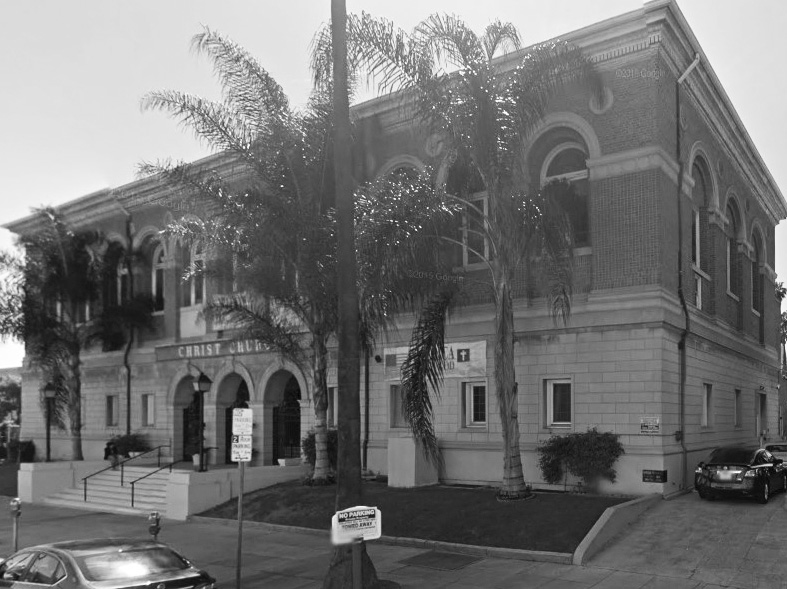 |
|
| (2015)#^** - Google street view showing Christ Church at 639 S. Manhattan Place (original location of Temple Emanu-el). |
* * * * * |
Victoria Arms Hotel Apartments (today, Park View Apartments)
 |
|
| (1924)^ - View showing the Victoria Arms Apartments located just west of MacArthur Park (Westlake Park at the time) at 2424 Wilshire Boulevard. |
Historical Notes Known as the Victoria Arms Hotel Apartments when it opened in 1924, this building located at 2424 Wilshire Blvd. near downtown Los Angeles was sold and renamed the Park Wilshire in the early 1930's. |
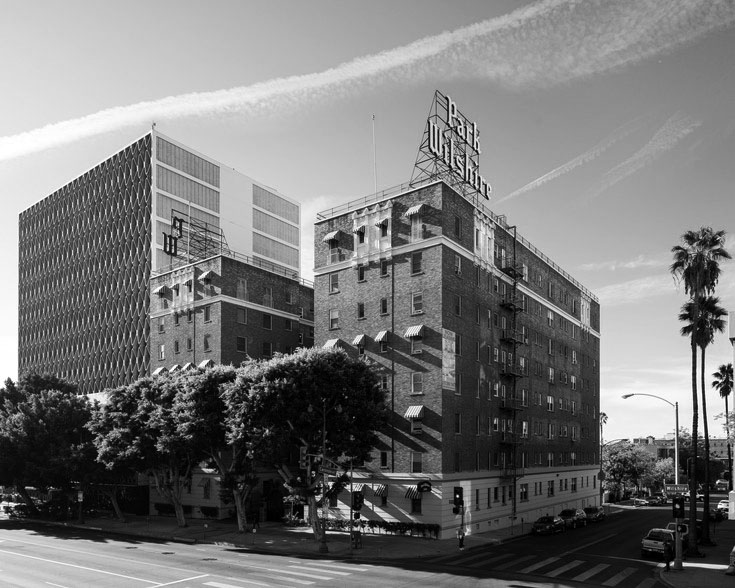 |
|
| (2017)^.^ – View showing the Park Wilshire Apartments located on the SE corner of Wilshire Boulevard and Carondelet Street. |
Historical Notes The historic eight-story apartment building is located at 2424 Wilshire Boulevard, sandwiched between Koreatown and downtown Los Angeles. The building is designated as a historic-cultural monument by the LA Cultural Heritage Commission and was designed by the famed architectural team of Clarence H. Russell and Norman W. Alpaugh in 1924. It originally opened as a residential hotel and was easily spotted by passerby due to its iconic neon sign which graced the building’s rooftop. |
 |
|
| (2009)^.^ – Close-up view of the iconic neon sign on the rooftop of the Park Wilshire Apartments. |
* * * * * |
Friday Morning Club (Original Building)
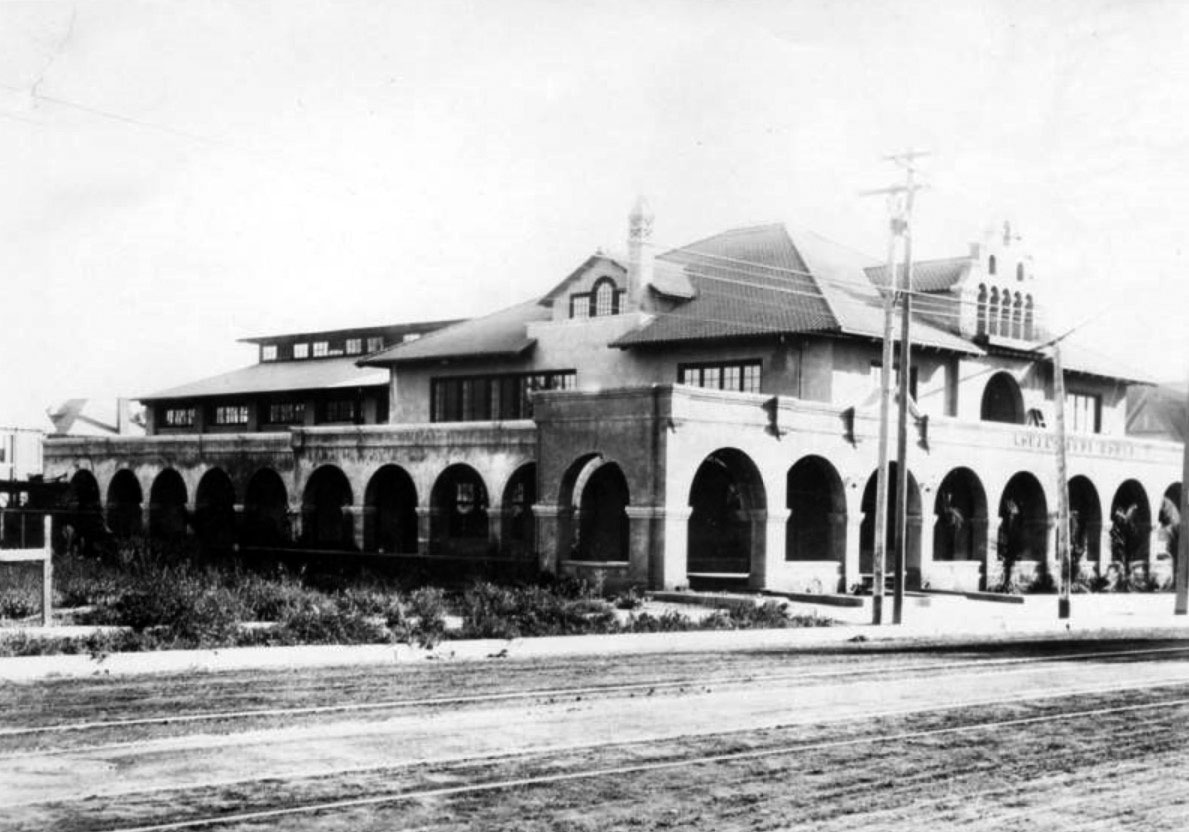 |
|
| (ca. 1900)* - View looking across an unpaved Figueroa Street showing the Friday Morning Club building, located at 940 South Figueroa. |
Historical Notes In 1891, Caroline M. Severance and 87 charter members organized the Friday Morning club in the parlor of the Hollenbeck Hotel, at 2nd Street and Spring. Among its interests were intellectual and literary pursuits. From its inception, however, the club was directly involved in political issues--women's rights, the movements that resulted in the establishment of Los Angeles Juvenile Court and a city library, and the preservation of landmarks. The club started the movement that put women on the board of education. It campaigned for harbor development at San Pedro. It fought to preserve the redwoods and the California missions. It sponsored food and drug legislation. At its peak, the club boasted 3,800 members.^ |
.jpg) |
|
| (ca. 1900)* – View looking southeast showing the Friday Morning Club located on the east side of Figueroa between 9th and 10th streets. The church seen on the right in the background is the Immanuel Presbyterian Church, located on the southeast corner of Figueroa Street and 10th Street (now Olympic Boulevard). |
Historical Notes In 1899, Severence formed a corporation and issued stock to its membership of the Friday Morning Club. The money raised from the stock, made it possible to purchase a parcel of land on Figueroa between Ninth and Tenth to build a clubhouse, which would eventually be leased back to the club.^^ |
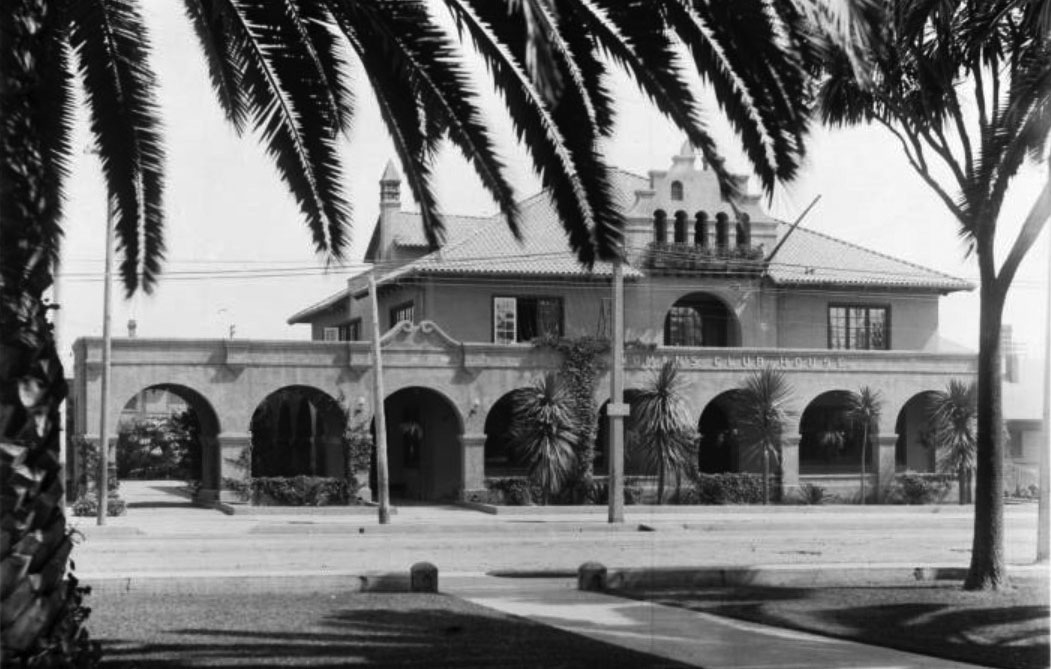 |
|
| (ca. 1905)^ – View showing the Mission-style Friday Morning Club building as seen from across the street. Sign above the front face of the building reads: “Woman’s Club House” |
Historical Notes On September 14, 1899, the cornerstone for the clubhouse was laid. On January 19, 1900, four months later, a $13,000, two-story Mission revival structure was completed and opened for meetings. Severence died in 1914 at the age of 94; however, the club that she stared continued to prosper and grow its membership.^^ |
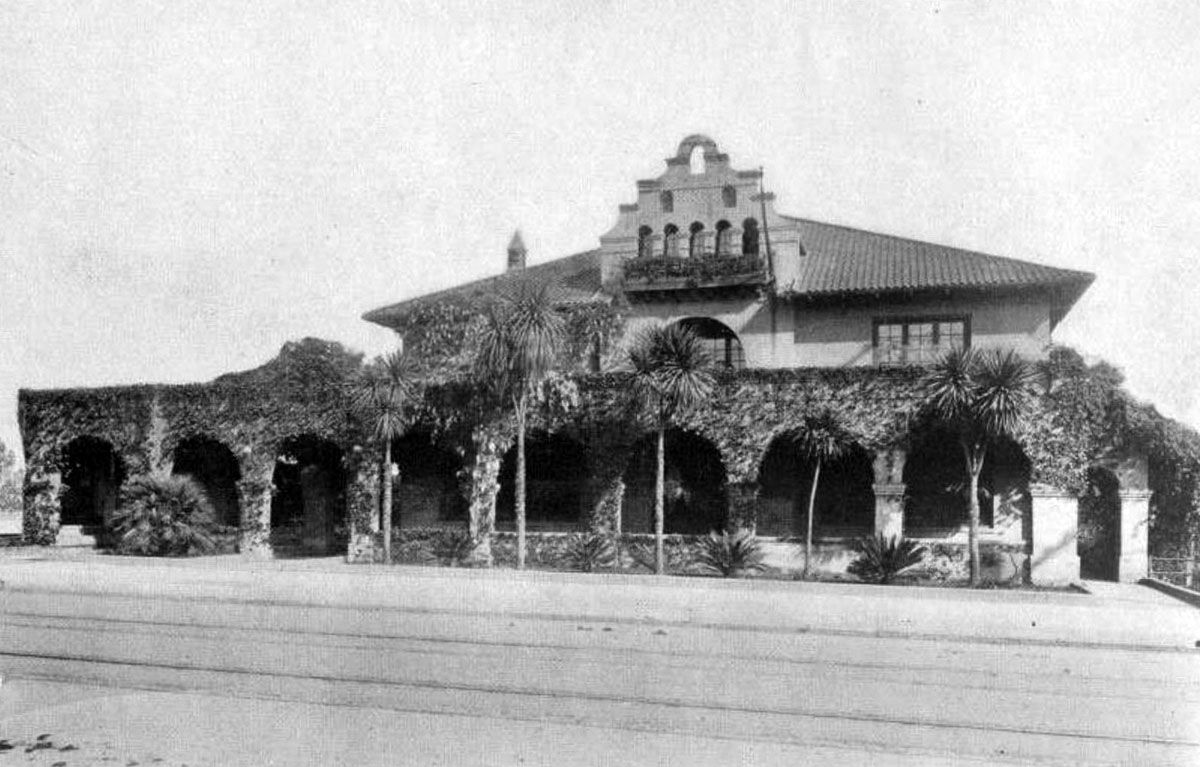 |
|
| (1911)^.^ – View of the original club house for the Friday Morning Club on Figueroa near Ninth Street. Ivy now covers the front arched face of building. |
Historical Notes In April of 1922, the Friday Morning Club hired architects James & David Allison to design and build a brand new five-story, Italian Renaissance clubhouse on the site of the original building. At a cost of $750,000, the old clubhouse was razed and the new clubhouse was built.^^ |
* * * * * |
Friday Morning Club (aka Variety Arts Center - Figueroa Playhouse & Variety Arts Theater)
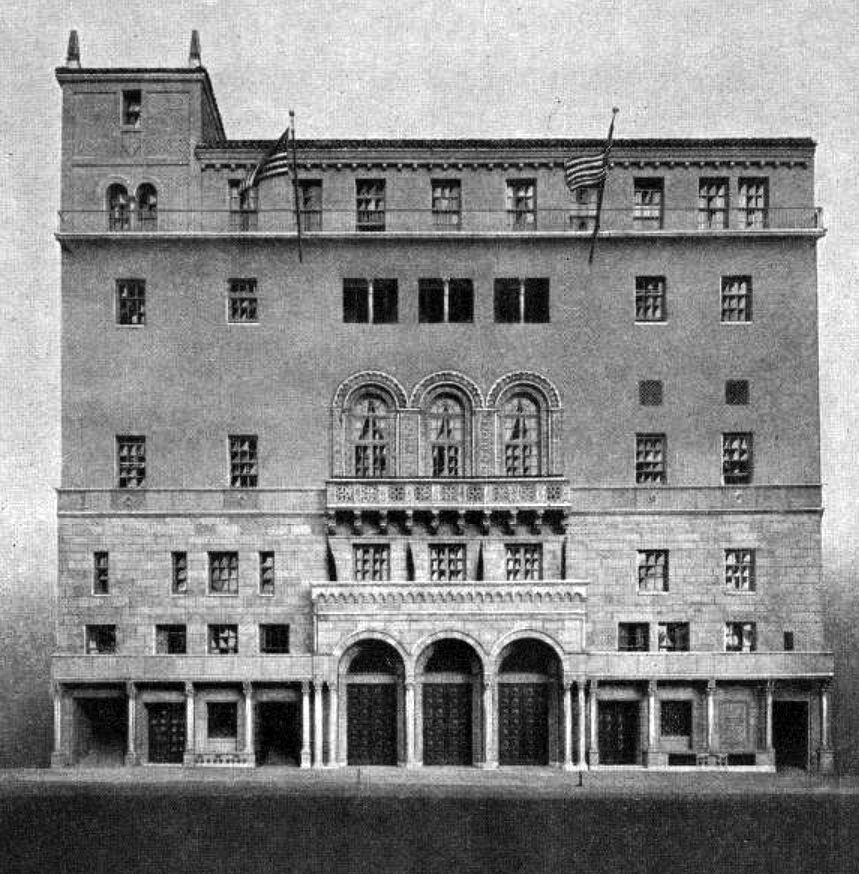 |
|
| (1924)^.^ – View showing a sketch (or model) of the Friday Morning Club’s 2nd Building located on the same site as the original Club Building building, 940 South Figueroa Street. |
Historical Notes The Friday Morning Club was founded by suffragist and abolitionist Caroline Severance. In 1922, the members announced plans for brothers James & David Allison to design and build a five-story clubhouse on Figueroa Street, replacing a 1900 structure already in use. The club opened in April, 1924, at a cost of over $750,000. Over the doorway is carved their motto: ‘In Essentials Unity – In Nonessentials Liberty – and In All Things Charity’* Among the clubs interests were intellectual and literary pursuits. From its inception, however, the club was directly involved in political issues--women's rights, the movements that resulted in the establishment of Los Angeles Juvenile Court and a city library, and the preservation of landmarks. The club started the movement that put women on the board of education. It campaigned for harbor development at San Pedro. It fought to preserve the redwoods and the California missions. It sponsored food and drug legislation. At its peak, the club boasted 3,800 members.^ The Figueroa Hotel was built directly across the street from the Friday Morning Club in 1925. It was also financed and run by women, to meet the needs of business, professional, and traveling women in Los Angeles. The two are a microcosm of the increasingly important and complex roles women were playing in American society in the 1920s. |
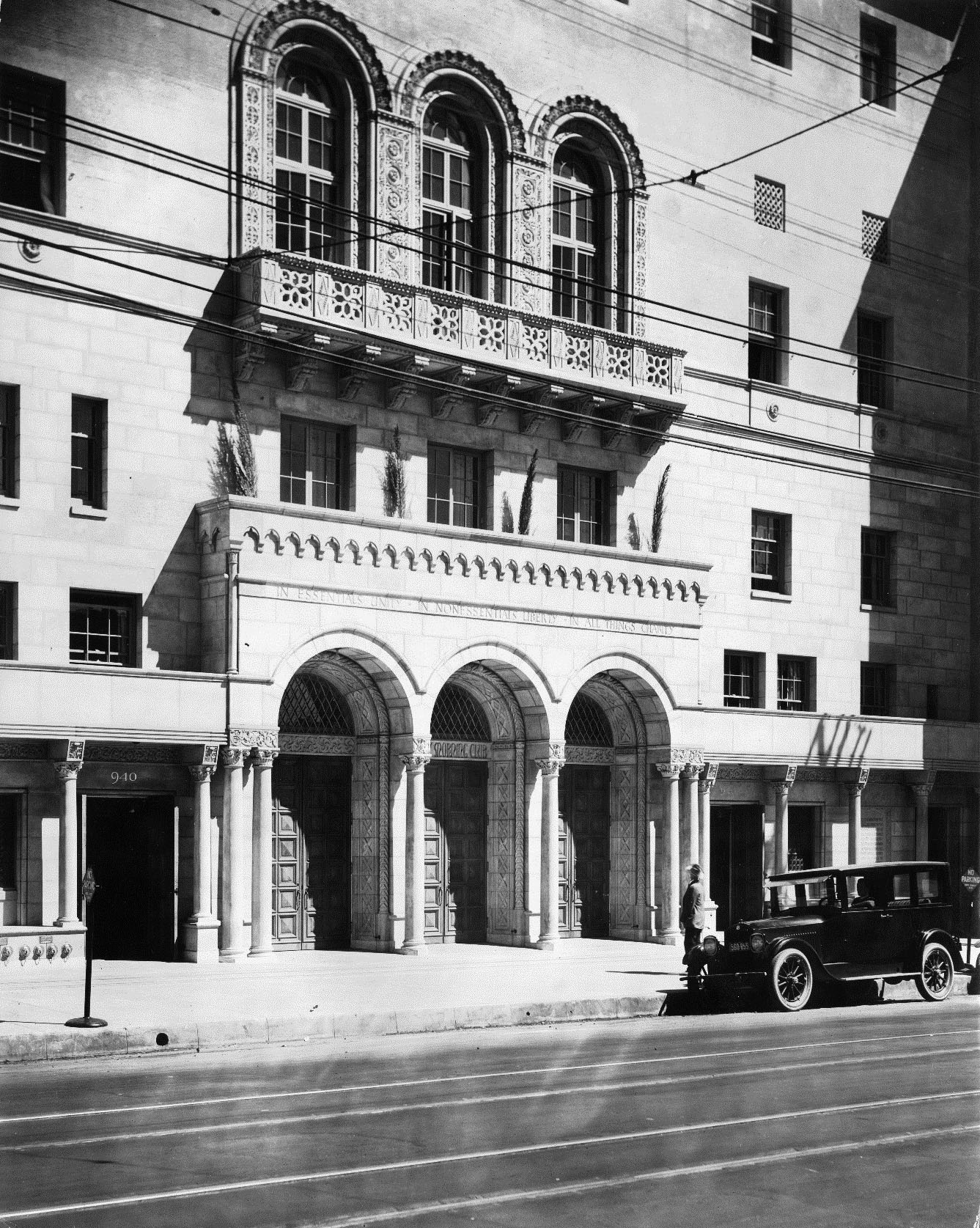 |
|
| (ca. 1925)^*# – A man is standing in front of an early model car looking up at the new Friday Morning Club Meeting Building located at 940 S. Figueroa Street. |
Historical Notes Opened: May 5, 1924 as the Friday Morning Club, a social and political group for women that had been founded in 1891. Will Rogers was the toastmaster at the opening and guests included Charlie Chaplin and C.B. DeMille. The idea was that the main theatre, known as The Playhouse, would generate revenue to support the building. Speakers included Eleanor Roosevelt and Dorothy Parker. Live radio shows from the building included performers such as Al Jolson and Eddie Cantor.^ |
.jpg) |
|
| (ca. 1925)* – Close-up view showing two men walking in front of the entrance to the Renaissance Revival-style Friday Morning Club Building. Note architectural designs over arches over the entranceway and windows above. Architects: Allison and Allison |
Historical Notes The building contained offices, lounges, a library, assembly/dining room with seating for 500, an art gallery and two small clubrooms. The 1,100-seat auditorium occupies first floor. The 500-seat auditorium on the third floor was leased out as The Playroom, a live venue and vaudeville house. It is said that Clark Gable made his acting debut here in “Romeo and Juliet” in May of 1925.* |
 |
|
| (1926)* - View looking southeast across Figueroa Street showing the Friday Morning Club and Figueroa Playhouse. The Playhouse marquee reads: “Coming Pauline Frederick”. The church seen in the distance is the Immanuel Presbyterian Church, located on the southeast corner of what is now Figueroa Street and Olympic Boulevard. |
Historical Notes The auditorium, originally called The Playhouse, was immediately leased to producers Louis O. Macloon and his co-producer-director-wife, Lillian Albertson. The first staged play was 'Romance,' starring Doris Keane and emceed by Will Rogers, which opened on May 5, 1924. Charlie Chaplin and Cecil B. DeMille attended the premiere. |
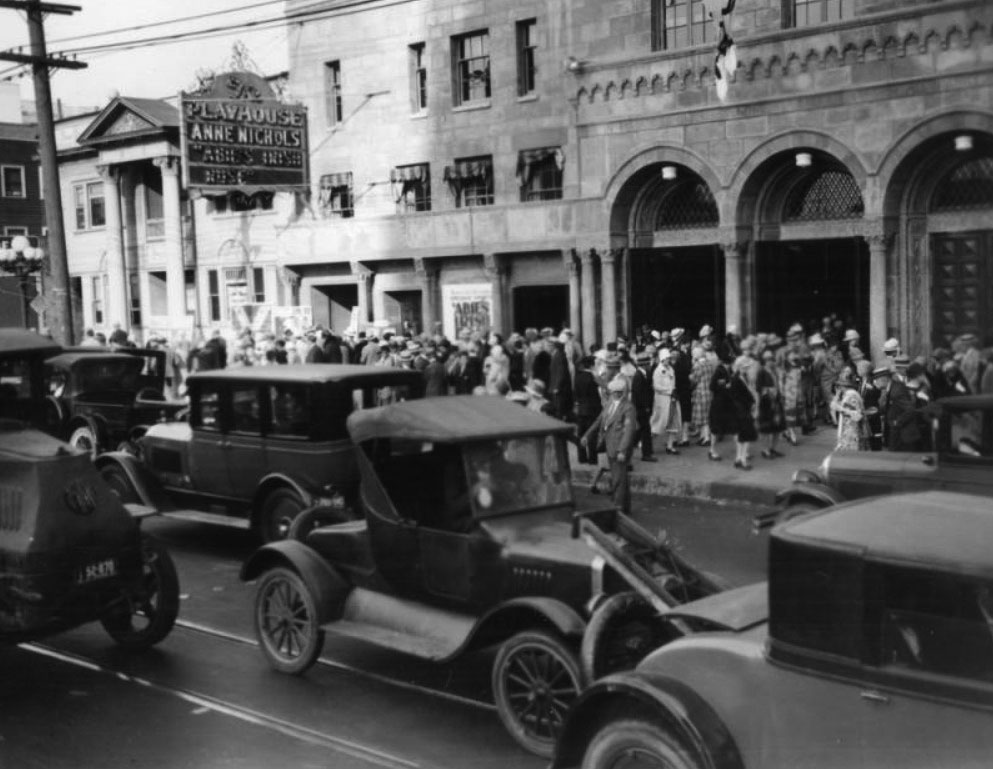 |
|
| (ca. 1935)^ - A view of Variety Arts Theater which at the time of this picture was named Figueroa Playhouse. Across the view of cars in the street you can see a crowd of people on the sidewalk and the marquee: "Anne Nichols Abie's Irish Rose." |
Historical Notes From 1932 to 1938, CBS Radio Playhouse used the auditorium to broadcast 'The Burns and Allen Show' as well as radio broadcasts by Al Jolson and Eddie Cantor. Even Eleanor Roosevelt allegedly spoke there. ^ |
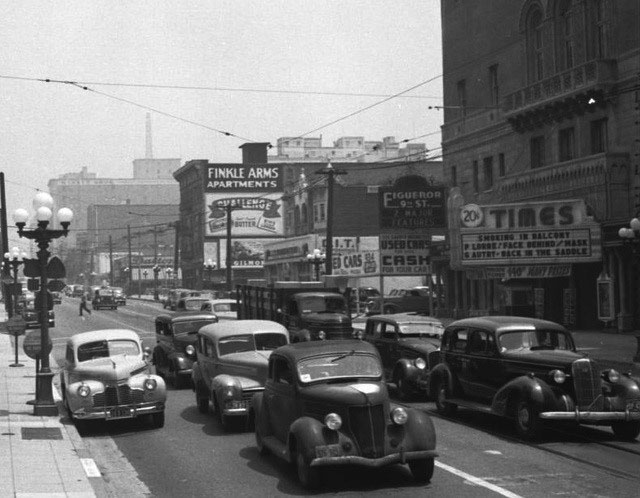 |
|
| (ca. 1941)^.^ – View looking north on Figueroa Street towards 9th Street showing the Friday Morning Club building on the right. The sign on the theatre marquee now reads “Times”. Movie now playing is “Back in the Saddle” starring Gene Autry |
Historical Notes In 1940, the auditorium was renamed the Times Theater, which tried to fill its calendar with stage shows, lectures and an occasional movie screening. However, the theater began losing its luster. ^ |
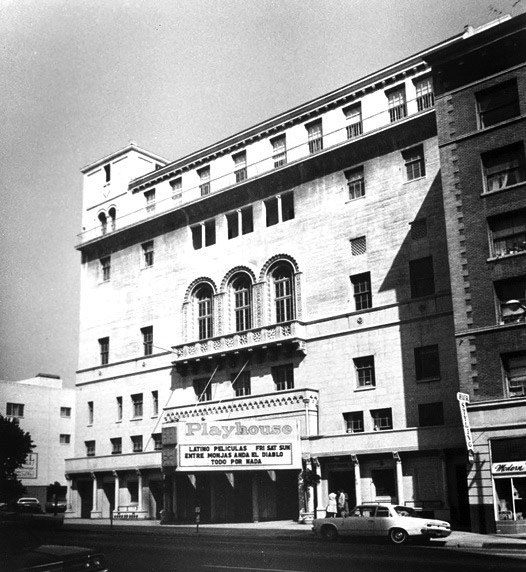 |
|
| (1970s)^.^ - View showing the Friday Morning Club with new marquee reading "Playhouse". |
Historical Notes After reverting the theater back to its original name, The Playhouse, the building was granted landmark status on August 9, 1978. |
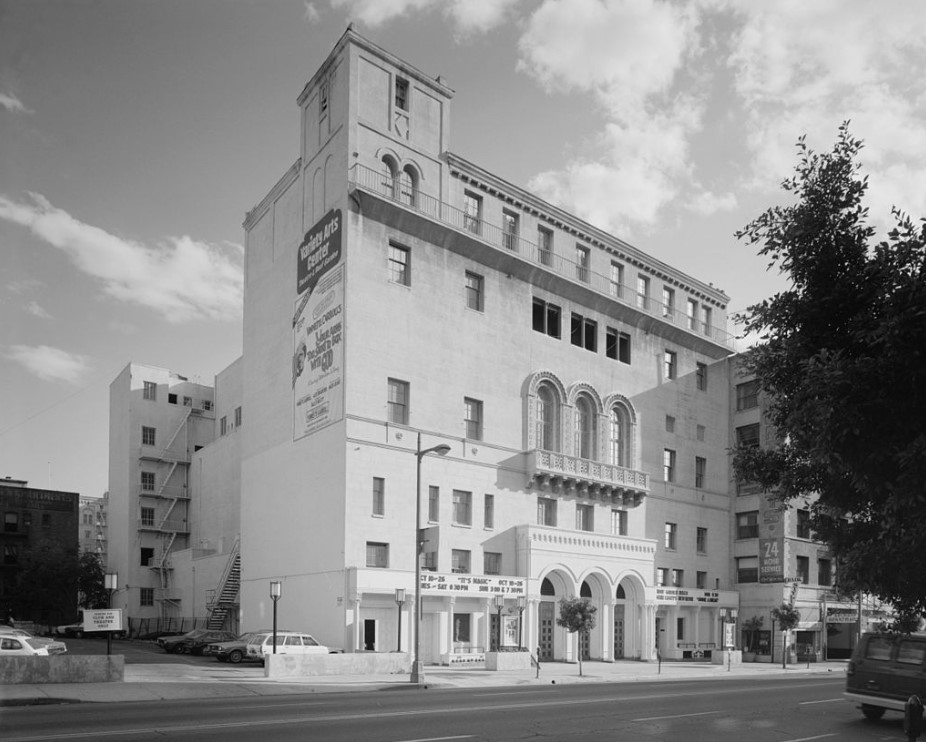 |
|
| (1980)^* – The Friday Morning Club building, 938-940 South Figueroa Street, as it appeared in the 1980s. |
Historical Notes The Friday Morning Club sold their headquarters in 1984 to a non-profit organization called the Society for the Preservation of the Variety Arts headed by Milt Larsen. Larsen, who owned the Magic Castle at the time, continued to use the building for live performances and opened a small museum dedicated to the vaudeville and the theatrical history of the building. The building was renamed the Variety Arts Center. In 1988, the Variety Arts Center closed due to Larsen’s failure to pay back taxes. Los Angeles’ Community Redevelopment Agency, who had initially loaned the Society for the Preservation of Variety Arts a half a million dollars for restoration purposes had to raise an addition $1.7 million to prevent the IRS from auctioning the landmark. Paul Sehdeva purchased the building in 1989 and operated a nightclub there for a short time. ^ |
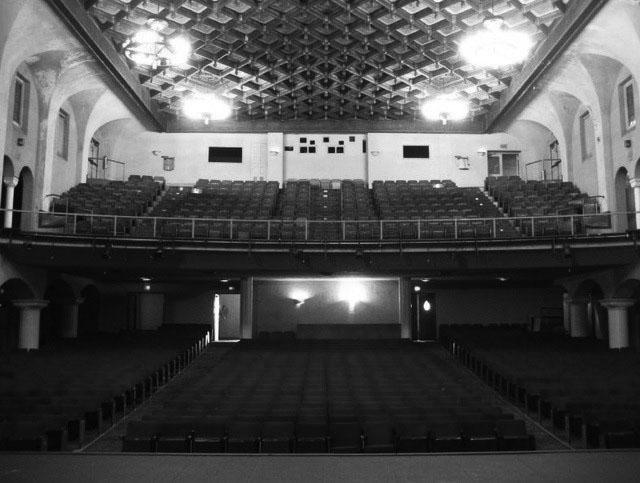 |
|
| (ca. 2010s)^.^ – Interior view of the Variety Arts Theatre Auditorium (Friday Morning Club Building) as seen from the stage. |
Historical Notes The Variety Arts Center Building is a Los Angeles Historic-Cultural Monument. It was added to the National Register of Historic Places in 1984, meeting the criteria for both social history and architectural significance. |
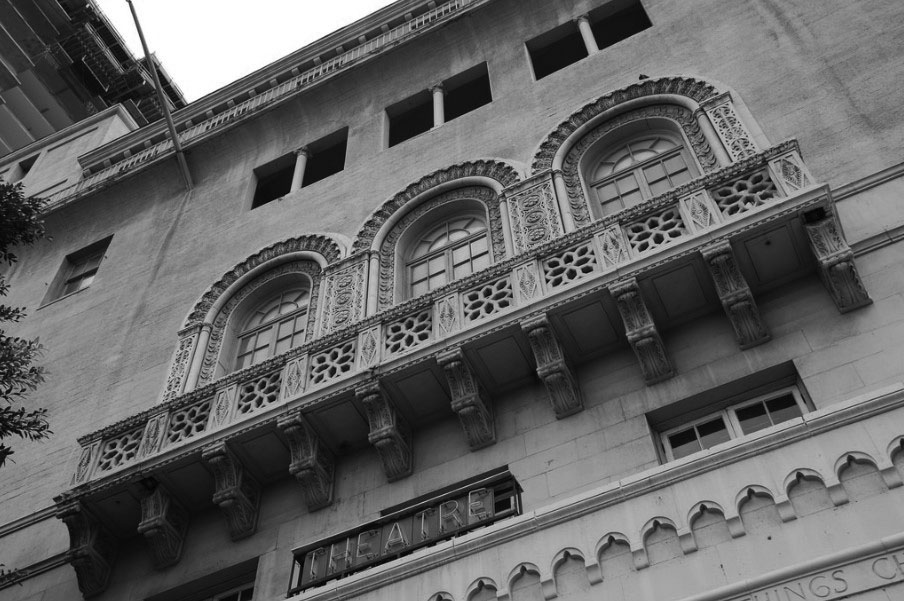 |
|
| (2008)^*^ – Close-up view showing the ornate arched window of the Variety Arts Center Building (formerly Friday Morning Club Building). |
Historical Notes In 2004, The Anschutz Entertainment Group (AEG) bought the Variety Arts Center for around $8 million, but was unsuccessful in their attempt to incorporate the property as part of their L.A. Live area. Originally, AEG had eyed the strip of land between Staples Center and the Variety Arts Center for the a $2.5 billion L.A. Live sports and entertainment district, featuring big-name restaurants, retail shops, a theater, movie complex, ESPN broadcast center, housing and a hotel. The proposed development was later abandoned.* |
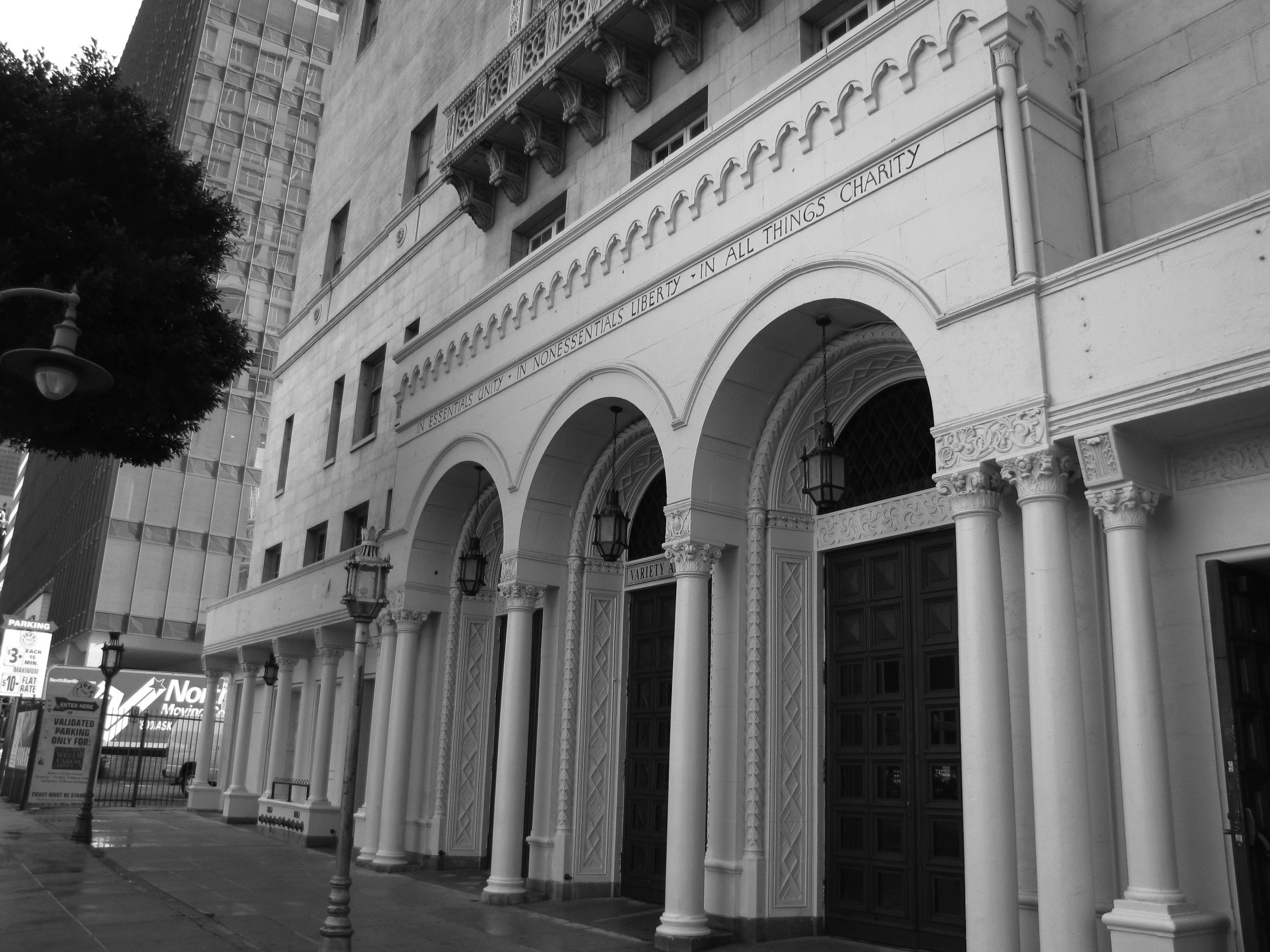 |
|
| (2010s)^x^ - Variety Arts Theater (Friday Morning Club). Engraved sign over front entrance reads: ‘In Essentials Unity – In Nonessentials Liberty – and In All Things Charity’ |
Historical Notes In late 2006, David Houk, former owner of the Pasadena Playhouse, bought the building from AEG for an undisclosed amount. However, in 2008, Houck told The Los Angeles Times that he was 'unable to secure the federal tax credits he had hoped would help fund restoration and operation…so now he must sell it or find a new partner willing to buy into his dream of bringing the old stage back to life.' In the meantime, the building is occasionally rented out for film and television productions, photo shoots and fashion shows."* |
* * * * * |
Gamut Auditorium
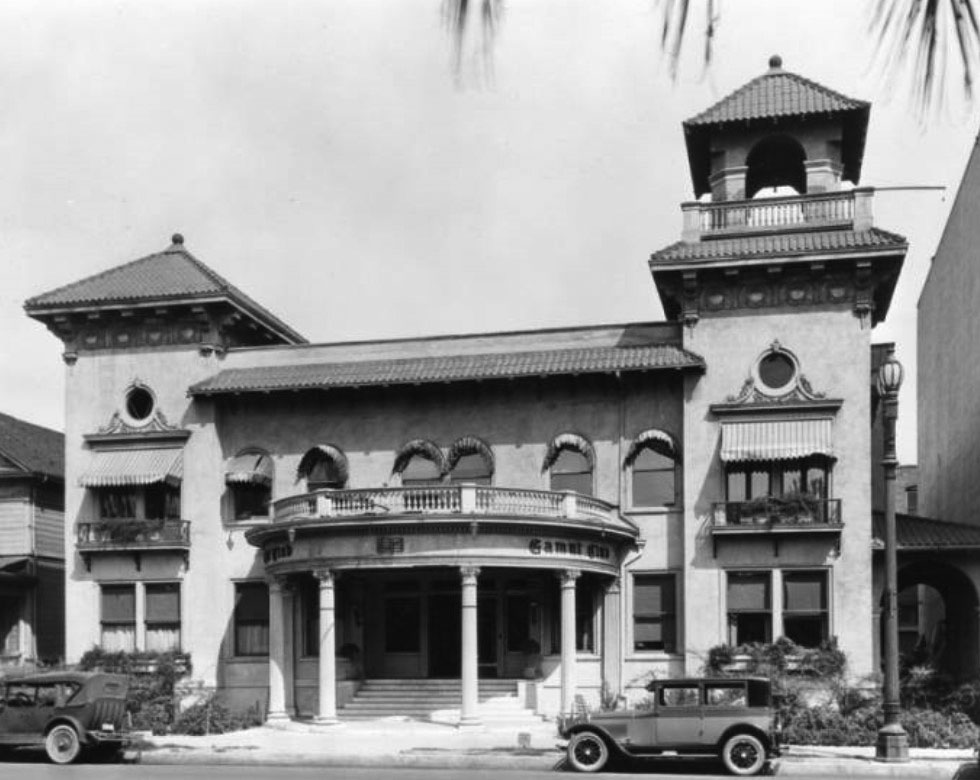 |
|
| (1926)* - View showing the Gamut Club Building (aka Gamut Auditorium) located at 1044 S. Hope Street. A musical symbol is seen above the entrance. |
Historical Notes Opened in 1904 as an exclusively male musical society by L.E. Behymer and other L.A. musicians. Soon the Gamut Club broadened its focus to other types of artists as well as local people of "artistic tastes." Behymer was also involved in the production of opera at Hazard's Pavilion and became the head of the Los Angeles Civic Light Opera, presenting at the later building on the site at 5th and Olive, the Philharmonic Auditorium. Seating: 668 in the auditorium plus various other meeting, banquet rooms and music studios. The club was the scene of a great variety of musical performances. Status: The building has been demolished. It's unknown when the club ceased to be active (Late 20s?). It's listed in the 1923 city directory under "theatres." The site of the Gamut Club is now (2018) a parking lot.^ |
* * * * * |
Jonathan Club
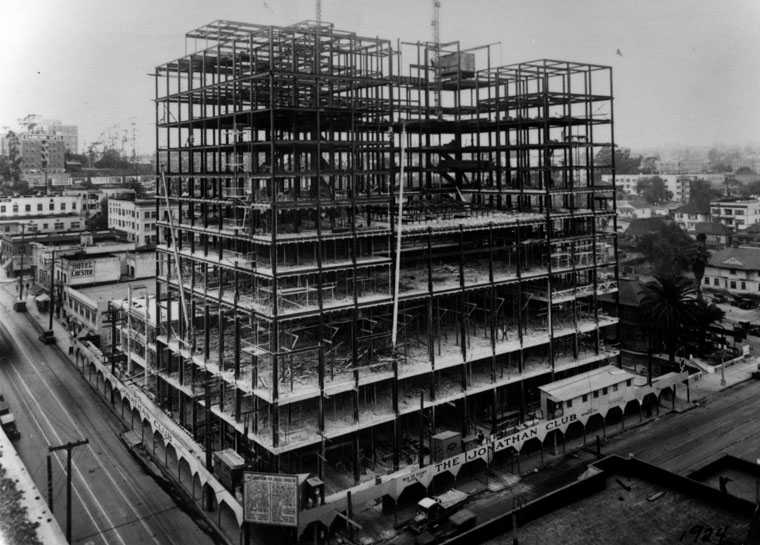 |
|
| (1924)* - Postcard view of the construction of the Jonathan Club building, with open steel frame. Date built: 1924. Architects: Schultze & Weaver. The new building is located at 545 S. Figueroa Street (NW corner of Figueroa and Sixth streets) where the Belleview Terrace Hotel once stood. |
Historical Notes In 1905, the club was headquartered in the monumental new Pacific Electric Building at 610 S. Main Street, which was the transportation hub for Southern California. According to the National Trust for Historic Preservation, "the top three floors of the building housed the exclusive and lavishly adorned Jonathan Club, one of the city’s most exclusive private clubs. In 1924 a contract was let for what Southwest Builder called a "magnificent new home" for the club — its present brick-faced structure at 545 S. Figueroa Street, one block west of the Los Angeles Central Library. In 1927 a second club, The Jonathan Beach Club, opened in Santa Monica at 850 Palisades Beach Road.^* |
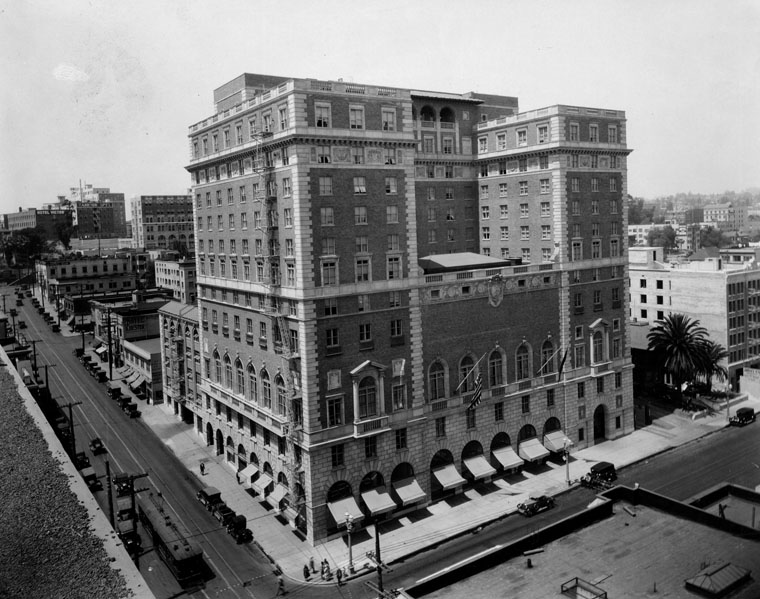 |
|
| (ca. 1925)* - Exterior view of the Jonathan Club building at Figueroa and 6th Streets. |
Historical Notes Established in 1894 as a political group Jonathan Club segued into a purely social club shortly after. The Club originally afforded an outlet through which members hosted political candidates, participated in political rallies and gathered for social activities. In 1895, Jonathan Club members determined that the social bond, and not the political one, was what interconnected its members. Jonathan Club was chartered as a “purely social club” by the State of California on September 23, 1895. +** |
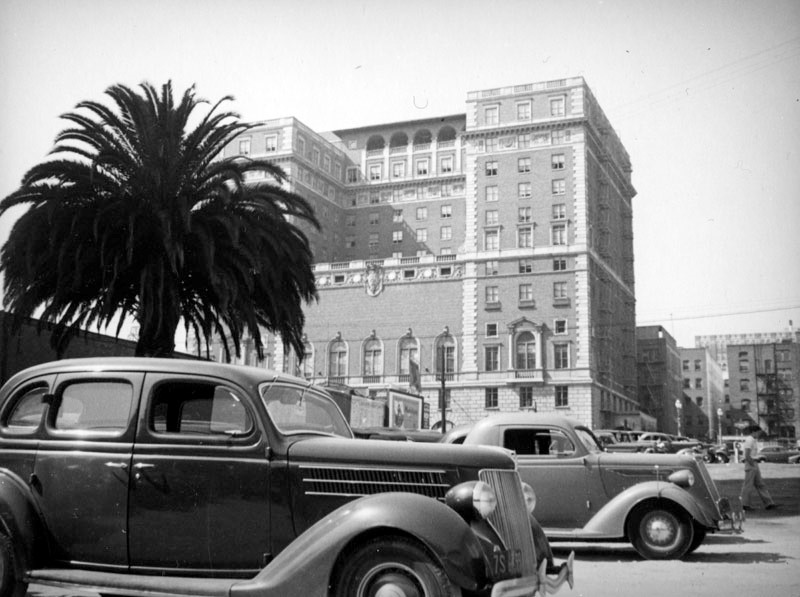 |
|
| (ca. 1937)* – View across a parking lot showing the Jonathan Club in the background. |
Historical Notes For most of its history, the club admitted only men, but since 1987 the club enjoys a diversified membership. When the Jonathan Club originated, only white, Anglo-Saxon, Protestant men were able to join. The club was alleged to have maintained discriminatory admission and access policies based on race and sex throughout the 20th century and into the 21st. The club admitted its first African-American and female members in 1987.^* |
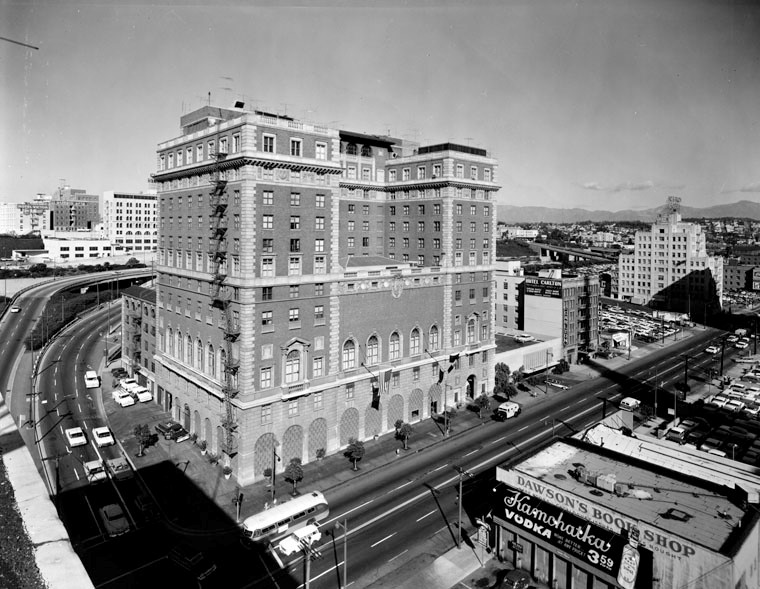 |
|
| (1960)* - View looking northwest showing the Jonathan Club at 545 S. Figueroa Street. Dawson's Book Shop can be seen across the street. |
Historical Notes The building was designed in a Beaux Arts version of early l6th Century Italian. Architects: Schultze & Weaver.* |
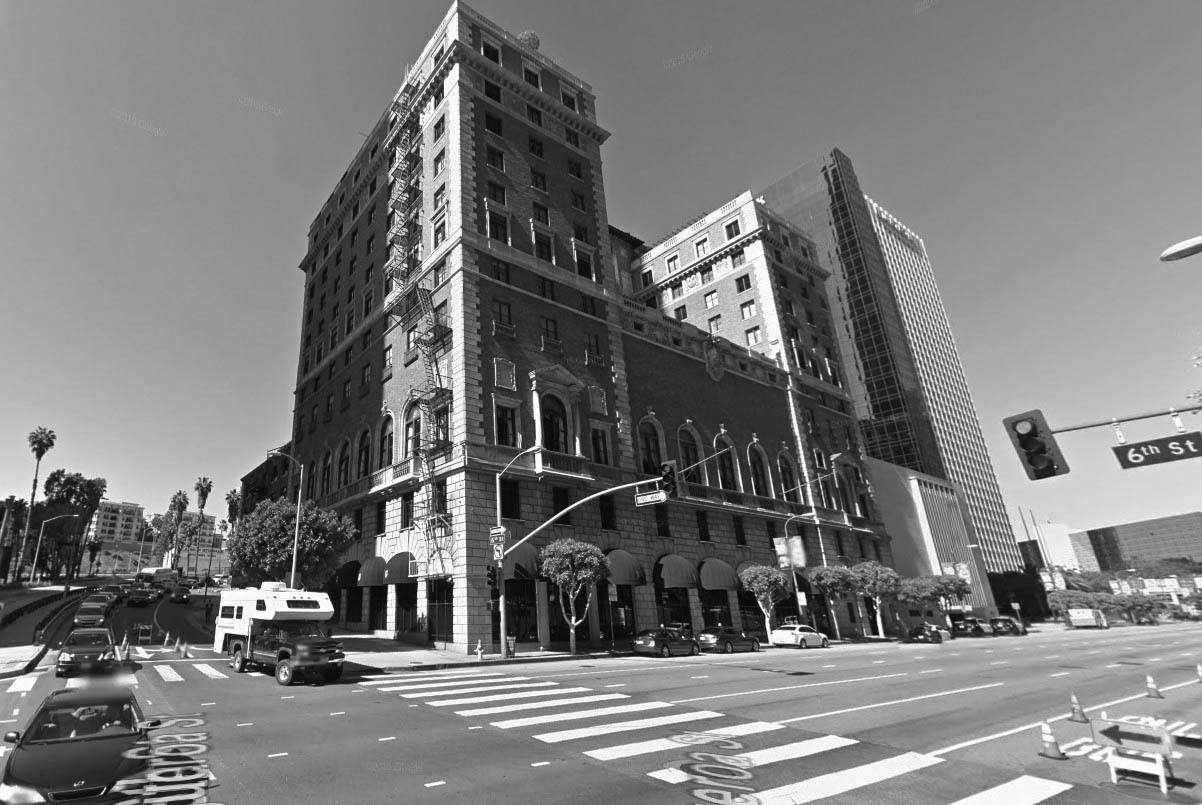 |
|
| (2015)#^^* – Google street view looking northwest toward the Jonathan Club from the intersection of Figueroa and 6th Street. |
Historical Notes Membership in the club is by invitation. For most of its history, the club admitted only white men, but since 1987 it has also admitted women and minorities.^* |
* * * * * |
Wurlitzer Building
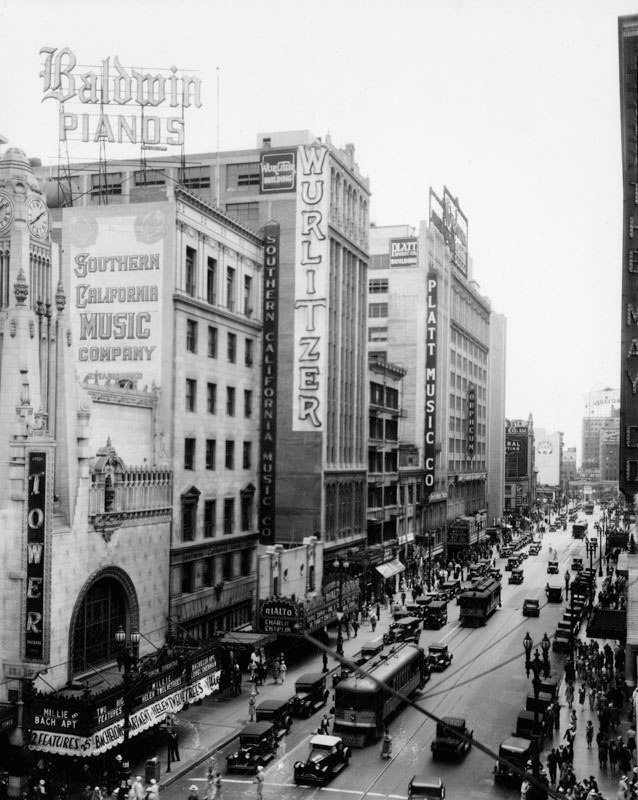 |
|
| (ca. 1924)* - View looking south on Broadway from 8th Street, showing the 13-story Wurlitzer Building located at center of block. |
Historical Notes The Wurlitzer was billed as "the world's largest music house" when it was designed by Percy Walker and Alber Eisen in 1924 (the Platt Building just down the block was also built to house music companies and had the same architects). In both buildings, one floor--according to Richard Schave of LAVA--was a concert hall, and the building was filled with practice rooms and offices. Franz Rudolph Wurlitzer opened his first shop in Cincinnati selling imported musical instruments but within a few decades was making violins, harps, juke-boxes and their best-known product, the “Mighty Wurlitzer” theatre organs. The company hit its stride during the early 20th century, when it built large organs for theaters that were--at that time--showing silent films, most of them pretty short and thrilling. Organs were ideal for that sort of venue because besides simply playing Bach loud enough for the sound to fill a large auditorium, organs "could produce a variety of sounds, from banjos to harps to orchestra bells to train whistles and galloping horses." * |
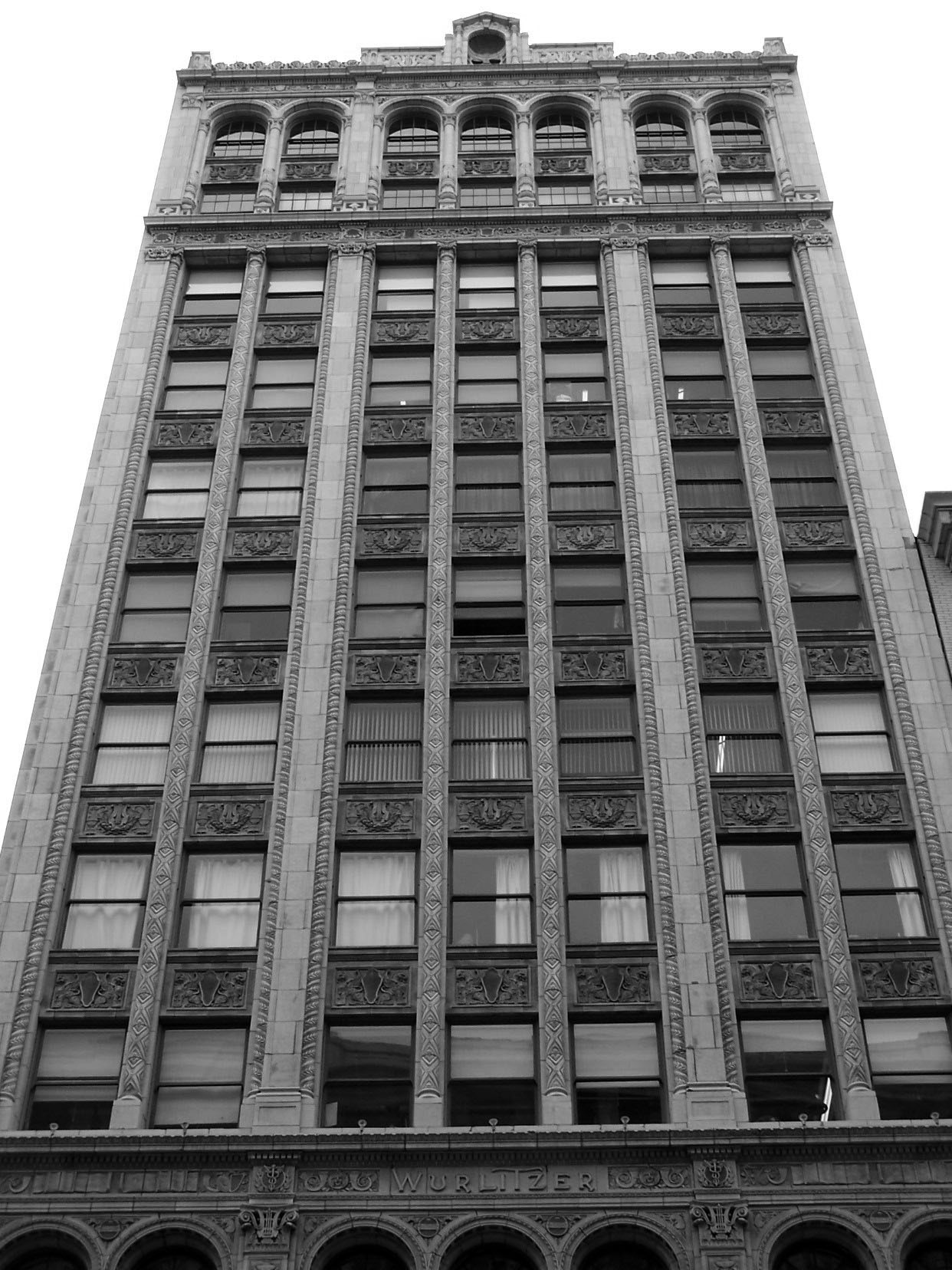 |
|
| (2010)*# – Front view of the Wurlitzer Building located at 818 S. Broadway (architects Walker & Eisen, 1924). |
Historical Notes The 13-story building would cost a million dollars to erect, and go up in six months-- incredible speed, according to an LA Times story in 1923. It confirms that that there would be a large recital hall, as well as a showroom for pipe organs. * |
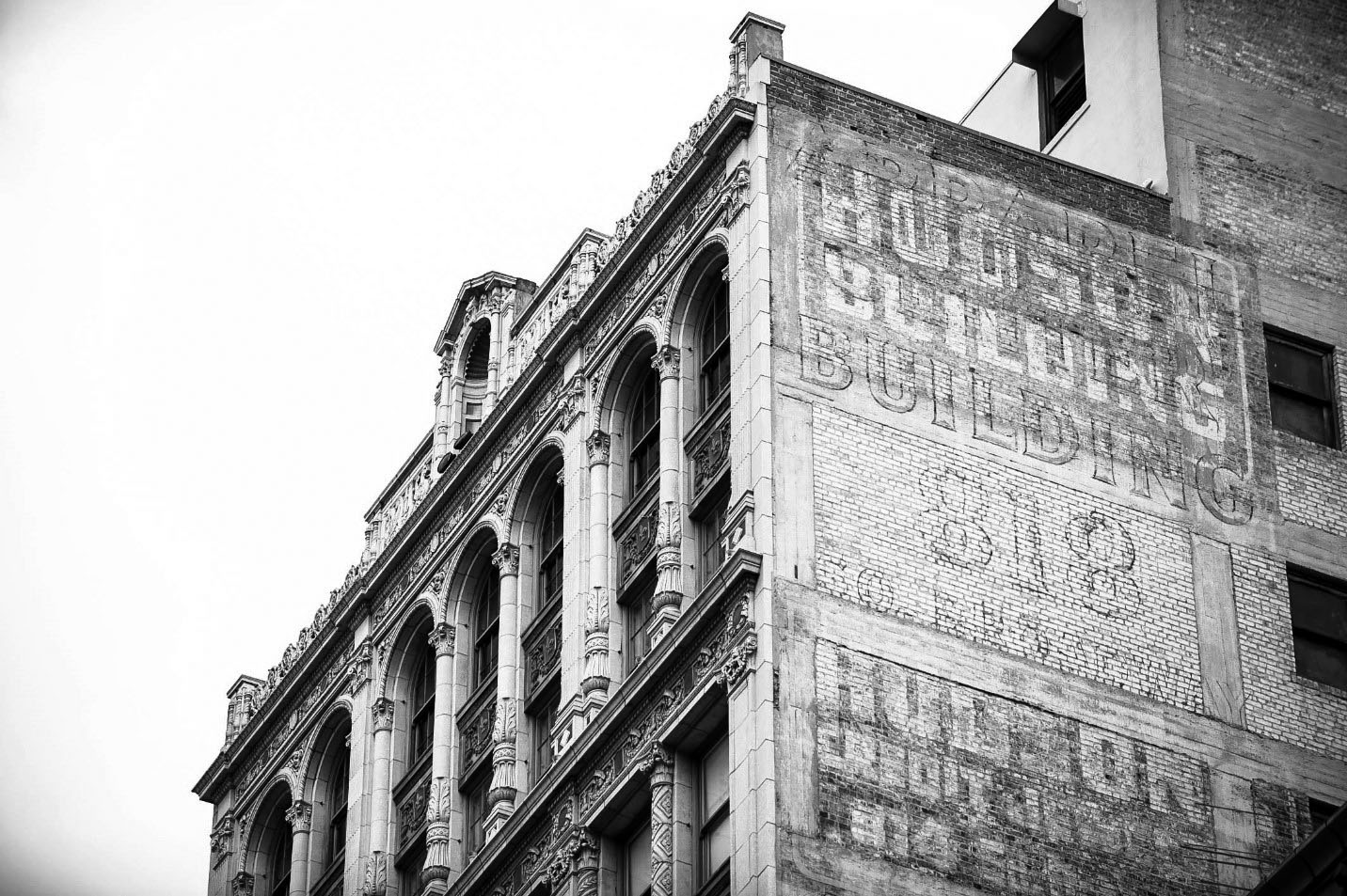 |
|
| (ca. 2016)^ – Close-up view showing the top two floors of the Wurlitzer Building. Over the years the Wurlitzer Building has been known by other names including the Apparel Center Building, Anjac Fashion Building, and apparently Hudson Building as seen on the side facing. |
Historical Notes In 1924, Wurlitzer occupied the bottom four floors and basement area, but leased out the top eight floors as loft space to other concerns. The other tenants of the Wurlitzer included millinery companies that sold hats and clothes, which we know because they suffered losses in fires in the 1920s. Since the building was concrete, the fires did not spread to other floors. * |
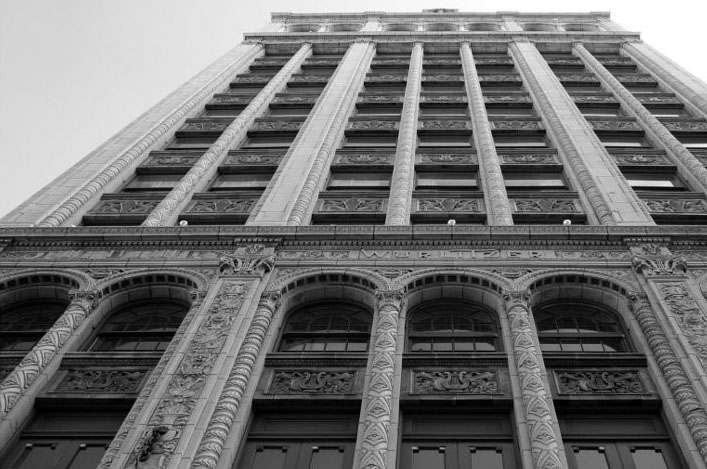 |
|
| (2010s)*^ – Looking straight up towards the top of the 13-story Wurlitzer Building located at 818 S. Broadway. |
Historical Notes Thirteen stories was the legal limit in those days (There was a 150’ height limit until 1957). The first floor usually encompassed a 2nd floor mezzanine, so that there was never a 13th floor. |
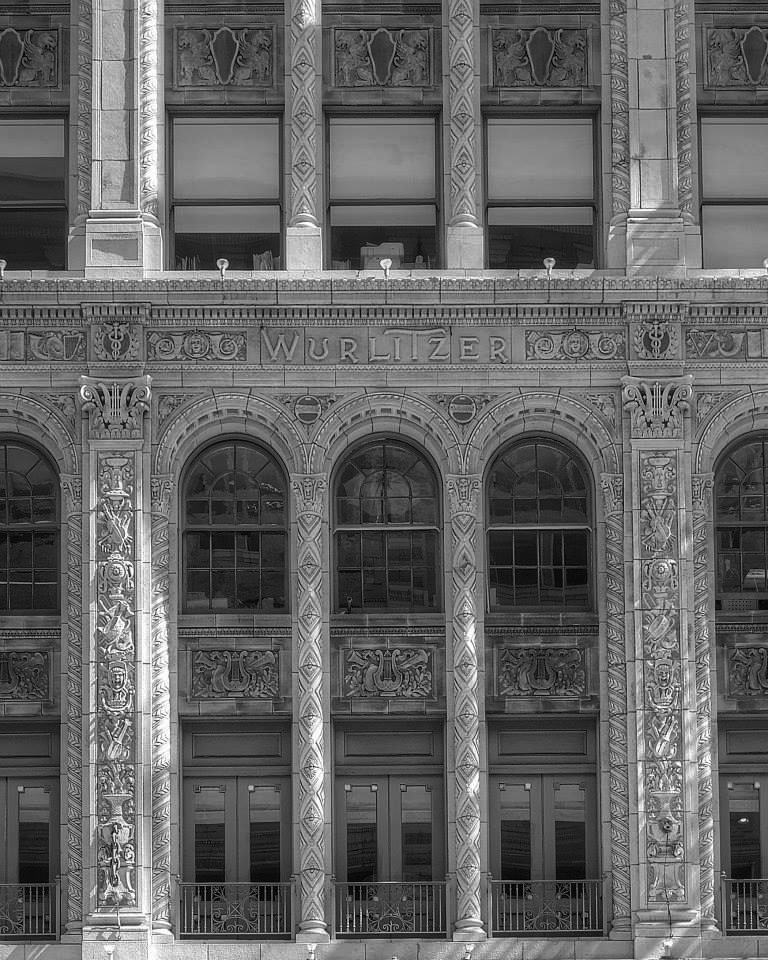 |
|
| (2014)^.^ – Wurlitzer Building close-up showing its unique Spanish Renaissance Revival detail design. |
Historical Notes The Wurlitzer's terra cotta facia, and its many hues, were covered by grime for far too long. But in 2007 the building was power-washed to expose its beautiful intricate ornamentation and designs. |
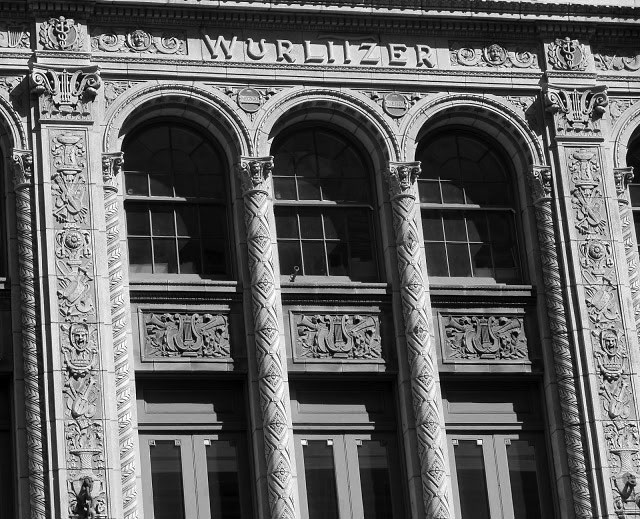 |
|
| (2013)^^ – Close-up detail view showing front facade of the Wurlitzer Building, 818 S. Broadway. |
Historical Notes If you look closely at the photo above, the names Mozart and Verdi are carved in the medallions beneath the Wurlitzer name. The detail of bas relief and sculpture on the place is incredible. |
* * * * * |
Platt Building
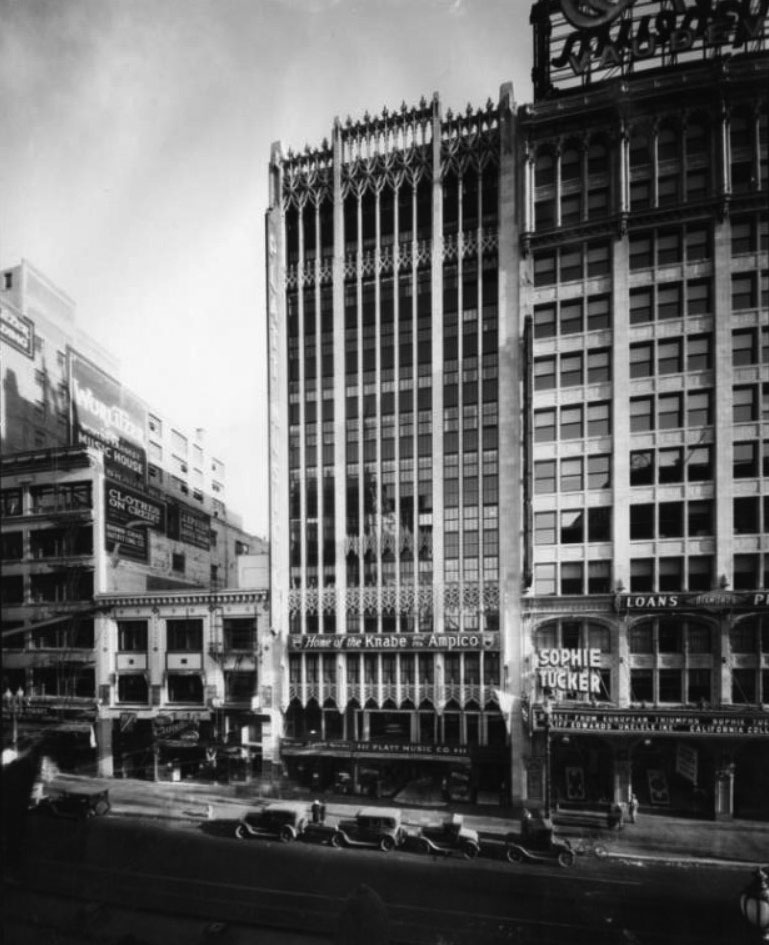 |
|
| (1927)* – View showing the Platt Music Company Building (center) at 832 S. Broadway with the Orpheum Theatre Building seen on the right. |
Historical Notes The Platt Music Company Building was constructed in 1927 and designed by architects Walker + Eisen who also designed the Wurlitzer Building just up the block at 818 S. Broadway. The same firm also designed the Beverly Wilshire Hotel in Beverly Hills.^ |
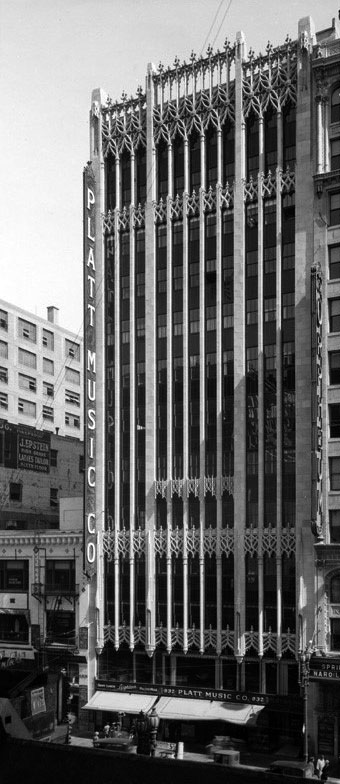 |
(1927)* - View showing the 13-story Platt Music Co. Building. Thirteen stories was the legal limit in those days (There was a 150’ height limit until 1957). The first floor usually encompassed a 2nd floor mezzanine, so that there was never a 13th floor. |
|
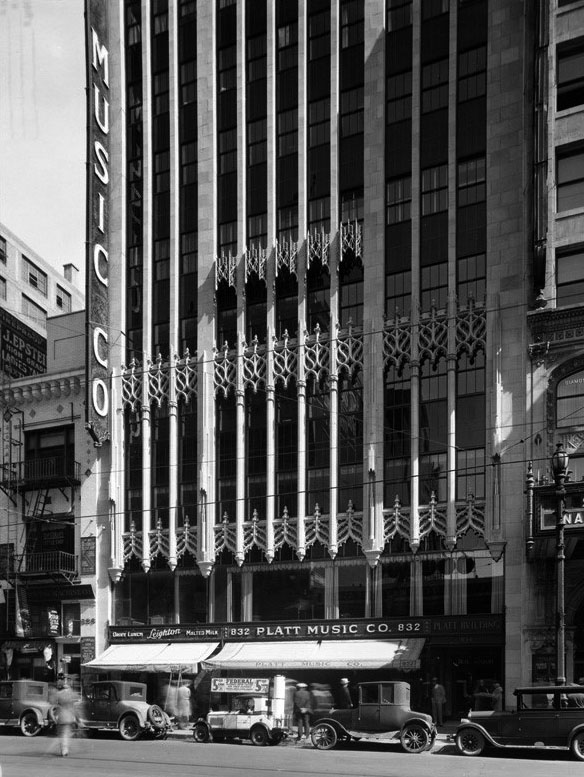 |
|
| (1927)* – Ground level view showing the entrance to the Platt Music Co. Building at 832 S. Broadway as seen from across the street (architects Walker & Eisen). |
Historical Notes The Platt Music Corporation, founded by Benjamin Platt in 1905, was a national retailer specializing in selling consumer electronics goods through leased operations in 135 department stores including Marshall Field's, Bloomingdale's, The May Department Stores Company and Emporium-Capwell.^ |
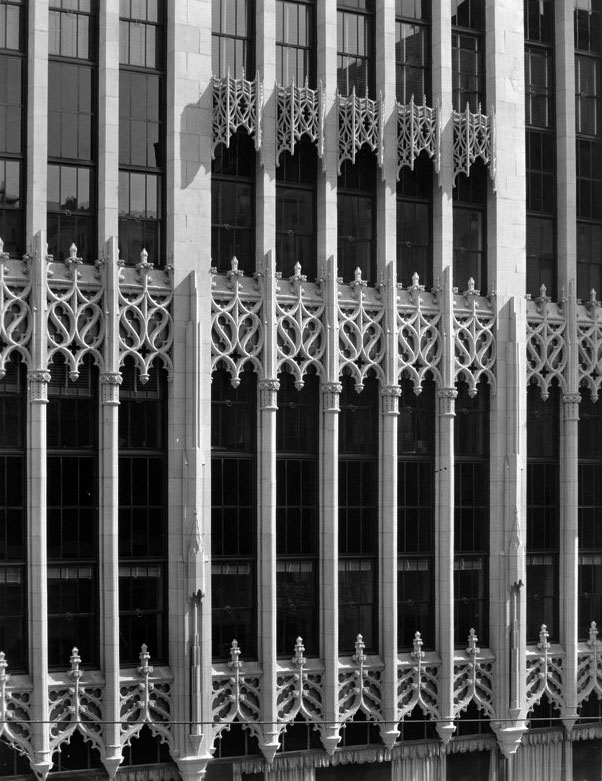 |
|
| (1927)* – View showing the center section and front facade of the Gothic Revival-style Platt Building. |
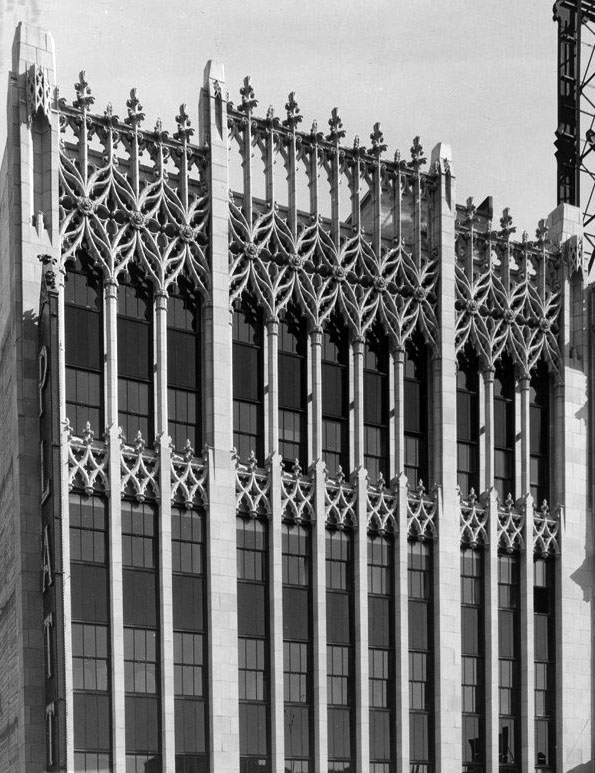 |
|
| (1927)* – View showing the top section of the Gothic Revival-style Platt Building, 834 S. Broadway |
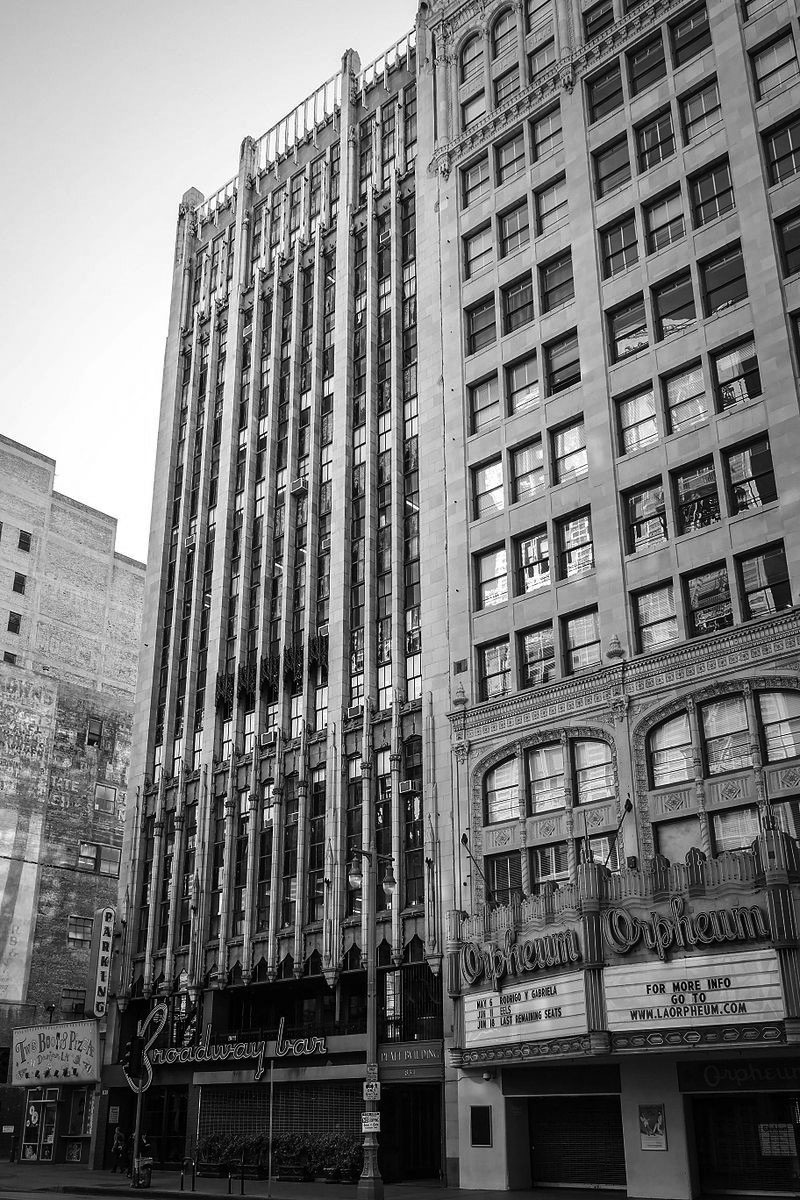 |
|
| (2014)^* - The Platt Building (left), also known as the Anjac Fashion Building, in the Broadway Theater and Commercial District of Los Angeles. The Orpheum Theatre is seen at right. |
Historical Notes The Platt Building is one of the Anjac Fashion Buildings, and the National Register of Historic Places nomination form for the Broadway Theater and Commercial District uses this name to designate the building. Anjac is a portmanteau of the names Annette and Jack Needleman, real estate owners who in 1964 began buying properties in the Fashion District and surrounding area.* |
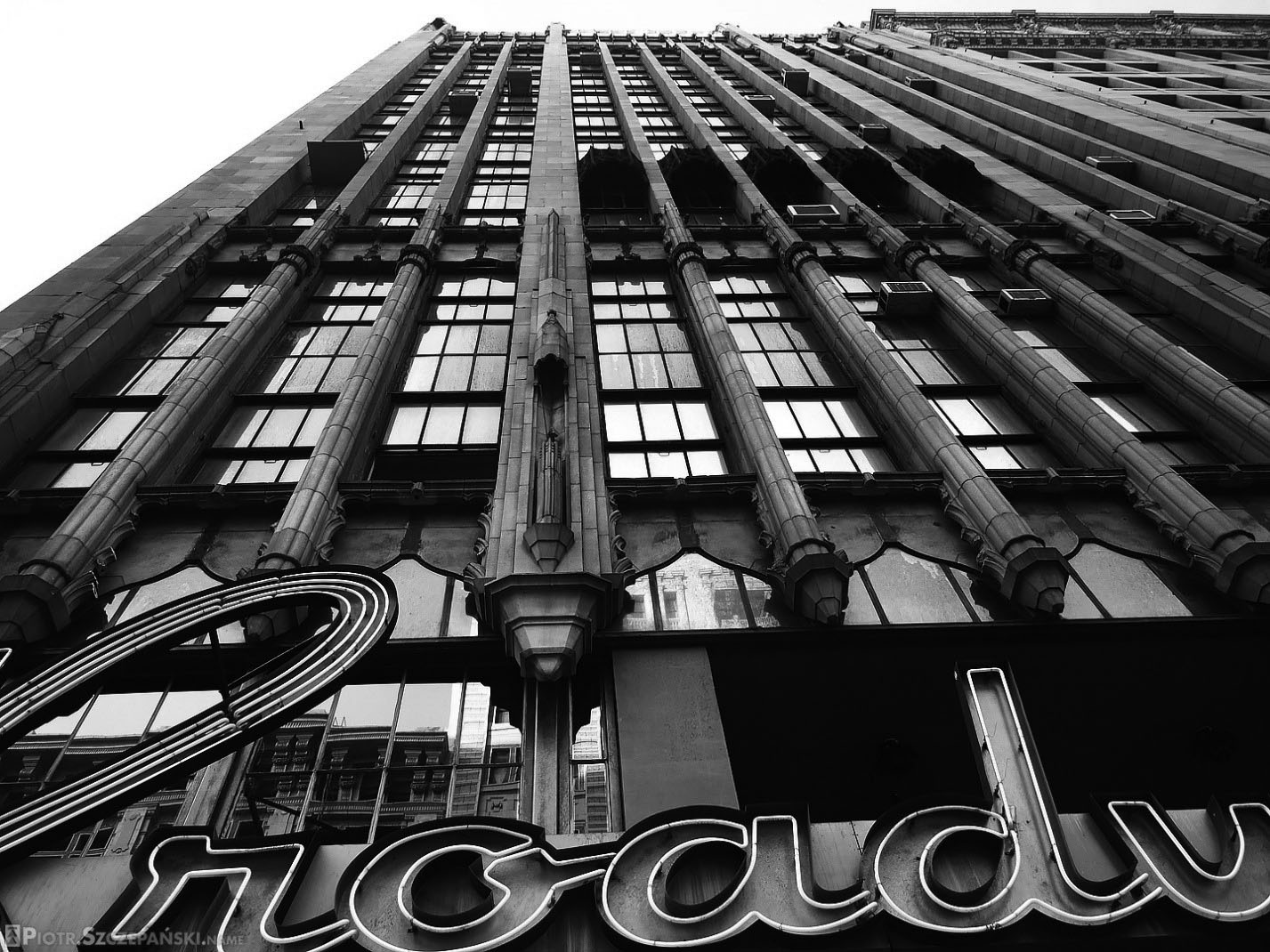 |
|
| (2014)*# – Looking up towards the top of the Platt Building with the Broadway Bar ground floor. |
Historical Notes The Broadway Bar (within the Platt Building) has been opened since 2005. The two-story bar is decked out in leather sofas, vintage brass sconces and colors including purple, black and deep blue. |
* * * * * |
Montmarte Cafe
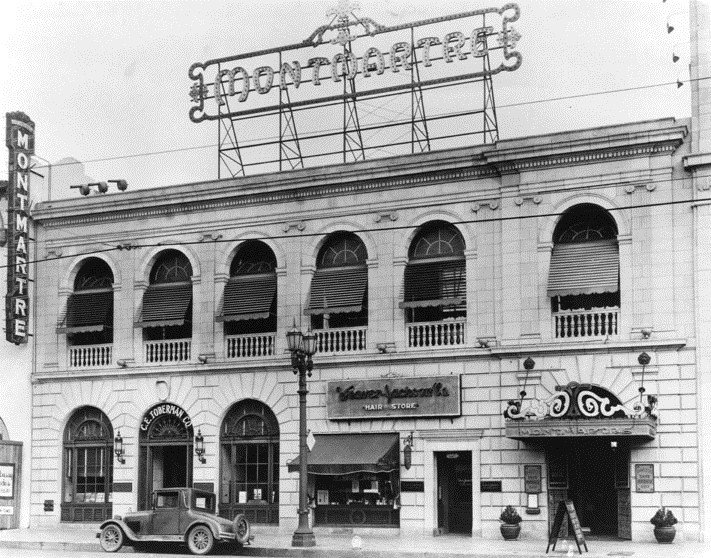 |
|
| (1924)* - The Montmartre name is on the top and the corner of the building, and over the doorway on the right. To the left are the doorways of a hair store, and of the C.E. Toberman Co. Six windows across on the second floor each have individual shade awnings. |
Historical Notes Eddie Brandstatter was one of Hollywood's greatest early restaurateurs. A native of France, he worked in Paris, London and New York restaurants before moving to Los Angeles in the 1910s. In 1923 he built the famous Cafe Montmartre, designed by Meyer and Holler, at a cost of $150,000. This establishment was described as "the center of Hollywood life", where stars usually frequented, and which was the place to see and be seen. |
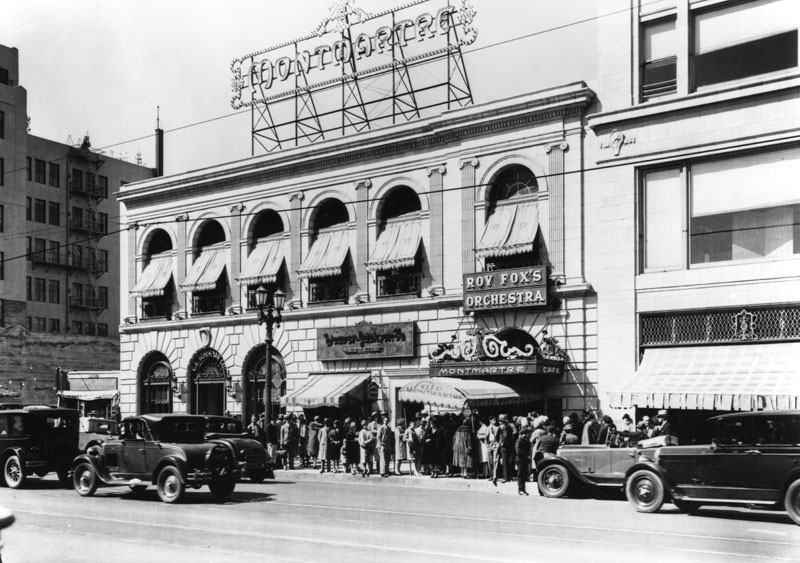 |
|
| (ca. 1928)* - Exterior view of the Montmartre Cafe, located at on Hollywood Blvd. between Highland and McCadden. It has a large lighted sign on top, and another which features Roy Fox's Orchestra. Crowds of people are waiting in line to get into the Cafe. |
Historical Notes Eddie Brandstatter was "Host of Hollywood" and catered to Hollywood stars in the 1920s and 1930s. He was owner and manager of the fashionable Montmartre Cafe, Embassy Club and Sardi's.* |
Click HERE to see more in Early Views of the Hollywood (1920 +) |
* * * * * |
Hellman Commercial Trust and Savings
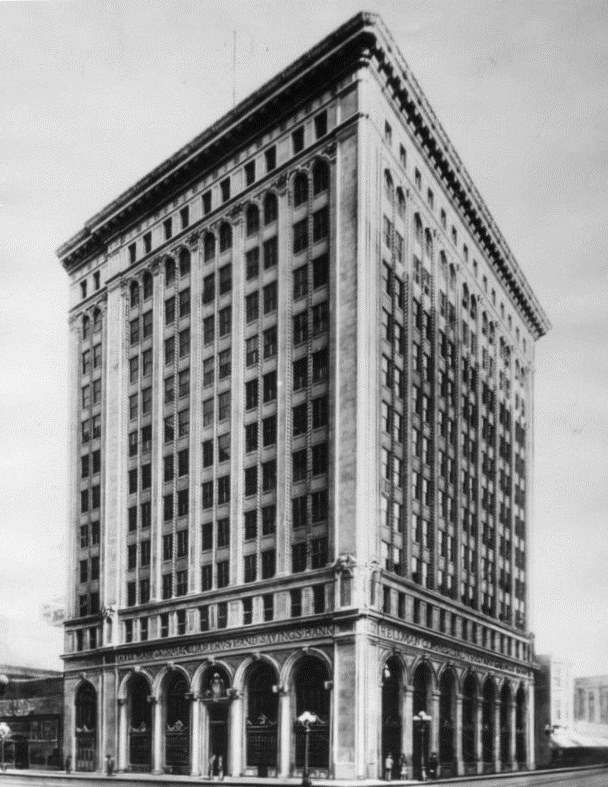 |
|
| (ca. 1924)* - Exterior view of Hellman Commercial Trust and Savings Bank in the original financial district of Los Angeles, on the northeast corner of South Spring and West 7th streets. |
Historical Notes Built in 1924, the Beaux Arts office building was designed by architects Schultze and Weaver. The bank later became the Bank of America.* |
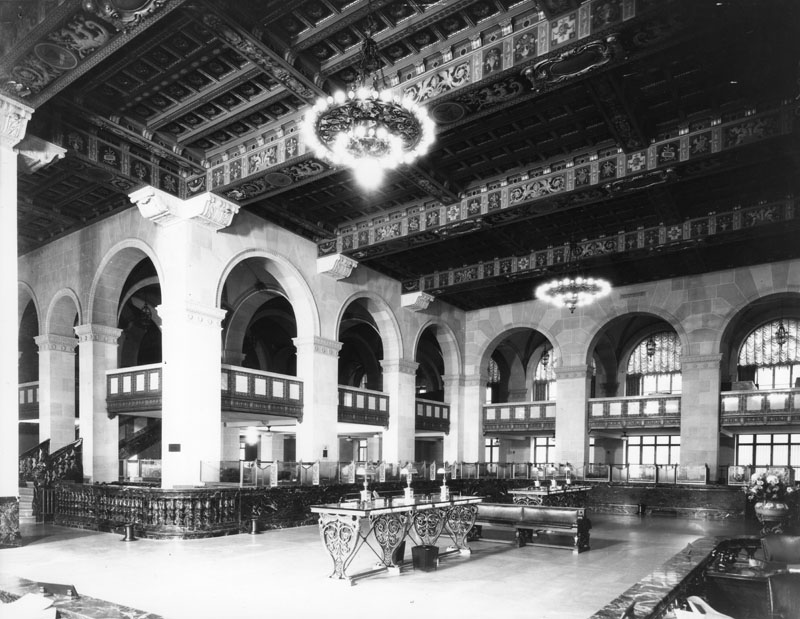 |
|
| ca. 1928)* - An interior view of the Merchants Trust and Savings Bank, located on the NE corner of So. Spring St. & W. 7th St. This was formerly the Hellman Commercial Trust & Savings, which later became Bank of America. On view here is the lobby with tables, counters and benches, with a stairway on the far left leading to the 2nd floor. The many arches emphasis the 2nd floor and the decorated ceiling with hanging chandeliers. |
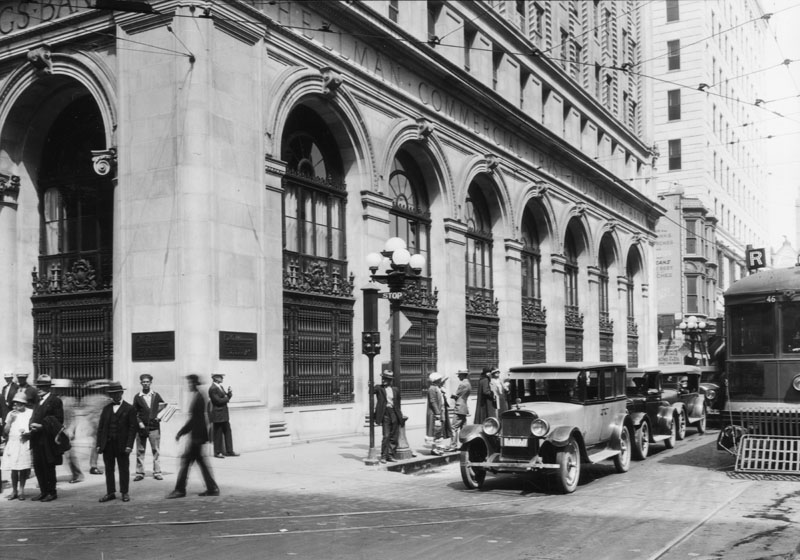 |
|
| (ca. 1924)* - Street level view of Hellman Commercial Trust and Savings Bank. The street scene shows people, cars, and a streetcar all going about their way in the busy Los Angeles' financial district. |
* * * * * |
Elks Club
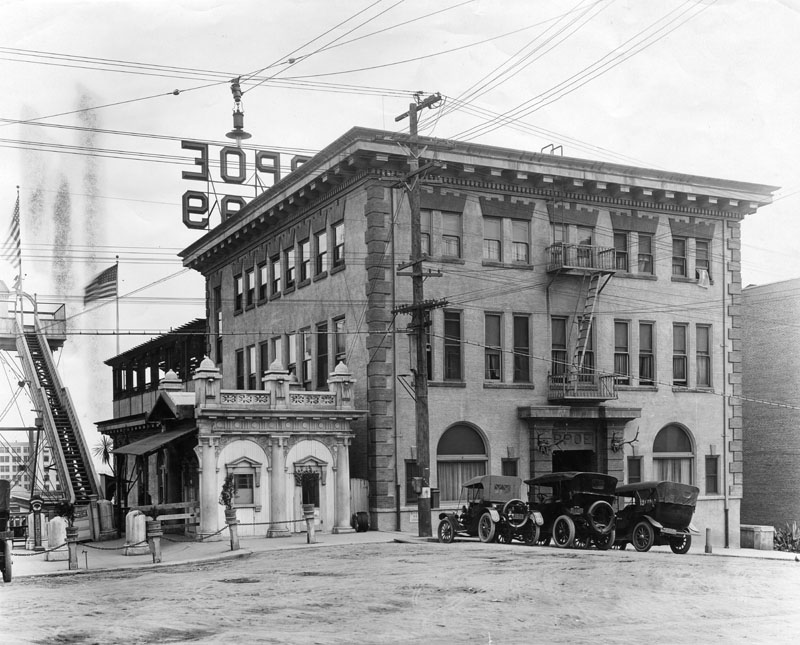 |
|
| (ca. 1920)* - The old Elks Club building on Olive and 3rd Street on Bunker Hill. The lookout tower to the left is that which overlooks Angels Flight. Elk antlers are at the entrance. |
Historical Notes The Elks had modest beginnings in 1868 as a social club (then called the "Jolly Corks") established as a private club to elude New York City laws governing the opening hours of public taverns. After the death of a member left his wife and children without income, the club took up additional service roles, rituals and a new name. Desiring to adopt "a readily identifiable creature of stature, indigenous to America," fifteen members voted 8-7 in favor of the elk above the buffalo. The name Elks is short for The Benevolent and Protective Order of Elks (BPOE; also often known as the Elks Lodge).^* In 1924, the Elks moved to a new building built for them at 607 Park View St. across from MacArthur Park (now the Park Plaza Hotel).^* |
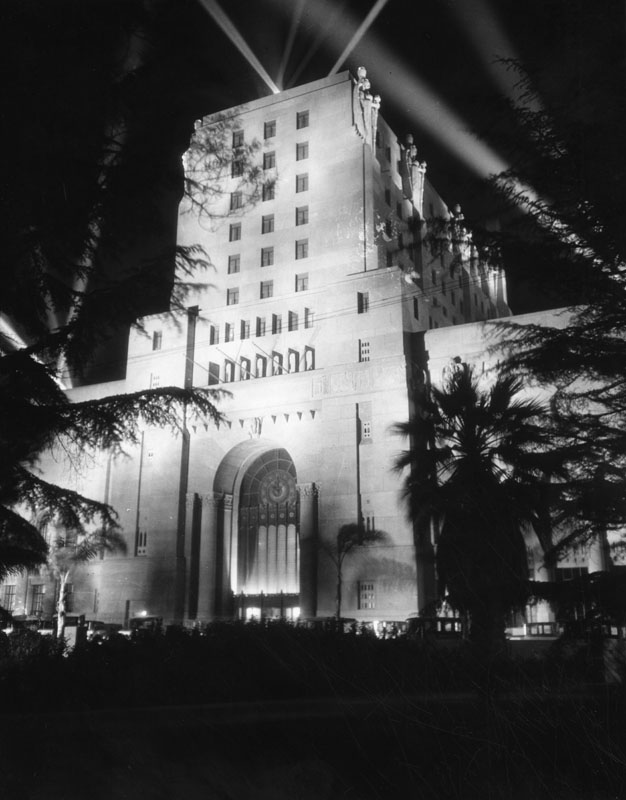 |
|
| (ca. 1924)* - Exterior view of the Elks Club building at 607 South Park View Street. Searchlights beam into the sky, illuminating the building at night. The outline of parked cars may be seen in front of the building. |
Historical Notes The Elks Club Building was originally designed for the Benevolent and Protective Order of Elks (B.P.O.E). by renowned Art Deco architect Claud Beelman, during the time he was a Senior Partner at the prestigious firm he co-owned in the 1920s, Curlett and Beelman. The building was constructed between 1923-1924.^* |
 |
|
| (1925)* - Interior view of the Lodge Room at the Elks Club on 607 South Park View Street. |
Historical Notes The elaborate interior murals and decorative paintings were designed and executed by Anthony Heinsbergen and Co, noted painter of many Los Angeles cultural landmarks. The central design of the lobby ceiling is based on the Villa Madama, a Renaissance era project by Raphael and Giulio Romano.^* |
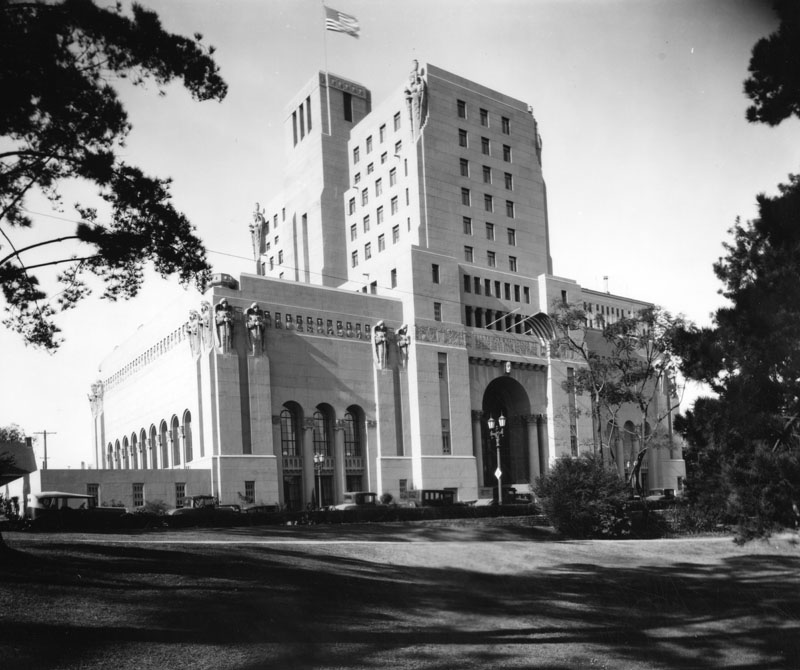 |
|
| (ca. 1924)* - Exterior view of the Elks Club as seen from the park. View shows the architectural designs and statues at the top of the building, the corners and at the very top corners of the building. |
Historical Notes Eventually, the Elks sold the building due to shrinking attendance in their ranks, and the building ended up being transformed into a luxury hotel (Park Plaza Hotel), set perfectly then on the shores of what was once a very glamorous MacArthur Park.^* |
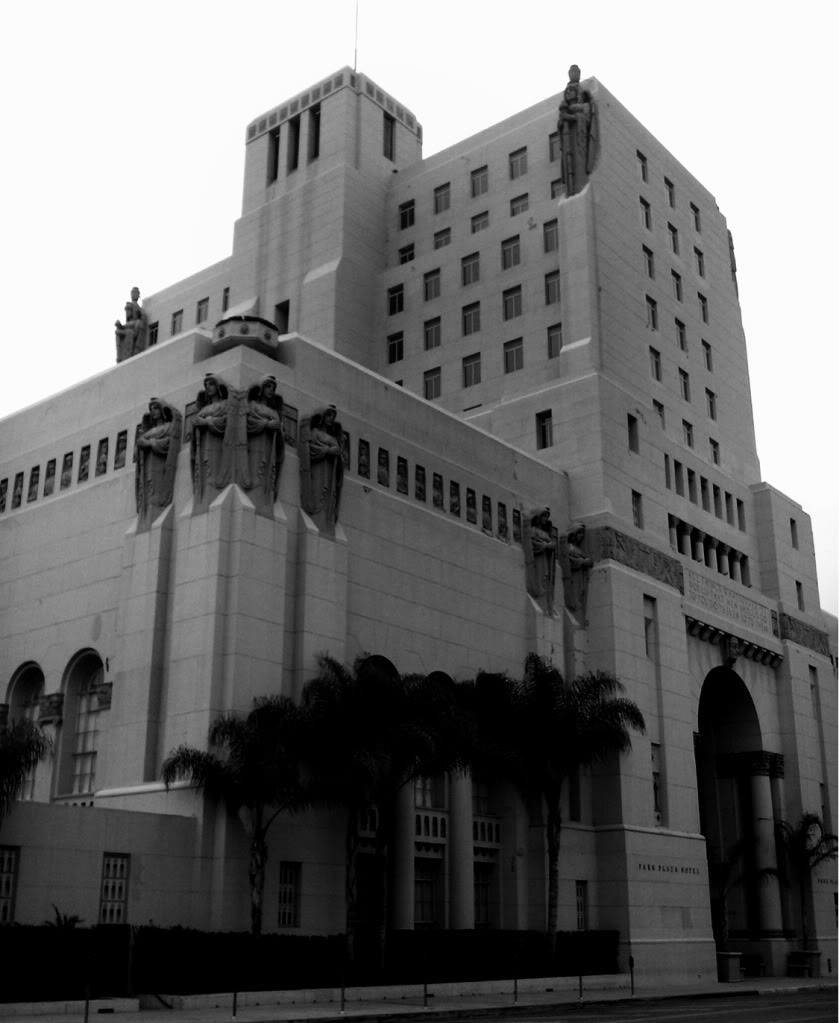 |
|
| (ca. 2011)**# - Exterior view of the Park Plaza Hotel located at 607 Park View Street just off Wilshire Boulevard. |
Historical Notes Though the neighborhood has gone through a period of urban decay and now urban renewal, the building, replete with angels at every corner, has lost none of its ethereal beauty, making it truly one of the classic examples of Beelman's architecture left standing in the modern world.^* In 1983, the Plaza Hotel Building (Elks Club Building) was designated Los Angeles Historic-Cultural Monument No. 267 (Click HERE to see complete listing). |
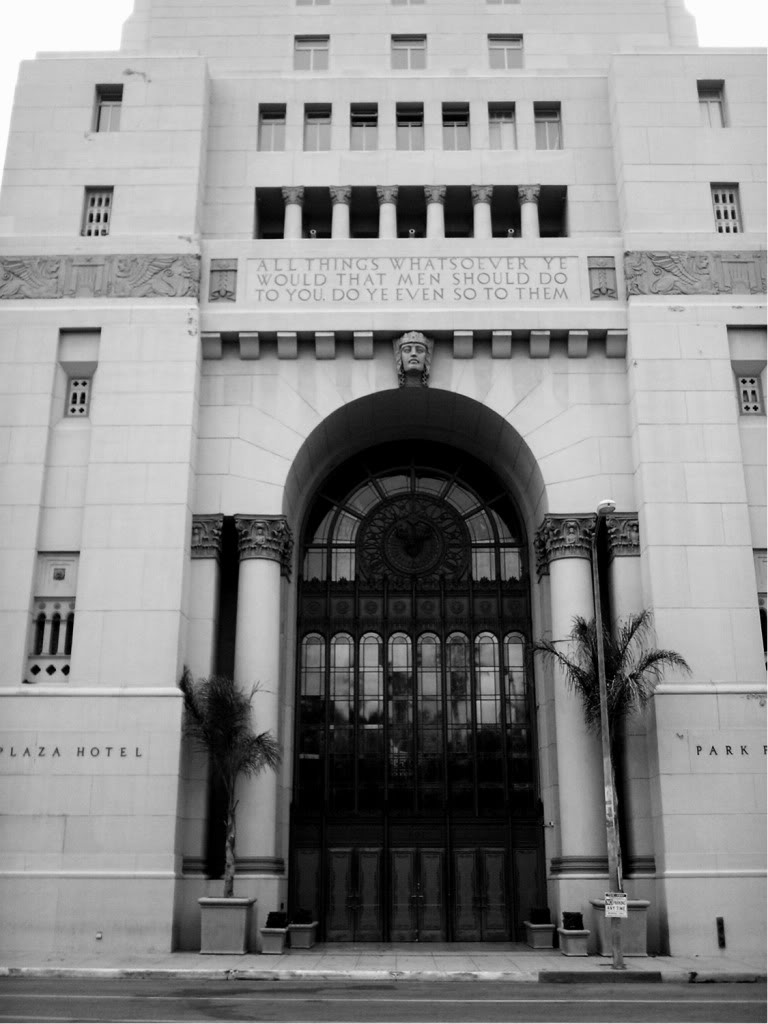 |
|
| (ca. 2011)**# - Exterior view of the grand entry to the Plaza Hotel Building. |
Historical Notes Done in the Gothic Revival architecture style (Neo-Gothic), the building still sports a brass sculpture of a set of elk antlers embedded in the clock above the grand entry to the building. The building is now vacant and is mainly used as a rental for movie shoots and special events.^* |
* * * * * |
Garden Court Apartments
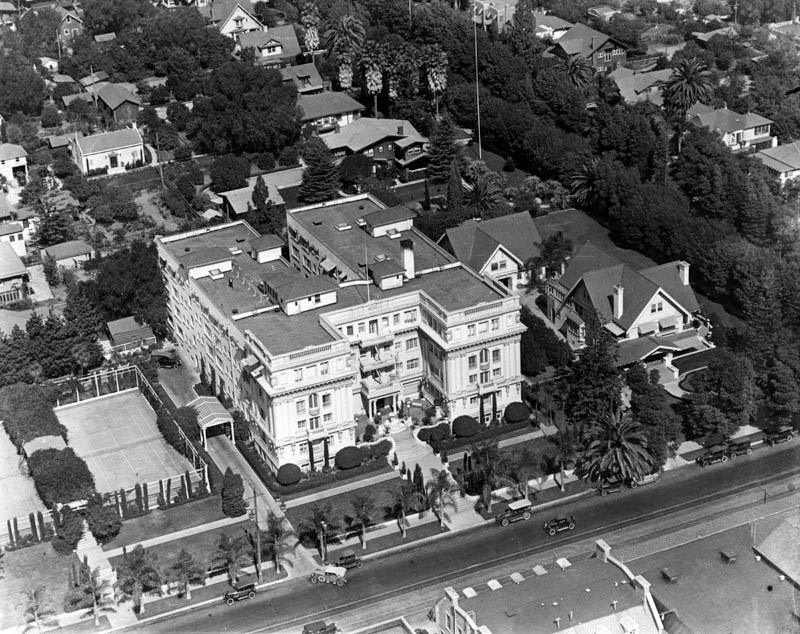 |
|
| (1924)* - Aerial view of the Garden Court Apartments located at 7021 Hollywood Blvd. |
Historical Notes Built in 1919, the Garden Court Apartments were designed by architect Frank S. Meline in Beaux Arts style. They were built to accommodate the movie industry.* |
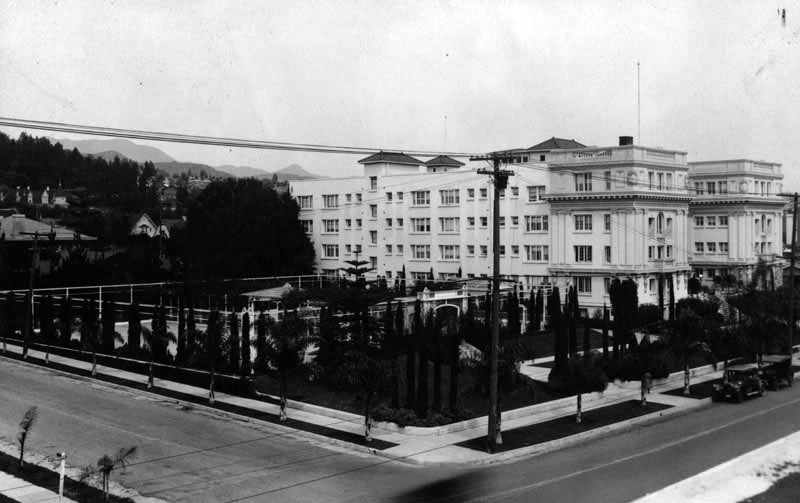 |
|
| (ca. 1934)* - View of the northeast corner of Sycamore Avenue and Hollywood Boulevard showing the western side of the Garden Court Apartments. |
Historical Notes The Garden Court Apartments was the home of a number of celebrities in the first forty or so years of its existence, including Clara Bow, Louis B. Mayer and Mack Sennett.*^ |
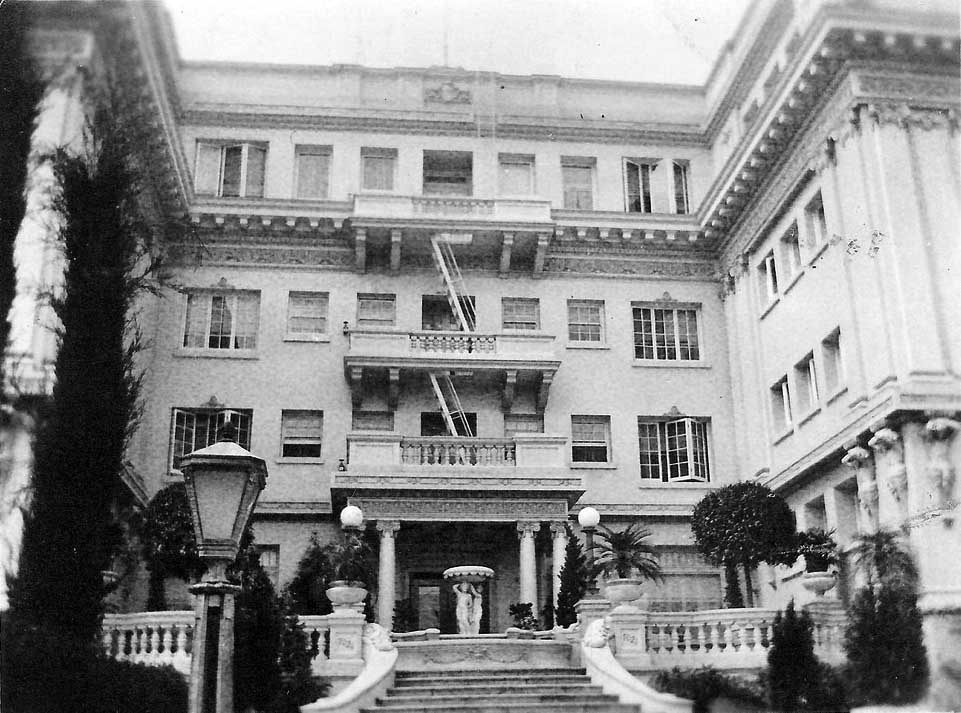 |
|
| (n.d.)**# - View of the front entrance to the Garden Court Apartments. A beautiful staircase leads to a fountain containing two figures holding up a bowl. |
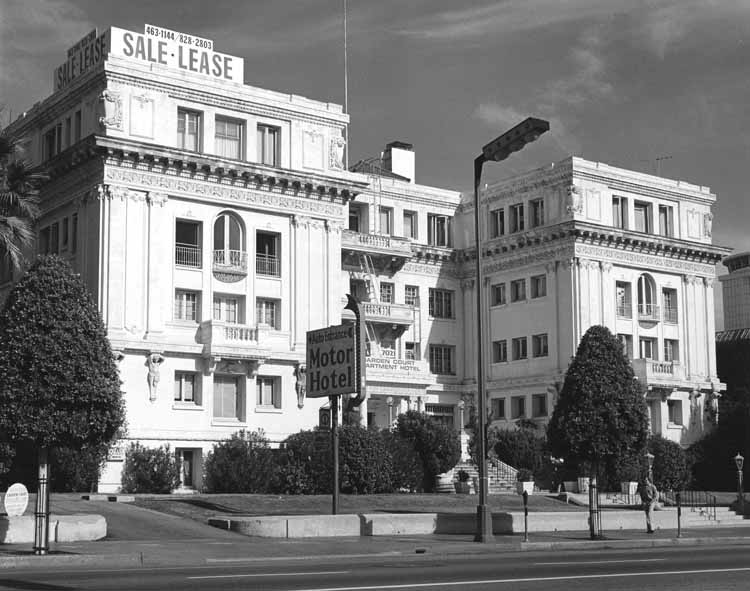 |
|
| (1976)^*# - View of the Garden Court Apartments (Hotel) on Hollywood Blvd. Sign in front of building reads Motor Hotel. |
Historical Notes The Garden Court Apartments’ fortunes declined in the 1960s and 1970s along with those of Hollywood Boulevard in general. After being vacated in 1980, it was inhabited by homeless squatters and nicknamed "Hotel Hell". The building was noted in the National Register of Historic Places in 1982, however, that did not prevent it from being razed in 1984.*^ |
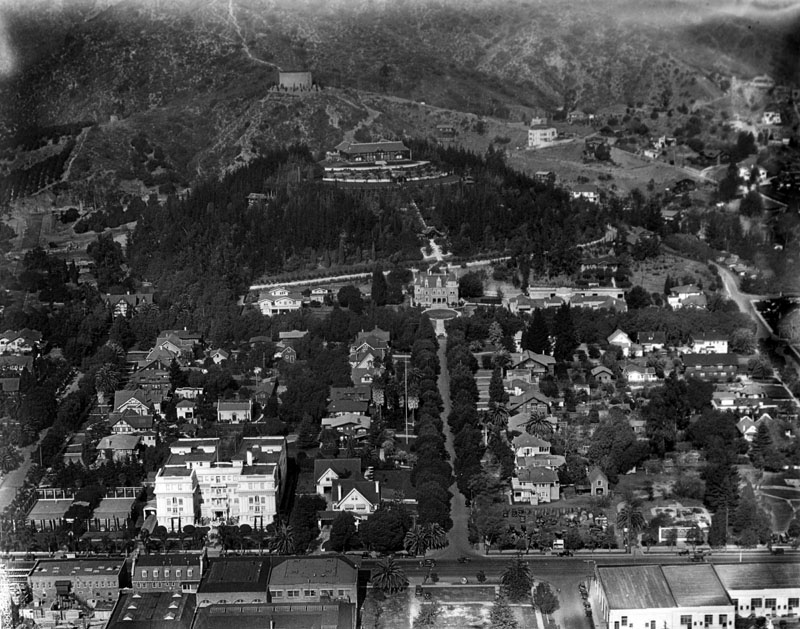 |
|
| (ca. 1924)* - View of the Garden Court Apartments on Hollywood Blvd. (foreground) and the residential neighborhood behind it, including the hilltop Japanese estate and gardens of brothers Charles and Adolph Bernheimer, located at 1999 N. Sycamore Avenue. |
Historical Notes This 1914 hilltop estate was built to house the Bernheimers' priceless collection of Asian treasures. In order to have an authentic Japanese design, hundreds of skilled craftsmen were brought from Asia to recreate an exact replica of a palace located in the Yamashiro mountains near Kyoto, Japan.* |
Bernheimer Japanese Palace
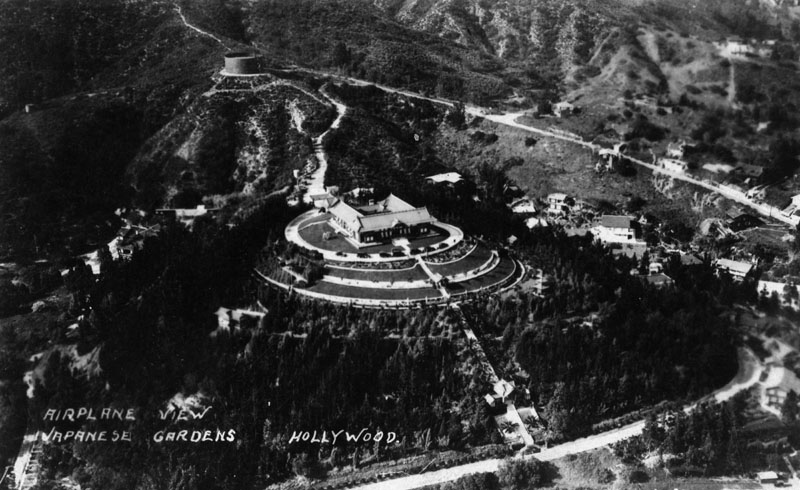 |
|
| (ca. 1924)* - Aerial postcard view of the Japanese estate and gardens of brothers Charles and Adolph Bernheimer located in the Hollywood Hills. |
Historical Notes In an act of bad timing, Adolph Bernheimer, a multi-millionaire silk importer, and his brother built a replica of a Japanese palace and garden on a hill overlooking Hollywood. Not only was the Bernheimer’s Teutonic name very suspicious, but so was their fluency in foreign languages. The new home’s large concrete retaining walls led some locals to suspect an armory or wireless station in the bowels. Under constant observation from a group of patriotic citizens, the brothers pacified neighbors by buying a $5,000 war bond. They spent little time in Hollywood after that.*### |
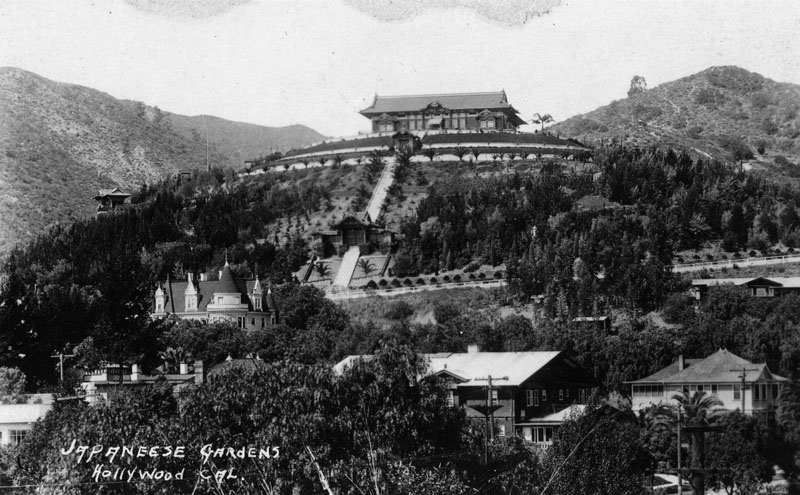 |
|
| (ca. 1920s)* - Postcard view of the hilltop Japanese estate and gardens of brothers Charles and Adolph Bernheimer. |
Historical Notes The hillside terraces included 30,000 varieties of trees, shrubs, waterfalls, hundreds of goldfish, and even exotic birds and monkeys.* |
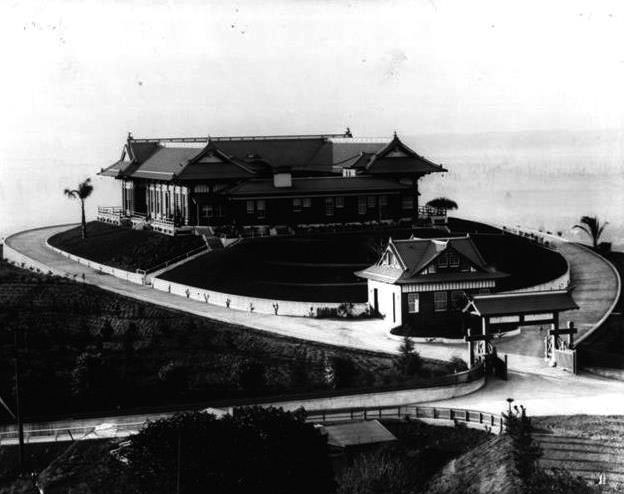 |
|
| (1914)**^# - Close-up view of the Bernheimer Brother's Japanese Palace the year it was built. |
Historical Notes The original Bernheimer structure included a 10-room teak and cedar mansion, where carved rafters were lacquered in gold and tipped with bronze dragons.* |
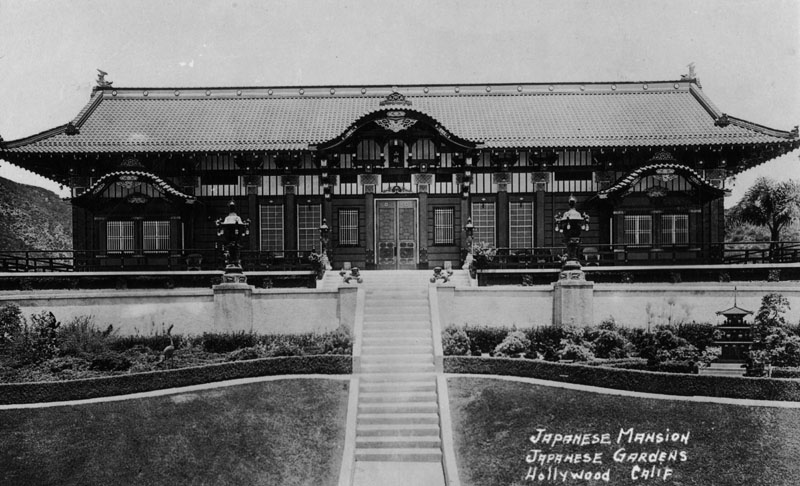 |
|
| (ca. 1920s)* - Front view of the Japanese estate and gardens of brothers Charles and Adolph Bernheimer. |
Historical Notes After the death of one of the brothers in 1922, the art collections were auctioned off. A few years later, the estate served as headquarters for the exclusive Hollywood "400 Club," an organization for the elite of the motion picture industry. After WWII, the home was remodeled and converted into apartments. Soon thereafter, Thomas O. Glover purchased the property and began the restoration of what was to become the Yamashiro restaurant.* |
* * * * * |
Hollywood Athletic Club
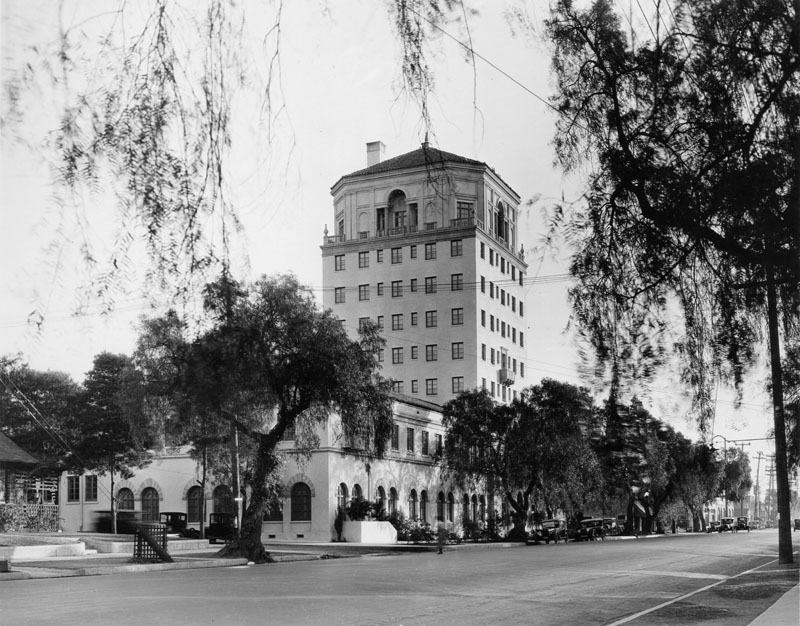 |
|
| (ca. 1925)* - Exterior corner view of the Hollywood Athletic Club building, with 1920s-era cars on the street. |
Historical Notes The Hollywood Athletic Club was built in 1924 by Meyer & Holler, the same architectural firm that built the Grauman's Chinese Theatre and the Egyptian Theatre. At the time is was the tallest building in Hollywood. The building at 6525 Sunset Blvd has been known as the Hollywood Athletic Club, University of Judaism, Berwin Entertainment Complex, and Hollywood Landmark.^* |
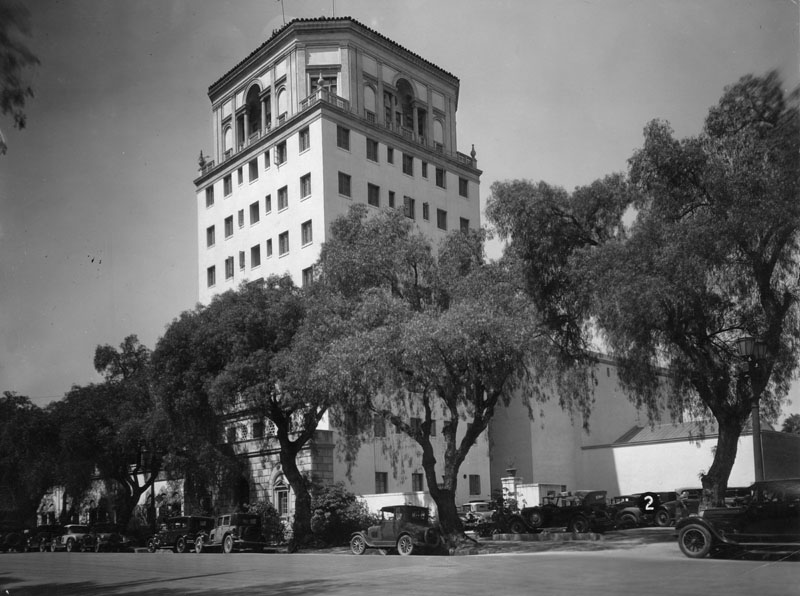 |
|
| (1929)* - Street view of the Hollywood Athletic Club, located at 6525 Sunset Blvd.^* |
Historical Notes When the Hollywood Athletic Club was first built in 1924, Hollywood was entering its greatest and most productive period. The building was the tallest building in Hollywood and loomed above Sunset Boulevard. Membership was originally $150 for initiation fees and $10 for monthly dues. During its early years as a health club, its membership included Johnny Weissmuller, Errol Flynn, Charlie Chaplin, John Wayne, Walt Disney, John Ford, Douglas Fairbanks Sr., Mary Pickford, Cecil B de Mille, Cornel Wilde, Humphrey Bogart, Clark Gable, Jean Harlow, Frances X. Bushman, Howard Hughes, Joan Crawford and Rudolph Valentino, Mae West, Walt Disney, and Buster Crabbe.^* |
Click HERE to see more in Early Views of Hollywood (1920 +) |
* * * * * |
Women's Athletic Club
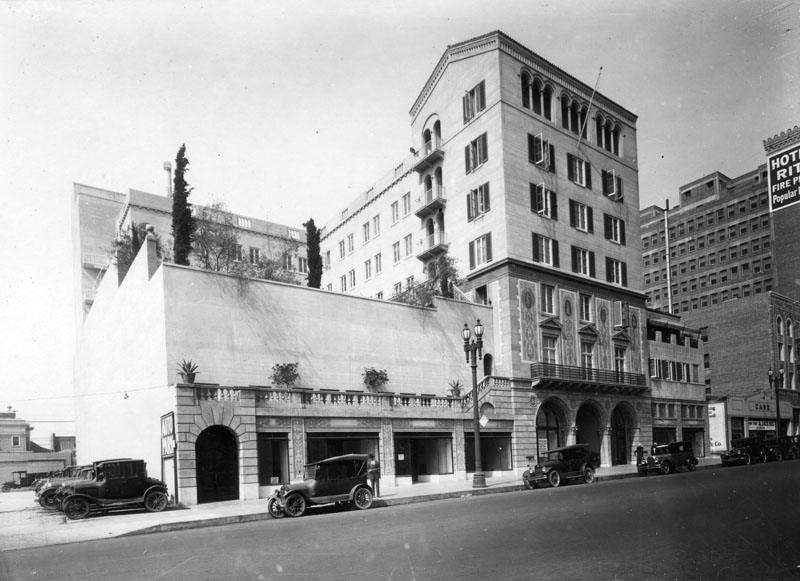 |
|
| (1925)* - Exterior view of the Women's Athletic Club of Los Angeles at 829 South Flower Street on October 9, 1925. On the right is the Hotel Ritz. |
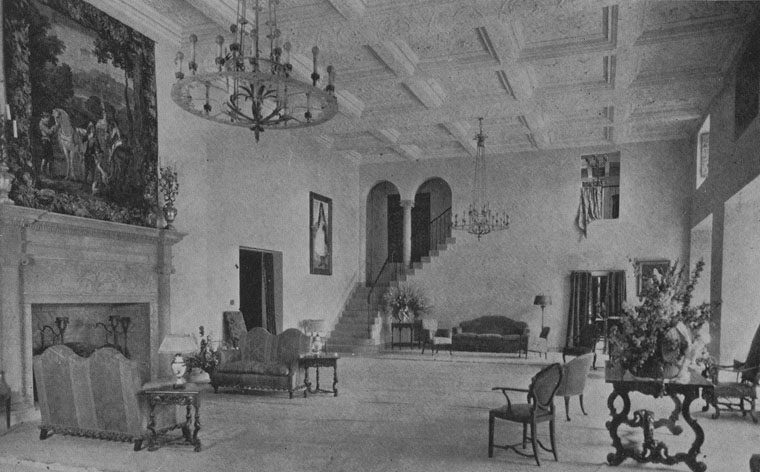 |
|
| (ca. 1925)* - Interior view on a postcard of the Women's Athletic Club of Los Angeles at 829 South Flower Street, showing the living room. |
* * * * * |
Hotel Cecil
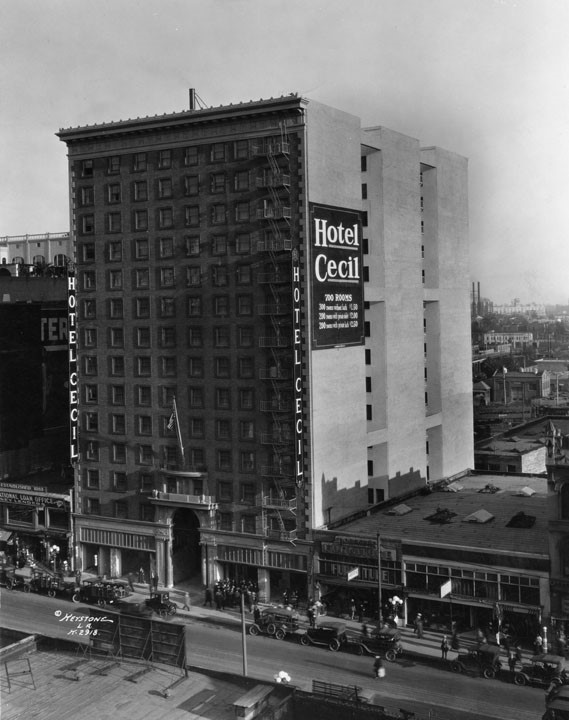 |
|
| (ca. 1924)* - View showing the Hotel Cecil located at 640 S. Main Street as seen from a roof across the street. It is the tallest building (approx. 15 stories) in the neighborhood, and advertises 700 rooms. |
Historical Notes The Cecil was constructed in 1924 by hotelier William Banks Hanner, as a destination for business travelers and tourists. Designed by Loy Lester Smith in the Beaux Arts style, the hotel cost $1 million to complete and boasted an opulent marble lobby with stained-glass windows, potted palms and alabaster statuary. Hanner had invested confidently in the enterprise, in the knowledge that several similar hotels had been established elsewhere downtown, but within five years of its opening, the United States sank into the Great Depression.^* |
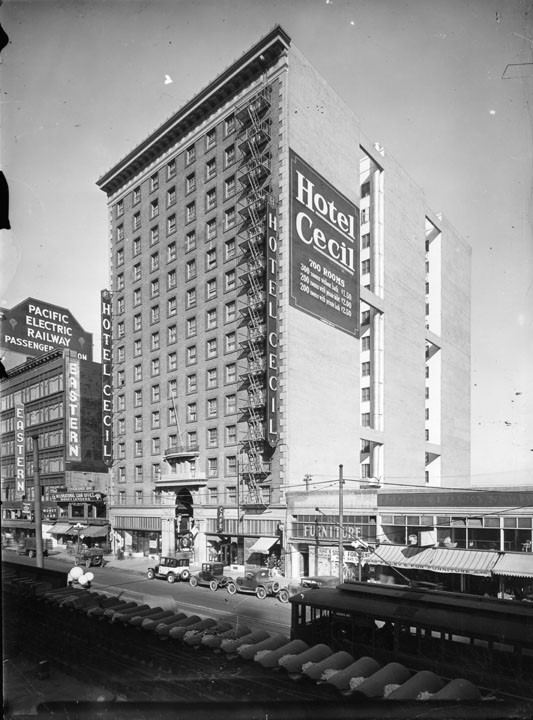 |
|
| (ca. 1924)* - Lower-level view of the Hotel Cecil. Down the street is the Pacific Electric Building, while on the street a streetcar passes cars parked along the curb. |
Historical Notes Though the hotel flourished as a fashionable destination through the 1940s, the decades beyond saw the hotel decline, as the nearby area known as Skid Row became increasingly populated with transients. As many as 10,000 homeless people lived within a four-mile radius. By the 1950s the hotel had gained a reputation as a residence for transients. A portion of the hotel was refurbished in 2007 after new owners took over. In the 1980s the hotel was rumored to be the residence of serial killer Richard Ramirez, nicknamed the "Night Stalker." Ramirez had been a regular presence on the skid row area of Los Angeles, but, according to a hotel clerk who claims to have spoken to him, is rumored to have stayed at the Cecil for a few weeks. Ramirez may have engaged in part of his killing spree while staying there. Another serial killer, Austrian Jack Unterweger, stayed at the Cecil in 1991, possibly as an homage to Ramirez. While there, he strangled and killed at least three prostitutes, for which he was convicted in Austria. He hanged himself shortly after his conviction.^* |
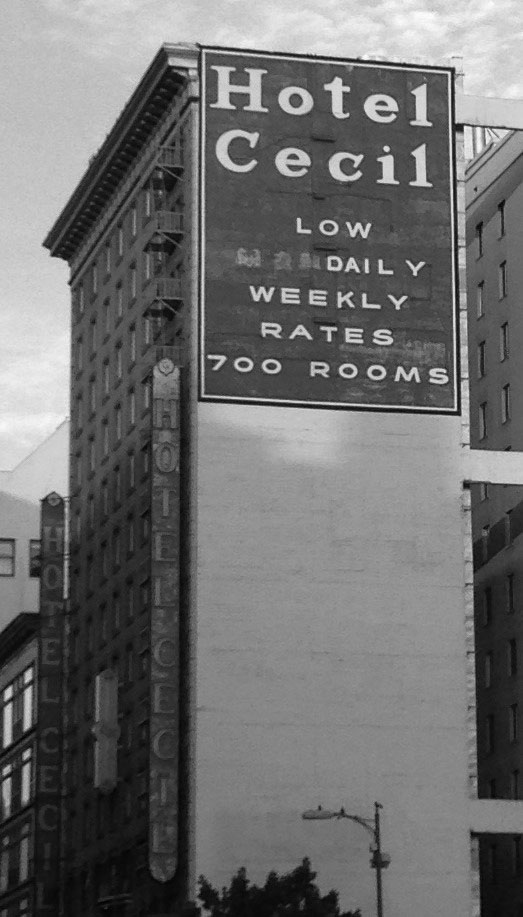 |
|
| (2013)^* - Looking up toward the top of the 700-room Hotel Cecil. |
Historical Notes The hotel was sold in 2014 to New York City hotelier Richard Born for $30 million, and another New York-based firm, Simon Baron Development, acquired a 99-year ground lease on the property. Matt Baron, president of Simon Baron, said he was committed to the preservation of architecturally or historically significant components such as the hotel's grand lobby, but that his company planned to completely redevelop the interior and fix the "hodgepodge" work that had been done in more recent years. Beyond renovating rooms, the developer also plans a rooftop pool, gym and lounge. Construction is projected to be complete by 2019.^* |
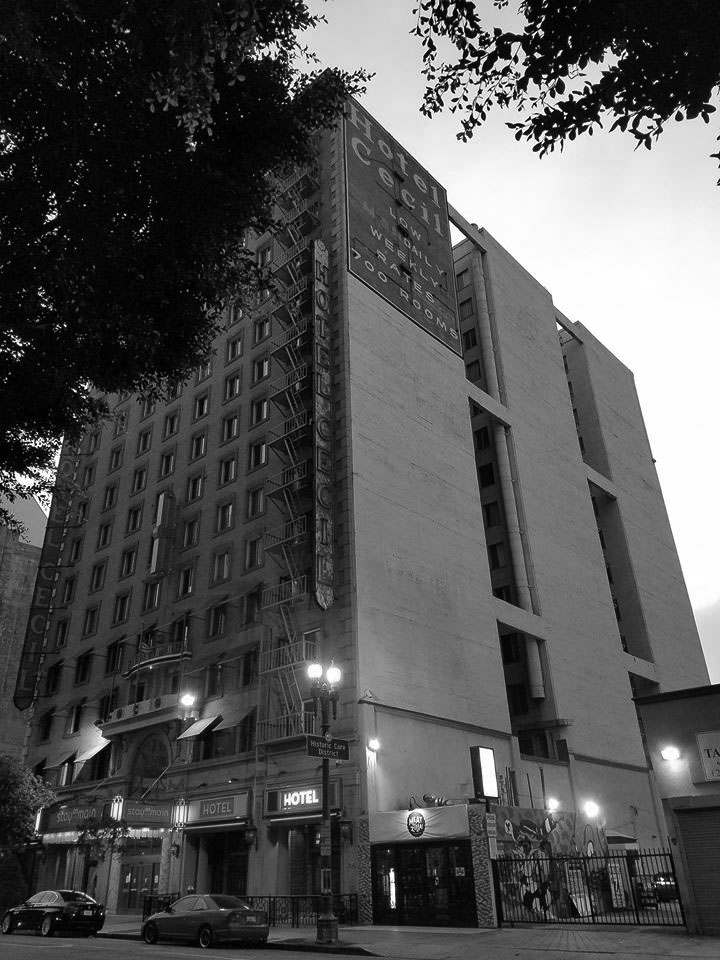 |
|
| (2017)^.^ - Looking up toward the top of Hotel Cecil. Photo courtesy of James J. Chun. |
Historical Notes In February 2017 the Los Angeles City Council voted to deem the Cecil a historic-cultural monument (No. 1117), because it is representative of an early 20th century American hotel, and because of the historic significance of its architect's body of work.^* |
 |
|
| (2022)* – Cecil Hotel – Photo by Carlos G. Lucero |
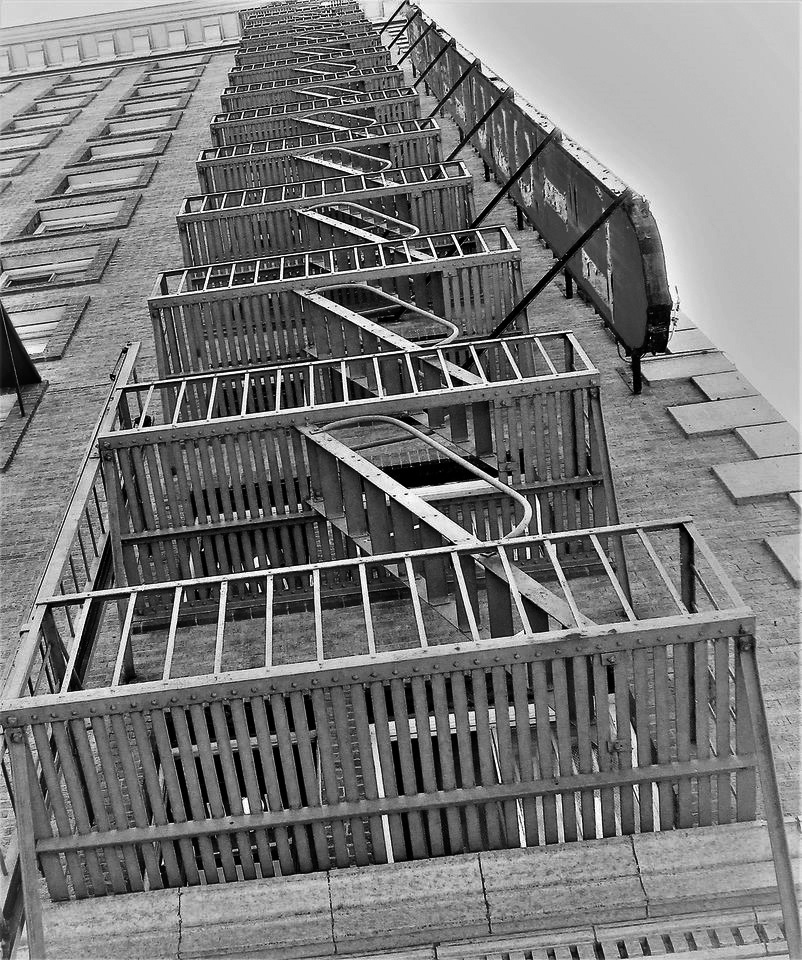 |
|
| (2020)^.^ - Fire escape ladders rise to top of Hotel Cecil alongside large building sign. Howard Gray |
Historical Notes Fire Escapes date back to the turn of the 20th century, when fire safety became a major concern and building owners were required by law to provide fire escape routes in their new property. The fire escape invention seemed to be a simple and cost-efficient way to address this requirement. As far as a patented fire escape, the first credited person for such an invention was Anna Connelly in 1887. She invented the exterior staircase, used specifically for a fire escape. Many companies saw advantages to using this system and decided to incorporate that patent into their own buildings. These exterior staircases were cheap to build and could be added to the existing construction very easily, without the need to restructure the walls.* |
\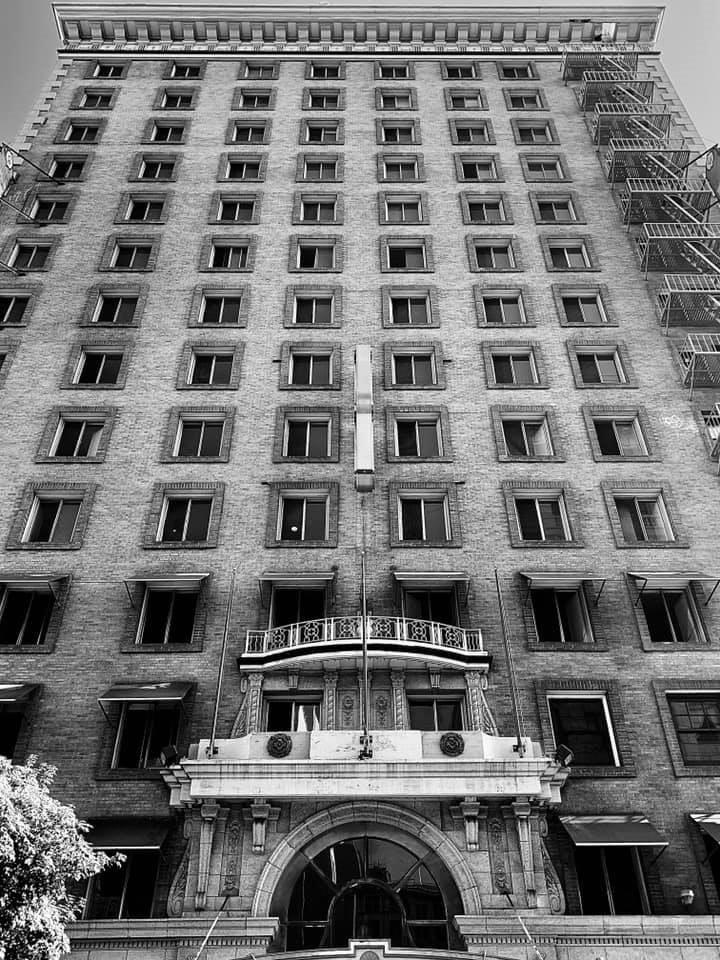 |
|
| (2021)^.^ - Front view of the Cecil Hotel, Historical-Cultural Monument No. 1140. Photo by Gilbert Jimenez |
* * * * * |
Hollingsworth Building and the Continental Hotel
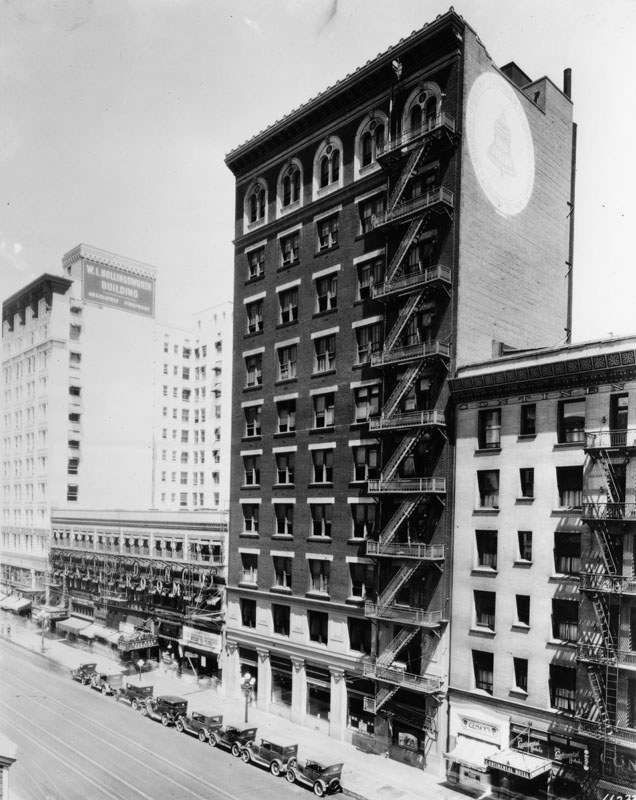 |
|
| (ca. 1925)* - View of buildings on the east side of Hill at 6th. On the left is the Hollingsworth Building with its ad of "absolutely fireproof" painted on the side. Next to it is Palais de Dance, a dance studio for ballroom, completed in 1925 at a cost of $800,000. The site was formerly occupied by the Rendezvous Cafe. On the far right is the Continental Hotel. |
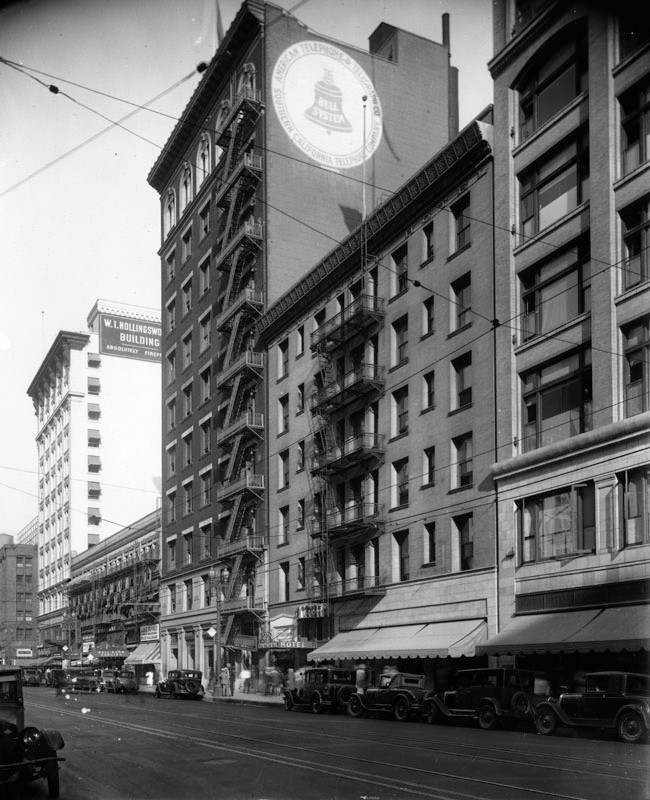 |
|
| (ca. 1925)* - Street view of Hill Street near 6th Street showing the Continental Hotel (center) and the Hollingsworth Building in the distance (left). The tall building at center is the AT&T Building with 'Bell System' written on its side. |
* * * * * |
Wrigley Field
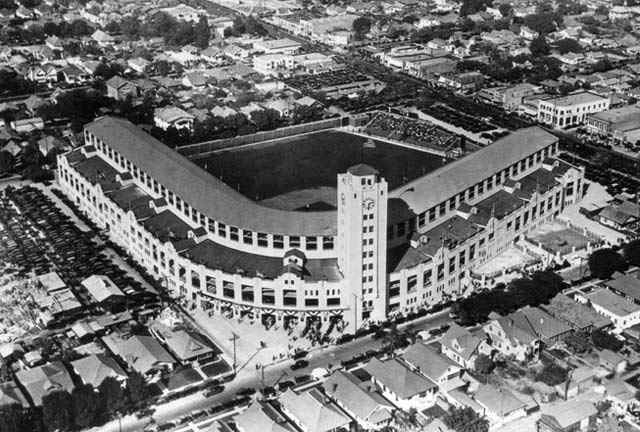 |
|
| (1925)* - Aerial view of Wrigley Field, Opening Day, September 29, 1925. |
Historical Notes For 33 seasons (1925-1957) Wrigley Field was home to the Angels, and for 11 of those seasons (1926-1935 and 1938) it had a second home team in the rival Hollywood Stars. The Stars eventually moved to their own new ballpark, Gilmore Field. Prior to 1925, the Angels played at their former home at Washington Park, and before that, at Chutes Park.* |
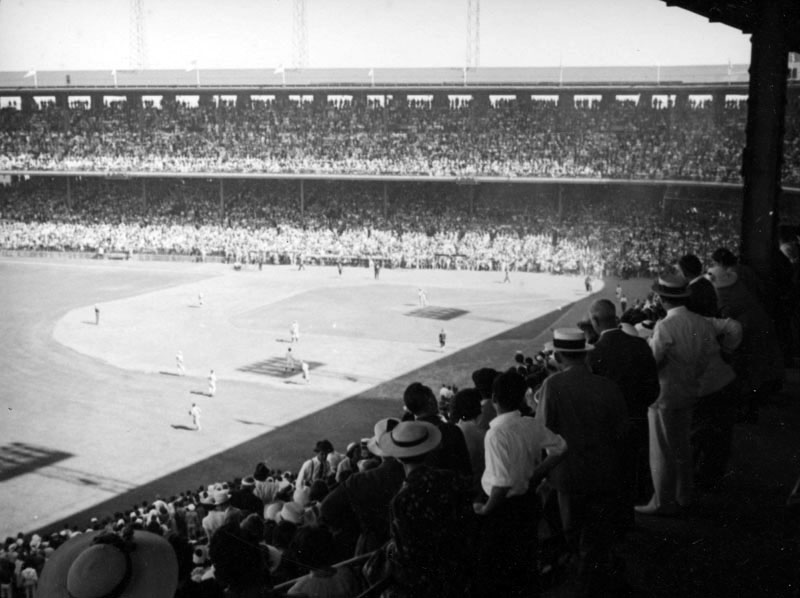 |
|
| (Early 1930s)* - Partial view of the "first" Wrigley Field - home for the Los Angeles Angels of the Pacific Coast League. The bleachers are practically bursting at the seams with eager spectators cheering on their favorite teams. |
Click HERE to see more Baseball in Early LA |
* * * * * |
Grand Olympic Auditorium
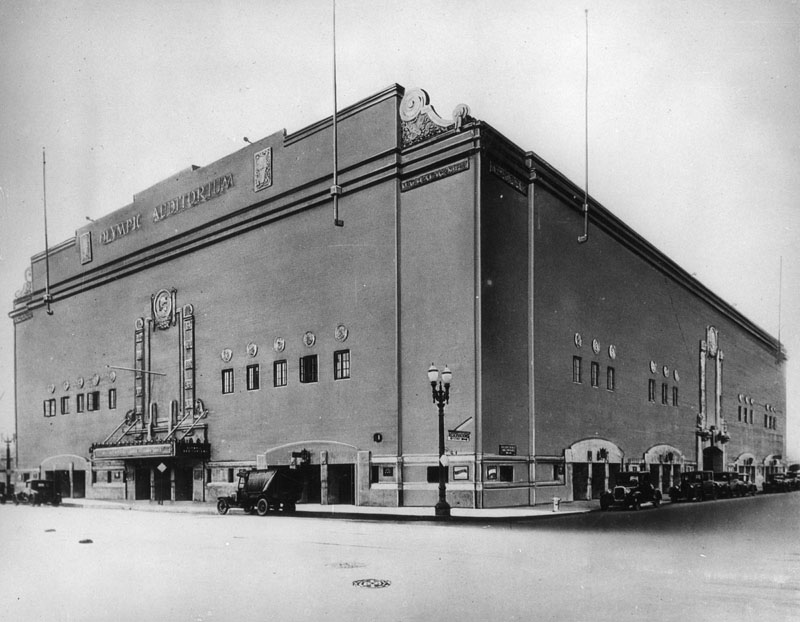 |
|
| (ca. 1925)* - View looking at the southwest corner of S. Grand Avenue and W. 18th Street showing the newly constructed Grand Olympic Auditorium. Architect G.S. Underwood |
Historical Notes The Grand Olympic Auditorium was built in 1924 by Jack Doyle, with the help of the Los Angeles Olympic committee for the 1932 Games. The grand opening of the Auditorium was on August 5, 1925, and was a major media event, attended by such celebrities as Jack Dempsey and Rudolph Valentino.*# |
 |
|
| (1932)* – Wide angle view of the Grand Olympic Auditorium filled to capacity. Spectators await the start of the Olympic wrestling competitions to be held on dual platforms in the center of auditorium. |
Historical Notes The Olympic Auditorium was leased by the 1932 Olympic organizing Committee for a very nominal sum sufficient to cover expenses, for the purpose of conducting the training and competitions of the boxing, wrestling and weightlifting events of the Games. At the time it was the largest indoor venue in the U.S., originally seating 15,300.^* |
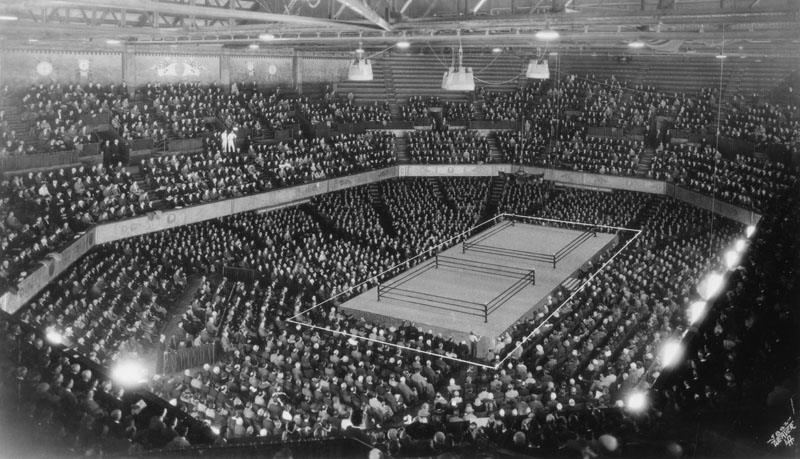 |
|
| (1932)* - Spectators have nearly filled the Olympic Auditorium to watch boxing, one of three events held at the venue during the 1932 Olympic Games. |
Historical Notes The building was the site of the boxing and Greco-Roman wrestling competitions for the Games. American Edward Flynn won the welterweight gold medal in boxing.*# |
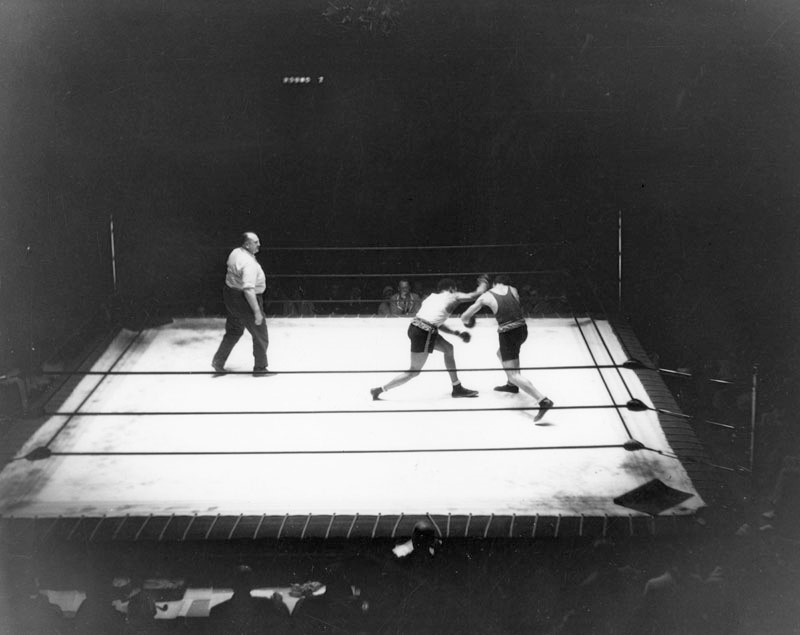 |
|
| (1932)* – Canada's gold medalist in boxing was Horace "Lefty" Gwynne who survived a fierce battle against Germany's Hans Ziglarski (right) in the bantamweight final during the 1932 Olympic Games. |
Historical Notes The 1932 Summer Olympics was celebrated in Los Angeles. No other cities made a bid to host these Olympics. Held during the worldwide Great Depression, many nations and athletes were unable to pay for the trip to Los Angeles. Fewer than half the participants of the 1928 Summer Olympics in Amsterdam returned to compete in 1932. Even U.S. President Herbert Hoover skipped the event.^* |
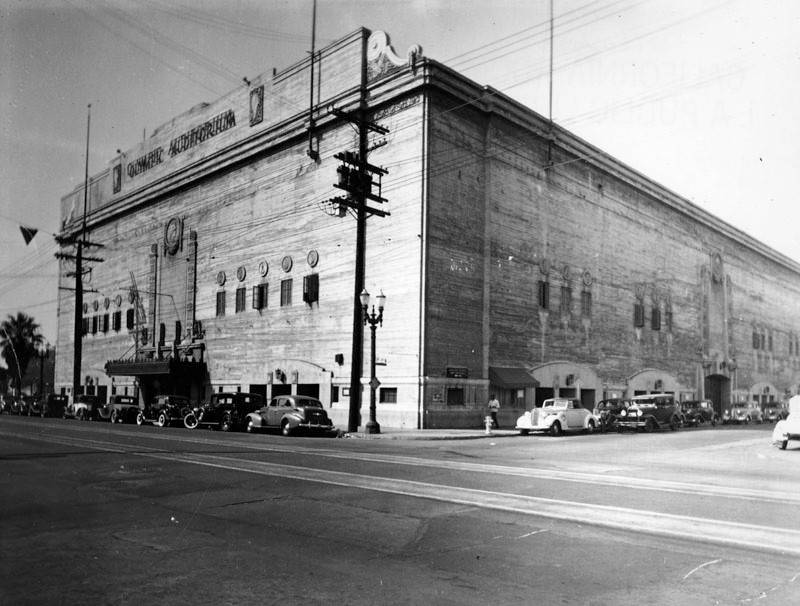 |
|
| (1938)* - View showing the Olympic Auditorium located at 1801 S. Grand Avenue. |
Historical Notes Throughout the 1930s, 1940s and 1950s it was home to some of the biggest boxing, wrestling and roller derby events and has become somewhat of a landmark for boxing history.^* |
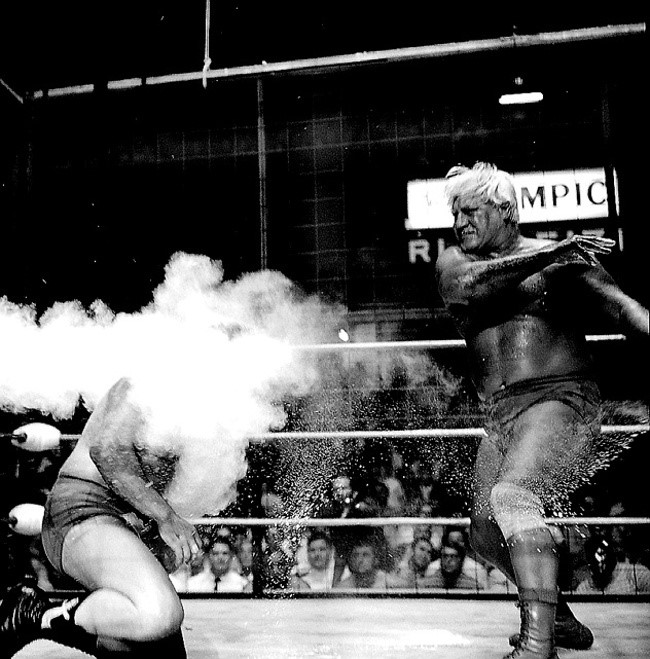 |
|
| (ca. 1970)^^+ - Freddie Blassie, Olympic Auditorium. Photo by Theo Ehret |
Historical Notes The 1960s and 1970s were a major boom period for the Olympic, as major wrestling events were held at the arena every other Friday night, as well as being the home to the Roller Games Los Angeles T-Birds. Wrestling legends such as Freddie Blassie, John Tolos, Buddy Roberts (as Dale Valentine), The Sheik, Fritz Von Erich, Gorgeous George, The Great Goliath, Black Gordman, Bobo Brazil, Buddy Rogers, Roddy Piper and Chris Adams competed in the arena at one point in their careers, along with the legendary Lou Thesz, Mil Mascaras and André the Giant.^* |
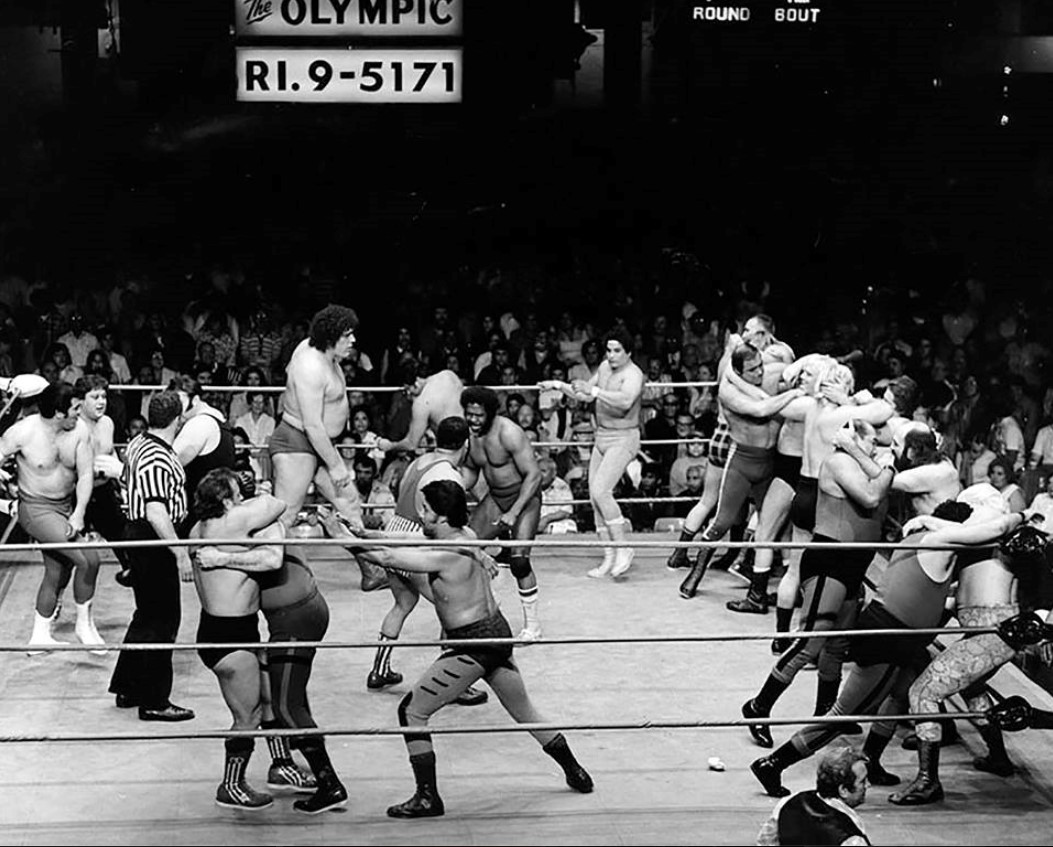 |
|
| (1976)^*^# - Andre the Giant, Roddy Piper, Porkchop Cash and approximately 17 other well-known Los Angeles wrestlers are competing for a $30,000 cash prize at the Olympic Auditorium in May of 1976 in an event called the Battle Royal. |
Historical Notes In January 1970, the Olympic began its annual 22-wrestlers-in-the-ring "Battle Royale." The goal was to not be thrown out of the ring. Chris Adams was one of the last big draws at the Olympic before promoters Mike Le Bell and Gene LeBell ended its wrestling cards in 1982. Adams went to Portland afterwards and eventually to Dallas to join Fritz Von Erich's World Class Championship Wrestling, as the sport's top wrestling city shifted from Los Angeles to Dallas and Atlanta before Vince McMahon's WWF reached national prominence. Some scenes in the 1976 film Rocky were filmed at the venue.^* |
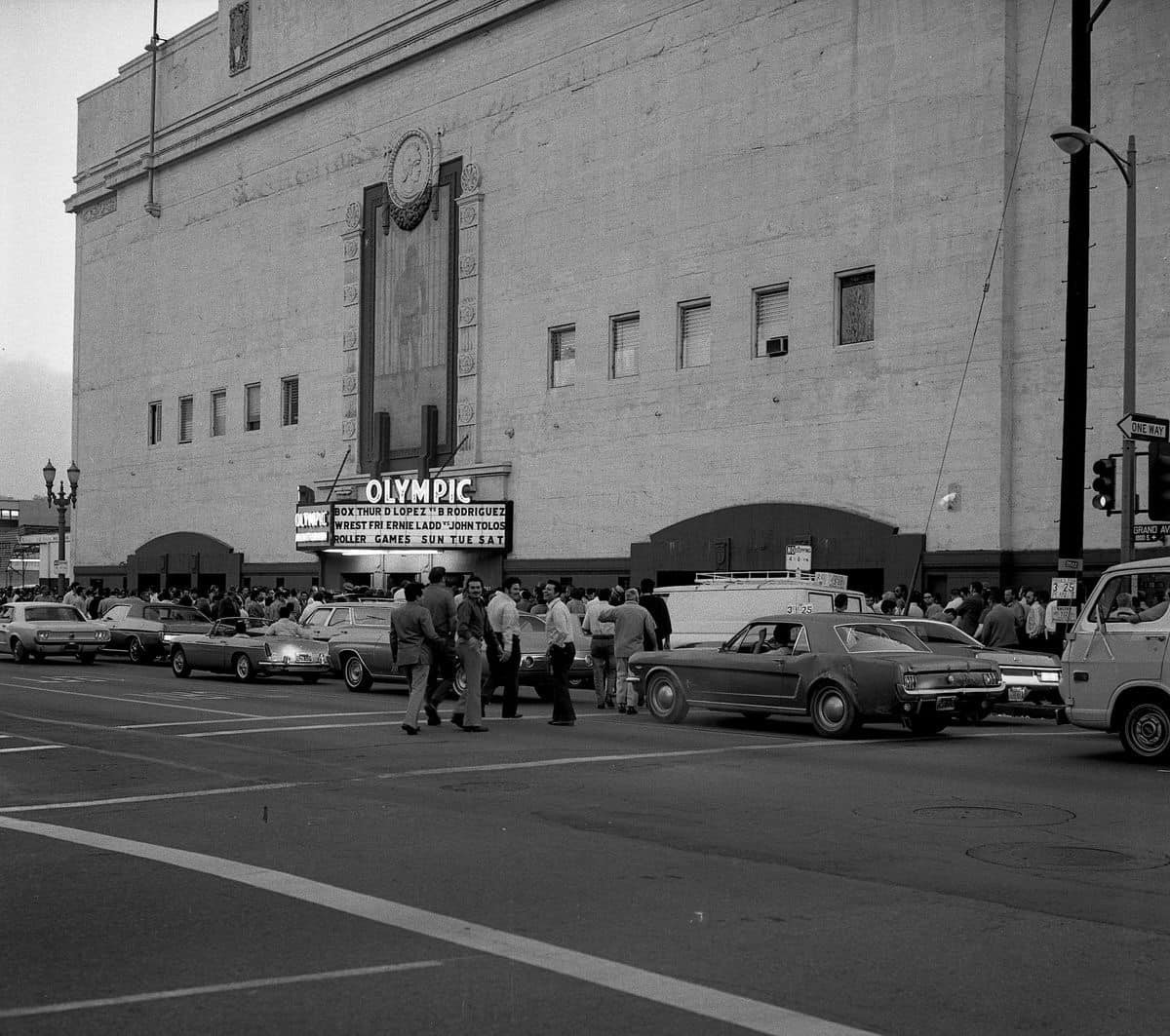 |
|
| (1972)* – The scene outside the Olympic Auditorium at Grand and 18th Street. |
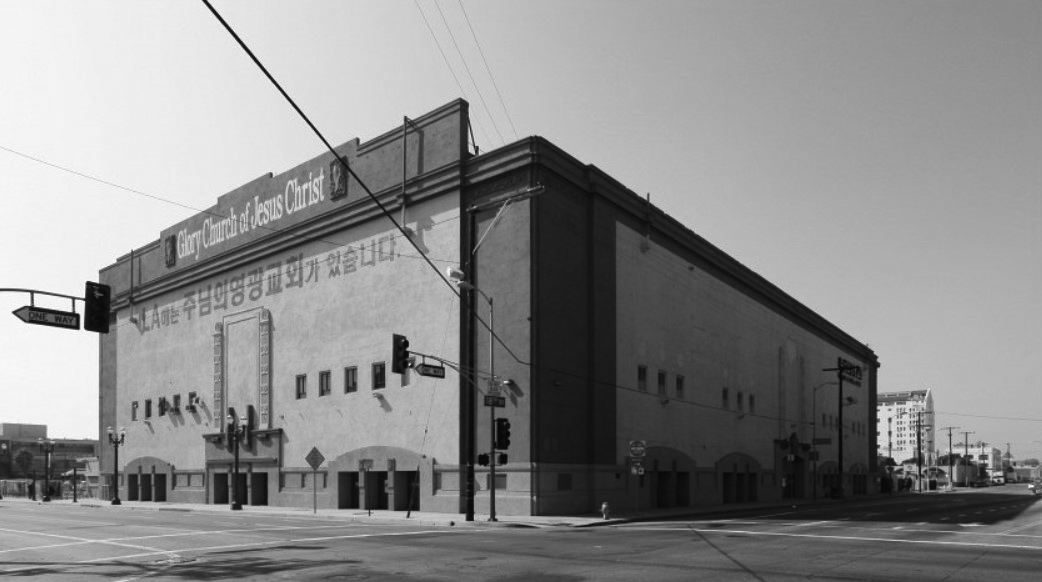 |
|
| (ca. 2014)^++ – View showing the Olympic Auditorium as it appears today, now a church. |
Historical Notes In June 2005, the Glory Church of Jesus Christ, a Korean-American Christian church, purchased the entire property, thus the name Grand Olympic Auditorium ceased to exist. In 2007, the arena was given a new facelift back to its original brown coat of paint that was abandoned in 1993 when the arena reopened.^* |
* * * * * |
St. Vincent Catholic Church
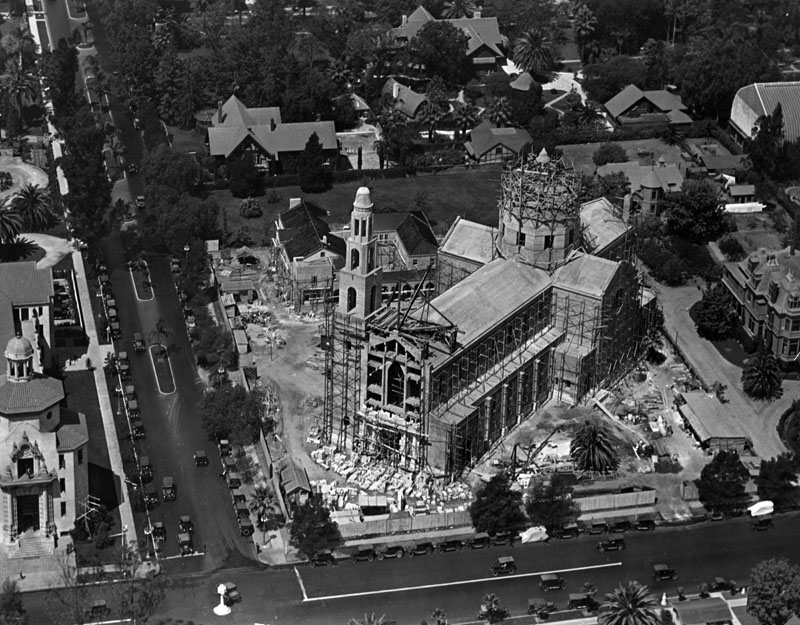 |
|
| (ca. 1924)* - A construction fence and temporary buildings surround the St. Vincent de Paul Catholic Church, 621 W. Adams Blvd., as it is being built. Scaffolding is on the dome and sides. Limestone blocks for the facade lie on the ground in front of the entrance. The surrounding neighborhood has stately homes with extensive grounds. |
Historical Notes The St. Vincent de Paul Church (aka St. Vincent Catholic Church) was built in the 1920s and designed by architect Albert C. Martin, Sr. Dedicated in 1925, it was located in what was then one of the wealthiest sections of the city, on land adjacent to the Edward Doheny Mansion and Stimson House. It was the second Roman Catholic church in Los Angeles to be consecrated.^ |
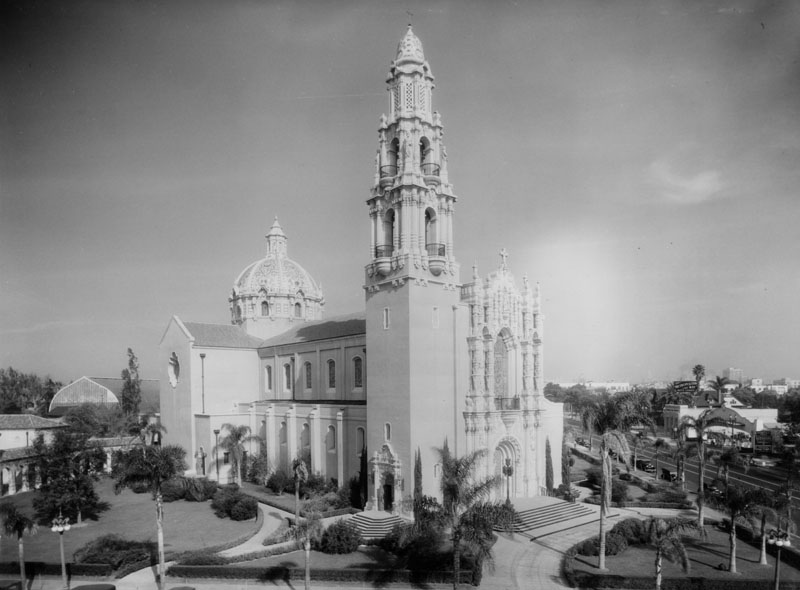 |
|
| (ca. 1925)* - View of a newly completed St. Vincent Catholic Church located at the northwest corner of Adams and Figueroa St. |
Historical Notes The Spanish Colonial Revival style St. Vincent Church was built in 1923-25. The decorative entrance is of Indiana limestone and brightly colored tile covers the 45 foot diameter dome. The interior ceiling decoration is by John B. Smeraldi.* |
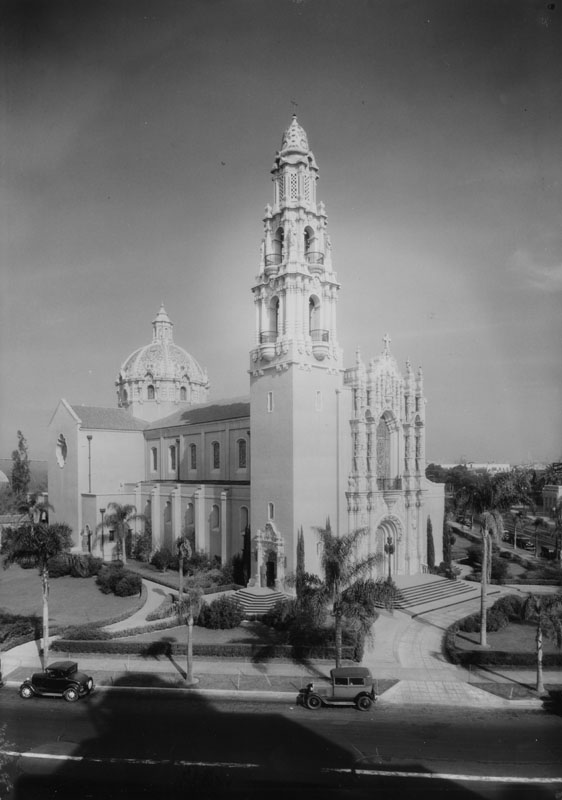 |
|
| (1925)* - Closer view of the newly constructed St. Vincent Catholic Church at 621 W. Adams Blvd. |
Historical Notes St. Vincent de Paul Roman Catholic Church was a gift from oil magnate and benefactor Edward Laurence Doheny I, who drilled Los Angeles' first oil well in 1892. |
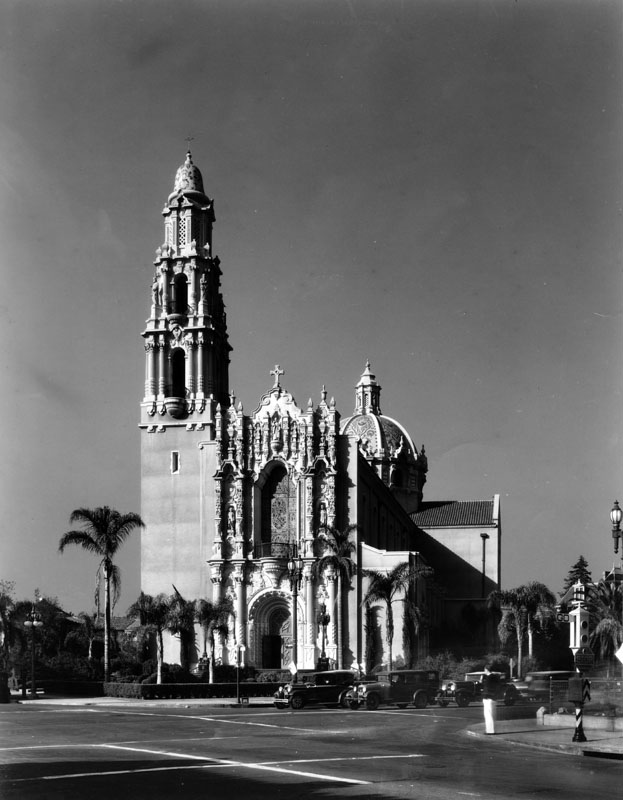 |
|
| (1930s)* - Exterior view of the main facade of St. Vincent de Paul Roman Catholic Church, located on the northwest corner of S. Figueroa and W. Adams. |
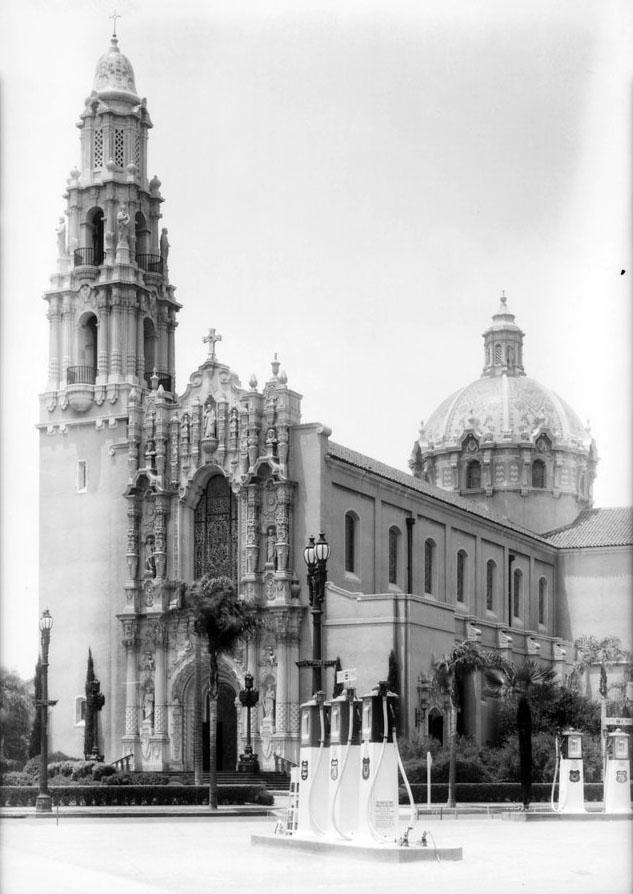 |
|
| (1934)^ – View looking at the St. Vincent Catholic Church as seen from a Union 76 service station located across the street, on the NE corner of West Adams Boulevard and South Figueroa Street. |
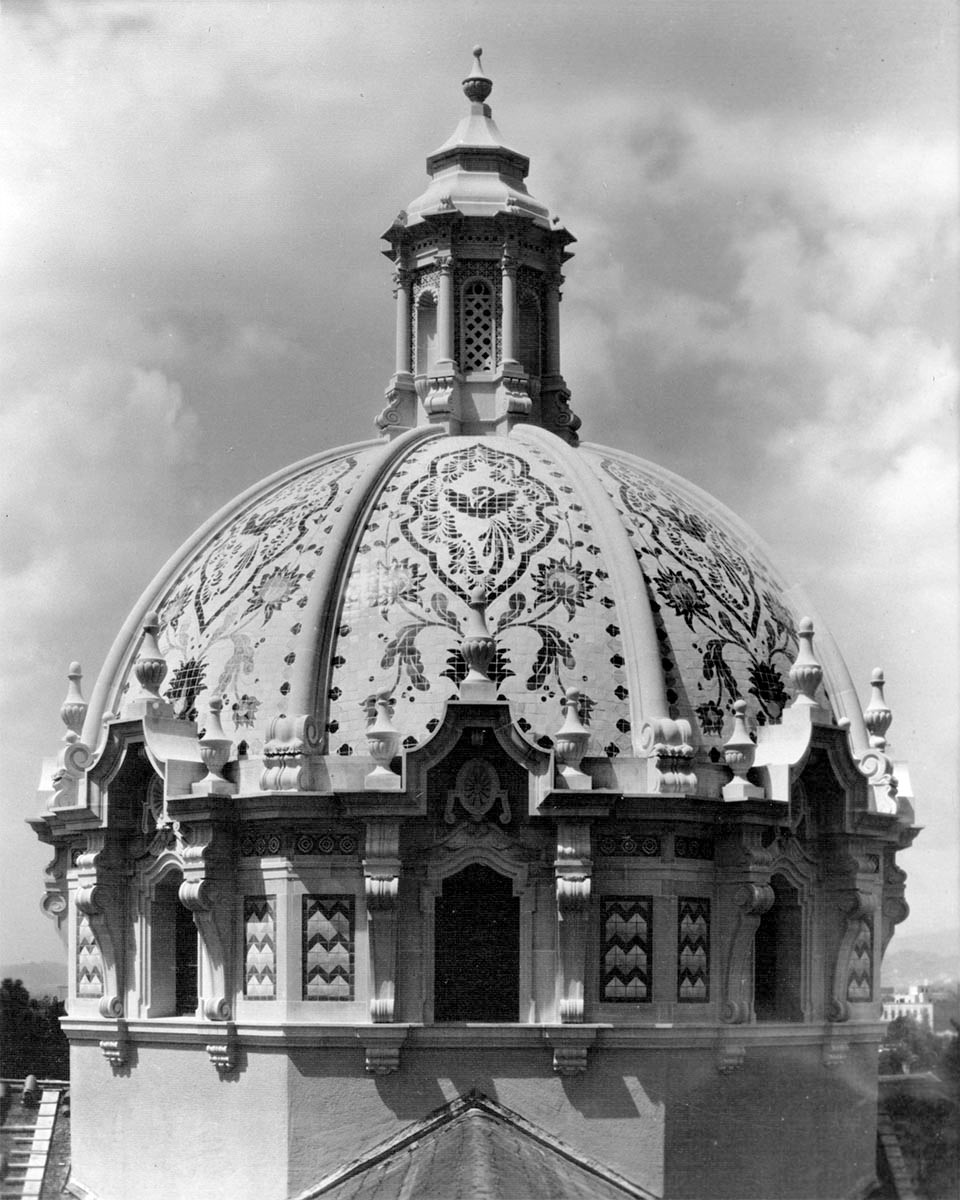 |
|
| (n.d.)**# – Close-up view of the Saint Vincent de Paul Church showing details of the tiled dome. |
Historical Notes The underside of the dome features eight paintings of Matthew, Mark, Luke, and John and their symbols: man; lion; ox; and eagle. In 1971, Saint Vincent de Paul Church was dedicated Los Angeles Historic-Cultural Monument No. 90 (Click HERE for complete listing). Click HERE for contemporary view. |
* * * * * |
St. Vincent's Hospital
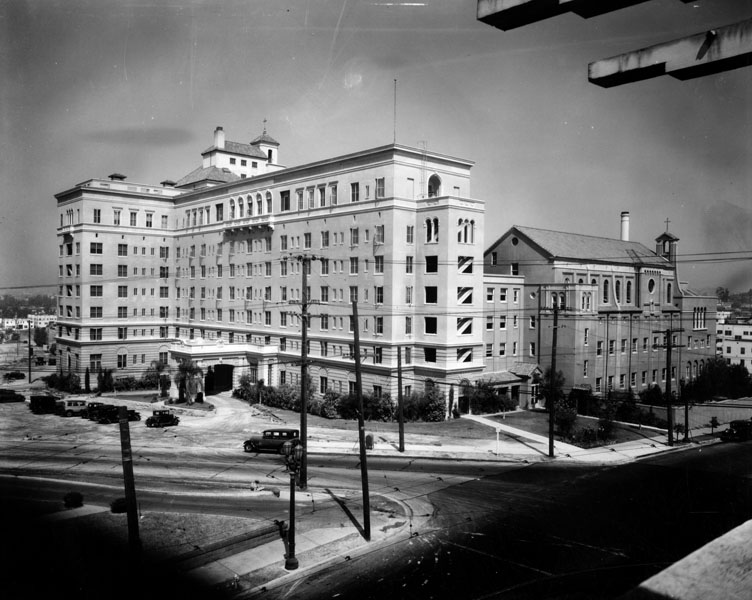 |
|
| (ca. 1925)* - Exterior view of St. Vincent's Hospital, located on 3rd and Alvarado Streets. Built in 1924, it was designed by architects Austin and Ashley. |
Historical Notes The Daughters of Charity of St. Vincent de Paul established the first hospital in Los Angeles - the Los Angeles Infirmary, in 1856. It was located in the Sonora Town adobe owned by then-Mayor of Los Angeles, Don Cristóbal Aguilar. Four years later, in 1860, the hospital relocated to 1416 Naud Street, between Ann (named for Sister Ann) and Sotillo Street (though other data indicates the location was 1414 Naud Street, between N. Main and San Fernando Road). In 1869, Daughters incorporated the Los Angeles Infirmary under their own ownership, the first women in the region to do so. In 1883 they purchased six and a half acres of land at Beaudry Park at a cost of $10,000, and a new hospital building was erected a year later at Beaudry and Sunset, on a hillside overlooking Sonora Town. By 1898, Los Angeles Infirmary had come to be known as Sisters Hospital, but both names were used interchangeably in reference to the same hospital; in 1918, the name was officially changed to St. Vincent's Hospital.* |
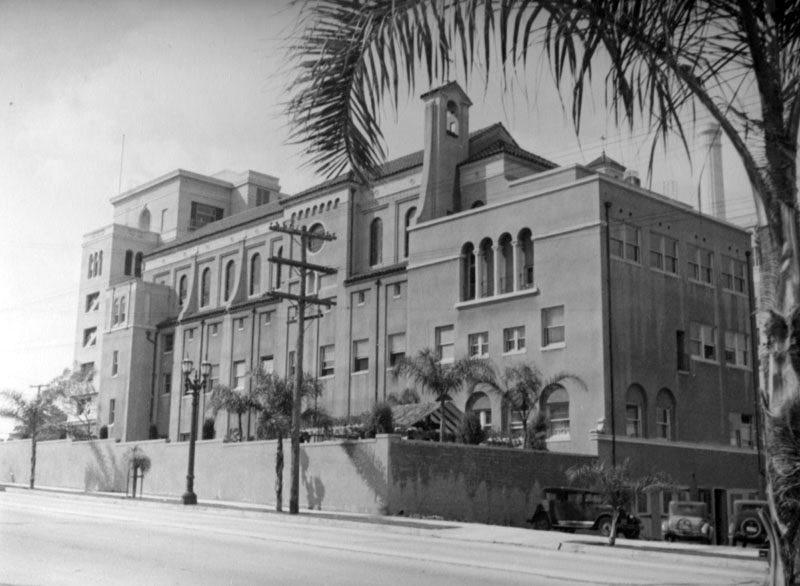 |
|
| (1933)* - View of the St. Vincent's Hospital, located at 2131 West Third Street. |
Historical Notes In 1924, the Italianate style St. Vincent's Hospital building was erected on 3rd and Alvarado. It was desinged by Architects John C. Austin and Frederick M. Ashley. |
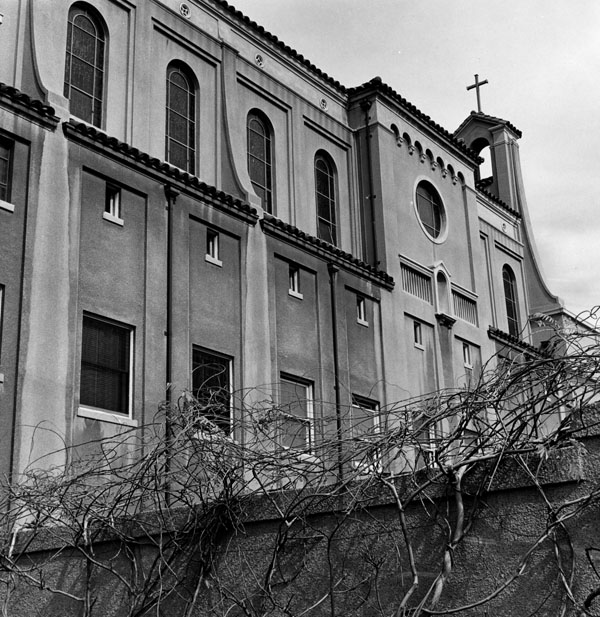 |
|
| (1964)* - Exterior view of a portion of St. Vincent's Hospital as seen in 1964. |
Historical Notes For 47 years, the hospital had such a steady growth that they were forced to expand yet again, and groundbreaking for a newer, larger building took place in 1971 - this time, located at 2131 W. 3rd Street. With a "new" hospital came a new name, and in 1974, it changed again, this time becoming St. Vincent Medical Center.* In 1995, the Daughters of Charity National Healthcare System sold SVMC to Catholic Healthcare West. In 2002, CHW sold the hospital to the newly established Daughters of Charity Health System.^* |
* * * * * |
Pacific Electric Hill Street Station
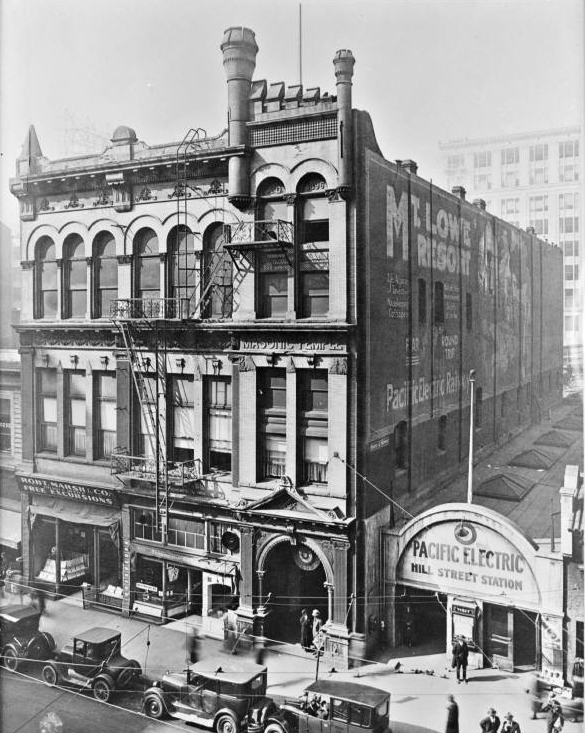 |
|
| (ca. 1920)^^## - Pacific Electric Hill Street Station & Masonic Bldg. West side of Hill St between 4th & 5th Streets. Mt. Lowe Resort is advertised on the side face of the Masonic Building. Click HERE to see more in Early Views of Mt. Lowe Railway. |
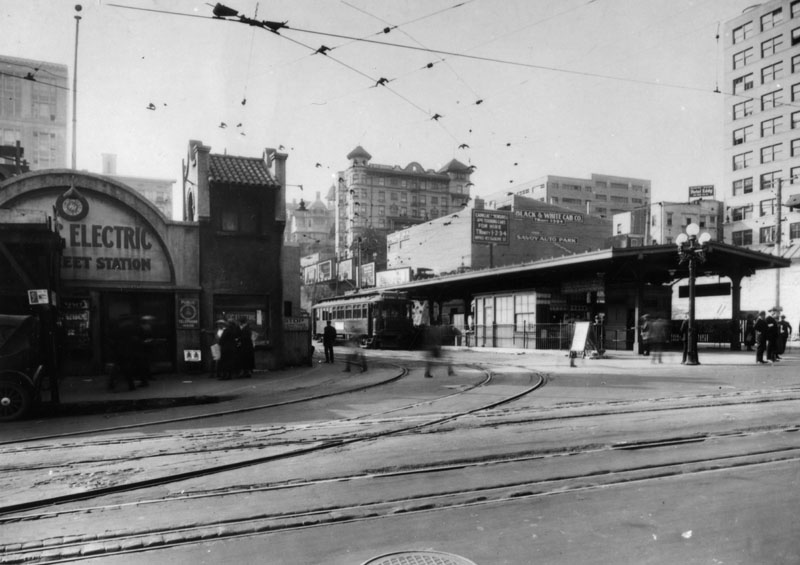 |
|
| (ca. 1920's)* - The Pacific Electric Hill Street station, located at 427 South Hill Street, |
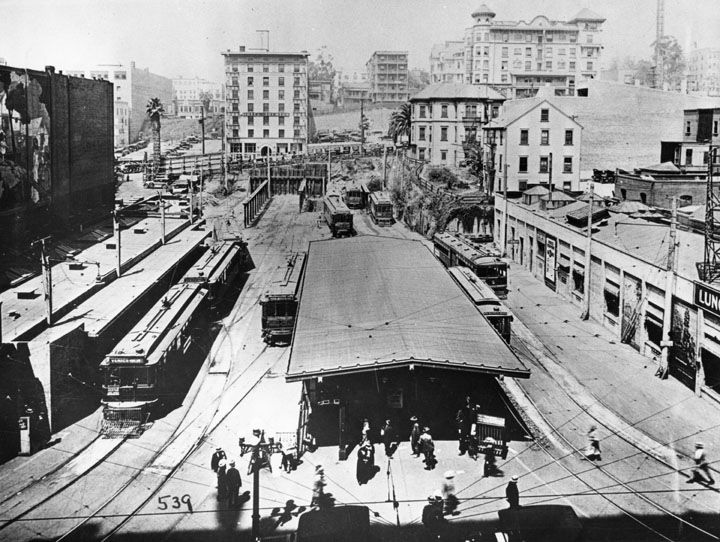 |
|
| (ca. 1924)* - The Hill Street station for electric cars during 1922 to 1925, before the Subway Terminal Building was built, looking west toward Bunker Hill. |
Historical Notes As street traffic increased in downtown Los Angeles, the Pacific Electric Railway undertook its most ambitious project, a dedicated right of way into downtown through a subway - the existing terminal in the Pacific Electric Building at Sixth and Main was reached by shared street running. Responding to the traffic congestion that clogged the streets, the California Railroad Commission in 1922 issued Order No. 9928, which called for the Pacific Electric to construct a subway to bypass downtown's busy streets.^* |
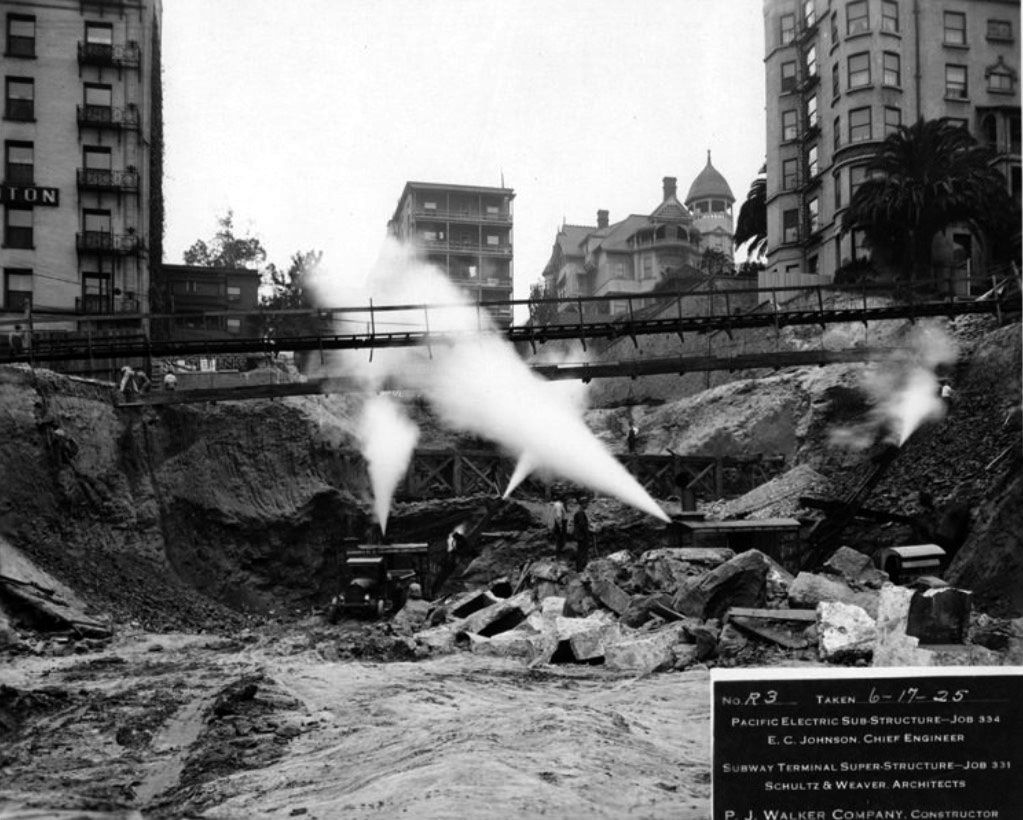 |
|
| (1925)^.^ – View, looking west from Hill Street, of the construction site as the PE Hill Street Station is converted to a massive building and entrance to a subway tunnel which will cross Bunker Hill to Toluca Yard (1st/2nd/Beverly Boulevard/Glendale Boulevard). Here they have breached the Olive Street roadbed and spanned the vacated Olive Street School/Health Department property. The Trenton (on the left) and the Fremont (on the right) look on nervously. The Rose Mansion at 4th Street and Grand Avenue can be seen behind the Fremont Hotel. |
Historical Notes After 18 months of construction and $1.25 million in expenditures, the Subway officially opened to the public on December 1, 1925, between the intersection of Beverly and Glendale Blvds in Westlake, and the Subway Terminal Building.^* Click HERE to see the construction of the western portal of the Pacific Electric subway tunnel at 1st and Glendale. |
* * * * * |
Subway Terminal Building
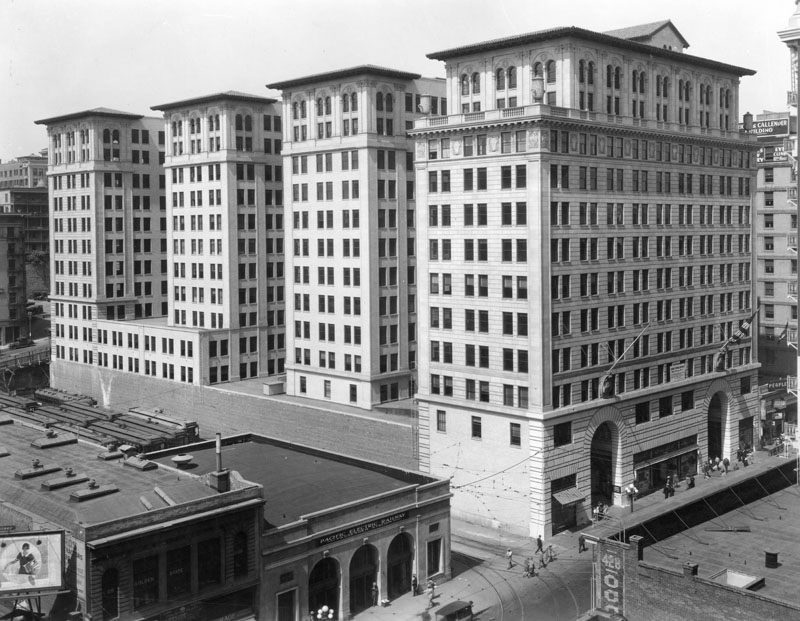 |
|
| (ca. 1925)* - Subway Terminal Building and the Pacific Electric Railway Passenger Station in 1925, the year they were built. View is of the Hill Street side south of 4th Street. |
Historical Notes The Subway Terminal Building, now Metro 417, is an Italian Renaissance Revival building in Downtown Los Angeles at 417 South Hill Street. It was designed by architects Schultze and Weaver and was built in 1925. It was the downtown terminus for the "Hollywood Subway" branch of the Pacific Electric Railway Interurban rail line. Currently it is a luxury apartment building. It is located near Pershing Square. The Subway Terminal Building was built to conform to the 150 foot height limit imposed on all downtown construction. The other end of the subway line emerged at the surface at the Belmont Tunnel / Toluca Substation and Yard.^* |
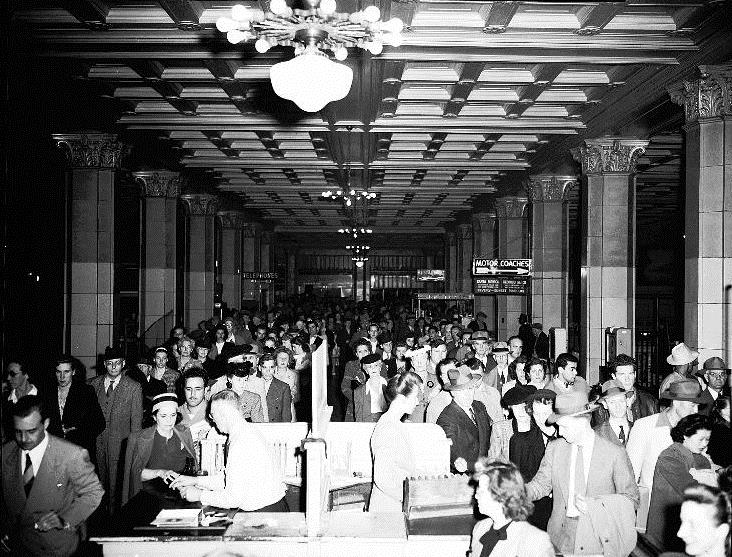 |
|
| (ca. 1925)^^## - View of the Subway Terminal main hall. |
Historical Notes After 18 months of construction and $1.25 million in expenditures, the Subway officially opened to the public on December 1, 1925. The trains, which traveled a distance of slightly over one mile, transported passengers between the tunnel's mouth (Toluca Yard) near the intersection of Beverly and Glendale Boulevards in Westlake, and the Subway Terminal Building.^* |
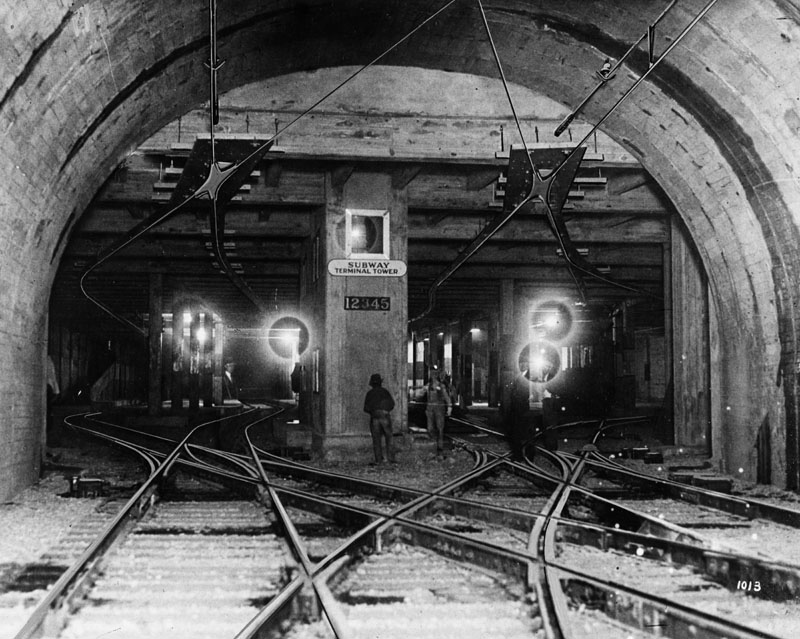 |
|
| (ca. 1925)* - Interior view of the Subway Terminal Building in downtown Los Angeles, showing Pacific Electric car tracks running in various directions in the subway. |
Historical Notes The early years of the Subway were widely met with success, as the Hollywood Subway emerged as one of Los Angeles's most popular modes of public transit throughout the 1920s and 1930s. Ridership hit an all-time high during the World War II-era; in 1944 – considered to have been the Subway's peak – trains carried an estimated 65,000 passengers through the tunnel each day.^* |
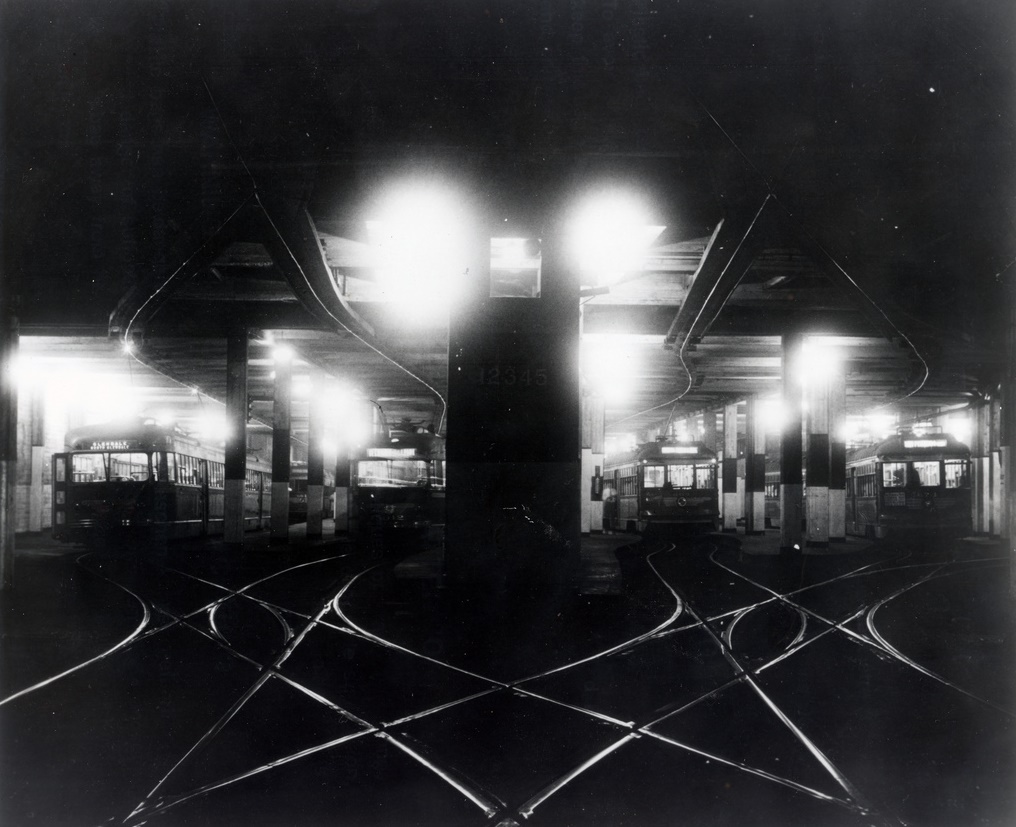 |
|
| (n.d.)^^## - View of the symmetry in the tracks within the Pacific Electric Subway Building. The subway was in operation from 1925 to 1955. |
* * * * * |
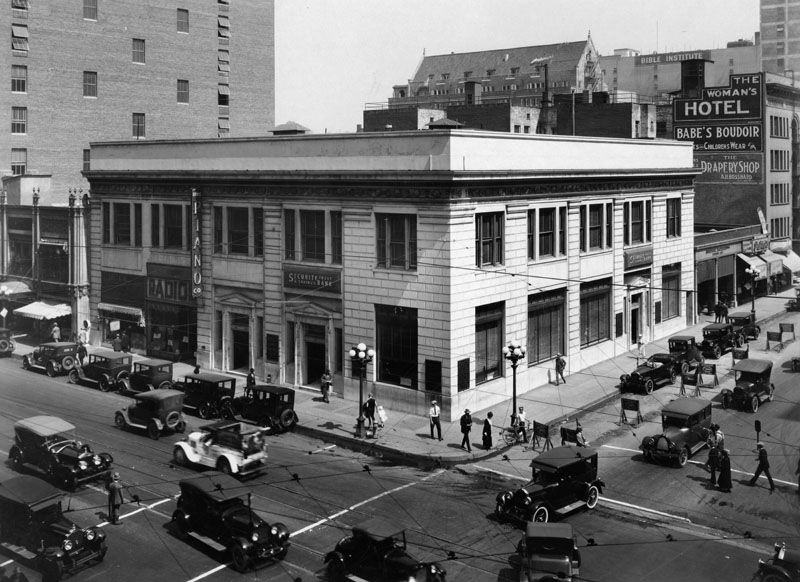 |
|
| (ca. 1925)* - A look down upon Seventh Street (running across in the foreground) and Grand Avenue reveals a busy intersection in this business corridor. The white building in the background is occupied by two businesses, a branch of Security Trust and Savings Bank (right) and Lyric Piano Co. |
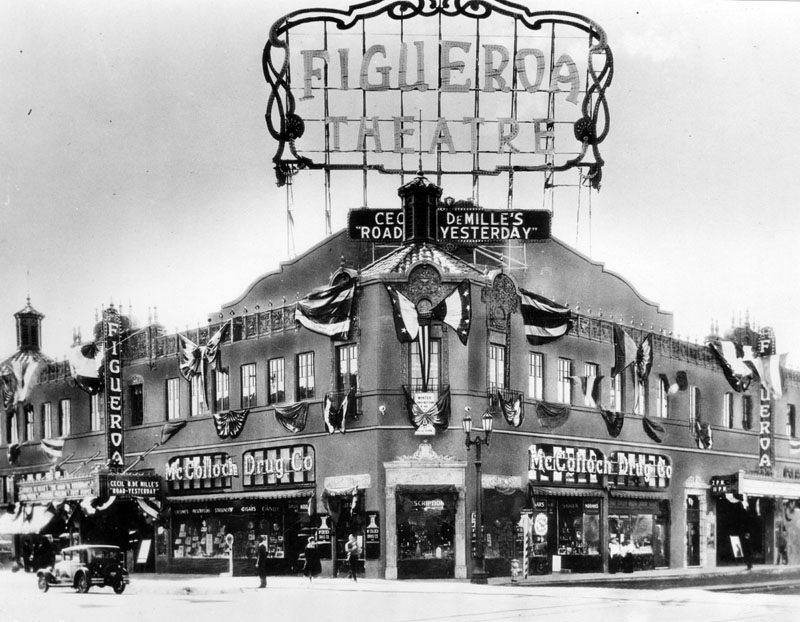 |
|
| (ca. 1925)* - Exterior view of the Figueroa Theatre, located on the corner of Figueroa and York Boulevard in Highland Park. The corner entrance is for McColloch Drug Co., offering perfumes, prescriptions, stationary, cigars, candy, and an array of goods. Two entrances for the theater are visible on either side of the building, each with a box office and marquees advertising Cecil B. DeMille's 1925 drama film, "The Road to Yesterday", starring Joseph Schildkraut. |
Central Library
.jpg) |
|
| (1925)* - Photograph shows the construction of the Los Angeles Public Library, located at 630 W. Fifth Street; view is of the southeast corner. The structure, which appears to be almost complete, is completely covered in scaffolding. Numerous vehicles are parked in the lot at the foreground, which has a sign at the entrance that reads "Savoy" (not visible in this angle). More automobiles are parked along Grand Avenue. |
Historical Notes Central Library, located at 630 W. 5th Street in downtown Los Angeles, was designed by architects Bertram G. Goodhue and Carlton M. Winslow. Constructed between 1924-1926, it was designed to mimic the architecture of ancient Egypt, complete with a tiled mosaic pyramid tower and many beautiful murals throughout.* |
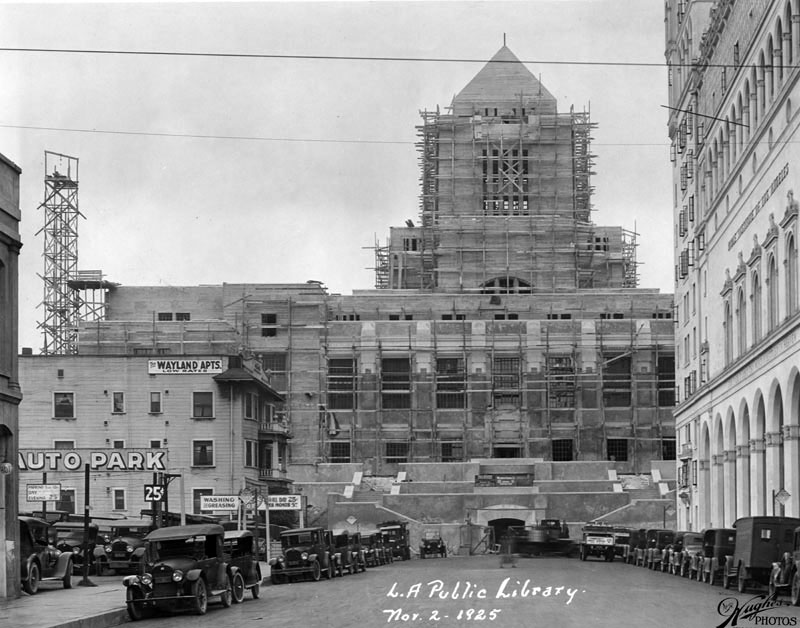 |
|
| (1925)* - Photograph shows construction of the Los Angeles Public Library, located at 630 W. Fifth Street; view is looking north on Hope Street. The structure, which is almost complete, shows scaffolding along the entire south side as well as surrounding the tower at the top. A sign posted above the tunnel entrance, at the end of this street reads: "Weymouth Crowell Co. - General Contractors". The Wayland Apts. offering "low rates" is visible on the left corner next to Savoy Auto Park, whose rates are .25 cents all day, or $5.00 per month. The large white building on the right is the Bible Institute, later to become Church of the Open Door/Biola Institute. |
Historical Notes The Central Library Goodhue building was constructed between 1924 and 1926 on the site once occupied by the State Normal School (later to evolve into UCLA). |
 |
|
| (1926)*##^ – Closer view looking north on Hope Street showing the Central Library Goodhue building in its final stages of construction. |
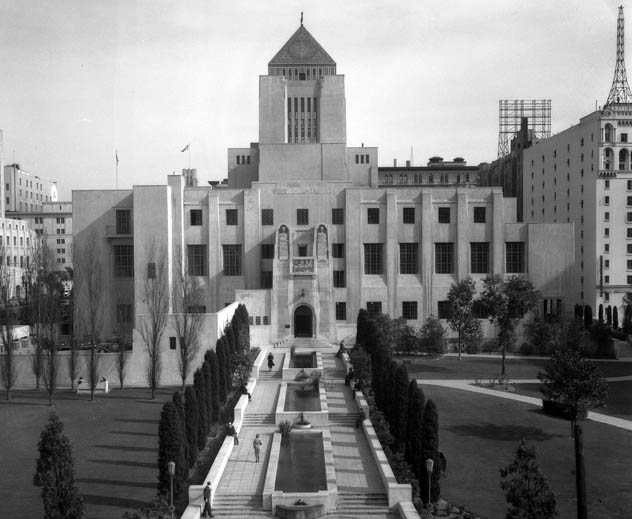 |
|
| (ca. 1935)* - Walkway and front facade of Los Angeles Public Library's Central Library, located at 630 W. 5th Street. View is looking east from Flower Street with the Church of the Open Door (Bible Institute) to the right. |
Historical Notes On March 1, 1967 the Central Library Building was designated Los Angeles Historic-Cultural Monument No. 46 (Click HERE to see listing). It is also listed on the National Register of Historic Places. |
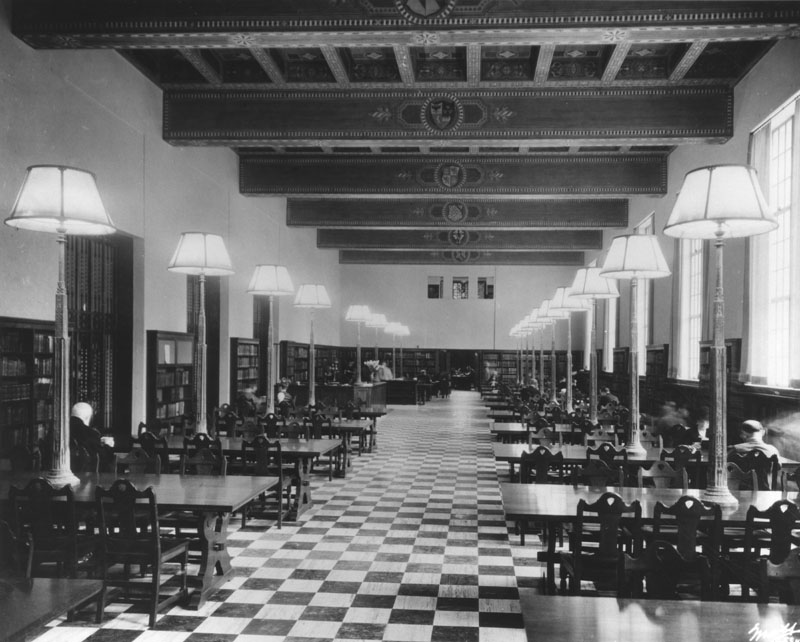 |
|
| (1926)* - Interior view of the History Department, at Los Angeles Central Library; view is looking toward the Travel and Biography section. The reference desk is visible mid-way on the left, and long wooden tables can be seen throughout the department - all have tall lamps illuminating each area. Note the colorful ceiling beams and checkerboard floor. |
Historical Notes The History Department was previously known as the Reference Room - which was the largest reading room of the library.* |
Click HERE to see more Early Views of the Los Angeles Central Library |
* * * * * |
Million Dollar Theatre Building
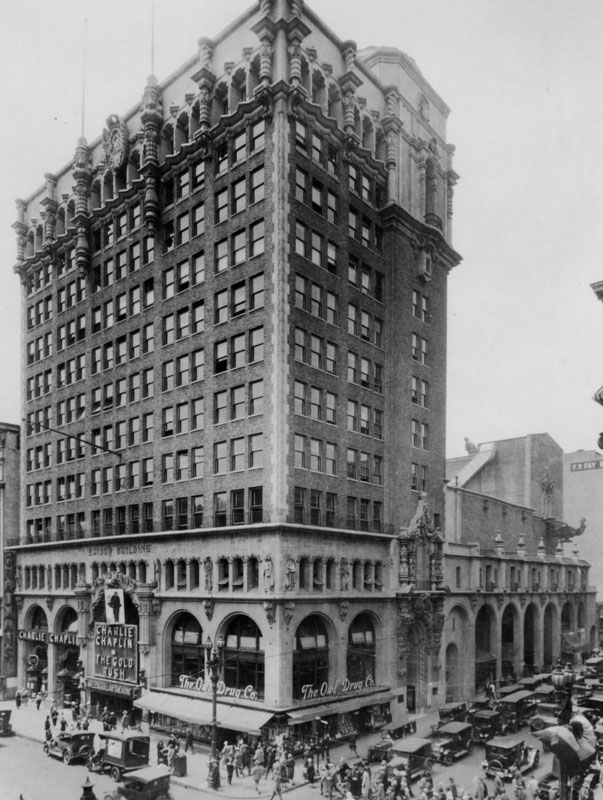 |
|
| (1925)* - Exterior view of a building on the corner of Third Street and Broadway. It was the home of the Edison Company offices, the Million Dollar Theatre (formerly Gruman’s Theater), and the Owl Drug Company. The marquee indicates that Charlie Chaplin's 1925 film Gold Rush is playing at the theater. |
Historical Notes Albert G. Martin and William Lee Woollett designed the building, constructed in 1918. The exterior, in the "Churrigueresque" style, was designed by A.C. Martin Sr., while the baroque interior was designed by W.L. Woolett. The interior includes the mural 'The Witch Scene from Macbeth' and a sculpture by Joe Morra. Click HERE to see more early views of the Million Dollar Theatre Building. |
* * * * * |
Metropolitan Theatre (later Paramount Theatre)
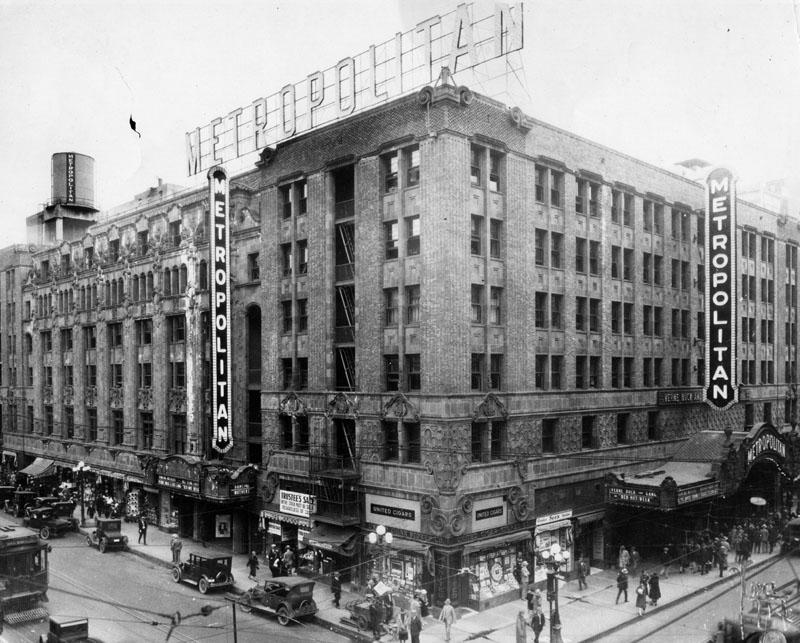 |
|
| (ca. 1925)* - View of the Grauman's Metropolitan Theater Building (later the Paramount Theater) located on the northeast corner of 6th and Hill streets across from Pershing Square. |
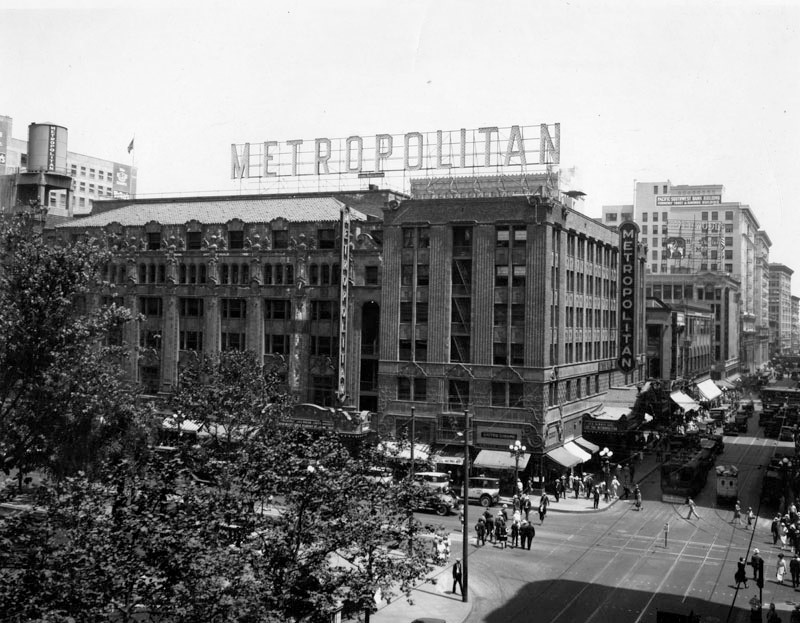 |
|
| (1926)* - View looking at the Metropolitan Theatre on the NE corner of 6th and Hill with Pershing Square at lower-left. |
Historical Notes The building extended 155 feet along 6th and 247 feet along Hill. The main entrance was on 6th while Hill got a much smaller marquee and a miniscule lobby. Those two entrances weren't enough. For a Broadway entrance an existing retail space was re-purposed for a lobby. You went up the stairs (or escalator) and across the alley, entering the theatre building at balcony lobby level. **^ |
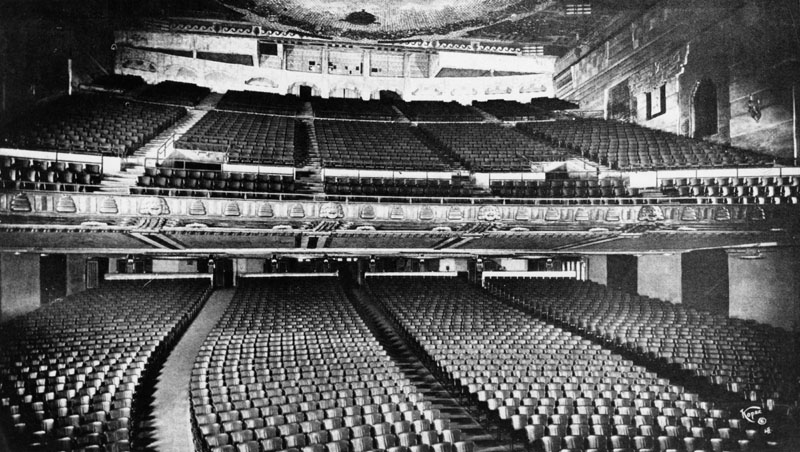 |
|
| (1923)* - Interior view of the Metropolitan Theater as seen from the stage. |
Historical Notes With over 3,600 seats, the Metropolitan/Paramount was the largest movie theater in Los Angeles for many years. Not only did it have one of the largest balconies ever built, its projector had the longest projection throw in the city.^^^* |
 |
|
| (ca. 1920s)* - View of the proscenium from the balcony of the Metropolitan Theatre (Paramount Theatre after 1928). |
Historical Notes The orchestra wasn't in a pit but on a big stage elevator. The screen and prologue action was behind.**^ |
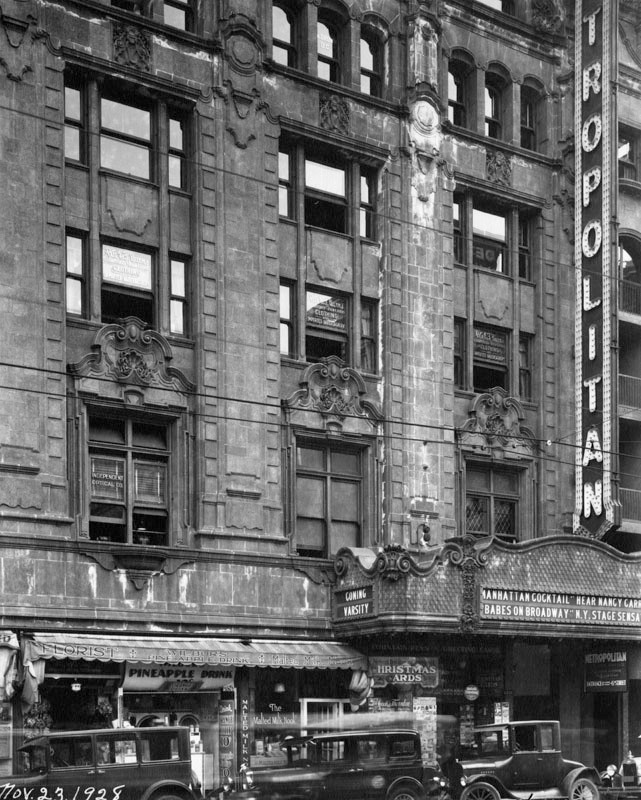 |
|
| (1928)* – Close-up view of the Metropolitan Hotel façade with early model cars parked at the curb. |
Historical Notes In July 1924 Grauman sold his downtown holdings to Paramount Publix. Like other west coast Publix theatres, the Metropolitan was actually operated by Fox West Coast for Paramount. Publix continued to use the Grauman name in advertising although he no longer participated in the theatre's operation. The Metropolitan name came off the building in 1928 and the theatre became the Paramount.**^ |
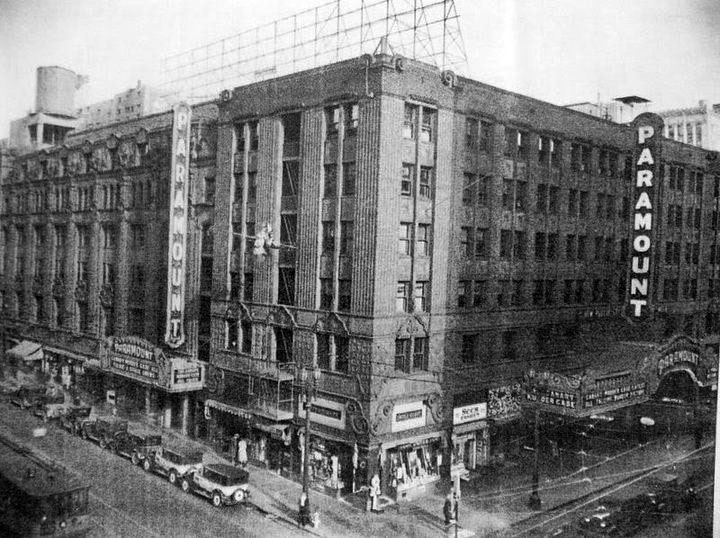 |
|
| (1929)#^*^ - A look at the NE corner of 6th and Hill with the new Paramount signage. The theatre is running "The Canary Murder Case" (a February 1929 release) with William Powell and Louise Brooks. |
Historical Notes The Metropolitan name came off the building in 1928 and the theatre became the Paramount.**^ |
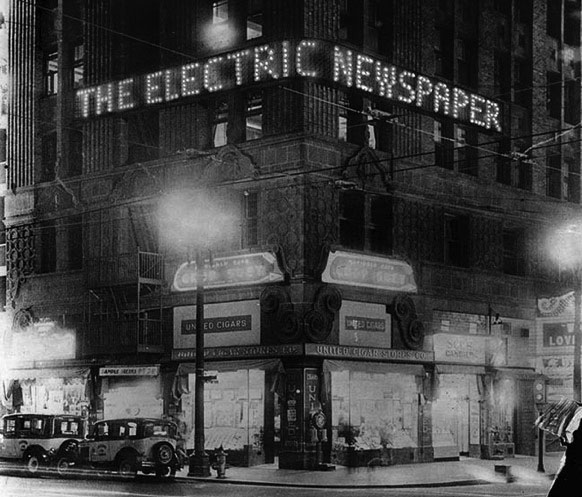 |
|
| (1931)*# – View showing the Los Angeles Times--Richfield “Electric Newspaper” during its preview at the NE corner of 6th and Hill streets on the Paramount Theatre Building (previously the Metropolitan Theatre Building). |
Historical Notes It was apparently thought that the flashing bulletins would stimulate Los Angeles residents to buy the paper the next day to read details behind the headlines. The Times faced stiff competition from several metropolitan papers during the ’30s, and having control of the bulletins read by thousands of people downtown was considered something of a coup. *# |
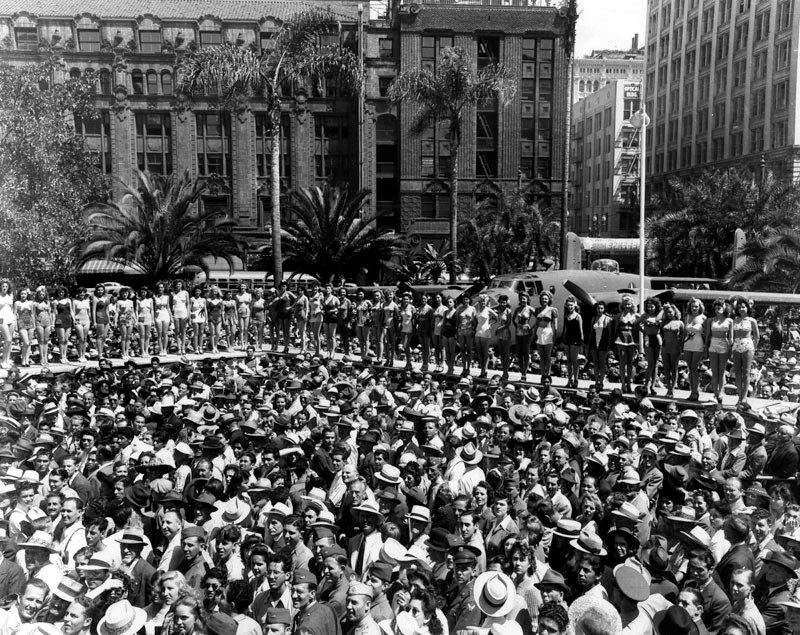 |
|
| (1942)**^ – View showing a beauty pageant in process in Pershing Square with the Paramount Theatre in the background. Photo by Ralph Morris |
Historical Notes In 1963, the Paramount was torn down to make way for a parking lot. In the early 1980’s, a bank was built on this same lot.^ |
* * * * * |
Desmond's Building
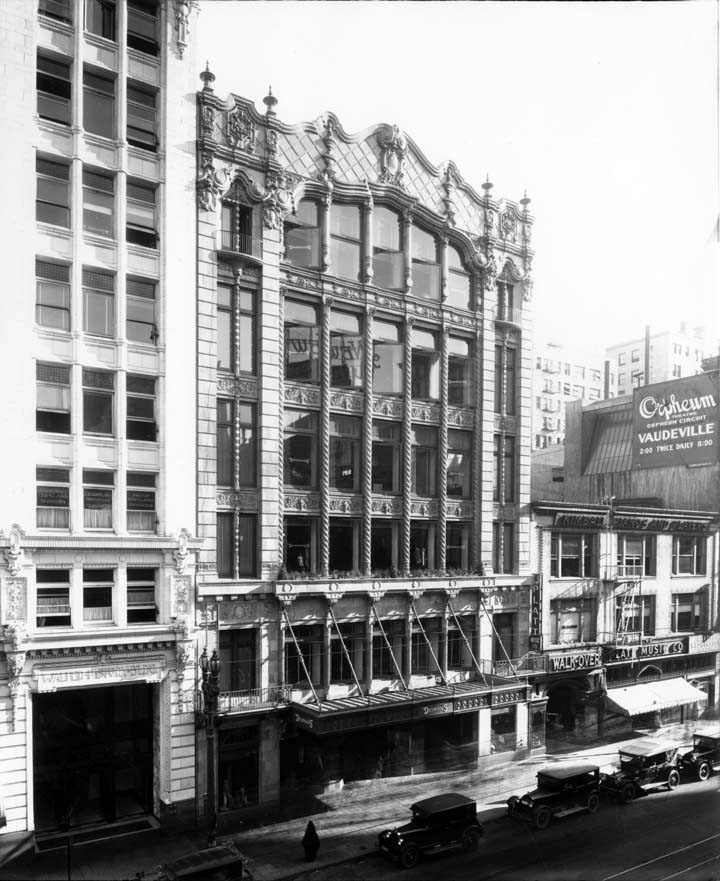 |
|
| (ca. 1925)^*# - View showing the Art Deco style Desmond’s Department Store located at 616 South Broadway. The Walter P. Story Building is on the left; and the Platt Music Company (later Schaber's Cafeteria, 1928) and Orpheum Theatre on the right. |
Historical Notes In 1869, Daniel Desmond arrived in Los Angeles and opened a hat store on Los Angeles Street near Commercial Street. His business expanded and he relocated into the more fashionable Broadway mercantile district at 612-616 South Broadway. In 1924, A. C. Martin designed the six-story concrete building in the Spanish Baroque Revival style featuring a terra cotta façade with twisting columns, balconies and an ornamental pediment. In 1933, the façade was redone in the Beaux Arts style (probably as a result of the Long Beach earthquake).* |
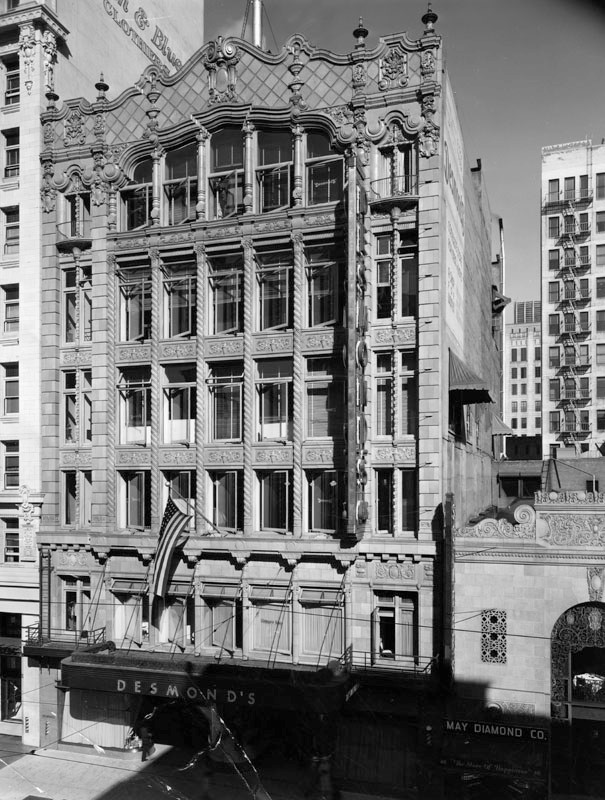 |
|
| (ca. 1929)* - Closer view showing the beautiful Desmond's Clothing Store at 616 South Broadway in Downtown Los Angeles. Schaber's Cafeteria is to the right. Click HERE to see contemporary view of the Desmond's Building. |
Historical Notes Previously on this site was the Symphony Theatre which opened in the 1910's and was demolished in 1923. |
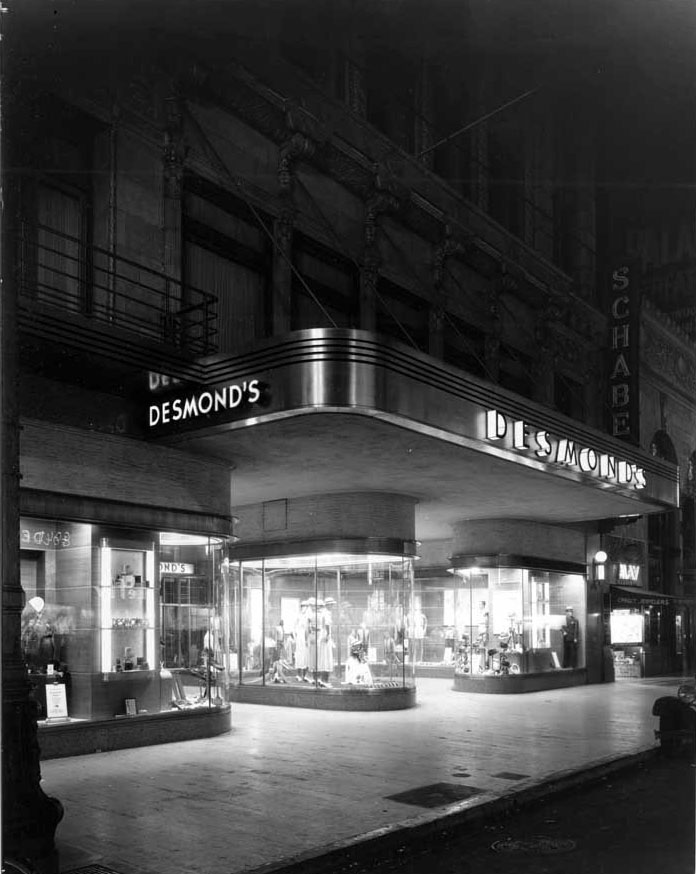 |
|
| (ca. 1930s)^*# - Night view showing the front entrance and window displays of the Desmond’s Department Store on Broadway. |
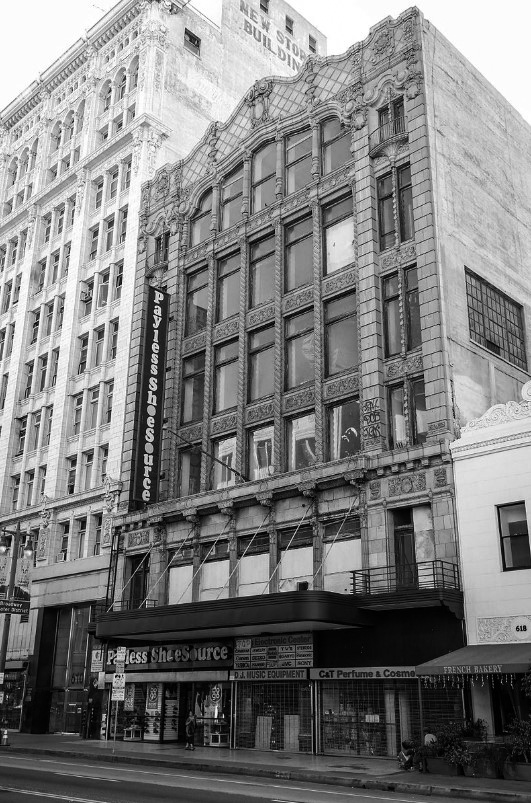 |
|
| (2014)*^ - View showing the former Desmond's flagship store at 616 S. Broadway, Los Angeles. |
* * * * * |
Cocoanut Grove
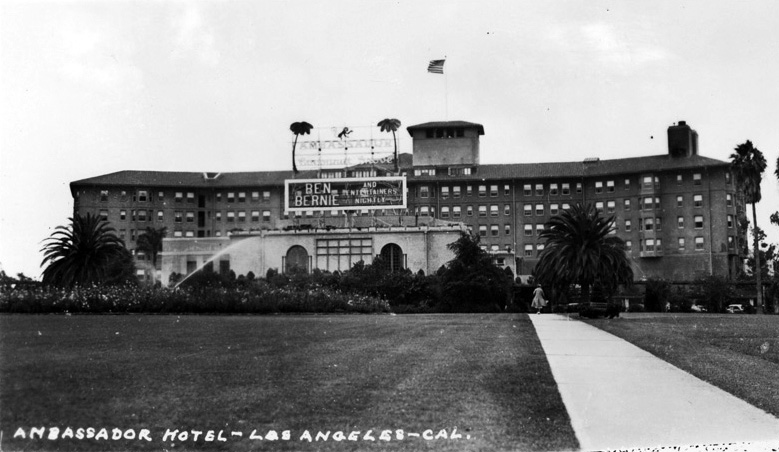 |
|
| (ca. 1920s)^*# - Postcard view of he Ambassador Hotel and the Cocoanut Grove. Ben Bernie and his orchestra are featured at the Grove. |
Historical Notes The Ambassador Hotel and the Cocoanut Grove began operation formally on January 1, 1921, and were located at 3400 Wilshire Boulevard, between Catalina Street and Mariposa Avenue.^* In 1925 Ben Bernie and his orchestra did the first recording of Sweet Georgia Brown. Bernie was the co-composer of this jazz standard (also Maceo Pinkard), which became the theme song of the Harlem Globetrotters.^* |
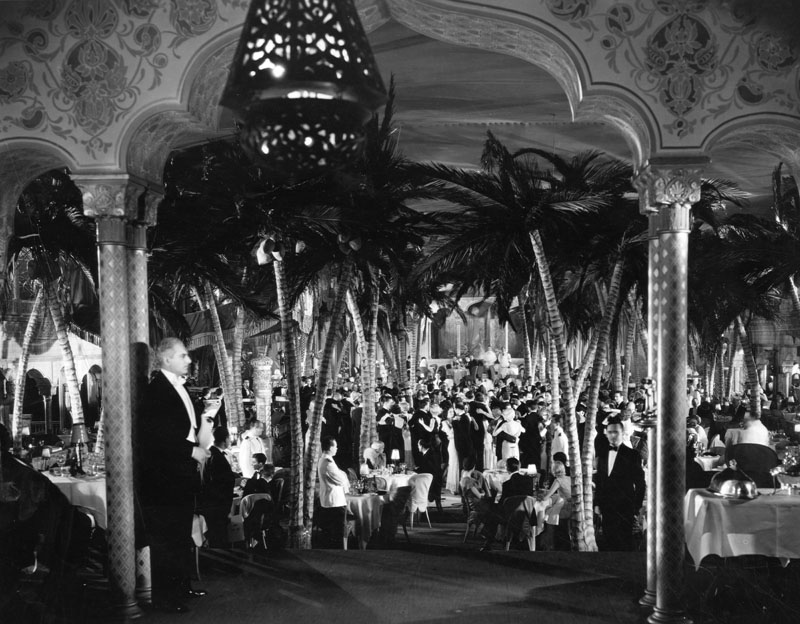 |
|
| (ca. 1938)* - A view across the dining room of the nightclub. Tables and the dance floor are filled with customers. A waiter stands in front. A large number of cocoaut trees spread throughout the room, plus the ornate decorations of ceilings and walls give the room an exotic look. |
Historical Notes For decades, the the Ambassador Hotel's famed Cocoanut Grove nightclub hosted well-known entertainers, such as Frank Sinatra, Barbra Streisand, Judy Garland, Lena Horne, Bing Crosby, Nat King Cole, Liza Minnelli, Martin and Lewis, The Supremes, Merv Griffin, Dorothy Dandridge, Vikki Carr, Evelyn Knight, Vivian Vance, Dick Haymes, Sergio Franchi, Perry Como, Dizzy Gillespie, Benny Goodman, Sammy Davis Jr., Little Richard, Liberace, Natalie Cole, and Richard Pryor.^* On February 29, 1940, the 1939 Academy Awards Ceremony was held in the Cocoanut Grove, with Bob Hope hosting.* |
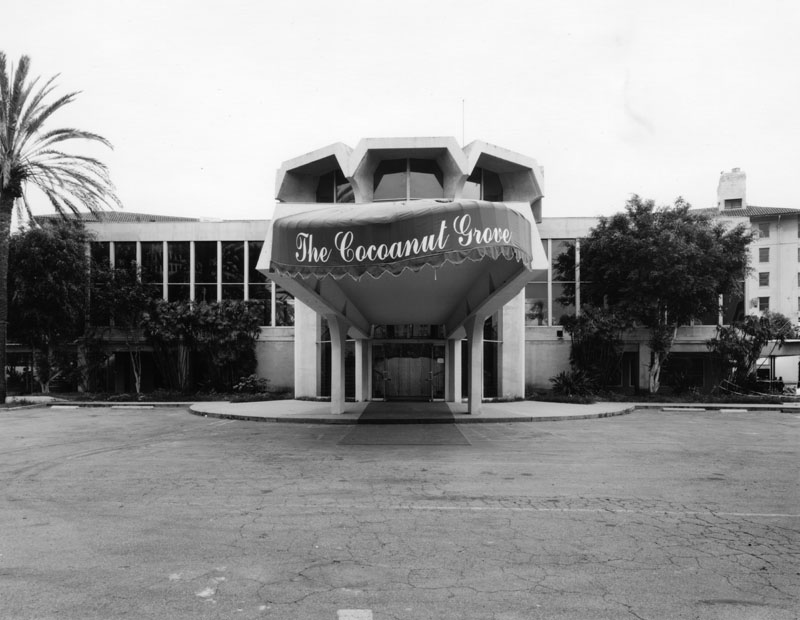 |
|
| (2005)* - View of Cocoanut Grove entrance, facing south. For decades this was "the" hot spot for live entertainment on the West Coast, where people like Bing Crosby and Barbra Streisand got their start, and Frank Sinatra, Sammy Davis Jr. and many others came to perform. |
Historical Notes In 2005, most of the Ambassador Hotel was demolished leaving only the annex that housed the hotel entrance, a shopping arcade, the coffee shop, and the Cocoanut Grove, all of which were promised to be preserved in some manner and used in a new LAUSD school to be built on the site. Due to poor structural integrity, however, the LAUSD decided to demolish most of the Cocoanut Grove, retaining only the hotel entrance and east wall of the Grove.^* |
* * * * * |
Asbury Apartments
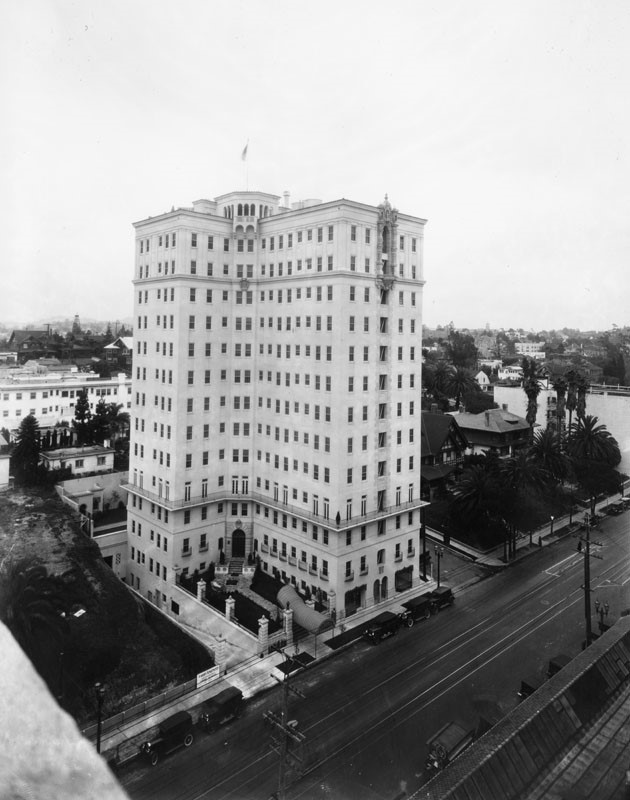 |
|
| (ca. 1925)* - View looking southwest showing the Asbury Apartments, located at 2505 W. 6th Street. Note the canopy above the sidewalk at the entrance. |
Historical Notes The Asbury Apartments was designed by Norman W. Alpaugh & Clarence H. Russel and built in 1924. Originally to be named the San Jacinto Dwellings, these luxury residences with commanding views of Westlake (now MacArthur) Park were regarded as ultra-exclusive when the building opened in 1925. #^*# |
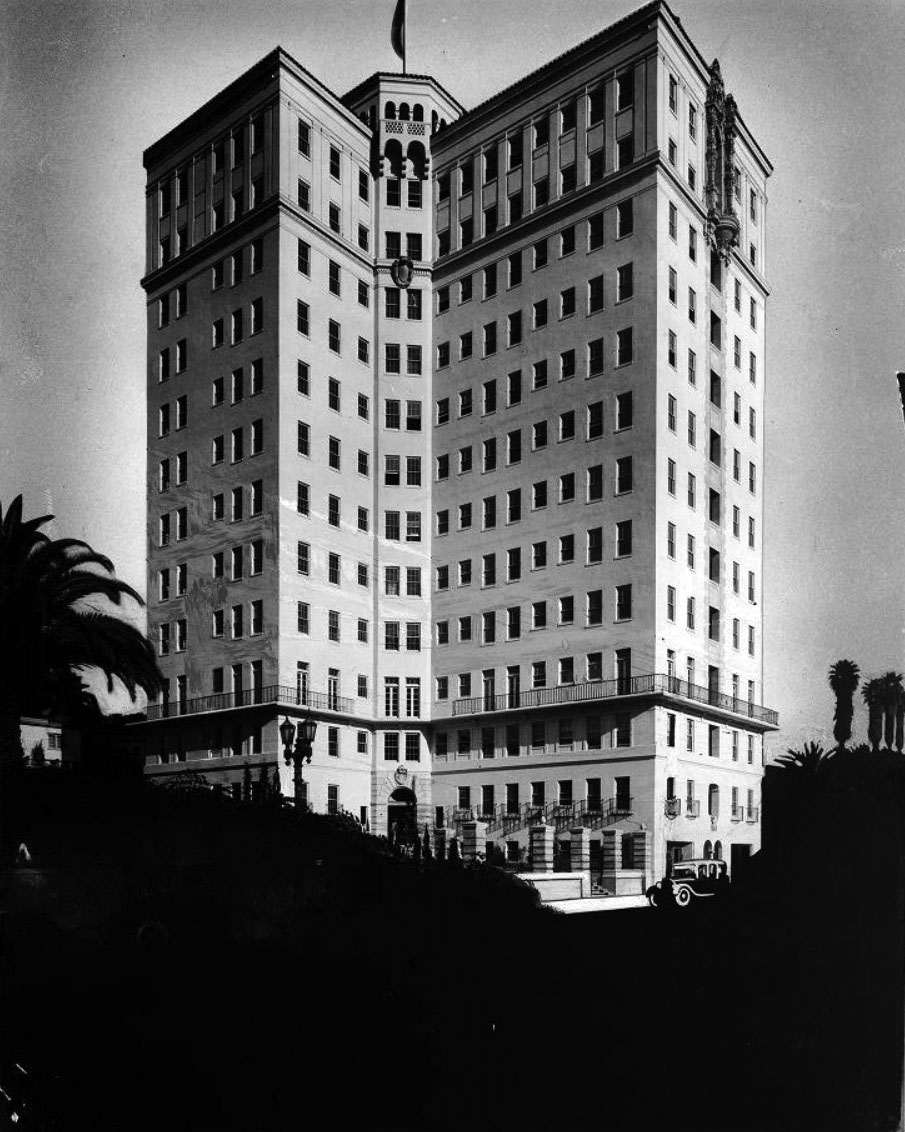 |
|
| (1929)^ – Ground view of the Asbury Apartments as seen from across the street, located on the southeasst corner of 6th Street and S. Carondelet Street. |
Historical Notes Units were sold individually in what was termed the "own-your-own" plan, the building was electrically operated throughout, and it contained a parking garage accessible by elevator -- quite rare at the time. A balcony extends along the fourth floor of the building, and the upper portion of the fire escape shaft facing Sixth Street is embellished with a semi-circular balcony and elaborate Churrigueresque detailing. #^*# |
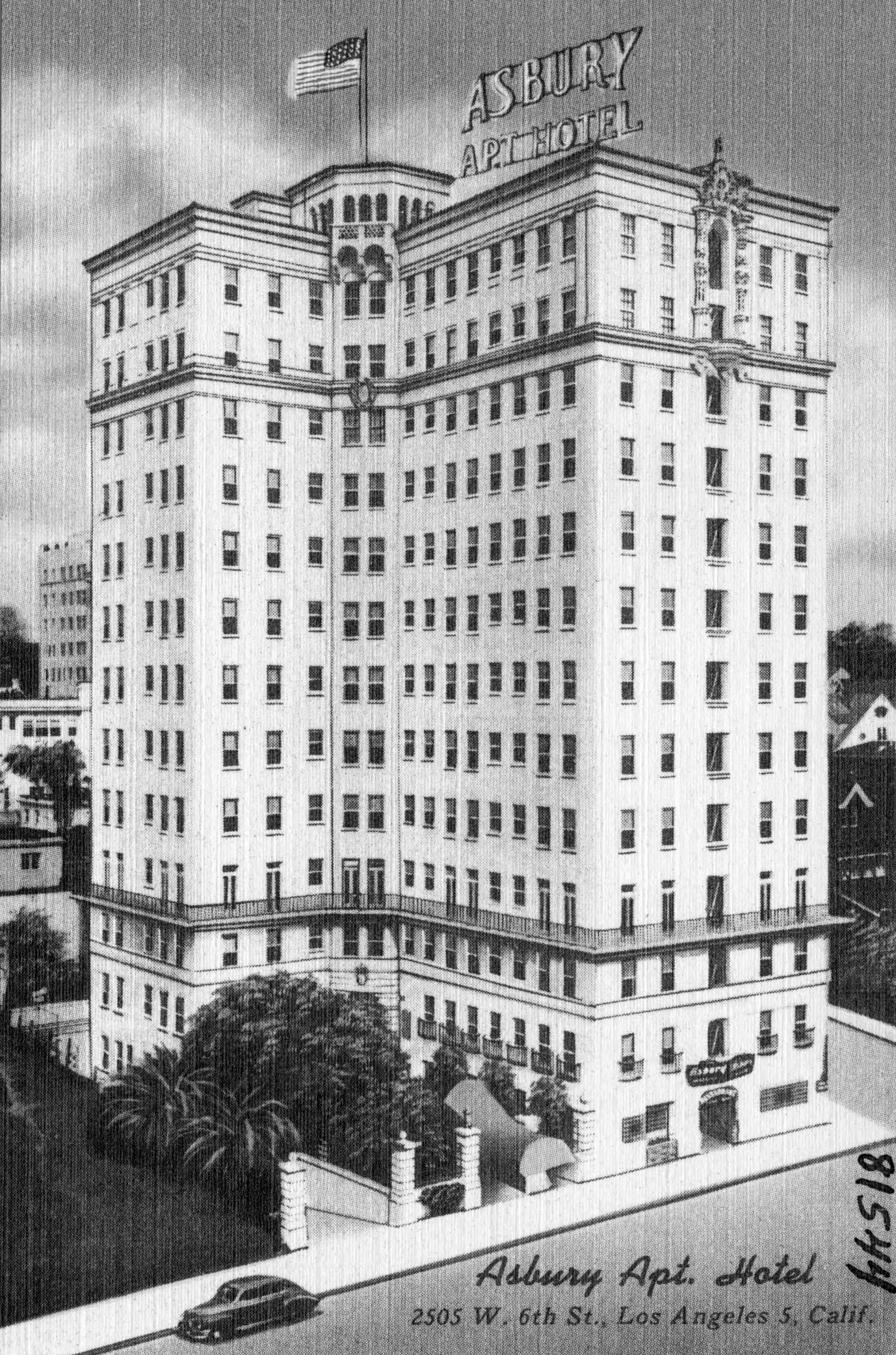 |
|
| (1940s)^* - Postcard view showing the Asbury Apartment - Hotel on 6th Street. |
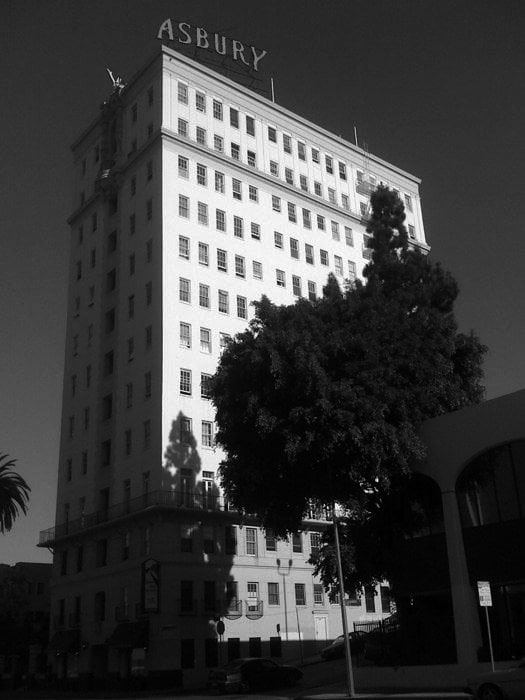 |
|
| (2009)^^ – Looking up toward the top of the Asbury Apartments as it appears today. View is looking southeast. Click HERE for contemporary close-up view. |
Historical Notes The two rooftop signs, advertising "Asbury" in neon, are visible for several blocks and were restored by the city's LUMENS program (Living Urban Museum of Electric and Neon Signs). |
* * * * * |
Talmadge Apartments
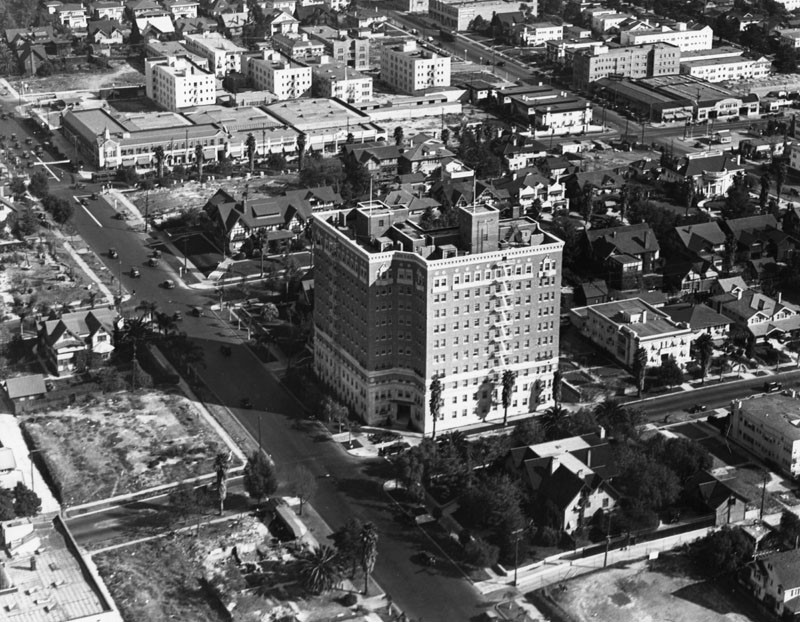 |
|
| (1924)* – Aerial view looking southeast showing The Talmadge Apartments located at 3278 Wilshire Boulevard. |
Historical Notes The Renaissance Revival-style building was designed by Architects Curlett and Beelman and completed in 1923. The building rose on the site of a Craftsman mansion designed for automobile dealer Earle C. Anthony in 1909 by legendary Pasadena architects Charles and Henry Greene. In 1923, the home was sold to actor Norman Kerry, who had it moved to North Bedford Drive in Beverly Hills. #^*# |
 |
|
| (ca. 1930s)* – Street view looking across Wilshire Boulevard showing the Talmadge Apartments on the southeast corner of Wilshire and Berendo Street. |
Historical Notes The elegant brick apartment tower bears the name of silent film actress Norma Talmadge. She and her husband, Hollywood producer Joseph Schenk, owned the building when it opened in 1924. The Talmadge opened with a summer garden party attended by socialites and business leaders. The Schenks lived for a time on the tenth floor. It remained an upscale address through the heyday of Wilshire Boulevard, attracting celebrities and dowagers who enjoyed attentive service. #^*# |
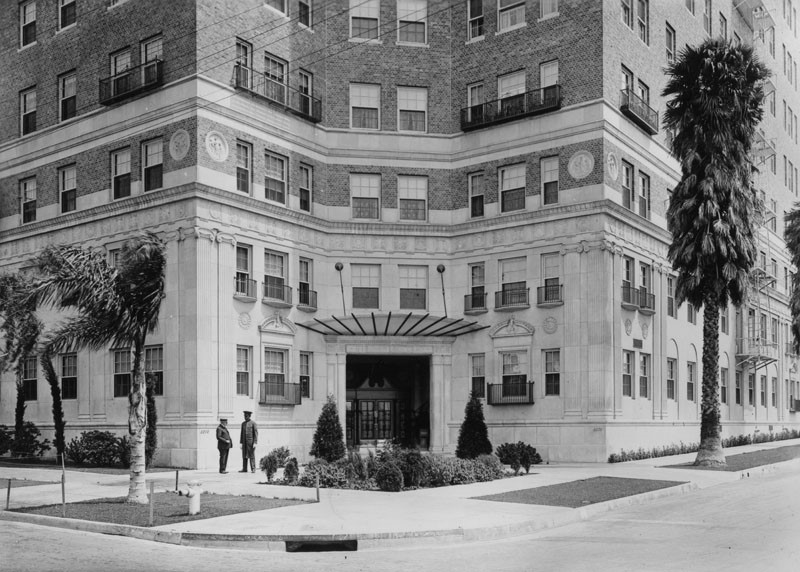 |
|
| (ca. 1940s)* – Close-up view showing the entrance to The Talmadge Apartments. Two men are seen standing in front of the building, one of which appears to be the doorman. |
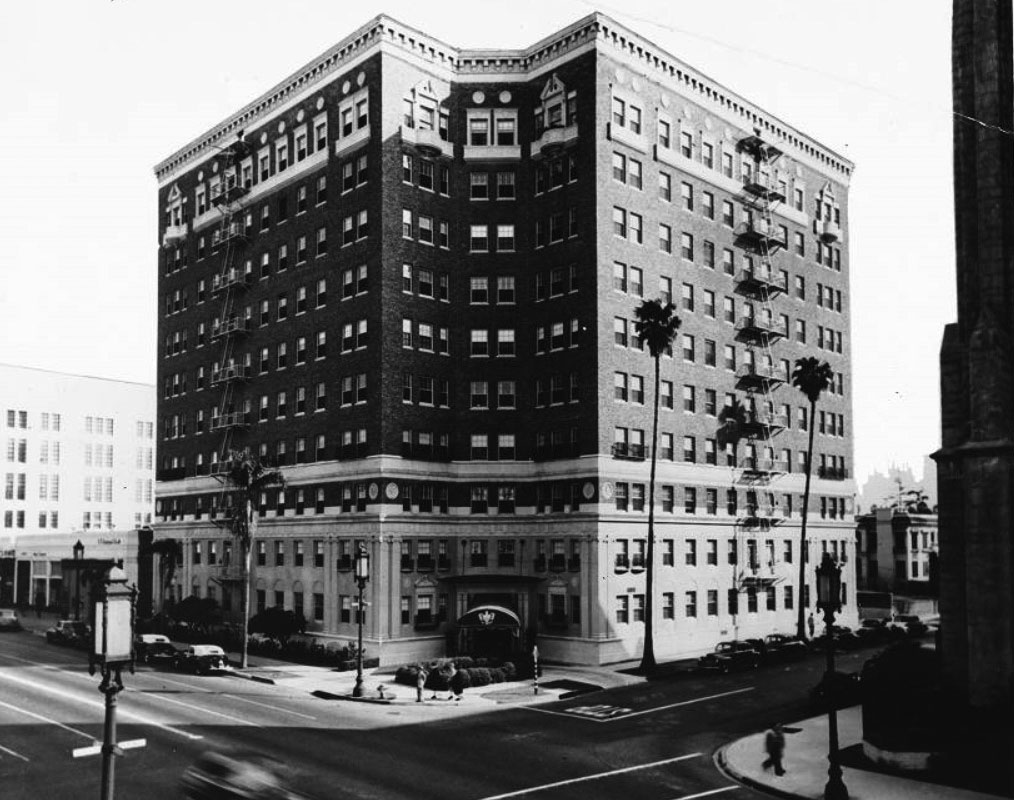 |
|
| (1952)^ - View of the Talmadge Apartments, southeast corner of Wilshire and Berendo. To the right can be seen the Immanuel Presbyterian Church (built in 1928). Note the height of the palm trees when compared to previous photos. |
Historical Notes Click HERE to see a contemporary view of the Talmadge Apartments. |
* * * * * |
George L. Crenshaw Residence
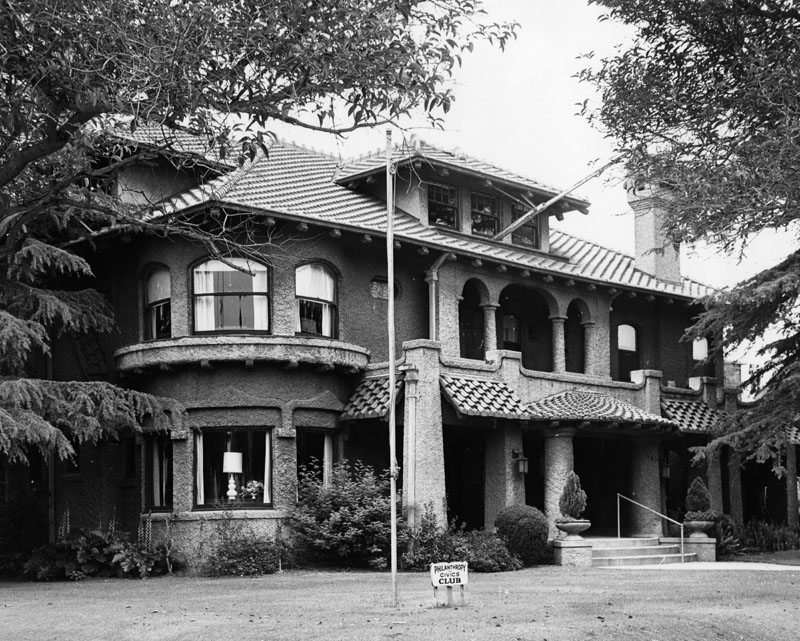 |
|
| (ca. 1924)* - Exterior view of the home once owned by George L. Crenshaw, located at 1419 S. Wilton Place. The roof and eaves are adorned with tiles, there is a slightly rounded dome on the left of the house, and arches on the second floor balcony. Above that, a dormer with three windows. The home became the Philanthropy and Civics Club clubhouse in 1924. A sign next to a flagpole on the front lawn reads, "Philanthropy and Civics Club". |
Historical Notes George L. Crenshaw was a banker and real estate developer who built several upscale residential developments in mid-city Los Angeles in the early 1900s. Among these was Lafayette Square and Wellington Square. The Crenshaw district of Los Angeles and its principal thoroughfare, Crenshaw Boulevard, bear his name.^* |
* * * * * |
First Church of Christ
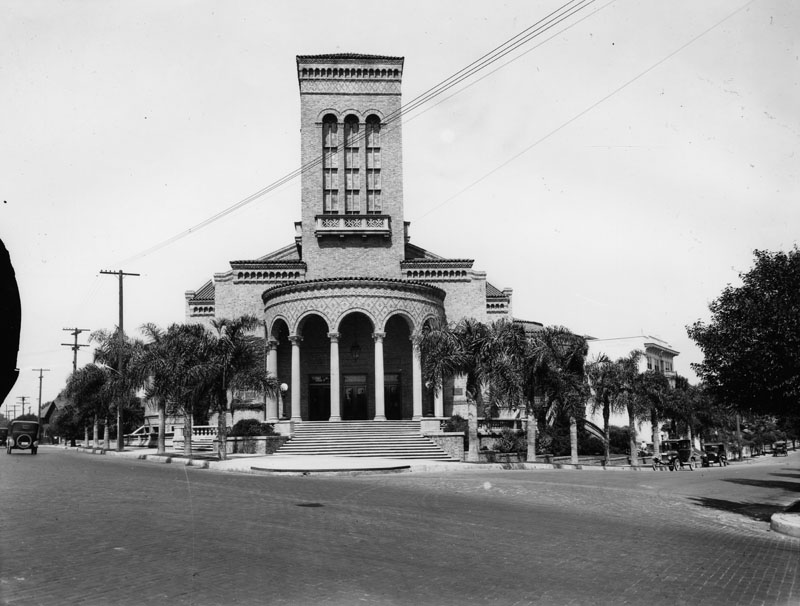 |
|
| (ca. 1920)* - View of the First Church of Christ from Hoover Street. Alvarado Street is on the left and Alvarado Terrace is on the right. |
Historical Notes Designed by architect Elmer Grey in the Beaux Arts/Italian/Spanish Romanesque style, the First Church of Christ, Scientist was constructed in 1912. It later became the Central Spanish Seventh-Day Adventist Church. It is Los Angeles Historic-Cultural Monument No. 89.* Click HERE to see the complete list of the LA Historic-Cultural Monuments. |
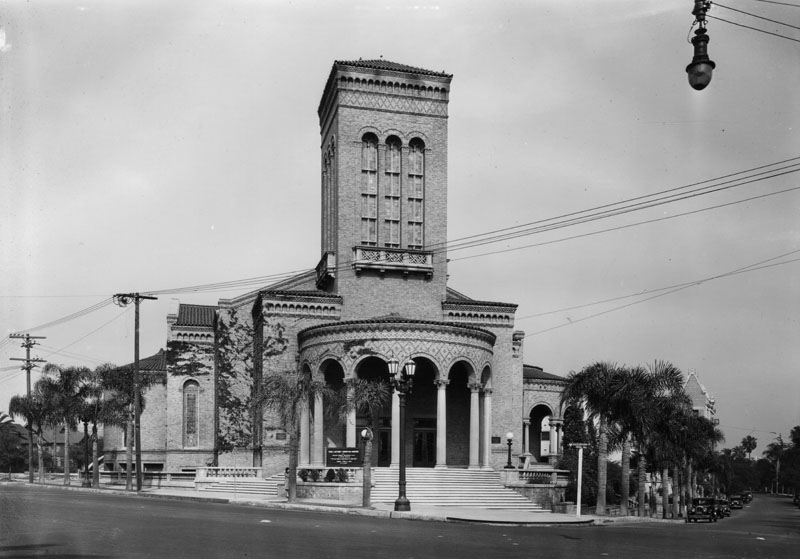 |
|
| (ca. 1925)* - Exterior view of First Church of Christ, Scientist, located at 1366 So. Alvarado Street. |
Historical Notes Now the Iglesia Adventista Central. For a time in the 1970s it served as the Los Angeles branch of the ill-fated Peoples Temple led by the Rev. Jim Jones. |
* * * * * |
B'nai B'rith Temple
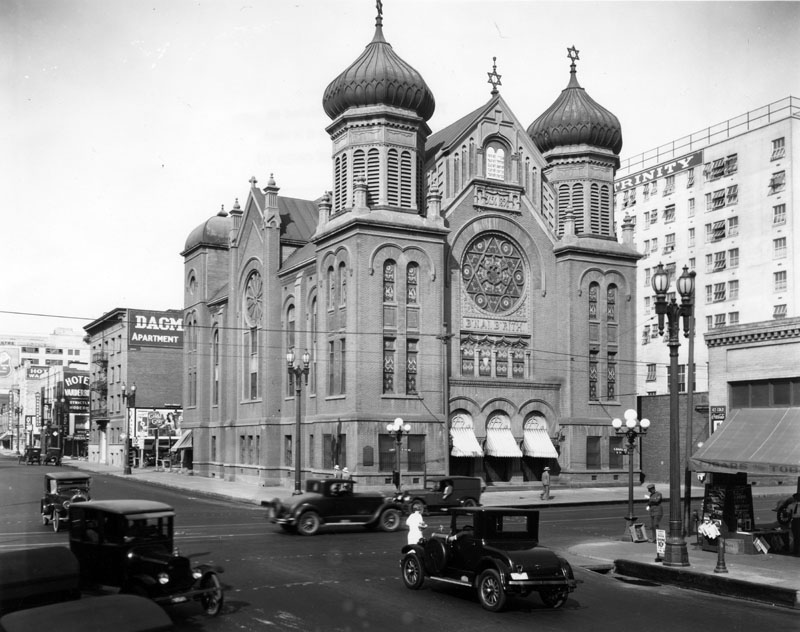 |
|
| (1926)* - Exterior view of the second B'nai B'rith Temple on the corner of 9th and Hope streets. Neighboring businesses, hotels and apartment buildings are visible all along Hope Street, which runs from the foreground to the left side of the image. |
Historical Notes Architect Abraham M. Edelman designed this synagogue, the second building for the congregation of B'nai B'rith. The cornerstone was laid on March 15, 1896 and it was dedicated on September 5th of the same year. The synagogue, which had seating for 600 people, was built of red brick with twin towers and pomegranate domes, its floors were carpeted in deep red with plush-cushioned pews and had a chandelier containing 60 bulbs, which made it the largest in the city. H.W. Hellman, Harris Newmark, Kaspare Cohn, and Mrs. J.P. Newmark presented the beautiful stained glass windows. This grand edifice was replaced in 1929 when Wilshire Boulevard Temple opened.* Congregation B'nai B'rith occupied its first building at Temple and Broadway in Downtown from 1862 until 1895.* Click HERE to see first location of B'nai B'rith Temple. |
* * * * * |
Wilshire Congregational Church (now Wilshire United Methodist Church)
 |
|
| (1925)*^*^ – View showing the Wilshire Boulevard Congregational Church still under construction, located at 4350 Wilshire Boulevard. |
Historical Notes Designed by Allison & Allison and built in 1924-1925, the church was promoted by Portland Cement Association as being "all-concrete." The exterior has a Romanesque revival appearance, while the interior is reminiscent of the Gothic revival style.* |
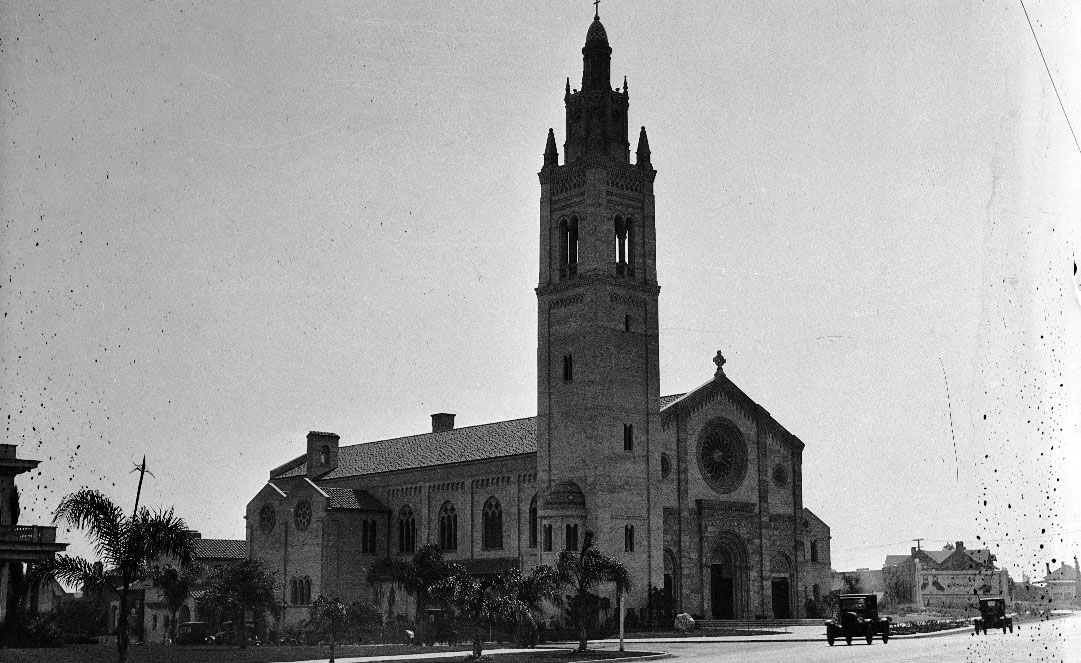 |
|
| (ca. 1925)*^*^ – View showing the Wilshire Boulevard Congregational Church shortly after its completion, located on the southwest corner of Plymouth and Wilshire Boulevards. |
Historical Notes The architects, Allison and Allison, who also designed First Congregational Church (540 S. Commonwealth), Janss Dome Building (1099 Westwood Blvd.), and buildings at UCLA, were known for their masterful use of concrete and fusion of Italian, Spanish, and Gothic styles, all in evidence here. #^*# |
.jpg) |
|
| (1925)* - Close up view of the Wilshire Boulevard Congregational Church (later Wilshire United Methodist Church). It was designed by Allison and Allison to have a Romanesque exterior with a Gothic interior. |
Historical Notes In its early years, the church's founding pastor, Frank Dyer, engendered great controversy by holding a jazz concert in the sanctuary and by staging a church fundraiser at the Olympic Auditorium that was to include prizefighter Jack Dempsey. #^*# |
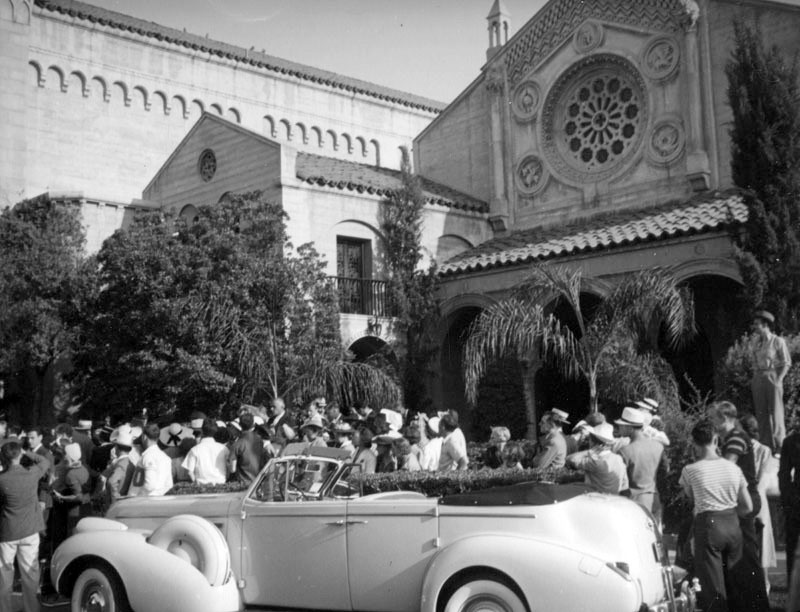 |
|
| (ca. 1939)* - A car is parked and crowds gather in front of the community hall of the Wilshire United Methodist Church, during what appears to be a wedding. |
Historical Notes In the 1930s and 1940s, the church became known for its celebrity contingent, hosting the weddings of Jeannette MacDonald in 1937 and seventeen-year-old Shirley Temple in 1945. #^*# |
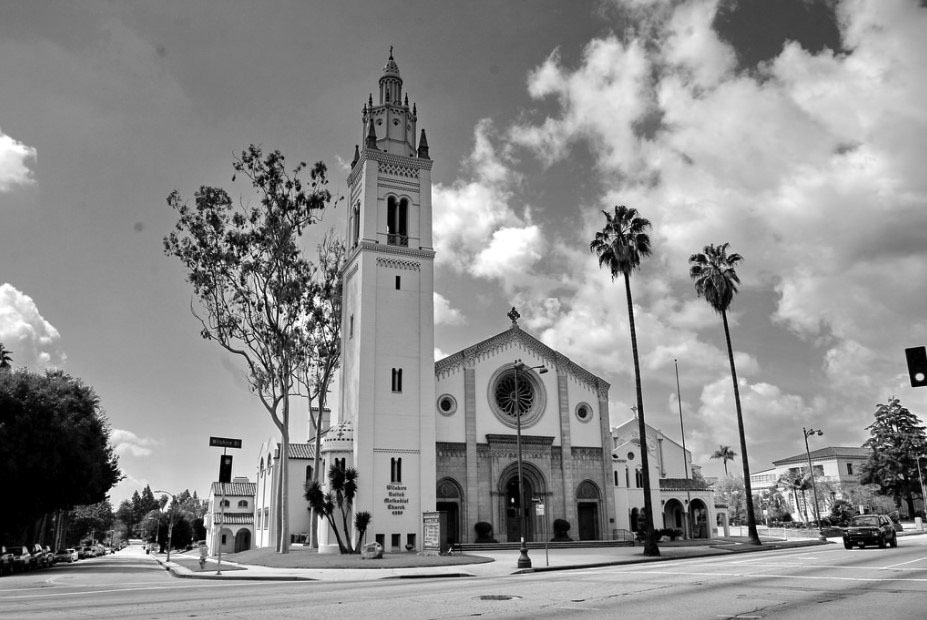 |
|
| (2010)^^** – View showing the Wilshire United Methodist Church as it appears today, SW corner of Wilshire and Plymouth Blvds. |
Historical Notes The church was designated a Los Angeles Historic-Cultural Monument in 1973 (No. 114). Located at 4350 Wilshire Blvd. in the Hancock Park neighborhood of Los Angeles. |
* * * * * |
Wilshire Christian Church
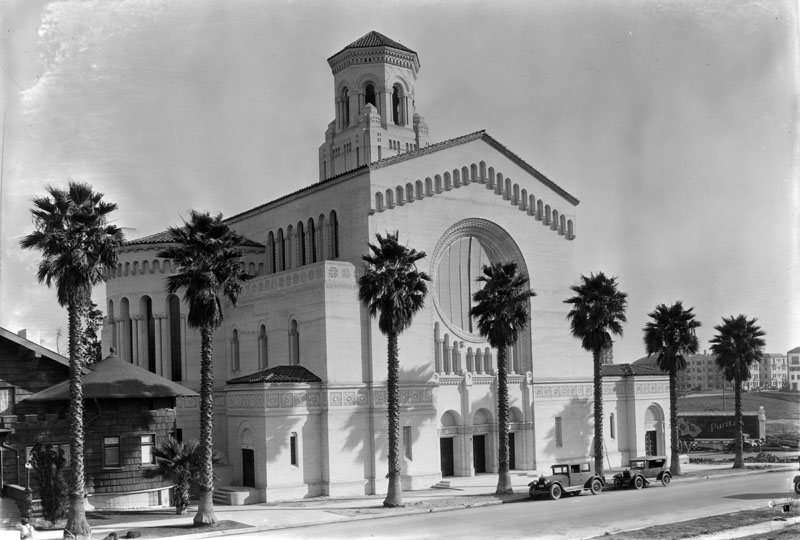 |
|
| (ca. 1927)* - Exterior view of the Romanesque Revival style Wilshire Christian Church during its construction, as seen from the western side of Normandie Avenue. The church's large rose window designed by Judson Studios has yet to be installed, but the window opening has been covered to protect the interior of the structure. |
Historical Notes After land was donated by Charles Chapman in 1911, a small bungalow style church was built at this corner of Wilshire Boulevard and Normandie Avenue. In 1927 the original church was replaced by this Northern Italian Romanesque style structure with a 200-foot tower, designed by Robert H. Orr.* Charles Clarke Chapman (1853–1944) was the first mayor of Fullerton, California and a relative of John Chapman, the legendary "Johnny Appleseed." He was a native of Illinois who had been a Chicago publisher before settling in Southern California. Chapman was a supporter of the Disciples of Christ, who was a primary donor and fundraiser for California Christian College, which in 1934 changed its name to Chapman College, and is now Chapman University, in his honor.^* |
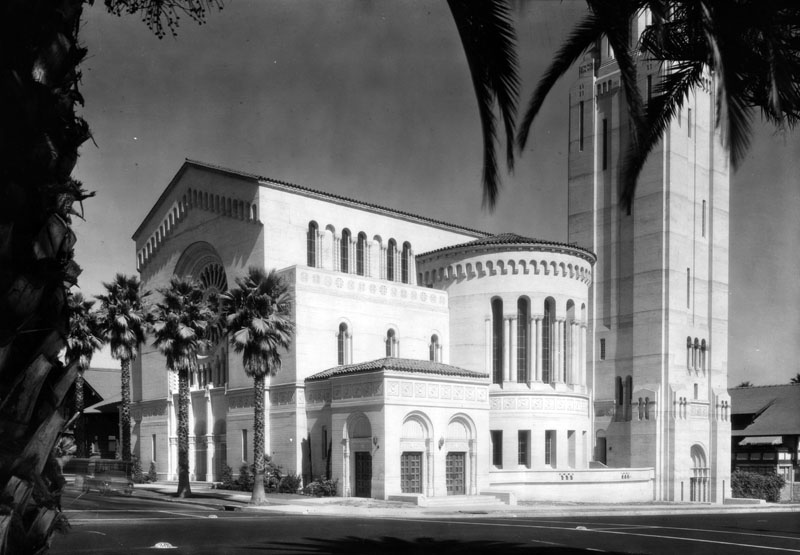 |
|
| (ca. 1927)* - Exterior view of the Romanesque Revival style Wilshire Christian Church, as seen from the southwest corner of the intersection of Normandie Avenue and Wilshire Boulevard not long after it was constructed in 1927. |
Historical Notes Located at 634 S. Normandie Avenue, the church was designated Los Angeles Historic-Cultural Monument No. 209 (Click HERE to see complete listing). |
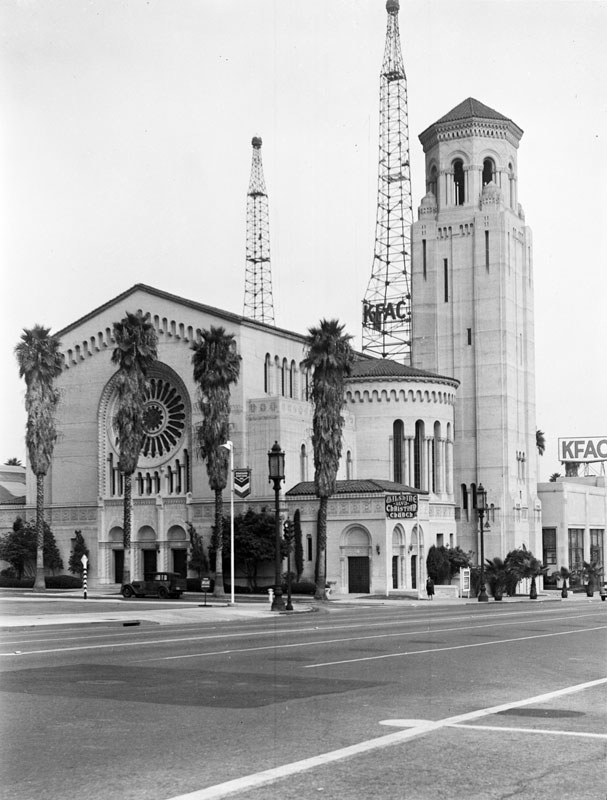 |
|
| (ca. 1930)* - Exterior view of the Wilshire Boulevard Christian Church taken from across Wilshire Boulevard. Located at 634 S. Normandie Avenue. The two towers for KFAC, a radio station next door, are visible. |
Historical Notes On May 19, 1940, First Christian Church of Los Angeles merged with Wilshire Boulevard Christian Church to become Wilshire Christian Church, which is of the Disciples of Christ denomination.* |
* * * * * |
Los Angeles Stock Exchange
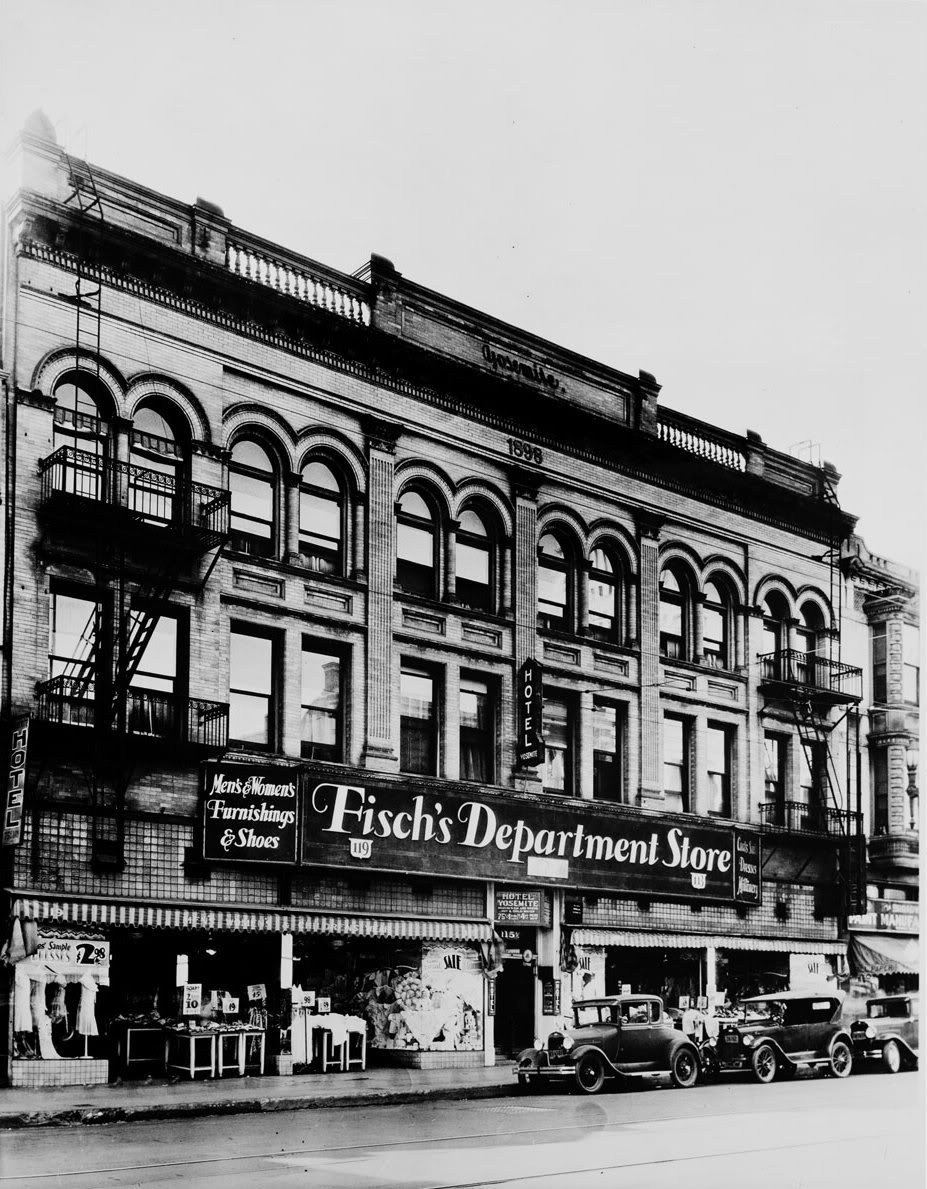 |
|
| (ca. 1927)^ - View of the Yosemite Building located at 115 South Broadway. This was the first home of the Los Angeles Stock Exchange in 1900. |
Historical Notes On December 7, 1899, a group of oil men lead by Wallace Libby Hardison met to organize the Los Angeles Oil Exchange to promote their industry, figure out how to get more investments, and set up a marketplace for related securities. The Exchange’s first trading session was on February 1, 1900, in the Yosemite Building on South Broadway, with seats selling for fifty bucks. At the end of the year, on December 23, the powers-that-be broadened the market’s services and renamed it the Los Angeles Stock Exchange.***# |
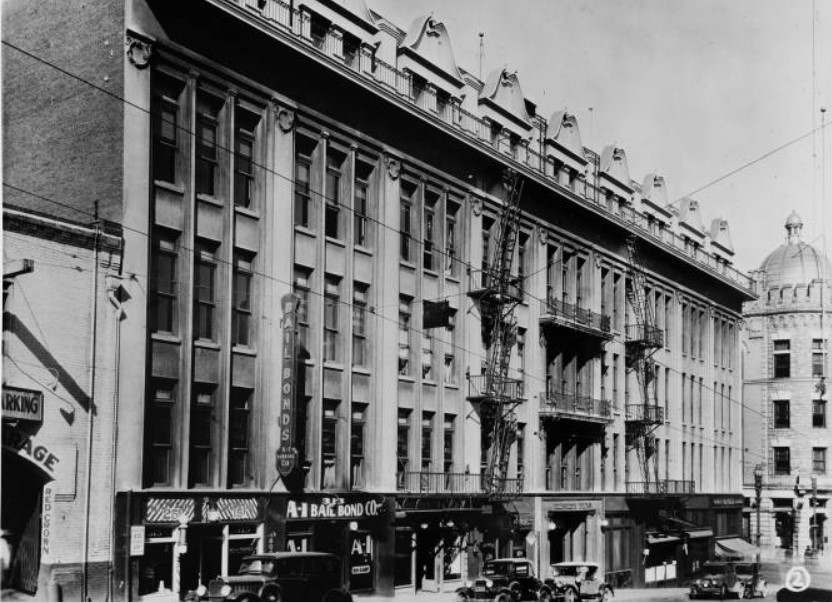 |
|
| (1930s)^ - View looking east on First Street showing the second home of the Los Angeles Stock Exchange. It was located on the second floor of the Tajo building, 307 West First Street. The LA Times building is seen at right on the corner of First and Broadway. |
Historical Notes The Exchange had relocated to half a dozen different locations in the city (including the Buildings Tajo, Hellman, and Chamber of Commerce) when, in early May 1929, the market bought the Strong & Dickinson (formerly Meredith) Building at 618 South Spring.***# |
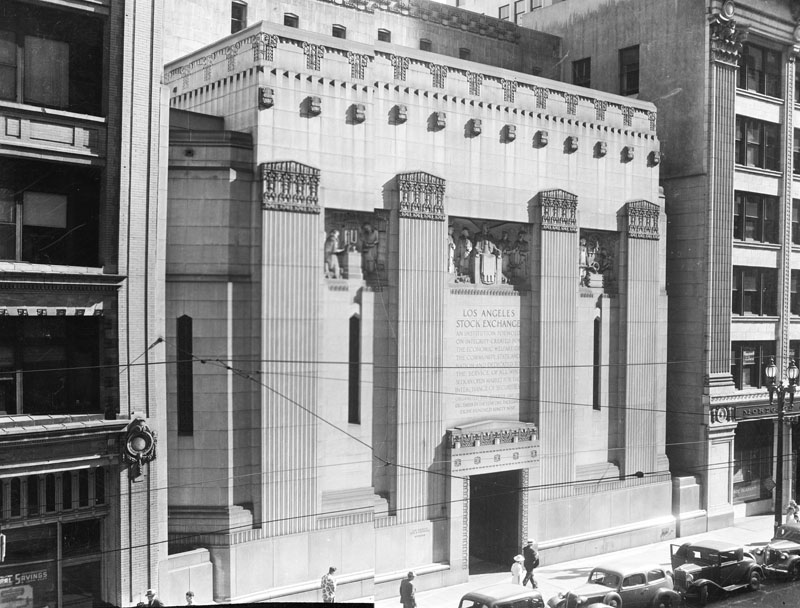 |
|
| (1939)* - Exterior view of the Los Angeles Stock Exchange Building at 618 South Spring Street on May 5, 1939, ten years after it was built. |
Historical Notes Built in 1929, the eleven-story exchange building was designed by Samuel Lunden in the Moderne style. Ground was broken in October 1929, just as the Great Depression hit, and when the Los Angeles Stock Exchange opened its doors there in 1931, the country was deep into the Depression. The Stock Exchange would stay in this building until 1986.^* On January 3, 1979, the Los Angeles Stock Exchange Building was designated LA Historic-Cultural Monument No. 205 (Click HERE to see complete listing). |
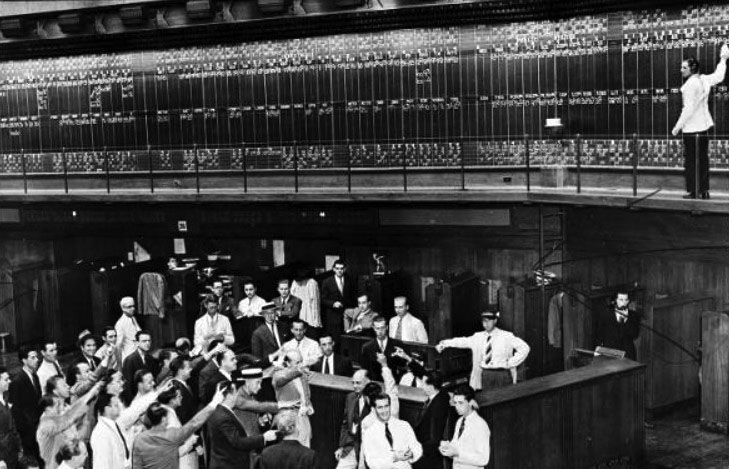 |
|
| (1938)^ - Stock brokers on the floor of the Los Angeles Stock Exchange at 618 S. Spring Street. |
* * * * * |
Temple Block to City Hall
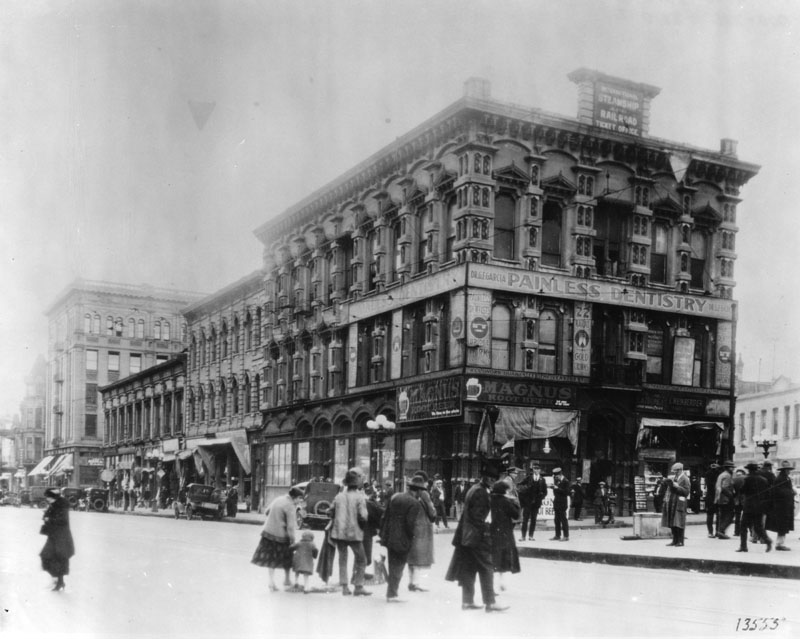 |
|
| (ca. 1926)* - Temple Block as it appeared just one year before construction of today's City Hall. |
Historical Notes This site, at the intersection of Spring, Main and Temple, is where John Temple built his original two-story adbobe two-story adobe in the early 1800s. Jonathan Temple was one of Los Angeles’ first developers, constructing the original Temple Block and the Market House, which later served as city and county administrative headquarters, contained the county courthouse, and featured the first true theater in southern California. Temple Street carries his name.^* The Old Courthouse occupied Temple Block between 1861 and 1891.* |
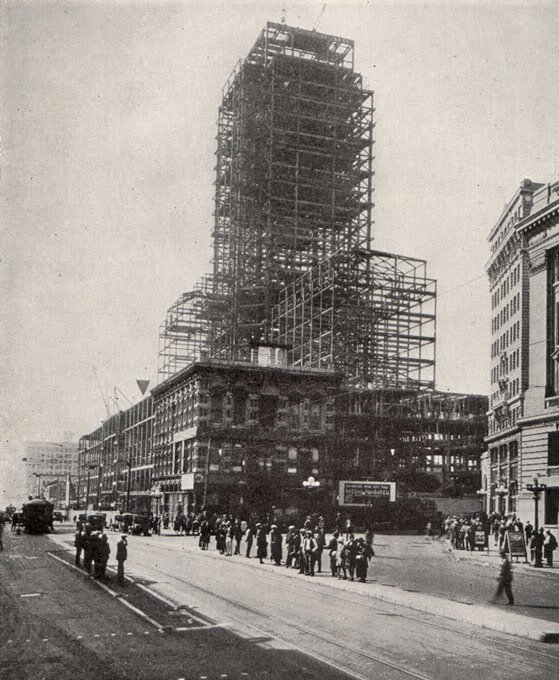 |
||
| (1927)^*^* - The last stand of the historic Temple Block. As the steel frame of the new City Hall neared completion the proud building, once dominant in the business and professional life of the city, was razed. |
Click HERE to see more of Construction of Today's City Hall |
* * * * * |
LA Evening Express and Everning Herald Building (later LA Herald-Express Building)
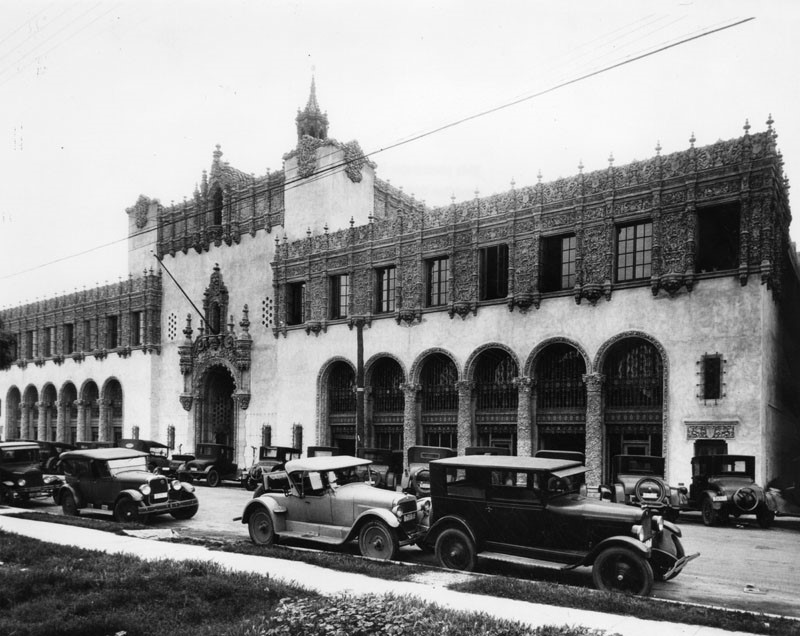 |
|
| (1926)* – View showing the Los Angeles Evening Express and Evening Herald Building, later the Los Angeles Herald-Express Building, located at 1243 Trenton Street. Photo dated July 21, 1926. Another source indicates the building was located on Georgia St, in downtown Los Angeles, between 12th and Pico (behind where the Staples Center is now).* |
Historical Notes The Mediterranean/Churrigueresque structure was designed by Morgan, Walls & Clements and built in 1925. When the Los Angeles Evening Herald and Express merged, it became the Herald-Express Building. |
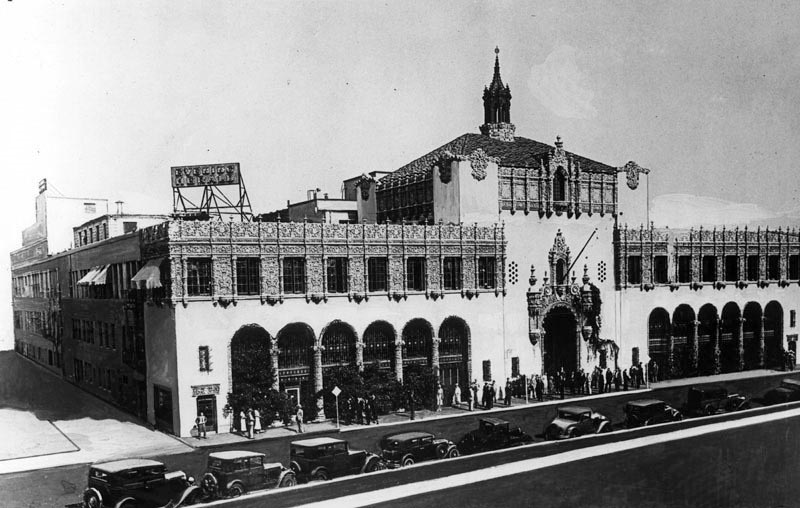 |
|
| (1926)*- Looking across the street towards the Los Angeles Evening Express and Evening Herald Building showing dozens of people by the front entrance. |
Historical Notes Established in 1873, the Los Angeles Herald represented the largely Democratic views of the city and focused primarily on issues local to Los Angeles and Southern California. Appealing to a mostly working-class audience during its 116 years of publication, the Herald evolved from a primary focus on agriculture to reporting extensively on Hollywood gossip and local scandal, reflecting the transformation of Los Angeles itself during the twentieth century. ^* |
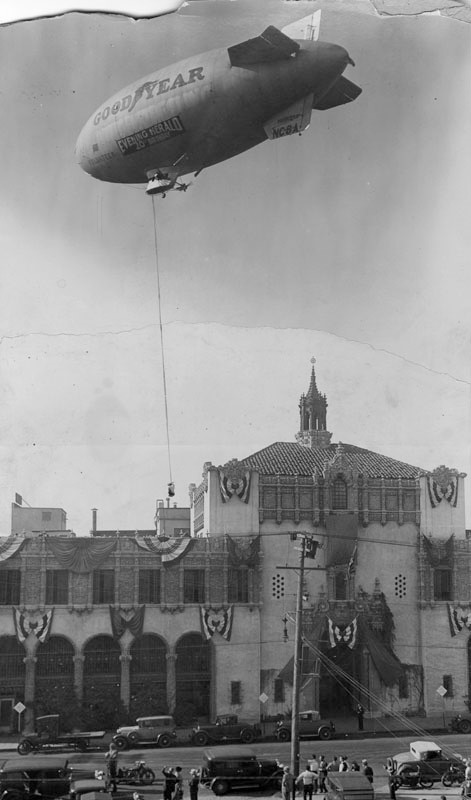 |
|
| (1931)* - Photograph caption dated November 5, 1931 reads, "Photo shows the Goodyear blimp 'Volunteer' soaring over The Evening Herald building today and picking up a bundle of Twentieth Birthday editions for delivery to civic officials at the city hall. The blimp dropped a rope weighed with a sandbag to the roof of the Evening Herald building. While the ship slowly passed over, two men running across the roof unhooked the sandbag and hooked on a bag containing the papers. The blimp then hauled the bag aboard, roared away and on reaching the city hall let the bag down on the end of the rope." |
Historical Notes In 1922, the Herald officially joined the Hearst News empire, although several sources suggest that Hearst had secretly purchased the paper in 1911. In 1931, Hearst merged the Los Angeles Daily Herald with the Los Angeles Evening Express to form the Los Angeles Evening Herald and Express, which was then the largest circulating evening newspaper west of the Mississippi. |
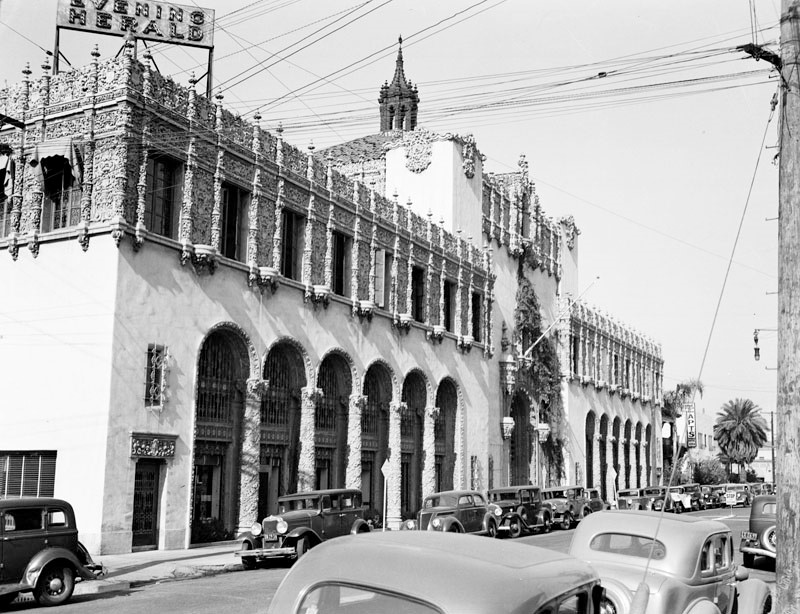 |
|
| (1937)* - View showing the Mediterranean style (with Churrigueresque detailing) Herald-Express Building. |
Historical Notes The Los Angeles Herald-Express was one of Los Angeles' oldest newspapers, formed after a combination of the Los Angeles Herald and the Los Angeles Express. After a 1962 combination with Hearst Corporation's Los Angeles Examiner, the paper became the Los Angeles Herald-Examiner. All operations were moved to the 1914-built Examiner Building located at 1111 S. Broadway. The Herald-Express Building used to stand on Georgia St, in downtown Los Angeles, between 12th and Pico (behind where the Staples Center is now). It was demolished in the mid-to-late 1960s. |
* * * * * |
Hotel Figueroa
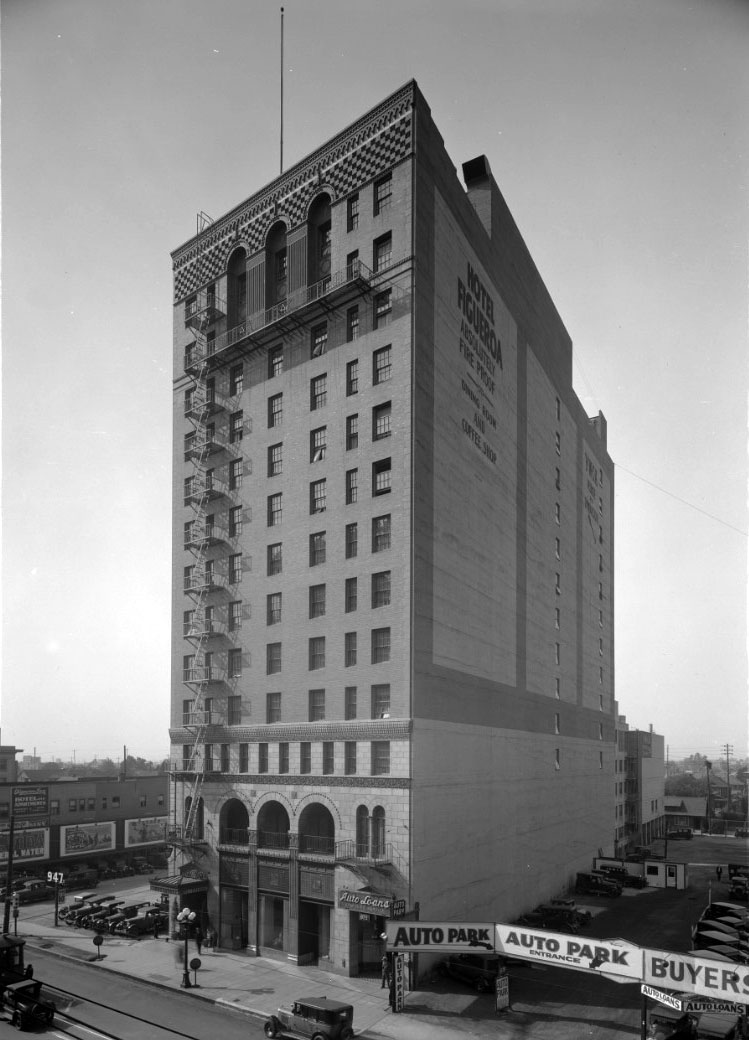 |
|
| (1925)^*# – View showing the newly constructed Figueroa Hotel located at 941 So. Figueroa St. |
Historical Notes Built in 1925, Hotel Figueroa was the first hotel to be completely financed, owned and operated by women in the United States. The YWCA (Young Women’s Christian Association) hired architecture firm Stanton, Reed & Hibbard to design and build the hotel. The Spanish Colonial style of the hotel pays tribute to the city’s Spanish and Mexican heritage. Defining features include the elaborate coffered ceiling, sculpture columns, wrought iron finishes, and ornate floor tiles.^ The Friday Morning Club was built directly across the street from the Hotel Figueroa in 1924. It was also financed and run by women. The two are a microcosm of the increasingly important and complex roles women were playing in American society in the 1920s. |
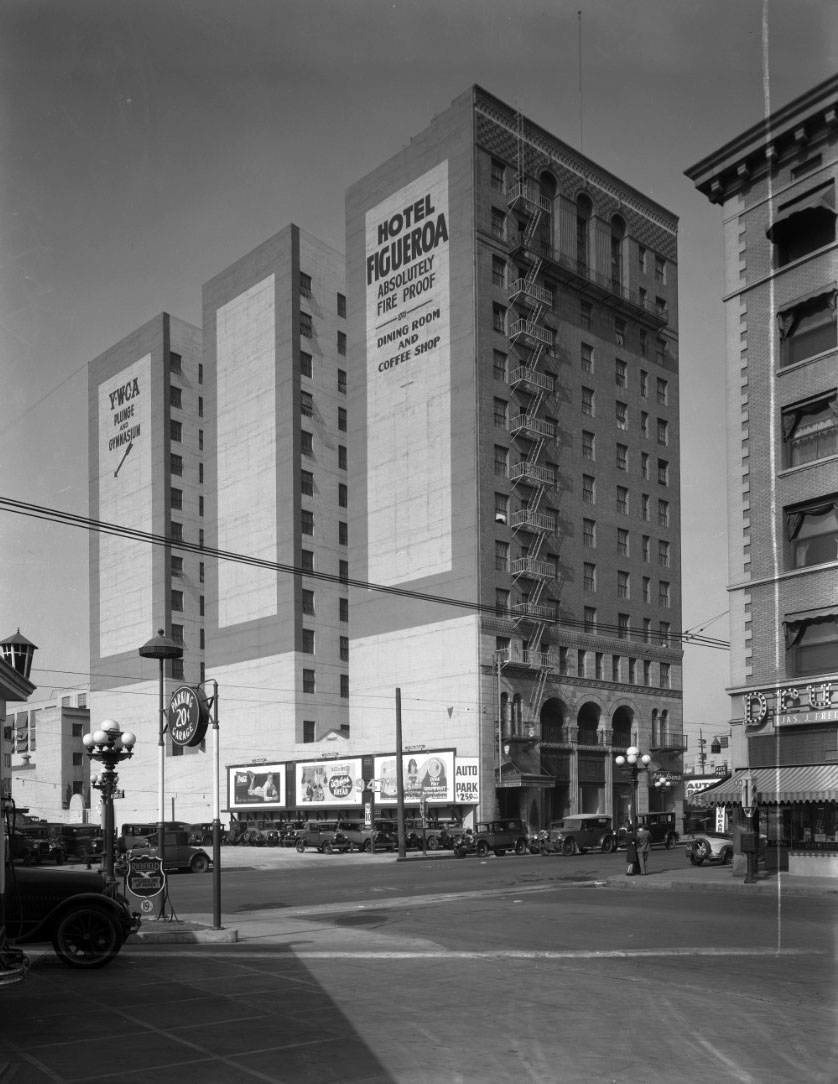 |
|
| (1925)^*# – View showing the Hotel Figueroa as seen from a gas station on the SE corner of Figueroa St. and 10th Street (later *Olympic Blvd). Signs on the side of the building read: ‘Hotel Figueroa - Absolutely Fire Proof’ and ‘YWCA – Plunge and Gymnasium’. Note the ornate 5-lamp streetlights. Click HERE for contemporary view. |
Historical Notes *Olympic Boulevard was originally named 10th Street. In 1932, the entire length of the street, from East L.A. to Santa Monica, was renamed Olympic Boulevard for the Summer Olympics being held in Los Angeles that year. |
.jpg) |
|
| (1931)^.^ – View looking north on Figueroa Street showing several women standing in front of Hotel Figueroa. Note the 5-globe streetlight in front of the hotel. Click HERE to see more. |
Historical Notes Originally the hotel only hosted travelling business women and their children. However, as effects of the Great Depression were becoming more severe, Hotel Figueroa started to accommodate men.^ |
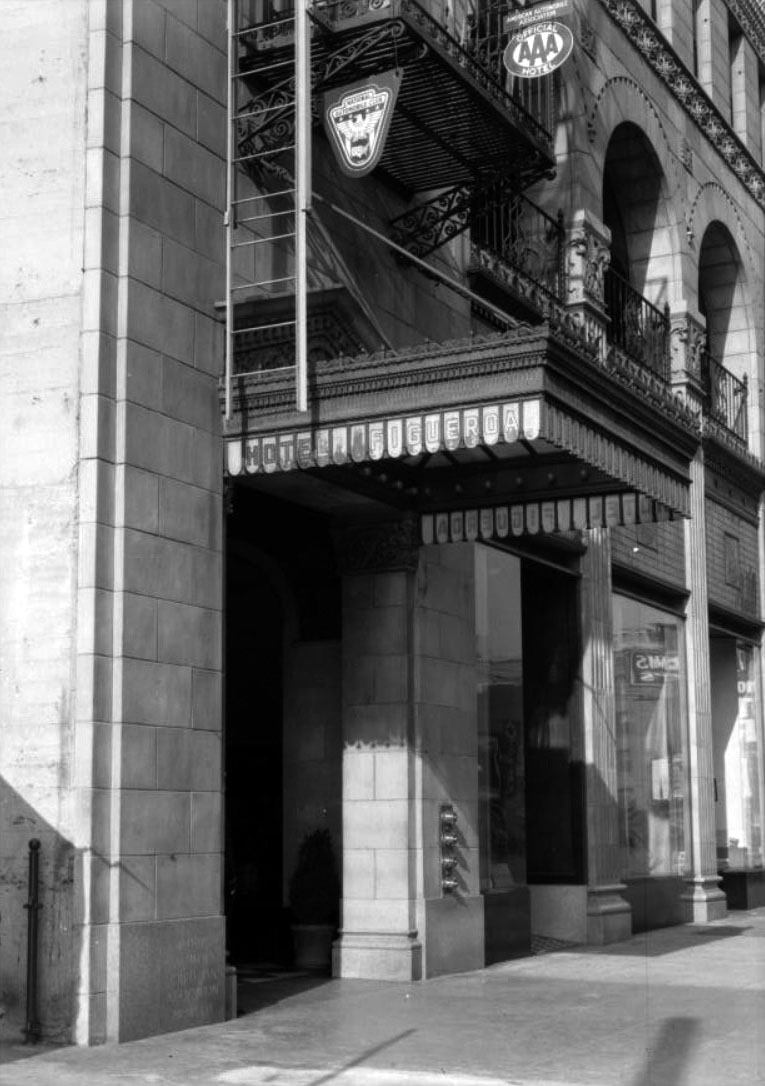 |
(1931)^ – Close-up view showing entrance to the Hotel Figueroa. A sign above the canopy reads: 'Official AAA Hotel'. | |
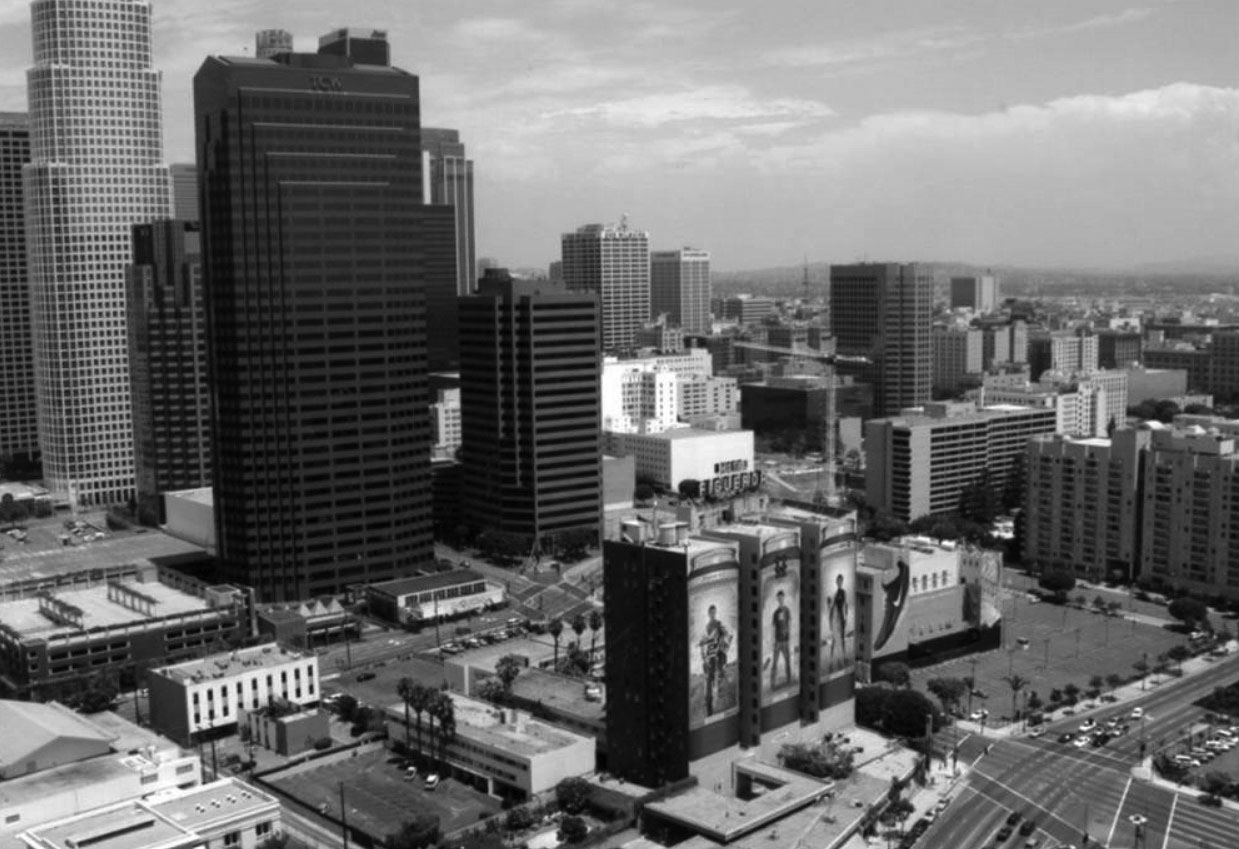 |
|
| (2005)* - Panoramic view of Downtown Los Angeles looking northeast with the Hotel Figueroa in the foreground, NW corner of Figueroa and Olympic. Murals, showing three male athletes and a Nike brand shoe announcing the ESPN X Games, can be seen painted on the south face of the hotel. |
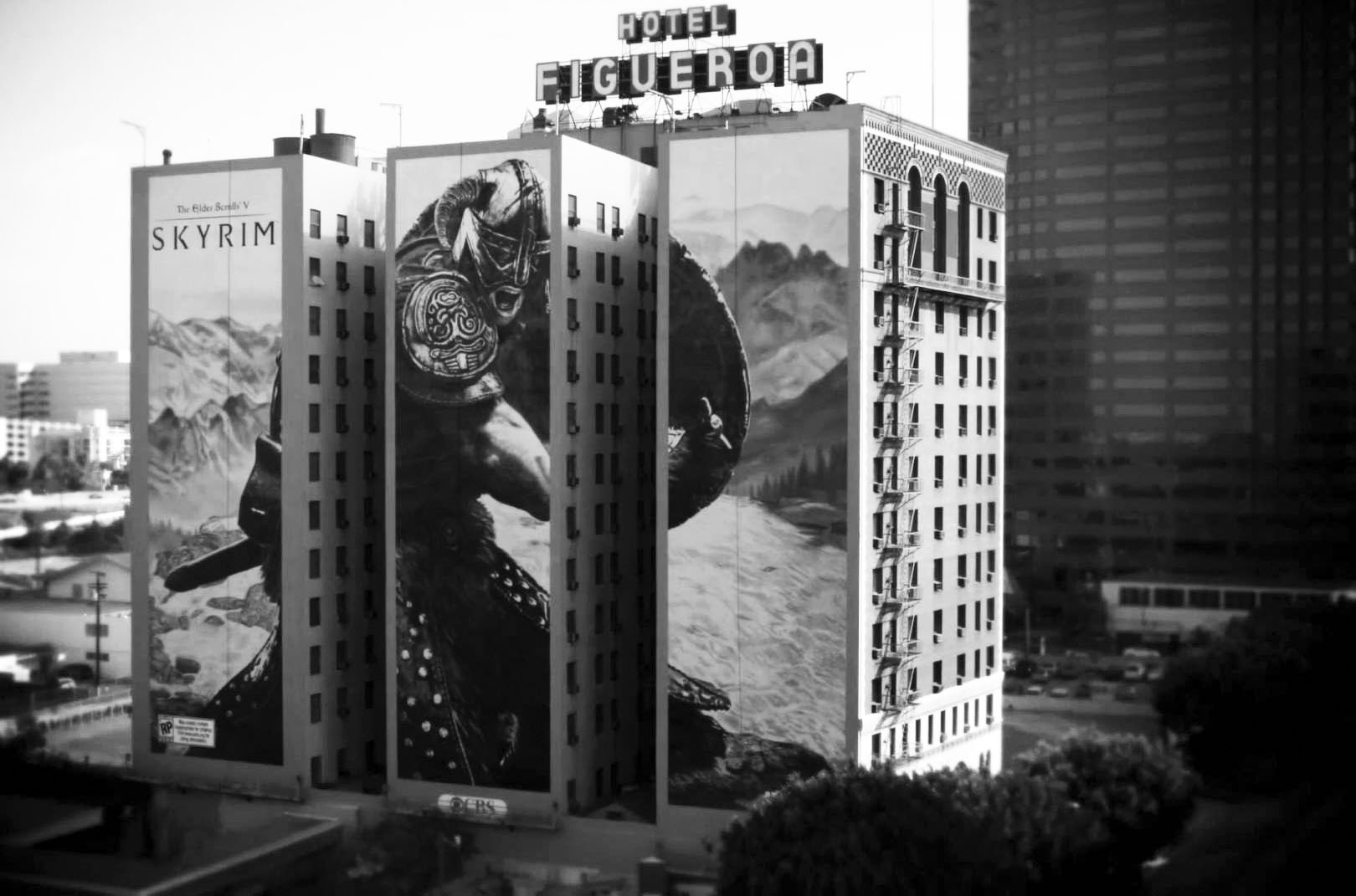 |
|
| (2010)^.^ – View of 12-story, triple towers Hotel Figueroa and its south face wall murals. |
Historical Notes Hotel Figueroa Historical Timeline: ◆ August 14, 1926 opened as Hotel Figueroa, for women only ◆ February 1928, Hotel Figueroa opened floors for men ◆ October 1930, Hotel Figueroa opened to all sexes ◆ 1931-1958 Hotel Figueroa is a hub of creative community, political organizations and social clubs in DTLA ◆ 1959-1976 Hotel Figueroa (and DTLA) operates as a semi-permanent residential hotel as the once dynamic downtown neighborhood experiences westward migration of offices and residents ◆ February 1976, Uno Thimansson takes over Hotel Figueroa as General Manager, begins transforming it into a “Moroccan retreat.” ◆ July 2014 Hotel Figueroa is purchased by Green Oak Real Estate and Urban Lifestyle Hotels, begins 3 year restoration to original Spanish Colonial Revival style ◆ February 2018: Reopens to the public^ |
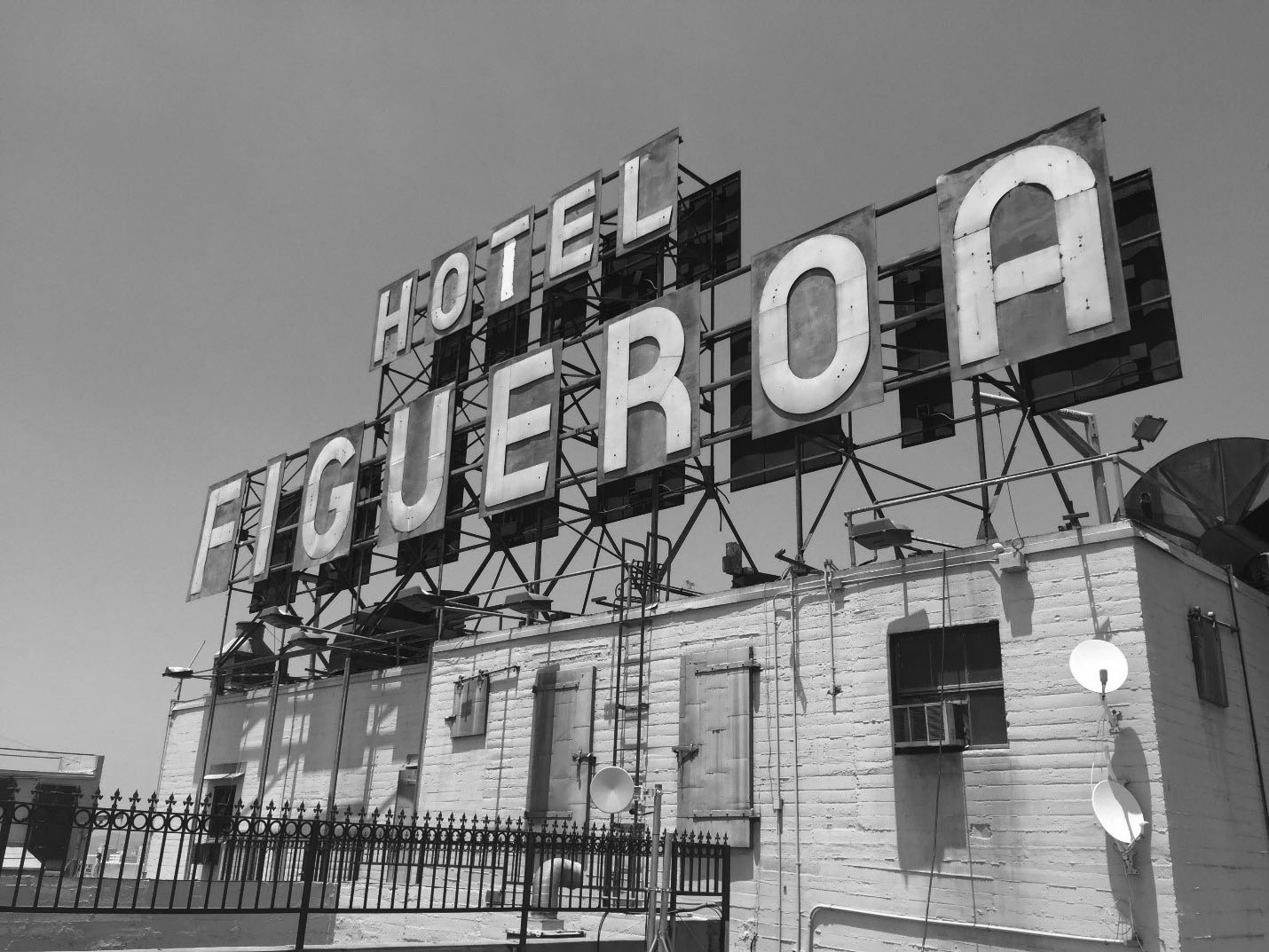 |
|
| (2010s)^.^ - Close-up view of the Hotel Figueroa's roof-mounted sign. |
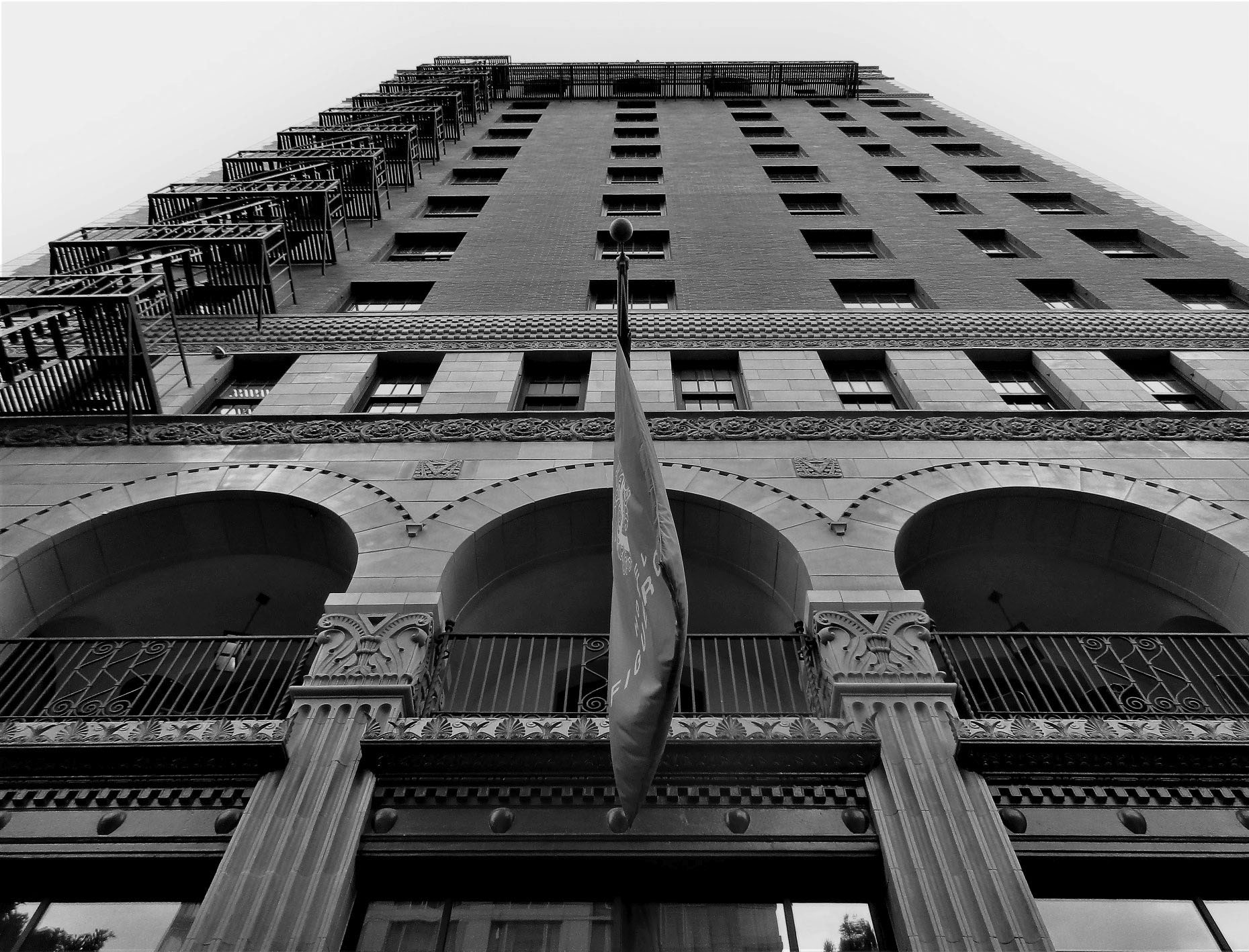 |
|
| (2019)^.^ - Looking up to the top of the Figueroa Hotel from the sidewalk in front. Photo by Howard Gray |
* * * * * |
Patriotic Hall
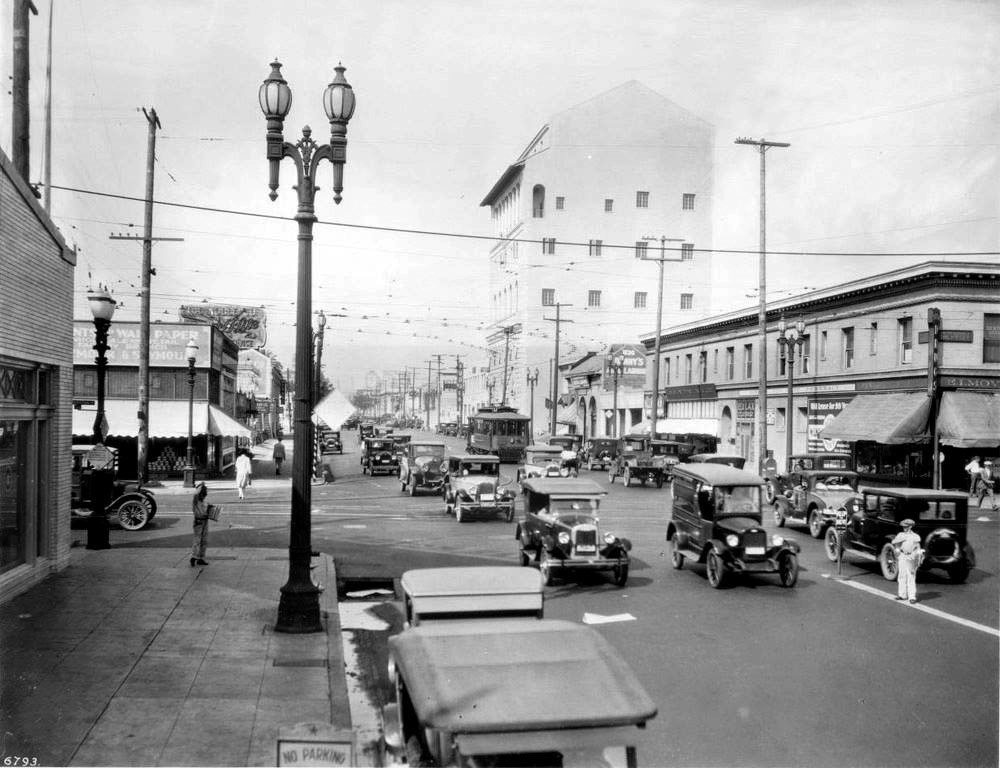 |
|
| (ca. 1927)^ - View looking north on Figueroa from just south of Washington Boulevard. A paperboy dressed in light-colored clothing stands at the center of the street to the right hawking papers while cars pass him on either side. The large building in the background is the Patriotic Hall. |
Historical Notes The Allied Architects Association of Los Angeles designed Patriotic Hall in the Italian Renaissance Revival style. When completed in 1926, the building was the tallest in all of Los Angeles, at the equivalent of twelve stories. ^ |
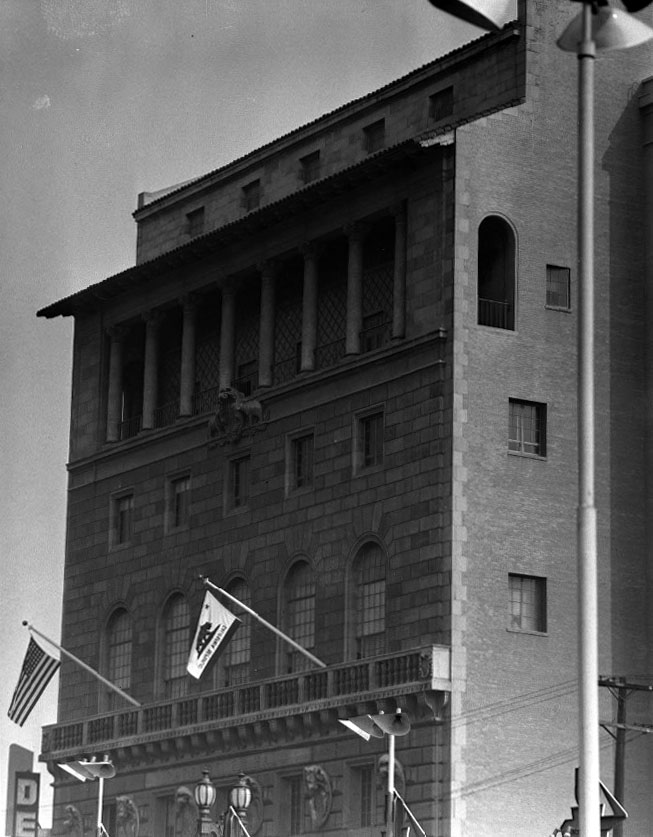 |
|
| (ca. 1940s)^ – View showing Patriotic Hall, headquarters and meeting place of various service organizations. LA Times / UCLA Image Archive |
Historical Notes Patriotic Hall housed service members on leave during World War II. It also hosted top performers who entertained the troops, including Bob Hope, Bing Crosby, and Dorothy Lamour. |
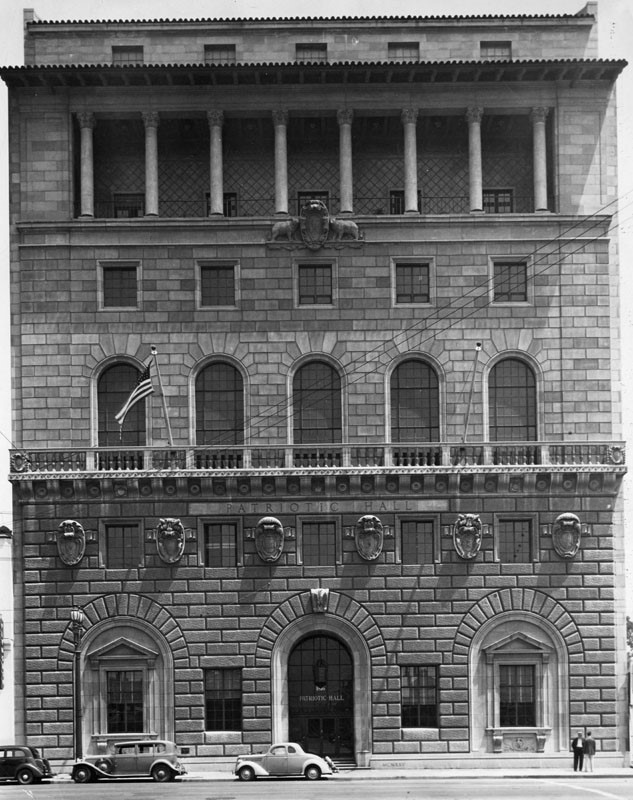 |
|
| (1937)* – View showing the front entrance to Patriotic Hall located at 1816 S. Figueroa Street. |
Historical Notes The building also housed the City’s municipal courts in the 1940s, as new ones were being constructed. During the Korean War, it served as a processing center for the Army and Air Force. ^ |
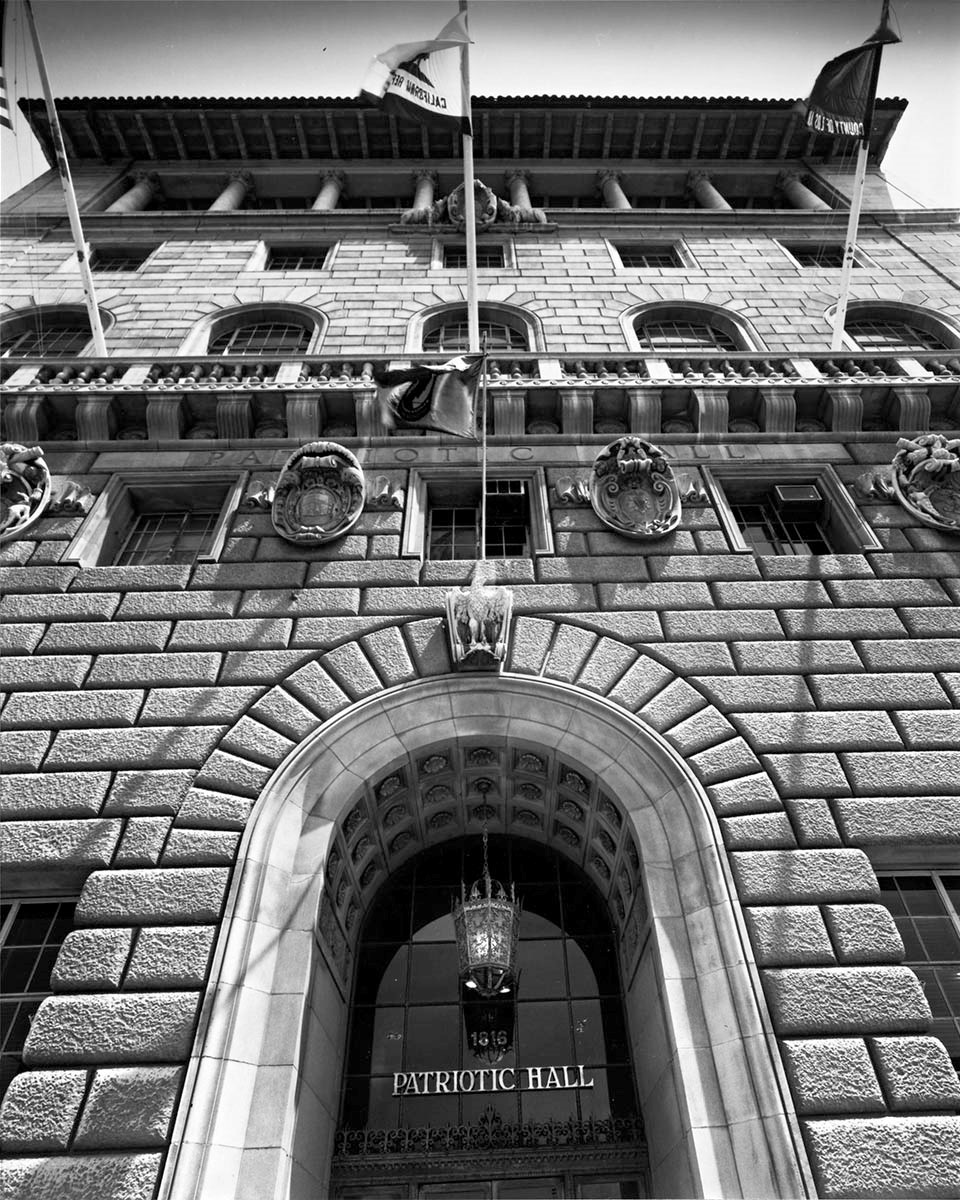 |
|
| (1985)*++ - View looking up towards the top of Patriotic Hall. Photo by Julius Shulman |
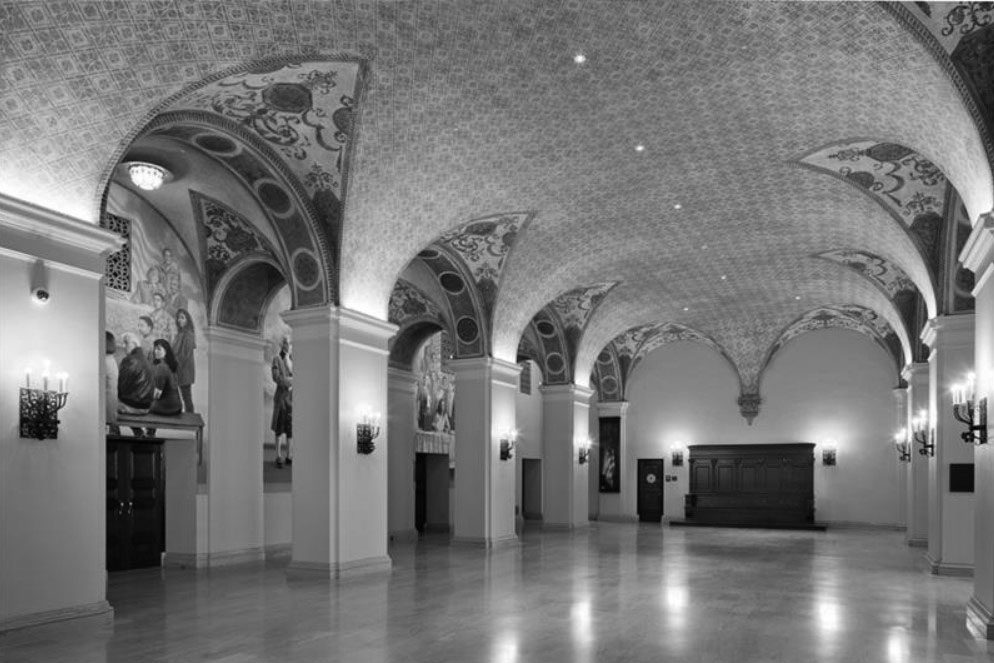 |
|
| (ca. 2012)^+^ – View showing the Bob Hope Patriotic Hall grand lobby after renovation. |
Historical Notes On November 12, 2004, the building was renamed “Bob Hope Patriotic Hall” in honor of Bob Hope an honorary veteran of the U.S. Armed Forces. Over the years, Bob Hope Patriotic Hall fell into disrepair. Its infrastructure and systems were sorely out of date, and it suffered from deferred maintenance. In 2006, the County of Los Angeles fundraised for the rehabilitation of the facility, a project with a budget of over $75 million. The project entailed a large-scale, comprehensive interior and exterior rehabilitation. Internally, the project team restored wood doors and hardware, marble finishes, ceramic tile, decorative plaster and painting, murals, and auditorium and gymnasium seats. Externally, the team restored and repaired all historic features, including cast stone, granite, brick masonry, terrazzo, steel windows and hardware, metal skylights, wrought iron doors, metal fire escapes and railings, decorative metal louvers and grilles, copper cornice and gutters, clay tile roof, plaster, decorative painting and stenciling, stained glass, and light fixtures. ^ |
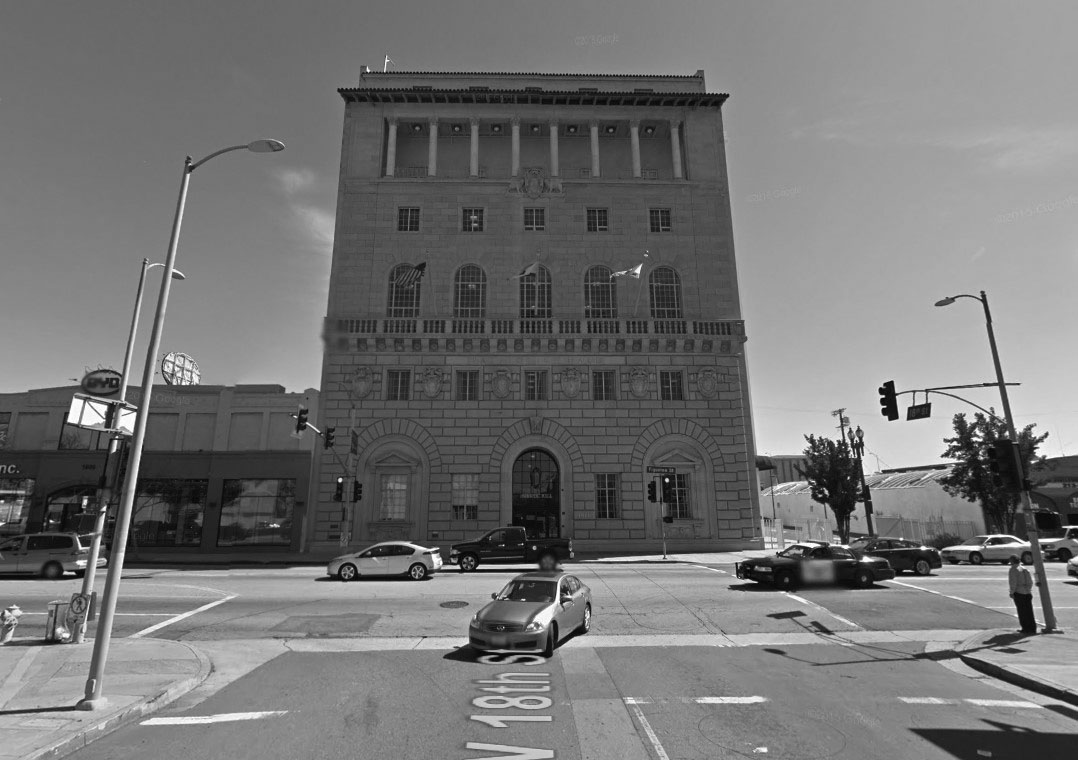 |
|
| (2015)#^** – Google street view showing the Patriotic Hall located where 18th Street meets Figueroa Street.. |
Historical Notes The building’s restoration project preserved one of Los Angeles’ most prominent, highly visible historical facilities, earning a Conservancy Preservation Award in 2014. Bob Hope patriotic Hall now enjoys new life as a multipurpose facility, with ample meeting and conference space for veterans and others in the community to meet and recreate.^ |
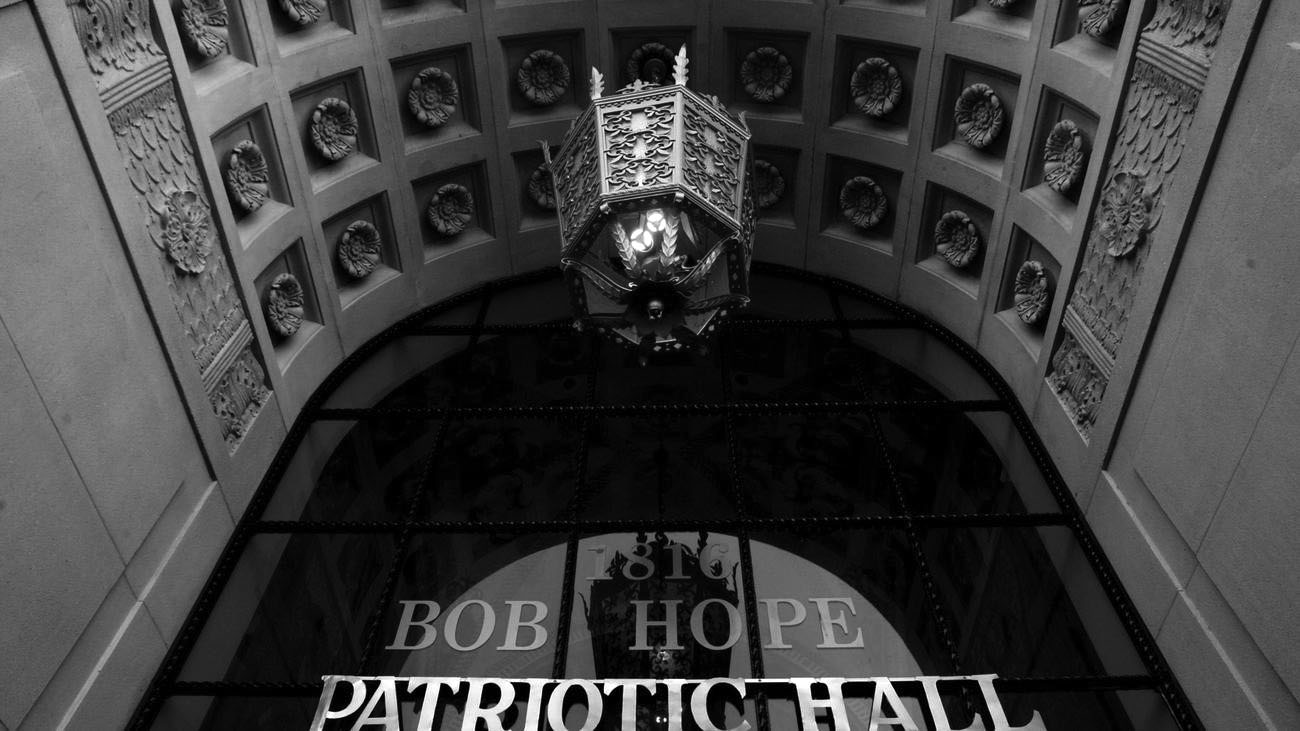 |
|
| (2013)*# - Close-up detailed view showing the ceiling of Bob Hope Patriotic Hall's arched entrance. |
* * * * * |
Barker Brothers
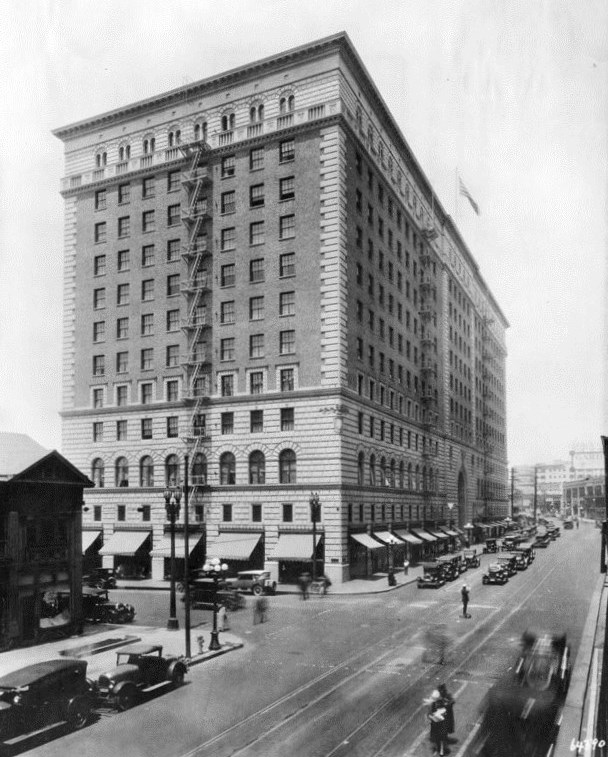 |
|
| (1926)* - Barker Brothers furniture store building, located at 818 W. 7th St. Cars are moving along Seventh St. and Pacific Electric streetcar tracks are visible in the foreground. A policeman is seen standing on a box in the middle of the intersection directing traffic. |
Historical Notes The 1925 building, designed in the Renaissance Revival style by Curlett and Beelman, was said to have been inspired by the Strozzi Palace in Florence. The symmetrically developed twelve-story structure is faced in terra cotta and brick, with a monumental three-story round arched center entry. Inside there is a forty-foot-high lobby court with beamed and vaulted ceilings.* |
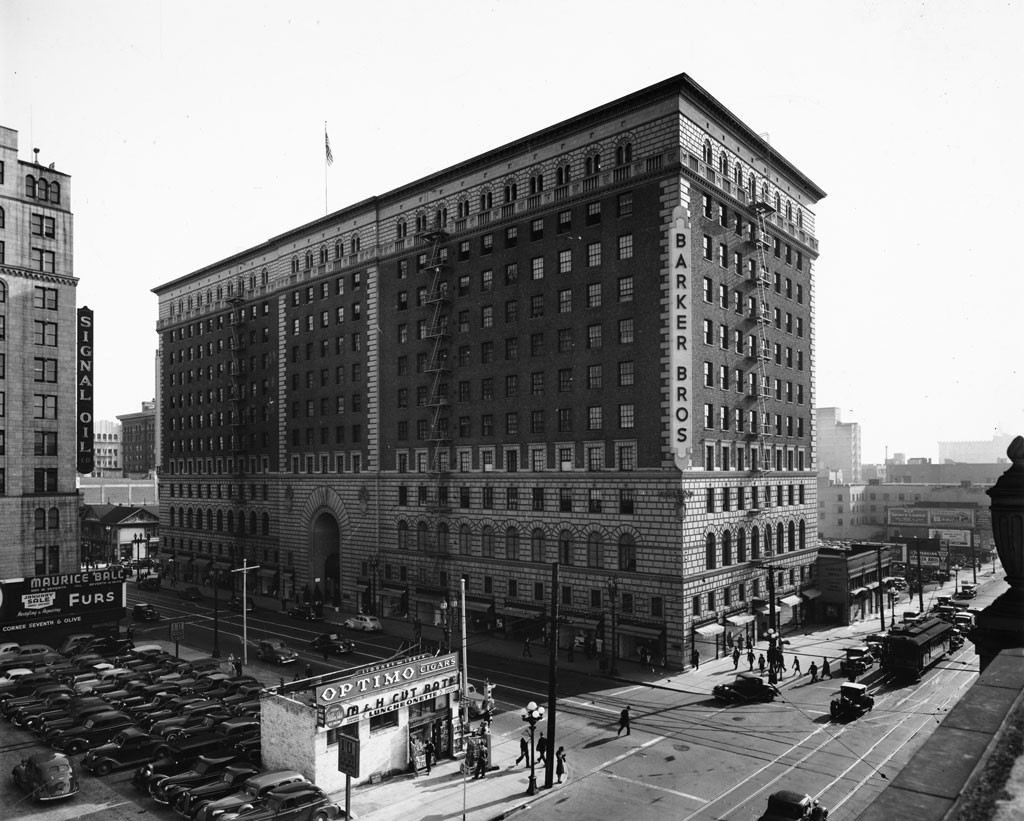 |
|
| (1930s)^ - View of the Barker Brothers building on the southeast corner of 7th & Figueroa. The M & H Cut Rate Luncheonette sits on the opposite corner adjacent to a parking lot. Sign on the mini-diner reads: “Optimo Cigars” |
Historical Notes Obadiah J. Barker was a Los Angeles business man and the founder and president of the furniture company, Barker Brothers. Born in Bloomfield, Indiana, Barker moved with his family to Colorado Springs, Colorado as a young man. He attended Colorado College and also attended dental school in St. Louis. However, he did not complete dental school and moved to Los Angeles with his parents and brothers in 1880. The family began a successful furniture business on Spring Street in Los Angeles. The company became one of the world's biggest house-furnishing stores.^* |
 |
|
| (1930s)* - Exterior view of the Barker Brothers furniture store building, located at 818 W. 7th St. Pedestrians can be seen walking in front of the over-sized display windows. |
Historical Notes In 1988, the Barker Brothers Building on the southeast corner of 7th Street and Figueroa was dedicated LA Historic-Cultural Monument No. 356 (Click HERE to see complete listing). |
* * * * * |
Young's Market
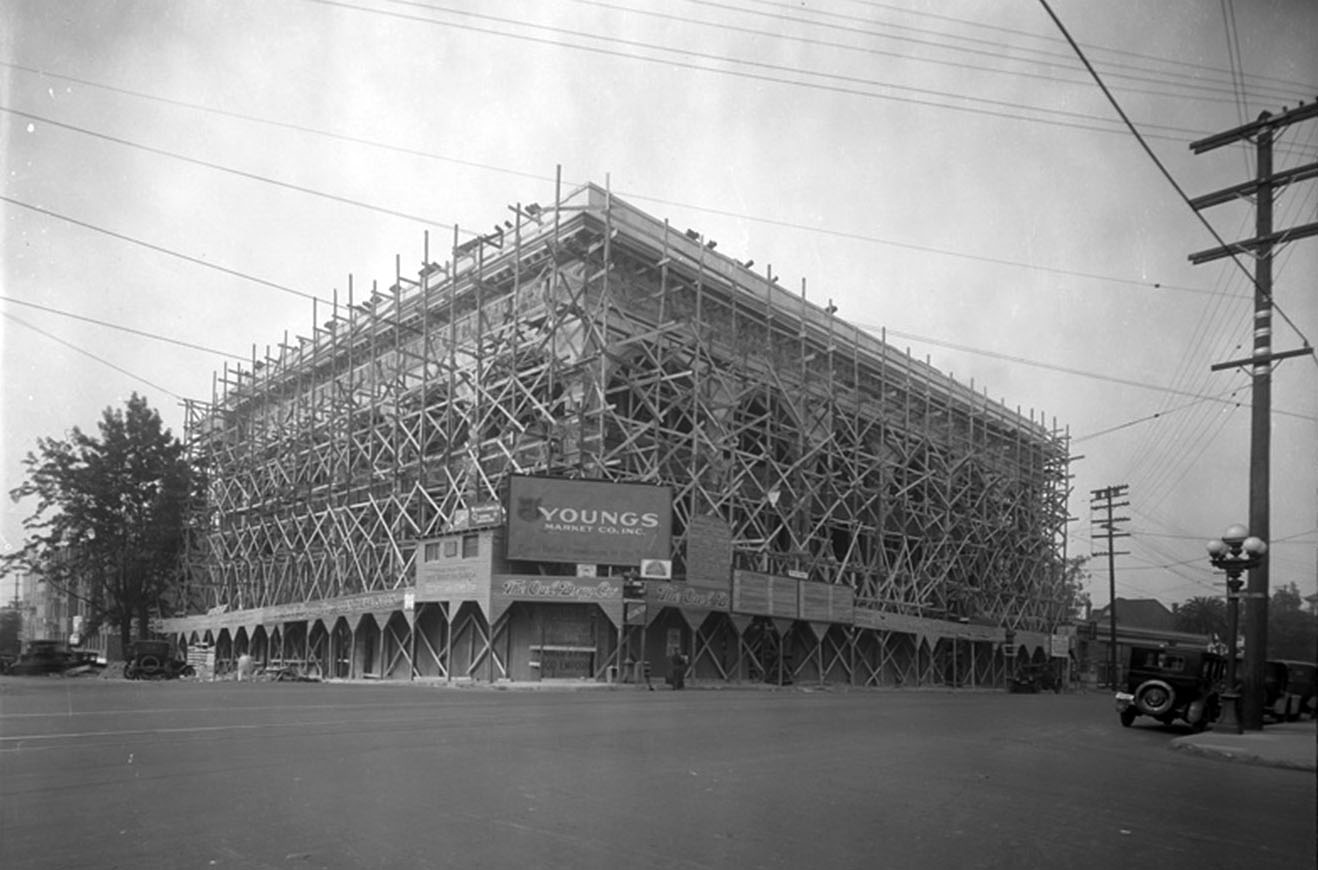 |
|
| (1924)* – View showing Young's Market Company building under construction. Location: 7th & Union, Los Angeles; A sign for Owl Drug Store can be seen on bottom floor. |
Historical Notes Built in Italian Renaissance Revival style. Architect: Charles F. Plummer; general contractors, Weymouth Crowell Co. |
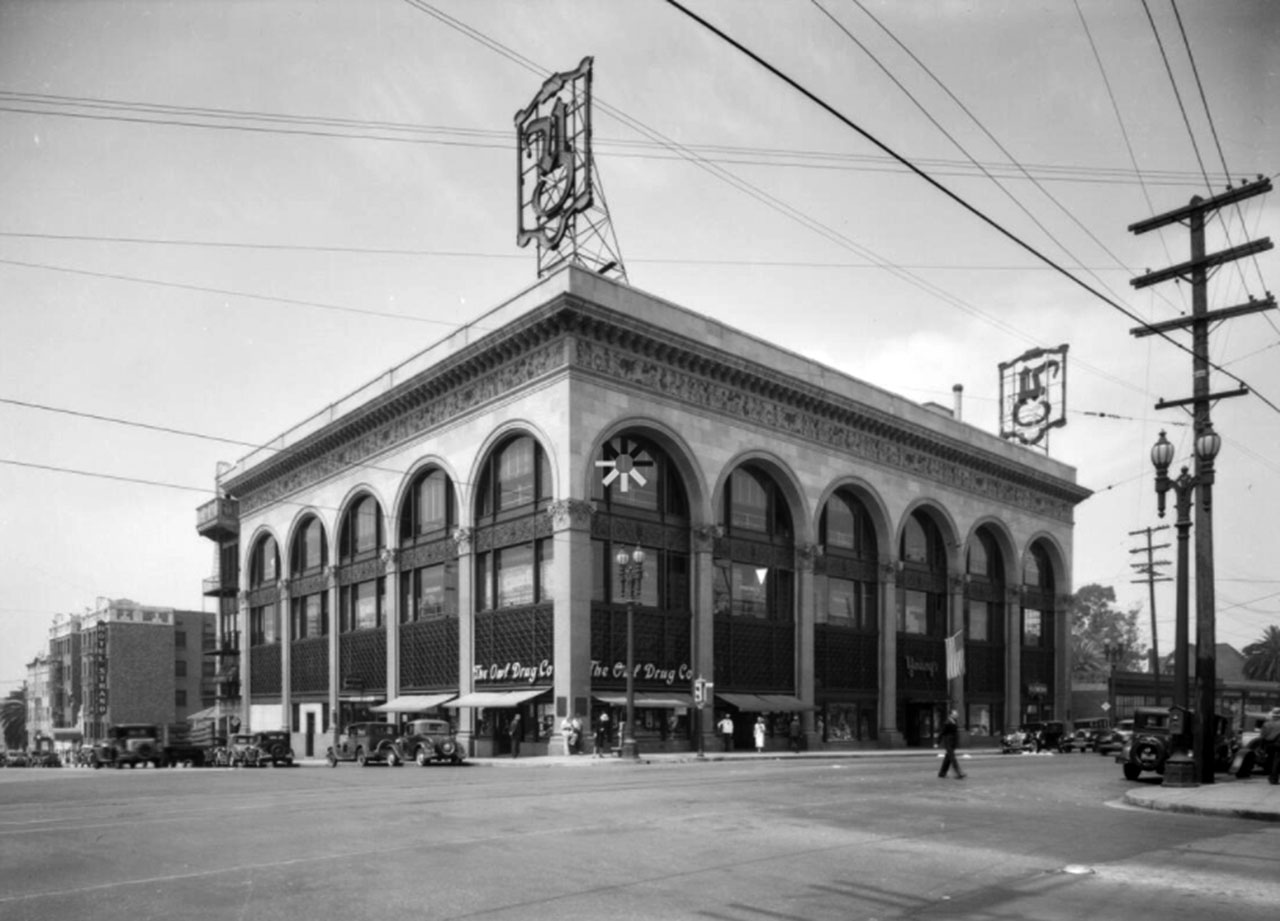 |
|
| (1932)^ – Young’s Market building located at 1610 W. Seventh St in DTLA. Note the two large signs on the roof. |
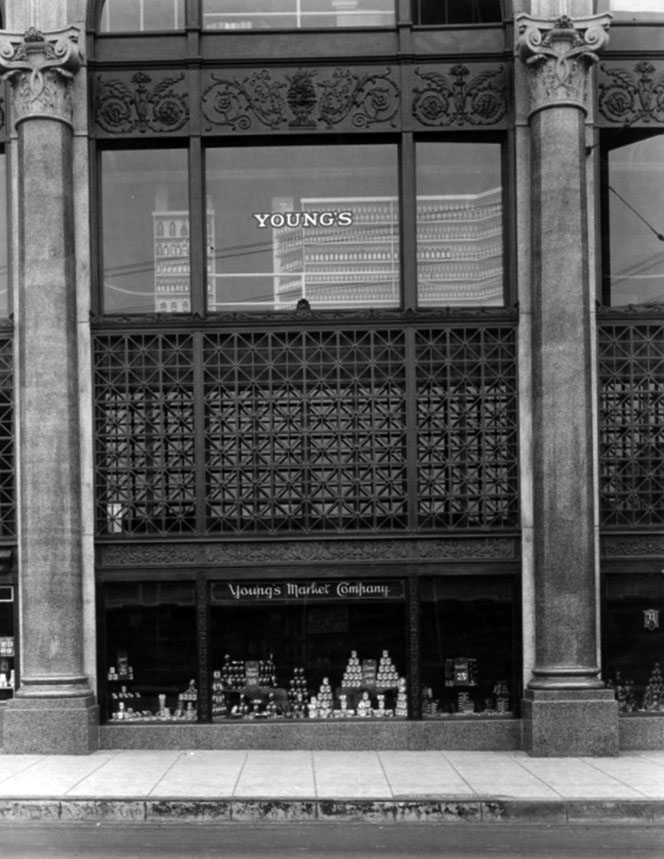 |
|
| (ca.1920s) – Close-up detail view of the Young's Market Company Building, located on the southwest corner of West Seventh Street and Union Avenue. |
Then and Now
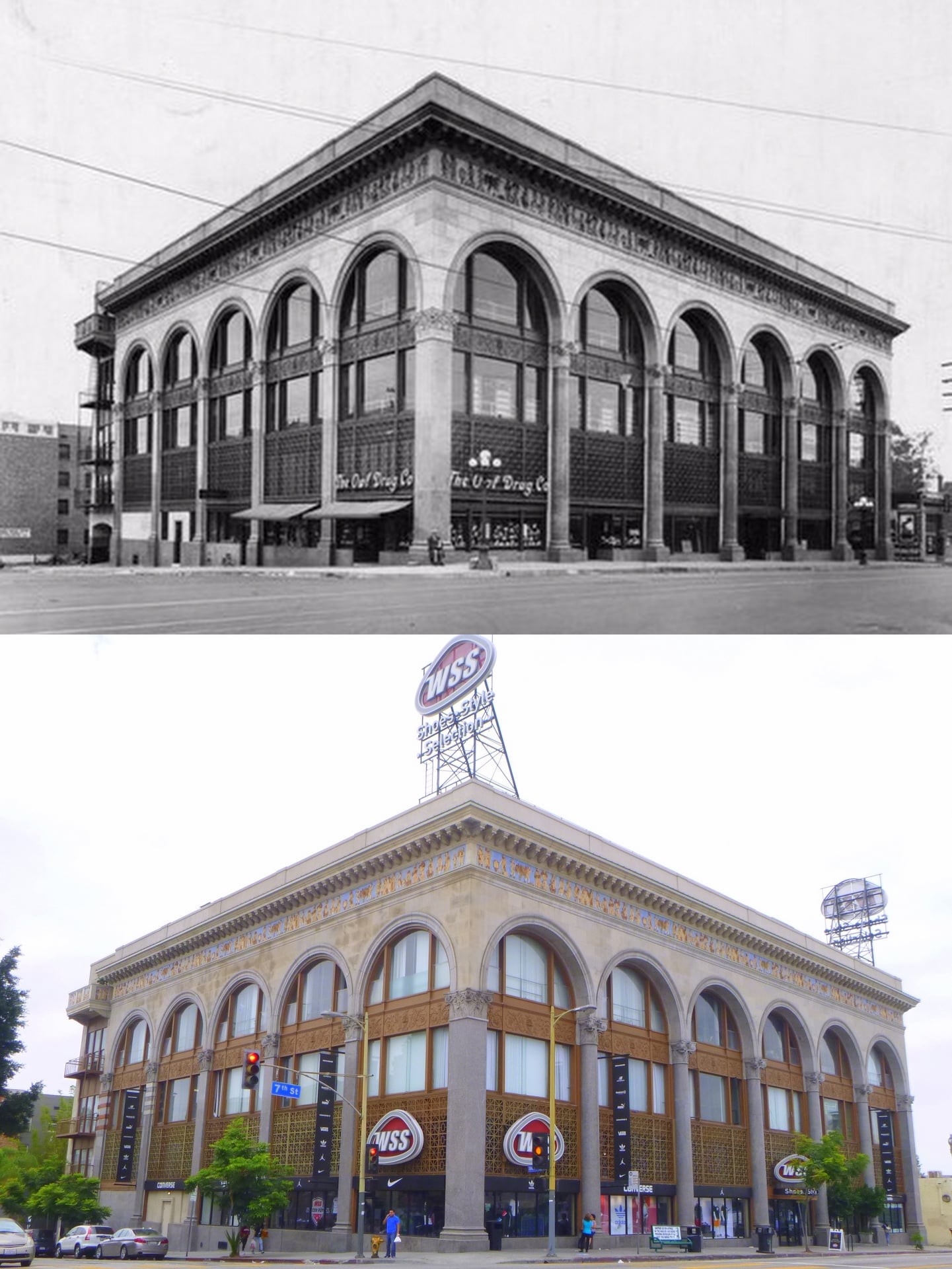 |
|
| Then and Now* |
Historical Notes The market has been repurposed as a shoe store and retains original murals and light fixtures. |
* * * * * |
Coffee Cup Cafe
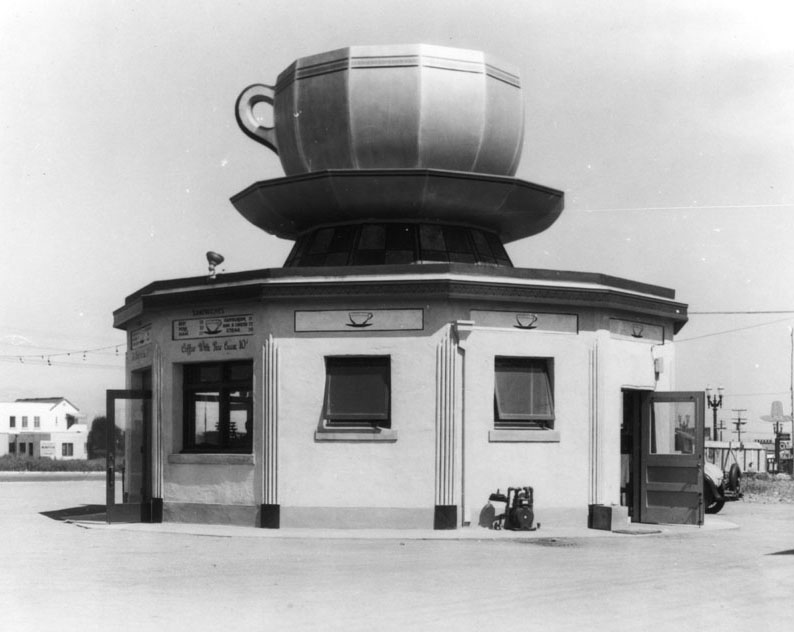 |
|
| (1920s)* - View of the Coffee Cup Cafe located at 8901 Pico Boulevard. A giant coffe cup and saucer sit on top of the cafe structure. |
Historical Notes In the 1920s and 1930s, more and more business catered to the Los Angeles automobile culture. Buildings and structures became more unique, often resembling the merchandise or services they hawked. Giant sized version of objects (Giant Hat – Brown Derby, Giant Dog - Pup Café, Giant Coffee Cup – Coffee Cup Café, etc.) began to pop up everywhere. #^#^ These “hey-you-can’t miss-me!” buildings (referred to as Novelty or Programmatic Architecture) were made to pull automobile drivers right off the road. Click HERE to see more examples of Programmatic Architecture. |
Wilshire Coffee Pot Restaurant
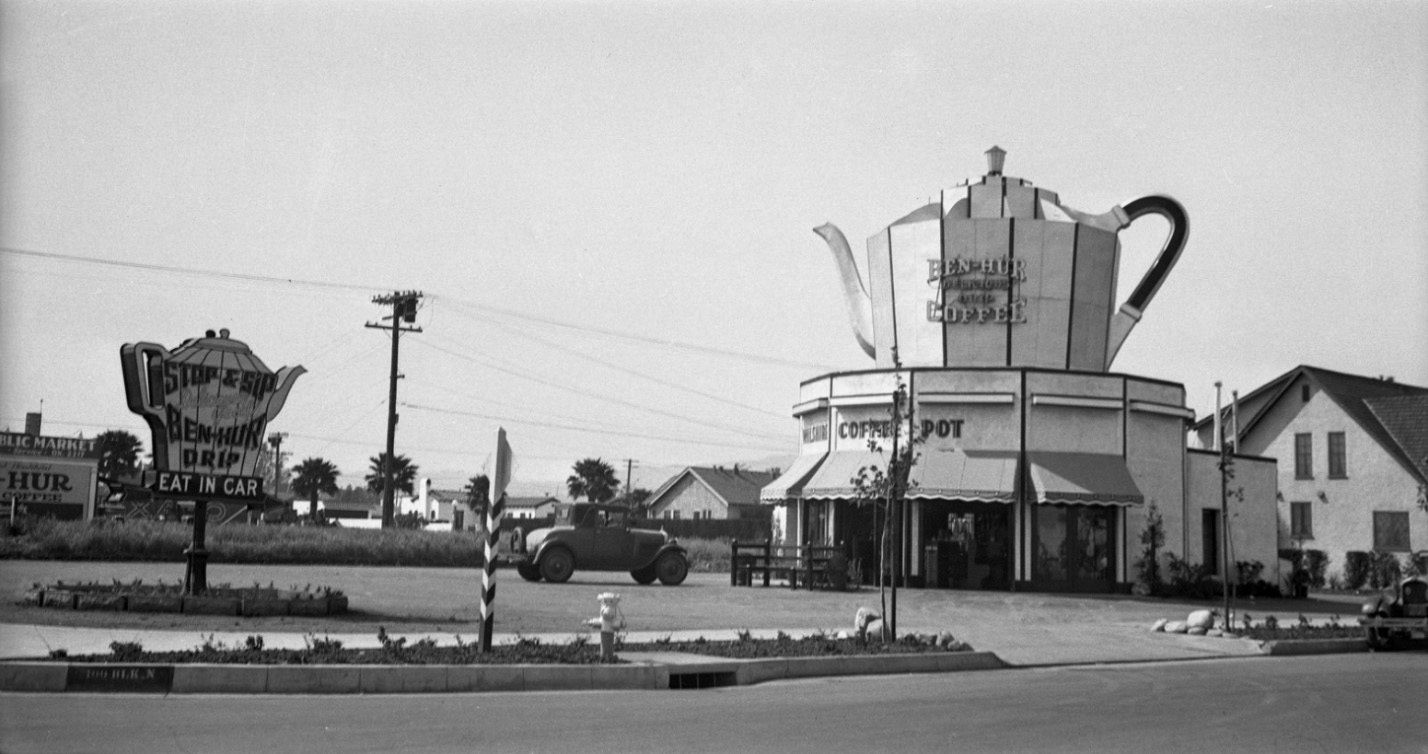 |
|
| (ca. 1925)#*#^ - View showing a car in the parking lot of the Wilshire Coffee Pot restaurant. The restaurant and coffee shop was located at 8601 Wilshire Boulevard, on the northwest corner of Stanley Drive and Wilshire Blvd. A giant coffee pot sits on top of the building. Ben-Hur Coffee is featured. |
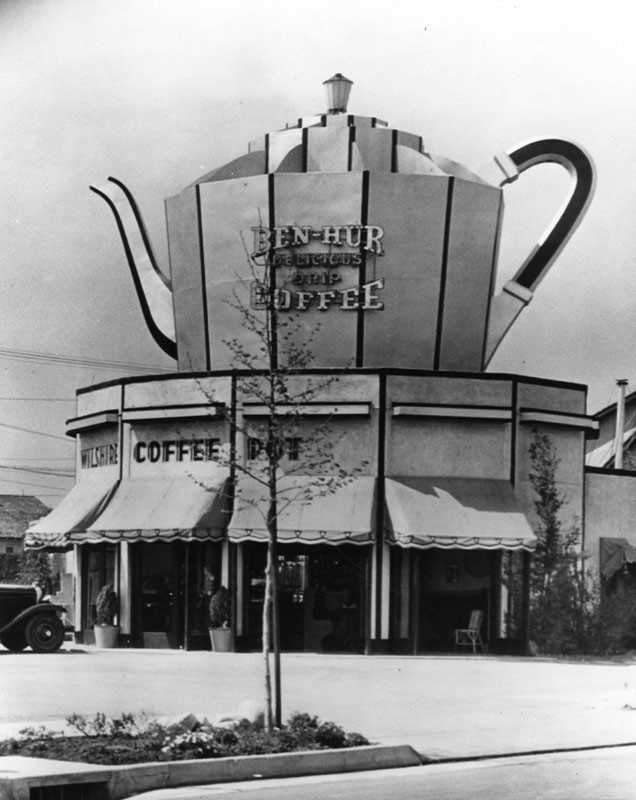 |
|
| (ca. 1930s)* - Close-up view of the Wilshire Coffee Pot restaurant, located at 8601 Wilshire Boulevard in Beverly Hills. The building has a coffee pot on the roof with advertisement for: Ben-Hur Delicious Drip Coffee. |
Click HERE to see more examples of Programmatic Architecture. |
* * * * * |
Hollyhock House
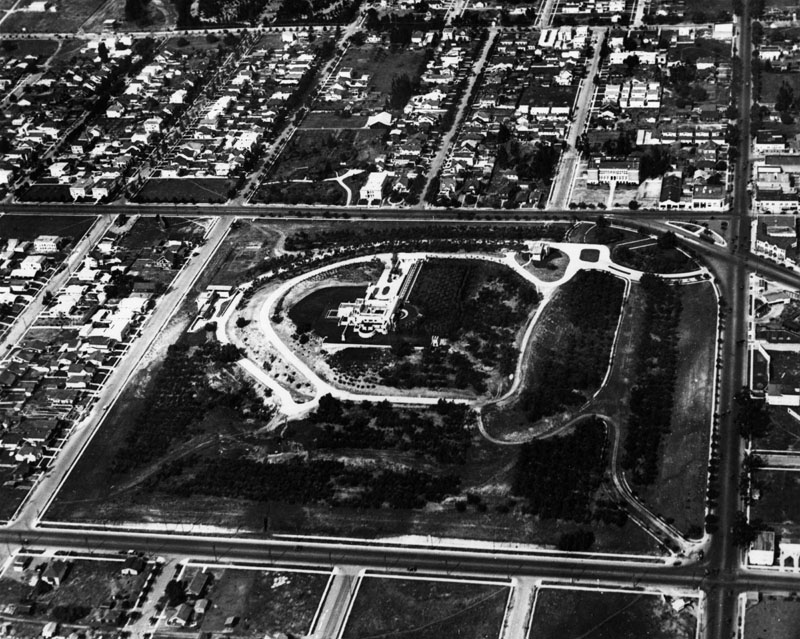 |
|
| (1920s)* – Aerial view looking north showing the Hollyhock House on top of Olive Hill. The estate is bounded by Hollywood Blvd (North), Sunset Blvd(South), Edgemont St (West), and Vermont Ave (East). |
Historical Notes Originally designed by Frank Lloyd Wright as a residence for oil heiress Aline Barnsdall, The Hollyhock House was built in 1919–1921. Barnsdall originally intended the house to be part of an arts and theater complex on a property known as Olive Hill, but the larger project was never completed.*^ |
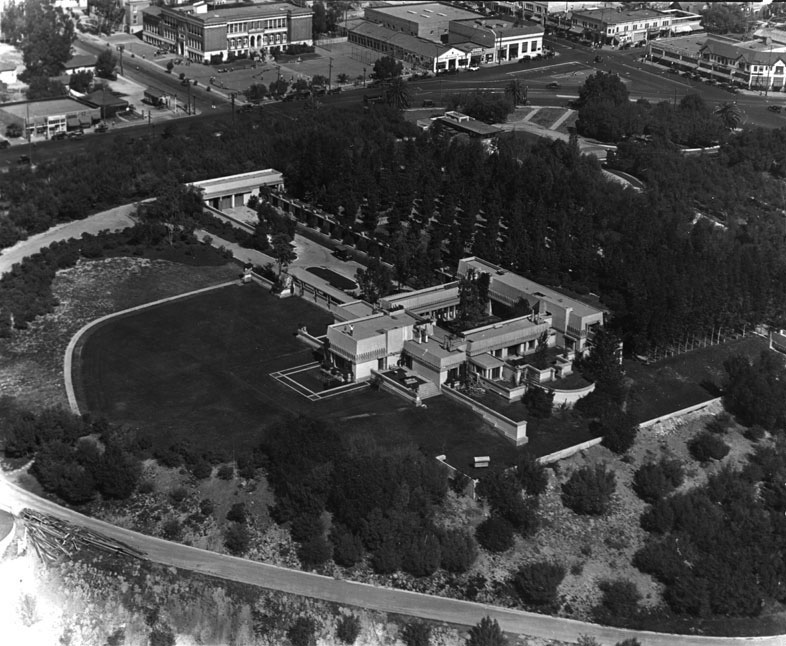 |
|
| (ca. 1927)* - Aerial view showing Barnsdall Art Park and the Frank Lloyd Wright designed Hollyhock House. At upper center-left is Los Feliz Elementary School. At upper-right corner is the intersection of Hollywood Boulevard and Vermont Ave. |
Historical Notes Disillusioned by the costs of construction and maintenance, Barnsdall donated the house to the city of Los Angeles in 1927 under the stipulation that a fifteen-year lease be given to the California Art Club for its headquarters, which it maintained until 1942. The house has been used as an art gallery and as a United Service Organizations (USO) facility over the years. Beginning in 1974, the city sponsored a series of restorations, but the structure was damaged in the 1994 Northridge earthquake. It was again restored, and was open to the public as of June 2005.*^ |
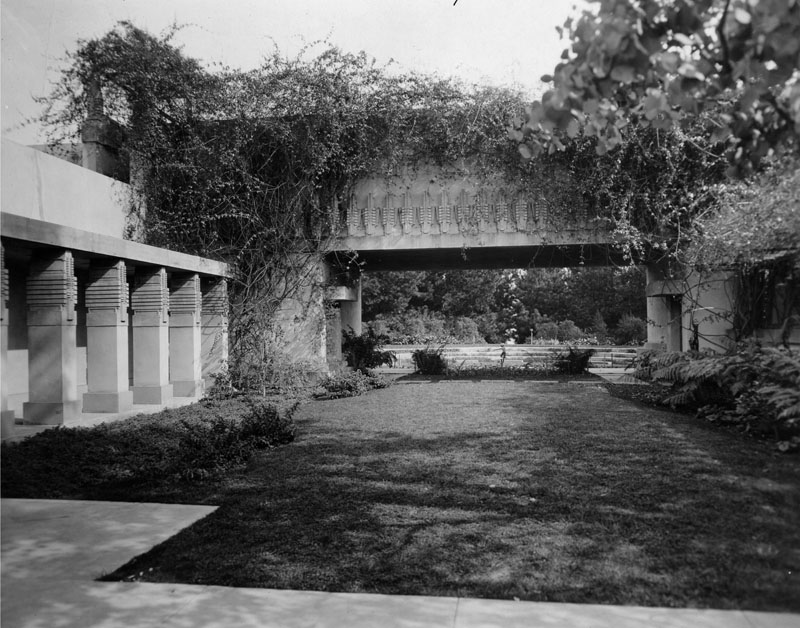 |
|
| (1939)* - View of archway and greenery, Hollyhock House located at 4808 Hollywood Boulevard in Barnsdall Park. The home was built between 1919-1921. Architect: Frank Lloyd Wright. Home has a "pre-Columbian air and stylized hollyhock ornamentation" - Gebhard & Winter, restored by Lloyd Wright (his son). |
Historical Notes Like many houses designed by Wright, it proved to be better as an aesthetic work than as a livable dwelling. Water tended to flow over the central lawn and into the living room, and the flat roof terraces were conceived without an understanding of Los Angeles' rains. The cantilevered concrete also has not stood up well to the area's earthquakes.*^ |
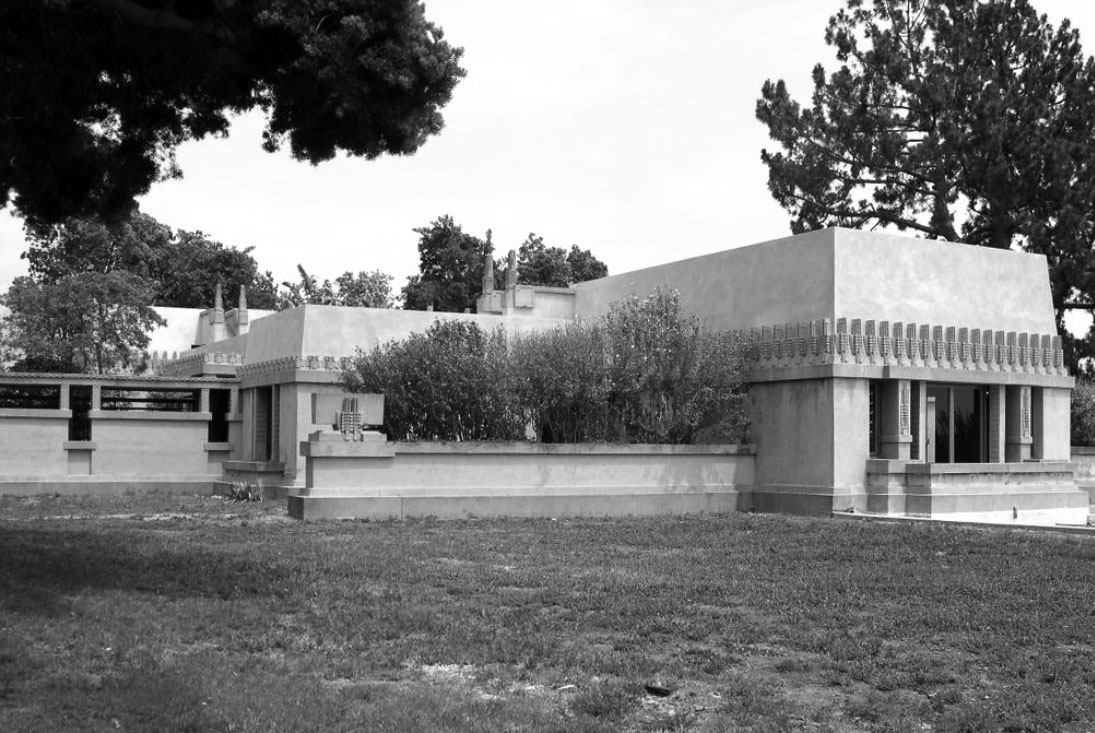 |
|
| (2005)*^ – Frank Lloyd Wright's Hollyhock House, located at 4808 Hollywood Boulevard. |
Historical Notes Originally designed by Frank Lloyd Wright as a residence for oil heiress Aline Barnsdall, The Hollyhock House is now the centerpiece of the city's Barnsdall Art Park.*^ Hollyhock House was added to the National Register of Historical Places in 1971 - Building #71000143 and designated Los Angeles Historic-Cultural Monument #12 in 1963. The 12-acre Barnsdall Park was designated Los Angeles Historic-Cultural Monument #34 in 1965 and Residence A (Barnsdall Park Arts Center) was designated Los Angeles Historic-Cultural Monument #33 in 1965. Click HERE to see complete listing of LA Historic-Cultural Monuments. |
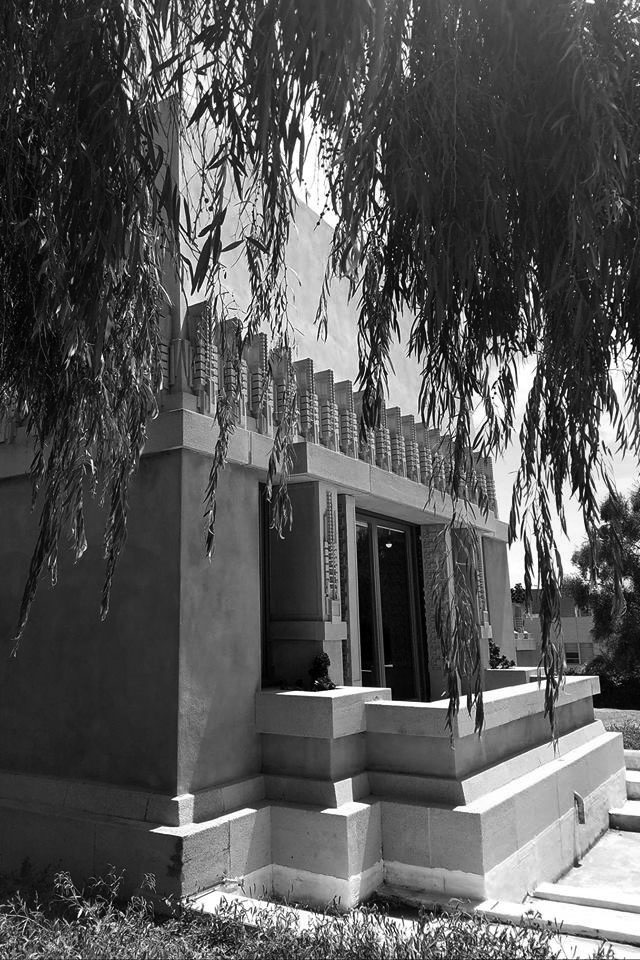 |
|
| (2018)^.^– Close-up view of Frank Lloyd Wright's Hollyhock House as it appears today. |
Historical Notes Hollyhock House is the only one of the 6 houses Frank Lloyd Wright built in LA that is open to the public. |
* * * * * |
Ennis House
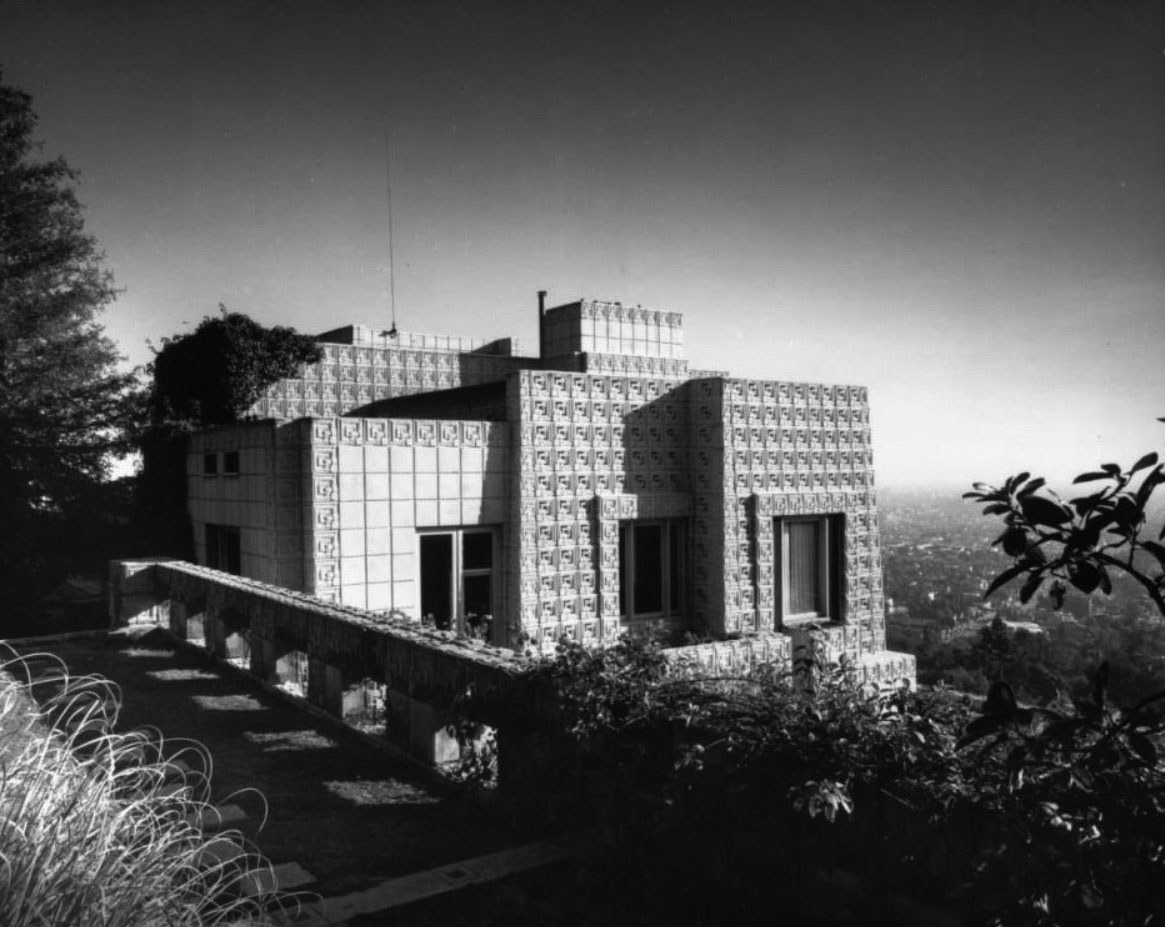 |
|
| (1924)^ - View showing the Ennis House, designed in 1923 by Frank Lloyd Wright for Charles and Mabel Ennis, and built in 1924. It is located at 2655 Glendower Avenue in the Los Feliz area of Los Angeles. |
Historical Notes The Ennis House, designed by Frank Lloyd Wright and built by his son, Lloyd, is the last and largest of the elder Wright’s four “textile block” houses in the Los Angeles area. These homes are noted for their patterned and perforated concrete blocks, which give a unique textural appearance to both the exterior and interior.* |
.jpg) |
|
| (1924)^ – View of the Ennis House showing a number of its elements built of decorated textile blocks. Photo by Julius Shulman |
Historical Notes Built for retailer Charles Ennis and his wife Mabel, the home is constructed of more than 27,000 concrete blocks, all made by hand using decomposed granite extracted from the site. The home’s unique appearance has made it a popular filming location for TV and movies, including The House on Haunted Hill (1959), Blade Runner (1982), and the television series Buffy the Vampire Slayer. * |
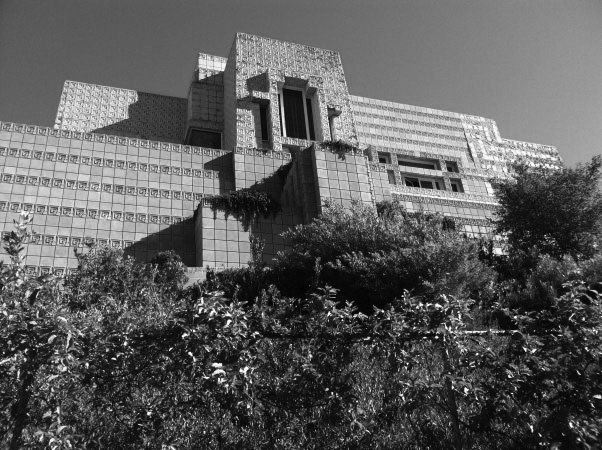 |
|
| (n.d.)** - View looking up toward the Ennis House from bottom of hill. |
Historical Notes By 2005, deferred maintenance, earthquakes, and heavy rains had taken a toll on the Ennis House. Foundations and walls had begun to fail, and the situation grew so dire that the National Trust for Historic Preservation included the home on its 2005 list of America's 11 Most Endangered Places. Work to stabilize and restore the house began in 2006, earning a Conservancy Preservation Award in 2008. * |
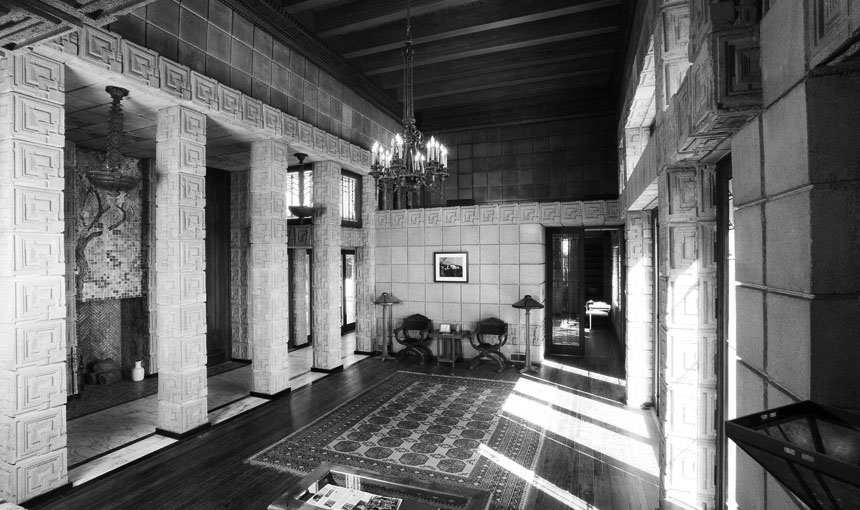 |
|
| (ca. 2008)** - Interior view of the Ennis House showing entryway |
Historical Notes Wright's client was Charles Ennis, the owner of a men's clothing store in downtown L.A. and an enthusiast of Mayan art and architecture. For each of Wright's houses built with concrete blocks, or textile blocks as they are often called, Wright designed a custom pattern. For the Ennis house, the pattern was a Greek key. Within the interlocking form, it's possible to interpret a stylized "g" -- perhaps an allusion to the Masonic Order, of which Ennis was a member, and the organization's symbol, the compass with the letter "g" in the middle representing God.* |
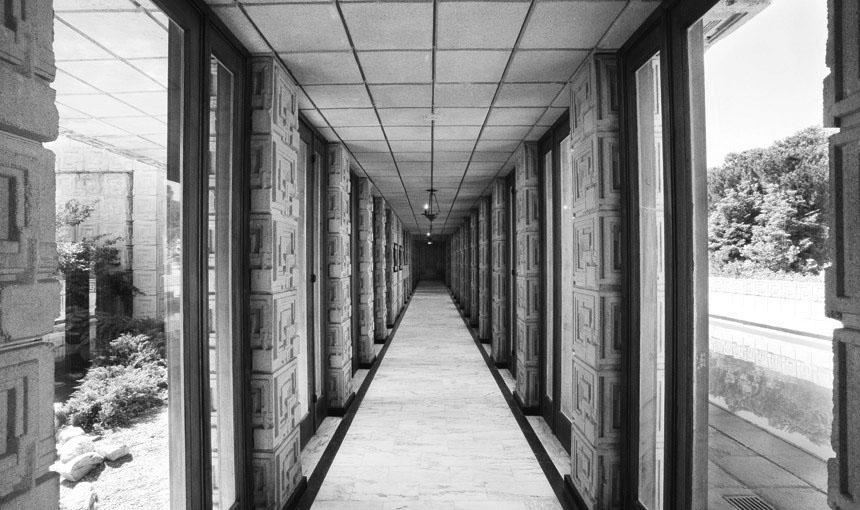 |
|
| (ca. 2008)** - A long symmetical corridor connects two sections of the Ennis House. |
Historical Notes The house consists of two buildings, the main house and a smaller chauffeur's apartment/garage, separated by a paved courtyard. Unlike the vertical orientation of the other three block houses, the Ennis House has a long horizontal loggia spine on the northern side, connecting public and private rooms to the south, and is very large at 10,000 sq ft. The kitchen, pantry, guest room, dining room, living room, master bathroom and bedroom, upper terrace, and second bathroom and bedroom are at the eastern and lower end of the main building.^ |
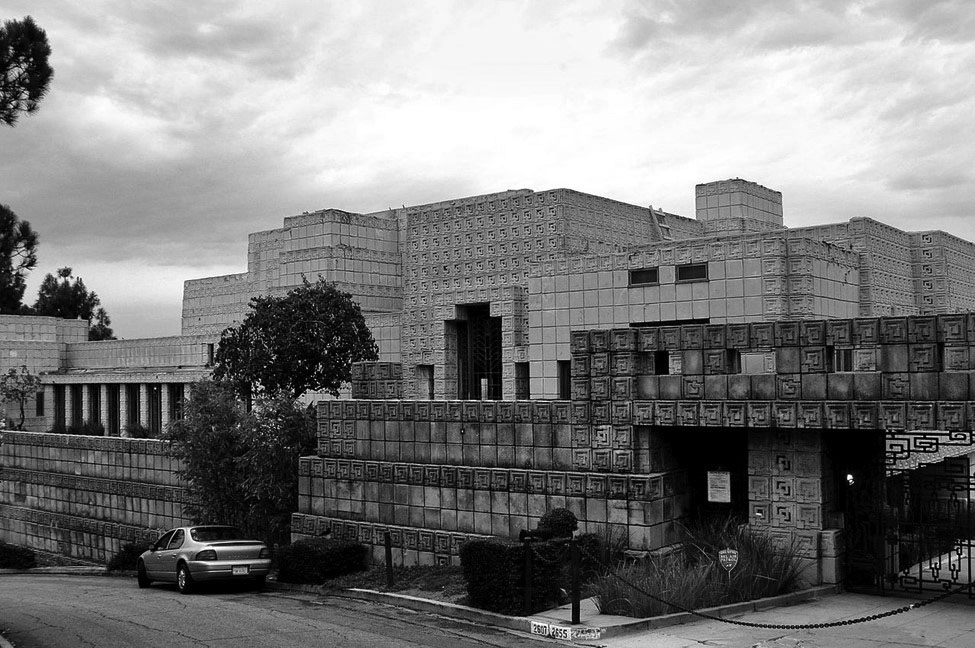 |
|
| (2005)^* - Front side of the Ennis House located at 2655 Glendower Avenue in the Los Feliz community of, Los Angeles. |
Historical Notes When Frank Lloyd Wright completed the Ennis house in 1924, he immediately considered it his favorite. The last and largest of the four concrete-block houses that Wright built in the Los Angeles area remains arguably the best residential example of Mayan Revival architecture in the country. When The Times' Home section convened a panel of historians, architects and preservationists in 2008 to vote on the region's best houses of all time, the Ennis house ranked ahead of the Modernist Eames house, the John Lautner spaceship-on-a-hill known as Chemosphere and the Arts & Crafts beauty the Gamble house.*# In 1976, the Ennis House was declared LA Historic-Cultural Monument No.149.^ |
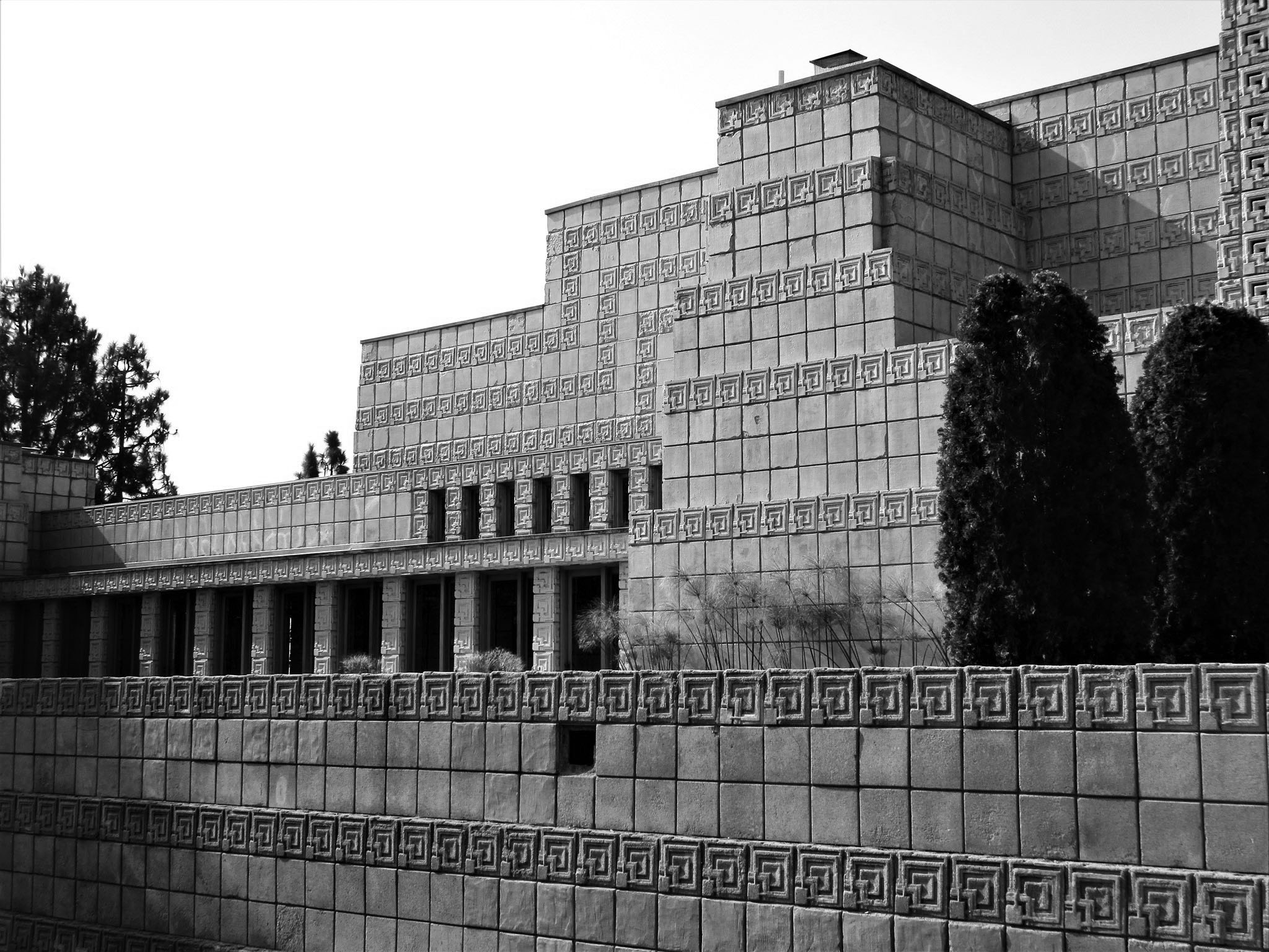 |
|
| (2020)^.^ - Close-up view showing the Frank Lloyd Wright designed Mayan Revival, Textile Block Ennis House located in Los Feliz. Photo by Howard Gray |
Historical Notes On July 15, 2011, The Ennis House Foundation announced the sale of the house to business executive Ron Burkle for just under $4.5 million. A condition of the sale is an easement that allows public viewing 12 days per year, a condition binding on subsequent buyers.^ |
* * * * * |
Pacific-Southwest Trust & Savings Bank (Central and 3rd Branch)
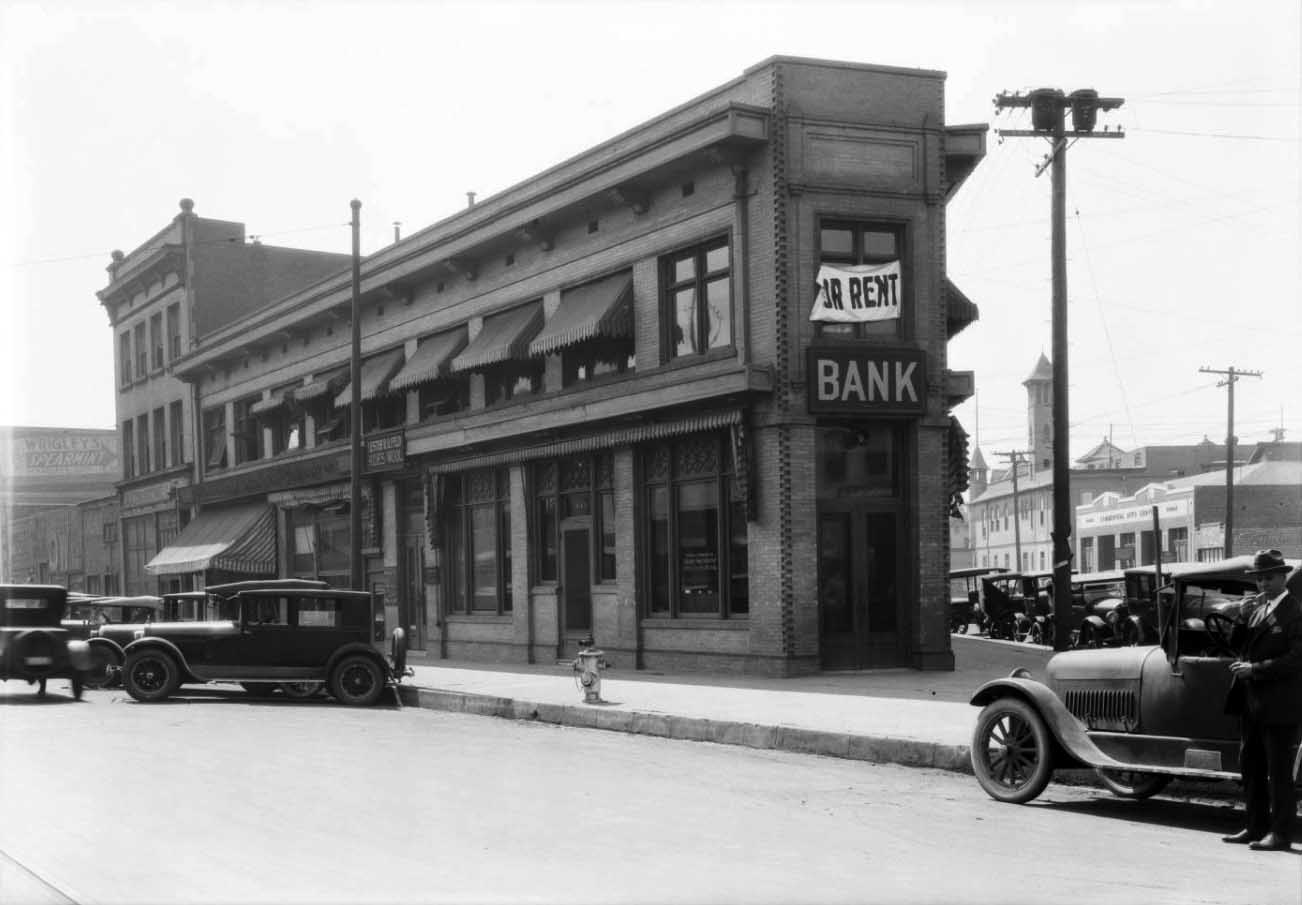 |
|
| (1924)* – View showing the newly constructed Pacific-Southwest Trust & Savings Bank - Central and Third Branch, located at 333 South Central Avenue. There’s a ‘For Rent’ sign for the second floor space above the bank sign. The building is still standing today. |
Historical Notes Originally known as Los Angeles Trust and Savings Bank, the named changed to Pacific Southwest Bank in 1922. |
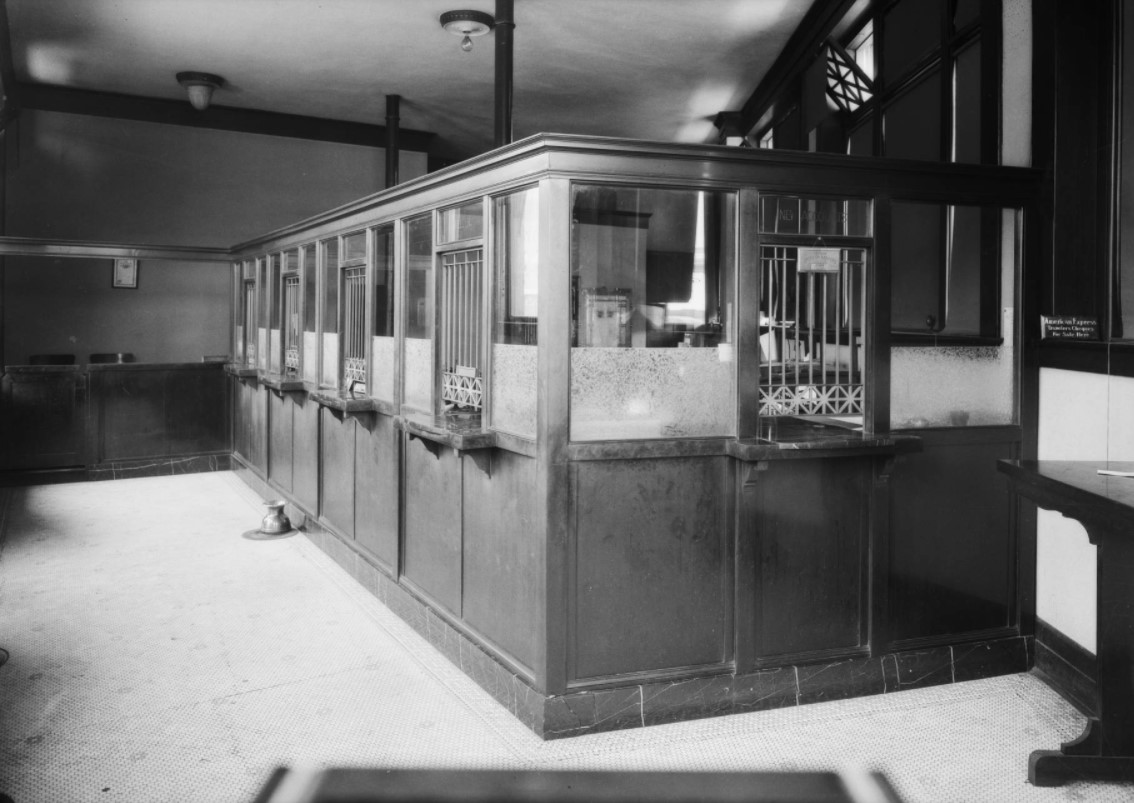 |
|
| (1924)* - Interior view of Pacific-Southwest Trust & Savings Bank showing teller cages. Not sure if that’s a spittoon on the floor. |
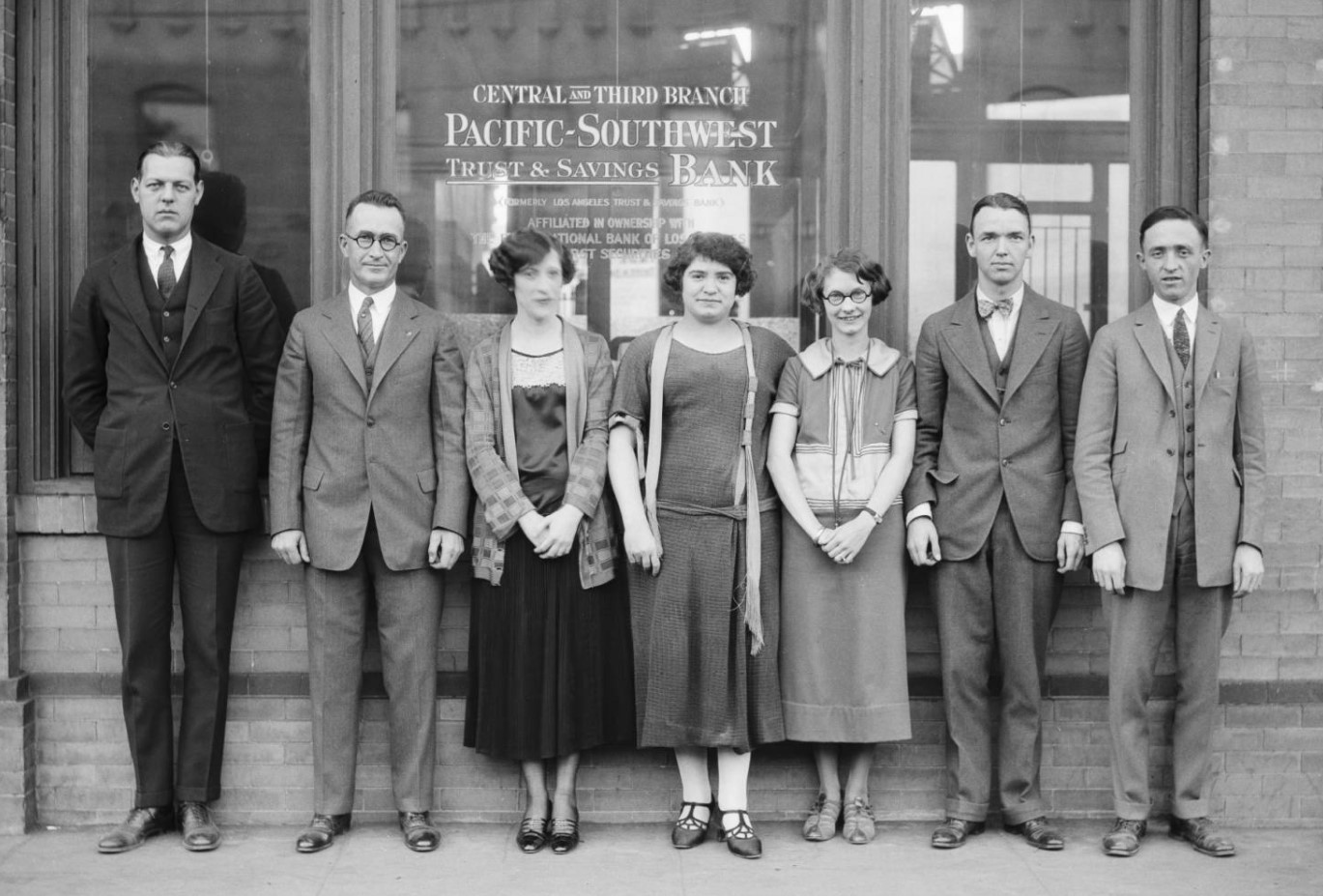 |
|
| (1924)* – Bank employees posing in front of the new building. |
Then and Now
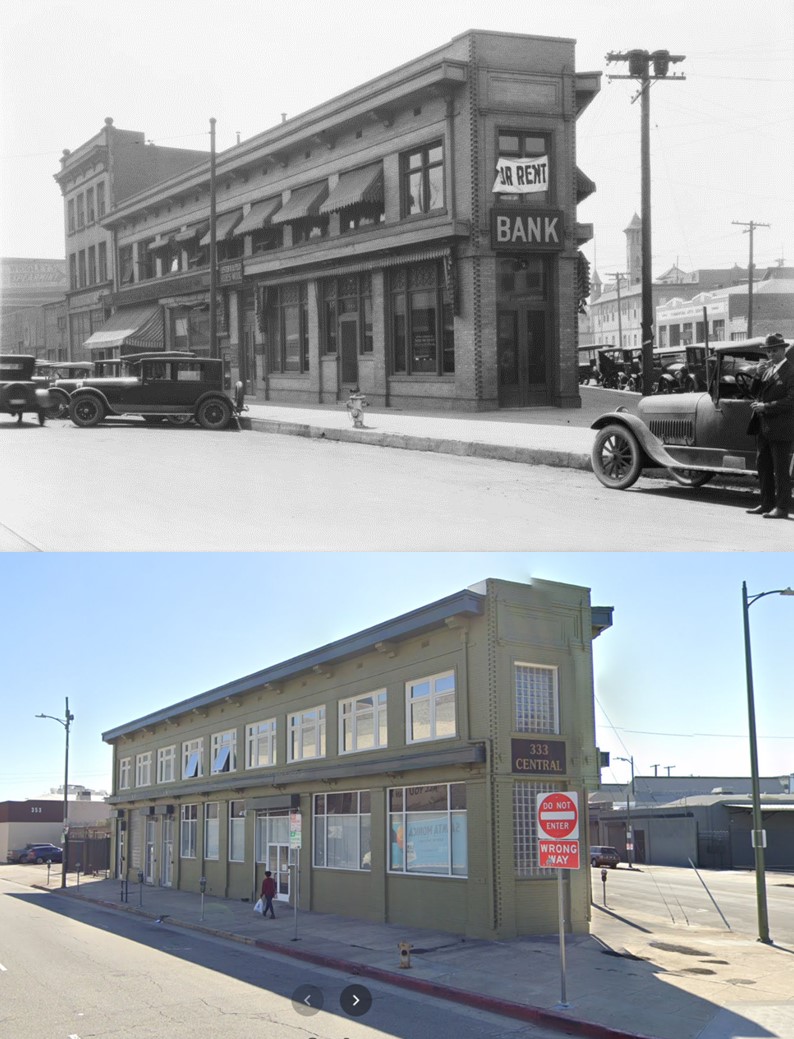 |
|
| (1924) vs. (2019) - 333 S. Central Avenue |
* * * * * |
Lake Vista Apartments
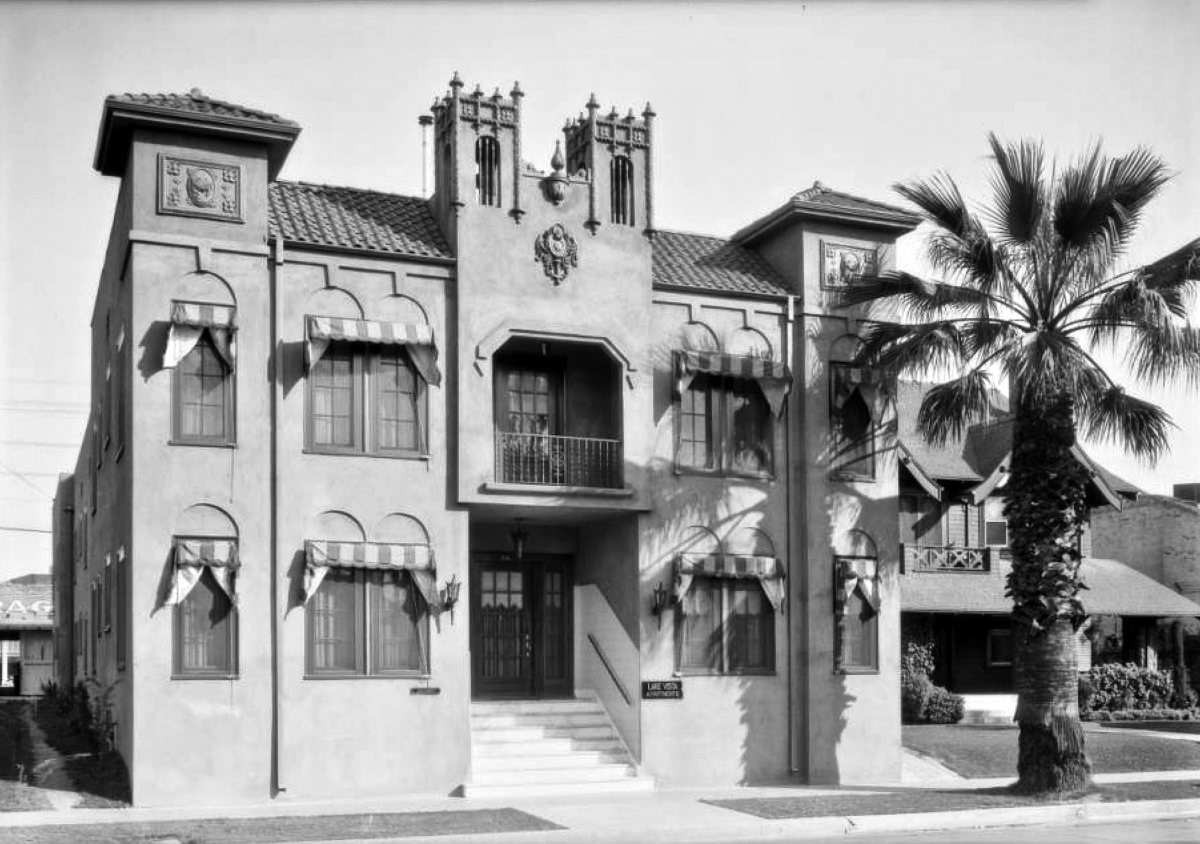 |
|
| (1926)^.^ - View showing the Lake Vista Apartments located at 1244 South Lake Street. Built by Frank Meline. |
Historical Notes Architect Frank L. Meline was born in Illinois and practiced architecture in Los Angeles under the name of Frank L. Meline Company. Among his architectural achievements are included the Fifth Church of Christ Scientist (Hollywood 1914-15); Rustikin Art Club (1922), H.H. Yanow Building (Hollywood, 1920) and the C. Reed Waterman Mausoleum in Inglewood. Frank Meline was also the first sales agent in Bel-Air for developer Alphonzo Bell (1875-1947). Meline became a prominent developer "who in 1912 formed his own Los Angeles construction company, which he expanded in 1919 to a full-service real-estate development and sales opertaion with (by 1924) eighteen branch offices throughout the Los Angeles basin. As a broker, Meline sold half the homes purchased in Beverly Hills before 1930. |
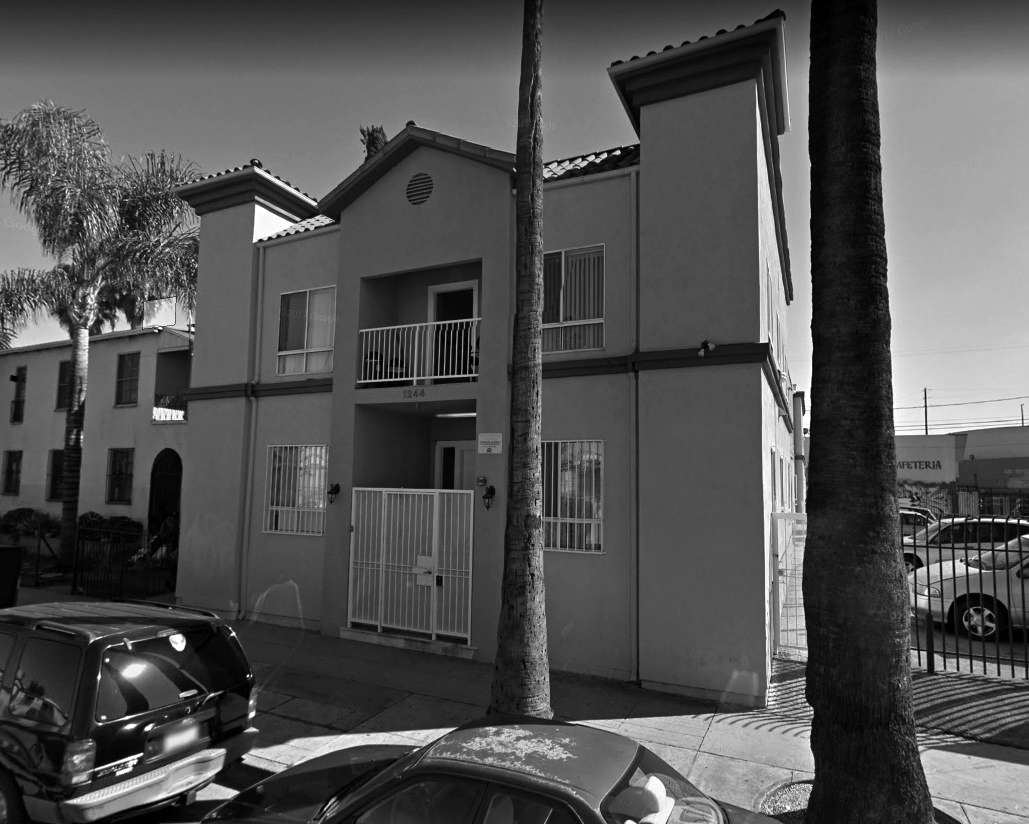 |
|
| (2017)^ – View showing the Lake Vista Apartments building as it appears today. Not as pretty as the original version. |
* * * * * |
Warner Brothers West Coast Studio
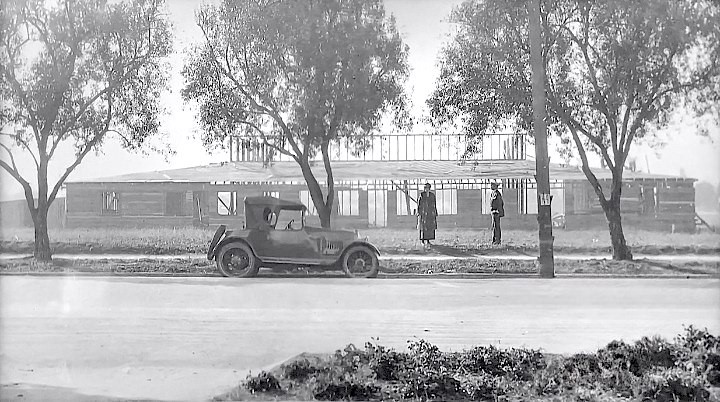 |
|
| (ca. 1919)* - View showing a man and woman standing on a lot at the 5800 Sunset Boulevard. Behind them is a structure under construction which became the birth of Warner Bros. west coast filming studios. The car parked in front happens to be a c1918 Scripps-Booth. |
Historical Notes In 1918, the Brothers Warner (Harry, Albert, Sam and Jack) bought 10.2-acres of land in Hollywood from the Beesmyer family at a cost of $25,000. In 1919 they built a giant stage nicknamed The Barn, which measured 50-feet wide by 100- feet long. This stage was torn down in 1923 and was replaced by a collection of smaller stages and buildings.* |
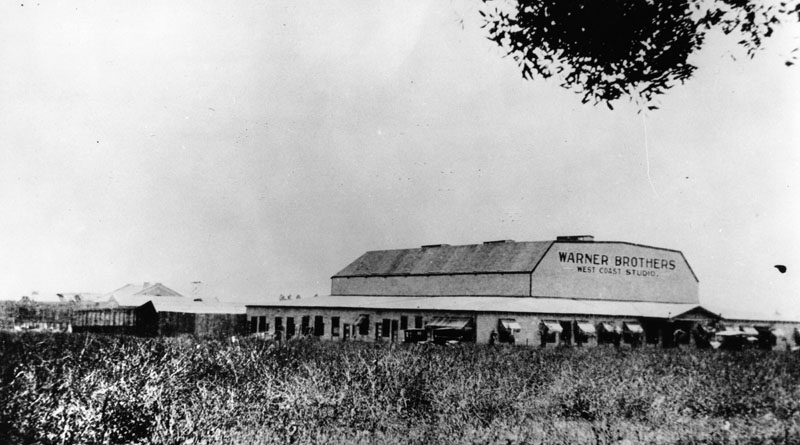 |
|
| (ca. 1918)* - View showing the original "Barn" filming stage at the Warner Brothers West Coast Studio at Sunset and Bronson in Hollywood. |
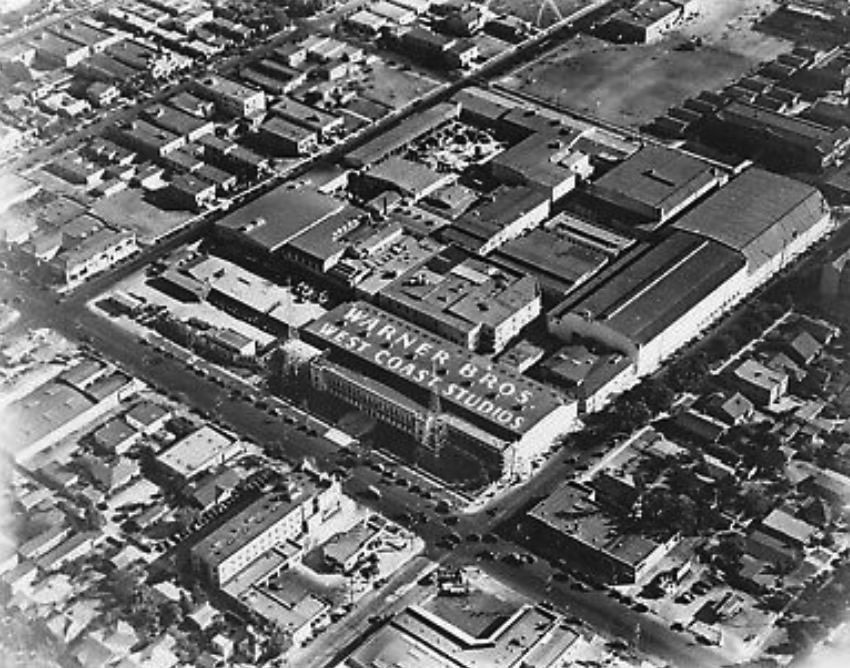 |
|
| (1920s)* – Aerial view looking down at Warner Bros. Studio located at 5800 Sunset Boulevard in Hollywood. The intersection of Sunset Boulevard and Bronson Avenue is seen in the foregournd. |
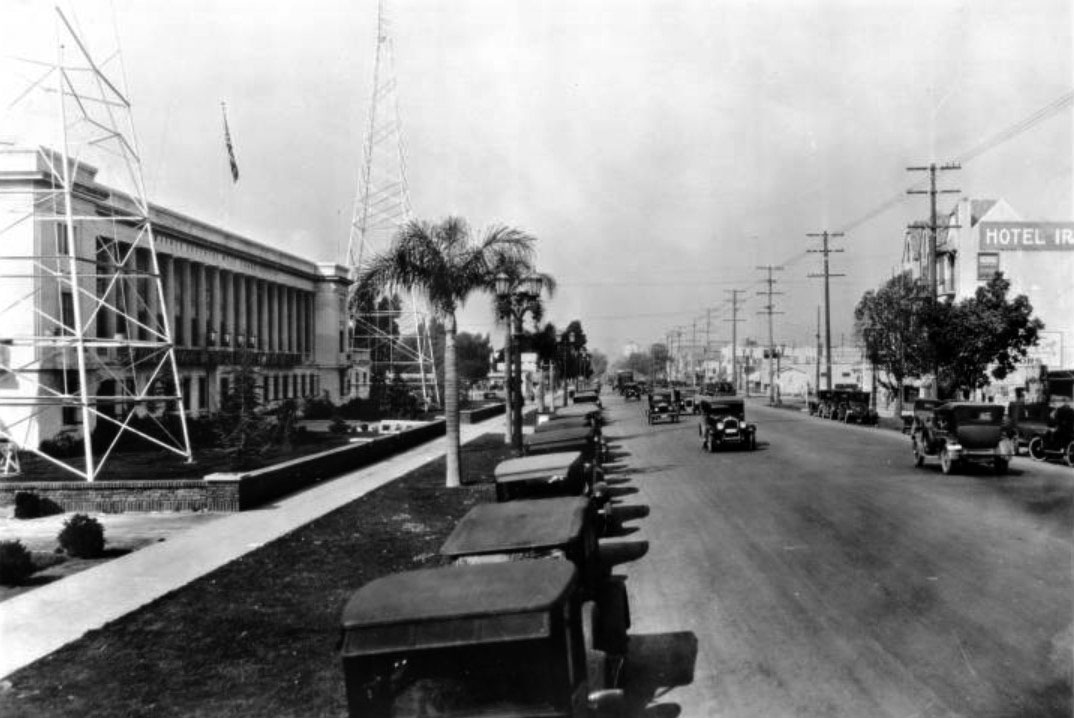 |
|
| (ca. 1926)^ - View of Sunset Boulevard looking west from near Van Ness Avenue showing the Warner Brothers Studio. Automobiles are parked along the left sidewalk while still others navigate the boulevard. To the left, the Romanesque architecture of the Warner Bros. West Coast Studio building can be seen flanked to either side by tall radio towers, with its entranceway supported by Doric columns. Hotel Iris can be seen across the street (This is where Judy Garland once stayed). |
Historical Notes The studio was the site where the first talking feature film, The Jazz Singer, was filmed in 1927.* |
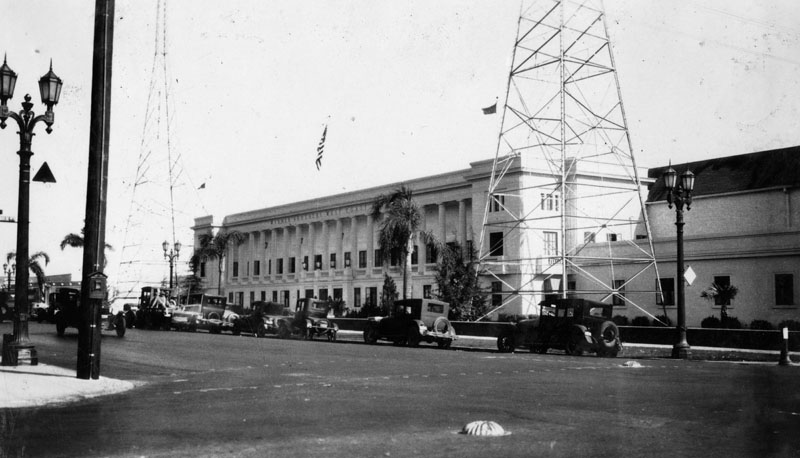 |
|
| (1927)* - View looking southeast from the intersection of Sunset and Bronson Ave showing the Warner Brothers West Coast Studios, located at 5858 Sunset Boulevard. |
Historical Notes In 1925, Sam Warner started KFWB radio station on the lot. Note the station’s two 150-foot towers in the above photo.* |
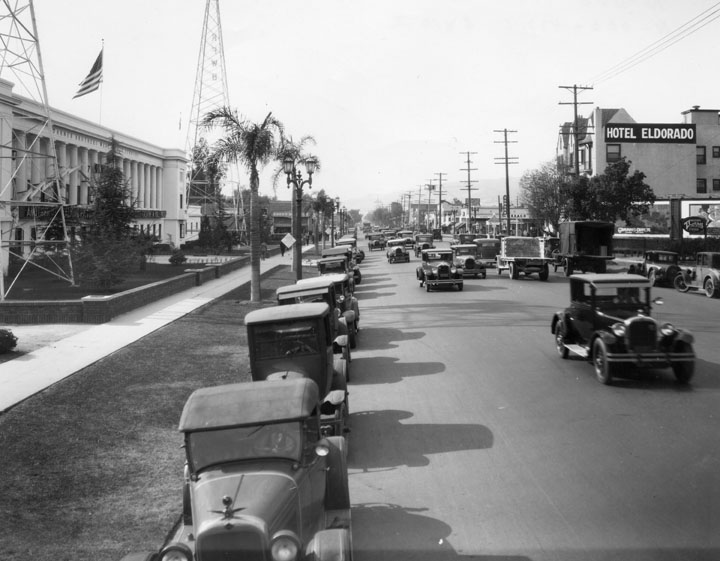 |
|
| (1930)* - Sunset Boulevard looking west from Van Ness. To the left is Warner Brothers West Coast Studios; to the right is the Hotel Eldorado, which was prviously the Hotel Iris . |
Historical Notes Warner Bros bought a majority interest in First National Pictures in 1928, consolidating its executive offices into that company’s 1926 Burbank lot after a $500,000 building program was completed in January 1930. Production followed over the hills shortly thereafter. While filming primarily occurred at the Burbank location, some shooting and phonograph recording continued at the Hollywood lot. In the 1930s, Termite Terrace, the animation production unit behind the Merrie Melodies and Looney Tunes cartoons operated out of the Warner Bros Hollywood studio. By the end of 1937, the Warner Bros had vacated their Hollywood home.***# |
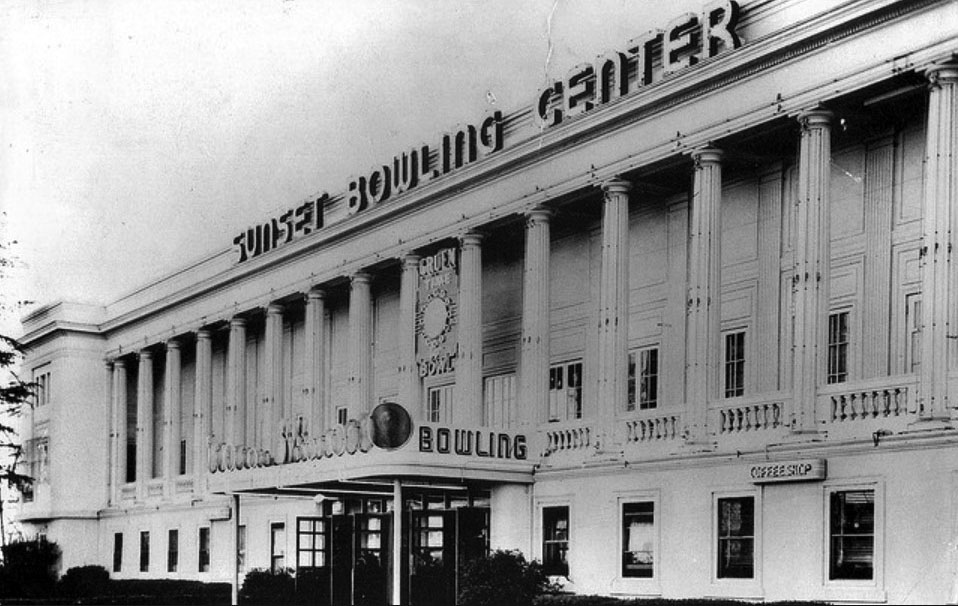 |
|
| (1937)^^** - View of the site of the filming of The Jazz Singer, the first feature film with synchronized sound. Converted to a bowling alley and sports center. |
Historical Notes In 1937, Sam Warner's brother-in-law, Harry Charnas, opened Sunset Bowling Center behind the old executive offices of Warner Bros. Studios. The Sunset Bowling Center was part of a "sports palace" that also contained badminton courts and a skating rink.* |
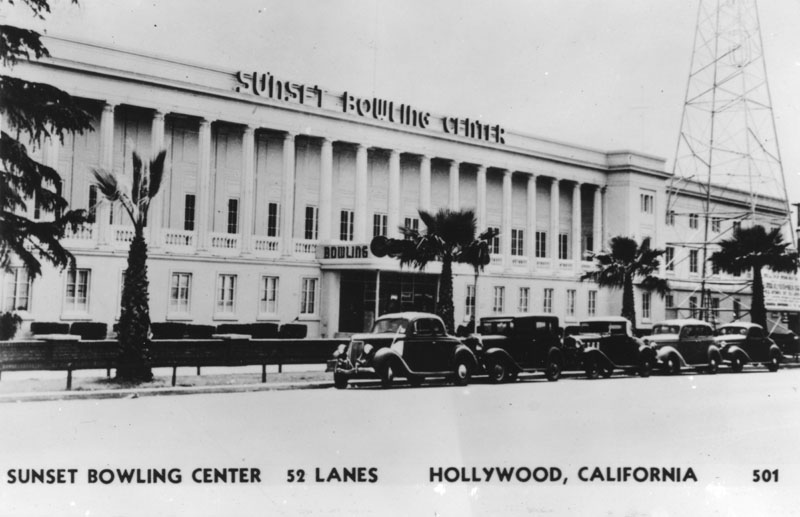 |
|
| (ca. 1941)* - Facade of the Sunset Bowling Center on Sunset Blvd. in Hollywood most likely taken during a bowling tournament held there in 1941. The 1922 building served as the West Coast headquarters of the Warner brothers, Harry, Albert, Sam, and Jack, until 1929. |
Historical Notes With 52 bowling lanes, the Sunset Bowling Center was the largest in the world at that time. Pin boys lived in the loft of the building. The bowling center operated for ten years.* |
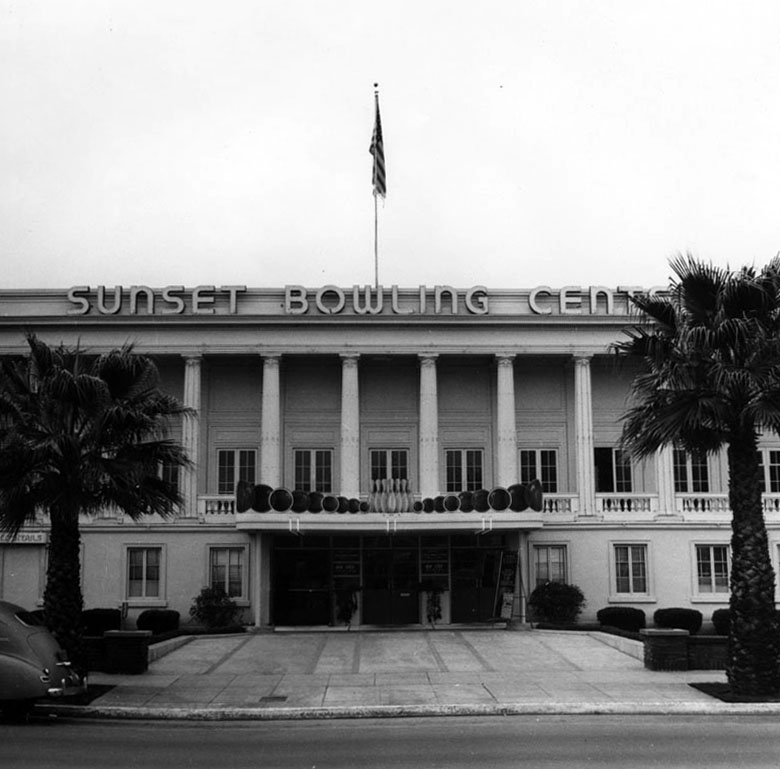 |
|
| (ca. 1940)* - Exterior view of neoclassical style Sunset Bowling Center, located at 5858 Sunset Boulevard in Hollywood. |
Historical Notes In 1954, Paramount bought the site to provide television production facilities for KTLA, which moved to the site in 1958. Gene Autry bought KTLA in 1964, and leased the space from Paramount for three years, after which he bought the property for a whopping $5 million dollars.* In June 1968, radio station KMPC, of which Autry was a principal owner since 1952, also moved to the site.***# |
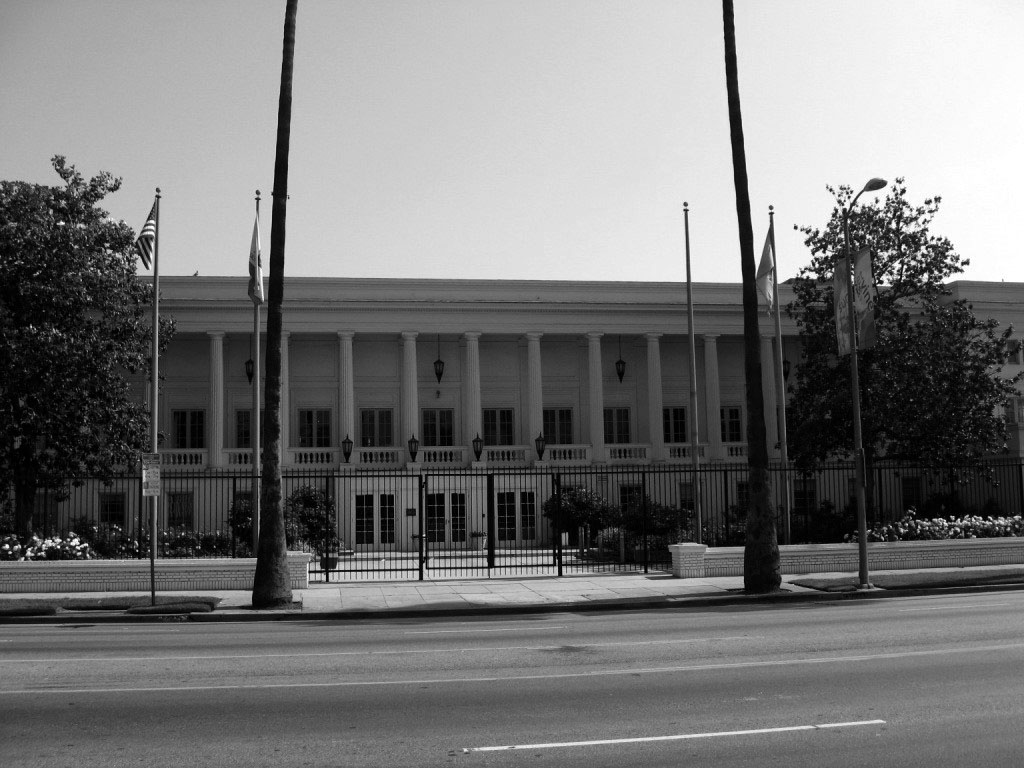 |
|
| (2008)^* - View of the Executive Office Building at the Old Warner Brothers Studio — on Sunset Boulevard, in Hollywood. It is officially called today Sunset Bronson Studios and also known as KTLA Studios and Tribune Studios. |
Historical Notes In 1982, an investment-banking firm bought the lot and KTLA, and three years later, sold out to the Tribune Company. In January of 2008, Hudson Capital purchased the landmark 1920s Warner Bros. Studio for an astounding $130 million dollars.* |
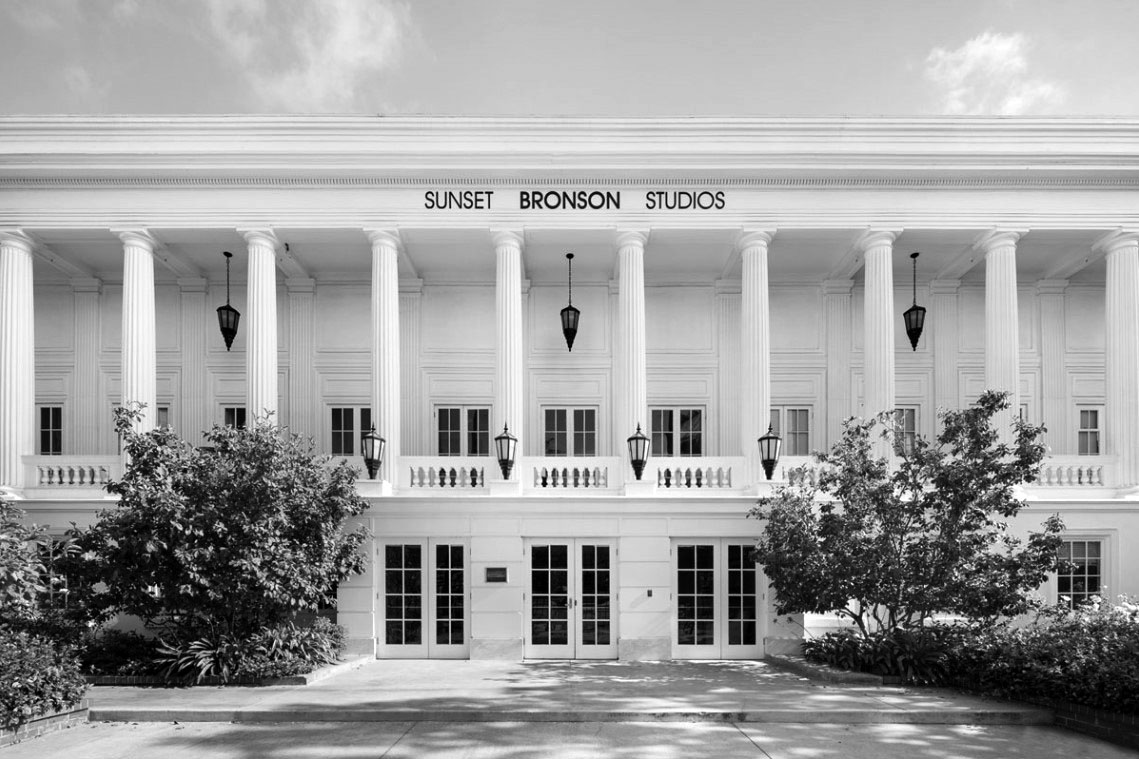 |
|
| (ca. 2014)###* - View of the Sunset Bronson Studios, also known as KTLA Studios and Tribune Studios. |
Historical Notes This beautiful building of classical design, which boasts of a big colonnade of Doric columns, was declared Historic-Cultural Monument No. 180 in 1977 by the city of Los Angeles (Click HERE to see complete listing). Being the "Site of the Filming of the First Talking Film”, the facilities were also listed on the National Register of Historic Places in 2002.^* |
* * * * * |
Castillo del Lago
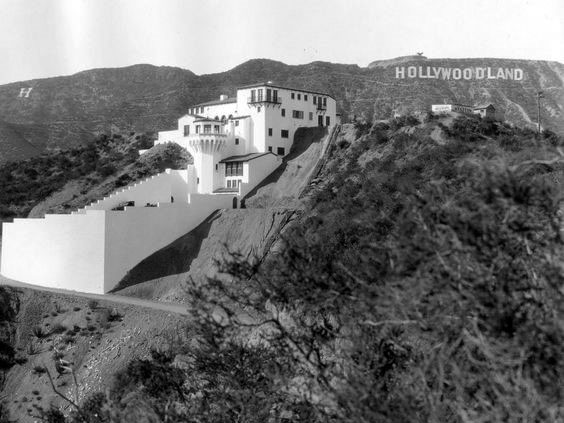 |
|
| (ca. 1926)^v^ - View showing the very large Mediterranean-style Castillo de Lago in the Hollywood Hills. The Hollywoodland Sign can be seen in the distance at upper-right. Another large letter H appears at upper-left. |
Historical Notes The Spanish colonial style castle called Castillo de Lago was built by oil baron Patrick Longden in Beachwood Canyon in 1926. It was designed by Architect John DeLario, the primary architect of the original Hollywoodland tract. |
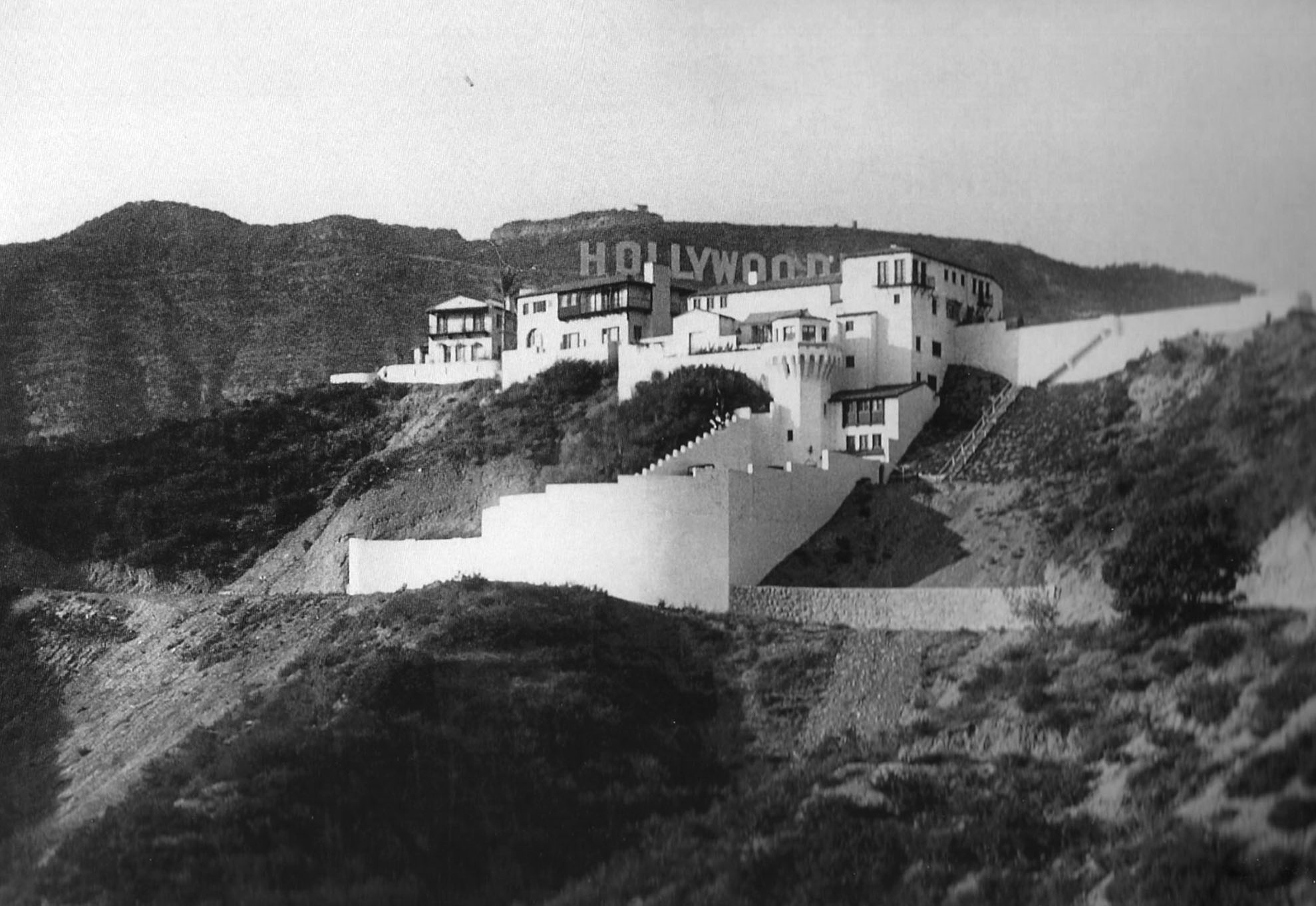 |
|
| (1926)^.^ – Closer view showing the magnificent Castillo del Lago with part of the Hollywoodland Sign visible behind it. |
Historical Notes At various times in its history, Castillo del Lago has been vacant, a white elephant during the Depression and beyond. Older adults who grew up in Beachwood tell stories of using it as a neighborhood clubhouse, entering through unlocked doors to play in the tower and on the stairs. * |
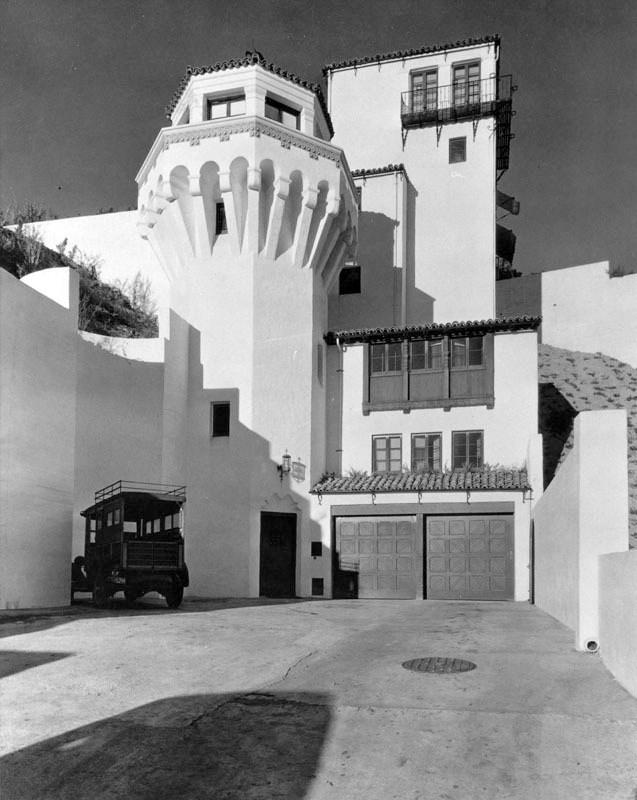 |
|
| (1926)^*– Driveway leading to the garage of the Spanish Colornial style Castillo del Lago. |
Historical Notes In the late 1930’s, a newcomer to Beachwood leased the house: Benjamin “Bugsy” Siegel, the gangster best known for spearheading the post-war casino boom in Las Vegas. Though he later took up residence in Beverly Hills, Siegel apparently lived in Castillo del Lago for a time while running it as an illegal casino. (It was not a speakeasy, as many people have claimed, as Prohibition was repealed in 1933.)* |
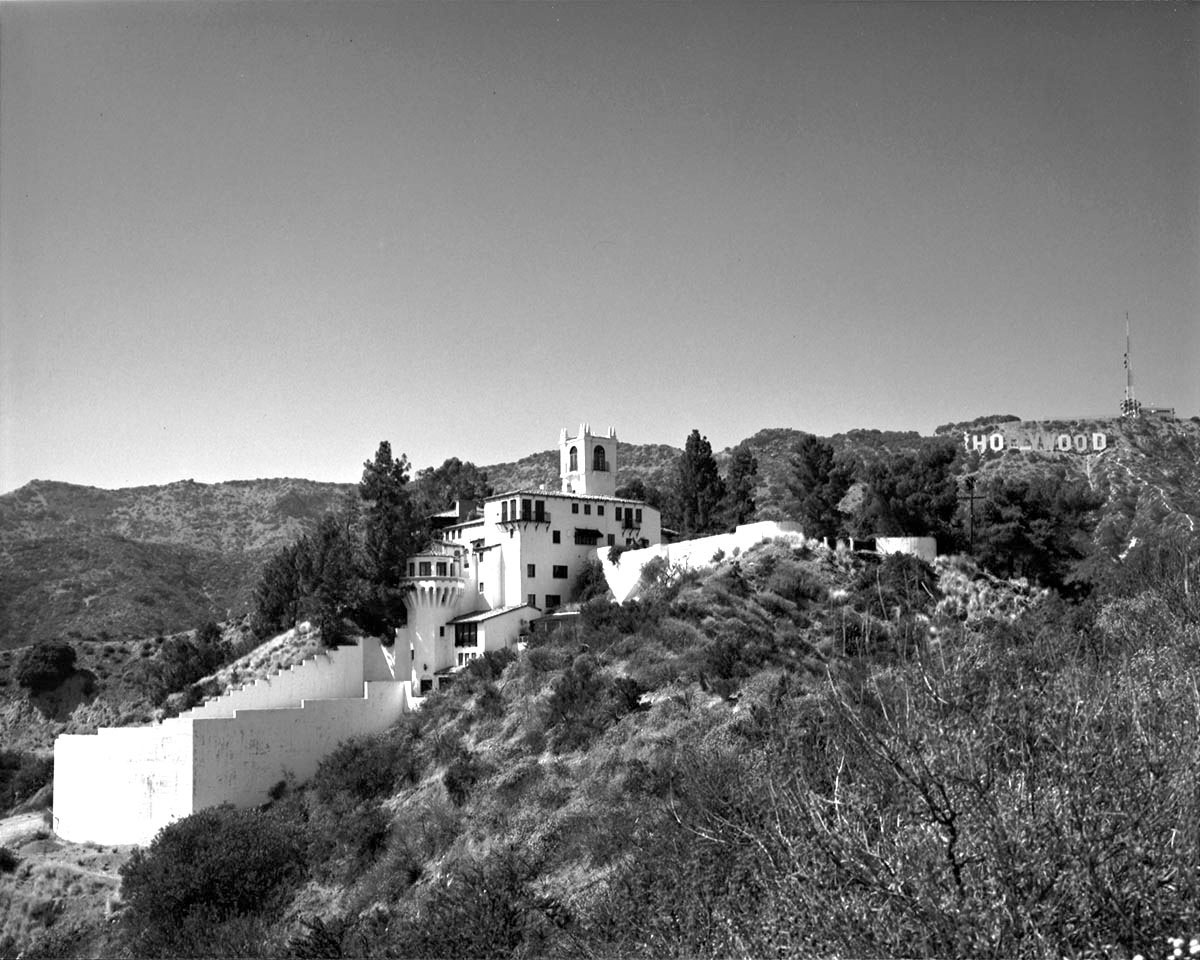 |
|
| (1980)+# - Looking up the Hollywood Hills showing the John DeLario designed, Willfong House (aka Castillo del Lago). Photo by Julius Shulman |
Historical Notes In the 1950s, the house fell into a sad state of disrepair, was vandalized and, at one point, caught fire. The property eventually came under ownership by Baron Patrick de Selys–Longchamps who, lived on the property for a few years in un-restored condition. The Baron sold to a couple named Willfong who did over and did up the house and had it published in Architectural Digest. Records show that in 1990, the Willfongs sold to Richard Grossman and Lisa Lyons. The Grossman/Lyons in turn sold it to Madonna Ciccone in 1993.*^ |
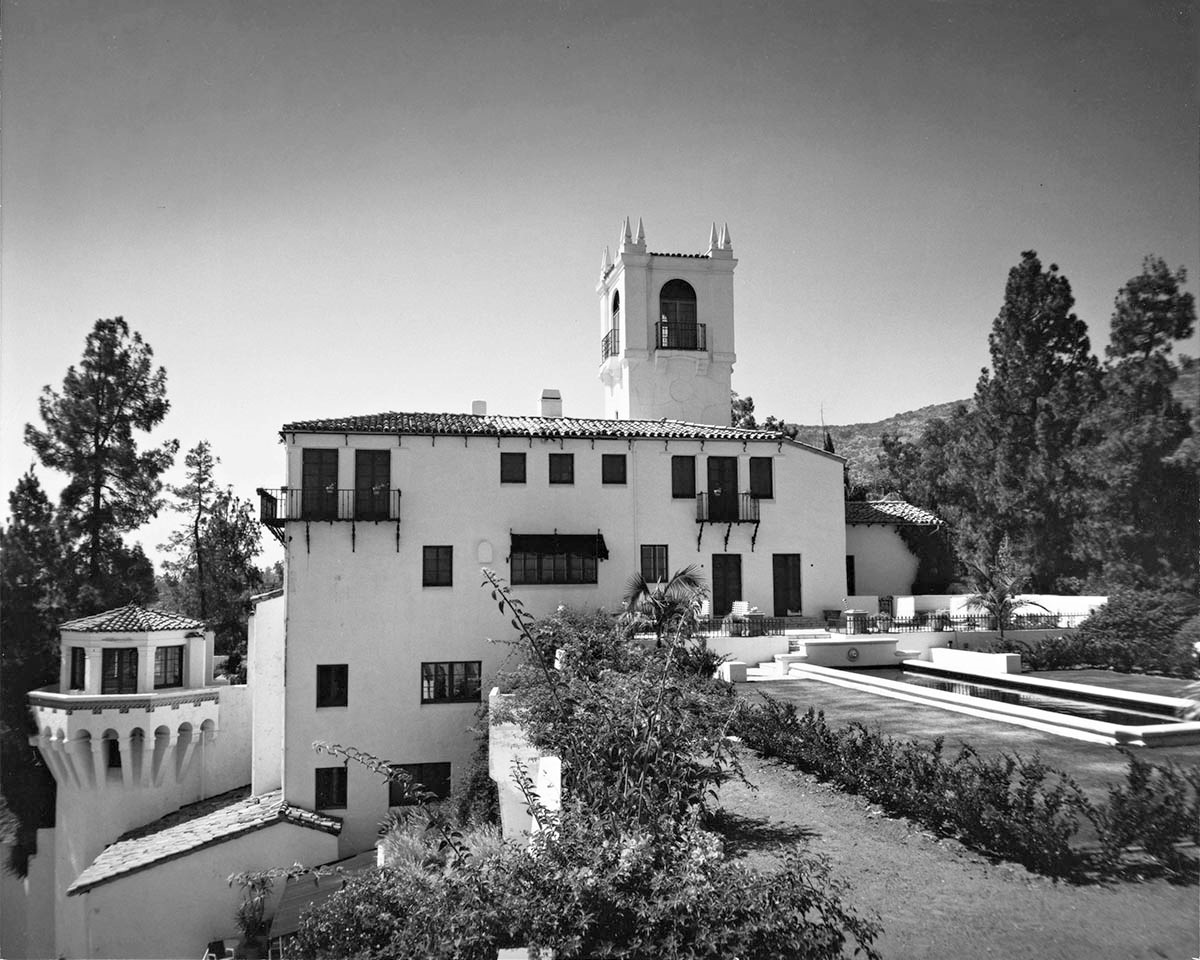 |
|
| (1980)+# – View showing the nine-story, 8,000 square foot Castillo del Lago. Photo by Julius Shulman |
Historical Notes In 1993, Madonna bought Castillo del Lago for $5 million. Soon after buying the mansion, Madonna undertook a renovation that cost $3 million and transformed the house from Spanish Colonial to Italianate. (The renovation still irks her neighbors, who claimed she “ruined” the house by painting the wall and replacing the original tiles with cheaper ones.) |
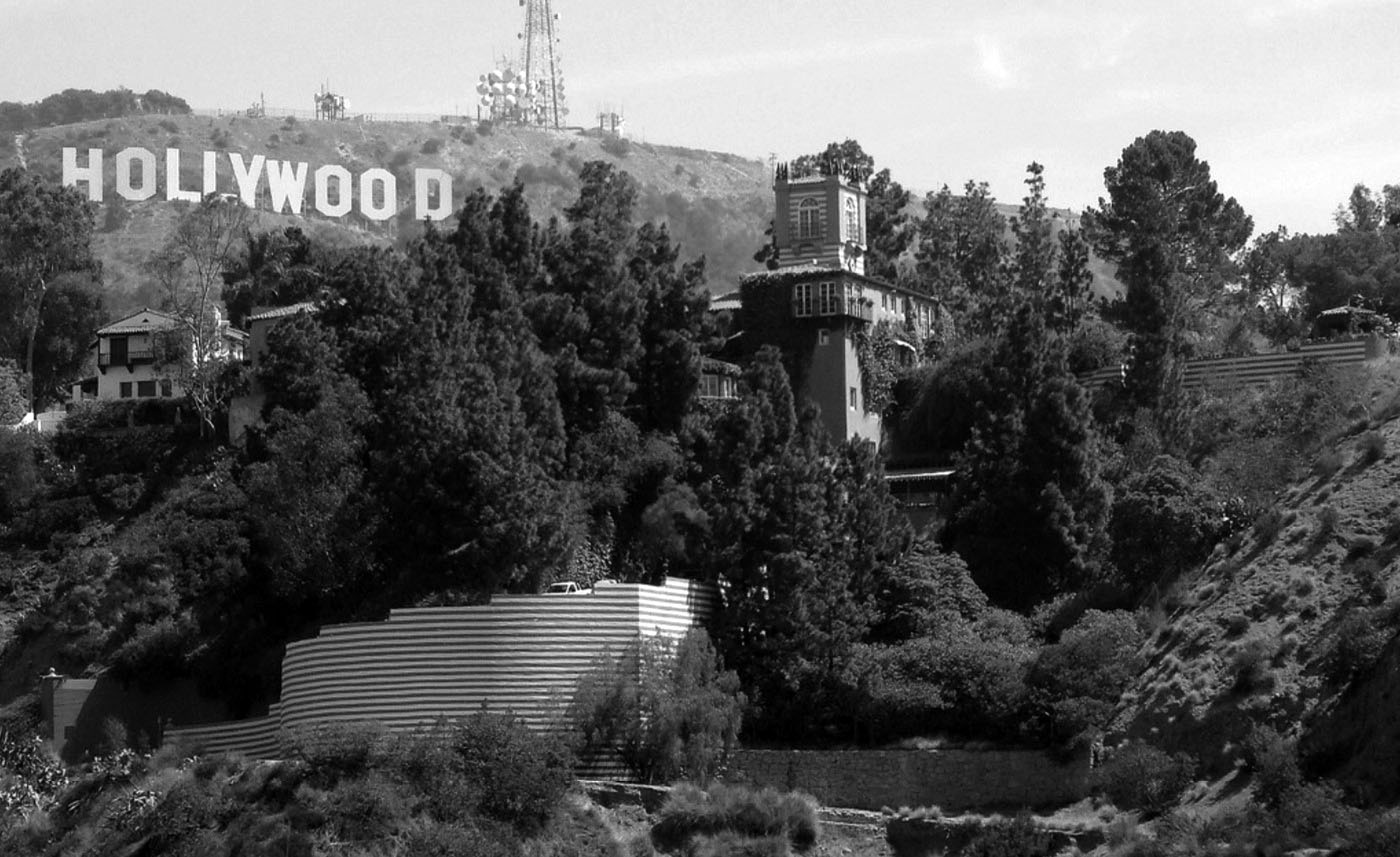 |
|
| (2007)^.^ - Hollywood Sign behind Madonna's old home, Castillo del Lago, after renovation. located at 6342 Mulholland Drive. Photo by Jeremiah Christopher. |
Historical Notes In 1997, Madonna sold Castillo del Lago at a huge loss to Joe Pytka, the commercial director and restaurant owner (of Bastide, now defunct). Pytka, who bought the house for $5.3 million, listed it last year for $14.95 million after an extensive renovation of his own. (In addition to creating a new kitchen and master suite, he upgraded Madonna’s tilework.)* |
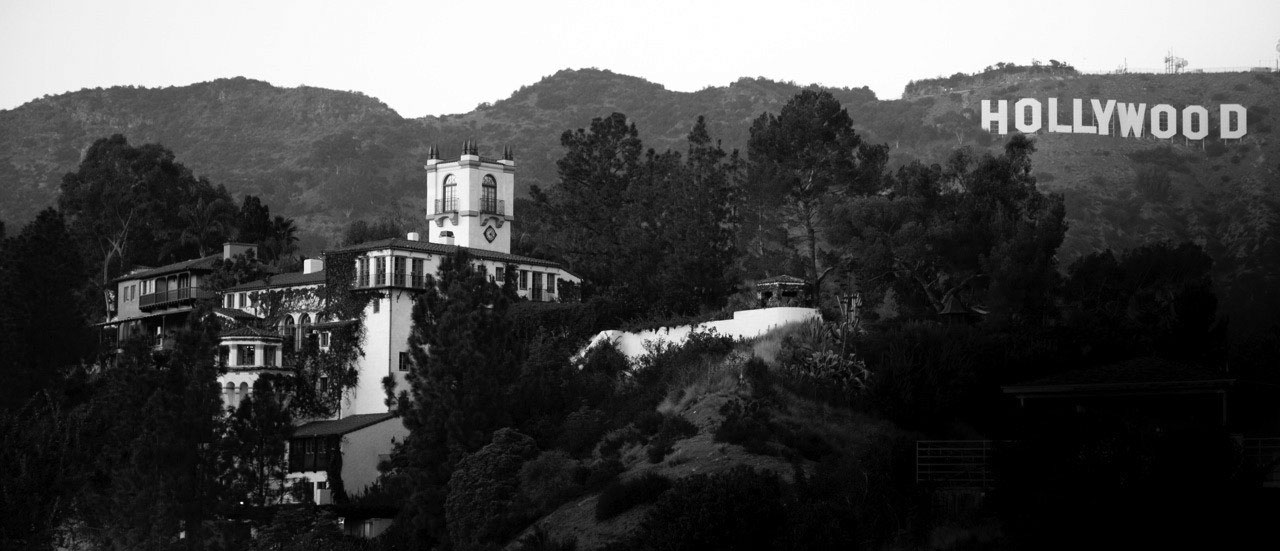 |
|
| (2012)^ – Panoramic view of the Castillo del Lago mansion located at 6342 Mulholland Drive, with the Hollywood Sign in the background. |
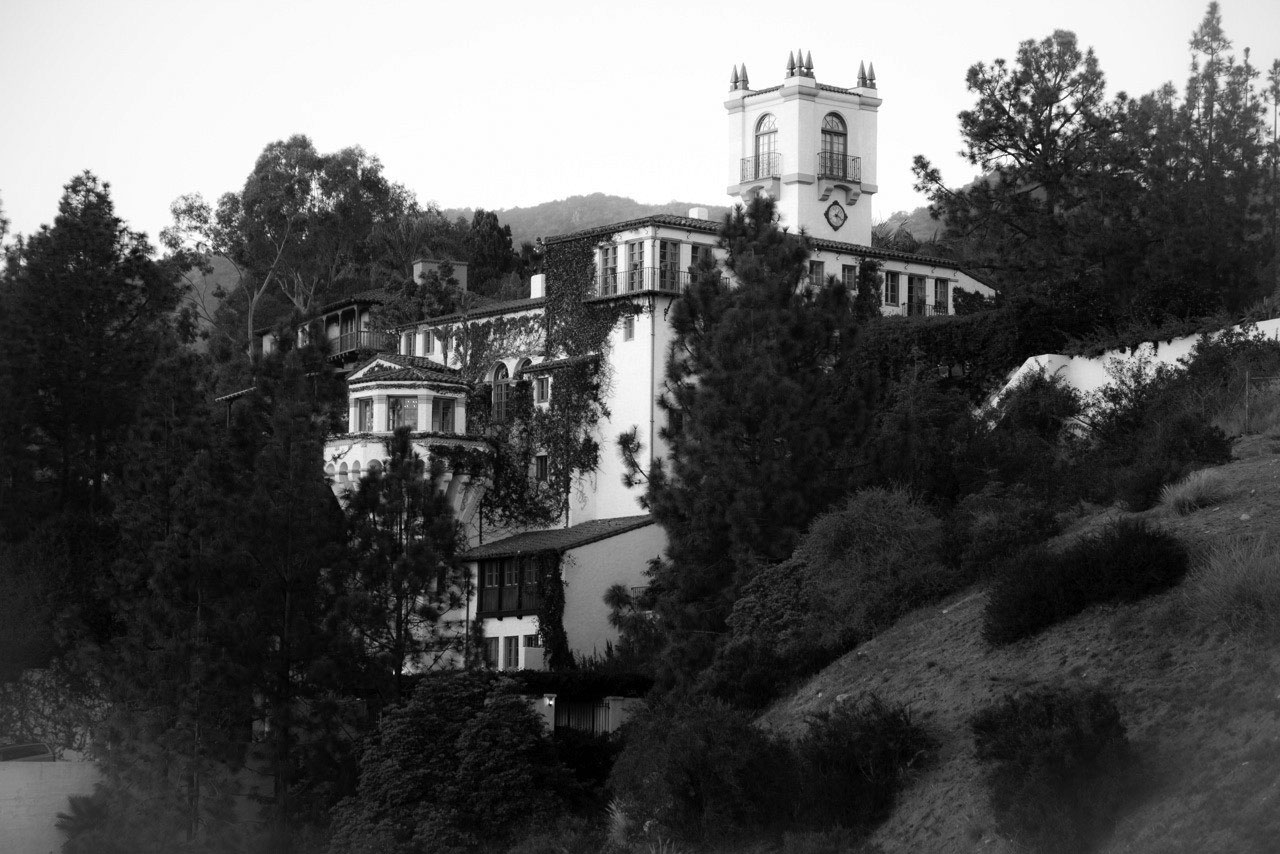 |
|
| (2012)^ – Close-up view of Castillo del Lago in the Hollywood Hills. |
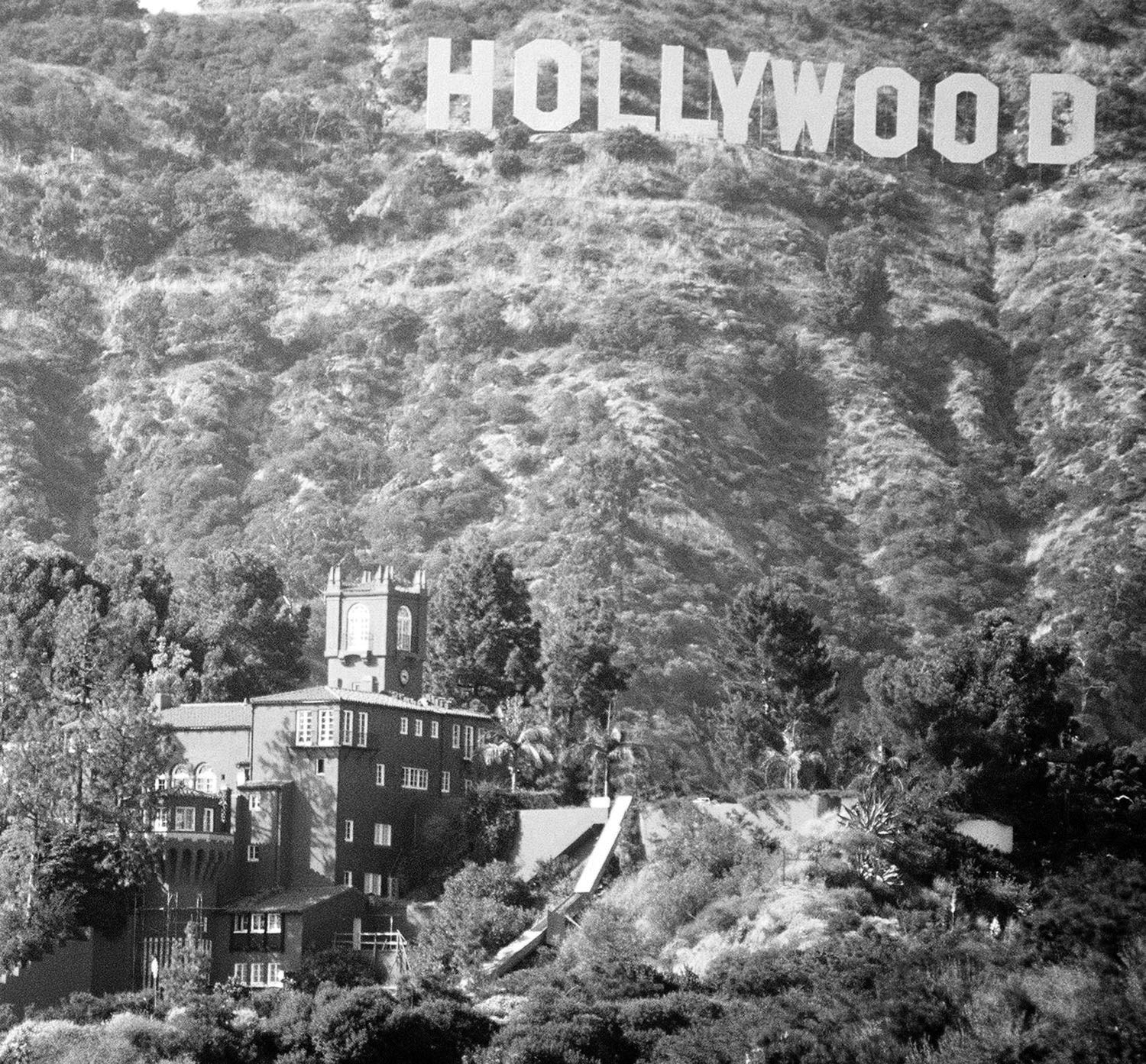 |
|
| (2018)**– The Castillo del Lago with the Hollywood Sign in the background as it appears today. |
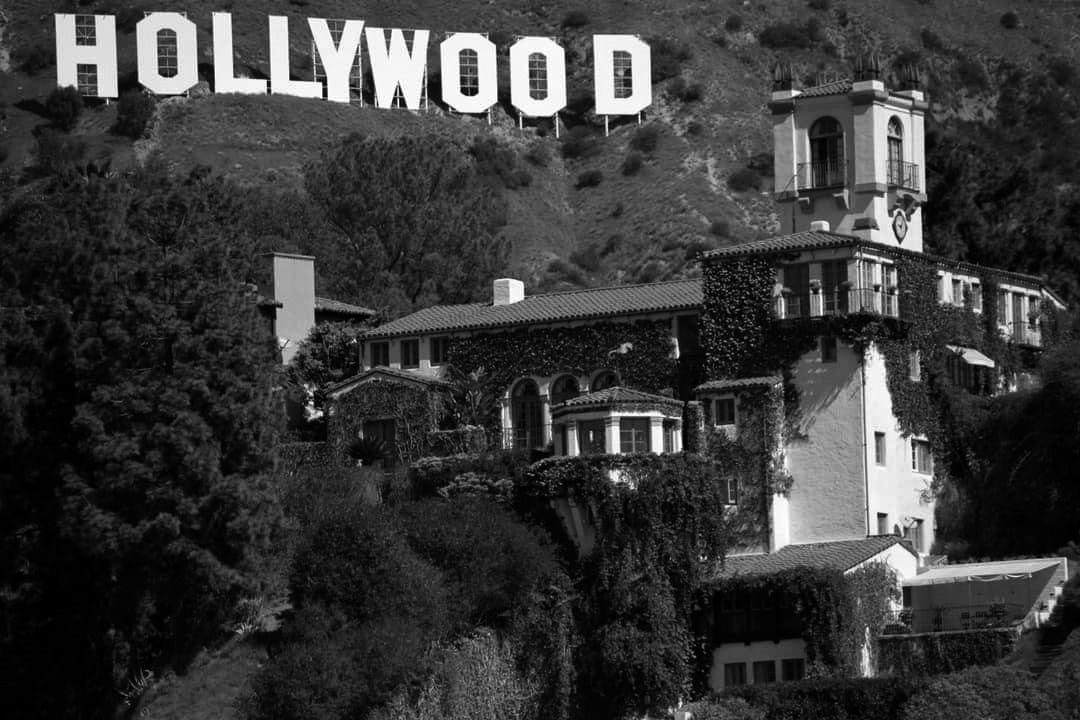 |
|
| (2019)^.^ - Closer view of Castillo del Lago with the Hollywood Sign perched on the hills behind it. Photo by Brady Hunsberger |
* * * * * |
First Presbyterian Church of Hollywood
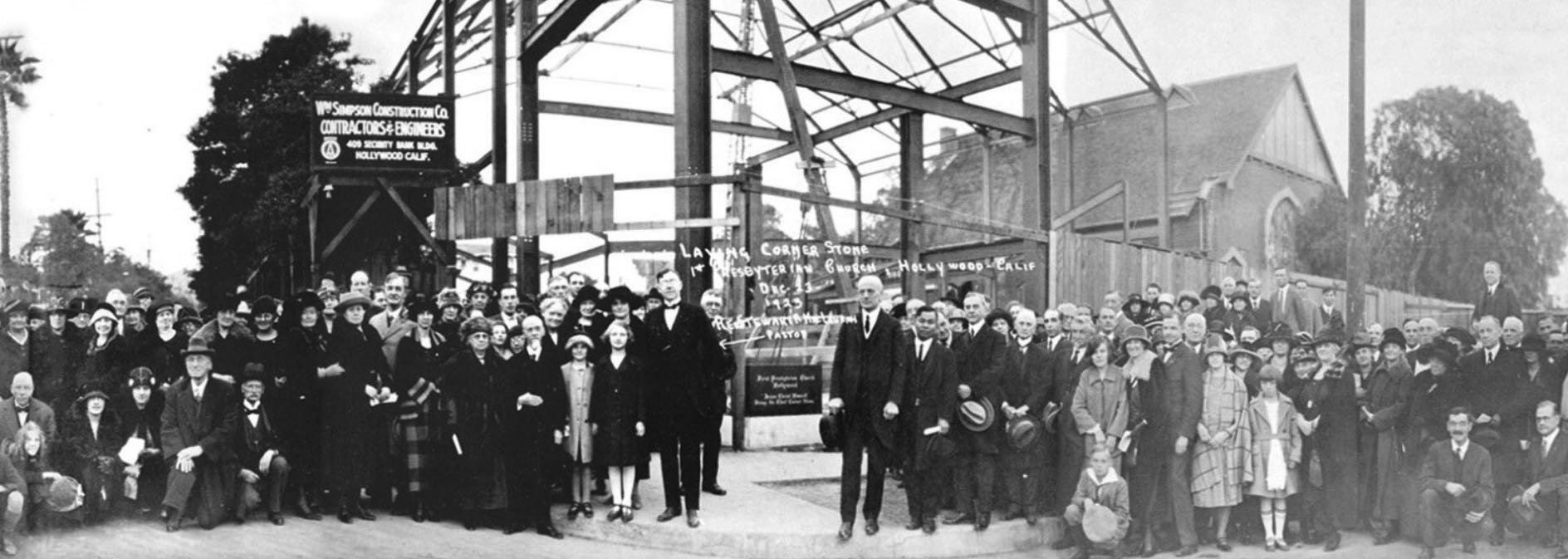 |
|
| (1923)* – Laying of Cornerstone Ceremony at the First Persbyterian Church in Hollywood, 1760 N. Gower Street. |
Historical Notes The church was founded in 1903. A large brick gothic sanctuary was built in 1923, and seats 1,800, with a balcony on both sides and in the back. ^ |
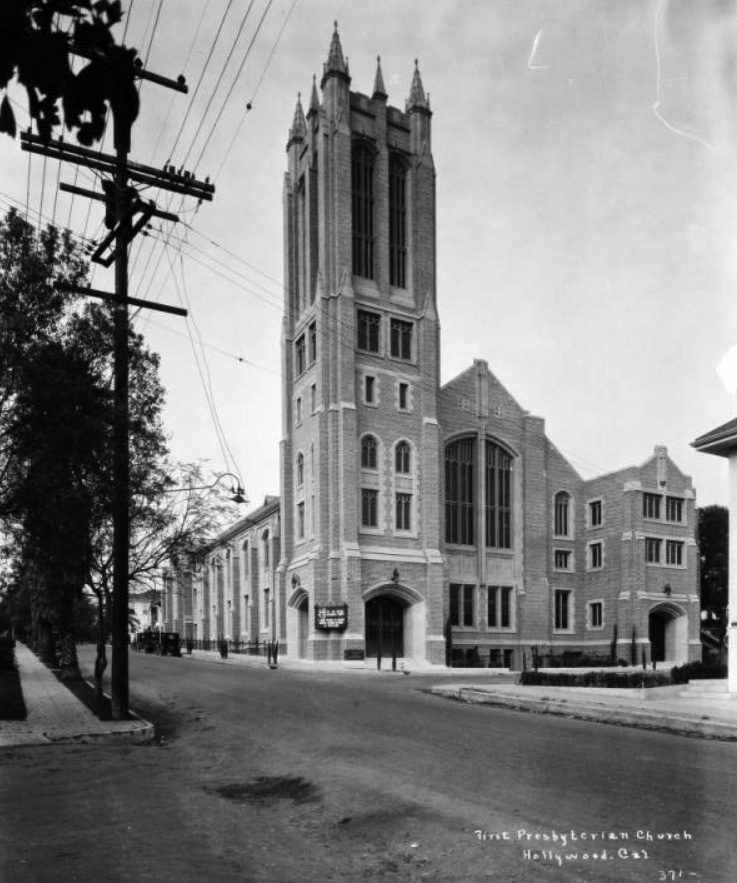 |
|
| (ca. 1926)^^- View looking up an unpaved Gower Street showing the First Presbyterian Church of Hollywood located on the northeast corner of Gower and Carlos Ave. |
Historical Notes The church campus covers a full square block on Gower Street, one block north of Hollywood Boulevard and three blocks from the legendary intersection of Hollywood and Vine.^ |
 |
|
| (2015)^*– View showing the First Presbyterian Church of Hollywood located at 1760 N Gower Street. |
Historical Notes Dedicated on November 16, 1924, the First Presbyterian Church of Hollywood immediately became one of the area’s most notable landmarks and one of its most popular churches with attendees coming not just from Hollywood but surrounding communities as well. In fact, by the 1960’s the church had grown to become the largest Presbyterian church in the world with a congregation exceeding 8,000 with nationally/internationally known pastors at its head. One of the best known, Dr. Lloyd Ogilvie, left the church in 1995 to become Chaplain of the United States Senate. Ogilvie was the second former pastor from Hollywood Presbyterian to be accorded the honor, the first being Dr. Richard C. Halverson. By 2013, however, the congregation had fallen to 1,036.^ |
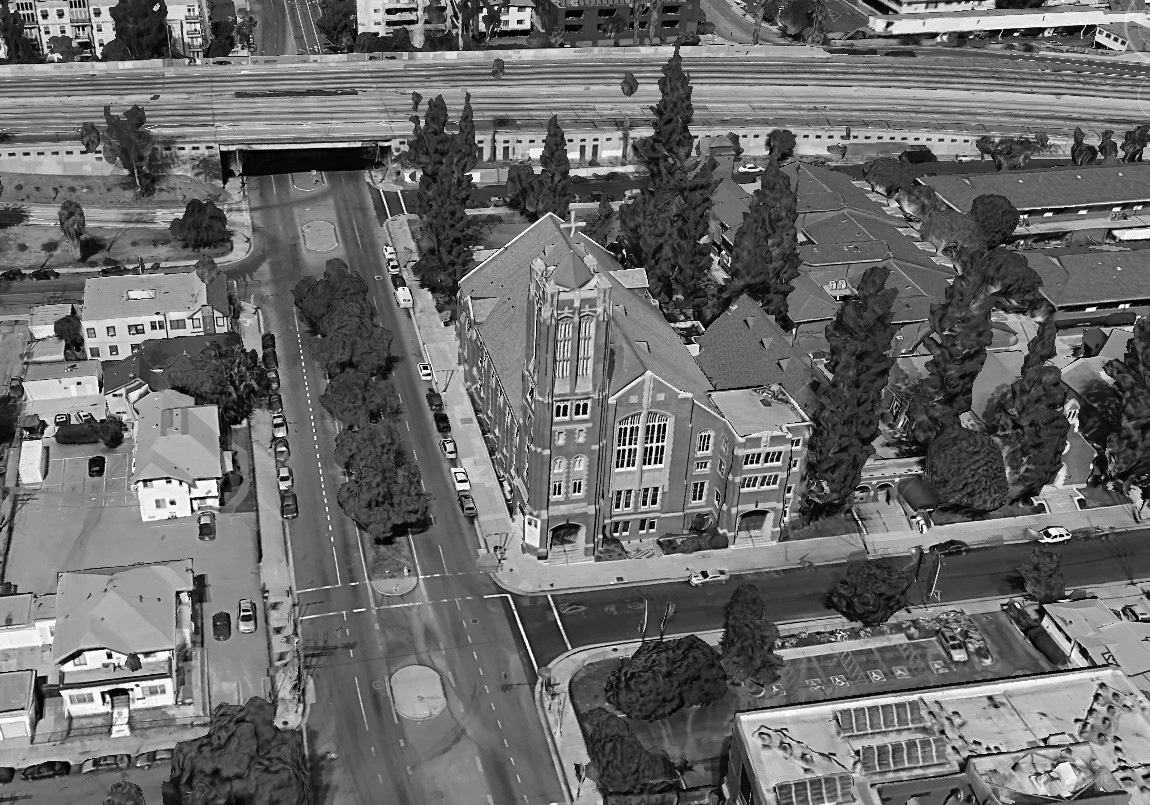 |
|
| (2015)* – Google Earth View showing the Hollywood Presbyterian Church located on the northeast corner of Gower Street and Carlos Avenue with the Hollywood Freeway in the background. |
Historical Notes The church drew congregants from an area much larger than the Hollywood community, taking advantage of its access to the Los Angeles freeway system (the church is located one block south of the Gower Street exit from the Hollywood Freeway).^ The First Presbyterian Church of Hollywood remains one of Hollywood’s most visible, beautiful and historic landmarks. |
Click HERE to see more in Early Views of Hollywood (1920 +) |
* * * * * |
Please Support Our CauseWater and Power Associates, Inc. is a non-profit, public service organization dedicated to preserving historical records and photos. We are of the belief that this information should be made available to everyone—for free, without restriction, without limitation and without advertisements. Your generosity allows us to continue to disseminate knowledge of the rich and diverse multicultural history of the greater Los Angeles area; to serve as a resource of historical information; and to assist in the preservation of the city's historic records.
|
For more Historical Los Angeles Views click one of the following:
For Other Historical Views click one of the following:
See Our Newest Sections:
To see how Water and Electricity shaped the history of Los Angeles click one of the following:
Water:
Power:
* * * * * |
References and Credits
* LA Public Library Image Archive
**DWP - LA Public Library Image Archive
*^Oviatt Library Digital Archives
^^ Daily Breeze: Los Angeles Motordome
*# LA Times: Hollywood Castles and Curious Cures; Olympic Auditorium History; The Ennis House; Bob Hope Patriotic Hall reopens in L.A.
#**Themerica.org: Tam O'Shanter Inn
#++Mattconstruction.com: The Ennis House
#^*Huntington Digital Library Archive
^*#California State Library Image Archive
^+^Bob Hope Patriotic Hall Renovation
+##RolandCommunications.com: Tam O'Shanter
++#Movie Palaces: Beverly Theater
^^*Early Downtown Los Angeles - Cory Stargel, Sarah Stargel
^^+Fightland: Fight Night at the Olympic
**#Noirish Los Angeles - forum.skyscraperpage.com; Elks Building - Horthos; Tam O'Shanter Inn; Garden Court Apartments; Angelus Temple; Coliseum Construction
**^Historical LA Theatres: The Philharmonic Auditorium; Downtown Theatres; Mason Theatre; Loew's State Theatre; Metropolitan/Paramount Theatre; Biltmore Theater
*^#Publicartinla.com - Bovard Hall
*##Curbed LA: California Broadway Trade Center
^^#CSULB - A Visit to Old LA: Hamburger Dept. Store
***Los Angeles Historic - Cultural Monuments Listing
*^*California Historical Landmarks Listing (Los Angeles)
*^^Nuestra Señora la Reina de los Ángeles: losangelespast.com
*^*^UCLA Libraries Special Collection: Pico House Courtyard
*^^*Pacific Eelecfric in San Pedro/Wilmington
^^**Flickr.com: Floyd Bariscale - Sunset Bowling Center
^^++Facebook.com - Pasadena Digital History
^^^*Cinema Treasures: Metropolitan/Paramount Theatre
^*^*Los Angeles Past: The Oldest Building in Los Angeles; Temple and Main Streets, Los Angeles - Then and Now
^*#*Los Angeles Memorial Coliseum and Sports Arena
^*^#Facebook.com - Bizarre Los Angeles
***#Big Orange: Los Angeles Stock Exchange Building; Warner Bros; Saint Vincent de Paul Church
**^#Vintage Los Angeles - Facebook.com: Bernheimer Japanese Mansion; Masonic Temple
^#**A Brief Egyptian Theatre History
^##*Los Angeles Fire Department Historical Archive
#**^Pinterest - Mid Century Hollywood
#*#*Fairfax High School Home Page
#*#^Flickr.com: Wilshire Boulevard History
#^*#Los Angeles Conservancy: Junipero Serra State Office Building; The Ennis House; Bob Hope Patriotic Hall; Talmadge Apartments; Wilshire United Methodist Church
#^#^Weird California: Los Angeles' Programmatic Architecture
#^*^Facebook.com: Photos of Los Angeles
*###The Story of Hollywood by Gregory Paul Williams
^^##Metropolitan Transportation Library and Archive: Hill St. Station; Subway Terminal Building
###*Sunset Bronson Studios: Hudson Pacific Properties
###+Reinventing Broadway Street: Los Angeles’ Architectural Reincarnation by Marques Vickers
##^*Facebook.com: Classic Hollywood-Los Angeles-SFV
#^^*Google Maps
#***Flickr.com: Old Los Angeles Postcards
^***^Facebook.com: Garden of Allah Novels
^* Wikipedia: Leonis Adobe; Occidental College; Beverly Hills; Beverly Hills Hotel; Huntington Hotel; Bank of Italy; Van de Kamp's Holland Dutch Bakeries; Rose Bowl Stadium; Los Angeles Memorial Coliseum; Farmers and Merchants Bank of Los Angeles; Los Angeles Biltmore Hotel; Jonathan Club; Los Angeles Plaza Historic District; St. Vincent Church; The Benevolent and Protective Order of Elks; Park Plaza Hotel; YMCA; San Pedro; Venice; Subway Terminal Building; St. Vincent Hospital; Los Angeles Herald-Examiner; Cahuenga Branch Library; Foy House; Frederick Hastings Rindge House; Los Angeles High School; MGM; Breed Street Shul; Natural History Museum of Los Angeles County; Jonathan Temple; Highland Park Masonic Temple; Egyptian Theatre; Phineas Banning; Eagle Rock; Hollywood Masonic Temple; Sawtelle Veterans Home; Downtown, Los Angeles; Los Angeles Philharmonic; Subway Terminal Building; Hollywood Athletic Club; Pío Pico; Los Angeles Plaza Historic District; Jonathan Temple; Charles Clarke Chapman; Los Angeles Stock Exchange; Park Plaza Hotel (Los Angeles); Broadway Theater District: Lowe's State Theater; Obadiah J. Barker; Leslie Brand; Ben Bernie; Ambassador Hotel; Tam O'Shanter Inn; Garden Court Apartments; George L. Crenshaw; St. Vincent's Medical Center; Fairfax High School; Old Warner Bros. Studio; Hollyhock House; Hollywood Bowl; Angelus Temple; Aimee Semple McPherson; Vista Theatre; Grand Olympic Auditorium
< Back
Menu
- Home
- Mission
- Museum
- Major Efforts
- Recent Newsletters
- Historical Op Ed Pieces
- Board Officers and Directors
- Mulholland/McCarthy Service Awards
- Positions on Owens Valley and the City of Los Angeles Issues
- Legislative Positions on
Water Issues
- Legislative Positions on
Energy Issues
- Membership
- Contact Us
- Search Index
